












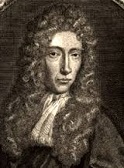





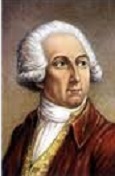




















TLW's Science and Technology Historyscope |
By T.L. Winslow (TLW), the Historyscoper™ |
© Copyright by T.L. Winslow. All Rights Reserved. |
Original Pub. Date: Aug. 28, 2012. Last Update: Nov. 20, 2023. |



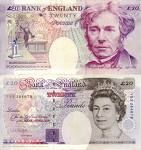







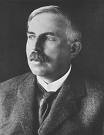





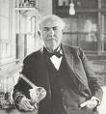







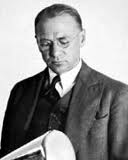



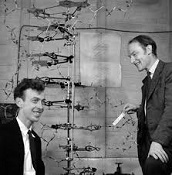



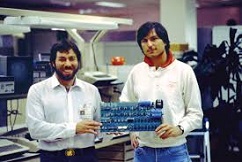
Westerners are not only known as history ignoramuses, but double dumbass history ignoramuses when it comes to science and technology history. Since I'm the one-and-only Historyscoper (tm), let me quickly bring you up to speed before you dive into my Historyscopes.
In this Information Age when kids are handed iPads and iTablets while traveling cross-country in a jumbo jet, it's hard to imagine how many myriads of tireless workers and dozens of long centuries it took to scale the present heights, and how philosophy and religion aided and hindered progress, not to mention the role of geography, climate, culture, political system, and sheer luck. While modern global Big Science has grown so arrogant that its high priests regularly claim to see back to the moment of Creation, real historyscopers strive mightily just to scope back a few thousand years trying to picture the great ascent from Zero on Da Brain to today's speeding Gigabrain Train, I sometimes think I wanna get off.
I'll skip most of the jazz from the Dawn of Time to 4000 B.C.E. since it's not really history it's the output of Science.
I must have a hole in my head, but one thing stands out. About 5,000 B.C.E. the first known trepanation operations are carried out in Ensisheim, Alsace, France. About 4,900 B.C.E. the first known surgery is an amputation operation on the left forearm of an elderly man in Buthiers-Boulancort (40 mi. S of modern-day Paris), France, complete with anesthesia and aseptic conditions.

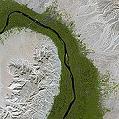

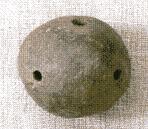
In -4000 world pop.: 7M, beginning to double every thousand years; pop. of India: 1M. -4000 is the date of Creation according to Sir Isaac Newton. In -4000 the Neolithic Period ends, and the Chalcolithic Period begins (ends -3500). In -4000 the sea level, which has been rising since the end of the Ice Age reaches modern-day levels; Mesopotamia develops a rich, fertile delta, and the Near East becomes a wet warm Eden; the Saharan grasslands turn to desert. In -4000 city-states begin to rise along the banks of the leisurely Euphrates River (Persian "ufratu" = good to cross over, Sumerian for fruitful) and swift Tigris River (Persian "tigra" = pointed, Sumerian "idigna" = swift river), and along the Nile River in Egypt; the Egyptians (Remetch, meaning "people") enjoy a lack of natural enemies, giving them the longest period of political stability in human history; the Nile is neat because it not only floods once a year and leaves a couple of miles of fertile silt on each bank, but it flows from S to N while the wind always blows from N to S because of the Mediterranean Sea, so that you can sail S and then turn around and float back N with the current. In -4000 the long-headed (dolichocephalic) super-tall fair-skinned blonde-blue Amorites from Europe or possibly the Arabian Peninsula, having a unique agglutinative language migrate to S Mesopotamia and intermarry with the pop. of the old city-states there, founding the Uruk Culture in Sumer (pop. 300K-500K), containing Semitic elements from Akkad N of Sumer on the W bank of the Euphrates in modern-day Iraq (which derives its name from Uruk) about 30 mi. SW of Baghdad; some cities have over 10K pop.; they worship the Moon god Sin. In -4000 migration begins from the Aegean Sea and Anatolia to the Broken Balkans (Turkish for mountains) and the E Mediterranean. In -4000 the Michelsberg Culture from the Rhineland settles in Belgium and the Netherlands. In -4000 the Funnel Breaker Culture, ranging from S Norway to the Czech-Austrian border and from the Ukraine to the Netherlands reaches NW France and England. In -4000 migrants from Asia settle in islands close to New Guinea. In -4000 the Salisbury Plain (Gael. "Sulis" = Sun") inC S England becomes the center of a funky Stone Age religious cult with huge burial mounds and graves. By -4000 the horse and camel, AKA dromedary ("running") are domesticated in the Middle East, while the llama and alpaca are domesticated in Peru. In -4000 farming begins in Ulster. In -4000 domesticated millet is raised in N China. In -4000 domesticated animals incl. pigs, chicken, and dogs are domesticated in China. In -4000 Copper is worked in the Balkans and the Fertile Crescent. About -4000 the jackass is domesticated in Africa (Somalia?). About -4000 the Egyptians develop sailing vessels (feluccas) for use near the mouth of the Nile River. About -4000 the Egyptians invent the Sundial. About -4000 the Egyptians bake Leavened Bread. About -4000 the Chinese make Cheese and Yogurt using mold. About -4000 Chiles, originally from Bolivia are used from the Bahamas to Peru, according to Linda Perry of the Smithsonian Nat. Museum of Natural History and Deborah M. Pearsall (1950-) of the U. of Mo. About -4000 tombs at Loughcrew in County Meath, Ireland align with the rising Sun at the spring and autumn equinoxes. About -4000 Megaliths are constructed in Malta. Golden artifacts from the Black Sea port of Varna date to the end of the 5th millennium B.C.E., becoming the world's oldest golden treasure in modern times. About -4000 a hard-to-play spherical ceramic flute is used for religious purposes near the Macedonian city of Veles. About -4000 the Akhmim Tablets contain a list of servants' names and a series of grain computations. About -4000 the Sumerian storm goddess-demon Lilith (Akkadian "Lilitu" = night") is worshiped, becoming known for appearing to men in erotic dreams and have sex with them, although she is sterile and has no milk; she is later claimed to be the mythological real first wife of the Bible's Adam.
Also about -4000 if the Bible's Adam and Eve story is true, giant Nephilim (Heb. "those causing others to fall or fail") inhabit the Earth until Noah's Flood (Gen. Ch. 6); "Now it came about, when men began to multiply on the face of the land, and daughters were born to them, that the sons of God saw that the daughters of men were beautiful; and they took wives for themselves, whomever they chose. Then the LORD said, 'My Spirit shall not strive with man forever, for he is indeed flesh; nevertheless his days shall be one hundred and twenty years.' The Nephilim were on the Earth in those days, and also afterward, when the sons of God came in to the daughters of men, and they bore children to them. Those were the mighty men who were of old, men of renown."
About -3500 the harp is first used in Sumer (Ur), along with lyres, spreading to Egypt by -3000.
About -3200 the first Hieroglyphs appear on labels and pottery in Egypt, along with the first scrolls of Papyrus.
About -3000 draft oxen and the Potter's Wheel are used in Mesopotamia. Beeswax Candles begin to be used in ?. Nail Polish is invented in China. The first permanent copper shaving razors appear in Egypt and India. Ma Huang, containing Ephedrine, closely resembling amphetamine is used by Chinese doctors. The earliest writing in China is in the E province of Zhejiang.
About -2700 the Sumerians invent the Abacus, followed by the Persians in -600, the Greeks in -500, and the Chinese in -200; the earliest known abacus dates to -300, the Salamis Tablet, discovered on the Greek island of Salamis in 1846.
About -2700 the square-sailed ship is invented in Egypt.
In -2640 Chinese Empress Hsi-ling Chi (Shi) allegedly discovers Sericulture after a cocoon falls from a mulberry tree into her tea cup, and it unravels as she tries to remove it; divulging the secret of sericulture becomes a treasonable death penalty offense, and the Chinese monopoly eventually makes it worth its weight in gold; the best silk comes from Bombyx mori moths, which each lay up to 500 pinhead-sized eggs, which hatch in 20 days, and begin munching mulberry leaves, growing 70X in 18 days after shedding their skin 4X and increasing their weight by 10KX; they then begin spinning secreting double strands of fibroin which are coated with gumlike sericin before coming out of the spinneret at the rate of 10-15 in. per min., or up to 1 mi. in 48 hours; it takes 100 cocoons to make a silk scarf, 140 to make a tie, and 9K to make a kimono - ooh, bite your tongue?
Also in -2640 Chinese royal astronomers Hsi and Ho are executed for dereliction of duty when they get drunk and fail to predict a solar eclipse; luckily, the dragon eating the Sun gets his fill and departs, even though the required noisemakers with gongs are not assembled to drive it away.
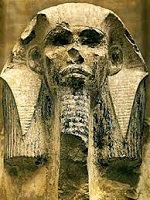

In -2630 Sanakhte dies, and his younger brother Netjerykhet (Djoser) (Zoser) (d. -2611) becomes king #2 of Egypt's Third Dynasty, building the Step Pyramid in Saqqara near modern-day Cairo, becoming the first pyramid in Egypt, launching the Age of the Pyramids (3rd thru 6th Dynasties, AKA the Old Kingdom) (ends -2200); Imhotep, later the "god of medicine" and "prince of peace" thrives during the Third Dynasty at the court of King Djoser.
About -2500 the ox-drawn plow (ard) is invented in Egypt.
About -2200 iron anchor chains on ships are first used by the Chinese under Emperor Yu, two fore and two aft.
About -2200 according to Bible-thumpers, construction begins on the Tower of Babel (Gen. 11:4), an attempt to disobey Jehovah's order to populate the entire Earth and instead build New York, New York, it's my kind of town, which Big J foils by confounding the workers' languages, rewiring their language circuits so that what they have here is a failure to communicate, and they do a Cool Hand Luke and ditch their own U.N. Bldg. (no translators), and go their own ways, forever at war, but spreading all over the Earth? Was Babylon the original source of magic, divination and astrology, and was the Tower of Babel built on the Dark Isle (al-Djezair) between the Tigris and Euphrates, and contained eight tiers in an attempt to attain to immortality, becoming the source of the Eightfold Path of Buddha, the figure-8 twined serpents on the Caduceus (staff of Hermes, AKA Mercury, AKA Thoth, AKA Prince of Tricksters, Joker, Jester, Fool), the I-Ching, Tarot Cards, the Game of Kings (chess) and the Knights' Tour, the marriage of the Red King and White Queen, the secret of the peacock's tail, the sideways-8 figure for infinity, and the alchemical quest for the Philosopher's Stone, a cake made from a reddish-black powder, which is mixed with Aqua Philosophia, "heavy water" gathered from dew when the Sun is between the Bull and the Ram (when the water falling from the Moon is heaviest), creating the Elixir of Life (al-Iksir), which gives immortality if made correctly, but death if made incorrectly?
About -2000 the Chinese develop a writing system; meanwhile Alphabetic Writing is invented in the Middle East.
About -1850 the Egyptian Twelfth Dynasty Moscow (Golenishchev) Mathematical Papyrus contains 25 math problems.

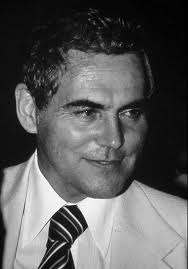
About -1800 Stonehenge (begun -2800) in England is completed, designed to predict eclipses of the Sun and Moon as well as solstices and seasons; on sunrise at the summer solstice the Sun comes right down the aisle of small stones in the center, as shown by English astronomer Gerald Stanley Hawkins (1928-2003) - where it shines on the sacrifice table so the Druids can insure another cycle of seasons?
About -1680 Labarnas (Labarna) I announces the brand-spanking new Old Hittite (Hatti) Kingdom (ends -1500), E of the Halys River on the C plateau of Anatolia (Asia Minor), developing iron-working, which gives his troops the mojo to cross the Taurus Mts. and tirelessly wage war on Syria and Assyria in a land grab in the Anatolian Peninsula; the land of Ebla in N Syria is "shattered like a ceramic vase"; in 1098 C.E. Crusaders mention seeing the ruins of Ebla (Mardikh) 40 mi. S of Aleppo.
About -1650 the Egyptian Mathematical Leather Roll is written, a practice test for students on fractions; also the Rhind Mathematical Papyrus, which contains mathematical problems.

About -1600 the oldest surgical treatise on trauma to survive to modern times, the Edwin Smith Papyrus is written during the Egyptian Second Intermediate Period (by first known physician Imhotep?), describing 48 cases of injuries, fractures, wounds, dislocations, and tumors, with treatment and prognosis, incl. closing wounds with sutures, using honey and moldy bread as antiseptics, stopping bleeding with raw meat, and immobilization for head and spinal cord injuries; magic is left as a last resort; it also contains detailed anatomical observations but shows no understanding of organ functions; the earliest known reference to cancers or ulcers of the breast; discovered in Luxor in 1862 C.E. by Am. antiquities dealer Edwin Smith (1822-1906).


About 1,550 B.C.E. the Ebers Papyrus is created in Luxor, Thebes, Egypt, describing diagnosis and treatment of various medical ailments incl. depression and dementia, mentioning that the heart is the center of the blood supply and all bodily fluids, and listing 877 drug prescriptions; discovered in 1873-4 by German Egyptologist Georg Mortiz Ebers (1837-98).
About -1500 the 22-letter (consonants only) Phoenician Alphabet begins to be developed, reaching its completed form around -1200.
About -1500 the Egyptians invent the Shadow Clock. About -1500 Bells are made in China. About -1500 are the earliest written record and surviving fragments of Tapestry. About -1500 the earliest known Glassware is made in Egypt.
Also about -1500 indigenous iron technology arises in Dwarka and Kashmir in India.
About -1270 the first bronze Naue Type II swords (grip-tongue or Griffzungenschwert) (good for slashing) are developed in N Italy or Austria-Hungary, spreading to the Aegean and Ugarit (N Syria) by -1200; named after German archeologist Julius Naue (1835-1907).

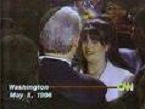
About -1250 at the climax of the year's largest religious festival in Thebes, 70-y.-o. Pharaoh (since -1290) Rameses (Ramses) II (the Great) (-1320 to -1224) stands on the pyramid before 300K adoring subjects and lifts his short white robe to reveal an erect thebesing penis, causing them to cheer after seeing that their pharaoh's staff is mighty and that Egypt will prosper; he dies after fathering 100+ legitimate and 1K+ illegitimate children, causing everybody in Egypt to end up looking like him?; according to Norman Mailer, nothing like this happens again until the days of U.S. Pres. Bill Clinton - a lost invention of Egyptian Viagra, or the eggplant trick of John Barth's "Sot Weed Factor"?
About -1200 the Late Bronze Period of Archaeology begins, and the Early Iron (Iron I) Period of Archeology begins (ends -1000).
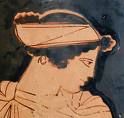
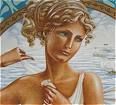
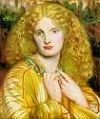




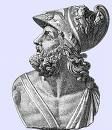


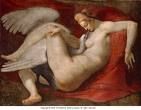




The original Hatfield-McCoy Feud? In -1194 the Trojan War (ends -1184) begins when Prince Paris (Alexander), son of King Priam of Troy (Ilium) on the Hellespont (known for his prowess with a bow) goes on a diplomatic mission to Spartan king Menelaus, and falls in love with his beautiful wife Helen, then abducts her and takes her with him back to Troy (founded by Dardanus, son of the god Saturn), pissing-off Menelaus, who gets his brother King Agamemnon of Mycenae (in the NE Peloponnesus 55 mi. SW of Athens) to join him, along with loose cannon Achilles of Thessaly, son of King Peleus of the Myrmidons and the Nereid Thetis; the whole thing started when Eris, goddess of discord, pissed-off at being excluded from a marriage throws a golden apple inscribed "To the Most Beautiful" into the gathering, and Paris awards it to Aphrodite, causing her to promise Helen to him?; according to Herodotus (Bk. 1), it all started when the Phoenicians first arrived from the Red Sea (Indian Ocean), and kidnapped Io and other maidens from the top Greek island of Argos and took them to Egypt, after which more Greeks kidnapped Europa, daughter of the king of Tyre, then Greek Jason and the Argonauts got the same idea and did ditto to Medea, daughter of the king of Colchis, causing Priam to think that he had a right to get a wife by kidnap, and when the Greeks actually made him pay for it for once, it pissed-off the Persians, who claimed to own all peoples in Asia Minor, causing them to become the enemies of the Greeks; actually a ton of Greek bucks had courted Helen before her marriage, and all had been made to promise Menelaus to defend her in advance?; the Greeks then launch a fleet of 1K ships and 50K men at Troy, which itself has no navy but has an impregnable fortress city, and the classic confrontation of irresistible force and immovable object is on; no ordinary Bronze Age Greek supermodel, Helen (Gr. "torch", or "selene" = Moon?) of Troy, "the face that launched a thousand ships" is the daughter of Zeus (in the form of a swan) and Spartan queen Leda (daughter of King Thestius of Aetolia), who on the same night was also impregnated by Spartan king Tyndareus (two fertilized eggs at the same time), producing her twin siblings Kastor and Polydeuces (Castor and Pollux) (mortals) and (from her first egg) Helen and Clytemnestra, whom Agamemnon married after killing her first hubby Tantalus in order to become king of Mycenae, after Clytemnestra bears him Orestes (Gr. "mountaineer"), Iphigenia (Iphigeneia) (Gr. "strong-born"), Electra, and Chrysothemis, then after he sacrifices Iphigenia to make the winds return so his fleet can sail to Troy, she waits till he gets back from Troy with Trojan princess Cassandra, pissing her off more, and murders them both so that her new beau Aegisthus (Gr. "goat strength") can become king, after which Orestes and Electra of the now doomed House of Atreus murder them both.
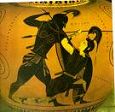


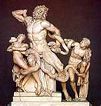


On June 11, -1184 the impregnable walled city of Troy (Ilium) in Asia Minor near the Hellespont (Dardanelles) is destroyed by fire in the last year of the 10-year Trojan War after the first special ops commando raid in history, made possible by the original 1-trick pony Trojan Horse (the original Kobayashi Maru Maneuver?), which Trojan priest Laocoon (Laocoön) tries in vain to expose by tapping with a spear, causing the goddess Athena to send sea serpents to strangle him and his sons Agesander, Athenodoros, and Polyclitus, which the Trojans interpret as proof that the horse is sacred; the doings in the 10th year are later celebrated by Homer's Iliad; the U.S. 10th Special Forces Group (Green Berets) later features a silver Trojan Horse on their badge; a band of survivors led by Aeneas (son of Aphrodite or Venus and Anchises, a cousin of King Priam) escape and search for a new home, ending up in Rome (Latium), where King Latinus (son of Inachus, son of Dardanus, son of Saturn) allows them to stay, and reneges on a promise to King Turnus of the Rutuli, marrying his daughter Lavinia to Aeneas instead, causing Turnus to turn-turn-turn declare war on Aeneas, which he loses, getting killed, after which Aeneas' Troy-born son (via 1st wife Creusa, who dies before reaching Latium) Ascanius founds Alba Longa SE of Rome on Lake Albanus in the Alban Hills (ends 7th cent. B.C.E.), and becomes its first king, establishing the line that leads to Romulus and Remus; Homer's Odyssey contains one of the earliest historical references to Crete, claiming that it's populated by Achaeans, Cydonians, Pelasgians, Dorians, and Eteocretans (pre-Hellenic natives), and has 90 independent cities, with #1 being Cnossos; shortly after the Trojan War ends, the city of Tenea is founded 15 km SE of Corinth and 20 km NE of Mycenae by Trojan POWs with the permission of Agamemnon. In May 1873 German ancient Greece freak archeologist Heinrich Schliemann (1822-90) claims to have dug up the remains of ancient Troy, which he had been excavating since 1870 in an effort to prove that it isn't a legend.
In -1244 the Cairo Calendar (Calendar of Lucky and Unlucky Days (ends -1163) begins to be kept, containing daily observations of the Algol triple star system, becoming the earliest historical record of a star's brightness.

About -1000 the soft limestone tablet Gezer Calendar is erected 30 mi. NW of Jerusalem on the site of the Biblical city of Gezer, outlining their lunar agricultural year; a school boy's exercise?; discovered in 1908 C.E.
About -800 the Saddle (without stirrup) is developed by the Assyrians, consisting of a simple cloth and surcingle; stirrups aren't invented until the 4th cent. C.E. in China, and are spread to Europe by the end of the 6th cent. C.E. by the Avars.
About -800 Couching (using a sharp instrument to push a cloudy lens to the bottom of the eye to cure cataract) is first described in the medical treatise "Sushruta Samhita, Uttar Tantra" by Indian surgeon Maharshi Sushutra.
About -730 the Hallstatt Iron Age Culture, characterized by iron and bronze swords with winged metal terminals, and horse domestication evolves from the Urnfield Culture, and begins spreading from Austria to France, Belgium, Netherlands, Iberia, and Ireland, launching the Iron Age in Europe (until -400), speaking a proto-Celtic language that becomes the ancestor of all later Celtic languages, branching into separate Celtiberian, Goidelic, and Byrthonic tongues; named from a necropolis containing 2K graves in Hallstatt in Upper Austria, excavated in 1846-99.

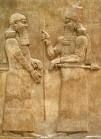
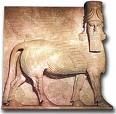
In -722 (6th year of Hezekiah of Judah) (2 Ki. 18:10), Samaria is conquered (2 Ki. ch. 17) by the Assyrians under king (since -727) Shalmaneser V, who is assassinated, allowing his successor Sargon II (Sharru-Kin) (-763 to -705) ("legitimate king") to claim credit; the 27,290 members of the Lost Ten Tribes of Israel, incl. King Hoshea are carried away like foam upon the water to Harran; the depopulated land is slowly settled by Aramaic-speaking Assyrians, and the Samaritan Religion is born; Jerusalem is strengthened with a great influx of refugees; after the time of Nehemiah, the Hebrew language dies out, and Aramaic, the language of the Aramean internat. land traders becomes the universal language of the civilized Western world by the time of Darius I the Great; of the original Twelve Tribes, only the depleted 2-tribe (Judah and Benjamin) S kingdom of Judah is left (along with some Levites, the landless priest-class 13th tribe), and Judah only has seven more kings to go before their royal line is kaput (Manasseh, Amon, Josiah, Jehoahaz, Jehoiakim, Jehoiachin, Zedekiah); later speculators trace the lost tribes to the British Isles, North Am., South Am., India (the Manashe Tribe in Manipur and Mizoram in E India), Abyssinia, Afghanistan, China, Japan, Africa, and Uzbekistan and Tajikistan; the proof that the Tribe of Dan migrated W is their naming of the Danube, Dnieper, and Denmark?; in the 18th cent. the Anglo-Israelite Theory, that they are the ancestors of the Anglo-Saxon peoples makes it easier for Jews to immigrate; did they go to Japan, as indicated by similar ceremonies?; some Scots claim that they are the lost tribes, and that the Stone of Scone (pr. SKOON) is really the Beth-El (Jacob's Pillow) in Genesis; the Book of Mormon claims they migrate to North Am., quoting Bible prophet Isaiah: "From the isles of the sea, from those parts beyond the sea into which they were carried captive" (Is. 24:24) (maybe to the British Isles?).
The pesky nation of Israel kaput, and the runt nation of Judah barely squeaking by, the Assyrians rule Da Middle East, causing Jews to forget how to speak Hebrew, except for a few priests. In -708 Babylon falls to Assyria, and now the known world pays homage to Assyria Da Great.
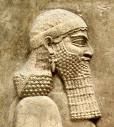
In -700 Assyrian king (-705 to -681) Sennacherib (Sin-Ahhe-Eriba) (d. -681) (Akkadian "the Moon god"), known for founding the capital city of Nineveh, which he turns into a magnificent city, with a royal palace of 80 rooms built on a foundation of 160M bricks, and featuring bas-relief stone panels of winged lions or bulls with a man's head, along with grisly scenes of cruel treatments of POWs incl. impalings orders the construction of the world's first known Aqueduct in Jerwan.
About -700 the Sumerians invent the Arch Bridge, using corbelled arches in aqueducts.

In -668 Esarhaddon's son Ashurbanipal (Ashur-Ban-Apli) (-692 to -627) (Sardanapalios, Sardanapalus, Asenaphar, Asenappab) becomes king of Assyria, and begins collecting the great Library of Ashurbanipal containing 22K+ cuneiform clay tablets, incl. a copy of the ancient Epic of Gilgamesh, which has the Babylonian accounts of the Creation and Flood (excavated beginning in 1845 C.E.); some cuneiform is so tiny (6 lines per inch) that it must be read through a magnifying glass; he installs his brother Shamash-Shuma-Ukin (d. -648) as king of Babylon, who has the Shamash-Shuma-Ukin Chronicle inscribed on a small tablet.
Too bad, in -639 the Assyrian Annals (state records) abruptly end; "With the year 639, the sources for Assyrian history cease... No explanation can be given for this curious blackout. With appalling suddenness, the Empire disintegrated." (The Interpreter's Dict. of the Bible)
In -612 the Assyrian capital of Nineveh (pop. 100K) is sieged, sacked and destroyed by the Babylonians under Nabopolassar, the Medes under Cyaxares, and the Scythians (Nah. 3:7), turning it into "ruin-hills and heaps of debris" (Babylonian Chronicle 21901 of the British Museum); the ruins aren't rediscovered until 1849 C.E.; the great library of Ashurbanipal is destroyed (22K cuneiform tablets found in modern times); the Assyrian Empire is threatened with collapse as the Medes and Babylonians divide it.
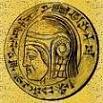

In -605 Babylonian crown prince Nebuchadnezzar II (d. -562) (Nabuchodonosor) (Nabu-Kudurri-Usur) defeats the Egyptians under Necho II (his rival for control of Syria and Palestine) at the Battle of Carchemish (Karkemish) on the W Bank of the Euphrates River 400 mi. N of Jerusalem (Jer. 46:1-2) (35 mi. SE of Gaziantep in S Turkey on the Syrian border), and overtakes and annihilates the fleeing Egyptian army at Hama; both sides take heavy casualties, and Nabopolassar dies; Egyptian power in Asia is destroyed (2 Chron. 35:20); "For the mighty man has stumbled against the mighty, and they are fallen both of them together (Jer. 46:12); on the first day of Elul (Aug.-Sept.) his son Nebuchadnezzar II is crowned king of Babylon and becomes undisputed ruler of W Asia (until -562); Judean king Josiah takes on Necho on his way to Carchemish in violation of God's orders, and is wounded by archers and brought back to Jerusalem, where he dies, and Jeremiah utters laments for him, which "are written in the Laments" (2 Chron 35:20-27); Josiah is succeeded by 23-y.-o. Jehoahaz, who reigns 3 mo. until Necho deposes him and lays a tribute of 100 talents of silver and one talent of gold on the land, then makes his 25-y.-o. brother Eliakim king of Judah, changing his name to Jehoiakim, taking his brother Jehoahaz hostage back to Egypt; "He reigned eleven years in Jerusalem, and did what was evil in the sight of the Lord his God" (2 Chron. 36:1-8). Jeremiah begins dictating to his secretary Baruch a prophecy directed against Israel, Judah and all the nations (Jer. Ch. 36).
About -600 the first Egyptian Merkhets ("instruments of knowing") are used to establish time at night.
About -600 Sushruta (Sansk. "well-heard") of Varanasi, India becomes the first plastic surgeon and father of surgery, leaving a Compendium, containing descriptions of 1,120 illnesses, 700 medicinal plants, and detailed surgical techniques for incisions, probing, cauterization, prostate gland removal, hernia surgery, cataract surgery, Caesarian section et al.

About -600 Thales of Miletus (-624 to -547) becomes what was regarded by Aristotle as the first philosopher; "Western philosophy begins with Thales" (Bertrand Russell); he becomes the first to break with religion and attempt to explain Nature without resorting to mythology, becoming known as "the Father of Science"; he regards water as the arche (source of all things), and leaves Thales' Theory of Geometry and Thales' Intercept Theorem, becoming the first true mathematician who discovers a mathematical theorem and uses deductive reasoning to derive four corollaries.
In -587 Nebuchadnezzar II conquers Cilicia, and heads for Jerusalem, capturing Zedekiah and bringing him to Big Neb blindfolded (2 Ki. 25:2-8); Nebuchadnezzar retires to Riblah "in the land of Hamath", leaving the siege to his chief bodyguard Nebuzaradan ("Nebo has given offspring") (2 Ki. 25:8-12), who comes to Jerusalem 1 mo. later; beginning on the 7th day of the the 5th month Ab, the Babylonians enter Jerusalem, wreck the wall, and loot the Temple of Jehovah (Solomon) (2 Ki. 25:8-20, Jer. 39:8-10, 43:5-6, 2 Chron.); the Ark of the Covenant is not there (captured by Pharaoh Shishak, or given by Solomon to the Queen of Sheba's son Menelik?); they capture and blind King Zedekiah, slaughter "all the nobles of Judah" (Jer. 39:1-8), and take the remainder of the pathetic Jews into the Babylonian Captivity, allowing some of the lowliest ones to remain; on the 10th day of Ab Nebuzaradan inspects and then burns the temple (on the same day that the rebuilt temple is burned in 70 C.E.) (the Jews commemorate the 7th day of Ab with a fast, and also celebrate the 9th day of Ab, or Tishbah b'Ab).

In -539 monotheist Zoroastrian Persian king Cyrus ("Sun", "throne") II the Great (-600 to -529) conquers Babylon after diverting the Euphrates River so that it can no longer be used as a moat. One of his first acts is to issue a decree (2 Chron. ch. 36) granting his exiled fellow monotheist subjects the Jews the right to return to Israel; the Bible book of Isaiah, Chap. 44 and Isaiah, Chap. 45, allegedly written 200 years earlier predicts the capture of Babylon by Cyrus, the draining of the Euphrates (44:27), the gates being left open (45:1-2), and even calls him by name (45:1) and describes him as the Anointed (Messiah); 42K Jews return, settling in the Persian province of Yehud (Judea), but the majority stay (cooler summers?). Now that the Order of the Middle East is restored with black-haired monotheist Persians running things, and the black-haired Jews allowed to return to their digs, the blonde Jove-worshipping polytheist Greeks see the handwriting on their wall and begin to ramp up Science? No wonder that Bible and Quran-thumpers later associate Science with the Devil?
Call it race, culture, social organization, geography, climate, low birthrate, sexual orientation, or luck, but the first real scientific brain men were blonde-blue Greeks running around in togas in Athens and environs - men not women, sorry. White supremacists love to dwell on those fabled days when their so-called race was winning all the blue ribbons, never mind all them blonde-blue illiterate barbarians in Europe who worshiped trees and were afraid to bend over for fear of a wild boar's tusk up their asses. If there is another side to it you should've asked Idi Amin, the last king of Scotland before he went to be with Allah in paradise.

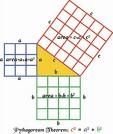

Shut your pi hole and do your math homework? In -530 after traveling to Egypt and learning the doctrines of the Egyptian priests, Greek Ionian philosopher Pythagoras (-580 to -497) is driven from Samos by tyrant Polycrates, and founds his mystical philosophical sect in Italy's Toe City Croton (Crotona), teaching reincarnation, numerology, and dietary restrictions (no beans), and gaining the support of superstar athlete Milo of Croton after claiming to be a reincarnation of Trojan War soldier Euphorbus; although he leaves no writings, his school discovers the Pythagorean Theorem and raises math to a science, considering Number to be the ultimate principle of the Universe, and believing the Earth to be a globe revolving with the planets (incl. the Sun) around a central fire, separated from each other by intervals corresponding to the harmonic lengths of strings, which play the "music (harmony) of the spheres"; Pythagoreans don't eat beans because they make bad music?


In spring -480 Persian Zoroastrian king (since -485) Xerxes (Khshayarsha) (Ahasuerus) (Pers. "monarch") I (d. -465) personally leads an invasion of Greece against the ?!*! pesky free-thinking polytheist Greek hooligan terrorists, assisted by bitter exiled Spartan king Demaratus, marching through Thrace and Macedonia with 200K-2M men, incl. units of Arabs on camels (Herodotus Bk. 7 says 5M plus camp followers), plus a fleet of 600-1,200 ships, cutting a canal through the 1 mi. wide Isthmus of Chalkidike for them; on Aug. 9-11 (Aug. 16-18?) a Greek allied army of 7K hoplites (incl. 300 Spartans, 400 Thebans, 700 Thespians, 900 Helots, and 1K Phocians) blocks the 50-yd.-wide (as wide as a wagon track in some places) coastal pass (6 mi. from the sea, which turns into a swamp then a rocky plain in modern times) of Thermopylae (Thermopilai) (Gr. "hot gates") in E Greece (between Mt. Oeta and the S shore of the Gulf of Maliakos) for three days, while a fleet of 270 Greek ships protects the Gulf of Artemisium; on Aug. 19 after a Greek traitor shows the Persians a bypass route which allows them to turn the Greek position, most of the Greeks retreat, except 300 Spartans and 700 Lesbians, er, Thespians (famous for their worship of Eros and the Muses) under Spartan Agiad king (since -490) Leonidas I (-520 to -480), who make a stand, and are all KIA in a legendary fashion after responding to the Persian demand to surrender their weapons with the immortal soundbyte "Molon labe" (come and take them); later Simonides of Keos turns this into the immortal soundbyte "Go tell the Spartans, stranger passing by, that here, obedient to their laws, we lie"; meanwhile half of the Persian fleet is lost to storms, and the Battle of Artemisium is a push, but the loss of Thermopylae causes the Greek navy to withdraw, and the Boeotians, Phocians, and Lorians to flop to the Persian side; the Greek army retreats to the Peloponnese and builds a wall across the Isthmus of Corinth, and the Greek fleet moves to the Saronic Gulf between Athens and Salamis, causing the Athenians to flee and the Persians to occupy Attica and sack and destroy Athens, but on Sept. 23 the Greeks score a big V at the naval Battle of Salamis in the Straits of Salamis after the Persians make the mistake of attacking in a narrow strait which takes away their numerical advantage; Paros switches sides after the battle, and joins the Athenian League; Xerxes heads back to Persia with what remains of his navy and a third of his army, leaving Gen. Artabazus in charge of one-third in Thrace, and Gen. Mardonius in charge of the rest, who withdraws from Athens, burning everything in his path, and winters in Boeotia; the Acropolis in Athens is destroyed.


On Aug. 27, -479 (morning) after the Persians invade Attica again, the Greeks ignore their differences and unite against the common Persian foe, fielding an army of 110K incl. 39K Spartans in the land Battle of Plataea; the Persians under gen. Mardonius are defeated by Greek forces under Spartan gen. Pausanias (-510 to -468), with a total loss of 250K; Mardonius is KIA and his body stolen and his camp plundered; meanwhile on Aug. 27 (afternoon) after the Samians and Chians convince king Leotychides II of Sparta to take his small Greek fleet guarding the Cyclades to surprise the Persians after the latter make the mistake of drawing their ships up on the beach at Mycale near Samos, the naval Battle of Mycale sees the Athenians under gen. Xanthippus (father of Pericles) destroy the Persian fleet and complete the Greek repulse of Persia; both battles take place near a temple of the Eleusinian Demeter (Herodotus, Bk. 9); too bad the town of Thespiae in SC Boeotia in EC Greece, E of Mt. Helicon (10 mi. WSW of Thebes and 10 mi. WNW of Plataea) (whose pop. fought at both Thermopylae and Plataea) is destroyed by the Persians; on Sept. 6 the Greeks siege Thebes, demand that they turn over Persian collaborators Timagenidas and Artaginus, and when they refuse, capture the town, abolish the oligarchy, and institute a democracy; the Ionian cities of Asia Minor along with several island cities (Chios, Lesbos, Samos) see their chance and revolt from the Persian melon-heads, forming an allied Greek fleet that sieges the Persian stronghold of Sestos in the Thracian Chersonesus at the mouth of the Aegospotami River; the Spartans return home in the fall, but the Athenians and Ionians stay and capture Sestos early next year.
This epic V made blonde polytheist Greece and the Wild West safe from dark-haired monotheist Persia and its oriental despotism, else we'd all be speaking Persian now and still be driving chariots. Too bad for blondes, the dark-haired polytheist Latins are beginning their rise, and prove that an empire can be built on stealing somebody else's Science, see any rerun of the Planet of the Apes. Meanwhile the ever-persecuted Jews wait in the wings, giving modern conspiracy theorists a lifetime job, I'll risk a spoiler and mention that 2,400 years later most brainy Jews go atheist and take over the World of Science in order to restore their lost state of Israel in 1948 with the power of their 2nd homeland the U.S., the conspiracy novel is still in my drawer I just haven't had time to publish it.
About -430 Greek Pythagorean philosopher Philolaus of Croton (-480 to -385) of Croton in Magna Grecia (S Italy) gets the credit for originating the theory that the Earth is not the center of the Universe; he claims that humans have immortal souls which are imprisoned as a punishment for bad behavior during life.
About -430 Greek sophist Hippias of Elis discovers the mathematical Quadratix of Hippias (Dinostratus), used for angle trisection.
In -427 the Hindu astronomical Siddhantas (Sansk. "Doctrine/Tradition") begin to be compiled, containing the Hindu numerals and zero.

In -420 Cumae is conquered by the Oscans using the gastraphetes (Gr. "belly bow"), a winched crossbow machine capable of throwing two arrows at the same time, invented by Pythagorean engineer Zopyrus of Tarentum; they go on to eradicate its Greek identity - easy cumae, easy osco?

About -420 Greek philosopher Democritus of Abdera (-460 to -370) pioneers the concept of atomic structure by contrasting the Intellect and the Senses: "Apparently there is color, apparently sweetness, apparently bitterness, actually there are only atoms and the void"; "Poor Intellect, do you hope to defeat us, while from us you borrow your evidence? Your victory is in fact your defeat."

About -400 60-y.-o. Hippocrates of Cos (-460 to -377) of the island of Cos in Greece becomes "the Founder of Western Medicine", teaching that diseases have natural causes, proposing the Four Humors (Temperaments) (sanguine, choleric, melancholic, phlegmatic) theory of disease, theorizing that mental disorders may be caused by physiological abnormalities; teaches that wounds should be washed in water that had been boiled or filtered, and that a doctor's hands should be kept clean and his nails clipped short, becoming the first to distinguish benign from malignant breast tumors, advocating withholding treatment for "hidden" cancers, with the soundbyte that surgery causes "a speedy death, but to omit treatment is to prolong life"; Aristotle later calls him the "great physician"; the Hippocratic Oath, drafted by him or his students incl. "Primum non nocere" ("The first rule is do no harm"); it begins "I swear by Apollo, the physician, by Aesculapius, by Hygieia, Panacea, and all the gods and goddesses... The regimen I adopt shall be for the benefit of my patients according to my ability and judgment, and not for their hurt or for any wrong. I will give no deadly drug to any, though it be asked of me, nor will I counsel such, and especially I will not aid a woman to procure abortion..."; he determines that the male contribution to a child's heredity is carried in the semen - matriarchial religions are f-ed? He also writes Aphorisms; "Life is short, and Art is long" (Vita breva, Ars longa) - is there a doctor in the Acropolis? He leaves the soundbyte: "Let food be thy medicine and medicine be thy food."
About -400 the Shun-Hai Ching (Sun-Hai King) (Classic of Mountains and Seas) (Mountain-Sea Classic) is written by a group of Chinese scholar-explorers, becoming the oldest secular book on Earth, describing 550 mountains and 300 channels in 18 sections; it describes fantastic creatures such as a 1-armed tusked ("spears of pearl") red giant as tall as three men, and a small grey pig with a white collar and teeth of pearls; did they visit America and see woolly mammoths and peccaries?
About -400 the city of Syracuse under tyrant Dionysius I invents the Arrow-Throwing Catapult.


In -347 after watching his master Socrates (-469 to -399) take the hemlock in -399 then wandering around before settling in Athens and founding the Academy in -387 (world's first univ.), Greek philosopher Plato (Gk. "broad") (real name Aristocles) (-427 to -347) (AKA Eflatun, meaning spring of water or knowledge) dies, leaving a giant stack of writings that wow the world forever. Too bad, his take on Science is that Nature is an idea, causing his disciples to get into an endless war with followers of Aristotle, who consider Nature to be a machine; in practice the theologians get into more deep doodoo than the Scientists, who have the common ground of mathematics.

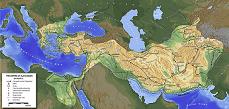
In -336 the blonde Greeks finally made their play for world domination, but not exactly, it was the blonde bi Macedonian Alexander III the Great (-356 to -323), who conquered the known world incl. Greece, the Holy Land, Egypt, and Persia before dying prematurely in Babylon, after which his generals split and spoiled the Great Blonde Greek Dream Empire, ask Mel Gibson how Jews started that war, okay, I'll tell ya, they stopped a war, against themselves. In -332 according to Jewish historian Josephus in his Antiquities 11.317-45, Alexander III the Great visits Jerusalem, and the Jewish elders freak him by reading to him from the Book of Daniel (Ch. 2) the prophesy about the statue with a head made of gold, chest and arms made of silver, belly of brass, legs of iron, and feet of iron mixed with clay, explaining that the head is Babylon, the breast and arms Medo-Persia, the brass belly and thighs Greece, and the iron legs Rome, before or after which he has a dream about the Jewish god being right and sacrifies to him, sparing the city from sacking although putting it under his control; meanwhile after cooperating with Alexander (who thinks Jerusalem is a no-value town run by stargazers?), the Samaritans build their Samaritan Temple to Jehovah on Mount Gerizim.

In -335 Stagira, Macedonia-born Greek Golden Mean philosopher (the first scientist?) Aristotle (Gr. "best (purpose) of all") of Stagira (-384 to -322) parts ways with Plato and founds the Lyceum in E Athens, becoming the teacher of undefeated world conqueror Alexander III the Great, preferring to collect data rather than sit around thinking, and (after much personal experimentation?) deciding that all inheritance comes from the father, the mother merely providing the material, and that female babies are caused by "interference" from the mother; he leaves 260 treatises, incl. Constitution of Athens (written in -350) (discovered in 1890 C.E.), Physics, Metaphysics, Ethics, Logic (Prior Analytics), Zoology, De Anima (On the Soul) (the nous poietikos or active intellect vs. the nous pathetikos or passive intellect), which first mentions the Tabula Rasa view of the mind as starting out a blank slate, and Poetics, the first work on art criticism, valuing art based on how it imitates the universal in human nature, and claiming criticism as a science: "Man is by nature a political animal"; "Hope is a waking dream"; "Tyrants preserve themselves by sowing fear and mistrust among the citizens by means of spies, by distracting them with foreign wars, by eliminating men of spirit who might lead a revolution, by humbling the people, and making them incapable of decisive action"; "Music directly represents the passions of the soul. If one listens to the wrong kind of music, he will become the wrong kind of person."

In -323 Aristotle's pupil, Greek philosopher-botanist Theophrastus (-371 to -287) (Gr. "graceful conversation") becomes dir. #2 of the Lyceum, writing Historia Plantarum, descriptions of 500+ species of plants.

In -305 Alexander's polymath gen. Ptolemy I Soter (Gr. "savior") (-367 to -283) establishes the great Alexandrian Museum (Museo) (dedicated to the Muses) in Egypt in honor of Alexander III the Great, whose body he had brought from Babylon and buried there; elite Greek scholars must complete the Logikon, a course in theoretical science before going on to the Cheirourgikon (experimental lab), incl. an observatory, botanical-zoological gardens, dissection rooms, et al.; the library is filled by royal decree, all travelers visiting the city required to yield up any scrolls in their possession so that copies can be made and given to them; the museum cranks out pioneers incl. Euclid of Alexandria (-365 to -265) (geometry), Hero (steam turbine and windmill-driven organ), Eratosthenes of Cyrene (-276 to -194) (astronomy), Aristarchus of Samos (astronomy), Herophilus (anatomy) et al.; destroyed in 642 C.E. by the Christians, er, Muslims.
In -305 the earliest known Multiplication Tables are inscribed on bamboo strips in China.

About -300 Greek mathematiciain Euclid of Alexandria (-325 to -265) pioneers deductive mathematics, and proves the infinitude of the prime numbers, providing the first examples of formal mathematical proofs and algorithms. In -295 he pub. Optica, the first text on geometrical optics. He dies leaving his 13-vol. masterpiece Elements [of Geometry] - and two Alexandrian Compasses in the garage? "There is no royal road to geometry."
About -300 the Magnetic Compass first appears in China, but it is used to determine propitious burial of the dead, not navigation until 1119 C.E..
Also about -300 the Samaritans invent the Saddle with breastplate and girth.
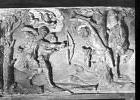
What is the greatest impediment to a career in mind-straining Science and Technology? Religion? Govt.? Business? Wrong, starts with S ends with X, er, starts with L ends with E. About -300 an Iberian stone relief is made in Osuna, Seville, Spain, showing a kissing man-woman pair in profile, they probably didn't even have a library or laboratory.
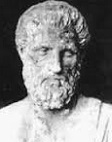
In -294 Greek physician Erasistratus of Ceos (-304 to -250) diagnoses Seleucis I Nicator's eldest son Antiochus I Soter as lovesickness, and when asked who it is, he claims it's his own wife, causing Seleucus I to pontificate that he should give her up, whereupon he reveals that it's really his own hot new queen Stratonice, causing Seleucus I to give her up; Erasistratus goes on to co-found the Medical School of Alexandria with Herophilus of Chalcedon (-335 to -280); after doing the first dissections (vivisections)? Erasistratus studies the brain, distinguishing between the cerebrum and cerebellum; Herophilus studies the nervous system, distinguishing between sensory and motor nerves.

In -260 Syracuse, Sicily-born Greek scientist-engineer-mathematician Archimedes (-287 to -212) discovers the law of buoyancy in his bath, shouting "Eureka!", going on to develop the principles of the lever, compound pulley, and other simple machines before being appointed to defend Syracuse from the Romans, creating defensive engineering marvels incl. giant ship-snatching levers, the catapult (600 ft. range, which can be varied as the ships close in), and a mirror device that sets Roman ships ablaze (Greek Fire), all of which make the Romans think of him as a sorcerer. Too bad, in -212 Syracuse is finally captured and sacked by the Romans under Gen. Marcus Claudius Marcellus, and turned into their govt. seat in Sicily; Archimedes is killed in Syracuse by a Roman soldier as he is drawing circles in the sand at the beach and telling him "Don't disturb my circles" (Noli tangere circulos meos). "Dos moi pou sto, kai kino ten gen" (Give me a place to stand, and I will move the Earth).
About -220 Greek writer Philo of Byzantium (b. -280) dies, leaving Pneumatics, which incl. the first description of a water mill and the problem of doubling the cube.

About -200 Egyptian-born Greek big brain Eratosthenes of Cyrene (-276 to -194) (head librarian of the Library of Alexandria) determines the circumference of the Earth by measuring noon Sun angles in wells at Syene (Aswan) and Alexandria, coming within 50 mi. of the correct value (approx. 25K mi.), suggesting that the Sun moves around the Earth; he also measures the obliquity of the ecliptic with an error of 7 min. of arc, and maps the course of the Nile River; the southernmost point of Africa is considered the Horn of Africa, taking the Greeks and Romans until the 1st cent. C.E. to discover SE Africa; it takes until 1670 C.E. for Christian Europe to catch back up?
In -193 the Porticus Aemilia, a warehouse in Rome's new dockyards is built S of the Aventine Hill, becoming the first use of Concrete, based on pozzolana, volcanic stone mortar from the new Roman colony of Pozzuoli in the Bay of Naples (two parts pozzolana to one part lime); the addition of seawater makes it stronger over time?

In -150 to -100 the Antikythera Mechanism, discovered in 1901 C.E. is the world's first computer, computing lunar-solar motions with gears, based on the off-center circle Hipparchos Model of the Moon's elliptical orbit around the Sun; the first astrolabe?; a Roman ship carrying it sinks off Antikythera Island in S Greece about -65, and is recovered in 1900 C.E.; the eclipse prediction is based on Babylonian rather than Greek math, and the astronomical calculations begin in -205; no instruments of comparable complexity are made for 1K years until Baghdad in 900 C.E. after the Romans and Greeks fail to pass on their technology, and the Muslim device is much simpler; designed by Hipparchos of Rhodes?
Too bad for Science, in -146 the Romans conquered Greece and turned the Greeks into slaves. After that Greek scientists, philosophers, and other brain men were so cute that every Roman ought to own one. The list of Roman mathematicians and scientists is so short it fell out of my pocket, sorry, they all remembered the lesson of Archimedes and wanted to be on the swordsman's side, preferring to conquer weak nations and steal their technology along with all the treasure they can find and create a monopoly, a strategy later adopted by 20th Cent. Software Emperor, er, Entrepreneur Bill Gates.

About -140 Greek #1 astronomer Hipparchus of Nicaea (-190 to -120) discovers trigonometry along with the precession of the equinoxes by observing the bright star Spica in Virgo.
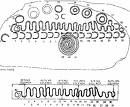
About -100 the Coligny Calendar, a 60 in. x 42 in. bronze plaque is made by the Celts in Gaul, displaying a lunar calendar where months begin with the full moon, off about 1.5 days every 30 years, compared to 0.25 days every 30 years for the Julian Calendar; days start at sunset, and each 15 nights is a Celtic week, either the bright week or the dark week; the new year starts on Nov. 1, when the Celts celebrate Samhain (Samain) (pr. SOW-un) (summer's end). Obviously, the Roman claim that the Celts were backward barbarians who deserved to be exterminated in the name of progress was a govt. coverup for the winner's side.

In -100 future Roman dictator Gaius Julius (Gr. "child of Jove") Caesar (Lat. "hairy") (-100 to -44) is born via the world's first Caesarian Section. In 1500 C.E. the first Caesarian Section since Julius Caesar is carried out by pig gelder Jakob Nufer in Switzerland.

In -55 Roman poet-philosopher Titus (Lat. "defender") Lucretius Carus (Lat. "beloved") (-99 to -55) dies, leaving the epic philosophical poem De Rerum Natura (On the Nature of Things), expounding his Epicurean doctrine of the Universe in poetic form to Roman readers, based on atomism and guided by fortuna (chance); the first description of persistence of vision, which later makes motion pictures possible; in 1417 C.E. the long-lost full text is rediscovered in St. Gall Monastery by Italian humanist Giovanni Francesco Poggio Bracciolini (1380-1459).
On Jan. 1, -46 after Julius Caesar's babe Cleopatra VII hooks him up with the scientists of Egypt, the solar-based Julian Calendar goes into effect, changing from a lunar to a solar year, with the start of the year from the traditional vernal equinox in late Mar., and making the year 445 days (15 mo.) long this year by imperial decree to bring it back in step with the seasons, making this the "Roman Year of Confusion"; it was designed by Egyptian astronomer Sosigenes of Alexandria, using the ancient Egyptian system of a 365-1/4 day year, and introduces a leap (bissextile) year every 4 years, with a bissextile day added in Feb. (originally Feb. 24, the sixth day before the calends of March, reckoned twice, later changed to Feb. 29); it is quite accurate, slipping by only 3 days every 400 years, plus another 1 day every 3,323 years (11 min. 14 sec. per year), and isn't officially adjusted for 1,627 years (Oct. 15, 1582 C.E.), by which time it has slipped by 12.692 days - and everybody calls himself Christian?

In -40 Formiae-born Roman architect-engineer Marcus Vitruvius Pollio (-80 to 16) (who dies during the reign of Augustus) writes De Architectura Libri Decem (Ten Books on Architecture), the first modern engineering handbook, an encyclopedia of Augustan architecture from engineering and sanitation to acoustic vases, discussing the Vitruvian Water Wheel, the first record of a vertical undershot (water below) waterwheel, featuring 5:1 gearing for better grinding, and mentioning gold amalgam (gold dissolved in mercury); used by Leonardo da Vinci to make his Vitruvian Man (1487 C.E.).
So divideth the B.C.E., the Don't-Say-B.C.-Before-Christ Butt Crack of Eternity (Before Common Era) from the C.E., the Don't-Say-A.D.-Anno-Domini-Year-of-the-Lord-Christ Scratch-and-Dent-Sale Common Era?
In the 1st cent. C.E. only nine chemical elements are known, vs. 12 in 1500, 84 in 1900, and 100 in 1953 (year of TLW's birth) - maybe it's a govt. coverup?



Speaking of one thing they couldn't cover up. In the murky years of the 1st cent. C.E. a gigantic blow was dealt to Science and Technology with the advent of a new religion called Christinsanity, er, Christianity, whose Aramaic-speaking Jewish founder Jesus Christ of Nazareth (-4 to 33) left no writings, works of art, statues, buildings, swords, armor, bling, portraits, descendants, or even newspaper accounts, worse, no body, because he was allegedly resurrected from the dead by God on Easter, visiting his believers for 40 days before being translated to Heaven, and now sits at God's right hand waiting to return and judge the world and everybody who ever lived, leaving it to his 12 Disciples to spread the word that he wasn't just a man but the Son of God, whatever that means, most followers apparently taking him for God himself, despite the intractable philosophical difficulties that rocked the Church for centuries. To become a Christian ("little Christ") and live with Christ forever in his Kingdom of Heaven, believers must take everything about him on faith, which is good since they don't have to learn Aramaic or any history other than that in the Greek New Testament, consisting of the Four Gospels (Matthew, Mark, Luke, and John) and the Acts of the Apostles, and no theology other than that in the Epistles of Paul, Epistles of Peter, Epistle of James, Epistle of Jude, and Epistles of John, or any eschatology other than that in the Book of Revelation. No, there's no final exam, because all new believers must do is undergo Baptism, which causes them to be "born again" as a symbol of future resurrection like Christ's. Sorry, but learning math, science, or technology doesn't matter to the fate of a Christian's soul, so no wonder the Christian world completely junked those subjects, especially as all useful works were written by pagans, who they thought were pawns of the Devil, and even more so because they thought that Christ would return any day and end the world itself. It took over a thousand years for Christians to get tired enough of waiting for Deadbeat Dad to begin to think about going back to the study of Nature as a way to help themselves, and those who did had the moral low ground, especially when they confused science with astrology and magic, and had to get translations of ancient Greek mss. from the infidel Muslims and heretic Byzantines.
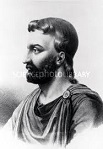
About 50 C.E. Roman brain man Aulus Cornelius Celsus (-25 to 50) dies, leaving De Medicina (8 vols.), which becomes the #1 medical text of the ancient Romans, with info. about diet, drugs, surgery, describes the "dilated tortuous veins" surrounding a breast cancer, causing Galen to later give cancer (Lat. crab) its name, describing four clinical stages of evolution of breast cancer, starting with cacoethes (benign lesion), recommending teatment first by caustics followed by surgical excision and cauterization for this stage only, warning against doing it for the other three stages because it might "irritate" the process and kill the patient; he also advises against removal of the pectoral muscles along with the breast; Bk. 3 addresses mental diseases - his image bears a striking resemblance to Jesus, er, naw?


In 70 C.E. Greek mathematician-engineer Heron (Hero) of Alexandria (b. 10) dies, leaving Mechanics and Optics, describing the principle of the shortest path of light, the Babylonian method for computing square roots, and Heron's Formula for finding the area of a triangle from its sides, also the design of the first vending machine, which delivers holy water for a coin; Pneumatics, describing Heron's Steam Engine (Aeolipile), with two jets that makes it rotate on its axis, a wind wheel that operates an organ (the first wind-powered machine?), a water pump for fire engines, and the syringe - put that all together and see what kind of party you can throw?


Help stop gingivitis before it starts? On Aug. 25, 79 C.E. Roman historian Pliny the Elder (b. 23) dies in Stabiae, Campania while attemping the rescue by ship of a friend and his family from the Mt. Vesuvius eruption after the wind won't allow his ship to leave the shore (vulcanized?), leaving Natural History (Historia Naturalis) (Historia Naturalis) (37 vols.), which contains all the known science of the day, incl. astronomy (attacking magic), geography, anthropology, zoology, botany, agriculture, pharmacology, metallurgy and mineralogy incl. Roman gold and copper mining, and a history of Greek and Roman painting and sculpture, also info. on the art of soapmaking, learned from the Gallic Celts, who make a mixture of tallow and wood ashes which they call saipo, and use to wash their long wild hair; mentions Escargo as an elite food; devotes a chapter to people of great longevity, incl. consul M. Valerius Corvinos, who lived to 100, Cicero's wife Terentia, who lived to 103, a woman named Clodia, who lived to 115 and had 15 children, and actress Lucceia, who performed on stage at age 100, with the soundbyte: "Nature has, in reality, bestowed no greater blessing on man than the shortness of life. The senses become dull, the limbs torpid, the sight, the hearing, the legs, the teeth, and the organs of digestion, all of them die before us"; in 1469 it becomes the first scientific book to be printed in the West with the Gutenberg printing press: "In vino veritas" (In wine there is truth); "True glory consists in doing what deserves to be written and in writing what deserves to be read"; "Among these things but one thing seems certain: that nothing certain exists, and that nothing is more pitiable or more presumptuous than man."

In 90 C.E. Greek physician (with the Roman army) Pedanius Dioscorides (40-90) dies, leaving De Materia Medica (5 vols.), containing 600+ animal, vegetable, and mineral remedies, and describing 500 plants, preserving their Dacian and Thracian names; the book is used until the 17th cent. C.E.
In the 2nd cent. C.E. the Mayans build the city of Lakamha ("big water") in modern-day Palenque, Chiapas, Mexico, with 1.5K bldgs. and a pop. of 6K, incl. an intricate water mgt. system; they discover vulcanization of rubber and produce bouncy rubber balls, rubber sandals, etc.?
About 100 C.E. the Chinese begin using crushed chrysanthemum flowers (active ingredient pyrethrum) to kill insects, becoming the first Insecticide.

In 105 Chinese eunuch Cai Lun (T'sai-lun) (50-121) invents felted sheeted fiber paper made of tree bark, hemp, cloth rags, and fishing nets, replacing bamboo and silk tablets - this gives the Jesus Christ scam away, since if he really was the Son of God, and needed his message spread fast, he would have invented papermaking, printing presses, and maybe copyright and trademark protection for his new world-domination church instead of relying on godless heathens to do it for him, and blind luck to transmit the knowledge to his believers?

In 120 C.E. Chinese astronomer Zhang (Chang) Heng (78-139) pub. Ling Xian, which describes solar and lunar eclipses, and supports the theory that the Moon reflects sunlight; "The Sun is like fire and the Moon like water: the fire gives out light and the water reflects it." In 132 C.E. he invents the first Seismograph, a bronze urn with dragon mouths that drop a ball in the direction of the earthquake into the mouth of a bronze frog.


In 132 C.E. Roman emperor (since 117) Hadrian (75-138) begins the Temple of Jupiter Capitolinus in Jerusalem on the site of the ruined Jewish Holy Temple, center of everything that is Jewish, with a dangly statue of a naked man-god and everything that Jehovah is against, sparking the Bar Kokhba (Kochba) Uprising of Simon (Shimon) Bar Kokhba (Kochba) (Heb. "Son of a Star") (real name Bar/Ben Kosiba or Kozebah) against Rome in Judea (ends 135), whose guerrilla fighters surprise the Roman legions, take over Judea, set up an independent nation, and try to rebuild the Temple of Jerusalem; the old fortress of Herodium near Bethlehem is briefly reoccupied; Bar Kokhba overstamps Roman coins to make Jewish ones; pissed-off Hadrian decides to make an example of the pesky Jews and sends 12 divs. from as far away as Britain to totally wipe them out of Judea, along with his best generals; meanwhile Bar Kochba's rebels are only a minority of the Jewish pop., who seem to have been getting along with the Romans and just wanted to make money and live the good life?
In 135 C.E. the Romans under troubleshooter gen. Sextus Julius Severus (gov. of Britain in 131-3) put down the pesky Bar Kokhba Revolt (begun 132); the Jews' butts are kicked bigtime, and 600K are killed, 900 villages are destroyed, and Jerusalem is plowed with oxen; Hadrian issues an edict ordering the Jews expelled from Israel (only permitted to enter Jerusalem once a year), completing the Jewish Diaspora (Heb. "Tefutzah" = scattered), the dispersion of the pesky oddball square-peg-in-a-round-hole Jews throughout the Roman Empire; Judea is renamed Syria-Palestina (coined by Herodotus), and the way is now clear for the spreading of the name Jah-Zeus (Jehovah-Zeus) (Jesus) by the empire-wide Catholic (universal, as in get all the pagans to join the Church no matter how much the original faith has to be diluted) conspiracy, when his real name was Yeshua, and being too Jewish it's now un-PC; Rabbi Akiva ben Joseph (50-135) is executed by the Romans after teaching the Torah in public after the revolt, leaving Sepher Yetsirah (Sefer Yezira) (Book of Creation), which goes with the Sepher Hazzohar (Book of Brightness) (Dan. 12:3) of his contemporary Simeon bar Jochai (Yochai), and teaches the mystical pantheistic Qabala (Qabbala) (Kabbala) (Kabbalah) (Cabala) (Cabbala) (Heb. "to receive, welcome"), in which there is no Creation, and Nature is due to the self-development of Adam Kadmon (first or ideal man), who is the absolute being God, who created the Universe via the 10 Sefiroth (numbers or principles), incl. the Spirit of God, the emanations of air, water, and fire, three spatial dimensions to the left, and three to the right; the 22 letters of the Hebrew alphabet determine the forms through which Creation can be understood by the human mind; its mystical numerology intrigues and undermines mystics, philosophers, and scientists until ? - man does not live by bread alone but by every word of whom?

In 159 C.E. Greek #1 physician Galen (Claudius Galenus) (Gk. "healer") (131-201) is appointed to the gymnasium attached to the Temple of Asclepius in Pergamum, Mysia (modern-day Bergama, Turkey), where he does animal (not human) dissections and goes on to establish that arteries carry blood and not air, and that blood is created in the liver, first using the pulse as a diagnostic tool; he elaborates on Hippocrates' vital humor theory that the body contains four vital fluids or humors (blood, yellow bile, black bile, phlegm), and that disease is due to an imbalance, pioneering the use of ligatures and becoming known as "the king of the catgut suture", viewing pus as beneficial; he views cancer as a result of melancholia caused by an excess of black bile, proven by its frequent occurrence in postmenopausal females, recommending surgical excision of a cancerous breast through healthy tissue to make sure that not "a single root" is left behind, discouraging ligatures and cautery to allow drainage of black bile; he leaves a physiological model of the human body that becomes the std. for anatomy for cents.; he leaves 500+ works (10M words) written down by 20 scribes, representing half of all lit. from ancient Greece to survive to modern times; too bad, little is translated into Latin, so that only the Byzantines read it until the Muslim Abbasids (750-) tr. some of it into Arabic, and only after the fall of Constantinople to the Muslims in 1453 do Greek scholars head W with his mss., incl. Ars Medica, which tries to preserve the Greek attribution of mental properties to bodily functions; On the Passions and Errors of the Soul; De Motu Musculorum (2 vols.), which explains the difference between motor and sensory nerves, mentions muscle tone, and differentiates agonists from antagonists; That the Best Physician is Also a Philosopher, and On the Natural Faculties (De Naturalibus Facultatibus) (3 vols.), which is pub. in London in 1523 - and Vicodin is cool to pop? About 200 he discovers Cold Cream, containing olive oil, beeswax, rose petals, and water.

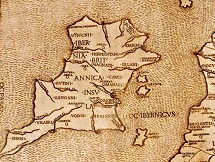
In 168 Egyptian-born Greek mathematician-astronomer Claudius Ptolemy (90-168) dies in Alexandria, Egypt, leaving Almagest (Arab. "Great Compilation) (original title "Astronomical System"), a 13-vol. system of mathematical astronomy placing the Earth at the center of a static Universe, which is accepted by both the Christian and Muslim worlds until the Christian Renaissance; he also leaves Geography (Geographical Guidance), which incl. a map of the known world with coordinates given, incl. the oldest known map of Ireland, and The Tetrabiblos (Apotelesmatika), a comprehensive work on astrology that becomes a std. work for 1K years, arguing that it is a natural and beneficial study.
A gynecologist with a sore anus took a hypocritical oath? In the 2nd cent. C.E. Greek physician Soranus of Ephesus dies, leaving "On Acute and Chronic Diseases" (describing the Guinea Worm), "Treatise on Gynecology" (4 vols.), "De Anima" (4 vols.) (which divides the soul into seven parts and denies its immortality), "Two Treatises on Pharmacy", and The Life of Hippocrates [fl. 400 B.C.E.], the earliest surviving bio. and source of most info. on him.
About 200 the Roman army invents the Roman Army Knife, made of silver with iron blades, featuring spoon, fork, spike, spatula, and toothpick.
About the 3rd cent. C.E. Jewish physician Asaf ha Jehudi (Asaph the Jew) leaves a ms. (oldest known medical work in Hebrew) teaching that the blood circulates through the arteries and veins, which is lost until modern times - he was afraid they'd think he had hairy palms?
In 224-383 C.E. the Bakhshali Manuscript, written on birch bark near the village of Bakhshali, India (modern-day Madan, Pakistan) contains the first known use of the zero symbol, a black dot; discovered in 1881.
In 230 the Wheelbarrow with Sails is invented in China.

In 275 the Roman Empire was partitioned into East and West for convenience, and in 313 Roman emperor (306-337) Constantine (Gr. "steadfast") I (the Great) (Flavius Valerius Aurelius Constantius) (271-337) made it officially Christian, founding Constantinople in 330. Too bad, the split hardened permanently, fed by the Greek vs. Latin thang, obviously the Greek-speaking Byzantines were smarter than the Latin dumbasses, despite their pope claiming to be the #1 bishop of Christendom, don't talk to me anymore, and for the rest of the 4th cent. C.E. the Roman Empire tore itself apart with a 3-way civil war between pagans on the one hand, and the two main Christian divisions of Athanasians and Arians on the other: winner: Athanasians. Too bad, the German pagan barbarian Goths threatening the entire empire were converted to Arian, giving religious war a new dimension.
In 284 Greek mathematician ("Father of Algebra") Diophantus of Alexandria (200-84) dies, leaving Arithmetica, founding the study of Diophantine equations.
About 350 Pappus of Alexandria (290-350) dies, leaving his Mathematical Collection, describing the cogwheel, lever, pulley, screw, and wedge, summarizing mathematical knowledge, and proposing geometrical theorems incl. Pappus' Hexagon Theorem in projective geometry, becoming the last important Greek scientist.
In the 4th cent. (3rd?) (5th?) C.E. Chinese mathematician Sun Tzu (Sun Zi) flourishes, leaving Sun Tzu Suan Ching (Sun Tzu's Calculation Classic), containing the how-many-eggs-in-my-basket Chinese Remainder Theorem. Early in the 4th cent. C.E. the Chinese invent the Stirrup.
In 386 Chinese astronomers witness a supernova.
In the 5th cent. C.E. steel is made in China from wrought iron and cast iron; also the Umbrella is invented, and the Chinese print full pages of characters using a single woodblock; they also invent true ink made from lampblack. Also the word "chemistry" is coined by Alexandrian scholars - it's definitely time for the Science-fearing Christians to burn their library?
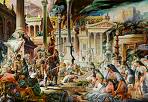


In 410 after deposed emperor Honorius regains power, Visigoth king Alaric I and his 40K-man army march down Italy yet one more time, depose and imprison puppet Attalus, then after a short siege marked by on-again-off-again negotiations enter through the Salarian Gate and sack Rome (say again?) on Aug. 24-27, leaving churches alone since they're still Christians, if heretic Arians, then after the emperor refuses to negotiate they head S towards Italy's granary in N Africa, and Alaric I dies on the way to Sicily after losing his fleet and being turned back, and is buried in the bed of the Busento River; his brother-in-law Ataulf (Athaulf) (Ataulphus) (-415) succeeds him, vowing to destroy the very name of Rome (home of the heretic Nicean Council crowd of bishops?), causing head bishop Pope Innocent I to leave the city until 412; the woes of the prostrate city cause St. Augustine of Hippo (354-430) in North Africa to produce his 22-vol. escapist work (about a holy Augustus ruling an invincible holy city of Rome?) The City of God, as the real City of God is no longer able to protect what's left of the Catholic Western Roman Empire from the heavy G.I. Joe and hairy Barbie-doll barbed Arians (barbarians)?; he at first claims "Behold, from Adam all the years have passed, and behold the 6,000 years are completed", but as the world shows no signs of ending he teaches that the Church should ditch the Book of Revelation because the Kingdom of God has actually arrived with its new political power, and imagines the Church as a worldwide empire acting as the instrument of the Holy Spirit to gradually transform the world, but preaches that the heavenly New Jerusalem should be the goal rather than the earthly one; he pushes the doctrine of "Totus Ubique" (the whole of God everywhere), invents the notion of the inner self, explores the inner relationship between the soul and God along with the idea of divine grace, and all with the cool language of a Roman-trained rhetorician, dissing the holier-than-thou Donatists by claiming that saints and sinners should all be part of the Catholic Church, and will be separated at the End of Time, with the mystical secret brotherhood of saints forming the City of God, and the sinners forming the Twin City of Hell; "That which man builds man destroys, but the city of God is built by God and cannot be destroyed by man", its role being "to inspire men and women to organize their communities in the image and likeness of the heavenly city"; the operational message is that Christians should get out and convert violent barbarians, with education relegated to survey courses on classical lit. (science and technology - fuggedaboutit), giving the Roman Catholic Church its Mission: Impossible for the next six cents.; too bad, his work is later used to justify persecution of heretics and Jews because membership in the Church is mandatory. In short, Da Dark Ages.
About 410-29 Roman pagan (Christian?) writer Martianus Minneus Felix Capella of Carthage writes The Marriage of Mercury and Philosophy (The Marriage of Philology and Mercury), a potpourri of allegorical classical wisdom, and the Encyclopedia of the Seven Arts, defining the trivium (grammar, logic, rhetoric) and quadrivium (arithmetic, geometry, music, astronomy) categories of education, which lead to serious study of philosophy and theology, and ends up ruling Western education all the way to the Renaissance; he leaves medicine and law out of the trivium since they are "earthly", i.e., applied not pure sciences.




In Mar. 415 after Alexandrian bishop (since 412) (St.) Cyril of Alexandria (376-444) expels the Jews from Alexandria, Greek mathematician-astronomer-philosopher Hypatia of Alexandria (b. 370), the Neoplatonist librarian of Alexandria, who supports Orestes, pagan prefect of Alexandria for opposing persecution of pagans and Jews is jumped in her chariot, stripped naked, and dragged through the streets to the newly-depaganized Caesareum Church, and murdered by a mob of Coptic Christian monks (from Nitria?) led by Peter (working for Archbishop Cyril under the influence of Pulcheria), ending the Hellenistic Age; her skin is scraped off with sharpened oyster shells and she is set on fire while still alive?; the first burning by Christians of a witch?; meanwhile St. Augustine writes "The true image of the Hebrew is Judas Iscariot, who sells the Lord for silver. The Jew can never understand the Scriptures and forever will bear the guilt for the death of Jesus."
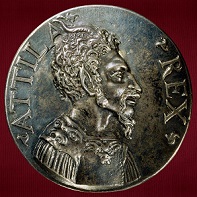
In 451-2 after the Romans and Visigoths temporarily united to make a stand, the hordes of horseback pagan Huns led by 3'5" Attila (Gothic for "little father"?) the Hun (the Mundzuk) (406-53) were thrown out after gutting what was left of the tottering Western Roman Empire, and it could be stuck with a fork, only lasting another 25 years as the Italian Peninsula was so depopulated that they began relying on Visigoth soldiers, who finally took over without firing an arrow.

In Aug. 476 Flavius Odoacer (Odovacer) (435-93), Herulian Visigoth chief gen. of the Germanic tribes in the Roman army leads a revolt over a baksheesh matter (free homes in Italy), captures Ravenna, and kills Orestes in Pavia; on Sept. 4 (Sept. 7 Gregorian) (Mon.) Romulus Augustus (461-77?) (AKA Augustulus), the boy emperor of Rome in Ravenna becomes the Last Roman Emperor of the West as he is deposed and exiled to the castle of Lucullus in Campania in S Italy (with 6K pieces of gold per annum allowance) by Odoacer, who proclaims himself Roman emperor of the West, petitioning Emperor Zeno to recognize him as a patrician and ruler of Italy on behalf of the Eastern Empire; Zeno accepts on the last part, but insists that exiled Julian Nepos (d. 480) remain Roman emperor, which he does, on coins; Odoacer uses the old Roman law of hospitality providing for the quartering of Roman soldiers to force Roman landowners to surrender a third of their estates for use by his soldiers; many non-aristocratic Romans welcome the new boss because he will abolish the taxation and police system, while aristocratic Romans in Gaul circle the wagons and create private armies; 753 + 476 - 1 = 1228?; the Dark Ages begin as 1.2K years of progress of civilization becomes kaput in Europe thanks to barbarians and Christian hostility to paganism, which to them incl. all pagan scientific, literary, historical, and cultural works, making all scientists forever suspect of being in league with the Devil by the Christian masses, an impediment that ends in ?, and the very idea of wanting to live for "the world" when the Kingdom of Heaven is dangled in front of your eyes to seem pointless?; "So it was in utter social decay and collapse that the great slave-holding 'world-ascendency' of the god-Caesars and the rich men of Rome came to an end" (H.G. Wells, Ch. 37) - so who is the last emperor, Romulus Augustus or Nepos?
After the Western Roman Empire falls, the new Visigoth masters of Italy, Gaul, Spain, and North Africa aren't into Science much, and as they were themselves squeezed by more German barbarians and Byzantine armies, Europe descends into the Dark Ages, where literacy is almost kaput, and money disappears, requiring barter; the onset of the Muslim Great Jihad in the 600s closes the last doors; literacy survives mainly in outlying monasteries in Ireland that only copy religious lit.

In 499 C.E. Hindu superbrain Aryabhata (476-550) writes the Sanskrit verse Aryabhatiya, divided into 4 parts: "Celestial Harmonies", "Elements of Calculation", "On Time and its Measures", and "Spheres"; Aryabhata advances the theory that the Earth rotates on its axis, gives the correct explanation for eclipses of the Sun and Moon, the value of pi as 3.1416, and solves the quadratic equation with the first known use of algebra; "The Moon consists of water, the Sun of fire, the Earth of earth, and the Earth's shadow of darkness. The Moon obscures the Sun and the great shadow of the Earth obscures the Moon"; too bad there's nobody left in the Ever-Saved West who cares enough to say goodbye or hello?; in 629 Hindu mathematician Bhaskara I (600-80) writes a verse commentary, first using the decimal number system and making it known to Indian scholars.
In the 6th cent. C.E. algebra and the decimal system are developed in India and Mesopotamia. Also the Heavy Plow comes into use in Slavic lands. Also the Breast Strap for horses comes into use in Germany. Also Arab physicians regularly prescribe cannabis for all sorts of maladies.
In 522 Greek Nestorian monk Cosmas Indicopleustes ("he who sailed to India") begins traveling this year from one end of the habitable world to the other, and ends up in Alexandria in 535, writing the narrative Christian Topography (535-47), claiming that he has personally proved that the Earth is not a globe, but has one oblong temperate zone of 400 days journey in length and 200 days in breadth, encompassed by the ocean and covered by the solid crystal firmament; his work becomes the state of the art of Dark Ages geography, holding back exploration for a millennium?
About 550 the Water Mill is invented in Greece.
These boots are made for walking? In 552 the Byzantines gain the secrets of Sericulture (silk production) via the smuggling of silkworm eggs from China by Persian monks (from Nanking?) in a hollow cane after going to Constantinople first to get some encouragement and baksheesh from Emperor Justinian I.
In 577 Northern (Bei) Zhou Dynasty women in China invent Matches, pyrotechnic chemical-tipped wood sticks ignited by friction.
In 589 the first written record of Toilet Paper in China by Buddhist scholar Yan Zhitui (531-91); "Paper on which there are quotations or commentaries from Five Classics or the names of sages, I dare not use for toilet purposes"; in 851 an Arab Muslim traveler disses them for using paper instead of water after going to the bathroom - not that kind of record, a written record?








In 632 Arab madass warlord prophet Muhammad (570-632) died after creating a new monotheistic religion crossing Judaism, Christianity, and uniquely Arab Allah (Moon god?) worship and ethnically cleansing the Arabian Peninsula, after which his followers launched a takeover attempt of the whole world, starting with Persia, Syria, Egypt, and the Holy Land, which they conquered by 642. The Muslim conquest of Europe sputtered in 732 when they were thrown out of France by Christian hero Charles Martel the Hammer (686-741), grandfather of Charlemagne (742-814). The Great Jihad is still theoretically on today since Allah's commands are set in stone, it's just that the great majority of modern Muslims are pikers who are satisfied with holding past gains. Too bad, Muhammad's infallible Quran combined with his personal example gave divine authority to the most retro social-moral system of the Middle Ages, incl. polygamy, slavery, male supremacy, and subjection of believers in other religions, maybe he was right and a man's testimony is worth that of two women, like it takes two women co-stars to substitute for a male star, like Geena Davis and Susan Surandon in "Thelma and Louise", I now pronounce you husband and wives, Brad Pitt may kiss the brides. In conquering the Zoroastrian Persians, Alexandrian Egyptians, and Byzantine cities, the Muslims captured a number of ancient Greek mss. on Science and Technology, and translated them into Arabic, launching Muslim Science, check out the one-sided Islam history ignoramus Ben Kingsley vids and get back with me about the whopping total of two Muslim Nobel Prize winners for Science out of a pop. 1.x billion, compared to only two Jews, one cripple, and one black. Actually, a total of three Nobels for intellectual (non-political) categories, one for every 450M Muslims alive today, compared to 169 for Jews, one for every 89K, that's a ratio of 5K. Christians fall in the middle. What happened? For Christians, it was the rise of the Roman Catholic Church and its suppression of all free thought that caused it to hold back the rise of Science and stink itself up because all works of ancient pagans, incl. Greek and Roman scientists were considered works of the Devil and banned, like throwing the baby out with the bathwater. Ironically, the Church even suppressed other Christians, particularly those who wanted the Bible alone to be their authority, not Church synods (they later split off permanently as the Protestants starting in 1517). The Muslims, on the other hand, went on for centuries without Science like them, but finally created an elite cadre in Spain (Al-Andalus) and another in Mesopotamia at the House of Wisdom in Baghdad (830) funded by the caliphs, who translated and studied the captured wisdom of da ancient infidels, the land that time forgot, enjoy the scenery just don't upset the natives, and actually advanced Science a bit, about to the modern pre-calculus high school level, no, the 5th grader level, starting with Abu Yusuf Ya'qub ibn Ishaq al-Kindi (801-73) (AKA Alkindus) in Baghdad, who supervised the translation project and introduced Indian numerals to the Islamic world, which made their way to the Christian world and were called Arabic numerals. He stole them from Hindu mathematician Bhaskara I (600-80), who in 629 wrote a verse commentary to the "Aryabhatiya" (499), first using the decimal number system and making it known to Indian scholars. The 499 work was written by Hindu superbrain Aryabhata (476-550), who advanced the theory that the Earth rotates on its axis, gave the correct explanation for eclipses of the Sun and Moon, the value of pi as 3.1416, and solved the quadratic equation with the first known use of algebra, with the soundbyte "The Moon consists of water, the Sun of fire, the Earth of earth, and the Earth's shadow of darkness. The Moon obscures the Sun and the great shadow of the Earth obscures the Moon." Now that the scholars had their Kindles, they ramped things up between their quintuple daily prayer breaks, with Muhammad al-Khwarizmi (780-850) developing algebra (Arabic for restoration), Abu Bakr Muhammad al-Razi (865-925) ("the Islamic Hippocrates") et al. developing medicine and alchemy (Arabic for art of transformation) (the start of chemistry), Alhazen (Abu Ali al-Hasan ibn al-Hasan ibn al-Haytham) (965-1038) of Egypt (who tried to lay low from the caliphs by feigning madness) founding modern optics, and Avicenna (Ibn Sina) (980-1037) of Persia becoming their best all-around raghead brain man. Too bad, it's pretty hard to engage in a laborious lab research project when you have to stop and pray 1-2-3-4-5 times a day to the non-existent Blaalah while Islamic police hold scimitars over your necks, and since religious dictators control society, any and every advance you make is immediately subjected to scrupulous examination for potential heresy, which they call Bid'ah ("innovation"), plus why aren't you out there with everybody else, Abdul, killing infidels for Allah, what are you, a draft evader? Actually, the general Muslim pop. always hated and feared Muslim scientists, as they do now, and they could only do it under the protection of a powerful ruler. As De Lacy O'Leary (1872-1957) put it: "Islam generally had its own wise men, men learned in jurisprudence, tradition, and Qur'an. These were universally respected with ungrudging esteem, such as was never rendered to the scientists who were only tolerated because they were under state protection. It very much tempers our estimate of Arabic learning to remember that scientific and philosophical scholarship was confined to one privileged coterie." Until the West began taking over in the Renaissance, both the Islamic and Christian worlds accepted Ptolemy's 2nd cent. C.E. Almagest ("Great Compilation") that claimed that the Earth is the center of the Universe and everything else revolves around it, let's make a muscle, make a difference, and flex for MDA, they were neck-in-neck in astronomical stupidity while claiming to have pipelines to God. Speaking of Islam killing not incubating Science, around 1100 Persian Sunni Sufi mystic theologian Abu Hamid Muhammad al-Ghazali (1058-1111) started a reaction against ancient Greek and Roman learning, launching the theory of Occasionalism, to the effect that all cause and effect is determined not by scientific laws but by Allah and his angels, with the soundbyte "A clumsy and stupid person must be kept away from the seashore, not the proficient swimmer, and a child must be prevented from handling a snake, not the skilled snake-charmer", along with the soundbyte: "The gates of ijtihad (rational debate) in Islam are now closed", meaning that perfection had been reached in both social and spiritual philosophy, hence the conservatives rule and the rationalists are out, causing an Islamic theocracy to be built up which regarded the very concept of scientific laws as an affront to Allah and an infringement of his freedom to act, after which Islam became kaput as an engine of science, and only kept a few engineers around to build butt bombs. Hence, Islam had its chance to prove to the world that it was the leader in science and technology who would turn Earth into a paradise, and blew it bigtime, forever proving it to be the opposite, watch that pothole it might contain an IED, which to be fair puts it on a par with the horrible mean Roman Catholic Church, let's rack 'em up, it seems like the Devil takes over all big organizations after enough time, which is why the little guy has to know who's at the top, God or the Devil, and bypass the organization as necessary to get to the real dude. Not that it's all the Muslims' fault. The House of Wisdom was destroyed by the Mongols of Hulagu Khan in 1258, after which the waters of the Tigris River ran black for 6 mo. from all the ink from the ruined books. In the 1420s brain man and future Persian Mongol Timurid sultan (1447-9) Ulugh Beg (1393-1449) (grandson of Tamerlane) founded the Samarkand (Ulugh Beg) Observatory, which had instruments to measure precise star positions, becoming the last great Muslim observatory, compiling books of trigonometric tables of sine and tangent values accurate to 8 decimal places; despite science being all-but dead in the Muslim World, thanks to the headlock of the Church, Muslim science remained far ahead of Christendom until about 1600, and I think by now we know that no Bible-thumping religion can claim credit, only scientists who braved the Bible-thumpers, which became easier to do in Christendom because Jeezy never said kill infidels like Muhammad did. In summary, as Pakistani nuclear physicist Pervez Amirali Hoodbhoy (1950-) recently put it, for the last 700 years Islam and Science have "parted ways", and even today Muslims tend to go into engineering rather than science since it strains their belief system less.
In the 8th cent. Gunpowder is invented in Tang Dynasty China, with the formula 15-3-2 parts saltpeter-charcoal-sulfur; having the property of vigorously igniting when excposed to flame, it is dubbed the "elixir of immortality"?; it is first used for insect fumigants and skin disease treatments, then fireworks, after which it takes a cent. or two to use it in warfare? - the first manmade cis boom bah? In the 8th cent. the Still is invented in Europe. Also in the 8th cent. the Norse invent the Longship (Longboat), useful for cargo and war, christened with blood, with cool dragon heads; weighing half as much as a galley, they are powered by rowers and a square sail. Also in the 8th cent. Porcelain is invented in Tang Dynasty China. Also in the 8th cent. the primitive open hearth Catalan Forge for producing steel is invented in desperate shrinking Christian Spain in reaction to the pesky Muslim Moors, becoming the first important metallurgical advance in iron smelting since ancient times.
In 777 Muslim astronomer Ibrahim al-Fazari (b. ?) dies in Baghdad after inventing the Astrolabe (Gr. "astron" + "lab" = star + to take) for measuring the altitudes of celestial bodies, consisting of a sight hole, degree scale, calendar scale, and rotating alidade (diopter); it is not perfected until the 850s, and doesn't arrive in Europe until the 1050s.

In 782 Arab (al)chemist-physician ("Father of Arab Chemistry") Abu Musa Jabir (Geber) (Gebir) ibn Hayyan (721-815) begins to study chemistry as distinct from alchemy: calcination, oxidation, congelation, fixation, solution, digestion, distillation, evaporation, sublimation, separation, extraction, ceration, fermentation, putrefaction, propagation, projection. He dies after allegedly discovering methods for preparing sulfuric acid, nitric acid, aqua regia, and silver nitrate; by the 10th cent. 100+ anon. works are written using his name, after which Euro alchemists of the 12th and 13th cents. escape the Inquisition by doing ditto.
In 809 the first Public Hospital in the Muslim World is founded in Baghdad, and the institution spreads.
In 815 Jewish scholar Mashallah (b. ?) dies, leaving De Scientia Motus Orbis (later tr. from Arabic to Latin by Gerard of Cremona), and De Mercibus (On Prices), oldest known scientific work in the Arabic language.

In 820 Euclid's Elements becomes the first ancient mathematics trs. from Greek into Arabic by the House of Wisdom in Baghdad; meanwhile about this year Persian Muslim House of Wisdom mathematician Muhammad Ibn Musa al-Khwarizmi (780-850) pub. Al-kitab al-mukhtasar fi hisab al-gabr wa'l-muqabala (The Compendious Book on Calculation by Completion and Balancing), which is tr. into Latin in 1145 by Robert of Chester under the title Liber algebrae et almucabola, coining the terms "algebra" (Arab. "reuniting", "restoration"), "algorithm, and "x" for the uknown quantity, along with "sine" after mistranslating the Arabic word "jb" as bay or inlet, which becomes sinus in Latin.
In 828 the Astronomical System of 2nd cent. astronomer Ptolemy is trans. into Arabic under the title Almagest.
In 830 Caliph Ma'mun founds the Academy of Translations (House of Wisdom) in Baghdad; the main body of scholars are Christian Nestorians?
In 869 Arab Muslim adab (belles lettres) master Othman Amr al-Jahiz (776-869) dies, leaving The Book of Misers, The Book of Animals (proposing that life climbed "from mineral to plant, from plant to animal, from animal to man", and man might climb to angel and even God), and Elegance of Expression and Clarity of Exposition - the original Botox?
In 870 calibrated candles are used in England to measure time.
In 895 Arab Muslim scientist-historian Abu Hanifa al-Dinawari (815-95) dies, leaving Book of Plants (based on Discorides, with new plants added), and The Long Narratives (history of Persia).
In the 10th cent. the moldboard plow is invented in China.
In the 10th cent. Arab soldiers invent a niter-sulfur-copper flamethrower and a terra cotta-naphtha grenade.

About 900 C.E. Indian mathematician Sridhara (870-930) discovers the power of the zero (suro) ("seed") ("circle") (the Sun divinity incarnate?) - are you the fat one in the family?
In 912 Basra-born Arab Sunni Muslim theologian Abu al-Hasan al-Ashari (Ash'ari) breaks with Mutazalite teacher Abu 'Ali Muhammad al-Jubbai'i (-915) and the liberal Aristotelian Mutazilite School, and founds the fundamentalist Neoplatonist Ashari (Ash'ari) (Kalam) School of Islam, which rejects freewill and the rationality of God, and becomes dominant in Islam, later leading to terrorists like Osama bin Laden who claim that because God is pure will and power, and above reason, there is no barrier to mandatory violence. In 915 Saadia Gaon (Saadia ben Joseph al-Fayyumi) leaves Egypt for Babylonia, setting up a Jewish Mental Ashcan School that clones the arguments of Abu al-Hasan al-Ashari to smother Jewish philosophy and skepticism.
Stay busy, stay beautiful, no sweat? Since Jeezy didn't come back, maybe it's time to figure out how to sweat a living out of the ground more efficiently? About 920 the Horse Collar comes into use in Europe, permitting horses to replace oxen, increasing food production; the Horseshoe permits all-terrain and all-weather horse use.

In 925 Persian #1 Muslim physician ("the Islamic Hippocrates") Abu Bakr Muhammad Ibn Zakariya al-Razi (Rhazes) (854-925) dies after becoming the first to use mercurial ointment, animal gut for sutures, and plaster of Paris for casts, leaving 131 books, incl. the 20-vol. Kitab al-Hawi (Liber Continens), containing a pharmacopeia, listing 50 methods of contraception; Treatise on Smallpox and Measles, the first accurate study of infectious diseases, and first to diagnose the difference between smallpox and measles; Kitab al-Mansuri (Liber Almansoris) (9 vols.); vol. 9 "Nonus Almansoris" is popular in Europe until the 16th cent. He goes on to become one of the top two Muslim medical writers studied at the U. of Paris along with Avicenna.

In 929 Arab astronomer Muhammad al-Battani (b. 858) dies, leaving On Stellar Motion, which accurately calculates planetary movements, and gives the precession of the equinoxes as 54.5 sec. a year, and the inclination of the ecliptic as 23 deg. 55 min.
In 976 Persian Muslim brain man Muhammad ibn Ahmad al-Khwarizmi (al-Balkhi) pub. Keys of the Sciences (Mafatih al-Ulum), which recommends using a little circle in calculations "to keep the rows"; the Arabic word "sifr" (empty) is translated into cipher, also zephyrum, which the Italians shorten to zero.
In 976 the Codex Vigilanus (Albeldensis) illuminated ms. is completed in the Monastery of Abelda in Pamplona, becoming the earliest known Western ms. containing the Arabic numerals 1-9 (no zero), along with the canons of the Councils of Toledo and a copy of the Liber Judiciorum.

About 1000 Arab brain man Alhazen (Ibn Al-Haytham) (965-1039) invents the Camera Obscura (pinhole camera), and reverses Aristotle, correctly claiming that light comes from the object seen into the eye and not vice-versa. In 1011-21 he pub. Book of Optics (7 vols.), written in a dark cell under house arrest in Cairo; reverses Aristotle, who taught that light is physical, and Ptolemy, who taught that the eye emits light, with the experimental discovery that some objects are sources of primary light (which travels in straight lines) that are reflected by other objects; first accurate description of the camera obscura and pinhole camera; computes the height of the Earth's atmosphere as 49 mi. (real value 50 mi.)
In the 11th cent. the 3-Field System is adopted in Europe, becomingthe hat trick for a thousand years of progress out of the Dark Ages. In the 11th cent. Persians begin mixing chromium into their steel. In the 11th cent. gears become common in the Arab world, used with water wheels and water clocks.

In 1025 Muslim brain man Avicenna (Ibn Sina) (980-1037) of Persia writes Al-Qanun fi at-Tibb (The Canon of Medicine) (5 vols.), which synthesizes Greek and Arab medicine, basing medicine on experiment and reason, dominating backward Western medicine until the mid-17th cent. In June 1037 he dies, leaving Kitab al-Shifa (Kitab ash-Shifa bi ta'rif huquq al Mustafa) (Book of Healing by the Explanation of the Rights of the Chosen One) (AKA Sufficientia) (18 vols.), an attempt to describe all scientific and philosophic knowledge; also Kitab al-Najat (Book of Salvation), an abridged vers. of the preceding, giving the "flying man argument" for the distinction between the body and soul, which must be strong enough to ensure its individuality, but weak enough to allow for its immortality; he also founds physiological psychology for the treatment of illnesses involving emotions, developing a system for associating changes in pulse rate with inner feelings, and developing the Tabula Rasa concept beyond Aristotle.

In 1030 after leaving Ghazni in modern-day Afghanistan in 1017 to tour India, Persian Shiite Muslim brain man Abu Rayhan Muhammad ibn Ahmad al-Biruni (al-Beruni) (973-1051) writes his masterpiece History of India (Kitab Tarikh al-Hind), which waxes lyrical about the Bhagavad Gita, becoming known as "the Father of Indology"; after uttering the soundbyte: "India has produced no Socrates; no logical method has there expelled fantasy from science", for funners he translated Euclid and Ptolemy into Sanskrit. In 1051 he dies in Ghazni, modern-day Afghanistan, leaving Kitab al Athar al Baikya, Kitab Tarikh al-Hind (History of India), Kitab at-Tafhim (Elements of Astrology), Kitab al-Qanun al-Mas'udi (The Mas'udi Canon) (major work on astronomy), and Kitab as-Saydalah (treatise on medical drugs), which uses Archimedes' Principle to calculate specific gravity; claims that the Earth rotates on its axis as well as around the Sun, but that the data can be equally well explained by the reverse hypothesis; speculates that the Indus Valley was once at the bottom of the sea; explains the working of artesian wells by the hydrostatic principle.
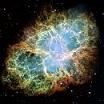
On July 4, 1054 Chinese astronomers note a "guest star" in the constellation Taurus, the star Zeta Thauri in the Crab Nebula (later known as a source of gamma rays); it is visible in daylight for 23 days and at night for two years; American aborigines see it, along with Arab astronomers, but no European records it, they're too busy with the Roman-Greek Catholic Church Schism, and King Macbeth's D at the hands of Duncan's son Malcolm - maybe this is a sign that a new country will be born on July 4 halfway to China in America, which will never be ruled by the ever-split Church?
In 1091 Walcher of Lorraine (Malvern) (later prior of Malvern Abbey) records observing lunar eclipses in Italy using an astrolabe, becoming the first observational astronomy in Christian Europe.
In 1065 Oliver of Malmesbury builds an airplane, and is killed testing it.

In 1066 Indian mathematician-astronomer Sripati (b. 1019) dies, leaving Dhikotidakarana (1039), a book on solar and lunar eclipses, and Dhruvamanasa (1056) on calculation of planetary longitudes, eclipses, and planetary transits; he also leaves Siddhantasekhara, about arithmetic, algebra, and calculations on the sphere, and Jyotisaratnamala, Jatakapaddhati (Sripatipaddhatih), and Daivajnavallabha, books on astrology.

In 1079 French conceptualist theologian-philosopher-lover (misunderstood and ahead of his time?) Peter Everhard, er, Peter Abelard (1079-1142) dies after becoming the #1 teacher in Paris, and leaning towards Aristotle over Plato, becoming a precursor of St. Thomas Aquinas. Too bad, he is castrated after getting into the pants of Heloise (1101-64) in 1117.
In 1081 Muslim astronomer Ibrahim al-Sahdi of Valencia builds the first known Celestial Globe, made of brass, 81.5 in. in diam. with 47 constellations and 1,015 stars along with magnitudes.

On May 25, 1085 the Castilian Christians under king (since 1072) Alfonso VI the Brave (1037-1109) recaptured Toledo in C Spain from the Muslims, immensely advancing Christian knowledge of astronomy and reviving the theory of the sphericity of the Earth, laying the foundation for the Renaissance.
In 1086-90 the black Muslim Berber Almoravids (Al-Murabitun) (Al-Morabiton) (backward horsemen from the W Sahara, known for riding to war wearing veils that only leave their eyes visible) (new kids on the block in Morocco in 1040-1147) invade and conquer all of Spain between the Tagus and Ebro Rivers, thumping their Qurans and destroying what was left of the Muslim high culture incl. science, descending al-Andalus into pure retro science-hating head-lopping fundamentalist Muhammad darkness.
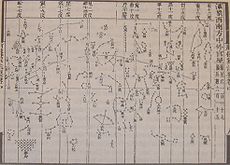
On Jan. 16, 1089 Chinese superbrain Su Song (1020-1101) finishes construction of the world's first astronomical clock.
In 1090 the first Water-Driven Mechanical Clock Tower is built in Peking, China.
In 1093 according to the Chinese, the Muslims first use a magnetic compass for navigation; the Muslims don't document it until 1282, after the Christians do it first in 1205.


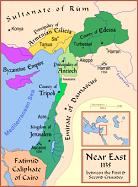

Western Science began lurching only after the Big M (Millennium) (Year 1000) proved a disappointment when Christ didn't return to judge Da World despite All the Work They Did. You can almost see the cautious steps they took, like a baby coming out of the womb and stretching its umbilical cord as long as possible before breaking loose. Too bad, the first steps were to launch the Crusades in 1095 in a futile effort to take and hold Jerusalem from the sea of infidel Muslims as Christ's landing pad; they sputtered out in 1291 with the capture of their last base in Acre, leaving Jerusalem reduced to a village, with fewer Christian pilgrims than before the Crusades started, who experienced far less Muslim tolerance. The loss of Big J in 1187 to cool all-black-wearing Saladin (Sala-ha-din) (Salah al-Din Yusuf ibn Ayyub) (1138-93) was a case of denial, anger, guilt, and acceptance, they even circulated stories about how wise and even Christian the Kurdish Muslim warlord was.

In 1111 Persian #1 Sunni Sufi mystic theologian ("the St. Augustine and Immanuel Kant of Islam") Abu Hamid Muhammad al-Ghazali (Algazel) (1058-1111) dies in Tus, Khorasan after years spent trying to reconcile faith and reason, and rejecting reason, leaving Revivification (Revival) of Science of Religion (Ihya Ulum al-Din), integrating Sufism and Islam, and backing birth control, esp. coitus interruptus (onanism), with the woman's permission; on the other hand women don't need men's permission to use contraceptives such as suppositories and tampons; Deliverance from Error (autobio.), containing the soundbyte: "A clumsy and stupid person must be kept away from the seashore, not the proficient swimmer; and a child must be prevented from handling a snake, not the skilled snake-charmer"; The Incoherence (Destruction) of the Philosophers (Tahafut al-Falasifa), with the soundbyte: "The gates of ijtihad [rational debate] in Islam are now closed", shifting Islamic philosophy away from classic Greek and Roman learning to the doctrine of Occasionalism, which ditches scientific laws of cause and effect in favor of Allah and his angels, causing an Islamic theocracy to be built up that shuts down all scientific research as an affront to Allah and his freedom to act, after which the Muslim World takes a vacation from science until modern times; Sufism becomes accepted by the Muslim world, with Sufis living in fraternities under a sheik, and calling themselves dervishes (faqirs), practicing asceticism and feverish dancing.
About 1122 Greek Asia Minor slave Abu'l Fath al-Khuzini pub. Kitab Mizan al-Hikmah (Book of the Balance of Wisdom), summarizing Muslim knowledge of physics, incl. the lever, specific gravity, and gen. gravity as a universal force drawing all things toward the center of the Earth.
In 1125 Alexander Neckam (1157-1217) of England pub. De Utensilibus, the earliest account of the Mariner's Compass, allegedly invented by Flavio Gioja of Amalfi, Italy. Neckam uttered the immortal soundbyte: "Science is acquired at great expense, by frequent vigils, by great expenditure of time, by sedulous diligence of labor, by vehement application of mind."
In 1136 Jewish brain man Abraham ben Hiyya of Barcelona (1065-1136) (first to write scientific works in Hebrew rather than Arabic) dies, leaving Hibbur ha Meshihah, the #1 mathematical treatise of the cent., incl. algebra, geometry, and trigonometry; he also leaves the oldest surviving Hebrew treatise on the calendar, and a lost encyclopedia on astronomy, math, optics, and music.
On Feb. 11, 1144 Robert of Chester pub. Liber de Compositione Alchemiae (Book of the Composition of Alchemy), becoming the first book on alchemy in Europe.
In the late 12th cent. Muslim texts on ancient Greek philosophers and scientists begin to arouse interest in Europe, and within a cent. they are getting serious and shifting into high gear; meanwhile Caliph Mustanjid of Baghdad orders all the philosophical works of Avicenna and the Brethren of Sincerity burned, and by 1200 speculative thought is kaput in the Muslim World.
In the late 12th cent., pardon my French, the Aristotelians began to make ground against the Platonists as the univ. movement began in W Europe; too bad, the Scholastics (Schoolmen) treated Aristotle's writings as holy writ, hanging on to every crackpot scientific theory.
About 1150 Magister Salernus is pub. in Salerno, Italy, containing the first Euro mention of distillation of alcohol, from the Arabic word al-kohl meaning powder for painting the eyebrows.
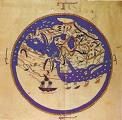
There's always some border area where warring cultures can mix and share some technical info., and in the era of the Crusades it was the Norman kingdom of Sicily. Mapmaker Al-Idrisi starts something big but doesn't know it? In 1154 Abdu Abd Allah Mohammed (Muhammad) al-Idrisi (al-Idrissi) (1100-65), a Moroccan geographer in the service of Norman king Roger II of Sicily writes The Book of Roger, a geographical treatise based on Ptolemy with a Muslim Map of the World, showing S at the top, and inscribed on a silver sphere weighing 400 kg; he divides the Earth into seven climactic zones, and subdivides each zone into 10 parts, providing 70 detailed accurate maps; he claims that the Earth is spherical because an "equilibrium experiencing no variation" keeps it in balance; his map is later used by Columbus; a 2nd expanded ed. is pub. in 1161 titled "The Gardens of Humanity and the Amusement of the Soul" (now lost), followed by an abridged ed. in 1192 called "Little Idrisi".
In 1159 Paris Bishop Peter Lombard (1096-1160) pub. Sententiae Libri IV (Four Books of Opinions), founding formal Scholastic philosophy, an attempt to reconcile reason and faith in the face of growing numbers of skeptics and atheists; a compilation of the thought of Peter Abelard, it attempts to solve all theological and philosophical problems, dissing reason for the authority of the Bible, becoming the std. text in Paris for the next four cents., with 4K+ commentaries getting written on it, holding back the advance of rationalism for the next half-cent. until the arrival of Aristotle's works in Latin; Roger Bacon says that it has displaced the Bible itself.

In 1162 Spanish Muslim physician Avenzoar (Ibn Zuhr) (1094-1162) dies in Seville after having performed the first tracheotomy on a goat, leaving Book of Simplification on Therapeutics and Diet (Kitab al-Tasir), written at the request of his friend Averroes, who calls him the greatest physician since Galen; it covers clinical descriptions of pericarditis, mediastinal tumors, intestinal tuberculosis, and pharyngeal paralysis, describing the use of bezoar stones (gastroliths) as medicinal items, becoming a hit in Latin and Hebrew translation.

In 1169 Cordoba-born Spanish Muslim brain man Averroes (Abu'l Waleed or Abu al-Walid Muhammad ibn Rushd) (1126-98) begins writing on Aristotle's works in Arabic, stirring to keep their sanity and faith at the same time; too bad, he doesn't read Greek, and has to use Arab translations of Syriac translations of Aristotle; like other Muslim brain men he Neoplatonizes Aristotle, but doesn't stop with minimizing him to save the dogmas of Islam, but minimizes Islam to fit Aristotle, even discarding the Creation for an eternal Universe, causing the Muslim World to turn against him and destroy most of his works in Arabic form, which are only saved by the Jews, who hand them to Christians, who groove on his slamming of Muhammad's dogmas until they go too deep and become rationalists, heretics, or atheists. He becomes the first to explain the function of the retina, and to recognize acquired immunity with smallpox. He dies in 1198, leaving Encyclopedia of Medicine (Kitab al-Kuyat fi al-Tibb) (1161), which becomes a hit in the West, and Tuhafut al-Tuhafut (Destruction of the Destruction), a reply to al-Ghazili, saying that deep study of philosophy will lead one out of atheism, albeit after giving up the dogmas of literal religion, so that the rulers should protect them while they combat the bad philosophers, and that in the meantime the uneducated masses should be allowed to have literal religion, and that philosophers, who should only accept it symbolically shouldn't criticize it as long as they in turn are not harassed.

In 1180 Spanish Jewish historian-philosopher Abraham ibn Daud (Ben David) (1110-80) dies in Toledo, leaving Emunah Ramah (Sublime Faith), introducing and reconciling Aristotle to Judaism,which is taken up by Spanish-born Jewish brain man Moses Maimonides (1135-1204) (AKA Rambam), author of Guide for the Perplexed (Moreh Nevukhim or Nebuchim) (1190), one of the great philosophic statements of Judaism, attempting to reconcile Moses with Aristotle, fostering scholasticism and influencing Thomas Aquinas et al.; it tries to explain which words in the Bible should be taken literally, metaphorically, and symbolically, accepting the Creation but dissing personal immortality, Aristotelizing Bible stories, e.g., Abraham and Sarah represent matter and form, Adam is the active spirit, Eve is passive matter (the root of all evil), and the serpent is imagination, pissing-off orthodox rabbis, who accuse him of "selling the Scriptures to the Greeks", and Qabbalists, who desecrate his tomb; "My primary object is to explain certain words occurring in the prophetic books"; "A thing which has in itself the necessity of existence cannot have for its existence any cause whatever"; "Everything except God has been brought into existence out of nonexistence"; "Incorporeal entities can only be numbered when they are forces situated in a body"; written in Arabic in Hebrew chars., in 1199 it is trans. into Hebrew by Samuel ben Judah ibn Tibbon, and also into Latin, causing a firestorm of controversy; "The first who openly declared that Scripture must be accomodated to reason" (Baruch Spinoza). Long-dead pagan brain man Aristotle has now invaded two of the three main Bible-thumping religions, leaving one to go.
In 1188 Shen Kuo (1031-95) pub. Dream Pool Essays (Meng Xi Bi Tan), a collection of scientific essays incl. the first description of the magnetic needle compass and its use in navigation; it takes Europe four cents. to catch up with China's #1 scientist.
In 1190 English abbot of Cirencester Alexander Neckam (1157-1217) pub. De Utensilibus, containing the first Euro mention of a compass, and De Naturis Rerum (On the Nature of Things), a compendium of scientific knowledge;, containing the first Euro mention of using a magnetic compass (bk. 2 chap. 98); describes the winged lizard-tailed cockatrice as born from an egg laid by a cock and incubated by a toad; it can turn people to stone by looking at them, touching them, or breathing on them, and only a weasel is immune; luckily, a rooster's crow will kill it instantly, as will looking at itself in a mirror; it takes until the middle of the 17th cent. for it to be regarded as a mythical duplicate of the basilisk or regulus after being mentioned in the 1611 King James Vers. of the Old Testament (Is. 11:8 et al.).
In 1194 Seville emir Abu Yusuf Yaqub al-Mansur orders all the works of Averroes except a few on natural science burned, and forbids the study of philosophy, encouraging the burning of all philosophy books, executing Ibn Habib for studying philosophy; by 1200 speculative thought is kaput in Islam, and after the Mongols destroy Baghdad in 1258, you can stick a fork in Islamic science.
By 1200 the Guitar (Persian "tar" = string) is in use in Europe, incl. the Moorish guitar (Guitarra Moresca) and the Latin guitar (Guitarra Latina). About 1200 the Camshaft is invented in Iraq by Al-Jazari, who describes it in 1206; Europe picks it up by the next cent. In the 13th cent. the Italians invent the Mannaia ("executioner's axe"), a type of horizontal guillotine, adopted by the Scots and Germans in the 16th cent. In the 13th cent. Iron Anchor Chains, which were last used during the 1st cent. B.C. begin to be used again in Europe infrequently. In the 13th cent. Mechanical Clocks (no water propulsion) begin to appear in Europe. In the 13th cent. alcohol begins to be used for medicinal purposes.


In 1202 Italian mathematician Leonardo (OG "lion bold") Fibonacci (Filius Bonaccii) (Leonardo Pisano) (Leonardo da Pisa) (1170-1250) pub. Liber Abaci (Book of the Abacus), introducing the Hindu-Arabic place-value system and Arabic numerals to Europe, and discussing the Fibonacci Sequence ("How many pairs of rabbits can be produced from a single pair in a year's time?"); forever after science and sex are romantically intertwined in Euro minds? In 1220 he pub. Practica Geometriae, first applying algebra to prove geometrical theorems. In 1225 he pub. two works contributing to the solution of equations of the first and second degree, and competes in a math tournament with John of Palermo supervised by HRE Frederick II.
In 1204 Andalusia, Spain-born Muslim astronomer Nur ad-Din al-Bitruji dies, leaving the astronomical treatise Kitab-al-Hay'ah, criticizing Ptolemy's system of epicycles and eccentricities and substituting a system of geocentric spheres, proposing a physical cause for celestial motion, which spreads through Europe for the rest of the cent.
In 1210 the Council of Paris reacts to the shock of Latin. translations of Aristotle's "Physics" and "Metaphysics" and the commentaries of learned Muslim infidel brain man Averroes by condemning Aristotle proponents Amalric of Bene (-1207) and David of Dinant (who began attacking Christian doctrines incl. miracles, creation, and immortality, leading their followers to deny heaven, hell, and the sacraments), and forbidding the reading of Aristotle's "metaphysics and natural philosophy" along with any "comments" (commentaries); too bad, this only makes them more popular, and in 1215 a papal legate arrives in Paris to proclaim the prohibition of the 1215 Fourth Lateran (12th Ecumenical) (Great) Council on teaching of all of Aristotle's works except those on logic and ethics, which doesn't stop Aristotle from being required reading at the U. of Paris in 1255. In 1263 Pope Urban IV tries to enforce the ban, but Thomas Aquinas talks him out of it after claiming that he can make Aristotle safe for Christians.
In 1216 Seville, Spain-born Andalusian Muslim scientist Abu'l Abbas al-Nabati (1166-1239) pub. Botanical Journey, a work on botany covering plants from the Atlantic to the Red Sea, earning him the name al-Nabati (the Botanist).
About 1220 after a large group and students and professors walk out of the U. of Bologna in search of more academic freedom, HRE Frederick II founds the U. of Padua in Italy to teach law and theology, followed in 1222 by medicine, and by 1399 it divides into two schools, one or civil and canon law, and the other for medicine, grammar, rhetoric, dialectic, philosophy, and astronomy; in a mere three cents. it becomes home to one of the first botanical gardens in Europe (1545), and produces giants incl. Andreas Vesalius and Galileo Galilei; in 1595 its anatomical theater begins performing public dissections.
In 1222 Jordanus Nemorarius (Jordanus de Nemore) (Giordano of Nemi) becomes gen. #2 of the Dominican Order, going on to dabble in science, using Hindu numerals and doing algebra with letters, writing Elementa Super Demonstrationem Ponderis, discussing the component of gravity along a trajectory, and expounding Jordanus' Axiom, that a force that can raise weight W to height H can raise weight K*W to height H/K. He also writes De Ratione Ponderis, discussing statical moments (the product of force and a lever arm), and The School of Jordanus, discussing the theory of virtual displacements.
In 1229 Morrocan Muslim scholar Hasan al-Marraqushi pub. tables of sines, versed sines, arc sines, and arc cotangents for each degree.
In 1229 Constantinople-born Arab Muslim scholar Abdallah ur-Rumi (Yaqut Shihab al-Din ibn-Abdullah al-Rumi al-Hamawi) (1179-1229) dies, leaving Kitam Mujam al-Buldan, a geographical lit. dictionary and encyclopedia of all Muslim knowledge of science, obtained by going through 10 libraries he found in Merv, one containing 12K vols.; after moving to Khiva then Balkh, the Mongols almost catch him, and he escapes naked clutching his mss. to Mosul, becoming a copyist and completing his opus - did he get to taste the fustaqiyya?
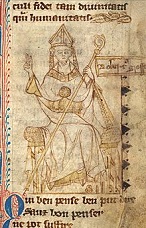
About 1230 Robert Grosseteste (1175-1253) of Oxford U. (teacher of Roger Bacon and John Peckham) discovers the writings on optics of Arab Muslim al-Haitham, and describes how the "visual ray" can be broken up by passing it through transparent lenses to enlarge or reduce visual objects; John Peckham goes on to become archbishop of Canterbury, and pub. Perspectiva Communis, describing reflection, refraction, and the structure of the eye. In 1482 an Italian ed. is pub., influencing Leonardo da Vinci to study Greek geometry in an attempt to improve his theory of lenses and the eye incl. the camera obscura.

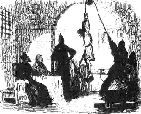

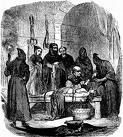


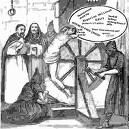
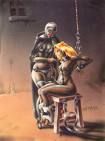
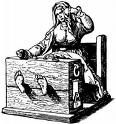
Jesus rolls over in his empty tomb? With Deadbeat Dad still overdue, and the Muslims pretty much in permanent control of Jerusalem, did the Church turn to Science in an effort to finally destroy the Muslim World and take their military field manual the Quran away from children to break the cycle so that Christian indoctrination could begin and Christ finally return as he promised after the Gospel had been preached to the whole world? No, instead it put up mile-high barriers against Science as well as all free thought, a development which sours many scientists to this day against it. Now that Bible reading has been prohibited (1229), and pesky Bible-thumpers continue to read it and point out that the Church's doctrines contradict it, in 1231 Pope (1227-41) Gregory IX (-1241), institutes the search-and-destroy Holy Office, AKA the Inquisition, in the hands of the Dominicans, for the apprehension, torture (begun 1252?) and trial of heretics, enacting a law for Rome that heretics condemned by an ecclesiastical court are to be delivered to the secular power to receive their "due punishment", i.e., death by fire, or life in a horrible inhumane prison. In his bulls of Apr. 13, 20, and 22, 1233, in order to combat the Albigenses in France, Pope Gregory IX founds the Monastic Inquisition, and appoints the Dominicans as the official Inquisitors for all dioceses of France; the smoke-choked Burning Times in France begin.
In 1234 after Rabbi Solomon ben Abraham of Montpellier in S France gets antsy about all the Catholic attacks on the Albigensian heretics, and doesn't want his congregation to be next, he anathematizes the philosophical works of Jewish brain man Maimonides (1135-1204), excommunicating all Jews who treat the Bible allegorically or even study science or profane lit.; Maimonides' supporters led by David Kimchi and Jacob ben Machir Tibbon strike back by persuading the Jewish congregations of Beziers, Lunel, and Narbonne in Provence, and Sargossa and Lerida in Spain to excommunicate Solomon and his followers; Solomon counterattacks by denouncing Maimonides to the Dominican Inquisition in Montpellier, causing them to burn all his works there, followed by Paris in 1242, setting a precedent that makes books too hot to handle in Catholic lands; too bad, 40 days later they burn the Talmud in Paris too; knowing that if you can get away with books, why not people, on June 13, 1234 Pope Gregory IX pub. the 5-vol. Liber Extra (Decretals of Gregory IX), a collection of 2K decretals which he has sent to the univs. of Bologna and Paris, repeating St. Augustine's belief that "every pagan, Jew, heretic, and schismatic will go to the eternal fire prepared for the Devil and his demons", containing the oldest surviving detailed Description of a Diabolical (Witches') Sabbath, describing the novice having to kiss an enormous toad, then a cold, pale, thin man, which causes him to forget the Catholic faith, then, after a feast, having to kiss a black cat, then the head devil (or devil's head), and finally participate in an orgy; Pope Boniface VIII adds a 6th book in 1298 - dominica, nica, what? This wonderful development in Catholic theology goes on to morph into the Spanish Inquisition in 1478, and the Portuguese Inquisition in 1531, burning its first Protestants in Spain in 1543; it is finally abolished (suspended until future notice?) after 666, er, 603 fun years in 1834.
One good thing: Gregory IX absolves those who violated the ban by the 1215 Fourth Lateran Council on teaching Aristotle, but renews it "provisionally, until the books of the philosopher had been examined and expurgated", appointing three Parisian masters to the job, which they give up on. Another good thing: Gregory IX exempts the Jews from the jurisdiction of the Inquisition, except when they attack Christianity, attempt to Judaize Christians, or revert to Judaism after Christian conversion. Meanwhile the Jewish war over Maimonides continues, with Maimonides' followers getting Solomon ben Abraham executed for ratting on fellow Jews, and his leading followers' tongues cut out; meanwhile a rabbinical ban on study of science is issued by Rabbi Don Astruc of Lunel, supported by Rabbi Asher ben Yehiel and Rabbi Nachmanides (Nahmanides) (1198-1270), causing Rabbi Solomon ben Abraham ben Adret of Barcelona to do ditto in 1305 for teaching any science, or studying it before age 25, except medicine, causing the rabbis of Montpellier to threaten to excommunicate any Jew who stops his son from studying science; the net result is the decline of science study in the Euro Jewish community, and a retreat into mysticism, esp. the Qabala - I got Scrombosis, I'm dead from the neck up?
In 1232 the Battle of Kaifeng (Kai-fung-fu) sees the Chinese use rockets in warfare for the first time to defend Kaifeng against pesky pagan Mongols; the use of gunpowder begins to spread.

In 1235 after suppressing a revolt led by his son Henry VII and having him imprisoned, super-educated skeptical Italian-born German HRE (since 1220) Frederick II (1194-1250) ("Stupor Mundi") (Amazement of the World) holds a Diet at Mainz where he promulgates the Laws of the Empire (best issued since Charlemagne?), establishing order in Germany; he goes on to allow surgeons to dissect human bodies at the Salerno school of medicine, and sponsors the trans. of Aristotle into Latin; Dante later calls his Sicilian court the birthplace of Italian poetry. By 1240 the intelligentsia of Italy adopt Averroism, the doctrine that Natural Law rules the world without interference by God, that the world is coeternal with God, that there is one immortal soul AKA the active intellect of the cosmos, of which the individual soul is a transitory form, and that heaven and hell are fables invented to cow the people into morality; to fool the Inquisition they profess to believe the Bible and the Christian faith at the same time.
In 1248 Spanish Arab Muslim scientist Abu Muhammad ibn Baitar (1190-1248) of Malaga dies, leaving Compendium on Botany and Pharmacology, listing 1.4K plants, foods, and drugs, incl. 300 new ones, becoming the std. botanical authority in Europe until the 16th cent.

In 1248 after a 16-mo. siege King (1217-52) (St.) Ferdinand III of Castile (1199-1252) captures Seville from the Moors, leaving only Granada left in their hands, where the Nasrid Dynasty (founded 1238) rules until 1492; the Moors use cannon, becoming the first use of gunpowder in Europe?

About 1250 English philosopher (Franciscan friar) ("Doctor Mirabilis") Roger Bacon (Rogerus/Rogerius Baconus/Baconis) (1214-94) invents the Magnifying Glass, breaking away from slavish reliance on Aristotle and demanding real experiments, look at that bug. In 1267 he pub. Opus Majus (Great Work), an encyclopedic work on experimental science, math, optics, and philosophy, coining the word "almanac" (Arab. "al manakh" = the weather), giving a recipe for gunpowder (41.2% saltpeter, 29.4% charcoal, 29.4% sulfur) (Pt. VI), predicting powered flight, proposing that one day be dropped from the Julian Calendar every 125 years, and containing the soundbyte (Pt. IV): "The sea between the end of Spain on the west and the beginning of India on the east is navigable in a very few days if the wind is favorable", later inspiring Columbus; it concludes with a warning that science cannot save mankind, but that "The science of morality is the mistress of every department of philosophy"; he didn't invent gunpowder, just repeated a formula he got from others - whether they're ground in, smeared on, or powdered, it doesn't matter, that's the power of Gunbarrel Clean? About 1270 he writes the soundbyte: "The philosophy of Averroes today obtains the unanimous suffrage of wise men." In 1271 he pub. the unfinished Compendium Studii Philosophiae, dissing nominalism in favor of realism; "A universal is nothing but the similarity of several individuals"; "One individual has more reality than all universals put together"; too bad, he also goes after the clergy, papacy, univs., and philosophers of his day, listing "36 great and radical defects", even going after Thomas Aquinas for pontificating on the angels, causing a conspiracy to silence him? No surprise, in 1277 the heads of the Franciscan and Dominican orders get together and imprison Bacon for "suspected novelties" until he gets too old to do any more harm (1292). "Mathematics is the gate and key of the sciences... Neglect of mathematics works injury to all knowledge, since he who is ignorant of it cannot know the other sciences of the things of this world"; "If in other sciences we should arrive at certainty without doubt and truth without error, it behooves us to place the foundations of knowledge in mathematics"; "Reasoning draws a conclusion, but does not make the conclusion certain, unless the mind discovers it by the path of experience... Argument is conclusive... but... it does not remove doubt , so that the mind may never rest in the sure knowledge of the truth , unless it finds it by the method of experiment."
About 1250 Franciscan friar Bernard of Verdun writes Treatise on the Whole of Astronomy (Tractatus Super Totam Astrologiam), defending Ptolemy's theory of epicycles and eccentrics against al-Bitruji's system of homocentric spheres. Also about 1250 French Dominican friar Vincent of Beauvais (Vicentius Burgundus) (1190-1264) of the Cistercian Royaumont Abbey pub. Speculum Maius (Majus) Naturale, Historiale, Doctrinale, an encyclopedia of medieval stupidity, quoting 450 Greek, Latin, and Arabic writers, becoming the #1 encyclopedia of the Middle Ages; the 40-vol. original is divided into "Speculum Naturale", "Speculum Doctrinale", and "Speculum Historiale", with "Speculum Morale" added around 1310; "I do not know even a single science."
About 1250 Jewish physician (in Jerusalem) Benevenutus Grassus Hierosolimitanus (-1290) pub. Practica Oculorum, which becomes a hit in the Muslim and Christian worlds, becoming the first work on opthalmology printed with the printing press in 1474.
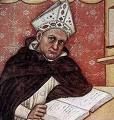
In 1250 German Dominican friar-priest philosopher-scientist (St.) Albertus Magnus (Albert the Great of Cologne) (1193-1280) (teacher of Thomas Aquinas) discovers the element Arsenic (As) (Gr. "yellow orpiment") (#33), going on to "give Aristotle to the Latins" with tons of essays on every branch of science, philosophy, and theology, citing Maimonides and Avicenna.

About 1250 Persian Muslim mathematician Nasir ud-Din al-Tusi (1201-74) of Tus, Khorasan pub. the first treatise treating trigonometry as its own subject rather than a part of astronomy; it takes the Euros two cents. until Regiomontanus (1436-76) to equal it.
About 1250 Jewish physician (in Jerusalem) Benvenutus Grassus pub. Practica Oculorum, which becomes a hit in the Muslim and Christian worlds, becoming the first work on opthalmology printed with the printing press in 1474.

Intellectually-cracked 13th cent. Europe gets one Bourbon, one Scotch, and one beer? The Crusades weren't all bad. In 1252 St. Ferdinand III (b. 1199) dies, and his erudite son Alfonso X (the Wise) (El Sabio) (1221-84) becomes king of Castile (until 1284), taking a clue about cautious multiculturalism from late great Frederick II of Germany and beginning a cultural awakening in intolerant backward Europe known as the Thirteenth (13th) Cent. Castilian Renaissance, creating the Spanish Nat. Library in Madrid, one of Europe's first state libraries, along with the Alfonsine School of Translators in Toledo, manned by Christians, Jews, and Muslims, incl. Hermannus Alemannus (Herman the German), who trans. a large mass of Arabic works mss. on astronomy, astrology, and history, selected by the king into Latin and Spanish, bringing the most important Greek, Indian, Persian, and Syrian works to the scholarly Euro community, and causing Toledo to become a European intellectual hub which fuels the coming Renaissance; Alfonso X the Wise supervises the ambitious Spanish pub. known as the General Estoria, which incl. the Alfonsine Astronomical Tables and the Alfonsine Bible (Biblia Alfonsina) as a vehicle for polishing and enriching the Spanish language, causing it to be established as a serious language and intellectual vehicle, rocketing it ahead of Italian, German, and English and making them play catch-up, causing Latin to turn a whiter shade of pale?
In 1256 Arab Muslim physician Khalifah ibn-abi'l-Mahasin of Aleppo performs a cataract operation on a 1-eyed man, leaving a comprehensive ocular manual.


Did I mention 1258? On Feb. 13, 1258 after stupid last Abbasid caliph Al-Mustasim (a damn fine calligrapher) fails to raise an army to defend it (thinking that women throwing stones can fight them off?), and accepts an offer of surrender with clemency from Hulagu Khan after a 1-mo. siege, Baghdad, the Paris of the Orient is captured by the pagan Mongol hordes of Genghis (Chinggis) ("universal river") Khan (1162-1227) (birth name Temujin = "iron worker") under the leadership of his grandson "Go West, Young Man" Hulagu (Hulegu) Khan (1217-65); of course he reneges, and 800K-1M are slaughtered over 40 days, the Tigris River running black with the ink from hundreds of thousands of ruined books; on Feb. 20 after being forced to reveal the location of his royal treasure, Al-Mustasim is rolled in a rug and trampled with horses so that no Mongol could be accused of shedding royal blood (either that, or he is imprisoned with his royal treasure and starved to death to mock him for not spending it on defense, with the khan telling him "Eat of your treasure as much as you want, you are so fond of it"), becoming the last Abbassid caliph of Baghdad; the Abbasid Dynasty (founded in 750) comes to an end along with Islam's Golden Age; the destruction of the irrigation system turns the paradise alley into a barren arid plain; the town of Tehran (Pers. "warm place") (modern pop. 8M) in Persia is settled by refugees from the Mongol invasion; Hulagu Khan goes on to take Iraq, followed by Anatolia. Too bad, the Mongols convert to Islam in 1295 after taking over China, holding them all back in science till the 20th cent. In 1303 the decisive Battle of Damascus ends the Mongol threat to the West, and they come and go in 40 years, turning Asia from 100+ thriving cities into a poverty-stricken hellhole, which continues until modern times.

In 1259 Pope Alexander IV summons U. of Paris brain man (St.) Thomas Aquinas (1225-74) to Rome (until 1268), where he wows everybody with his erudition; in 1268 he returns to Paris, and immediately gets involved in the controversy caused by heretic philosopher Siger de Brabant (1235-81), a popularizer of Muslim philosopher Averroes at the U. of Paris from 1266-76, whose commentaries on Aristotle upset followers of St. Augustine, who taught that the search for truth shouldn't be based on sense experience, and instead begin to believe that empirical knowledge rules - are you for real? In 1270 Aquinas pub. On the Unity of the Intellect Against the Averroists, which turns the tide against Siger de Brabant and the Averroists, causing the Church to back him and condemn them. When he dies, Aquinas leaves Summa Contra Gentiles (1261-4), an attempt to reason Muslims out of their infidelity between 5x-daily prayers and holy murders, and the unfinished Summa Theologica (Theological Compendium), an attempt to use the Aristotelian science and logic of the Averroists to justify the conclusions of St. Augustine and the Neoplatonists, while denying Averroes' double-truth theory that there is one truth in science and another in faith; it incl. the Five Arguments for the Existence of God (Quinque Viae), the Prime Mover, who is perfect, omniscient, omnipotent, and free. After his work sinks in, it turns the Roman Catholic Church decisively Aristotelian, widening the split with the Eastern Orthodox Church, which remains Platonist and sinks into mysticism. In 1366 Pope Urban V sends legates to Paris to announce that all candidates for an arts degree at the U. of Paris have to thoroughly study Aristotle.

On Sept. 3, 1260 after the Mamluks take advantage of the absence of Hulagu to move on them, the Mongols offer an alliance with the Franks, but Pope Alexander IV forbids it, and Count Julian Grenier of Sidon (-1275) (son of Balian I and Margaret of Brienne) causes the death of a grandson of Kitbuqa, causing him to sack Sidon, pissing the Christians off so bad they allow them to pass through Crusader territory, 10K-20K Egyptian Mamluks defeat 10K Mongols in the Battle of Ain (Ayn) Jalut (Arab. "Spring of Goliath") in the Palestinian desert in the Jezreel Valley near Ein Harod, becoming the first Mongol D that isn't avenged, forever defining the SW limit of Mongol expansion as the Tigris River; Kitbuqa is executed; Syria suffers severely from the Mongol invasion, worsened by subsequent invasions in 1281 and 1299; the Egyptians use portable hand cannon (midfa) using gunpowder cartridges charged with 2-3-15 (sulfur-carbon-saltpeter) gunpowder; on the way back to Cairo Al-Zahir al-Malik Baybars (Baibars) (-1277) ("panther") murders Sultan Qutuz, and becomes Bahriyya sultan #1 of the Mamluk Empire (until 1277); the Kipchak Turkish Mamluks (Mamelukes) (Arab. "possessed", "owned") seize control of the Egyptian sultanate, ruling Egypt until 1517, and continuing as vassals of the Ottoman Empire until 1811, becoming known for kicking the Franks out of Palestine, and kicking the last Crusader's butt out of Asia; the Bahriyya Sultanate of the Mamluk Empire (ends 1382) is founded, becoming the leading Muslim state, integrating and ruling the Syrian provinces in 1271-1516 while recruiting Mamluk soldier-slaves from the Caucasus, which causes ethnic tensions between Turks and Circassians (known for their beautiful babes); Cairo becomes the richest city W of the Indus River until 1300, with public works erected by exploited peasants; the usual form of succession is assassination; by the middle of this decade the Christians wake up and begin accepting Mongol feelers about a Franco-Mongol Alliance against the greater threat of the Muslims, the Mongols promising them Jerusalem in return for cooperation; too bad, despite several pro-Christian Buddhist Mongol khans sending embassies, it never happens, perhaps because the Christians demand their conversion first, giving Islam time to slam-dunk and convert them.
In 1267 the Council of Vienna forces Jews to wear the pileum cornutum (a cone-shaped headdress) in addition to a special badge, and forbids Jewish physicians to treat Christians, which doesn't stop Christian popes (Boniface VIII), kings (James I of Aragon, Ferdinand II and Isabella I), monasteries, nunneries et al. from employing them.

In 1269 Petrus Peregrinus (Pierre Pelerin) de Maricourt (Peter the Pilgrim) pub. Epistola de Magnete, the first scientific treatise, describing his experiments with magnets, naming the north and south poles, formulating the law that poles of opposite polarity attract while poles of like polarity repel, describing experiments in magnetizing objects, along with his invention of the 360 degree compass, and a project to build a perpetual motion machine with self-regenerating magnets.
In 1270 Marcus Graecus (Mark the Greek) pub. Liber Ignium ad Comburendos Hostes (Book of Fires for Burning Enemies), which describes Greek fire and phosphorescence, and gives a recipe for gunpowder as 1 lb. of live sulfur, 2 lbs. of charcoal from a lime or willow tree, and 6 lbs. of saltpeter. Also about 1270 Peter of St. Omer pub. Liber de Colorius Faciendis, containing recipes for painting pigments, incl. the use of linseed oil for oil painting. Also in 1270 Spanish monk Raymundus Martini pub. Pugeo Fidei, containing the first use of the word "Jehovah".

About 1270 German friar-scientist Witelo (1230-1313), pub. Perspectiva, a work on optics based on Alhazen, containing speculations on psychology, nearly discovering the subconscious.
In 1271 Robert of England first correctly states the theory of the Pendulum Clock. A big one is built in a tower in Westminster in 1288, spreading to the Continent.
About 1275 Jewish physician Abu Al-Mina Al-Kuhin al-Attar pub. a pharmacopia that becomes a hit in the Muslim World until modern times.
In 1280 Hans Speyer invents the Belt-Driven Spinning Wheel (from China?), causing a revolt among Flemish textile workers - throw them shoes?
In the 1280s Salvino d'Amarto (-1317) of Italy invents Eyeglasses (Spectacles).
In 1289 letters containing block printing are sent from Persia to the king of France, going on to be developed in Ravenna.

My mind's such a sweet thing, crimson and clover, over and over? In 1298 Italian world traveler Marco Polo (1254-1324) is captured in battle and thrown in jail in Genoa, which gives him the leisure to write up his cool travels, and he begins dictating his memoirs to his cellmate, incl. a sherbet recipe brought home from Asia, finishing ca. 1300; it takes until 1447, but finally A Description of the Marvels of the World (The Travels of Marco Polo), AKA (by his many doubters) Il Milione (The Million Lies) (The Marco Millions) is pub.; it describes heating coal ("black stones"), oil lamps, asbestos, Chinese scholars wearing eyeglasses, crocodiles, yaks ("grunting oxen"), coconuts, how emperor Kublai Khan's harem is filled with 100 new concubines every two years by special emissaries, the Pacific Ocean, his route across the Asian continent and all the cool wonders and sights, the interior workings of unsaved China, everything except tea, foot binding, and the Great Wall of China?; on the other hand, he claims that a prince "sixth in descent from Prester John" rules a territory W of Peiping (Peking); although there really is a Kublai Khan who rules from Siberia to the Punjab, and he really did go away from age 17-40 and mainly tell it like it is, it takes cents. for him to be believed by members of the Holy Mother Church and its infallible Pope with a pipeline to Christ and God; the stories introduce Japan, Peking, Java, Sumatra, Siam, Burma, Ceylon, the Zanzibar Coast, Madagascar, and Abyssinia to the West, inspiring commerce and travel,
In 1299 after lobbying by abacists, a law is passed in Florence against using "newfangled figures" (Hindu numerals, the zero, decimals) to do accounting; Hindu numerals don't replace Roman numerals until the 16th cent.
In the 14th cent. Cast iron becomes widely available in Europe; in this cent. Sheffield, England in South Yorkshire (built on seven hills like Rome and Prague) becomes known for manufacturing cutlery, becoming the #1 center by 1600.
In 1300 a Jew is appointed as regent of the faculty of the Montpellier School of Medicine in France, pissing-off the medical faculty of the U. of Paris, who don't like the theory of demonic possession of the sick and the efficacy of relics to be questioned, and force them to expel all Jews next year.

In 1303 Pietro d'Abano (1250-1316), an Averroist prof. of medicine from the U. of Padua pub. Conciliator Controversiarum, attempting to harmonize medical and philosophical theory; he teaches that the brain is the source of the nerves, and the heart of the blood vessels, and measures the year as 365 days 6 hours 4 min.; too bad, his claim that all causation is caused by the stars, eliminating God from the equation gets him accused of heresy, but his patients Pope Honorius IV and Marquis Azzo d'Este protect him until 1315, when he escapes an Inquisition trial by a natural death, his friends hiding his body so well they have to execute him in effigy.
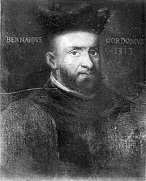
In 1303 prof. of medicine at the U. of Montpellier Bernard de Gordon pub. Practica seu Lilium Medicinae, which describees anthrax, plague, TB, scabies, epilepsy, and leprosy, and contains the first Euro medical reference to spectacles.
In 1307 after Arabic texts on alchemy get translated to Latin and spawn Euro alchemists, the Roman Catholic Church condemns alchemy as a diabolical art, which only makes it more popular?
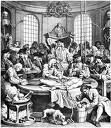
In 1315 the first Public Human Dissection is performed in Italy by Mondino de Luizzi (1258-1326), who pub. Anatomia (De Anatome), the first practical dissection manual this year, used by Euro medical schools for the next three cents.

In 1324 English Franciscan friar William of Ockham (Occam) (1280-1347) (student of Duns Scotus) defines his Nominalist (anti-Realist) (Terminalist) philosophy at Pope John XXII's court in Avignon, incl. the cool Occam's (Ockham's_ Razor (principle of economy of thought), toppling the dunce Schoolmen by separating logic from metaphysics with the claim that logic has nothing to do with ultimate truth, backing an experimental approach to science and even suggesting the law of inertia; after a catfight with Thomists in the 1320s, Ockham's school dominates European thought until the Protestant Reformation of the 1500s.
The Black Death (the original Darth Vader) rockets through Europe's Internet with breathtaking speed? In Oct. 1347 a Genoese trading fleet arrives in Messina, Sicily carrying the Black Death (Bubonic Plague), caused by Yersinia pestis bacteria carried by fleas from rats; not rats but gerbils?; it also arrives in Egypt, Syria, and Cyprus; by 1351 it kills 20M-30M in Europe (a third of Europe's pop., and up to 60% in some areas), and 75M worldwide by 1361; world. pop. decreases from 450M to 350M-375M by 1400; Europe takes 150 years to return to 1347 pop. levels; it ravages China, halving its pop. from 123M in 1200 to 65M in 1400; lucky America is not affected, but not toughened up by it either?; rats didn't really spread it, because it spreads so fast from person to person? On Sept. 26, 1348 Pope Clement VI issues the bull Quamvis Perfidiam, attempting to dispel the rumor that Jews caused the Black Death by poisoning wells, saying that they too are suffering from the plague, but he is ignored. In summer 1349 the Great Plague reappears in Paris, where it peaks, killing up to 800 a day, and spreads to Picardy, Flanders, and the Low Countries; also in the summer it reappears in London, and spreads to Ireland, killing 35% of the pop. within a year; by the middle of the year half of the pop. of Venice is killed; by the end of the year half of England's pop. is killed, and a truce with France is called; the plague spreads to Norway when an English ship full of corpses floats into Bergen, and reaches Elbing (Elblag), Poland on Aug. 24; the Church and its credibility being challenged head-on, the main solution offered is by the Flagellants, who appear in force all over Europe (especially Germany), torturing themselves publicly, and proclaiming that the Second Coming is 33.5 years away (I been a bad, bad boy, so tan my sinful hide?), while causing trouble for Jews, the rich, the Church, and finally themselves (besides all the wounds), causing Pope Clement VI to pub. a bull condemning them on Oct. 20; "Many persons, and even young children were soon bidding farewell to the world, some with prayers, others with praises on their lips."
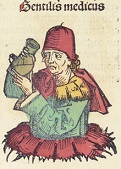
On June 18, 1348 Italian physician (pioneer in cardionephrology) Gentile da Foligno (b. ?) dies of the plague after becoming known for applying the "art of latitudes" to Galen's physiology; leaves Consilia.
In 1350-1 the Great Plague begins clearing, leaving a depopulated Europe where the deck is reshuffled and the entire social order is thrown up for grabs. The intelligentisa begin to smell a rat in the divine pretensions of the Church, and launch the timeless look at the ancient pagan past called the Renaissance via their Greek scholar friends in Constantinople, no longer being satisfied with Arab translations but learning ancient Greek for themselves; meanwhile the workers see the class struggle clearly now, the rain is gone.
About 1350 the Renaissance (It. "Rinascita" = rebirth) Period in Europe begins (ends 1650) as the intelligentsia begin to smell a rat in the divine pretensions of the Church and launch the timeless look at the ancient past called the Renaissance via their Greek scholar friends in Constantinople, no longer being satisfied with Arab translations but learning ancient Greek for themselves; meanwhile the workers see the class struggle clearly now, the rain is gone?; in Europe begins (ends 1650) as the intelligentsia begin to smell a rat in the divine pretensions of the Church and launch the timeless look at the ancient past called the Renaissance via their Greek scholar friends in Constantinople, no longer being satisfied with Arab translations but learning ancient Greek for themselves; meanwhile the workers see the class struggle clearly now, the rain is gone? the Italian Renaissance begins first, spreading outward, with Italian Renaissance painting beginning about 1400, along with Italian Renaissance architecture, Italian Renaissance humanism, Italian Renaissance music, Italian Renaissance philosophy, and Italian Renaissance science.
About 1360 French Roman Catholic priest Jean Buridan (1295-1363) develops the Theory of impetus, which he defines as weight x velocity, becoming the precursor to the concepts of inertia, momentum, and acceleration.
In 1361 French alchemist Nicolas Flamel (1330-1418) discovers the alchemical textbook The Sacred Book of Abraham the Jew, Prince, Priest, Levite, Astrologer and Philosopher to that Tribe of Jews Who by the Wrath of God Were Dispersed Amongst the Gauls, spending 21 years trying in vain to understand it until a converted Jew in Leon gives him the key; on Jan. 17, 1382 he performs his first successful chemical transmutation in Paris, growing wealthy, allowing him to endow 14 hospitals, seven churches, and three chapels in Paris, and ditto in Boulogne, making him a hit with Sir Isaac Newton, who copies one of his works by hand - behind every fortune is a crime?

In 1364 is the first recorded use of a hand gun ("hand cannon") in Europe; by 1378 they are spreading across Europe. In 1364 William of Ockham disciple Nicole Oresme (Nicolas d'Oresme) (1320-82) pub. Le Livre du Ciel et du Monde (The Book of Heaven and Earth), which questions the theory of a stationary Earth, suggesting that it revolves, and proposes Galileo's law of falling bodies; too bad, until Euro militaries become dependent on cannon in the 16th cent. and need scientists to figure out cannonball trajectories, science is only a hobby for univ. profs., who make their livings with theology and dialectic, and mathematics is still too primitive to get very far - the wizards are still mired in alchemy, and the geniuses are too busy reaping commissions from the Church and aristocracy for art works? Oresme leaves Tractatus de Configurationibus Qualitatum et Motuum, which distinguishes between intensity and quantity of heat, anticipates rectangular coordinates and the treatment of time as a variable, and proves the divergence of the harmonic series.
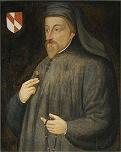
In 1383 English lit. giant Geoffrey Chaucer (1343-1400) pub. The House of Fame, a dream vision of a glass temple adorned with images of the famous, where he meditates on the nature of fame with an eagle as his guide, containing the first use in English of the words "galaxy" and "Milky Way".

In 1400 French traveler-poet and court historian Jean Froissart (1337-1400) dies, leaving Froissart's Chroniques (Chronique de France, d'Angleterre, d'Ecosse et d'Espagne) (Chronicles of France, England, Scotland and Spain) (1.5M words), covering from the deposition of Edward II in 1326 to 1400, becoming the chief description of the chivalric culture of 14th cent. England-France and the Hundred Years' War; incl. personal accounts of the 1367 baptism of Richard II in Bordeaux, the 1380 coronation of Charles V in Rheims, the 1386 preparations for the invasion of England in Sluys, the 1389 marriage of Duke John of Berry and Jeanne of Boulogue in Riom, and the 1389 joyous entry of French Queen Isabeau of Bavaria to Paris; too bad, they are filled with errors; he has "marvelous little sympathy" for the "villain churls" (Sir Walter Scott); first known mention of the verge escapement for clocks.

In 1420 future Persian shah (1447-9) Ulugh Beg (1393-1449) founds the Samarkand Observatory, which has instruments to measure precise star positions (the last great Muslim observatory?), compiling books of trigonometric tables of sine and tangent values accurate to 8 decimal places; Muslim Science remains far ahead of Christendom until about 1600.

In 1421 Prince Henry the Navigator (1394-1460), equipped with the Muslim secret weapon of the astrolabe, making his Portuguese fleet the only Euro fleet able to navigate open waters assembles Europe's leading maritime experts in Sagres on Cape St. Vincent, and develops the amazing small, light, 3-masted (square, lateen, or both) Caravel, which can outrun other vessels even when fitted with cannons, and/or carry more cargo, becoming a quantum leap in oceangoing technology, enabling the Portuguese to win the Tour de Lance with the Muslims in colonizing Africa, India, America et al.
The Mouse That Roared? In 1430 16-ton Mad Marjorie, the first cast-iron gun is introduced into battle; it has a 2-ft. bore and fires a 750 lb. stone ball.

In 1431 Cheng Ho (Zheng He) (1371-1433) begins his (last) Seventh Voyage from China, reaching 20 states and exacting tribute from 11 of them, incl. Muhammad's holy city of Heavy Mecca (ends 1433). In 1433 the Chinese Exploratory Voyages begun in 1405 end with the return of eunuch Chinese adm. Cheng Ho from his 7th voyage after having gone as far W as America?; China isolates itself from the "backward" outside world, burns all the ships, shipyards, and records, and makes it a crime to go to sea from China in a multi-masted ship - boy do they have a surprise coming from those *!?*! backward barbarians?
In 1433 Tibetan saint Thangtong Gyalpo (Chakzampa) (1385-1464) invents the Iron chain suspension bridge, building eight in E Bhutan; the last one is washed away in 2004.

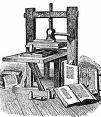
Speaking of wizards, about 1439 German goldsmith Johannes Gutenberg (1398-1468) of Mainz invents a process for mass-producing movable type using a hand mold for a screw-type wooden Printing Press using oil-based ink; the Info. Explosion begins. Too bad, Bill Gates, er, the pope makes use of it to mass-produce indulgences to fill his coffers, fomenting a revolt in Germany led by Martin Luther.
In 1455 cast-iron pipe is invented in the Castle of Dillenburgh in Germany - should be dildoburgh?
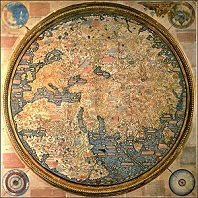
In 1457 Portuguese king Afonso V commissions Italian cartographer Fra Mauro (-1464) (a Camaldolese monk from Murano Island near Venice) to make the 2mx2m Fra Mauro Map, of Africa, Asia, and Europe, which is finished on Apr. 24, 1459, and sent to his uncle Prince Henry the Navigator along with a letter encouraging funding of new explorations, becoming the best map to date by the Euro world, ending Bible-based geography and launching scientific geography; claims that the Earth is spherical with a diam. of 22.5K-24K mi. (34.5-43.1km) (true value 24,860 mi. = 40,008km; the first mention of Java in a Euro map; show the Cape of Diab as the southernmost point of Africa; no mention of America, only Greenland (Grolanda).
In 1469 Pliny the Elder's Historia Naturalis becomes the first scientific book to be printed in the Wild Wild West, one year after Johannes Gutenberg (b. 1398) dies, and only 993 years after the fall of the Roman Empire in 476 C.E. - introducing scrubbing bubbles toilet cleaning gel, eeeeuuuw?


In 1471 German astronomer Regiomontanus (Johannes Muller von Konigsberg) (Johannes Müller von Königsberg) (1436-76), pupil of Austrian astronomer Georg von Puerbach (Purbach) (1423-61) sets up the Nuremberg Observatory, becoming the first European observatory. In Jan. 1472 he measures the angular diam. of comets, and helps pub. Puerbach's Theoricae Novae Planetarum, which features diagrams of the system of solid spheres. In 1457 Puerbach pub. Pro Pluribus Annis in Vienna, becoming the first printed almanac. In 1473 Regiomontanus pub. Ephemerides ab Anno, an almanac for 1475-1505, used by Columbus. In 1474 he pioneers lunar nautical navigation. In 1475 he is called to Rome by Pope Sixtus IV to help reform the pokey Julian Calendar, which is now eight days behind, with the vernal equinox falling on Mar. 12 instead of Mar. 20; too bad, he dies of the plague next year before doing it. He leaves De Triangulus, which becomes the std. textbook on trigonometry.

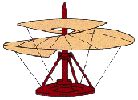
In 1483 Italian superbrain Leonardo da Vinci (1452-1519) invents the Parachute - works on both flat and round worlds, and might be useful if the edge of the Earth is reached? In 1487 he invents the tank, "which will enter the closed ranks of the enemy with their artillery, and no company of soldiers is so great that it will not break through them. And behind these our infantry will be able to follow quite unharmed and without any opposition"; no real tanks are fielded until WWI. In 1490 he describes Capillary Action after Veronese anatomist Marc Antonia Della Torre dies and he dissects 10 human bodies in the cellar of the Santa Spirito by candlelight to fulfill a vow to him. In 1493 he designs the Airscrew, the first flying machine, and leaves notes on the laws of friction and the horizontal water wheel (basis of the water turbine) in his Notebooks, finished in 1510 - all suggested by his sexual orientation?



Yes, the whole game was about to change with the discovery of the New World. After giving up on ending Muslim control of the Mediterranean Sea, by the early 1400s Western Euro powers began improving their ability to navigate on the seas using stolen Muslim astrolabes, and set out south in search of another route to India and China so they could get hold of yummy spices to make their unrefrigerated rotten meat more palatable, plus so that they could steal anything that wasn't bolted down. It didn't take long for the Portuguese to discover Africa, taking back their first African slaves in 1434, that was no sweat, but the big breakthrough for the world war between Christians and Muslims was in 1492, when Spanish-backed Christopher Columbus (1451-1506) discovered America AKA the New World, thinking it was was part of the Old World, India, because he knew the world was round despite the official opinion of the Church, but vastly underestimated the circumference. In 1498 Portuguese explorer Vasco da Gama (1460-1524) finally found a route around Africa to India, reaching Kappakadavu near Calcutta on May 20, and discovering that Arab merchants had beat him to it, but going on to kick them out. The discoveries made Spain and Portugal rich with stolen loot, incl. tons of gold, and gave them a strategic advantage in future fights with the Muslim Hive, although it exposed them and their Roman Catholic Church backers as cruel greedy genocide artists and slavemasters, the intellectual backlash causing them to eventually concoct the theory of white supremacy as a justification.
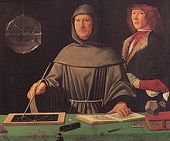
In 1494 Italian Franciscan friar Luca Bartolomeo di Pacioli (Paciolo) (1445-1517) pub. Summa de Arithmetica, Geometria. Proportioni et Proportionalita in Venice, becoming the first textbook on modern accounting theory, incl. double-entry bookkeeping, causing him to be called "the Father of Accounting and Bookkeeping"; first printed use of +/- symbols for arithmetic?
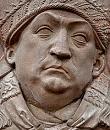
About 1499 Trittenheim, Germay-born polymath Benedictine abbot Johannes Trithemius (Johann Heidenberg) (1462-1516) writes Steganographia (3 vols.), which is pub. in Frankfurt in 1606; too bad, its coverstory of magic and spirits causes it to be placed on the Roman Catholic Prohibited Index until 1900.
About 1500 a German engraving depicts a doctor wearing a mask with a birdlike beak containing perfume to protect against the Black Death.

In the early 1500s the Spanish begin sailing Galleons, giant lumbering heavily-armed ships with three masts and 3-4 decks (a modification of the galley) used to transport gallons of treasure from South Am. (the Spanish Main) and other lands to home turf - click if you want to become a buccaneer?
About 1500 Chinese inventor Wan Hu allegedly devises a flying chair using 47 rockets, which explodes, killing him, becoming the world's first astronaut; Wan-Hoo Crater on the Moon is later named after him.

In 1504 Peter Heinlein (Henlein) (1480-1542) of Nuremberg, Germany invents the coiled mainspring Pocketwatch (Watch) (portable clock), called the Nuremberg Live Egg; it only has an hour hand, and is so heavy it has to be worn on a belt or around the neck.
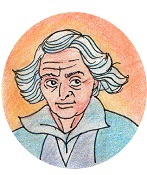
In 1505 Italian mathematician Scipione del Ferro (1465-1526) partially solves the cubic equation, obtaining the full solution in 1520.
In 1507 Italian-born John Damian attempts to fly by strapping on chicken-feather wings and jumping from the walls of Stirling Castle in Scotland; too late he remembers that chickens don't fly.
In 1510 Leonardo da Vinci designs the Horizontal Water Wheel, basis of the water turbine.

In 1511 Italian-born Peter Martyr d'Anghiera (1457-1526) is appointed by HRE Charles V as the chronicler for the Council of the Indies, going on to pub. eight "Decades", descriptions of all the exciting voyages and discoveries in the New World, and become the first writer to realize the significance of the Gulf Stream, which is first discovered in 1513 by the expedition of Puerto Rico gov. Juan Ponce de Leon (1460-1521).
In 1514 Dutch writer Giel Vander Hoecke becomes the first to use the + and - signs in a book on arithmetic? - were they ad hoc signs?
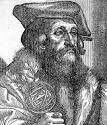
In 1517 Italian physician Hieronymus Fracastorius (Girolamo Fracastoro) (1478-1553) explains fossils as the remains of living organisms, but questions that they all came from Noah's flood - he goes too far up the family tree in his search of genealogy? In 1530 he pub. the poem Syphilis, or the French Disease (Syphilis sive Morbus Gallicus), about a shepherd named Syphilis (who does it with sheep?), giving the venereal disease caused by the spirochete Treponema pallidum its name, containing the germ of the Germ Theory of Disease, later taken up by Louis Pasteur. In Apr. 1546 he pub. On Contagion (De Contagione et Contagiosis Morbis et Eorum Curatione) (3 vols.), the first discussion of contagious infections, suggesting that diseases like syphilis, rabies, and phthisis are like seeds (fomites) that can be transferred from person to person as they "propagate their like" through air, water, etc. via direct contact, indirect contact, or at a distance; the first to recognize the disease typhus.
In 1517 Hans von Gersdoff pub. Feldtbuch der Wundtartzney, the first depiction of an amputation, recommending use of a tourniquet - we'll have to take your hands and gersd off?




With Catholic indulgences, crime does pay? The papal quest for filthy lucre finally reaps public reaction, creating the Protestant schism? On Oct. 31, 1517 (Wed.) (Halloween or All Hallows' Eve) German Roman Catholic Augustinian friar Martin Luther (1483-1546), after becoming sick of the indulgences peddled by Dominican friar Johann Teufel, er, Johann Tetzel (1465-1519) et al., and convinced that 1517 marks the end of the Babylonian Captivity of the Congregation, nails his Ninety-Five (95) Theses (Disputation on the Power of Indulgences) (written in Latin) to the door of the Wittenberg Palast (Palace) (Castle) Church in Saxony on the Elbe River (known for housing 5K+ holy relics, which he detests), arguing against indulgences and other Roman Catholic Church abuses, starting out pulling his punches then within a few years claiming that the pope is the Antichrist, "and his seat is that of Satan himself", and that "The treasures of indulgences are nets with which they now fish for the wealth of men", igniting the already-smoldering Protestant Reformation (he could have picked a more PC date than Halloween?); he really just sent them to Mainz archbishop Albert of Brandenburg that day, then posted them on the church door sometime in mid-Nov.?; his offer of a public debate is declined, but his theses are soon translated from Latin to German and pub., causing the German middle and merchant classes, who are already chafing at Italian efforts at domination to rise to his support in reaction to the fugging Fuggers (successor to the Medicis) and other papal bankers who are draining Germany of gold for Rome with this holy racket (the Fuggers are behind the loans made by Albert of Brandenburg to the pope); the big revelation to Luther that gave him strength was from the Bible, incl. the Seven Trumpets in Rev. Ch. 8, and Rev. 13:5, where it says that the Antichrist will rule the world for 42 mo., which he turns into 1260 years instead of days, setting year 1 in 539 C.E., and claiming that Christ will therefore return in the year 1799, thus it's time to get started whipping things up? - the wildlife experience, more than a museum?

In 1520 Swiss walking wonder medical student Philippus Paracelsus (Lat. "Greater than Celsus") (Aureolus Theophrastus Philippus Bombastus von Hohenheim) (1493-1541) wanders through Europe, and introduces Laudanum (spiced wine and opium) as a painkiller and cure-all, blissfully unaware of its addictive properties - the original Timothy Leary? In 1528 he pub. Die Kleine Chirurgia, the first Euro surgery manual, which crusades for the use of chemicals in the treatment of disease, pioneering the use of minerals incl. lead and mercury as drugs, and coining the name "zink" (zinc) (Ger. "pointed"), introducing the system of salt, sulfur, and mercury in Opus Paramirum (1530) as the three "prime elements" from which all things are made, inventing chemical therapy and chemical urinalysis, suggesting a biochemical theory of digestion, and coining the term "tartar" for the stony crud on teeth (really saliva plus bacteria), becoming known as "the Father of Toxicology" (grandfather of pharmacology), and "the Devil's Doctor".
In 1520 German gunsmith August Kotter invents the spirally-grooved rifle barrel for straighter shooting - welcome back, Kotter?
In 1520 the Wheel Lock is invented in Italy, leading to the creation of single-handed pistols.
In the 1520s the Violin emerges in its modern form in the region of Milan, Italy.
In 1521 Bologna surgery prof. Jacopo Berengario da Carpi pub. a Commentary on Mondino containing a number of anatomical discoveries, incl. the action of the cardiac valves, and the fact that the kidney is not simply a sieve; he coins the term "vas deferens".

In 1522 German painter Albrecht Durer (Dürer) (1471-1528) designs a flying machine for use in war - you drive? In 1525 he pub. Manual on Geometry, the first one pub. in Germany.
In 1525 Fernando Francesco de Avalos, Marquis of Pescara (1489-1525) invents the Harquebus (Arquebus) (first portable shotgun) just in time for the Battle of Pavia on Feb. 24.
In 1525 German mathematician Christoff Rudolff (1499-1545) introduces the radical sign for square roots in mathematics in Coss, the first German textbook on algebra.

In 1529 Italian humanist physician Giovanni Battista da Monte (Johannes Baptista Montanus) (1498-1551) introduces clinical sickbed examination of patients at the U. of Padua - is there a doctor in the padded house?

In 1530 Flemish cartographer Regnier (Reiner) Gemma Frisius (1508-55) proposes finding longitude by means of difference of times, causing Jean-Baptiste Morin to comment "I do not know if the Devil will succeed in making a longitude timekeeper but it is folly for man to try" - now all we need is a Mickey Mouse watch? In 1533 he becomes the first to pub. the Triangulation Method for surveying.

In the 1530s Parisian publisher Claude Garamond (1480-1561) creates the Garamond Type Font, the first Roman type font; he is created "imprimeur du roi" by Francis I.
Also in the 1530s in Europe the bottle cork is invented, and the spinning wheel and the workman's bench come into use.
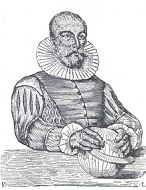
In 1537 Portuguese mathematician Pedro Nunes (Petrus Nonius) (1502-78) pub. Treatise in Defense of the Maritime Chart, the first discussion of the Rhumb line, a path with constant bearing relative to true north (loxodrome). In 1542 he invents the Nonius, predecessor of the Vernier scale.
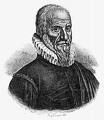
In 1537 French barber surgeon Ambroise Pare (Paré) (1510-90), in the service of Francis I during the attack on Turin discovers that soldiers with gunshot wounds that have not been scalded with the usual boiling oil of elders fare better than those who do, causing him to discard the accepted practice and prepare poultices with more humane cold ingredients incl. egg yolks, turpentine, and rose oil, used by the ancient Romans - it's a triple mess-kit cozy? Blue ribbon for best complementary inventions in the same year? In 1540 Pare pares, er, invents the first Artificial Limbs. In 1540 Italian munitions manufacturer Camillo Vettelli begins producing the first Pistols (for horse soldiers) at (guess where?) Pistoia in Tuscany (21 mi. NW of Florence), all made possible by the invention of the wheel lock; Henry VIII ends up owning a 4-chamber arquebus with a 2'9" barrel, 7.5" chamber, and 0.5" bore; others begin combining the pistol with a battle-axe or dagger - I'll pare off those lame legs after you come to be ventilated by a pistol? In 1550 Pare develops the first Ligature to stop bleeding during surgery, and traces phantom pains to the brain.
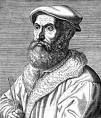
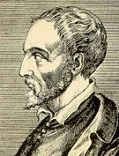
In 1537 Italian mathematician Niccolo (Niccolò) Fontana Tartaglia (Ital. "stammerer") (1500-57) pub. Nova Scientia (A New Science), which discusses projectile trajectory and the motion of heavy bodies, proposing Tartaglia's Theorem, that the trajectory of a projectile is a curved line, and that a projectile fired at an elevation of 45 deg. will travel the farthest, founding the science of Ballistics - heavy balls as a cure for stammering? In 1556-60 he pub. General Trattato di Numeri et Misure in Venice, containing Tartaglia's Formula for the volume of a tetrahedron, becoming the #1 treatise on arithmetic in the 16th cent. Too bad, he is tricked by Italian mathematician Gerolamo (Girolamo) (Geronimo) Cardano (1501-76) into revealing his solution to the cubic equation on the promise of keeping it secret, only to be betrayed, causing a running feud with Cardano and his student Ludovico Ferrari (1522-65). Cardano goes on to pub. solutions to the cubic and quartic equation, acknowledge the existence of imaginary numbers, help found mathematical probability, introducing binomial coefficients and the binomial theorem, pub. "De Proportinubus" in 1570, describing hypocycloids, and invent the combination lock, gimbal, universal joint, and biconvex lens.
In 1538 the Diving Bell is invented by Guglielmo de Lorena of Italy.
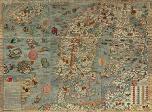
In 1539 Olaus Magnus (1490-1557) pub. Map of Scandinavia, the first accurate large-scale map of a large Euro region.
In 1540 Petrus Apianus (1495-1552) pub. Astronomicum Caesareum, dedicated to HRE Charles V, which notes that the tail of a comet observed in 1531 pointed away from the Sun, and incl. the first scientific drawing of a comet.
In 1540 Vannoccio Biringuccio (1480-1539) posth. pub. De la Pirotechnica, the first prof. handbook of metallurgy, smelting, ore reduction, and cannon-molding, and first modern book on how to operate a foundry.



In 1540 after being forced to flee to Paris and change his name to Villanovus, Freethinking Spanish physician Michael Servetus (1511-53) discovers the Pulmonary Circulation of the Blood. On Oct. 27, 1553 Swiss Protestant leader John Calvin (1509-64) burns his theological enemy, Unitarian (non-Trinitarian) Catalan scholar Michael Servetus (b. 1511) (who was captured while fleeing to his protection after escaping a prison of the Spanish Inquisition) in Geneva, executioner Guillaume Farel warning the audience: "(Servetus) is a wise man who doubtless thought he was teaching the truth, but he fell into the hands of the Devil... Be careful the same thing doesn't happen to you"; liberals lose their illusions about Bible-thumpers ever lightening up anything but a faggot, and a corner is turned in the fight for freedom of conscience?; at his trial Servetus is ridiculed for describing Palestine as a sparse, sterile land when the Bible says it's the land of milk and honey; noted noble Paris-educated French Protestant ex-humanist poet Theodore Beza (1519-1605) backs Calvin up - I look bad, feel bad, which is most important?
In 1541 Italian anatomist Giambattista Canano (Canani) (1515-79) pub. an anatomical tract that shows each muscle separately in its relations with the bones.

In 1542 Jean Fernel (1497-1558) pub. De Naturali Parte Medicinae, which establishes his rep as a top French physician, and becomes part 1 of his 3-part Universa Medicina. He becomes the first to observe that when the ventricles contract (systole), the arteries increase in size due to the blood entering them; an accurate understanding of heart circulation is still far off.
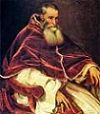


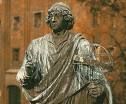

The original Coppertone Baby kept his ass out of the Sun on purpose? In 1542 Pope (since 1534) Paul III (1468-1549) establishes the Holy Office (Congregation for the Doctrine of the Faith) (Supreme Sacred Congregation of the Roman and Universal Inquisition) in Rome to intercept appeals from defendants of the Inquisition and forward them directly to the Holy See, ending up being used to speed up the persecution of scientists promoting Copernicus' heliocentric system - I'm feeling really nonjudgmental today? On May 24, 1543 (May 14 Old Style) (Mon.) Polish astronomer-mathematician Nicolaus Copernicus (Lat. "copper worker") (b. 1473) dies in Frombork, Poland after allegedly awakening from a stroke-induced coma long enough to view the first printed copy of his magnum opus Six Books on the Revolutions of the Celestial Orbits (De Revolutionibus Orbium Coelestium), advancing the Heliocentric Theory (which he had shelved, claiming it to be incomplete or even erroneous, but more likely afraid of Catholic reprisals?), which was pushed through the press by his one and only pupil Georg Joachim Rheticus (Rhaeticus) (von Lauchen) (1514-74) (a Lutheran math prof. whose father had been executed for heresy), and is pub. posth. in safe Protestant Nuremberg; it is (fawningly?) dedicated to Pope Paul III, and incl. a cautious (mendacious?) Preface by Andreas Osiander (1498-1552) of Konigsberg, stating that the revolution of the Earth is a mere mathematical convenience and not necessarily a physical fact (although Coppertone Baby had considered it otherwise?); "There have already been widespread reports about the novel hypotheses of this work, which declares that the Earth moves whereas the Sun is at rest in the center of the Universe. Hence certain scholars, I have no doubt, are deeply offended and believe that the liberal arts, which were established long ago on a sound basis, should not be thrown into confusion. But if these men are willing to examine the matter closely, they will find that the author of this work has done nothing blameworthy. For it is the duty of an astronomer to compose the history of the celestial motions through careful and expert study. Then he must conceive and devise the causes of these motions or hypotheses about them. Since he cannot in any way attain to the true causes, he will adopt whatever suppositions enable the motions to be computed correctly from the principles of geometry for the future as well as for the past. The present author has performed both these duties excellently. For these hypotheses need not be true nor even probable. On the contrary, if they provide a calculus consistent with the observations, that alone is enough. Perhaps there is someone who is so ignorant of geometry and optics that he regards the epicyclc of Venus as probable, or thinks that it is the reason why Venus sometimes precedes and sometimes follows the Sun by forty degrees and even more. Is there anyone who is not aware that from this assumption it necessarily follows that the diameter of the planet at perigee should appear more than four times, and the body of the planet more than sixteen times, as great as at apogee?"; "The massive bulk of the Earth does indeed shrink to insignificance in comparison with the size of the heavens" (Copernicus); the kind of reception awaiting Copernicus' followers is shown right away when the first Auto da Fe, AKA Act of Faith, or burning alive of heretics (Protestants) by the Spanish Inquisition dressed in weird sinister hoods takes place in 1543 in the island of Goa (goa to Hell, you heretics?), and Pope Paul III issues his first Index Librorum Prohibitorum (Index of Prohibited Books); each lucky heretic gets to wear a black sanbenito painted with flames and devils to his own BBQ - toast them marshmallows on a stick, hooray for Christ? In 1552 Rheticus pub. Canon of the Science of Triangles, the first Euro pub. of 6-function trig tables.

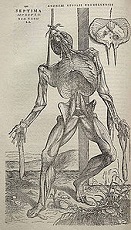
Is it Science or is it Porno? In 1543 after becoming prof. of anatomy at Padua in 1537 (until 1544), founding a school that turns up the heat on the subject no matter whom it shocks, Dutch Flemish anatomist Andreas Vesalius (Andre Vesale) (Andreas Vesal) (Andreas van Wesel) (1514-64) pub. The Fabric of the Human Body (De Humani Corporis Fabrica) (7 vols.), and the companion vol. Epitome (both in Basel), with illustrations by Titian's studio, the first illustrated anatomy of the human body, and the most detailed and extensive to date. Too bad, after being persecuted as a graverobber, sorcerer et al., he dies in poverty in a shipwreck while returning from the Holy Land.
In 1544 Georg Hartmann of Germany discovers the Magnetic Dip (Inclination) of the compass. In 1576 English hydrographer Robert Norman rediscovers it.


In 1544 Bolognese physician-botanist Luca Ghini (1490-1556) creates the first known Herbarium (Hortus Siccus) in Pisa, gluing dried plants to cardboard; in 1554-8 he is succeeded by Italian physician-botanist Andrea Cesalpino (1519-1603), who is later called to be a prof. of medicine at the U. of Rome and physician to Pope Clement VIII, trying to figure out the circulation of the blood by explaining it as due to repeated evaporation and condensation, getting closer to the truth than anybody until William Harvey, pub. Quaestionum Peripateticarum in 1571; in 1593 he follows with Queaestionum Medicarum (2 vols.), which discusses the circulation of the blood but fails to form any clear picture. In 1596 he pub. De Metallicis (3 vols.) (Rome), a work on chemistry, mineralogy, and geology, showing a correct understanding of fossils, and anticipating some of the discoveries of Antoine Lavoisier and Rene Just Hauy.
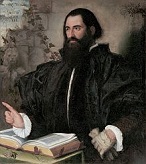
In 1544 the cultivation and consumption of the tomato (golden apple) is first described in European lit. in a herbal by Siena, Italy-born physician-botanist Pietro Andrea Gregorio Mattioli (Matthiolus) (1501-77).
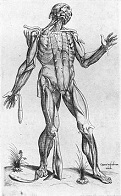
In 1545 Flemish printer (refugee in London) Thomas Geminus (Lambrit) (1510-62) pub. Compendiosa Totius Anatomie Delineatio, Aere Exarata (A Complete Delineation of the Entire Anatomy, Engraved on Copper), showing how cheaper is better, replacing hand-painted illuminations and woodcuts, hastening the spread of know know knowledge.

In 1546 Glauchau, Saxony, Germany-born "Father of Mineralogy" Georgius Agricola (Georg Bauer or Pawer) (1494-1555), De Natura Fossilium; first attempt to categorize rocks, minerals, and sediments since Pliny's "Natural History; in their 1912 English tr., Herbert and Lou Hoover wrongly claim that he coined and first used the term "petroleum" (Lat. "rock oil") here.


In 1546 Flemish geographer-cartographer Gerardus (Gerhardus) Mercator (1512-94) (Lat. "merchant") states that the Earth has a magnetic pole. In 1568 he develops the Mercator Projection, a cylindrical projection for maps and charts, and pub. a World Projection showing North and South Am. separated from Europe and Asia by vast oceans, which wows the crowds and pretty much puts the flat Earthers out of biz?; the distortion shows Greenland as larger than South Am., shrinking Africa and other equatorial regions and enlarging the polar areas - motivated by white racism?
In the 1550s the Screwdriver and Wrench are invented by Euro gunsmiths and armorers? Also in the 1550s Sealing Wax is first used in Europe.

In 1550 Gerolamo (Girolamo) (Geronimo) Cardano (1501-76) of Italy describes the Biconvex Lens in use in a camera obscura.

In 1551 Swiss naturalist Conrad Gessner (Konrad von Gesner) (1516-65) pub. Historiae Animalium (5 vols.) (4.5K pages) (1551-8), founding modern Zoology (Animal Biology); in 1554 he pub. the first scientific description of the Guinea pig; the earliest known portrait of a guinea pig is painted in Elizabethan England in 1580.
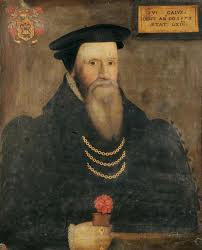
In 1552 English physician John Caius (Kays) (1510-73) (pr. like keys) (of Gonville and Caius College, Cambridge fame) pub. the first clear description of Sweating Sickness.


In 1552 Roman anatomist Bartolommeo Eustachio (Lat. "giving fruit") (1500-74) discovers the Eustachian Tubes, the adrenal glands, and the detailed structure of the teeth, but his discoveries are not pub. until 1611 (1714) in Tabulae Anatomicae and Libellus de Dentibus.

In 1553 French naturalist Peter Baleen, er, Pierre Belon (1517-64) pub. De Aquatilibus, the first scientific study of marine animals, revealing that cetaceans (whales, dolphins, porpoises) breathe air with lungs, and other shocking discoveries.
In 1553 before being burned, Catalan scholar Miguel Serveto (Servetus) (1511-53) pub. Christianismi Restitutio, a theological discussion in which he mentions that blood passes from the right to left ventricle via the lungs, where it changes color, becoming the first Westerner to pub. the theory of the pulmonary circulation; he had been a pupil of Johannes Gunther of Andernach in Paris at the same time as Vesalius.

In 1554 Italian naturalist ("Father of Natural History Studies") Ulisse Aldrovandi (1522-1605) (author of the first book on fishes that doesn't lump them with other aquatic forms, and founder of the first botanical garden in Europe in Bologna) pub. the 17-vol. Herbarium, becoming the biggest herbarium of the cent.
In 1554 Realdo Colombo's Catalan pupil Juan Valverde de Amusco (Hamusco) (1525-?) pub. the first account of the Pulmonary (Lesser) Circulation.

In 1557 French Huguenot potter Bernard Palissy (1510-89) invents Enamel after 16 years spent trying to imitate Chinese porcelain, causing imitators to begin cranking out Palissy Ware, featuring molds of real creatures incl. fish and crabs; in 1580 he pub. In 1580 French Huguenot pottery maker Discours admirables, de la nature des eaux et fontaines, tant naturelles qu'artificielles, des metaux, des sels et salines, des pierres, des terres, du feu et des maux (Paris), which applies ancient Alexandrian principles of hydraulics, and incl. a theory of the origin of springs and underground waters, enunciating the modern theory of the origin of fossils.
In 1557 Jean Pena, royal mathematician at Paris rejects the spheres of fire and of the planets after determining by optical reasoning that some comets are beyond the Moon.

In 1557 English mathematician Robert Recorde (1510-58) pub. The Whetstone of Witte, which introduces the = (equals) symbol into mathematics.

In 1557 Italian scholar-physician Julius Caesar Scaliger (1484-1558) discovers the metallic element Platinum (pt) (#78)

In 1558-70 Italian polymath philosopher Giambattista della Porta (1535-1615) pub. Magia Naturalis (Natural Magic) (20 vols.), "Wherein are set forth all the riches and delights of the Natural Sciences", explaining the difference between magical and physical events such as magnetism, and showing how to put a convex lens inside the aperture of a camera obscura to brighten the projected image, making it more popular. In 1560 he founds the Academia Secretorum Naturae (Accademia dei Segreti), the first modern scientific society in Naples; it is ordered closed by the Church in 1580.

In 1559 Italian anatomist Renaldus Columbus (Matteo Realdo Colombo) (1516-59) pub. De Re Anatomica, which puts forward the idea of pulmonary blood circulation, and details experiments supporting it, incl. finding that the pulmonary vein contains blood not fumes like the Galenists claimed; describes the position and posture of the human embryo, and provides the first description of Ankylosing Spondylitis, which causes the vertebrae to fuse together; claims to be the first anatomist to observe the clitoris, "seat of woman's delight", uttering the immortal soundbyte "Since no one has discerned these projections and their workings, if it is permissible to give names to things discovered by me, it should be called the love or sweetness of Venus" - so we have to eat the box to get the fiber?
In 1565 the Royal College of Physicians in London is empowered to carry out human dissections.

In 1565 the first known drawings of fossils are pub. by Swiss naturalist Conrad Gessner (Konrad von Gesner) (1516-65); meanwhile the first Graphite (Plumbago) Pencils (invented by von Gesner) begin to be manufactured in England from graphite mined in Borrowdale in the Lake District of N England, the purity being so high that it corners the Euro market
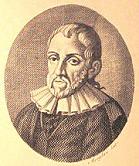
In 1565 Italian Renaissance anti-Aristotelian philosopher-scientist ("First of the Moderns") Bernardino Telesio (1508-88) pub. De Rerum Natura Luxta Propria Principia (On the Nature of Things According to Their Own Principles), basing his theory on not matter and form but matter and force, the latter consisting of heat (which expands) and cold (which contracts); too bad, his attacks on Aristotelianism piss-off the Church, and his books are banned for awhile after his death.
In 1567 Italian mathematician Fabrizio Mordente (1532-1608) pub. the first description of the Proportional (Military) Compass (Sector).

On July 13, 1568 Alexander Nowell (1507-62), dean of St. Paul's in London leaves his bottle of beer by a river bank for a few days, and when he comes back it "opened with a bang" and was "very tasty", becoming the first known mention of Bottled Beer.

In 1569 Jacques Besson (1540-76) of France pub. Theatrum Instrumentorum (Theatrum de Instrumens Mathematiques et Mechaniques), describing his screw-cutting lathe designs, incl. cams and plates, making him the 2nd Leonardo da Vinci?
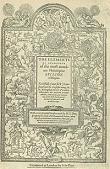
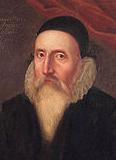
In 1570 Sir Henry Billingsley ((-1606) pub. The Elements of Geometrie of the Most Ancient Philosopher Euclide of Megara, the first English trans. of "Euclid's Elements"; printed in folio by John Day, incl. several 3-D fold-up diagrams illustrating solid geometry; the preface by mathematicisn-astrologer John Dee (1527-1609) extols the virtues of mathematics, becoming more important than Francis Bacon's "The Advancement of Learning" (1605).
In 1571 English mathematician Leonard Digges (1520-59) invents the Theodolite for surveying, and pub. Pantometria, a manual of surveying, pitching his father Leonard Digges (1520-59) as the inventor of the reflecting and refracting telescopes between 1540-59; too bad, he brags too much and claims that he could "read letters, numbered pieces of money with the very coin and superscription thereof, cast by some of his friends of purpose upon downs in open fields, but also seven miles off declared what hath been done at that instant in private places."

In 1571 the Strasbourg Cathedral Astronomical Clock, designed by Conrad Dasypodius (1530-1600) is begun by brothers Isaac Habrecht (1544-1620) and Josias Habrecht (1552-75) from Schaffhausen, becoming the flagship of math, physics, and scientific know-how (finished 1574) (replaced 1842).
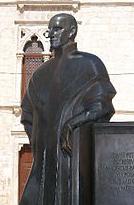
In 1571 Croatian-born Italian Platonic philosopher-scientist Franciscus Patricius (Francesco Patrizi or Patrizzi) of Cherso (1529-97) (student of Bernardino Telesio and master of Giordano Bruno) pub. Discussiones Peripateticae (Discussionum Peripateticorum) (15 vols.) (Basel), which claims that Aristotle's teachings directly oppose Christianity, while Plato's foreshadow it, attacking Aristotle's life and character and the authenticity of his works, attempting to refute his doctrines theologically. In 1591 he pub. Nova de Universis Philosophia (New Philosophy of Ideas) (Basel), which goes back to the Ionians and Presocratics to portray God as "First Light", which is later adopted by Galileo to mathematize physics.





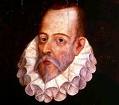

On Aug. 3, 1571 after an 11-mo. siege, 70K Turks capture Famagusta, capital and chief city of Cyprus, and massacre its pop.; on Oct. 7 after Pope (1566-72) Pius V (Antonio Michele Ghislieri) (1504-72) signs the Holy League Alliance with Spain and Venice, 200 Spanish and Venetian galleys under 24-y.-o. Don John (Juan) of Austria (1547-78) (half-brother of Philip II of Spain, and illegitimate son of HRE Charles V) defeat the 230-galley Turkish fleet at the 6-hour Battle of Lepanto (Naupactos) in a bay at the mouth of the Gulf of Patras (entrance to the Gulf of Corinth) off Lepanto in W Greece (biggest naval battle in Mediterranean history?) (last major naval battle fought exclusively by rowing vessels?) just before 5 p.m., with 12K Christian casualties vs. 6K Muslim POWs taken and 30K of 56K KIA, incl. Turkish fleet grand adm. Muezzinzade Ali Pasha aboard his ship, becoming the first defeat of Muslims by Christians on the sea, a big V for Western military technology, and the beginning of the end of the Ottoman naval threat in the C Mediterranean, destroying the myth of their invicibility, although both fleets are heavily damaged and the Ottomans speedily rebuild their fleet and restore their supremacy on the W and E sides; Spanish writer Miguel de Cervantes Saavedra (1547-1616) is wounded in the battle, calling it "the most noble and memorable event that past centuries have seen or future generations can ever hope to witness"; Italian-born Muslim convert Ottoman adm. Uluj Ali Reis (Giovanni Diongini Galeni) (1519-87) captures the flagship of the Maltese Knights along with its great banner before gathering the fleet's remaining 87 ships and returning to Constantinople, getting promoted on Oct. 29 to grand adm.; since most of the Ottoman sailors had been sent home for winter and the rest were involved in political squabbles, and the Christians outnumbered them, it was an overrated V for Christ?; the failures of war galleys cause their use to decline as better designs are sought and bigger vessels built; many Muslim POWs are taken and used to man Christian oars; bald, white-bearded future saint Pope Pius V allegedly sees the V in a vision in Rome at the exact moment it happens, ascribing it to intercession by Our Lady the Virgin Mary, even though he isn't informed of it officially until Oct. 21? - Playtex, who knows you like we do?

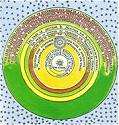
In 1572 Danish metal-nosed astronomer Tycho Brahe (1546-1601) (known for keeping a tamed elk and a dwarf named Jepp as a jester) discovers a supernova ("New Star") in the constellation Cassiopeia, startling the establishment, who believe that the heavens are unchanging; the discovery wows Danish king Frederick II, who in 1575 pays for Uraniborg Castle ("fortress of the heavens"), with a complete observatory on Hven Island between Sweden and Denmark; he also produces the first star catalog, correcting grave errors in the Alfonsine and Prutenic Tables; meanwhile English astronomer Thomas Digges (1546-95) uses the parallax of the supernova to conclude that it has to lie beyond the orbit of the Moon, shocking the establishment, which believes that no change can take place among the fixed stars. In 1577 Brahe measures a comet as at least 4x as distant as the Moon, proving that they're not atmospheric phenomena. In 1576 Thomas Digges pub. A Prognostication Everlasting, his father's perpetual almanac, with a new appendix containing the first detailed discussion of the Copernican heliocentric theory in the English language; "This orb of stars fixed infinitely up extends itself in altitude spherically, and therefore immovable the palace of felicity garnished with perpetual shining glorious lights innumerable, far excelling over [the] Sun both in quantity and quality the very court of celestial angels, devoid of grief and replenished with perfect endless joy, the habitacle for the elect."
In 1572 Italian mathematician Rafael Bombelli (1526-72) pub. Algebra, which shows the use of continued fractions.

In 1573 Constanzo Varolio (1543-75) of Italy pioneers a new method of dissecting the brain by starting at the base, and discovers the Optic Nerve and Pons.

In 1575 Spanish physician Juan Huarte de San Juan (y Navarro) (1529-88) pub. Examin de Ingenios para las Ciencias, becoming the first to connect psychology with physiology.

In 1576 Flemish physician-botanist Carolus Clusius (1526-1609) pub. a treatise on the flowers of Spain and Portugal, founding Modern Botany.
In 1576 French mathematician Francois Viete (Franciscus Vieta) (1540-603) discovers Decimal Fractions. In 1591 he pub. In Artem Analyticem (Analyticam) Isagoge, the first book to use letters for algebraic quantities (consonants for constants, vowels for variables), inventing Analytical Trigonometry.
In Jan. 1580 after Muslim religious leaders object to it, Sultan Murad III orders the destruction of the astronomical observatory in Constantinople.


In 1581 with clocklike precision, Italian scientist Galileo Galilei (1564-1642) discovers that the time taken by a swinging lamp in the Cathedral of Pisa does not depend on the angle through which it swings (i.e., a pendulum swings isochronously). In 1591 he drops a 1 lb. and a 100 lb. weight from the Tower of Pisa simultaneously to prove a point in physics about bodies falling at the same speed regardless of mass, refuting the know-it-all Aristotelians. In 1593 he invents the Thermoscope, a primitive uncalibrated thermometer used as a novelty perpetual motion machine.
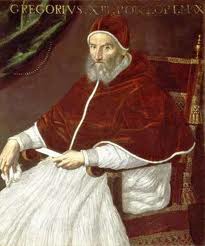
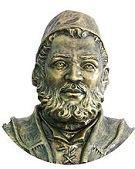

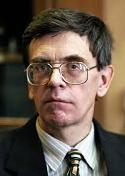

Speaking of clocks, er, calendars. On Feb. 24, 1582 upon the recommendation of German Jesuit astronomer Christopher Clavius (1538-1612), Pope (since May 13, 1572) Gregory XIII (1502-85) issues the bull Inter Gravissimas, decreeing a changeover from the Julian Calendar to the Gregorian Calendar; 10 days (lost since Jan. 1, -46, when the Julian Calendar began) are to be dropped, so that Oct. 15 (Fri.) immediately follows Oct. 4, or Dec. 20 (Mon.) follows Dec. 9; the Papal States, Spain, Portugal, and Poland change in Oct., France, Holland, Belgium, and Scandinavia in Dec.; the Roman Catholic states of Germany and Switzerland adopt it in 1584, followed by Hungary in 1587; too bad, Protestant countries suspect a rat and refuse to change, and the Continental Protestant states hold out until 1700, and England and its colonies till 1752; Russia holds out until 1918, Greece until 1924, and non-Euro states don't adopt it until the 19th and 20th cents., Japan in 1873, Egypt in 1875, Turkey in 1926, and China in 1949; the figure for the length of the year from Copernicus' De Revolutionibus Orbium Coelestium is proposed but not used as the basis of the reform calendar; after a suggestion by Vatican librarian Topo Gigio, er, Aloysius Lilius (Luigi Lilio or Giglio) (1510-76), only century years (1600, 1700, etc.) with the century part itself evenly divisible by four (1600 but not 1700) are leap years, which causes three leap years to be taken out of each 400, trimming the avg. calendar year down quite fortunately to only about 26 sec. longer than the Earth's real orbital period, which will take 3,323 years to become 1 day out of synch; too bad, there should have been a 13-day discrepancy, not a 10-day one, causing the Phantom Time Hypothesis to be developed by Herbert Illig (1947-), Anatoly Fomenko (1945-), Uwe Topper (1940-) et al., that phony phantom centuries were manufactured during the Renaissance to create a nonexistent Dark Ages; Pope Gregory's new calendar for the Christian world changes the date of the new year from Apr. 1 to Jan. 1, and those who still celebrate New Year's Day on Apr. 1 begin to be known as April Fools.
In 1585 Bartholomew Newsam (1530-87) of the Strand, London constructs the first English traveling and standing clocks.
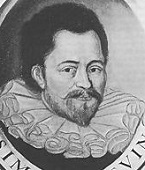
In 1585 Flemish mathematician-engineer Simon Stevin (Stevinus) (1548-1620) pub. the booklet "Die Thiende" (The Art of Tenths), expounding the use of decimal fractions, causing their daily use; he goes on to predict the universal introduction of decimal coinage, weights, and measures; in 1600 he invents the first wind-driven land vehicle.

In 1590 German scholastic philosopher (believer in withcraft) Rudolph (Rudolf) Goclenius (Gockel) (Göckel) (1547-1628) coins the term "psychology"; really coined in the 1530s by Croatian humanist Marko Marulic (1450-1524)?
About 1590 the first linen Condoms are used in Italy to prevent disease, after which their contraceptive use begins to be recognized - not that everybody didn't want big families to support them in their old age?
In 1590 Dutch spectacle-maker Zacharias Janssen (1580-1638) allegedly invents the Compound Microscope, using two double convex lenses in a tube.
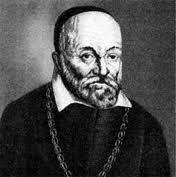
In 1594 Italian "Father of Embryology" Hieronymus Fabricius (Girolamo Fabrici) (1537-1619) of the U. of Padua (Galileo's personal physician and William Harvey's teacher) performs the first public dissection. In 1600 he pub. Tabulae Pictae, which announces his discovery of the cerebral fissure. In 1604 he pub. De Formata Foetu, a study of human embryology, containing his discovery that leg veins have unidirectional valves permitting blood to flow only toward the heart, and that blood circulates in the fetus through the umbilical cord.
In 1594 Windmills are first used in Holland to drive mechanical saws by sawmill owner Cornelis Corneliszoon van of Uitgeest (Krelis Lootjes) (1550-1600), who speeds up the conversion of log timber into planks by 30x.
In 1595 German mathematician Bartholomaeus (Barthelemy) (Bartholomeo) Pitiscus (1561-1613) pub. the Latin work Trigonometria: sive de solutione triangulorum tractatus brevis et perspicuus (5 vols.) in Heidelberg, coining the term "trigonometry", which carries into English (1614) and French (1619) translations; je first borrows, er, uses decimal pits, er, points in his trigonometry tables, which he gets the big idea of using for problems on Earth instead of the heavens.

In 1596 Sir John Harington (Harrington) (1560-1612), a godson of Elizabeth I pub. A New Discourse of a Stale Subject, Called the Metamorphosis of Ajax, which punningly describes his invention of the first practical jakes (john) (flush toilet), complete with a water tank above, and a faucetlike handle for flushing, which he built for the queen at her palace in Richmond; the ridicule it draws causes the queen to banish him, deny a patent on grounds of propriety, and remove the stinking contraption, with the smell wafting up through the pipe (it takes until 1775 to figure out to put a curve in the pipe) - get that hairy john out of my bath?

In 1597 English gay brain man Sir Francis Bacon (1561-1626) pub. Essays, Civil and Moral, Vol. 1, which describes the process of inductive reasoning, reversing Aristotle and his process of deductive reasoning, becoming the beginning of formal scientific thought in Europe.
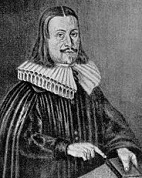
In 1597 German physician-chemist Andreas (Andrew) Libavius (1555-1616) pub. Alchymia, the first systematic chemistry textbook; describes the use of chemistry for drugs, acknowledging the possibility of transmutation; describes how ammonia turns cuprous salt solutions dark blue; first to claim that fermentation and putrefaction are different processes, and to describe a method for distilling alcohol; describes how to make many useful chemicals such as hydrochloric acid and ammonium sulphate.

In 1598 Cornelius (Cornelis) Drebbel (1572-1633) of Holland receives a patent for a pump and clock that operates by perpetual motion powered by atmospheric changes, causing him to become a star in scientific circles.
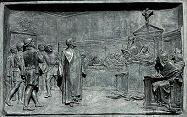



On Feb. 17, 1600 after Cardinal Robert Bellarmine (1542-1621) demands a full recantation of his philosophy, and he appeals to Pope Clement VIII hoping only for a partial recantation, and the pope responds by telling them to burn the bum, Italian philosopher Giordano Roddenberry, er, Giordano Bruno (b. 1548) tells them "Perhaps you, my judges, pronounce this sentence against me with greater fear than I receive it", then is led naked to the Campo de' Fiori in Rome, "his tongue imprisoned because of his wicked words", and burned at the stake for his heretical opinions, esp. the infinity of inhabited worlds; "He insisted till the end always in his damned refractoriness and twisted brain and his mind with a thousand errors. Yes, he didn't give up his stubbornness, not even when the court ushers took him away to the Campo de' Fiori. There his clothes were taken off, he was bound to a stake and burned alive. In all this time he was accompanied by our fraternity, who sang constant litanies, while the comforters tried till the last moment to break his stubborn resistance, till he gave up his miserable and pitiable life" (Fraternity of St. John the Beheaded, 1889); his works are placed on the Vatican's Prohibited Index in 1603, and he becomes a martyr to Trekkies, er, scientists, who claim he was burned just for his Copernican views, causing the Church to claim it was only because of his heretical religious beliefs, incl. that Jesus Christ was merely a magician, the Holy Ghost is the soul of the world, and the Devil can be saved, although the Church gives it away at the time by using the same rooms where he is questioned to persecute Galileo Galilei; his death seems to propel scientific effort in Protestant countries; in 1889 a monument to him backed by Victor Hugo, Herbert Spencer, Ernest Renan, Ernst Haeckel, Henrik Ibsen et al. is erected on the site of his execution, and another is erected in Berlin on Mar. 2, 2008; in 2000 Pope John Paul II expresses "profound sorrow" for what his church did - Burn Bruno Burn is how many years from Live Long and Prosper?


In 1600 English royal physician William Gilbert (1544-1603) pub. De Magnete, Magneticisque Corporibus, et de Magno Magnete, Tellure, Physiologica Nova, the first great English scientific work, containing his discovery that the Earth itself (not just some island in the N) is a giant magnet, and coins the terms "electricity" (Lat. "electricus" = like amber in its attractive properties), "electric force", "electric attraction", and "magnetic pole".
About 1600 HRE Rudolf II's jewel cutter Caspar Lehmann invents the cut-glass process.

Also in 1600-1 English superbrain William Shakespeare (1564-1616) writes The Tragedy of Hamlet, Prince of Denmark, not everybody has to go into science.
In 1603 Bolognese alchemist Vincenzo Cascariolo discovers Lapis Solaris, a heated mixture of powdered barite (heavy spar) (barium sulfate) and coal that gives off a bluish glow at night and is recharged by exposure to sunlight, pioneering the study of luminiscence; thinking it's the fabled Philosopher's Stone that turns inferior metals to gold, he starts the myth of the Bologna Stone.

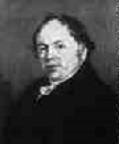
In 1603 German Jesuit astronomer Christoph Scheiner (1575-1650) invents the Pantograph (Gr. "pant" + "graph" = all/every + write) for reproducing enlarged or reduced maps and drawings; he doesn't pub. the invention until 1631 - without fishing your socks from the bottom of the sheets? In 1821 Scottish mathematician-astronomer William Wallace (1768-1843) improves the pantograph, inventing the Eidograph.

In 1606 Welsh clergyman-mathematician Edmund Gunter (1581-1626) invents Gunter's Chain for surveying, consisting of 100 links of 7.92 in. each (66 ft. total). In 1622 he discovers the magnetic variation of the compass, i.e., that the magnetic needle does not retain the same declination in the same place over time.



Two ways to shoot the Moon? In 1608 Dutch eyeglass maker Hans (Johann) Lippershey (1570-1619) applies for a patent for the telescope (Gr. "far-seeing"), which is first used to look at the sky by Galileo, who constructs his own next July 1 mo. after hearing about it.
In 1609 the salary of Pisa-born Italian scientist Galileo Galilei (1564-1642) is doubled by the senate of Venice for his invention of the Astronomical Telescope after he views the Moon at 6X magnification in Aug. (later increased to 20X), noting that it has mountains, and discovers Jupiter's moons (not all 63 of them); a believer in astrology, he prepares the horoscope of the Grand Duke of Tuscany and predicts that he will have a long life, only to see him die a few weeks later - a little bit of bacon, a little bit of beans?
In 1609 the first Rinderpest Zanzootic (cattle plague) begins (ends 1713), causing a simultaneous anthrax pandemic that kills 60K in S Europe by 1713; others follow in the 1740s and 1770s, killing 200M cattle by 1769, 20% of the total pop.; meanwhile Venetian physician Bernardino Ramazzini (1633-1714) begins scientific study of the causes of rinderpest, causing him to suggest immunization.
On Jan. 7, 1610 Galileo sights four of Jupiter's moons (Ganymede, Io, Europa, Callisto), calling them the Medician Stars after the Medicis; by the end of the year he observes the Phases of Venus, becoming the first direct evidence for the Copernican Theory, which he waits until 1613 to pub. In 1610 Galileo pub. Siderial (Starry) Messenger (Sidereus Nuncius), becoming the first pub. look at the sky through a telescope, bolstering the Copernican theory with its description of the mountains on the Moon and the four satellites of Jupiter ("sideria Medicea"), a mini-model of Copernicus' Solar System; he also discovers sunspots, and uses them to estimate the rate of the Sun's rotation, which really freaks out the Aristotelians, who believe in the immutability of the "perfect" heavenly bodies; next year Johannes Kepler coins the word "satellite", from the Latin word for assistant.
In 1610 French chemist Jean Beguin (1550-1620) pub. Tyrocinium Chymicum (Beginner's Chemistry) in Paris, becoming the first chemistry textbook.
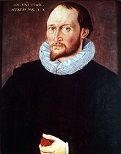
In 1610 after beating Galileo by 4 mo. and making the first drawing of the Moon through a telescope on July 26, 1609, English astronomer Thomas Harriot (1560-1621) discovers sunspots - you're the cream in my coffee?

In 1610 French astronomer Nicolas-Claude Fabri de Pieresc (1580-1637) discovers the Orion Nebula.
 In 1611 Dalmatian ecclesiastic Marco Antonio de Dominis (1560-1624) pub. the first scientific explanation of the rainbow.
In 1611 Dalmatian ecclesiastic Marco Antonio de Dominis (1560-1624) pub. the first scientific explanation of the rainbow.

In 1611 German astronomer Johannes Kepler (1571-1630) pub. Dioptrice, containing the first explanation of the optics of myopia, and the first theory of the rainbow; also describes the double convex microscope; he also pub. Phyllotaxis, which mentions the Fibonacci Sequence. In 1604 he pub. Supplement to Witelo, Expounding the Optical Part of Astronomy, incl. Ad Vitellionem Paralipomena, the first explanation of the optics of the human eye. In 1618 he pub. Epitome Astronomia Copernicanae (The Epitome of Copernican Astronomy), a textbook on astronomy which describes it in modern terms, replacing scholastic mumbo-jumbo with observation, translation into numbers, and use of mathematical models to form hypotheses which "save the appearances" and describe the true motions of the planets and their causes, which had been hidden in "God's pandects"; those who can penetrate his shrouded Latin prose get a shock; Kepler's salary, which is paid only irregularly before the Thirty Years' War, is hardly paid at all; his mommy is charged with witchcraft during one of the many German witch hunts, and narrowly escapes execution; meanwhile, the Catholics keep persecuting him for not worshipping images and saints, and even his fellow Lutherans in Linz exclude him from their Evening Meal because he doesn't believe in God's omnipresence; "Suffering along with many brothers for the sake of religion and for the glory of Christ by enduring harm and disgrace, by leaving one's house, fields, friends, and home, I would never have believed all of this could be so agreeable." (Kepler) In 1619 he pub. Harmonices Mundi (The Harmony of the World), which contains his Third Law of Planetary Motion (the squares of the periods of revolution are proportional to the cubes of the mean distances).
In 1611 Simon Sturtevant of England first uses coke to make iron.
Also in 1611 the King James (Authorized) Version of the Holy Bible (66 books) is pub. in England, throwing Science for another big loop; commissioned in 1604 (lucky that the 1605 Guy Fawkes Plot to replace the govt. with Roman Catholics didn't succeed), with the work divided between ? translators (? Anglican, ? Puritan, 0 Roman Catholics, 0 Separatists) in six committees with 15 rules to follow, using ancient mss. for reliability, and deliberately preserving ambiguities, e.g. Romans 5:12: "Wherefore, as by one man sin entered into the world, and death by sin; and so death passed upon all men, for that all have sinned" (can mean that all men die because of sin, and that all men sin because they are under God's judgment of death); most of the language is William Tyndale's, but without the pesky marginal notes challenging the divine right of kings; James I's planned royal authorization of the final work never happens?; the intent is to make "of many good translations one principal good one", according to translator Miles Smith (1554-1624) in Preface to the Translation; it takes its place beside the Bishops' Bible (official vers. for use in Anglican churches, original ed. 1568, revised ed. 1602) (basic source for the King James Bible?), the Geneva Bible (1575) (known for Calvinist-slanted footnotes dissing the divine right of kings, always translating the word king as tyrant), and the 1582 Rheims trans. of the 5th cent. Roman Catholic Vulgate; too bad, the King James Bible is initially universally panned, and the Puritans continue to use the Geneva Bible, causing Charles I to ban it in 1644, leading to the Puritans taking over the govt. and beheading him in 1649, later realizing the superiority of the KJV; translator Lancelot Andrewes (1555-1626), master of Pembroke College, Cambridge U. is appointed bishop of Winchester in 1619, becoming the mentor of Reformed Roman Catholicism in the post-Reformation Anglican Church; the notes on the trans. process are stored in Whitehall, and are destroyed in the 1598 Whitehall Fire; in modern times the Ruckmanists claim special divine inspiration for the translators, even though they are govt. employees told what to do by the hardly saintly king, and explicitly deny special inspiration; a case of disguised Am. WASP racism?
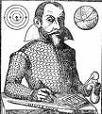
In 1612 German astronomer Simon Marius (1573-1625) rediscovers the Andromeda Nebula, which was first noted by the Muslims in 963.
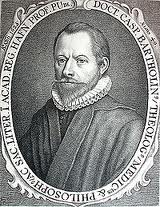
In 1613 Caspar Bartholin the Elder (1585-1629) becomes prof. of medicine at Copenhagen U., after which two generations of descendants keep the chair for the next 125 years, making key discoveries in anatomy and medicine; still having a foot in both camps, in 1624 Caspar falls ill, makes a vow that if he recovers he will switch to divinity, then switches to prof. of divinity - back when Science was still small enough to become a family thang?
In 1613 Copper coins first come into use in Europe - got the idea from Pocahontas? In 1613 German miners become the first to use explosives in mining with drilling.
In July 1613 Galileo Galilei and his archenemy Lodovico delle Colombe (1565-1616) (known for challenging his idea that the Earth revolves around the Sun) debate in Florence on the question of why ice floats on water, with Galileo arguing that ice floats because it's less dense than water, and delle Colombe winning after floating a thin wafer of ebony using surface tension.


In 1614 Scottish Protestant mathematician John Napier (Neper) of Merchiston (1550-1617) pub. Description of the Marvelous Canon of Logarithms (Mirifici Logarithmorum Canonis Descriptio), which gives mathematicians and astronomers a new improved method of computation, and uses the decimal point to express decimal fractions. In 1621-2 William Oughtred (1574-1660) of England invents the logarithmic scale along with the slide rule, which does multiplication and division by adding and subtracting logarithms - did it hurt? Oughtred also coins the terms "x" for multiplication, "sin" for sine, and "cos" for cosine.

In 1614 Swiss physician Felix Platter (Plater) (1536-1614) first describes Dupuytren's Disease; the first proponent of the Germ Theory of Disease?

In 1614 German astronomer Simon Marius (1573-1624) pub. Mundus Iovialis (Jovalis), which claims to have discovered Jupiter's four major moons before Galileo; true or not, he names them Io, Europa, Ganymede (largest moon in the Solar System), and Callisto (3rd largest moon in the Solar System, but only 99% the diam. of Mercury) (always shows same face toward Jupiter); Io, Europa and Ganymede have an orbital resonance that gives them tidal heating.
In 1615 beleaguered Italian scientist Galileo Galilei (1564-1642) writes an Open Letter to Madame Cristina of Lorraine, Grand Duchess of Tuscany on his Copernican views, trying to clear himself of the appearance of being an unbeliever, claiming that the Book of Nature is to be read in the language of mathematical science, while the Scriptures when referring to physical fact are not to be taken literally, "nor does God reveal himself less admirably in the effects of Nature than in the sacred words of Scripture"; the purpose of the Scriptures is to teach us "how to go to heaven, not how the heavens go"; the priestly authorities are not amused, and in Dec. Galileo is summoned before the Inquisition in Rome and put on trial for his scientific views in a super-rigged trial; "To assert that the Earth revolves around the Sun is as erroneous as to claim that Jesus was not born of a virgin" (Cardinal Robert Bellarmine (1542-1621), head of the Congregation of the Holy Office, who personally framed the decision to burn Giordano Bruno in 1600, and is not a student of astronomy); Galileo's observations with the telescope actually backed the Tychonic view that the Earth doesn't move, but he stuck with the Copernican system anyway, and was just lucky?
On Feb. 16, 1616 Galileo writes a letter to Monsignor Dini, trying to clear himself of charges of heresy and blasphemy, but failing to convince the Church of the truth of Copernicanism; on Feb. 24 the Qualifiers of the Holy Office pub. a Report on the Bad Boy Galileo condemning the proposition that "the Sun is the center of the world and entirely devoid of local motion" as "foolish and absurd philosophically, and formally heretical", while the proposition that "the Earth is not the center of the world nor immovable, but moves as a whole, and also with a daily motion" is "to receive the same censure in philosophy and, as regards theological truth, to be at least erroneous in faith"; on Feb. 26 Galileo is ordered by Holy Office Commissioner Gen. Vincenzo Maculano da Firenzuola "to relinquish altogether the said opinion that the Sun is the center of the world and immovable and that the Earth moves, nor further to hold, teach or defend it in any way whatsoever, verbally or in writing"; on Mar. 3 the Congregation of the Index, headed by Cardinal Robert Bellarmine (1542-1621), without mentioning Galileo by name bans all writings which treat Copernicanism as anything but an unproven hypothesis, and prohibits Copernicus' 1543 De Revolutionibus from pub. until it is "corrected" to state that it is only presenting a hypothesis (done in 1620); the anti-Copernican decree, which is never officially ratified by the pope is not annulled until 1757; as chastened Galileo mumbles, "epur si muove" (nevertheless, it moves).

In 1616 English physician William Harvey (1578-1657) first reveals the function of the heart and complete circulation of the blood at the Royal College of Physicians in London, causing detractors to begin calling him "the Circulator". In 1628 he pub. On the Motion of the Heart and Blood in Animals (Exercitatio Anatomica de Motu Cordis et Sanguinis), containing the first accurate theory of the heart and circulatory system.
In 1616 Italian philosopher Lucilio Vanini (1585-1619), who likes to call himself Giulio Cesare (his real name and he's just lucky?) suggests that humans evolved from apes; he is burned for it three years later - did they do the ape imitations too?
In 1616 Italian physician Santorio Santorii (Sanctorius) (1561-1636) invents the first Medical Thermometer - guess where they sanctimoniously stick it?

In 1617 Dutch mathematician-astronomer Willebrord Snell (Snellius) (Willebrord Snel van Royen or Roigen or Roijen) (1580-1626) first describes a method for surveying by triangulation, taken from ancient Greek mathematician Eratosthenes; he also uses 96-sided polygons to improve the value of pi from 2 to 7 decimal places. In 1621 he discovers Snell's Law of Refraction, a sine ratio called the refractive index between the angles of incidence and refraction of light entering a block of glass; too bad, he doesn't pub. it, and it takes until 1703 for Huygen to pub. his results in his "Dioptrica".
In 1617 Galileo's collaborator Benedetto Castelli uses a telescope to determine that Mizar, one of the two stars in the Big Dipper is a binary; in 1890 Mizar A is discovered to be a binary, followed in 1908 by Mizar B, followed in 2009 by Alcor, making it a sextuplet group.
On May 23, 1618-May 15, 1648 the Thirty Years' War tears Europe apart with Protestant-Roman Catholic fighting, killing 8M.

On Nov. 10-11, 1619 (St. Martin's Day) (night) after joining the Dutch States Army in 1618, La Haye en Touraine, France-born philosopher-mathematician (Roman Catholic) (Rosicrucian) ("Father of Modern Philosophy") Rene (René) Descartes (1596-1650) has divine visions in Neuburg an der Donau, Germany in which he "discovered the foundations of a marvelous science", which later becomes Analytic Geometry, along with his famous dictum "Cogito ergo sum" (Je pense donc je suis), causing him to dedicate his life to the mathematical basis of Nature; in 1620 he leaves the army, returning to the Dutch Repub. in 1628, spending 20 years formulating his philosophical works; in 1637 after the horrific Galileo affair, he pub. Discourse on Method (Discourse on the Method of Rightly Conducting One's Reason and Seeking Truth in the Sciences (Discours de la Methode pour bien Conduire sa Raison, et Chercher le Verite dans les Sciences); an epoch-making work expounding the technique of divide and conquer, containing the three appendices (Qui Sont des Essais de Cete Methode): La Dioptrique, advancing the corpuscular theory of light; Les Meteores: Traite de la Lumiere, on cosmology; and La Geometrie, founding the field of analytic geometry and introducing the concepts of a coordinate plane and a mathematical function. In 1644 he pub. Principia Philosophiae (Principles of Philosophy) in Amsterdam, containing the ultimate philosophy soundbyte "Je pense, donc je suis" ("I think, therefore I am"); too bad, it kowtows to the Roman Catholic 1616 anti-Copernican decree by stating that "I want what I have written to be taken simply as an hypothesis, which is perhaps far removed from the truth"; it declares that all motion is relative, thus the Earth can be considered at rest like the Church dictates, drawing criticism from Newton; also that bodies can act on each other only through contact; famous for its diagrams of vortices in which planets are carried in the whirlpool of subtle matter around the Sun - don't try to fight it, don't try and save me, she's a woman in love? In 1662-4 he posth. pub. Treatise on the World, proposing the Dualistic Model of Reality, mind vs. matter.
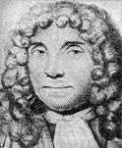
In 1620 Niccolo Cabeo (1586-1650) of Italy discovers that electrified bodies can attract non-electrified ones and that two electrified bodies repel each other.


In 1620 Cornelius (Cornelis) Drebbel (1572-1633) of Holland invents the first navigable (steerable) Submarine, based on a leather-covered wood frame for the British Navy, and later demonstrates it to Charles I - it's corny and it dribbles, but it's all mine?
In 1623 Sir Francis Bacon invents Steganography.
In 1623 William Schickard invents the first mechanical adding device with carry; math prodigy Blaise Pascal later lays claim to its invention even though he is still shitting yellow at the time; Pascal also invents the Roulette Wheel?

In 1624 Brussels-born Belgian Flemish chemist Jan (Johannes) Baptist van Helmont (1580-1644) pub. his discovery that the atmosphere is composed of gases, and coins the term "gas" (Gr. "chaos" = unformed) for a compressible fluid - that would make it classical gas?

In 1625 German-Dutch chemist Johann Rudolf Glauber (1604-68) discovers Glauber's Salt (sodium sulfate). In 1648 he discovers (makes) hydrochloric acid.

In 1627 Sir Francis Bacon (1561-1626) posth. pub. The New Atlantis, which inspires the Royal Society in 1660; "Ye shall understand (my dear friends) that amongst the excellent acts of that king, one above all hath the pre-eminence. It was the erection and institution of an Order or Society, which we call Salomon's House; the noblest foundation (as we think) that ever was upon the earth; and the lanthorn of this kingdom. It is dedicated to the study of the works and creatures of God. Some think it beareth the founder's name a little corrupted, as if it should be Solamona's House. But the records write it as it is spoken. So as I take it to be denominate of the king of the Hebrews, which is famous with you, and no stranger to us"; Bacon leaves plans for a nat. museum of science and art.

In 1628 William Harvey (1578-1657) pub. On the Motion of the Heart and Blood in Animals (Exercitatio Anatomica de Motu Cordis et Sanguinis), which contains the first accurate theory of the heart and circulatory system. In 1651 he pub. Exercitationes de Generatione Animalium, which describes the development of organs in the embryo, and declares that all living things come from eggs mating with invisible sperm (omne vivum ex ovo); "The egg is the common beginning for all animals."
In 1628 French-born Dutch mathematician Albert Gerard (Girard) (1595-1632) first uses brackets and other abbreviations in mathematics, going on to become the first to discuss imaginary numbers (square root of -1), provide an inductive definition for Fibonacci numbers, use the abbrevs. sin, cos, and tan for trig functions, and to state this year that each prime of the form 1 mod 4 is the sum of two squares - the original going Dutch?
In 1630 Richard Delamain (1600-44) of England invents the Circular Slide Rule.

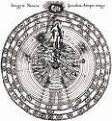
In 1630 English physician-astrologer Robert Fludd (1574-1637) pub. the first Color Wheel, taking Aristotle's color line and turning it on itself to create seven areas.
On May 17, 1630 Jesuit astronomer Niccolo Zucchi (-1670) discovers the spots on Jupiter's surface - I have this uncle with a great big face and a big red mustache?
In 1631 French physician-chemist Jean Rey (1583-1645) uses a water-filled glass bulb thermometer to follow the progress of fevers in patients; he goes on to discover that lead and tin become heavier after calcination, attributing it to the weight of air, making possible the invention of the barometer.

In 1631 French-born Spanish capt. Pierre Vernier (1580-1637) invents the Vernier Scale for artillery, greatly increasing accuracy.

Speaking of mean Roman Catholics? In Feb. 1632 Pisa-born Italian super-brain scientist ("Father of Science") Galileo Galilei (1564-1642) pub. his "fictional" masterpiece Dialogue Concerning the Two Chief World Systems (Dialogho Sopra i Due Massimi Sistemi del Mondo), which becomes an immediate bestseller in Italy; in Sept. Pope Urban VIII finally gets a copy, shits bricks and orders its distribution stopped, and in Oct. Galileo receives a summons to appear before the friendly Roman Inquisition for reneging on his 1616 promise and only playing games with them, pretending to treat Copernicanism as a theory but anything but; the Medici family waffles but finally drops protection for him, and he has to go to Rome, where the outcome is unstoppable. Speaking of mean Catholics? On Feb. 13, 1633 Galileo arrives in Rome, is interrogated (tortured) by the Big I in Apr., pleads guilty to a lesser charge in exchange for a more lenient sentence (please, I don't want to squat to pee?), is found guilty (3 of 10 Cardinal judges withholding their signatures), and on June 22 in the Dominican Convent of Santa Maria Sopra Minerve he is forced to abjure his belief in the *!?! Copernican hypotheses; after prostrating himself in the white nightshirt of a penitent and kissing their holy feet for saving his soul he is sentenced to an indefinite prison term; in Dec. he is allowed to return to Florence under permanent house arrest at his villa in Arcetri, becoming the end of any remaining claim the Church could make to having any direct pipeline to God; the chilling effect is instant, with French brain man Rene Descartes withholding pub. of Le Monde (The World) (Treatise on the Light) next Apr. because it agrees with the Copernican theory, "and I confess that if it is false, then so are the whole foundations of my philosophy, because it is demonstrated from them beyond doubt" (he turns into the "philosophe au masque"); as late as 1739-42 an ed. of Newton's Principia is pub. with a cover letter by Minim Fathers Le Seur and Jacquier pointing out to good Roman Catholics that the Newtonian system of the world is also "hypothetical". In Jan. 1638 Galileo, now totally blind from retina damage caused by peering at the Sun petitions the Holy Inquisition to be freed, but is denied; he smuggles his Dialogue Concerning Two New Sciences (Statics and Dynamics) to a publisher in Holland (the first popular science bestseller in history); John Milton makes a pilgrimage to Rome to "commune with enlightened men", and visits Galileo - enlightened, get it? In 1641 Galileo proposes the pendulum clock.

On Nov. 8, 1637 after being inspired by sketches by Leonardo da Vinci, Greek man Arsenios Tselepis from Constantinople becomes the first man to fly using wings, taking off from the Galata Tower and landing in Dogancilar Square 2 mi. away; the Turks try a coverup, claiming he's a Muslim with the name Hezarfen ("expert in a thousand sciences") Ahmed Celebi.

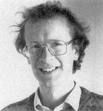
In 1637 French atty. and math dabbler ("Father of Number Theory") Pierre de Fermat (1607-65) conjectures Fermat's Last Theorem (that the Pythagorean Theorem for n greater than 2 is not solvable in integers) in the margin of his copy of Diophantus' Arithmetica, with the famous soundbyte that he "discovered a truly remarkable proof which this margin is too small to contain", launching a massive search for the proof after the Royal Academy of Sciences at Gottingen offers a 100K mark prize to prove it true or false, without takers; Fermat proves it for n=4, Leonhard Euler proves it for n=3, Peter Gustav Lejeune Dirichlet proves it for n=5 and n=14; in 1954 an electronic calculating machine proves it true for n less than 2000; it is finally solved in 1994 by English mathematician Sir Andrew John Wiles (1953-) after seven years locked up by himself, who also proves that all rational semistable elliptic curves are modular.
In 1638 English astronomer-mathematician William Gascoigne (1612-44) invents the Micrometer.
On Jan. 8, 1642 the #1 scientist of his time, Galileo Galilei (b. 1564) dies, blind and under house arrest by the Infallible Holy Church; what a coincidence that Isaac Newton (d. 1727), the Summa (greatest) scientist of his or any age, and the discoverer of the secret of light is born in England on Dec. 25 Old Style (Jan. 4, 1643 New Style) - the big keelboat is rammed by more and more great logs?

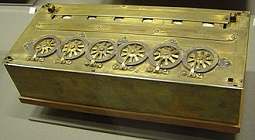
In 1642 French superbrain Blaise Pascal (1623-62) begins designing a calculating machine called the Pascaline, which performs addition and subtraction and can do multiplication and division via repeated you know what, becoming the first adding machine used in a business setting since the abacus; after finishing the design in 1644, Pascal goes on to sell 50 units in 10 years - if only he'd also invented electronics, he coulda been a contender?

In 1643 Rome-born Italian physicist-mathematician Evangelista Torricelli (1608-47) (Galileo's mathematics student, who succeeded to his chair in mathematics at the U. of Pisa) accidentally invents the Mercury Barometer (Torricelli Tube) (along with Vincenzo Viviani); a torr is later defined as the number of millimeters of mercury in a Torricelli Tube; on June 11, 1644 Torricelli writes the soundbyte in a letter to Michelangelo Ricci: "We live submerged at the bottom of an ocean of air" (Noi viviamo sommersi nel fondo d'un pelago d'aria).
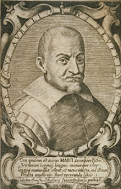
In 1646 Italian surgeon-anatomist Marco Aurelio Severino (1580-1656) pub. De Efficaci Medicina (3 vols.), becoming the first to describe refrigeration anaesthesia using snow-ice mixtures.

In 1647 French astronomer Adrien Auzout (1622-91) proves that air has barometric pressure.
In 1648 Blaise Pascal proposes the concept of air pressure in barometers, having his brother-in-law carry one up a mountain and record its readings to show that higher altitudes have lower air pressure.
On Oct. 24, 1648 (Sat.) the Thirty Years' War (begun 1618) between the Holy Roman (Catholic) Imperial Crown and the Protestant Princes of Europe ends with the compromise Peace of Westphalia (AKA Two Treaties of Munster and Osnabruck), redrawing the map of Europe by allowing the princes to decide their country's religion, which gives scientists in Protestant nations the protection they need to sprint out ahead of the Catholics.

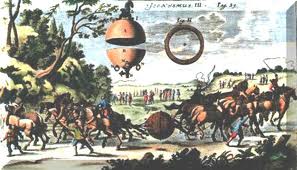
In 1650 German physicist Otto von Guericke (1602-86) of Magdeburg invents the vacuum air pump (now he's got both friction and suction?); in 1655 he uses it to remove the air from two metal Magdenburg hemispheres and challenges horsemen to pull them apart; it ends up being used on farms.
In 1652 the Academia Leopoldina (originally Academia Naturae Curiosorum) is founded in the free imperial city of Schweinfurt, Germany, with physician Johann Lorenz Bausch (1605-65) as pres. #1, becoming the oldest scientific academy to survive to modern times; it moves to Halle in 1878.


In 1654 French mathematicians Blaise Pascal (1623-62) and Pierre de Fermat (1601-65) pub. the basic laws of Probability Theory; Pascal invents the roulette wheel as a by-product of experiments with perpetual motion.

In 1655 Dutch scientist Christiaan Huygens (1629-95) discovers the rings of Saturn, also on Mar. 25 Saturn's biggest moon Titan (2nd largest moon in the Solar System, and only moon with an atmosphere); at last the age-old belief that the heavens are of a different stuff than the Earth is shattered when the former "god" Saturn turns out to have a physical structure, and therefore is not heavenly, pushing the abode of God and the angels back, back, back; he also discovers the mv^2/r formula for planetary orbits, which really makes their physical ordinariness apparent, since the m in the formula applies to heavenly angel hair as well as crap? - what a revelation just as the big 666 year is coming up? In 1656 he builds the first Pendulum Clock in London based on a design by Galileo; after adding the first-ever anchor escapement to reduce the pendulum swing, it only loses 1 sec. every 3 hours, vastly improving on the old verge-and-folio escapement. In 1660 he and the Abbe d'Hautefeuille independently invent the spiral hairspring for clocks and watches, improving accuracy. In 1661 he invents the manometer for measuring the elastic force of gases. In 1665 he first observes automatic synchronization of two clocks suspended on the same beam, along with indirect coupling, which makes two pendulum clocks mounted together swing in opposite directions.

In 1661 English scientist (rival of Isaac Newton) Robert Boyle (1627-91) (after discovering that sound doesn't travel in a vaccum in 1658) pub. New Experiments Physicomechanical, Touching the Spring of the Air (2nd ed.), incl. Proemial Essay, expounding Boil's, er, Boyle's Law (pressure-volume dependence) - all great scientific laws are named after people with just the right names? Also in 1661 he uses his pneumatic pump to prove that animals die from lack of air not the accumulation of noxious vapors, stimulating others to begin respiration studies; he also discovers methyl (wood) alcohol - by drinking it? Also in 1661 he pub. The Sceptical Chymist, breaking Chemistry away from Alchemy, dissing the Aristotelian theory of the elements and the Paracelsian theory of principles, and listing chemical elements; "I look upon amity and enmity as affections of intelligent beings, and I have not yet found it explained by any, how those appetities can be placed in bodies inanimate and devoid of knowledge or of so much as sense." In 1666 he pub. Origin of Forms and Qualities According to the Corpuscular Philosophy, explaining his view that everything is mad of atoms, and that Nature is mechanical in er, nature. In 1667 he proves that fresh air is necessary for respiration, and that an animal can be kept alive by artificial respiration using a bellows in a dog's trachea; his partner Robert Hooke shows that blood alteration in the lungs is the essential feature of respiration. In 1679 French physicist-priest Edme (Edmé) Mariotte (1620-84) announces his rediscovery of Boyle's Law - but Edme's Law or Mariotte's Law has no pizzazz?
In 1662 the Royal Society of London receives a royal charter from Charles II, becoming England's major center of scientific activity until the 19th cent.; women are excluded; it begins separating science from theology, leading to modern godless Big Science?

In 1662 English economist Sir William Petty (1623-87) pub. A Treatise of Taxes and Contributions, inventing statistical mathematics.

In 1663 Scottish mathematician James Gregory (1638-75) pub. his invention of the compact reflecting Gregorian Telescope, which becomes the std. telescope design for the next 150 years; he also describes a method to measure the Astronomical Unit (Earth-Sun distance) by using the transit of Venus. In 1667 he pub. Vera Circuli et Hyperbolae Quadratura, which shows that the areas of the circle and hyperbola can be obtained from an infinite convergent series, and speculates on the impossibility of the quadrature of the circle and the existence of transcendental numbers; he also pub. infinite series expansions of trig functions; reprinted in 1668 with the appendix Geometriae Pars, with methods on calculating the volumes of solids of revolution.

In 1665 English scientist Robert Hooke (1635-1703) pub. Micrographia, popularizing microscopy; "The most ingenious book that I ever read in my life" (Samuel Pepys); uses the microscope to identify cells, coining the term "cell" for the rigid thingies in cork, which remind him of monks' cells; his 12 in. x 18 in. Drawing of a Flea grosses out sensitive ladies and makes them faint?; he is the first person to examine fossils under a microscope, and concludes they are the remains or traces of long-dead organisms; the microscope is now de rigueur, causing Antony van Leeuwenhoek, Marcello Malpighi, Nehemiah Grew, Jan Swammerdam et al. to bend over and squint - giving future air duct salesmen a job? In 1667 he invents the Anemometer for measuring wind speed, which is also invented the same year by Christian Forner (Förner) of Weissenfels, Germany. On Feb. 5, 1675 Sir Isaac Newton writes a Letter to Robert Hooke, with the soundbyte "If I have seen further it is by standing on ye sholders of Giants"; later when their rivalry goes bitter, Newton starts dropping bigger and bigger slams on Hooke, and ultimately tries to erase his memory? In 1678 he pub. Hooke's Law of Elastic Force ("ut tensio, sic vis", "stress is proportional to strain") - especially on springs with hookes?
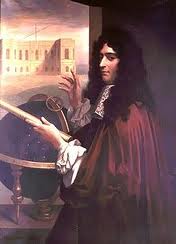
In 1665 Italian astronomer Giovanni (Gian Domenico) Cassini (1625-1712) discovers Jupiter's Great Red Spot, and determines the rotations of Jupiter, Mars, and Venus. In 1666 he determines the rotation period of Mars to be 24 hours 40 min. (actual value 24 hours 37 min. 22.6 sec.), and discovers the Martian polar ice caps - another ancient god proves to be just orbiting dirt? In 1671 he becomes dir. of the Paris Observatory, and discovers Saturn's satellite Iapetus, followed by Rhea next year, and Tethys and Dione in 1684; he also calculates the distance from Earth to Mars, allowing him to calculate the distance to all the planets. In 1672 he becomes the first to accurately calculate the distance between the Earth and Sun. In 1675 he discovers the big gap between Saturn's A and B rings, AKA the Cassini Division; the narrow gap inside the A ring is later called the Encke Division. In 1679 he pub. the first Scientific Map of the Moon.


The year 1666 contains all the Roman numerals MDCLXVI) once; also 1444, 1446, 1464, 1466, 1644, 1646, 1664. In 1666 the Millennium Fever (MF) over the Big Year 1666 stirs mass paranoia in Christendom, the smart money being that all those evil scientists and secular pagans (and the antichrist pope and his papist followers, according to Protestants) are going to be consumed in fire just as the unbelievers were consumed in water in the days of Noah; later, when the disappointment sets in, hope springs eternal in the human breast, so anybody born in this year is suspected of being the Devil or the Antichrist, and Armageddon is at least going to happen in his lifetime, so don't give up the faith?; meanwhile never fear, the Scientists are here, as the Annus Mirabilis of English Cambridge U. man Sir Isaac Newton (1642-1727) begins when the plague causes him to be sent home from Cambridge to his home in Woolsthrope, where the world's most famous apple falls from the tree, revolutionizing Science with the stunning realization that the heavens and the Earth are subject to the same universal laws - one little orb falls from the sky, causing their minds to fall from the divine Heavens into the material world of Earth, and like it? I walk this empty street on the boulevard of broken dreams? Don't let a migraine upset you? As a total rebuff to the Millennium Feverists who say the world is not worth studying (since this is its last year), Isaac Newton goes into a glorious brilliant Rain Man funk in Woolsthorpe and discovers the Integral Calculus (not dental rot but the branch of mathematics) and the Newton's Law of Universal Gravitation (inverse square law), measures the Moon's orbit, and, when not otherwise occupied, buys a glass prism "to try therewith the phenomena of the colours", becoming the first to deduce that the prism splits white light into a spectrum as a result of the different refractive index for each color; sitting under a you know what kind of tree, he observes a you know what falling, and calculates that at a distance of 1 ft. the attraction between two objects is 100 times stronger than at 10 ft., making the super mental leap that the force exerted by the Earth on the apple is the same as that exerted by the Earth on the Moon; "And the same year [1666] I began to think of gravity extending to the orb of the Moon, and having found out how to estimate the force with which a globe revolving within a sphere presses the surface of the sphere, from Kepler's Rule... I deduced that the forces which keep the Planets in their Orbs must [be] reciprocally as the squares of their distances from the centers about which they revolve: and thereby compared the force requisite to keep the Moon in her Orb with the force of gravity at the surface of the earth, and found them answer pretty nearly. All this was in the two plague years of 1665 and 1666, for in those days I was in the prime of my age for invention, and minded Mathematicks and Philosophy more than at any time since" - Isaac Newton, memo in the Portsmouth Collection, 1714; the Newton pippin is later named to commemorate the Big Apple of 1666 - the first modern scientist walks the Earth, and he's white, Anglo-Saxon, and Protestant, but actually not so modern, as he's still got one foot in the past and believes in alchemy and bizarre Bible theories, taking a few years out of his all-important studies to figure out math and physics, in the belief that the Universe is a giant code and he can crack it; his success paradoxically strengthens belief in astrology? Newton's funeral was presided over by "A. (Alexander) Pope".

On Dec. 19, 1666 French royal physician Jean-Baptiste Denis (Denys) (1640-1704) performs the first known human blood transfusion on Antoine Mauroy, a known wife beater who was found wandering zonked and naked through the streets of Paris, twice transfusing about 10. oz of blood from a "gentle" calf and apparently curing him with a kind of emotional transplant, although he is really suffering from syphilis? Science counts sheep in its sleep? On June 15, 1667 Jean-Baptiste Denis performs his second human blood transfusion in England from a lamb to teenaged, daft, improverished clergyman's helper Arthur Coga, who is paid 20 shillings to receive up to 12 oz. (350 ml) of blood in the hope that the life force of the docile creature will tame his madness; the following week Coga addresses the Royal Society in Latin, and Pepys reports "He is a little cracked in his head, though he speaks very reasonably"; he disappears before they can give him any more treatments. In Jan. 1668 he performs his third human blood transfusion on a wife beater in France using a sheep, and when he dies the doctor is tried for murder and acquitted, causing blood transfusions to be banned in France, although the technique is adopted in the Netherlands, Germany, and Italy - enough to make me a Jehovah's Witness?

In 1666 19-y.-o. German polymath superbrain Gottfried Wilhelm von Leibniz (1646-1716) (pr. LIPE-nits), Germany's answer to England's Isaac Newton pub. Disserto de Arte Combinatoria (Discussion of the Combinatorial Art), which formulates the idea that all reasoning and discovery are reducible to an ordered combination of elements, incl. words, numbers, colors, and sounds; contains his suggestion, based on the work of Raymond Lully, that a mathematical language of reasoning should be developed, which is taken up by George Boole et al. In 1672-94 he constructs the Stepped Reckoner, the first calculating machine capable of multiplication and division; the cylindrical crank-operated calculating machine was inspired by a pedometer he saw while on a diplomatic mission to Paris, and he visits London to seek financial backing from the Royal Society, claiming it can calculate trig tables. In 1672 he first describes the mysterious invisible Ether (Aether), so dear to Newtonists; meanwhile in 1672 Isaac Newton announces his discovery of the decomposition of white light into the rainbow, breaking it into spectral colors each with a different index of refraction. In 1679 Leibniz discovers the Binary Number System; he doesn't pub. his findings until 1701.
In 1666 Cheddar Cheese is first made in Cheddar, Somersetshire, England, at the entrance of the rocky 1-mi. Cheddar Gorge on the S side of the Mendip Hills (22 mi. SW of Bristol).
In 1666 Robert Hooke designs a new type of escapement for clocks, with the moving part in the same plane as the balance wheel on which it acts to increase accuracy.


In 1666 Charles II's master of mechanics Samuel Morland (1625-95) invents the first multiplying machine, with a duodecimal (base 20) scale based on English currency, requiring human intervention to enter the carry displayed in an auxiliary dial.

In 1666 Jean de Thevenot (1633-67) invents the carpenter's level, consisting of a bubble floating in a thin liquid-filled glass tube.

In 1666 Italian physician Marcello Malpighi (1628-94) pub. the discovery that bile is secreted by the liver.

In 1666 London physician Thomas Sydenham (1624-89) pub. Methodus Curandi Febres (Ways to Cure Fevers), which advocates the use of opium to relieve pain, cinchona bark (quinine) to relieve malaria, and iron to relieve anemia.

In 1667 German physician Johann Joachim Becher (1635-82) pub. a forerunner of the Phlogiston Theory, claiming that all bodies are composed of air, water, and three earths, terra lapida (stony), terra mercurialis (mercurial), and terra pinguis (fatty), and that in combustion the fatty earth is released, which later causes Joseph Priestley of England to call oxygen "dephlogisticated air" - close but no fat cigar?

In 1667 after using her clout with her hubby William Cavendish, "Mad Madge" Mary Cavendish, Duchess of Newcastle-upon-Tyne (1623-73) becomes the first woman admitted to the British Royal Society (next in 1945). In 1666 she pub. Observations upon Experimental Philosophy, which rejects Aristotelianism and mechanical philosophy in favor of Stoicism; being a woman, her work is pooh-poohed.

In 1667 Cornish physician Richard Lower (1631-91) transfuses blood from one dog to another in Oxford, and observes that blood changes color when in contact with air - air lowers blood pressure?

In 1667 Abbe Jean Picard (1620-82) of France invents a micrometer for use with a telescope, and uses it to discover anomalies in the positions of stars, which are not explained until 1728.
In 1667 Scottish physician Sir Robert Sibbald (1641-1722) and Sir Andrew Balfour found the first botanical garden in Edinburgh, Scotland.

In 1667 Danish scientist Steeno (Niels Steensen) (1638-87) of Copenhagen, who discovered the parotid salivary duct while studying anatomy in Amsterdam, then became court physician to grand duke Ferdinand II of Florence in 1665 publicly dissects a shark's head and proves that its mouth is full of teeth, not serpent tongues, then reveals that stones found in Malta are fossils of ancient shark teeth, founding the modern study of geology; he then advances the theory that land formations such as seabeds evolve via natural processes - living in the moment, priceless?

In 1667 Dutch painter Jan van der Heyden (1637-1712) devises a comprehensive street lighting scheme for Amsterdam, which is used until 1840, and adopted by many other towns.
In 1668 Isaac Newton invents the Newtonian Reflecting Telescope, which is a great improvement, reducing distortion.

In 1669 Danish scientist Rasmus (Erasmus) Bartholin (1625-98) pub. the first observations of double refraction of light in Iceland spar crystals.
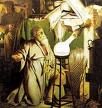
In 1669 alchemist Hennig Brand (Brandt) (1630-1710) of Hamburg, Germany discovers Phosphorus (P) (#15) in distilled human urine, becoming the first new element discovered since ancient times, launching the chain of events leading to the Periodic Table - he wasn't kidding about his burning urination?

In 1669 English naturalist ("Father of English Natural History") John Ray (1627-1705) pub. results of experiments on trees, showing that sap ascends through the wood. In 1680 he begins work on the taxonomy of plants, defining the concept of species (Lat. "seeing", "appearance").

In 1670 Italian scientist Giovanni Alfonso Borelli (1608-79), known for his experiments in biomechanics describes a mechanical bird with artificial wings, attempting to explain flight by means of an inclined plane. In 1680 he pub. De Motu Animalium (On the Motion of Animals), financed by Queen Christina of Sweden (who gives him protection from Galileo's fate), which links Galilean mechanics to Cartesian mechanistic biology, founding the science of Biomechanics; recognizes that forward motion requires forward movement of the body's center of gravity, followed by swinging of the limbs to maintain balance; likens the action of the heart to a piston, requiring the arteries to be elastic - the heart is like the Sun, and the weenie is like the Moon?
In 1671 Isaac Newton writes Methodus Fluxionum et Serierum Infinitarum (The Method of Fluxions and Infinite Series), describing the notion of fluxions (time derivatives) and fluents (inverse of fluxions, i.e., integrals); his hesitancy to pub. his secret veapon Calculus until 1736 allows Gottfried Wilhelm von Leibniz to claim prior discovery and get into a cross-Channel pissing contest; actually Leibniz rediscovers the Calculus in 1675, but his prettier notation becomes std.

In 1672 French Catholic priest Laurent Cassegrain (1629-93) of France invents the Cassegrain Reflecting Telescope, using both a parabolic and hyperboloid mirror to cancel spherical aberration, besting Newton's 1668 design; Christiaan Huygens learns about it and disses it to build Newton up, causing Cassegrain's name to be forgotten until modern times, when his design becomes the preferred one.

In 1672 English physician-anatomist Francis Glisson (1597-1677) first describes the "irritability" of living tissues (tendency to react to their environment); he disproves the balloon theory of muscles by showing that when a muscle contracts under water the water level stays the same, therefore no air or fluid could be entering or leaving it.
In 1672 French mathematician Jean Richer (1630-96) reaches Cayenne, finding that a pendulum of the same length has a longer period on the equator than in France, becoming the first to notice the bulge at the equator and the flattening at the poles - everybody else is heeding Nature's call? In 1673 he ends his scientific expedition to Cayenne, and finds that gravy, er, gravity is less richer, er, intense near the equator than in higher latitudes.

In 1672 Flemish physician Franciscus Sylvius (Franz de le Boe) (1614-72) pub. Praxeos Medica Idea Nova (New Idea in Medicine), which ditches the imbalance of the four humors for an imbalance of acids and bases.

In 1672 Dutch painter Jan van der Heyden (1637-1712) and his son make the first Flexible Fire-Fighting Hoses.


In 1672 Flemish Roman Catholic Jesuit priest Father Ferdinand Verbiest (1623-88) AKA Nan Huairen builds (just designs?) a steam-powered vehicle for the Chinese Qing Kangxi emperor, becoming the world's first automobile?; too bad, it's too small to carry a driver or passengers?
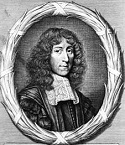
In 1674 English physician-chemist-physiologist John Mayow (1640-79) pub. Tractatus Quinque Medico-physici, researches on respiration and rickets, some originally pub. at Oxford in 1668; calls the portion of air that supports combustion "spiritus igneo-aerus" and "nitro-areus", from the acid portion of potassium nitrate KNO3, giving the first correct anatomical description of the mechanism of respiration, recognizing the existence of oxygen, founding the field of Pneumatic Chemistry.
In 1674 George Ravenscroft (1632-83) of England patents English lead (flint) glass, a heavy, water-clear crystal doped with lead oxide; lead is already being used in Italian paste jewelry?

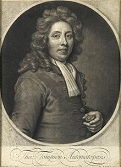

On Aug. 10, 1675 the Royal Greenwich Observatory in Greenwich, London overlooking the River Thames, designed by Sir Christopher Wren is begun by order of Charles II in order to make a new improved catalog of stars for ship navigation; Charles II selects clockmaker ("Father of English Clockmaking") Thomas Tompion (1639-1713) to build two identical clocks with long pendulums and small arc swing as suggested by Robert Hooke, driven by a deadbeat escapement invented by Richard Towneley (1629-1707), that only need to be wound once a year, proving so accurate that they become instrumental in correcting astronomical calculations; John Flamsteed (1646-1719) is appointed the first astronomer royal of England, but he is so slow at calculation that at in 1704 the catalog is still incomplete but is pub. against his wishes, and he publicly burns 300 of the 400 copies in protest; meanwhile Sir Isaac Newton uses his catalog to verify his theory of gravitation. 19-y.-o. Edmund Halley (b. 1656) devises a new method for determining planetary orbits; Tompion and Hooke go on to make some of the first watches with balance springs.

In 1677 Danish anatomist Caspar Bartholin the Younger (1655-1738) first describes Bartholin's Glands of the vagina - had a nose for his work, make that a taste for his work?

In 1677 Dutch linen draper and late-blooming long-living scientist (zoologist) Anton (Antony) (Antonie) (Thonius) Philips van Leeuwenhoek (1632-1723) [pr. lay-van-HOOK] first sees red blood cells and spermatozoa through a microscope, leading to a cent.-long animalculist-ovist debate about whether the male or the female contributes more or all to the embryo. In 1683 he invents a stronger (200x) microscope and discovers bacteria in the plaque of his own teeth, along with spermatozoa (not necessarily from the same place?) - I'm DJ Anton van Leeuwenhoek, and I'll allow you a look with my hooky hook hook? In 1684 he makes the first microscopic observation of the retina, and discovers the rods and cones.
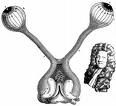
In 1678 English physician William Briggs (1650-1704) describes the anatomy of the eye, incl. the papillae of the optic disc, fibers in the retina et al.

In 1678 Italian mathematician Giovanni Ceva (1647-1734) pub. the elegant Ceva's Theorem on the division of sides of a triangle.

In 1678 Dutch London pendulum man Christiaan Huygens (1629-95) formulates the Wave Theory of Light, and discovers light polarization.
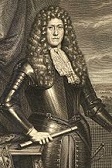
In 1678-91 Hortus Malabaricus (Lat. "Garden of Malabar") (12 vols.) is pub. in Amsterdam, along with a trans. by K.S. Manilal in Kerala; compiled by 25 people working for Dutch East India gov. of Dutch Malabar (1669-76) Hendrik Adriaan van Rheede tot Drakenstein (1636-91), and edited by 100+ experts, containing descriptions and drawings of 740 medicinal plants there, incl. cannabis and the joys of smoking it.
In 1679 Denis Papin (1647-1712) of France discovers that the boiling point of water depends on atmospheric pressure, and invents the Pressure Cooker, which he calls the Bone Digester, complete with the first automatic safety valve, and demonstrates it for the Royal Society in England, architect Sir Christopher Wren finding the meal so delicious that he requests instructions on how to use it.
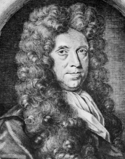
In 1682 English botanist Nehemiah Grew (1641-1712) pub. Anatomy of Plants (4 vols.), containing the first microscopic description of pollen, founding plant anatomy. In 1695 he isolates magnesium sulfate (Epsom salts) from water taken from North Downs springs in you know where.

In 1682 English astronomer Edmund Halley (1656-1742) discovers the 75.5-year period of Halley's Comet from observed data and his own calculated parabolic orbits, deducing that the comets of 1531, 1607, and 1682 are one and the same, and move in an elliptical orbit because they all have a Nodus Ascendus of about 20 deg. in Taurus. On Dec. 25, 1758 Halley's Comet is located on Halley's predicted return date, making him a superstar; its closest approach is next Mar., as predicted by Alexis Clairaut - proof that 1759 is Britain's year?
In 1683 Isaac Newton discovers the effect of gravity on tides, and comes up with a mathematical theory - no matter how you shake and dance, the last few drops end up on your pants?


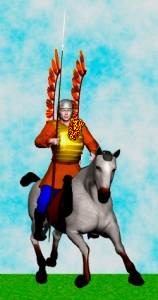
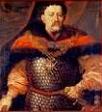





Which brings us the watershed year 1683. After a thousand years of Islamic terrorist attacks on innocent Christian Europe since Maddass' Death in 632, giving the West time to pass them up permanently in military technology, on Sept. 11-12, 1683 the Battle of Vienna (Kahlenberg) was a giant V for a combined army of 84K Roman Catholic and Protestant troops, led by Roman Catholic Polish King Jan (John) III Sobieski (1629-96) and his 3K mounted Winged Hussars, along with Roman Catholic Austrian Hapsburg Duke Charles V of Lorraine (1643-90), who kicked the butts of 150K-250K Muslim losers under sultan (1648-87) Mehmed IV (1642-93), leaving 10K Muslims dead and 5K wounded, and 5K taken POW, while losing only 2K Christians dead and 2.5K wounded. In the interest of forgetting their religious differences while throwing out the Saracens, the Catholic battle cry of "Maria help" was modified to a combo Catholic-Protestant battle cry of "Jesus and Maria help", there wasn't a dry eye in the house, despite Catholic Hapsburg-hating French king (1643-1715) Louis XIV (1638-1715) refusing to send help, and Protestant Hapsburg-hating Hungarian Count Imre Thokoly (1657-1705) aiding the Turks in hopes of becoming their vassal prince of Transylvania. After Buda was retaken in 1686 and the pesky Jews (who sided with the Turks) kicked out, the Ottomans were then thrown out of Hungary hopefully for good on Aug. 12, 1687 in the Second Battle of Mohacs with 60K Christian soldiers kicking the butts of 60K Muslim soldiers and losing only 600 vs. 10K Turks, after which the pesky Muslims never again attempted to subjugate Europe militarily, although they left all the other options on the table incl. mass migration to just take it over without firing a shot, giving illegal immigrants a bad name, just give me a generation of Islam history ignoramuses and PC professors. Meanwhile they did give the West one good thing, coffee, drink up, professor.

















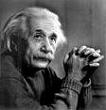









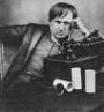






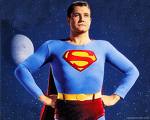

1683 represents the year when the Muslim World's military threat to the West ended, and the West began to leave it and its population and its stinking Allah along with the Medieval Ages in the rearview mirror as the ass-crack-sniffing Islamic world failed to keep pace with the West, not only in science and technology, but in all key aspects, incl. the construction of public clocks, implementation of standardized linear measurements, and modernization in general, compounded by pervasive autocracy. The 1648 Peace of Westphalia left fledgling Western Science pretty much free to romp unmolested by any organized religion, helped by an internat. science community that encouraged nation-hopping, and combined with the Age of Reason launched by Rene Descartes in the early 1600s, followed by the Age of Enlightenment, it immediately began producing a long ever-growing line of super scientists building on the work of Leonardo da Vinci (1452-1519) of Italy (read the catalog), Nicolaus Copernicus (1473-1543) of Poland (heliocentric theory), William Gilbert (1544-1603) of England (electricity and magnetism), Galileo Galilei (1564-1642) of Italy (theory of momentum), and Johannes Kepler (1571-1630) of Germany (laws of the Solar System), incl. Rene Descartes (1596-1650) of France (analytical geometry and rationalism in philosophy), Sir Isaac Newton (1643-1727) of England (law of gravitation, optics, calculus), Gottfried Wilhelm von Leibniz (1646-1716) of Germany (modern notation for calculus et al.), Carl Linnaeus (1707-78) of Sweden (biological classification and nomenclature), Antoine Lavoisier (1743-94) of France (law of mass conservation, metric system), Jons Jakob Berzelius (1779-1848) of Sweden (chemical formula notation), Michael Faraday (1791-1867) of England (electromagnetic induction, electrolysis), Gregor Johann Mendel (1822-84) of Austria (genetics), Louis Pasteur (1822-95) of France (germ theory of disease), James Clerk Maxwell (1831-79) of Scotland (electromagnetic field theory), Dmitri Mendeleyev (1834-1907) of Russia (Periodic Table of the Elements), Albert Einstein (1879-1955) of Austria and the U.S. (photoelectric effect, mass-energy equivalence, relativity theory), and Niels Bohr (1885-1962) of Denmark (quantum theory), the honor list grows exponentially, no Muslims but scads of Christians and Jews on it, gee, Allah, what happened, they were all infidels and should have been beheaded by your faithful Muslim fucktards so we could continue to grovel in the Muslim Golden Age of cubic equations and the search for the process for transmuting lead to gold, if I get a broken back will I still be able to walk? And then there's the applied scientists and inventors, who contributed to the Industrial Revolution in the late 18th and 19th centuries, incl. Johannes Gutenberg (1398-1468) of Germany (printing press), Galileo Galilei of Italy (already mentioned) (telescope), Anton van Leeuwenhoek (1632-1723) of the Netherlands (microscope), Benjamin Franklin (1706-90) of the U.S. (electricity), Alessandro Volta (1745-1827) of Italy (electric battery), Robert Fulton (1765-1815) of the U.S. (steamboat), Louis Daguerre (1787-1851) of France (photography), Charles Babbage (1791-1871) of England (computer), Alexander Graham Bell (1847-1922) of Scotland (telephone), Thomas Alva Edison (1847-1931) of the U.S. (light bulb, phonograph, moving pictures), Rudolf Diesel (1858-1913) of Germany (diesel engine), Marie Curie (1867-1934) of France and Poland (radioactivity) (what happened Allah, I thought you made all of the menstruating women of the world stupid?), Guglielmo Marconi (1874-1937) of Italy (radio), the Wright Brothers of the U.S. (airplane), Robert Hutchings Goddard (1882-1945) of the U.S. (rockets), Philo Taylor Farnsworth (1906-71) of the U.S. (TV). Where are the Muslim inventors? Oh yes, the auto clit slicing machine, the Wifi chastity belt, the IED, the butt bomb and shoe bomb, the Black Hole of Calcutta, all invented by Mohamed something. And I don't have enough megabytes available to cover Western art, literature, music, etc., while on the Muslim side there's about enough to fill a donkey cart, and anything good in it is probably by secular or skeptical or ex-Muslims.
In 1683-4 the Great Frost of 1683-4 strikes Europe and the British Isles; a Frost Fair is held on the 11-in. thick frozen Thames between Southwark and the Temple until the ice melts on Feb. 6, 1684; the Thames freezes at least 8x in 600 years of the existence of the London Bridge because its 19 arches impede the river's flow - all them scientific brains and no mention of Global Cooling?
In May (Aug.?) 1684 celeb Edmund Halley visits Sir Isaac Newton in Cambridge to ask what orbit a body would describe under an inverse-square law of attraction, and Newton replies an ellipse, and that he had proved it years earlier but lost the papers and would rework it and send it to him, which he does in Nov., pub. De Motu Corporum in Gyrum (On the Motion of Revolving Bodies) in Dec., then expanding the work, until in 1687 he pub. his monumental "Principia" at Halley's expense; meanwhile Leibniz pub. his system of the integral and differential calculus independently of Newton, allegedly based on his own work from 1673-6, starting a doowahdiddydiddy credit-seeking race; Newton wins the decision for priority with the great tale of the apple in the plague year of 1666 and his killer theory of gravity, but Leibniz' cooler notation gets adopted by textbook writers.

On July 5, 1687 English #1 superbrain Sir Isaac Newton (1643-1727) pub. Philosophiae Naturalis Principia Mathematica (pr. prin-KIP-ee-ya), founding celestial and terrestrial mechanics with his Three Universal Laws of Motion, proving the inverse square law of gravitation and many other basic results after a bitter feud with Robert Hooke (1635-1703) over priority; the rough ms. is finished on June 20, 1686, but he adds a section on comets with the help of John Flamsteed; the preface acknowledges Edmund Halley, saying "it was through his solicitations that it came to be published"; "But hitherto I have not been able to discover the cause of those properties of gravity from phenomena, and I frame no hypothesis; for whatever is not deduced from the phenomena is to be called an hypothesis; and hypotheses, whether metaphysical or physical, whether of occult qualities or mechanical, have not place in experimental philosophy. In this philosophy particular propositions are inferred from the phenomena, and afterwards rendered general by induction. Thus it was that the impenetrability, the mobility, and the impulsive force of bodies, and the laws of motion and of gravitation, were discovered. And to us it is enough that gravity does really exist, and act according to the laws which we have explained, and abundantly serves to account for all the motions of the celestial bodies and of our sea."

In 1688 Italian physician Francesco Redi (1626-97) attempts to prove that ain't fresco ready to eat rotting meat cannot spontaneously turn into maggots, starting a Debate on Spontaneous Generation that goes on for two cents.
In 1688 polished Plate glass is developed by Louis Lucas de Nehou and A. Thevart of France, rolling molten glass poured on an iron table, making large plates possible; about 1800 a steam engine is used for grinding and polishing.
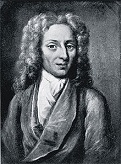
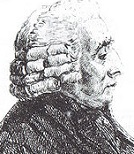
In 1690 Swiss scientist Nicolas Fatio (Facio) (Faccio) de Duillier (1664-1753) presents the unpub. treatise "On the Cause of Gravity" to the Royal Society in London, which proposes the Push/Shadow Theory of Gravitation, that gravity is a pushing force created when two objects shadow each other and block the flow of ether particles, creating an effective vacuum, with the soundbyte that despite its apparent heaviness, it is possible that gold ctains a trillion times more void than substance; in 1748 Swiss (Genevan) physicist Georges-Louis LeSage (1724-1803) revives and popularizes the idea, which is supplanted by Newton's attractive theory of gravitation despite similar results.


In 1691 Dutch botanist-anatomist Frederik Ruysch (1638-1731) first describes Hirschsprung's Disease, a congenital disorder of the colon where ganglion cells are absent in the myenteric plexus that moves food in the intestine; too bad, in 1888 Danish physician Harald Hirschsprung (1830-1916) (first Danish pediatrician) first describes two infants who died of it, causing it to be named after him. In 1700 Ruysch describes the ocular circulatory system, proving the existence of the arteria centralis oculi (central artery of the eye); he goes on to prove the existence of valves in the lymphatic system, along with the vomeronasal organ in snakes, and invents the art of injection and embalming techniques, becoming the first to embalm by injecting a chemical solution into the blood vessels made of clotted pig's blood, Berlin blue, and mercury oxide, creating dioramas incorporating human parts, esp. infant and fetal bodies, leaving 2K+ preserved specimens in his private museum, also preserved butterflies and lizards, selling a load of it in 1717 to Peter the Great.

In 1692 English scientist Edmund Halley (1656-1742) discovers the westward-drifing motion of Earth's geomagnetic field.
In 1692 Dutch anatomist Philip Verheyden dissects his own amputated leg, becoming the first to name the Achilles heel.


The original Supersize Me? On Aug. 4, 1693 blind French Benedictine monk Dom Pierre Perignon (1638-1715) invents Champagne, which is later sold in supersized bottles called Magnum (2x), Jeroboam (4x), Rehoboam (6x), Methuselah (8x), Salmanazar (12x), Balthazar (16x), and Nebuchadnezzar (20x) (My Judy Really Makes Splendid Belching Noises); actually, he didn't invent sparkling wine, just taught blending skills and figured out how to bottle the stuff in reinforced glass bottles sealed with Spanish corks?

In 1694 German botanist Rudolph Jacob Camerarius (1665-1721) discovers the function of plant pollen.
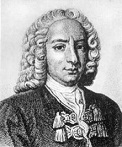
In 1695 French physicist Guillaume Amontons (1663-1705) invents the pendant barometer, and improves the thermometer for use at sea; in 1699 he pub. his rediscovery of the laws of friction first proposed by Leonardo da Vinci, and is pooh-poohed until Charles-Augustin de Coulomb verifies them in 1781.
In 1695 Edmund Halley discovers the periodicity of comet orbits.
In June 1696 Swiss mathematician Johann Bernoulli pub. the Brachistochrone Problem (Br. "brakistos kronos" = shortest time) in Acta Eruditorum, the curve of fastest descent between two points, with the soundbyte: "Given two points A and B in a vertical plane, what is the curve traced out by a point acted on only by gravity, which starts at A and reaches B in the shortest time"; Bernoulli takes two weeks to solve it , incorrectly, and ends up using his brother Jakob's correct solution in the May 1697 ed. of the mag.; meanwhile after receiving a letter from Leibniz with the problem on Jan. 29, 1697 (4:00 p.m.) and staying up all night, Isaac Newton sends the solution anonymously to Bernoulli, who immediately recognizes him, with the soundbyte that he "recognizes a lion from his claw mark", to which Newton utters the soundbyte: "I do not love to be dunned and teased by foreigners about mathematical things."
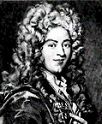
In 1696 French mathematician Guillaume de L'Hôpital (Hopital) (1661-1704) pub. L'Analyse des Infiniment Petits pour l'Intelligence des Lignes Courbes, the first textbook on infinitesimal calculus, based on lectures by his teacher Johann Bernoulli (1667-1748); it incl. L'Hopital's (L'Hospital's) Rule for solving the indeterminate form 0/0 through repeated differentiation - send it to the differential hospital?

In 1696 English mathematician-theologian William Whiston (1667-1752) (student of Isaac Newton at Cambridge U.) pub. A New Theory of the Earth from its Original to the Consummation of All Things, which defends the Biblical account of Creation, with the soundbyte: "The Mosaic Creation is not a nice and philosophical account of the origin of all things; but a historical and true representation of the formation of our single Earth out of a confused Chaos, and of the successive and visible changes thereof each Day, till it became the habitation of mankind"; he claims that the Biblical Flood was caused by a comet hitting the Earth; too bad, he pushes Arianism, pissing-off most Christians, esp. Roman Catholics, but making fans of Isaac Newton and John Locke.
In 1699 Dumaurier Duperrier invents the first portable fire pump to put out the imminent fires of Armageddon - a major case of mass tenesmus?
In the 18th cent. the Industrial Rev. begins in Europe, starting slow and picking up steam about 1760; at the beginning of the cent. living conditions in Europe stink, with corpses piled into empty graves until full.

In 1700 English mathematician John Machin (1686-1751) (prof. of astronomy at Gresham College, London) invents a convergent series for pi based on the series expansion of the arctangent function, and uses it to compute pi to 100 decimal places - well snaggle my fran?
About 1700 Sir Isaac Newton predicts the deflection of light around the Sun by 0.875 arc sec.; Albert Einstein later plagiarizes him for his 1913 prediction, which isn't experimentally verified because of WWI, but changes his prediction to 1.75 arc sec. before an expedition to a solar eclipse measures it in 1919?; Newton claimed that the gravitational attraction of the Sun makes light travel faster close to it so that the deflected light arrives before the undeflected light, whereas Einstein claimed that light will be delayed when passing close to the Sun.
In 1700 Joseph Sauveur begins writing on musical acoustics.
In 1700 French botanist Joseph Pitton de Tournefort (1656-1708) discovers ammonium chloride.
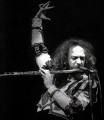


In 1701 English farmer Jethro Tull (1674-1741) invents the horse-drawn machine seed drill, which neatly sows seeds in rows. In 1731 he pub. Horse-hoeing Husbandry; shows how to reduce seed requirements by 75% using his seed drill, and grow perpetual wheat crops without manure, along with a system of 13 continuous crops; used by Voltaire and George Washington; "I was so far from being inclined to the scribbling disease, that I had disused writing for above twenty years, before I was prevailed on to commit my thoughts upon Husbandry to paper... It is no wonder that the style is low as the author... but fine language will not fill a farmer's barn; neither does truth need any embellishments of art."
In 1702 Dutch natural philosopher Guillaume (Wilhelm) Homberg (1652-1715) discovers Boron and Borax - no mule team needed?
In 1702 George Sorocold (1668-1739) of Derby, England invents the Tidal Pump - the Oral B Pulsar, changing the way you brush forever is only 3 centuries away?
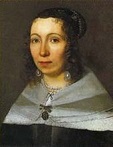
In 1705 Frankfurt-born German scientific illustator Maria Sibylla Merian (1647-1717) pub. Metamorphosis Insectorum Surinamensium, based on her 1699-1701 trip to Surinam to study Nature, making her the first person "to plan a journey rooted in science"; uses indigenous names for plants, and produces a classification of butterflies and moths that survives to modern times, becoming the first Euro to describe army ants and leaf cutter ants; contains a famous pictorial description of the metamorphosis of the butterfly, making her a star and making a fan of Peter I the Great.

In 1707 German chemist-physician Georg Ernst Stahl (1659-1734) pub. the alchemy-influenced Phlogiston Theory of Combustion, which it takes Antoine-Laurent Lavoisier until 1783 to phlog out of fashion.

In 1710 Irish Anglican bishop George Berkeley (1685-1753) pub. A Treatise Concerning the Principles of Human Knowledge, arguing that the physical world consists only of ideas, which exist when we are not observing them only in the mind of God. In 1878 the town of Berkeley, Calif. on the E shore of San Francisco Bay is named after him, becoming home of the radical main campus of the U. of Calif.
In 1710 Jacob Christoph Le Blon (1667-1741) of Germany invents 3-color printing.
In 1710 Per (Pehr) Elvius the Elder of Sweden becomes the first to assign the values 0 degrees and 100 degrees to the boiling and melting points of water.
In 1710 English astronomer Edmund Halley (1656-1742) discovers that the position of the "fixed" night stars change over time, hence the Earth must move around the Sun.
In 1710 Francois Xavier Bon de Saint Hilaire of France produces the first commercial saffron-colored silk from golden orb spiders in Madagascar, making an entire suit of clothes for Louis XIV.


In 1712 Thomas Newcomen (1664-1729) invents the Newcomen Steam Engine, becoming the first practical device to harness steam power to produce mechanical work, and the first great invention of an Englishman; unfortunately it uses only one chamber and is only about 1% efficient - hi, I love your purse?
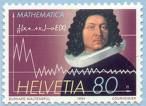
In 1713 Swiss mathematician Jacob Bernoulli (1654-1705) pub. the primitive form of the Law of Large Numbers, that the average of a large number of trials converges to the expected value.
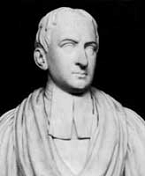
In 1713 English (Cambridge) mathematician Roger Cotes (1682-1716) revises Newton's Principia Mathematica (begun 1709), contributing a preface touting Newton's Law of Gravitation as superior to Rene Descarte's Theory of Vortexes; 750 copies are printed.
In 1713 Japanese scientist Ekiken Kabara (-1714) first describes the concept of dietary control as a method for achieving good health and longevity.
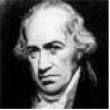

In 1714 Danzig, Poland-born Daniel Gabriel Fahrenheit (1686-1736) of Amsterdam invents mercury-in-glass thermometer, followed in 1724 by the 0-32-212 Fahrenheit Scale, which becomes popular with beer brewers. In 1742 Swedish astronomer Anders Celsius (1701-44) proposes the 0-100 Celsius (Lat. "centigrade" = 100 steps) Scale for use in lab work to the Royal Swedish Society. with 0 for the boiling point and 100 for the freezing point; in 1745 Carolus Linnaeus inverts it; mercury solidifies at -39 C; after the Celsius scale is adopted by the internat. scientific community, only the U.S. sticks with the Fahrenheit scale. In 1724 Fahrenheit discovers the phenomenon of supercooling (undercooling), the ability of a liquid or gas to be lowered below its freezing point, for example when water doesn't freeze in clouds.


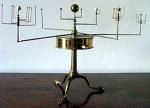

In 1713 English clockmaker George Graham (1674-1751) creates the first Orrery, a mechanical model of the Solar System, named for his patron Charles Boyle, 4th Earl of Orrery (1674-1731), and built by instrument maker John Rowley of London; Orrery gets the 2nd copy after the first goes to Austrian prince Eugene of Savoy (1663-1736).
In 1714 the first crude typewriter is patented by Henry Mill (1683-1711) in England.
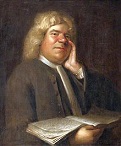
In 1717 the hybridization of Dianthus is reported in Britain by English gardener Thomas Fairchild (1667-1729) of Hoxton, East End, London, who crosses a Sweet William (Dianthus barbatus) with a Carnation Pink to create Fairchild's Mule, the first artificial hybrid.

In 1718 French-born mathematician (in London) Abraham de Moivre (1667-1754) pub. The Doctrine of Chances, the first textbook on probability theory, prized by gamblers. In 1830 he pub. Miscellanea Analytica, the first book to use a probability integral with an integrand consisting of the exponential of a negative quadratic; it contains De Moivre's Formula, using complex numbers in trigonometry, bringing it into the realm of analysis.

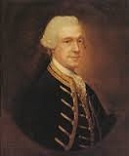
In Apr. 1721 Scottish surgeon Charles Maitland (1668-1745) performs the first smallpox inoculation in England with live smallpox virus on 4-y.-o. Mary Montagu, daughter of Lady Mary Wortley Montagu (1689-1762), who had contracted smallpox in Dec. 1715 and learned of the procedure while visiting Constantinople and had him do it to her 5-y.-o. son there in Mar. 1718; in Aug. 1722 seven condemned prisoners at Newgate Prison volunteer to become guinea pigs, and all survive and are released; in Dec. 1722 after five orphans of St. James's Parish in London are successfully inoculated, French-born English surgeon Claudius Amyand (1680-1740) inoculates three of the children of Prince George (later George II) and Princess Caroline of Ansbach, and later has Maitland inoculate her eldest son Frederick and one other child; meanwhile a smallpox epidemic in Boston, Mass. in Apr.-Dec. 1721 that infects 5,889 and kills 884 leads Cotton Mather to have his son inoculated, then to preach inoculation, causing a public hue and cry against him even though it works, drawing fire from physician William Douglass and support from physician Zabdiel Boylston, with prejudice against "heathens" in the Ottoman Empire and Bible-thumping arguments playing a role. On Dec. 6, 1735 Amyand performs the first successful Appendectomy on 11-y.-o. Hanvil Anderson at St. George's Hospital in London, England.
In 1724 the Jantar Mantar (magical device), a network of three observatories based in and S of Delhi is constructed in the "Pink City" of Jaipur, Rajasthan by Rajput maharaja and astronomer Maharaja Sawai Jai Singh II (1688-1743) of Amber, who designs masonry structures and crude instruments because his Jesuit advisers were prohibited by the Church from accepting the views of Galileo and Copernicus; the city is designed according to Hindu doctrine in seven rectangular areas according to the caste system, with the palace in the 7th and holiest one, and the observatory in the place of the temple; other observatories are built in Delhi, Mathura, Ijjain, and Varanasi.

In 1725 English astronomer royal #3 James Bradley (1692-1762) observes that the fixed stars describe small ellipses within exactly the duration of the terrestrial year, and that stars from the poles of the ecliptic to the ecliptic describe figures increasingly less circular and more approaching straight lines, suggesting the possibility of observing stellar parallax (discovered in 1838); he also discovers the aberration of light (which he explains by the finite speed of light combined with the motion of the Earth around the Sun), and the phenomenon of nutation, and begins measurement throughout an 18.5-year lunar cycle (until 1748).

In 1726 English clergyman Stephen Hales (1677-1761) first measures blood pressure. In 1727 he pub. Vegetable Staticks, or, Statical Essays, which founds the science of plant physiology.
You might as well be walking in the Sun? On Apr. 15, 1726 William Stukeley dines with Sir Isaac Newton; "After dinner, the weather being warm, we went into the garden and drank thea, under the shade of some appletrees, only he and myself. Amidst other discourse, he told me, he was just in the same situation, as when formely, the notion of gravitation came into into his mind. It was occasion'd by the fall of an apple, as he sat in a contemplative mood. Why should that apple always descend perpendicularly to the ground, thought he to himself. Why should it not go sideways or upwards, but constantly to the earths centre? Assuredly, the reason is, that the earth draws it... That there is a power, like that we here call gravity, which extends its self thro' the Universe."
On Mar. 31, 1727 (Mar. 20, 1726 Old Style) Sir Isaac Newton (b. 1643) (b. 1642 Old Style) dies in London after saying that his greatest accomplishment is lifelong celibacy; his brainy disciple Samuel Clarke (1675-1729) (known for leaping over chairs and tables and swimming on tables?) turns down his £1K-a-year job as master of the mint because it's a govt. job and he's a clergyman?; his VIP burial is attended by royalty and presided over by his friend Alexander Pope (1688-1744), who gives a stirring eulogy before sprinkling dirt on his tomb, with the soundbyte: "Nature and Nature's Laws lay hid in Night/ God said, Let Newton be! and All was Light".
On Mar. 31, 1727 (Mar. 20 Old Style) English #1 scientist-mathematician-alchemist Sir Isaac "Apples Happen" Newton (b. 1643) (b. 1642 Old Style) dies in London; his funeral is presided over by "A. (Alexander) Pope"; first scientist buried in Westminster Abbey; leaves a sealed trunk with 100K pages on alchemy, astrology, and the occult, incl. works rejecting the Bible Book of Revelation (after all, he lived through 1666 personally so it failed the empirical test?); also leaves The Chronology of Ancient Kingdoms Amended; "Newton was not the first of the Age of Reason. He was the last of the magicians, the last of the Babylonians and Sumerians... He looked on the Universe and all that is in it as a riddle... He regarded the Universe as a cryptogram set by the Almighty" (John Maynard Keynes) - having a sense of the mathematical designs and codes in Nature, and believing he can concentrate hard enough to decode anything, he falls for Satan's offer to be a god and enjoy immortality if he can just find the code for the right potion, laboring to the point of mental breakdown to find it, thinking that Satan is Lucifer, the Angel of Light, who will be his god forever, while all that Be As A Child, Have Faith, Jesus Saves, Armageddon is Nigh, and Leave It To Beaver, er, Jehovah to Resurrect You stuff sails over his proud head?

In 1727 after discovering slight magnetic fluctuations on his compass to be correlated with the latter's observations of aurorae, English watchmaker George Graham (1674-1751) and Swedish scientist Anders Celsius (1701-44) discover that sunspots are really magnetic storms.
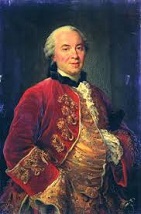

In 1727 French scientist ("Father of Natural History") George-Louis Leclerc, Comte de Buffon (1707-88) discovers the Binomial Theorem. In 1749-89 he pub. Histoire Naturelle, générale et particulière, avec la description du Cabinet du Roy (36 vols.) (8 more vols. pub. posth.), which becomes an internat. hit, shocking Bible-thumpers with the claim that the Earth has been developing for at least 75K years via "organic particles", pointing out similarities but not the common ancestry of humans and apes while entertaining it as a hypothesis, preparing peoples' minds for the advent of Darwinism, Anthropology, etc.; too bad, he views the Caucasian race of Adam and Eve as the pinnacle, and all other races as a degenerated version caused by climate, etc. - if they only coulda seen U.S. Pres. George W. Bush?
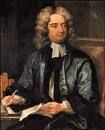
In 1727 Irish writer Jonathan Swift (1667-1745) pub. Gulliver's Travels (Travels into Several Remote Nations of the World, in Four Parts, By Lemuel Gulliver, First a Surgeon, and then a Captain of Several Ships); Lemuel Gulliver visits the countries of Lilliput (6-in. tall people, their city of Mildendo surrounded by a 2.5-ft. wall), Blefuscu (ditto), Brobdingnag (60-ft. tall giants), Laputa (flying island of scientific quacks), Glubdubdrib (sorcerers), Luggnag (island where the Stuldbrugs live forever), the land of the Houyhnhnms, where intelligent horses rule over savage humanoid Yahoos, and Balnibarbi (inventors and projectors, capital Lagado); a satire of all things English, or just English modernism?

In 1728 French scientist ("Father of Modern Dentistry") Pierre Fauchard (1678-1761) pub. Le Chirurgien Dentiste, ou Traite des Dents (The Surgeon Dentist), which disproves the worm theory of dental decay, and invents the prof. of dentistry and the word dentist; he invents an improved tooth drill.
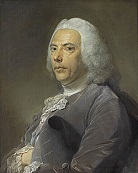
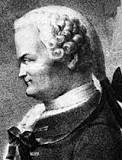
In 1729 French scientist Pierre Bouguer (1698-1758) pub. Essai d'optique sur la gradation de la lumiere (lumière), a study of the quantity of light lost passing through the atmosphere, announcing the Beer-Lambert Law, which states that the absorbance is directly proportional to its path length; in June 1760 Swiss superbrain scientist Johann Heinrich Lambert (1728-77) pub. Photometria, establishing a complete system of photometry (Gr. "photos" + "metria" = light + measurement), quoting Bouguer's 1729 paper proposing the Beer-Lambert Law and ending up getting credit; in 1852 German Jewish scientist August Beer (1825-63) pub. another version, stating that the intensity of light transmitted through a solution at a given wavelength decreases exponentially with the path length and the concentration of the solute - let's have a beer?

In 1729 French scientist Jean-Jacques d'Ortous de Mairan (1678-1771) first observes the Circadian Rhythm in the plant Mimosa pudica.

In 1730 Swedish chemist Georg Brandt (1694-1768) discovers the element Cobalt (Co) (#27), becoming the first new element discovered since ancient times.


In 1730 English mathematician John Hadley (1682-1744) invents the Octant (precursor to the sextant) for sea navigation to determine latitude; Thomas Godfrey (1704-49) of British Am. independently invents it.

In 1730 Henri Pitot (1695-1771) of France invents the Pitot Tube to measure fluid velocity.
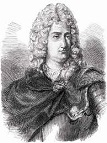
In 1730 French chemist Charles Francois de Cisternay du Fay (1698-1739) discovers that electrical action can be repulsion as well as attraction.
In 1730 George Martine (1700-41) performs the first tracheotomy to treat diphtheria.
In 1730 London Soho optician Edward Scarlett perfects rigid sidepieces for eyeglasses, which are in greater demand because of the proliferation of the printing press - tell us about the revolutionary role spectacles play in history?

In 1731 French entomologist Rene (René) Antoine Ferchault de Reaumur (Réaumur) (1683-1757) invents an alcohol thermometer with the 0-80 (freezing-boiling) Reaumur (Réaumur) Temperature Scale - he should have used the 20-80 rule and made it 0-100? In 1752 he proves that gastric juice dissolves meat - and thus all animals are meat machines?
In 1731 English astronomer John Bevis (1695-1771) discovers the Crab Nebula (M1), which was seen by Chinese astronomers in 1054.
In 1731 the annual Copley Medal is founded via a £100 bequest by Sir Godfrey Copley, 2nd Baronet (1653-1709) to recognize "outstanding achievements in research in any branch of science", becoming the oldest medal awarded by the British Royal Society, and the oldest scientific award to survive to modern times; the first one is given to Stephen Gray for "his new Electrical Experiments".

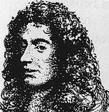
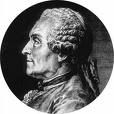
Spin it round, spin it round? In 1732 Saint-Malo-born Pierre Louis Moreau de Maupertuis (1698-1759), who left the army in 1723 at age 25 after five years of spare-time study of math to become a member of the Academie Francaise in Paris introduces Newton's Theory of Gravitation to France, sparking a French nerd movement. Science reaches out and touches Father, er, Mother Earth? In 1735 the Paris Academie Francaise is rocked by a controversy between supporters of Isaac Newton (1643-1727), led by Pierre de Maupertuis (1698-1759), who believe that the Earth is slightly flattened at the poles, and supporters of Jacques Cassini (1677-1756), who believe it is instead flattened at the equator. In 1736 French scientist Charles Marie de La Condamine (1701-74) leads an expedition to Ecuador-Peru to measure a degree of longitude at the equator, siting the zero degree latitude line (Middle of the World) near Quito, and discovering rubber (insert gratuitous sex joke here?); meanwhile Anders Celsius and Pierre de Maupertuis lead an expedition to Lapland to measure a degree of longitude at the North Pole, and verify Isaac Newton's prediction that the Earth is an oblate spheroid - of course, it's a woman not a man?

In 1732 English clockmaker Christopher Pinchbeck (1670-1732) invents the copper-zinc alloy Pinchbeck, which becomes popular for imitation gold watches for the next 20 years until 9-carat gold and electrogilding replace it.

In 1733 French chemist Charles Francois de Cisternay du Fay (1698-1739) pub. his discoveries that electrical action can be repulsion as well as attraction, calling the two types "vitreous" and "resinous", noting the difference between conductors ("electrics") and insulators ("non-electrics"); he also disproves the theory of Stephen Gray that electric properties of a body depend on its color.
In 1733 British lawyer Chester Moore (Moor) (More) Hall (1703-71) builds the first Achromatic Compound Lens out of flint glass.
In 1733 John Kay (1704-80) of England patents the Flying Shuttle Loom for the manufacture of textiles, which uses a lever and springs to allow one weaver to throw the shuttle back and forth instead of two; too bad, while wool weavers adopt it, cotton weavers don't follow er, suit until the 1760s.


In 1735 Swedish botanist Carl Linnaeus (1707-78) pub. Systema Naturae, which describes his plant classification system. In 1751 he pub. Philosophia Botanica, the first textbook on systematic botany and botanical Latin. In 1753 he first distinguishes plants via species and genera, causing him to become known as the Father of Taxonomy.

In 1736 Swiss #1 mathematician Leonhard Euler (1707-83) solves the Konigsberg (Königsberg) Bridge Problem, and founds the study of Analytical Mechanics. In 1744 he discovers the Calculus of Variations. In 1752 he pub. the Polyhedron Face-Vertex-Edge Formula f+v=e+2 (e.g., f=6, v=8, e=12 for a cube, f=32, v=60, e=90 for a buckyball). In 1768 he proposes that the wavelength of light determines its color.

In 1736 English clockmaker John Harrison (1693-1776) completes the first accurate chronometer for determining longitude, making long-distance sea travel possible along with a global sea empire, and applies for the £20K Longitude Prize offered by the British govt.; too bad, they play games and never award it to him as he goes through five major versions H1-H5; in 1773 after George III personally intervenes, Parliament gives him a different monetary award.

In 1737 English mathematician Thomas Simpson (1710-61) pub. Treatise of Fluxions, in which he derives Simpson's Rule for numerical approximation of definite integrals, which he gets credit for even though it was used by Galileo's student Bonaventura Cavalieri in 1639, and by Johannes Kepler.

In 1737 Jacques de Vaucanson (1709-83) of France builds the Transverse Flute Player, a lifesize automaton that plays the pipe and tabor and has a 12-song repertoire; next year he puts skin on it so it can play the flute; the first true robot? In 1738 he builds the Tambourine Player and the Digesting (Defecating) Duck, with 400+ moving parts, able to flap its wings and drink, eat, and shit from a hidden container (no actual digestion) using the world's first flexible rubber tube. In 1745 after being appointed by Cardinal Fleury in 1741 as French inspector of silk manufacture, he invents a Punch-Card Controlled Drawloom (the first completely automated loom) in an effort to help French industry catch up with England and Scotland; too bad, the Luddites shut him down, and he gives up on robots.

In 1738 Swiss mathematician-physicist Daniel Bernoulli (1700-82) pub. Hydrodynamica, which announces Bernoulli's Law (Principle), a pressure-velocity (PV) relationship for fluids explaining the loss of vis viva in fluid flow using the idea of conservation of energy, stating that an increase in the speed of a fluid occurs simultaneously with a decrease in the fluid's pressur or potential energy, founding the field of Hydrodynamics; derives Boyle's Law by considering a gas as a collection of atoms which collide with the container wall, but everybody overlooks it until it's rediscovered in 1859 - they still teach all that in Top Gun school?
In 1738 the first Cuckoo Clocks are produced in the Black Forest district of Germany - 200 years till Shirley Temple as Heidi?
In 1739 Plunket Fleeson of Philadelphia, Penn. invents Wallpaper, stamping designs on paper with woodblocks, painting them in by hand, then advertising "paper hangings" in the Penn. Gazette - plunket and fleece 'em?

In 1740 Hold onto your bonnet, boys? Charles Bonnet (1720-93) of Switzerland pub. his Dissertation on Aphids, describing parthenogenetic reproduction for the first time, winning him the honor of corresponding member of the French Academy of Science.


And I owe it all to the Bissel Flipit? In 1740 Emilie Du Chatelet (Gabrielle Émilie Le Tonnelier de Breteuil, Marquise Du Châtelet) (1706-49), a student of Pierre de Maupertuis, who attracted Voltaire to her scientific circle then became lovers and shacked up with him in her cozy chalet pub. a seminal paper in Institutes of Physics, based on experiments of Dutch scientist Willem Jacob 's Gravesande (1688-1742), backing up Gottfried Wilham von Leibniz' vis viva theory (energy is mass times speed squared, not mass times speed as Isaac Newton claims); being a woman, it is not accepted for a cent., and meanwhile she dies in 1749 at age 43 (15 years after hooking up with Volty) of an embolism 6 mo. after giving birth to a 4th child; "A great man whose only fault is being a woman." (Voltaire)

In 1740 French scientist Charles Marie de La Condamine (1701-74) discovers Curare.

On June 7, 1742 Prussian-born mathematician Christian Goldbach (1690-1764) proposes the Goldbach Conjecture, that every natural number greater than two can be expressed as the sum of two primes, and every natural number greater than five can be written as the sum of three primes; it is solved in ?.

In 1743 French mathematician-astronomer Alexis Claude Clairaut (1713-65) pub. a confirmation of Isaac Newton's prediction that the Earth is slightly oblate (flattened at the poles).

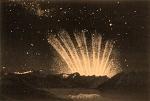
On Dec. 9, 1743 the Klinkenberg-De Cheseaux Comet (Great Comet of 1744) is discovered by Dirk Klinkenberg (1709-99) of Haarlem, Netherlands, and again on Dec. 13 by Jean-Philippe Loys de Cheseaux (Chéseaux) (1718-51) of Lausanne, Switzerland; next Mar. it exhibits 6-7 tails and becomes brighter than Jupiter, becoming the largest recorded comet since the birth of modern astronomy (0.5 absolute magnitude), although the ancients saw a bigger 10-tailed comet in -1486. In 1744 Cheseaux first states Olbers' Paradox, that the night sky can't be dark if the Universe is infinite.

In 1744 French scientist Jean Baptiste le Rond d'Alembert (1717-83) pub. Traite de l'Equilibre et du Mouvement des Fluides (Treatise on the Equilibrium and Movement of Fluids), which introduces the components of fluid velocity and acceleration, differential requirements for continuity, and complex numbers, deriving the paradox of zero longitudinal force on the body.

In 1744 French naturalist Georges Louis Leclerc, Comte de Buffon (1707-88) pub. his 44-vol. L'Historie Naturelle, which shocks Bible-thumpers with its claim that the Earth has been developing for at least 75K years via "organic particles", pointing out similarities if not the common ancestry of humans and apes - if they only coulda seen U.S. Pres. George W. Bush?


In 1744 Spanish scientists slash naval officers Antonio de Ulloa (1716-95) and Jorge Juan y Santacilia (1713-73), who went on the La Condamine expedition to South Am. in 1736 then remained, discover sizeable stores of the element Platinum (Pt) (#78) (Sp. "platina" = little silver), and take some back to Europe with them on separate ships; too bad, Ulloa's ship is captured by the Brits, but after the scientists pull their increasingly powerful internat. strings he ends up a fellow of the Royal Society of London - what's it good for, doorstops?

In 1744 Benjamin Franklin invents the cast-iron Franklin Stove, which stands away from the walls and looks like a chimney; it is redesigned in 1790 by David R. Rittenhouse so that it actually works.



In 1745 French mathematician Pierre Louis Moreau de Maupertuis (1698-1759) (whose portrait bears a striking resemblance to actor Bob Hope (1903-2004)?) pub. Venus Physique (The Earthly Venus), which challenges the preformation theory of genetics, proposing development of life from a common ancestor, and announcing the take-a-chance-on-me Principle of Least (Stationary) Action. In 1747 he and French mathematician Alexis Claude Clairaut (1713-65) return from expeditions to Peru and Lapland with proof that the Earth is oblate as predicted by Newton, not ovoid as predicted by Descartes - he laid an egg? In 1751 he pub. Systeme de la Nature, which challenges the spontaneous generation of life, and proposes the idea of dominant and recessive genes by discussing polydactyly in families, attributing it to a mutation in the "hereditary particles".

In 1745 English farmer Robert Bakewell (1725-95) of England pioneers Systematic Stock Breeding (Animal Husbandry) - good stock we must bake well?

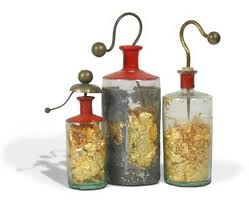
In 1745-6 the Leyden Jar, the biggest electrical breakthrough of the 18th cent. is discovered independently by Canon Ewald Georg von Kleist (1700-48) of Kamin, Pomerania (Oct. 11, 1745) and Pieter van Musschenbroek (1692-1761) of the U. of Leyden in Holland (Jan. 1746), giving it its name.

In 1746 French philosopher Denis Diderot (1713-84) anon. pub. Pensees Philosophiques, a collection of aphorisms, giving him a rep after the Paris Parlement burns it for its anti-Christian ideas, causing him to be found out and invited to edit a French tr. of the 1728 English "Cyclopedia" of recently-deceased lexicographer Ephraim Chambers (1660-1740), and he hooks up with Jean Baptiste Le Rond d'Alembert and ramps up the project into a propaganda campaign against the Church and feudal society, esp. in France. In 1751 they pub. Encyclopedie (Encyclopédie) ou Dictionnaire Raisonne (Raisonné) des Sciences, des Arts et des Metiers (Métiers), Vol. 1 in Paris, becoming the Bible of the French Enlightenment; it is pub. despite hounding by govt. censors and condemnation by the Church and other enemies, who to try to prevent pub., getting it delayed in 1752 and 1757, and suppressed in 1759-65; it eventually comprises 34 vols. (last vol. pub. 1772) - I know, I memorized them all?
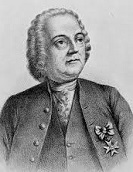
On Apr. 8, 1747 French opthalmologist Jacques Daviel (1696-1762) performs the first extracapsular cataract extraction surgery, becoming the first significant advance since couching in ancient India - just use a laser?

In 1747 Edinburgh physician James Lind (1716-94) discovers that lemons and oranges cure Scurvy, while vinegar, garlic, and seawater are ineffective; British ships begin carrying limes from Montserrat Island in the Caribbean, causing British seamen to become known as limeys.


In 1747 German chemist Andreas Sigismund Marggraf (1709-82) discovers sugar in beet roots, also a pure form of zinc; his student Franz Karl Achard (1753-1821) goes on to devise an economical industrial method to extract pure sugar from beets.

In 1748 French physicist Abbe Jean-Antoine Nollet (1700-70) invents the Electroscope, and describes how a cylinder filled with alcohol, closed with an animal bladder and immersed in water causes the bladder to swell to bursting as water passes in and alcohol can't pass out, becoming the first description of Osmotic Pressure (Gr. "osmos" = impulse).

In 1750 Swiss mathematician Gabriel Cramer (1704-52) pub. Cramer's Rule for solving a system of linear equations with matrices and determinants; too bad, Colin Maclaurin beat him to it in 1748?

In 1750 French economist Anne-Robert-Jacques Turgot, Baron de Laune (1727-81) pub. A Philosophical Review of the Successive Advances of the Human Mind on Universal History: Reflections on the Formation and the Distribution of Wealth, the first pub. of the idea of progress, which incl. the arts, sciences, and culture.

Frankly my dear, I don't give a bolt? In 1750 Am. brain man Benjamin Franklin (1706-90) presents Two Letters on Lightning to the Royal Society of London, describing an 1749 experiment (which he hasn't tried yet) to see if lightning is really electricity by holding a 20-30-ft. pointed sharp metal rod up from the top of a tower during a thunderstorm, inventing the Lightning Rod; they are excerpted in The Gentleman's Magazine, then pub. as an 86-page booklet next year, causing a (electric?) sensation.

In 1750 Jonas Hanway (1712-86) of London becomes the first to use an umbrella to keep off rain, rather than a newspaper in his hand to keep the rain away, suffering catcalls and jeers as up till now only women used them, and only as sun shades (parasols).
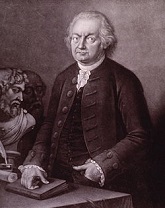
In 1751 German physician Johann Gottlob Leidenfrost (1715-94) discovers the Leidenfrost Effect, in which a liquid dropped on a surface hotter than its boiling point produces an insulating vapor layer that causes it to hover over the surface.
In 1751 German physicist Johann Tobias Mayer (1723-1830) pub. new solar tables which improve navigation, giving longitude at sea to 0.5 deg.
In 1752 James Ayscough (-1759) of London perfects Eyeglasses with double-hinged sidepieces, which become the fashion.
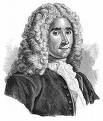
In 1752 Rene Antoine Ferchault de Reaumur (1683-1757) proves that
gastric juice dissolves meat - and thus all animals are meat machines?

In 1754 Scottish chemist Joseph Black (1728-99) discovers carbon dioxide (carbonic acid) gas, which he
calls "fixed air", and discovers its function in the "causticization of lime", which helps disprove the phlogiston theory.
In 1761 Black discovers the phenomenon of Latent Heat
(required to effect a change of state), and measures the value for steam in 1764.
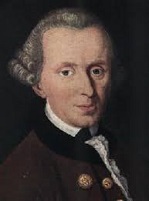
In 1754 German brain man Immanuel Kant (1724-1804) discovers the retardation of the rotation of the Earth by frictional resistance of tidal currents, and concludes that time is not a thing in itself, but an unavoidable framework of the human mind; his discovery isn't noticed by scientists until 1840 when the idea of energy is being developed. In 1755 he pub. his doctoral thesis Gen. Natural History and Theory of the Celestial Bodies, conceding the existence of life on other planets like Giordano Bruno was burned at the stake for, and advancing the nebular hypothesis, describing nebulae as "island universes".
In 1757 South Am. cinchona being so expensive, and assuming that since malaria comes from marshy places, the cure must ditto, English clergyman Edward Stone substitutes willow bark, and thinks it cures malaria as well, although all it does is reduce fever, which becomes known as the Willow Bark Fallacy.

In 1757 Capt. John Campbell (1720-80) of England invents the Vernier Sextant.
In 1757 James Whatman (1702-59) of Kent, England invents Wove Paper (Papier Velin), featuring a uniform surface free of ribs and watermarks.

In 1758 Dalmatian Jesuit mathematician (in Italy and France) Roger Joseph (Ruggero Giuseppe) Boscovich (1711-87) pub. A Theory of Natural Philosophy Reduced to a Single Law of the Actions Existing in Nature (Theoriam Philosophiae Naturalis Redacta ad Unicam Legem Virium in Natural Existentium), which questions Newtonian action at a distance and pioneers field theory, later influencing Michael Faraday.

In 1758 John Dollond (1706-61) and Chester Moor Hall (1703-71) of England independently invent the Achromatic Lens for telescopes after taking Leonhard Euler's 1747 suggestion of glass and water lenses and switching to crown and flint glass, countering Newton's belief that chromatic aberration is present in all lenses; after finding that optician George Bass made achromatic lenses without patenting them in 1733, Dolland refrains from enforcing his patent, but when he dies his son Peter Dollond (1730-1820) goes after everybody and gets the patent upheld, ruining several opticians until it expires in 1772.

In 1758 Scottish physician James Lind (1716-94) discovers that heating salt water produces steam that is fresh, and proposes solar energy distillation of water for ships, but nothing is done until 1810.

In 1758 French astronomer Charles Messier (1730-1817) rediscovers the Crab Nebula in the constellation Taurus, first seen by Chinese astronomers in 1054, and decides that it isn't a comet since it doesn't move, causing him to begin compiling his Messier Star Catalog, with this as M1 (actually a catalog of celestial objects that shouldn't be mistaken for comets).

In 1759 German mathematician Johann Heinrich Lambert (1728-77) pub. Treatise on Optics and Treatise on Perspective, causing the unit of brightness to later be named after him. In 1768 he proves that pi is incommensurable (has no common divisor).

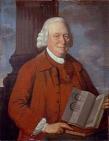
On June 6, 1761 there is rare (once in 434 years) transit of Venus, and Russian mathematician Mikhail Vasiliyevich Lomonosov (1711-65) of Petersburg, Russia uses observations to predict that Venus has an atmosphere, causing preparations for the companion transit in 1769 to become big stuff; London-born English Rev. Dr. Nevil Maskelyne (1732-1811) is sent with mathematician Robert Waddington (-1779) to St. Helena Island to observe the transit, but bad weather prevents it, however, he successfully tests his new lunar distance method of determining longitude using the position of the Moon, which he pub. in The British Mariner's Guide (1763), and is used until about 1850; in 1765 he is appointed British astronomer royal #5 (until 1811).

In 1761 English mathematician and Presbyterian minister Thomas Bayes (1701-61) dies, leaving "An Essay Towards Solving a Problem in the Doctrine of Chances", containing Bayes' Theorem, which is read to the Royal Society by Richard Price in 1763; the theorem "is to the theory of probability what Pythagoras' theorem is to geometry" (Sir Harold Jeffreys).

In 1764 poor weaver James Hargreaves (1720-78) of Blackburn, England invents the Spinning Jenny, a mechanical spinning wheel that can spin eight threads at once; too bad, the news leaks, causing Luddites to invade his home and destroy it, after which he moves to Nottingham and gets financial backers, and patents it in 1770, only to see patent violators steal him blind.

In May 1765 Scottish inventor James Watt (1736-1819) (asst. of Joseph Black) invents the dual condenser steam engine (one hot and one cold) (patented in 1769), which cuts fuel consumption in the Newcomen steam engine by two-thirds, giving steam engines up to 7% efficiency, thus making them practical; he coins the marketing term "horsepower", and the Industrial Rev. is cooking with steam. In Oct. 1781 Watt patents the Sun-and-Planet Gear that makes it possible to give rotary motion to machinery via a steam engine - bringing the power of the sky down to Earth?

In 1765 Lazzaro Spallanzani (1729-99) of Italy discovers hermetic sealing as a means of preserving food - I no wanna lazzaro spoil la lasagni? In 1768 he disproves the theory of spontaneous generation using rotting meat in a hermetically-sealed container, which doesn't sprout maggots or flies.


In 1766 English scientist Henry Cavendish (1731-1810) studies hydrogen ("inflammable air"), named in 1787 by French chemist Louis-Bernard Guyton de Morveau (1737-1816) (from the Gr. for "water producing" when it burns), learns how to produce it, and discovers that it is lighter than air, and forms water on combustion, with the soundbyte "Water consists of dephlogisticated air [oxygen] united with phlogiston [hydrogen]."


In 1766 German mathematician Johann Daniel Titius (1729-96) discovers a pattern in planetary distances, namely that they are in the proportions 4, 7, 10, 16, 28, 52, 100, 196, which happens to be the series 0, 3, 6, 12, 24, 48, 96, 192 with 4 added to each; in 1772 German astronomer Johann Elert Bode (1747-1826) pub. it for the 1st time, causing it to become known as the Bode (Titius-Bode) Law of Planetary Distances; the discovery of Uranus in 1781 checks with the number 196, and the discovery of the asteroid Ceres (orbiting between Mars and Jupiter) in 1801 checks with the missing number 28, however Neptune (388) and Pluto (722) don't pan out, and the Titillating Bogus Law is dismissed as moose hockey (coincidence).
In 1766 London engraver-mapmaker John Spilsbury (1739-69) invents the jigsaw puzzles, a set of world maps.

In 1767 Swedish chemist Torbern Olaf Bergman (1735-84) of Uppsala measures and records the first "chemical affinities"; in 1775 he pub. Dissertation on Elective Affinities, containing the largest chemical affinity tables ever pub., first using the A, B, C etc. system for chemical equations.
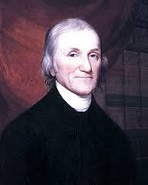
In 1767 English chemist Joseph Priestley (1733-1804) creates the first artificially carbonated water; in 1771 Torbern Olaf Bergman of Sweden makes it from chalk and sulfuric acid. In 1770 Priestley discovers sulfur dioxide, and coins the name "rubber" for the substance from an Am. tree that is good for wiping black lead pencil marks from paper - funny how a priest coins the term rubber?

In 1767 Swiss Alpine climber and scientist Horace-Benedict de Saussure (1740-99) begins studying glass solar heat traps, obtaining temps higher than boiling water and building the first solar oven.

In 1768 French chemist Antoine Baume (Baumé) (1728-1804) invents the Baume (Baumé) Scale, a pair of hydrometer scales that measure the density of various liquids in degrees Baume, with distilled water = 0.
In 1769 Benjamin Franklin charts the Gulf Stream using info. from whaler captains and bottles dropped into the water with notes asking finders to return them to the postmaster gen. of the Am. colonies.

In 1769 after modifying an unsuccessful machine patented by Lewis Paul in 1738, English textile capitalist Richard Arkwright (1732-92) of Bolton invents the Water Frame hydraulic spinning machine to speed up the process of spinning cotton rope (roving) into fine twisted cotton threads using revolving rollers.

In 1769 French artillery officer Nicolas-Joseph Cugnot (1725-1804) builds a small 2-cylinder 3-wheeled steam carriage ("fardier a vapeur") (the first automobile?) in Paris, which can carry four people at 2 mph but lacks sufficient power and is unstable; next year he builds a larger version as a gun carriage for the French War Ministry, but it overturns as he tries to turn a corner on a Paris street, and knocks down part of the stone arsenal wall (first automobile accident), and he is sent to jail as a dangerous driver and his machine is impounded, ending up in the Conservatoire Nat. des Arts et Metiers in 1800 - if it worked we might have 100 Cugnotpower automobile engines?

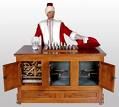
Is it a big head thing? In 1769 German engineer Baron Wolfgang Ritter von Kempelen (1734-1804) builds The Turk, a chess-playing automaton in Vienna, which sits behind a 4'x2'x3' box with machinery and never loses; HRE Joseph II of Austria falls for it, and sends it on a tour of Europe, defeating Empress Catherine II of Russia and Napoleon; when Kempelen dies, it is revealed that a man hides inside; it is destroyed in a 1854 fire in the Chinese Museum in Philly.

In the 1770s the Chemical Rev. begins in Europe, led by French brain man ("the Father of Modern Chemistry") Antoine-Laurent de Lavoisier (1743-94).
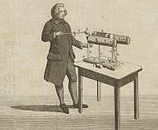
On Apr. 15, 1770 the Pencil eraser is first described by English scientist Joseph Priestley made of a vegetable gum that he calls rubber; meanwhile English optician Edward Nairne (1726-1806) begins marketing erasers at 3 shillings/half-in. cube, making them popular as an alternative to bredcrumbs despite the high price; Nairne also patents a medical electrostatic generator, a chest microscope, and the first sucessful marine barometer.

In 1771 Scottish surgeon John Hunter (1728-93) pub. A Treatise on the Natural History of the Human Teeth, an anatomy of the jaws and teeth, which coins the terms "(bi)cuspids", "incisors", and "molars", founding modern dentistry. In 1772 he pub. The Digestion of the Stomach after Death, which describes shock and intussusception. In 1776 he becomes surgeon extraordinary to George III, rising to surgeon gen. in 1789; he goes on to become "the Father of Modern Scientific Surgery", building his knowledge from scratch with a collection of 13K specimens, pioneering new methods of repairing damage to the Achilles tendon, and a better method for ligating the arteries to treat an aneurysm, becoming one of the first to understand the importance of pathology, advocating surgery as the last resort to prevent complications from infection; in 1776 he oversees the first successful attempt at human artificial insemination, telling a linen draper suffering from hypospadias to impregnate his wife using a warm syringe - you need a bigger car?

In 1771 German-Swedish chemist Karl (Carl) Wilhelm Scheele (1742-86) discovers the halogen element Fluorine (Lat. "fluo" = to flow) (F) (#9).


In 1771 Swabian-born Jesuit U. of Vienna prof. Franz Friedrich Anton Mesmer (1734-1815) uses magnetic plates to cure diseases; in 1774 he invents animal magnetism (mesmerism) as the cure-all, hypnosis for your health, which develops a large following in about 1780-1850, with some influence until 1900. In 1834 Scottish physician ("Father of Modern Hypnotism") James Braid (1795-1860) coins the term "hypnosis" for animal magnetism or mesmerism.

In 1772 Italian mathematician-astronomer Joseph-Louis Lagrange (Giuseppe Luigi Lagrangia or Lagrancia) (1736-1813) pub. a paper proposing the five Lagrange (Libration) Points (L1 to L5), gravitational parking spaces. In 1788 he introduces Lagrangian Mechanics, which uses the Calculus of Variations.
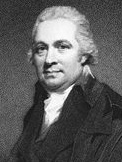
In 1772 Scottish chemist Daniel Rutherford (1749-1819) discovers the gaseous element Nitrogen (N) (#14). In 1772 Priestley discovers nitrous oxide, which soon begins to be abused in laughing gas parties.
In 1773 the Shropshire Process for making iron is invented in England, and in 1779 the first cast iron bridge begins construction over the Severn River at Coalbrookdale in Shropshire (finished 1792). C.G. Kratzenstein of Copenhagen succeeds in reproducing human vowels mechanically using resonance tubes connected to organ pipes. In 1773 Swiss inventors Pierre Jacquet Droz (1721-90) and Henry Louis Jaquet-Droz (1752-91) invent the first automaton that can write.
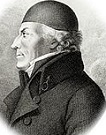
In 1774 Swedish chemist-metallurgist Johan Gottlieb Gahn (1745-1818) of Falun, Sweden discovers Manganese (It. "by metathesis") (Mn) (#25).
In 1774 Karl Wilhelm Scheele discovers Ammonia, Barium (Ba) (#56), Chlorine (Cl) (#17) and Baryta (barium sulfate), and (along with Joseph Priestley and Antoine-Laurent Lavoisier) oxygen (O) (#16), which is first isolated by Priestley on Aug. 4.
A frosty but good year for inventors? In 1774 Eiswein (sweet wine from grapes that are allowed to freeze on the vine) is discovered by accident in the Franconia wine region of Germany near Wurzburg. In 1774 ice cream is first mentioned in British Am. In 1774 William Forsyth constructs the first rock garden in England. In 1774 Paper whitener is invented in Sweden. In 1774 John "Iron-Mad" Wilkinson (1728-1808) of England constructs a boring mill to manufacture steam engine cylinders - not that kind of boring?
In 1775 Priestley discovers hydrochloric acid and sulfuric acid.
In 1776 French chemist Joseph Marie Francois de Lassone (1717-88) becomes the first to prepare carbon monoxide by heating zinc oxide with coke, but thinks it's hydrogen because it burns with a blue flame; it takes until 1800 for English chemist William Cruikshank to identify its elements carbon and oxygen.


In 1776 Swedish chemists Karl (Carl) Wilhelm Scheele (1742-86) and Torbern Olof Bergman (1735-84) (who originally "discovered" Scheele) independently discover uric acid in kidney stones, and produce oxalic acid by reacting sugar with nitric acid, calling it "sugar acid" (sacker/socker-syra) - good cover story until they're ready to come out of the closet?
In 1777 Carl Wilhelm Scheele almost discovers ultraviolet when he studies how light of different colors darkens silver chloride, and finds that the effect is greatest toward the violet end of the spectrum.
In 1778 Carl Wilhelm Scheele discovers the element Molybdenum (Mo) (#42), and proves that molybdenite (molybdenum sulfide), graphite (black lead or plumbago), and galena (lead II sulfide) are three different minerals.

In 1779 Antoine-Laurent Lavoisier and Pierre Simon Laplace pub. their discovery that respiration is a form of combustion. In 1779 Scheele discovers Glycerine, and makes the surprising discovery that black pencil lead (plumbago) is actually a soft form of carbon; in 1789 In 1789 German Prussian geologist Abraham Gottlob Werner (1749-1817) names black lead Graphite, from the Greek "graphein" = "to draw or write".

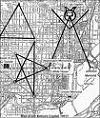
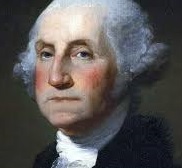







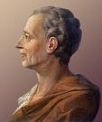





It took 1300 years after the fall of Rome for the West to finally get its act together with the American Revolution in 1775-83, a new beginning for humanity that reached back to the ancient Greeks and made use of all the wisdom since, becoming the greatest breakthrough in human liberty ever seen, making the U.S. Da (don't say Great White) Hope of Da Non-Allah-Submitting World ever since. No Mel, it wasn't a Jewish plot, or if so, they must have made up with the ancient pagan Greeks who liked to exercise naked with their uncircumcised dongs swinging like your Celt ancestors, how'd you get so rich? Some of the great Founding Fathers included George Washington (1732-99), Thomas Jefferson (1743-1826), James Madison (1751-1836), John Adams (1735-1826), Alexander Hamilton (1755-1804), Benjamin Franklin (1706-90), and Thomas Paine (1737-1809). They all based their philosophy on English big brain John Locke (1632-1704), ("Father of Liberalism"), French big brain Charles-Louis de Secondat, Baron Montesquieu (1689-1755), and Scottish big brains David Hume (1711-76), and Adam Smith (1723-90), but went way beyond them. Where did the U.S. Founding Fathers get their great ideas? Answer: they were historyscopers. Back then they didn't have the Internet like TLW, so access to historical materials was limited to the wealthy, and only those with great gobs of leisure time could absorb it all, so there these white English dudes were, hanging out in the libraries and studies in their mansions while their slaves supported them. No wonder they had an ambivalent attitude toward slavery, knowing that it was wrong but also not wanting to have to get a day job, but hedging their bets by laying the groundwork for racial equality on paper, while playing it safe and leaving the matter to posterity. Benjamin Franklin was an exception, a self-made man, so no surprise that he finally made peace with his conscience and denounced slavery just before he croaked of ripe old age. Tom Paine was a radical Freethinker who saw the French Revolution firsthand, and was always living off the income from his sensational writings, incl. The Age of Reason (1794-1807) (an American bestseller that argues for the existence of one God, but dissects the Bible as full of errors and contradictions, and slams the Bible god Jehovah as not the real God, but a tribal god of the Hebrews, little more than a bloodthirsty idol, not worthy of belief, too bad that Jefferson didn't loan him his Quran so he could tear it apart too), so of course he was the most vehement in denouncing slavery, knowing that they'd consider all his ideas kooky but cool enough to read in the loo. They were all ahead of their time, and the rest of the world is still catching up to their sound ideas, the world's main chance. Yes, there are still Deists around, and they do sometimes tear into the Quran, go Deists. So sorry, Pres. Obama,there wasn't a Muslim among them, but there were a lot of Freemasons among them, and they even laid out the U.S. capital city Washington, D.C. in a Masonic configuration. There were also Jews among them. In Germany in 1776 the mysterious Bavarian Order of the Illuminati was founded by Johann Adam Weishaupt (1748-1830), allegedly secretly funded and masterminded by German Jewish banker Mayer Amschel Rothschild (1744-1812), the father of international banking (a Spinoza disciple), with a general plan of destroying the Christian order in Europe by infiltrating and turning nation against nation until it all turns to crap, then stirring the crap to create a dNew World Order (NWO), and which somehow was allegedly behind the American Revolution, the French Revolution, the Revolutions of 1848, the U.S. Civil War, the Russian Revolution, World Wars I and II, the League of Nations and U.N., and which is supposedly on its game to this day and will be there if/when there's an Armageddon, stay tuned to Armageddon Idol starring Simon Scowl. Alexander Hamilton was allegedly a secret Rothschild agent, which is why he pushed the creation of the First U.S. National Bank on Feb. 25, 1791, which became the mission of U.S. pres. #7 (1829-37) Andrew Jackson (1767-1845) to free the U.S. from, which he did, only to have it come back bigtime on Dec. 23, 1913 with the Federal Reserve - Illuminati shark music here?

In 1776 English physician John Fothergill (1712-80) pub. the first clinical description of Fothergill's Disease (trigeminal neuralgia), prevalent in 45+-y.-o. females - love is a battlefield?

In 1776 Scottish geologist James Keir (1726-1820) suggests that rock formations such as Giant's Causeway in Ireland may have been caused by molten rock crystallizing as it cooled.

In 1776 27-y.-o. French mathematician brain man Pierre Simon Laplace (1749-1827) pub. the alluring theory that if we know all of the forces on all objects at any one time, then Da Future can be completely predicted - actions can happen at any time, that's why Newton's Law is here? In 1796 he pub. his Nebular Hypothesis. He goes on to pioneer the Laplace Transform, the Laplacian (Laplace Operator), and Laplace's Equation.
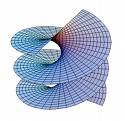
In 1776 French mathematician Jean Baptiste Marie Charles Meusnier de la Place (1754-93) pub. Meusnier's Theorem, that all curves on a surface passing through a given point and having the same tangent line at that point also have the same normal curvature at that one cool bitchin' point; he also discovers the mathematical pretty woman Helicoid, the 3rd known minimal surface.

As white Americans fight to create a new homeland for their "race" on stolen Amerindian land, a German scientist lays the theoretical basis for the original sin of white supremacy so that white will always be right theoretically no matter how the facts look? In 1776 German biologist Johann Friedrich Blumenbach (1752-1840) pub. De Generis Humani Varietate Nativa Liber (On the Natural Varieties of Humanity), which lays the foundation for the science of anthropology; taking it as given that only God can create them, he defines the four "races" of mankind as Caucasian, Mongolian, American Indian, and Ethiopian (African); in 1795 he adds Malayan; of course the punch line is that white is right and black is bad - and for the in-between colors, welcome to Progressive.com, Manwich, Manwich, we adore thee?

In Jan. 1779 French astronomer Antoine Darquier de Pellepoix (1718-802) discovers the Ring Nebula (Messier 57) in the N constellation of Lyra.

In 1779 French mathematician Etienne Bezout (Étienne Bézout) (1730-83) pub. Theorie Generale des Equations Algebriques in Paris, which contains material on the Elmination Theory, the symmetrical functions of the roots of an equation, and Bezout's Identity, that the greatest common divisor of natural numbers a and b is ax + by for some integers x and y.
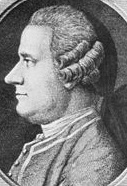
In 1779 Dutch chemist-biologist Jan Ingenhousz (1730-99) discovers that plants need carbon dioxide, and that they need light in order to produce oxygen.

In 1779 Swiss physicist Horace-Benedict de Saussure (1740-99) pub. the idea that glaciers slide downhill on a base of meltwater.

In 1779 Italian biologist Lazzaro Spallanzani (1729-99) proves that sperm and egg must come into contact for fertilization to occur, and invents Artificial Insemination - don't be lazy and spill any?

In 1779 Samuel Crompton (1753-1827) of Bolton, England invents the Spinning Mule, AKA Hall-i'-th'-Wood, an improvement on the spinning jenny and water frame suitable for making tightly-twisted muslin; too bad, he can't afford to pay to patent it, so it becomes public domain and he dies broke; meanwhile Richard Arkwright et al. attempt to invent a carding machine to produce the cotton rovings that are fed into the spinning mule, based on the failed 1748 invention of Lewis Paul, and Arkwright pioneers all-in-one cotton factories, which are powered by water until 1784 when steam is first used.

In 1780 French printer Francois Ambroise Didot (1730-1804), son of Francois Didot (1689-1757) becomes the first to print on vellum paper.
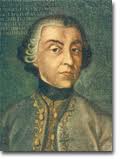
In 1780 Italian scientist Felice Fontana (1730-1805) invents the Water Gas Shift (Water Splitting) Reaction, in which H2O and CO react at high temps to form CO2 and H2.
About 1780 the Age of Heroic Medicine in Europe and the U.S. begins (ends 1850), in which the patient has to become a hero to endure bloodletting, forced vomiting, sweating, blistering, and intestinal purging via calomel.

On Mar. 13, 1781 German-born English amateur astronomer Frederick William (Friedrich Wihelm) Herschel (1738-1822) discovers a new comet, sending An Account of a Comet to the Royal Society; when it turns out to be a new planet, Uranus, he names it Georgium Sidus in honor of George III, and gets knighted in return; in 1850 "the Georgian" is renamed Uranus - Your Anus would suggest itself later quite naturally when thinking about him? On Jan. 11, 1787 Herschel discovers Uranus' moons Titania and Oberon, naming them after Shakespeare's "A Midsummer Night's Dream".


In 1781 Spanish (Basque) brother chemists Don Fausto Fermin de Elhuyar (Delhuyar) y De Lubice (1755-1833) and Juan Jose de Elhuyar (1754-96) discover the mineral element Tungsten (Swedish "heavy stone") (W) (#74) in wolframite and scheelite, and Karl Wilhelm Scheele determines its composition; because of the wolframite connection it receives the German symbol W and is also called wolfram; it has the highest melting point of any metal (3380 C, 6116 F).

In 1782 French papermaker brothers Joseph-Michel Montgolfier (1740-1810) and Jacques-Etienne (Étienne) Montgolfier (1745-99) of Annonay (near Lyons), France test their first small unmanned hot air balloon, made of paper filled with smoke.
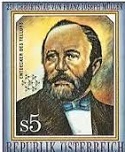
In 1782 the sulfur-like element Tellurium (#52) (Te) (Lat. "tellus" = earth) is discovered combined with gold in Transylvania by Austrian mineralogist Franz=Joseph Muller (Müller) von Reichenstein (1740-1826).

In 1782 Oliver Evans (1755-1819) constructs the Hopper-Boy, the first automated flour mill in Wilmington, Del.
In 1782 James Watt develops the double-acting rotary steam engine, coining the term "horsepower", finding that a mine pony can lift 22K ft.-lb./min., increasing it by 50% for horses (33K).
In 1782 Josiah Wedgwood (1730-95) of England invents a pyrometer for pottery furnaces.



Do you know the way to Hot Air Bay? On June 4, 1783 the Montgolfier Brothers Joseph-Michele Montgolfier (1740-1810) and Jacques-Etienne Montgolfier (1745-99) publicly demonstrate their paper-lined linen hot air balloon, which rises to a height of 3K ft. at Annonay, France in a 10-min. 1-mi. flight; on Aug. 27 Parisian physicist Jacques Alexandre Cesar (César) Charles (1746-1823) launches a 13-ft.-dia. silk balloon (constructed under his supervision by A.J. and M.N. Robert) filled with hydrogen in Paris in front of 50K spectators; it floats at 3K ft. for more than 45 min. and lands in a village 16 mi. away, where the spooked villagers attack it with stones and knives; on Sept. 19 the Montgolfier Brothers conduct another demo in Versailles, witnessed by Louis XVI and Marie Antoinette, where a duck, rooster, and sheep become the first living passengers, traveling 2 mi. in 8 min., with max. alt. of 1.5K ft, pissing the king off with the dense smoke they deliberately generate in the belief that it's what causes the buoyancy, later learning that it's heat; on Oct. 15 French daredevil physician Jean Francois Pilatre de Rozier (1754-85) makes the first tethered balloon ascension, repeating the demo on Oct. 17 before a group of scientists, then reaching 324 ft. on Oct. 19; on Nov. 21 (2 p.m.) champagne-toting de Rozier and army officer Marquis Francois Laurent le Vieux d'Arlandes (1742-1809) make the first untethered human flight, reaching a peak alt. of 500 ft. and traveling 5.5 mi. in 25 min. from the Bois de Boulogne in Paris in the presence of Louis XVI and a huge crowd, across the Seine River to the Butte-aux-Cailles; the next day Benjamin Franklin et al. sign the official certification at Passy; on Nov. 31 Jacques Charles (financed by Franklin) flies in his hydrogen balloon, while gouty Franklin watches from his carriage near the Tuileries Gardens; balloon exhibition flights soon become the rage in Paris; when asked what was the practical use of these balloon thingies, Franklin replies "What is the use of a newborn baby?"; the power of a mere individual to go over the king's head and attract large crowds is a giant leap for popular democracy, making the French In 1783 Jacques Charles makes and tests the first hydrogen-filled balloon, which is witnessed by Ben Franklin.

In 1783 Dutch-born deaf English amateur astronomer John Goodricke (1764-86) suggests that the variable star Algol (Beta Persei) (the Demon Star) is an eclipsing binary.
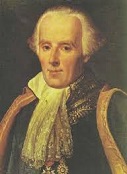
About 1783 English natural philosopher (known for his black complexion) Rev. John Michell (1724-93) proposes the Cavendish Experiment to measure the gravitational constant, and first pub. the Schwarzschild Radius for a star, where gravity causes it become a "dark star" from which light cannot escape, later called a black hole; the experiment is performed in 1797-8 by British scientist Henry Cavendish.
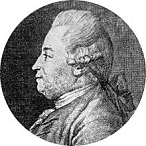
In 1783 Danish naturalist Otto Friedrich Mueller (Müller) (1730-84) becomes the first to describe Diatoms.

In 1783 taking advantage of the lengthening of human hair with humidity, Swiss geologist Horace-Benedict de Saussure (1740-99) invents the Hair Hygrometer, which is so reliable it is not replaced by an electrical version until the 1960s.

In 1783 German-born Geneva jeweler Johann Jacob Schweppe (1740-1821) uses a pump to carbonate mineral water, moving to London in 1792 to manufacture Schweppes Tonic Water.


On Sept. 15, 1784 crowd-pleasing "daredevil aeronaut" Vincenzo Lunardi (-1806) of Lucca, Tuscany makes the first balloon ascent in England in front of a crowd incl. the Prince of Wales, taking a dog, cat, and pigeon with him as he travels 24 mi.; on Nov. 23, 1785 he wows Glasgow, Scotland.

In 1784 Johann Wolfgang von Goethe (1749-1832) of Germany discovers that the human intermaxillary bone has a similar structure to that in apes, foreshadowing comparative morphology - while who was giving whom head?

In 1784 French mineralogist Abbe Rene Just Hauy (Haüy) (1743-1822) of the U. of Paris proposes the Law of Rational Indices, that the regular form of crystals is caused by a regular internal arrangement of tiny cubes or polyhedra ("molecules integrantes"); 174 years later (1958) an electron microscope confirms his model.

In 1785 French physicist Charles-Augustin de Coulomb (1736-1806) discovers Coulomb's Law of electrical forces.

In 1785 Scottish geologist James Hutton (1726-97) pub. Theory of the Earth; or An Investigation of the Laws Observable in the Composition, Dissolution, and Restoration of Land Upon the Globe, founding the modern science of geology with its presentation of the Bible-bashing principle of uniformitarianism, an Earth with "no vestige of a beginning - no prospect for an end"; too bad, it's too technical to obtain gen. acceptance until John Playfair popularizes it in 1802 - no end maybe, but it could have been created and had a beginning?

In 1786 Italian scientist Luigi Galvani (1737-98) discovers that nerves transmit electricity, and goes on in 1789 to experiment on the muscular contraction of dead frogs.

On Feb. 2, 1786 Westminster, London-born Anglo-Welsh hyperpolyglot linguist Sir William Jones (1746-94) delivers a famous speech in Calcutta to the Asiatic Society (which he founded in 1784), claiming a common source for the Sanskrit, Persian, Greek, Latin, Celtic, and German languages, with the soundbyte: "The Sanskrit language, whatever be its antiquity, is of a wonderful structure; more perfect than the Greek, more copious than the Latin, and more exquisitely refined than either, yet bearing to both of them a stronger affinity, both in the roots of verbs and the forms of grammar, than could possibly have been produced by accident; so strong indeed, that no philologer could examine them all three, without believing them to have sprung from a common source, which, perhaps, no longer exists; there is a similar reason, though not quite so forcible, for supposing that both the Gothic and the Celtic, though blended with a very different idiom, had the same origin with the Sanskrit; and the old Persian might be added to the same family."

In 1786 German scientist Karl Wilhelm Scheele (1742-86) discovers hydrocyanic acid before dying on May 21, and it's no surprise, since he tasted or sniffed all his chemical discoveries, most of which others get credit for, causing Isaac Asimov to call him "hard-luck Scheele"; he actually dies from long-term mercury poisoning?
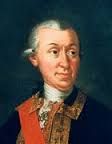
In 1786 Swiss mountaineer and French lt. gen. Franz Ludwig Pfyffer (1716-1802) constructs the first Relief Map, a 3-D model of the Lake Lucerne area after working on it for 24 years.


In 1787 Edmund Cartwright (1743-1823) of England invents the Power Loom, featuring driving shafts driven by water; too bad, pissed-off weavers burn down a cotton mill using it, and it works poorly, taking until 1813 for William Horrocks to perfect it, adapting it to steam by 1822; in 1813 there are 2.4K power looms in use, followed by 12,150 in 1820, 45.5K in 1829, 85K in 1833, and 250K in 1850; British cotton exports zoom from £355K in 1781 to £7M in 1801, and £23.4M in 1841; meanwhile, the woolen industry lags behind in automation, with many hand looms still in use in 1850.
In 1787 Charles discovers Charles' Law, describing the relationship between gas volume and temperature.
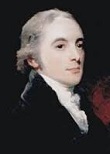
In 1789 English Anglican minister and mineralogist William Gregor (1761-1817) of Cornwall, England discovers the metallic element Titanium (Ti) (#22) (named by Martin Heinrich Klaproth for the Greek Titans) (melting point 3,272 F) in menachanite, and names it menachite.
In 1789 William Herschel builds the world's largest telescope for the next 50 years, with a 48-in. aperture; on Aug. 28 he discovers Saturn's 6th moon Enceladus (the 100-armed giant?), and on Sept. 17 its 7th moon Mimas (named after a son of Gaia), marked by the giant Herschel Crater.

In 1789 German chemist Martin Heinrich Klaproth (1743-1817) makes the first chemical analysis of Pitchblende, and discovers the element Uranium (U) (#92), which initially is used in ceramics and textiles; he also discovers the metallic element Zirconium (Zr) (#40) in the sands of the rivers of Sri Lanka (Srilankium?); uranium is later used to make fuel elements for atomic reactors, and zirconium in containers for fuel elements since it doesn't absorb neutrons.

In 1789 French chemist ("the Father of Modern Chemistry") Antoine (Antoine-Laurent de) Lavoisier (1743-94) pub. Traite Elementaire de Chimie, the first modern chemical textbook; it defines an element as a single substance that can't be broken down by chemical analysis and from which all chemical compounds are formed; discovers that fermentation produces carbon dioxide (carbonic gas) and spirit of wine, saying that it is "more appropriately called by the Arabic word alcohol since it is formed from cider or fermented sugar as well as wine", and pub. the first chemical equation "grape must = carbonic acid + alcohol", calling it "one of the most extraordinary in chemistry", adding: "In these experiments, we have to assume that there is a true balance or equation between the elements of the compounds with which we start and those obtained at the end of the reaction." In 1790 he pub. Table of 31 Chemical Elements, founding modern chemistry with the first quantitive chemical experiments, rejecting the phlogiston theory after meticulously burning things and measuring all the byproducts and proving that matter is conserved, considering heat (caloric) and light to be elements and counting the role of oxygen and hydrogen, the components of water, naming both; "Nothing is lost, nothing is created, everything is transformed." In 1790 he is appointed to a committee that develops the Metric System. Too bad, he pisses-off aspiring scientist Jean-Paul Marat, who later pays him back by circulating a denouncement that gets him a free French close shave.
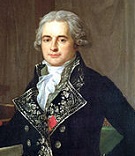
In 1790 French physician-chemist Jean-Antoine Chaptal (1756-1832) pub. Elements of Chemistry (3 vols.) (Montpellier), which coins the term "nitrogen". In 1806 he pub. La Chimie Appliquee aux Arts, which revolutionizes wine-making in France, describing the Chaptalization process of adding sugar to increase final alcohol content.

In 1790 French surgeon-chemist Nicolas Leblanc (1742-1806) develops a process for producing sodium carbonate (alkali) (used to make lye) from common table salt using sulfuric acid, carbon, and calcium carbonate, paving the way for industrial soap manufacture, but it takes until the end of the 19th cent. for manufactured soap to become popular and have a global market.
In 1790 William Nicholson of England patents the Rotary Press, but fails to build a prototype.


Welcome to the next round? A classic case of what goes around comes around? The pen is mightiless against the sword? On Mar. 20-25, 1792 the Legislative Assembly in Paris sticks its neck out and approves the use of the centuries-old "painless" Guillotine, named after physician (Freemason) Joseph-Ignace Guillotin (1738-1814), who recommends it as a humane form of execution, as well as a way of eliminating the class distinction of hanging commoners while beheading nobles, who are expected to go to their deaths without displaying emotions unless they're women; on Apr. 4 the first guillotine is installed in the Place de Greve in Paris; on Apr. 25 highwayman Jacques Nicolas Pelletier becomes the first person executed by the new "feminine" form of execution; in Aug. a giant guillotine is erected in the Place de Carrousel in the center of Paris, whose blade makes a noise like thunder when it falls, designed by German harpsichord maker Tobias Schmidt, who was working with Metz-born king's surgeon Antoine Louis (1723-92) (secy. of the surgical academy), and main executioner (since 1754) Charles Henri Sanson (1739-1806) (4th hereditary executioner in the family since 1688); Schmidt turns the blade o a 45-deg. angle and changes it from round to you know what, and it is weighted by a pulley system as it travels down two 14-ft. upright greased wooden planks, all of which are reached by a 24-step platform; in 1890 asst. executioner Leon Burger adds refinements; the machine is set up also at the Place de la Revolution, Place St. Antoine, and Barriere (Barrière) Ranverse; it is originally called "La Veuve" (window), and after Louis XVI's execution "La Louison", then after Marie Antoinett'e execution "La Louisette", and not called guillotine until after 1800; 15K heads roll by 1799, out of 40K total killed during the Terror, 70%-80% of them commoners; tricoteuses sometimes sit near the base of the scaffold knitting stockings for soldiers - well, shiver me carotids?
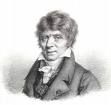

In 1792 French mathematician Baron Gaspard Clair Francois Marie Riche de Prony (1755-1839) begins calculating log and trig tables to 14-29 decimal place accuracy - why didn't he invent the computer first?


In 1793 while visiting from New Haven, Conn., Am. nailmaker Eli Whitney (1765-1825) invents the little ole Cotton Gin (which combs out them pesky seeds) at Nathaniel Greene's Mulberry Cove Plantation near Savannah, Ga., applies for a patent on June 20, and is granted one on Mar. 14, 1794, but it is so easily pirated that he never gets paid much; 800K+ black slaves are imported to the cotton-producing regions in the U.S. South between this year and 1860, and cotton becomes the South's leading crop, with Savannah the chief cotton port.

Hey now, you're an all-star, get your game on? In 1793 English-born Am. Rev. War hero Thomas "Tom" Paine (1737-1809) pub. The Age of Reason, Pt. 1, which was written just before being thrown into prison in France, pub. with the help of his friend Joel Barlow; a rabble-rousing Rationalist Deist attacks the divine origin of the Bible, becoming the Infidel's Bible, setting the 19th cent. up for secularism and belief in scientific progress as a replacement religion for Christianity, with pithy soundbytes incl.: "Belief in a cruel God makes a cruel man"; "One good schoolmaster is of more use than a hundred priests"; "I do not believe in the creed professed... by any church that I know of. My own mind is my own church"; "The story of the whale swallowing Jonah... borders greatly on the marvelous, but it would have approached nearer to the idea of a miracle if Jonah had swallowed the whale"; "It is wrong to say that God made rich and poor; he made only male and female, and gave them the whole earth for their inheritance"; he gets widely accused of being an atheist, when actually he attacks atheism in the book and supports Deism, but the bigoted religious reaction (which incl. most of his old Am. friends, incl. Washington) causes his place in the pantheon of Am. Founding Fathers to get tainted, and later the infidels strike back by attempting to paint all the U.S. Founding Fathers (incl. Bible-thumping Washington) as Deists and overdo separation of church and state? - was Paine their "rabbit", writing what they all believed but couldn't openly express, or was he just out on a limb, too extreme but holding onto the Founding Father main trunk for support?

In 1794 17-y.-o. Johann Carl Friedrich Gauss (1777-1855), a language student at Caroline College in Brunswick, Germany gets interested in math and takes up the classical problem of constructing regular n-gons, proving that it can't be done when n is a prime number except for 17, 65, 257 and 65,537, causing him to switch next year to the U. of Gottingen, submitting a doctoral thesis in 1798 proving the Fundamental Theorem of Algebra (every possible algebraic equation has a solution), going on to become the Princeps Mathematicorum, the #1 mathematician in da whole wide world - I can win that race?
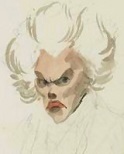
In 1794 after losing fortune last year in the French Rev., French mathematician Adrien-Marie Legendre (1752-1833) pub. Elements de Geometrie, which becomes a std. textbook for the next 100 years. In 1798 he conjectures the Prime Number Theorem, which isn't proved by Jacques Hadamard and Charles Jean de la Vallee-Poussin until 1896. In 1806 he pub. The Path of Comets, containing the first pub. of the Least-Squares Method, developed by Carl Gauss. In 1811 he discovers and names the Gamma Function. In 1830 he proves Fermat's Last Theorem for the exponent n=5. He goes on to conjecture the Quadratic Reciprocity Law (later proved by Gauss), and discover the Legendre transformation and Legendre polynomials.

In Apr. 1796 French naturalist Jean Leopold Nicolas Frederic Georges Cuvier (1769-1832) gives the lecture Mémoires sur les espèces d'éléphants vivants et fossiles at the Nat. Inst. (pub. in 1800), comparing skeletons of Indian and African elephants, and mastodons ("the Ohio animal"), which he concludes are all different species, the latter extinct; in 1806 he coins the name "mastodon"; he also describes a large skeleton found in Paraguay, which he names the Megatherium, claiming it is an extinct variety of the tree-dwelling sloth, ending the debate about whether extinction has actually happened, and founding Comparative Anatomy and Paleontology. In 1798 he pub. Tableau élémentaire de l'histoire naturelle des animaux, becoming the first attempt at systematic classification of the animal kingdom, founding modern Zoology (Comparative Anatomy), stressing how the parts of an organism are correlated to the functioning whole. In 1812 he pub. Recherches sur les Ossements Fossiles de Quadrupedes (Researches on Quadruped Fossil Bones), issuing his "rash dictum" that it is unlikely that any large animal remained undiscovered. In 1813 he pub. Essay on the Theory of the Earth, which advances the theory of catastrophism in geology, claiming that new species were created after periodic catastrophic floods after establishing the fact of past extinction. In 1817 he pub. Le Règne Animal (The Animal Kingdom) (4 vols.), his magnum opus, a summation of his life's work on comparative anatomy, containing apparent support for evolutionary change for the extinct mammoths et al., making a fan of Charles Darwin, although Cuvier rejects the idea of evolution.

On May 14, 1796 English physician Edward Jenner (1749-1823) introduces smallpox vaccination to a needy world, inoculating 8-y.-o. James Phipps (1788-1853) with material from a cowpox pustule from the hands of milkmaid Sarah Nelmes, who caught cowpox from the cow Blossom, whose hide is preserved at the St. George Medical School; Jenner goes on to save more people than Jesus?
In 1796 Lithography, a technique of printing based on the fact that oil and water do not mix is invented by German playwright Alois (Aloys) Senefelder (1771-1834) in Prague; the age of colored printing and colorful magazines is around the corner.

In 1797 German astronomer Heinrich Wilhelm Matthias Olbers (1758-1840) pub. his method for calculating comet orbits.

In 1797 French chemist Louis Nicolas Vauquelin (1763-1829) discovers the metallic element chromium (Cr) (#24), named after the colorful flames made by its compounds.
In 1797 the duck-billed platypus is discovered near Sydney, Australia.
In 1797 Nathaniel Briggs of N.H. patents the first "clothes washing" machine - named George?
In 1797 Janet Keiller of Dundee, Scotland invents orange marmalade after a Spanish ship carrying Seville oranges takes refuge in the harbor and they get a little unfresh and have to be unloaded quick, causing Dundee to become known as the city of jute, jam, and journalism.
In 1797 Charles Newbold of Burlington, N.J. patents the cast-iron plow.
In 1797 Etienne-Gaspard Robert of France invents the Phantasmagoria (Gr. "fantasma" + "agora" = ghost + public meeting place), a machine for projecting moving images; too bad, after he begins showing victims of the Reign of Terror, the police shut him down.

In 1798 Westcott, Surrey, England-born cleric Thomas Robert Malthus (1766-1834) pub. An Essay on the Principle of Population (June); pub. under the alias Joseph Johnson; 2nd ed. 1803; 6th ed. 1826; a response to William Godwin's view of the "perfectibility of society" in "Political Justice" (1793), dissing the English Poor Laws and supporting the Corn Laws (taxes on grain imports), claiming that the pop. can double in 25 years, causing the food supply to run out in two generations, and proposes Malthus' Iron Law of Pop. (Wages), that "Food is necessary to the existence of man", "The passion between the sexes is necessary and will remain nearly in its present stage", thus the "power of population is infinitely greater than the power in the Earth to produce subsistence for man"; "The mighty law of self-preservation expels all the softer and more exalted emotions of the soul... In so short a period as withing fifty years, violence, oppression, falsehood, misery, every hateful vice, and every form of distress, which degrade and sadden the present state of society, seem to have been generated by the most imperious circumstances, by laws inherent in the nature of man, and absolutely independent of its human regulations"; as a corollary, a rising pop. causes a rising labor supply, leading to lower wages, causing passage of the British Census Act of 1800; despite its uncorked exponential scientific assumptions, it gets used to justify war as a way to keep the non-white (or less-white) pop. down for the common good of whites (or more-whites) everywhere.

In 1798 Am.-born British physicist Sir Benjamin Thompson, Count Rumford (1753-1814) pub. An Enquiry Concerning the Source of Heat which is Excited by Friction, which shows that in the boring of brass cannon there is a direct connection between the heat generated and the mechanical work done, proving that heat is not a material substance; too bad, he calculates a value for the mechanical equivalent of heat that is too high.

In 1799 English scientist Sir Humphry Davy (1778-1829) proves that two pieces of ice rubbed together will melt without the addition of any heat, disproving the Caloric Theory of Heat; on Dec. 26 he becomes the first to describe the mental effects of Laughing Gas (nitrous oxide); "I existed in a world of new-connected and newly modified ideas." In 1808 he uses electrolysis to isolate chemical elements Barium (#56) (Ba) (as an amalgam only - the pure metal is not isolated until 1901) and Strontium (#38) (Sr). In 1811 he discovers colorless poisonous heavy gas Phosgene (carbonyl chloride).


In 1799 Italian physicist-chemist Alessandro Giuseppe Antonio Anastasio Volta (1745-1827) makes the shocking discovery of the Voltaic Pile, reporting it to the British Royal Society next year; the first one is made of zinc and copper metal plates and wet cardboard soaked in salt solution, and he later substitutes silver for copper and cloth for cardboard to build bigger piles from which he can draw sparks and shocks, amazing the world and causing a sensation; in May W. Nicholson and A. Carlile use a voltaic pile to decompose water, observing oxygen appearing at one pile and hydrogen at the other, adding to the sensationalism with the idea that atoms are held together by electricity - and hence immortality is just around the corner? In 1818 London-born Mary Wollstonecraft Shelley (1797-1851) pub. the Gothic romance novel Frankenstein, about a mad scientist who makes a corpse live again via electricity; she got the idea while in a trance based on the writings of alchemists about creating a homunculus in a test tube, "a pale student of the unhallowed arts [grave-robbing] kneeling beside the thing he had put together"; "I beheld the wrath of the miserable monster whom I had created"; "I curse (although I curse myself) the hands that formed you" - could it have really been based on her hubby Percy's anatomy?
About 1800 French surgeon Bernard Peyrilhe (1737-1804) becomes the first to experimentally transmit cancer to an animal by injecting breast cancer cells, claiming that breast cancer is spread via the lymphatics, and advocating total mastetctomy incl. the auxiliary lymph nodes the pectoralis major muscle.
In 1800 World Economic Growth jumps from 0% to 2% per annum for the first time in known history, making the modern world possible?


In 1800 German physician Franz Joseph (Josef) Gall (1758-1828) develops cranioscopy, the measurement of the skull, which is later renamed Phrenology by his student Johann Spurzheim (1776-1832), who also demonstrates the fibrous structure of the brain; too bad, phrenologists go too far and claim to know all about a person from the bumps on their noggin.

In 1800 German-born English astronomer Sir Frederick William Herschel (1738-1822) discovers Infrared Light (beyond the red end of the spectrum) using prisms and thermometers on solar rays; he also discovers a connection between 11-year sunspot cycles and wheat prices, becoming the first theory of economic cycles.

In 1800 German (Prussian) polymath geographer-explorer Baron Friedrich Wilhelm Heinrich Alexander von Humboldt (1769-1859) after launching an exploration of South Am. in 1799 (ends 1804) proposes that South Am. had once been joined with Africa, becoming the first person to describe anthropogenic climate change - just look how Brazil fits into the Gulf of Guinea? In 1802 he discovers and explores the cold sluggish low-salinity Humboldt (Peru) Current running along the Pacific coast of South Am. toward the equator, extending 300-600 mi. off the coast (500M cu. ft. per sec). In 1845-52 he pub. Kosmos (Cosmos) (5 vols.), a bestseller retracing the history of science and showing its Greek origins, claiming that contemplation of the beauty of the Cosmos holistically viewed as a single entity gives one a superior outlook on life; too bad, he taints it with Romanticism?; "It was the discovery of America that planted the seed of the Cosmos."
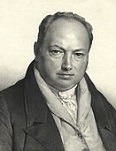
About 1800 Henry Maudslay (1771-1831) of England, apprentice of Joseph Braham invents the slide rest for the metal lathe to manufacture std. screw thread sizes, allowing interchangeable parts and mass production, becoming known as "the Father of Machine Tool Technology".

On Feb. 22, 1800 the first light-pressure steam engine railway locomotive, built by Cornwall-born Richard Trevithick (1771-1833) is test-driven in Wales; in 1801 he builds the first high-pressure road locomotive.

In 1800 English Liberal statesman-scientist Charles Stanhope, 3rd Earl Stanhope (1753-1816) develops the first all-iron printing press.

In 1800 Am. inventor Robert Fulton (1765-1815) builds the steam-powered metal-clad submarine Nautilus, and tests a 20-ft. model of it on the Seine at Brest, making two 20-min. dives himself, becoming the first practical submarine; in 1803 after trying to sell his metal-clad steam-power submarine to Napoleon, he invents the Side-Paddle Steamboat. In 1814 his 38-ton USS Fulton becomes the first steam-powered warship.
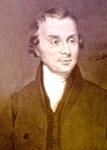
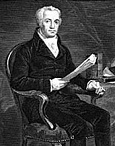
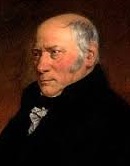
In the first decade of the 19th cent. Science makes great leaps in the concepts of Thematic Cartography, Statistical Graphing, and Data Visualization; coordinate paper is first used in pub. research (graph of barometric variations) by English industrial chemist Luke Howard (1772-1864), who makes comprehensive recordings of London weather in 1801-41. In 1801 the first Pie Chart and Circle Graph are pub. in London in "Statistical Breviary" by Scottish engineer-economist William Playfair (1759-1823), who in 1786 pub. "The Commercial and Political Atlas" in London, containing the first Bar Chart. In 1801 William "Strata" Smith (1769-1839) of England pub. "the map that changed the world", the first Geological Map (of England), founding the science of Stratigraphic Geology (Stratigraphy); too bad, the establishment ignores him, his work is plagiarized, and he ends up in debtors' prison.

In 1801 French physician Xavier Marie-Francois Bichat (1771-1802) pub. Anatomie General, which introduces the term "tissues" (textures of the body with unique vital properties), and describes 21 types, founding the science of Histology.

In 1801 German astronomer Johann Elert Bode (1747-1826) pub. Uranographia, a catalog of 17,240 stars, beating the previous charts by 12K stars, with elaborate artistic representations of the constellations, which go out of fashion with astronomers after this.


On Jan. 1, 1801 Italian Theatine monk-astronomer Giuseppe Piazzi (1746-1826) discovers the first asteroid, Ceres, and German rising star mathematician Carl (Karl) Friedrich Gauss (1777-1855) computes its orbit using his new Gauss Least-Squares Method, which allows it to be found even after it goes invisible and emerges among a multitude of stars, causing him to be appointed dir. of the Gottingen Observatory for life in 1807, going on to become the greatest mathematician since antiquity - while juggling sausages? In 1801 Gauss pub. Disquisitiones Arithmeticae, which founds the mathematical field of Number Theory, incl. the theory of congruences, quadratic forms, and quadratic residues.


In 1801 German chemist Johann Wilhelm Ritter (1776-1810) and English chemist-physicist William Hyde Wollaston (1766-1828) independently discover Ultraviolet Light - now the nightclubs will rock?
In 1802 blind epileptic Kendal, Westmorland, England-born Quaker naturalist John Gough (pr. like gof) (Gow) (1757-1825), who touches plants to his lip and tongue to identify them pub. "An investigation of the method whereby men judge by the ear of the position of sonorous bodies relative to their own persons", describing echolocation; in 1804 he first pub. the elastocaloric effect after quickly stretching a piece of natural rubber (Caoutchouc) and feeling its sudden warmth on his lip, making a fan of James Joule, who undertakes more experiments, discovering that stretched rubber contracts when heated, causing the Gough-Joule Effect to be named; he goes on to discover hydrosere sucession whereby freshwater lakes dry out and become land, and to describe seed banks in soils.

In 1802 English chemist Luke Howard (1772-1864) pub. Essay on the Modification of Clouds, containing the first scientific definition of cloud types, incl. cumulus (puffy popcorn), stratus (formless), and cirrus (ice crystal), plus modifications incl. cirrostratus, stratocumulus, and cumulonimbus, becoming the father of the science of Meteorology.


In 1802 French naturalist Jean-Baptiste Pierre Antoine de Monet, Chevalier de Lamarck (1744-1829) pub. Hydrogeologie, coining the term "biology", and claiming that continents march steadily westward; he also pub. Recherches sur l'Organisation des Corps Vivans, proposing the theory of evolution, but without describing a mechanism. In 1802 German naturalist Gottfried Reinhold Treviranus (1776-1837) pub. Biologie: Oder die Philosophie der Lebenden Natur, independently coining the term "biology", and proposing the transmutation of species - God holds it remarkably up his anus?


In 1802 Jean d'Aubuisson de Voisins (1762-1841) and Christian Leopold von Buch (1774-1853), students of German geologist Abraham Gottlob Werner (1749-1817) reject their teacher's Neptunism (oceanic origin of rocks) in favor of the volcanic origin of basalt - you can't always give your kids what they love, but with Werner you can?

In 1802 the silver-white hydrogen-absorbing metallic element Palladium (Pd) (#46) (which is later alloyed with gold to make white gold) is discovered by English chemist-physicist William Hyde Wollaston (1766-1828), followed in 1804 by the the metallic element Rhodium (Rh) (#45), useful in strengthening platinum.

In 1802 English physicist Thomas Young (1773-1829) proposes the Wave Theory of Light in his Royal Society paper On the Theory of Light and Colours. In 1805 he first describes Surface Tension as a hypothetical membrane of infinitesimal thickness stretched over the surface. In 1807 he coins the term "energy", from Gr. "work within".



In 1802 English chemist Thomas Wedgwood (1771-1805), son of Josiah Wedgwood makes the first photograph using paper coated with silver nitrate, causing his acquaintance Humphry Davy to pub. a paper on it, after which the search for a fixing agent begins - send us your pictures? In 1835 English physicist William Henry Fox Talbot (1800-77) takes the earliest known negative photograph using paper coated with silver chloride in a camera obscura, Lacock Abbey, Wiltshire, and later claims to have invented photography ahead of Daguerre; he later waxes the negative, places it over another coated paper, and exposes it to sunlight to produce a positive image, becoming the first to produce multiple copies from one negative, and the first to make paper photographs ("negative positives"), which develops into modern photography, while Daguerrotypes prove to be a dead end? In 1837 French painter Louis Jacques Mande (Mandé) Daguerre (1789-1851) invents the "miraculous" reduced exposure time Daguerreotype process of photography using a silver iodide coating on copper plates, developed with mercury fumes and washed with a salt solution to prevent darkening; he doesn't present it to the public until 1839. On Jan. 7, 1839 after partnering with Nicephore Niepce in 1829, Daguerre gives his first public demonstration of his new photographic process, and it becomes an instant hit, launching "daguerréotypomanie"; "An hour later, all the opticians' shops were seiged, but could not rake together enough instruments to satisfy the onrushing army of would-be daguerreotypists; a few days later you could see in all the squares of Paris three-legged dark-boxes planted in front of churches and palaces." (Helmut Gernsheim); on Feb. 23 the earliest report of the Daguerrotype in the U.S. appears in the Boston Daily Advertiser, which calls it a "remarkable invention"; in Sept. Robert Cornelius of Philadelphia learns the process and begins making improvements; at least two dozen men from Norway to Brazil step forward to claim precedence over Daguerre?
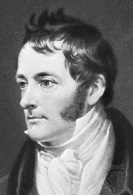
On Jan. 1, 1803 English chemist William Henry (1774-1835) pub. the paper Experiments on the Quantity of Gases Absorbed by Water, at Different Temperatures, and under Different Pressures, proposing Henry's Law, which states that the amount of dissolved gas is proportional to its partial pressure in the gas phase, with the soundbyte: "Water takes up, of gas condensed by one, two, or more additional atmospheres, a quantity which, ordinarily compressed, would be equal to twice, thrice, &c., the volume absorbed under the common pressure of the atmosphere."

In 1803 Swedish chemist Baron Jons Jacob (Jöns Jakob) Berzelius (1779-1848) discovers the metallic element Cerium (Ce) (#58), the most abundant of the rare-earth group, named after the asteroid Ceres; the cerium metal group incl. #57 to #63 (lanthanum, cerium, praseodymium, neodymium, promethium, samarium, europium). In 1814 after proposing in 1812 that all chemical combinations are caused by electrostatic attractions, he pub. Theory of Chemical Proportions and the Chemical Action of Electricity, a dualistic electrochemical theory to account for electrolysis and chemical combination; it suggests using letters as abbreviations for the elements in chemical formulas, e.g., H2O. In 1835 he coins the term "catalysis", with the soundbyte "Catalysts are substances which by their mere presence evoke chemical reactions that would not otherwise take place."

In 1803 French engineer Lazare Carnot (1753-1823) pub. Principes Fondamentaux de l'Equilibre et du Mouvement, which first points out the energy of position in a gravitational field (potential energy) as separate from energy of motion (kinetic energy).

The biggest scientific advance since ancient Greek times, and it takes a colorblind weather watcher? In 1803 colorblind English scientist John Dalton (1766-1844) proposes the modern Quantitative Atomic Theory of Matter, that it is composed of atoms of different weights that combine according to regular laws - it's like magic, good night Snow White?

In 1802 the silver-white hydrogen-absorbing metallic element Palladium (Pd) (#46) (which is later alloyed with gold to make white gold) is discovered by English chemist-physicist William Hyde Wollaston (1766-1828), followed in 1804 by the the metallic element Rhodium (Rh) (#45), useful in strengthening platinum.

In 1803 English chemist Smithson Tennant (1761-1815) discovers the rare (#61) metallic elements Osmium (Os) (#76) and Oridium (Ir) (#77) in platinum ores; the specific gravity of Ir (22.4) is exceeded only by Os (24), which is the most dense known substance; they are later used in the alloy osmiridium to strengthen platinum.

In 1803 the Shrapnel Shell, invented by British royal artillery lt. (later lt.-gen.) Henry Shrapnel (1761-1842) of England is adopted by the British army - when the fog rolls I keep seeing terrible things happening?


In 1804 English coachmaker Obadiah Elliott of Lambeth patents an Elliptical Spring Suspension for 4-wheeled carriages, doing away with the heavy pole and are-ya-having-any-fun sore butts, and initiating modern carriage design, incl. the Phaeton (an open 4-wheeled carriage that is the first status symbol, coming in Highflyer and low styles); the closed Brougham, named after lord chancellor Lord Brougham, projecting a moralistic mood; the Cabriolet (a 2-wheeled 2-seat sports car preferred by bachelors); the low, elegant roomy open Victoria (popular with Victorian ladies); the "sociable" Landau, which seats four passengers facing each other; the Barouche, a landau with a folding hood for the wealthy; the 1-horse Gig, a favorite with country doctors, carrying 1-2 passengers directly over its two wheels (the VW of the Victorian era); the closed Post Chaise (flying chariot) (used as limos, painted yellow with an elderly postboy dressed in a yellow jacket and beaver hat); the Omnibus; the Dog Cart, with a fold-up footboard doubling as a seat, allowing four passengers to sit back to back; the Wagonette, with bench seats (called char-a-banc in France); the 2-wheeled 1-horse very handsome Hansom Cab ("the gondola of London"), where the driver rides behind the passenger compartment standing up, used as taxis, patented in 1834 by English (York) architect Joseph Aloysius Hansom (1803-82).

In 1805 County Meath, Ireland-born hydrographer and British rear adm. Sir Francis Beaufort (1774-1857) devises the Blowfart, er, Beaufort Wind Scale (0-12) for gauging wind force at sea: 0:0-1 mph (calm), 1:2-3 (light air), 2:4-7 (slight breeze), 3:8-12 (gentle breeze), 4:13-18 (moderate breeze), 5:19-24 (fresh breeze), 6:25-31 (strong breeze), 7:32-38 (moderate gale), 8:39-46 (fresh gale), 9:47-54 (strong gale), 10:55-63 (whole gale), 11:64-72 (storm), 12:73-82 (hurricane).
In 1805 Jean Chancel of Paris, France invents the first Match, tipped with sugar, sulfur, rubber, and potassium chlorate, which ignites after being dipped in a bottle of concentrated sulfuric acid.

In 1805 Oliver Evans (1755-1819) invents the steam-powered dredge called the Oruktor Amphibolos (Amphibious Digger), becoming the first amphibious vehicle; he also designs a vapor-driven refrigeration machine, which he never builds.

In 1806 German scientist Freiherr Christian Johann Dietrich Theodor von Grotthuss (1785-1822) pub. the Grotthuss Mechanism, the first theory of electrolysis, to the effect that an "excess" proton can diffuse through the hydrogen bond network of water molecules, with the oxygen atoms passing them in a "bucket line".

In 1806 German pharmacist Friedrich Wilhelm Adam Serturner (Sertürner) (1783-1841) isolates the bitter white crystalline alkaloid Morphine (the first known alkaloid, and first plant drug to be isolated), the active ingredient in Opium from the poppy, and tries it on himself, later writing, "Lying down, I got into a dreamy state"; it is initially marketed as a cure for opium addiction?
In 1806 French chemists Nicolas Louis Vaquelin and Pierre-Jean Robiquet (1780-1840) determine the chemical structure of asparagine (derived from asparagus), becoming the first amino acid to be analyzed.

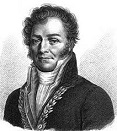
In 1808 French Sorbonne prof. of physics (1808-32) Joseph Louis Gay-Lussac (1778-1850) and Baron Louis-Jacques Thenard (Thénard) (1777-1857) isolate hard nonmetallic element Boron (#5) (B); Gay-Lussac measures the relative volume of gases involved in chemical reactions, and next year formulates Gay-Lussac's Law of Combining Volumes, that the ratios of the volumes of reacting gases are small whole numbers; it is independently discovered by Jacques Charles - also true for gay-lez ass gasses?

In 1808 German physician Johann Christian Reil (1759-1813) coins the term "psychiatry" (Gr. "psyche" + "iatros" = mind/soul + healer).


In 1809 Irish-born Robert Adrain (1775-1843) of Princeton U. and Carl (Karl) Friedrich Gauss (1777-1855) of Germany independently pub. the Method of Least Squares.
In 1809 Am. surgeon Ephraim McDowell (1771-1830) performs an ovariotomy, becoming the first successful surgery of the abdominal cavity.
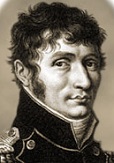
In 1809 French scientist Etienne-Louis Malus (1775-1812) pub. his discovery of the polarization of light by reflection; in 1810 he pub. his theory of double refraction of light in crystals.
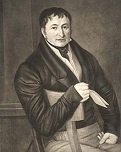
In 1810 German inventor (in London) Friedrich Gottlob Koenig (1774-1833) patents a high-speed steam-powered printing press that prints on both sides of the paper; on Nov. 29, 184 the London Times begins to be printed on Koenig's steam-operated press, increasing the speed of printing by 5x.
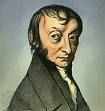
In 1811 Turin-born Italian scientist Count Lorenzo Romano Amedeo Carlo Avogadro (1776-1856) proposes Avogadro's Principle (Law), that equal volumes of gases contain equal numbers of molecules (not atoms) at a given temperature and pressure; his ideas are neglected until 1858?


In 1811 French chemist-physicist Pierre Louis Dulong (1785-1838) discovers the double decomposition of salts. In 1812 he discovers sensitive unstable nitrogen trichloride, losing two fingers and an eye. In 1817 he discovers the oxides of phosphorus. In 1819 Dulong and French physicist Alexis Therese (Thérèse) Petit (1791-1820) of France pub. the Law of Dulong-Petit, that the heat capacity of a mole of a solid element is about 3R, where R is the universal gas constant, i.e., that relative atomic weight is inversely proportional to specific heat, i.e., that approximately the same amount of heat is required to accomplish a particular rise in temperature of the same number of atoms of any metal, making possible the experimental determination of atomic weight - du long and winding road to specific petit?

In 1812 Am. naturalist John James Audubon (1785-1851) makes his famous breakthrough Drawing of a Whippoorwill in Flight.

In 1814 Bavarian optician Joseph von Fraunhofer (1787-1826), after deciding that he can make better optical glasses if he can define the colors in light more accurately improves on Isaac Newton's old prism-slit-lens apparatus by adding a theodolite telescope behind the prism, not only confirming William Wollaston's 1802 observation of a dark line spectrum in sunlight, but discovering 700 different weak and strong vertical dark Fraunhofer Lines in the spectrum, launching the science of Spectroscopy; use of the lines provides the first precise measure of dispersion in optical glasses.

In 1814 the first practical steam locomotive is built by George Stephenson (1781-1848) at Killingworth Colliery near Newcastle, England. On Sept. 27, 1825 his Stockton and Darlington Railroad, the world's first steam-powered railroad carrying public cargo begins operation in England; it begins carrying fare-carrying passengers in 1833.

In 1815 French physicist Augustin Jean Fresnel (1788-1827) pub. researches on the diffraction of light (Fresnel Lines), interference, polarization, and double refaction, ultimately establishing the Transverse Wave Theory of Light (1815-21). In 1822 he invents the lighthouse reflecting lens.

In 1815 English physician-chemist William Prout (1785-1850) anon. pub. the paper "On the Relation Between the Specific Gravities of Bodies in their Gaseous States and the Weights of their Atoms", proposing Prout's Hypothesis, a relation between specific gravity and atomic weight, suggesting that atoms of all elements are aggregates of hydrogen atoms. In 1823 he discovers that stomach juices contain hydrochloric acid, and separates it by distillation; in 1827 he proposes dividing the chemical components of food into sugars and starches (carbohydrates), lipids (fats), and albuminoids (proteins).


In 1815 English chemist Humphry Davy (1778-1829) and English engineer George Stephenson (1781-1848) develop the oil-burning Miner's Safety Arc Lamp, using a gauze cylinder.

In 1815 British road surveyor John Loudon McAdam (1756-1836) invents a method for improving roads by elevating the roadbed and using small stones to keep it dry - why didn't I think of that?

In 1816 German philologist Franz Bopp (1791-1867) pub. About the System of Conjugations of the Sanskrit Language in Comparison with Greek, Latin, Persian and Germanic, which links Sanksrit with Greek, Latin, Old Persian, and Teutonic languages via verb inflections, founding the science of Comparative Philology; the expansive myth of the white-is-right Aryans is born.

In 1816 Sir Marc Isambard Brunel (1769-1849) patents the Tricoteur, a circular stocking knitting frame, which improves Jedediah Strutt's 1758 ribbing apparatus.
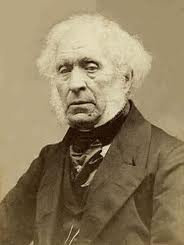
In 1816 Scottish physicist Sir David Brewster (1781-1868) invents the Kaleidoscope.
In 1816 Parisian pharmacist Jean Francois Derosne invents the Phosphorus Match.

In 1816 French physician Rene Theophile Hyacinthe Laennec (1781-1826) (with help from wife Hyacinthe Laennec) invents the Stethoscope to protect the modesty of his female patients - he likes to wear it around his laennec? Imagine the way they did it before?

In 1816 Scottish minister Robert Stirling (1790-1878) patents the Stirling Steam Engine, using a "gas spring" system to control the phase relationship between the movements of the displacer and piston.
In 1816 Auguste Taveau of Paris develops the first dental amalgam from silver coins mixed with mercury.


In 1817 after establishing the first theory of electrolysis n 1806, Leipzig, Germany-born chemist Baron Christian Johann Dietrich Theodor von Grotthuss (1785-1822) pub. the Principle of Photochemical Activation, that only the light absorbed by a substance is used in producing a photochemical change (such as a photograph); after nobody listens, English-born Am. scientist John William Draper (1811-82) pub. it in 1842, causing it to be called the Grotthuss-Draper Law.
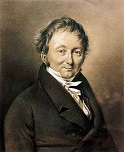
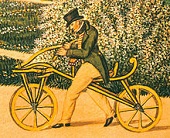
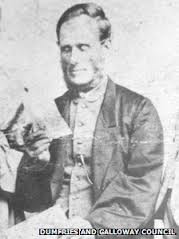

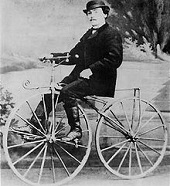
On June 12, 1817 Karlsruhe-born German forest official Karl Freiherr von Drais (Karl Friedrich Christian Ludwig Freiheirr Drais von Sauerbronn) (1785-1851) demonstrates the ballbreaker Draisienne (AKA Laufmaschine, Draisine, Dandy Horse) in Mannheim, a 2-wheeled bicycle sans pedals that you walk on, becoming the first 2-wheeler vehicle, archetype of the bicycle; too bad, after it catches on and riders begin using the sidewalks and harassing pedestrians, it is banned in Germany, England, U.S., and Calcutta. In 1839 the Velocipede, a Draisienne with pedals on the rear wheels (first true bicycle) is invented by Scottish blacksmith Kirkpatrick Macmillan (1810-78). On Nov. 20, 1866 French mechanic Pierre Lallement (1843-91) is awarded the first U.S. patent on a pedal bicycle.



In 1818 English scholar William Buckland obtains a large lower jaw fossil containing sharp teeth, and in 1824 gives it the name Megalosaurus (great lizard), becoming the first dinosaur to be scientifically named. In 1825 English physician-paleontologist Gideon Algernon Mantell (1790-1852) pub. a paper describing Iguanadon (Iguana tooth) from fossils of teeth discovered in 1822 by his wife Mary Ann Mantell in Sussex, England, becoming the 2nd dinosaur to be named; English zoologist Sir Richard Owen (1804-92) claims he's full of it, and that they are mammalian teeth, but in 1841 after more finds he accepts it and coins the term "dinosaur" (Gr. "fearfully great or terrible lizard").
In 1819 London physician John Bostock becomes the first to describe hay fever, which he personally suffers from, attributing its cause to freshly cut hay; he claims he can find only a few other sufferers in England.

In 1819 German chemist Eilhard Mitscherlich (1794-1863) pub. his law of isomorphism, that compounds crystallizing together probably have similar structures and compositions.

In 1819 Danish physicist Hans Christian Oersted (1777-1851) discovers electromagnetism, the relation between electricity and magnetism - no fairy tale?
In 1819 after discovering the pupil dilating qualities of belladonna to his friend Johann Wolfgang von Goethe (1749-1832), German chemist Friedrich Ferdinand Runge (1795-1867) takes his advice and analyzes coffee, discovering caffeine - I'm glad he didn't call it rungine? The optical phenomenon known as Parry's Arc is discovered by the English expedition led by Sir William Edward Perry (1819-21). Joseph Pelletier and Joseph Bienaime Caventou isolate brucine from Nux vomica.
On Dec. 4, 1819 Sir William Congreve of Britain patents the colored watermark, consisting of a triple paper; too bad, the Bank of Resistance fails to adoopt it because of resistance from the Portals Co. that manufactured its currency paper since 1725.
In 1819 the first soda fountain patent is granted to Samuel Fahnestock.
In 1819 Augustin Jean Fresnel invents the dioptric system for lighthouses.
In 1819 David Napier invents the flat-bed cylinder printing press.

In 1819 Anglo-German inventor Augustus Siebe (1788-1872) invents an open diving suit consisting of a leather jacket and metal helmet fitted with forced air hoses that keep the water below the diver's chin.


In 1820 Dutch physicist Hans Christian Oersted (1777-1851) discovers that an electric current in a wire deflects a compass needle, the direction depending on the direction of current flow, thus discovering electromagnetism; French physicist Andre-Marie Ampere (André-Marie Ampère) (1775-1836) repeats his experiments and discovers that two current-carrying wires exert a reciprocal action upon each other, and pub. Ampere's Law. In 1824 Ampere invents the Galvanometer.

The original A Star is Born? In 1821 English physicist Michael Faraday (1791-1867) turns the "magnetic needle being deflected by an electric current" experiment on its head and discovers the electric motor principle (electromagnetic rotation) ("electrified wire being moved by a magnet"), which unlocks the entire field of electromagnetism in physics, launching the Great (New) Rev. in Physics; his celeb boss Sir Humphry Davy gets jealous and tries to keep him from being elected to the Royal Academy, claiming that he stole the work of William Austin, but when Austin vindicates Faraday, the science is so undeniable he gets in anyway in 1824, and Davy kicks off within five years from self-abuse with laughing gas? In 1831 Faraday discovers Electromagnetic Induction. In 1832 he pub. a pictorial representation of electric and magnetic lines of force, introducing the Field Concept into physics, showing radial instead of straight field lines, rocking the scientific world.

In 1821 French mathematician Baron Augustin-Louis Cauchy (1789-1857) pub. Cours d'Analyse, the first halfway decent correct mathematical definition of limit for Calculus purists, along with the first systematic study of convergence of series, the first theory of functions of a complex variable, and the definition of derivative and integral in terms of limits. In 1823 he rigorously proves the Fundamental Theorem of Calculus. He goes on to found complex analysis and the theory of permutation groups in abstract algebra, and pub. 800 articles and five textbooks.

In 1821 Estonian-born German physicist Thomas Johann Seebeck (1770-1831) discovers the Peltier-Seebeck Thermoelectric Effect, where a junction of dissimilar metals produces an electric current when exposed to a temperature gradient, with the voltage produced proportional to the junction temperature difference, and the proportionality constant becoming known as the Seebeck Coefficient. In 1822 he invents the Thermocouple.

In 1822 French mathematician Baron Jean-Baptiste Joseph Fourier (1768-1830) pub. On the Propagation of Heat in Solid Bodies (Theorie Analytique de la Chaleur), his mathematical theory of heat conduction, introducing his hot new Fourier Series, expansions of piecewise continuous functions as trigonometrical series. In Oct. 1824 Fourier pub. the paper Remarques generales sur les Temperatures du globe terrestre et des espaces planetaires (General Remarks on the Temperature of the Terrestrial Globe and the Planetary Space) in Annales de Chimie et de Physique, in which he calculates that the Earth would be far colder if it had no atmosphere, allegedly discovering the Greenhouse Effect (talking about a glass box) and launching climate change science; "In short, if all the strata of air of which the atmosphere is formed, preserved their density with their transparency, and lost only the mobility which is peculiar to them, this mass of air, thus become solid, on being exposed to the rays of the sun, would produce an effect the same in kind with that we have just described. The heat, coming in the state of light to the solid earth, would lose all at once, and almost entirely, its power of passing through transparent solids: it would accumulate in the lower strata of the atmosphere, which would thus acquire very high temperatures. We should observe at the same time a diminution of the degree of acquired heat, as we go from the surface of the earth. The mobility of the air, which is rapidly displaced in every direction, and which rises when heated, and the radiation of non-luminous heat into the air, diminish the intensity of the effects which would take place in a transparent and solid atmosphere, but do not entirely change their character. The decrease of heat in the higher regions of the air does not cease, and the temperature can be augmented by the interposition of the atmosphere, because heat in the state of light finds less resistance in penetrating the air, than in repassing into the air when converted into non-luminous heat."


In 1822 French vivisecting physiologist Francois Magendie (1783-1855) discovers that different spinal roots cause different sensory and motor functions, and gets into a contest with Sir Charles Bell (1774-1842) of Scotland over priority; meanwhile his ghastly vivisection demos cause so much upchucking that anti-vivisectionists finally begin making progress changing the laws.



On Nov. 19, 1822 the Chilean Earthquake of 1822 is experienced by Scottish writer (recent widow) Maria, Lady Callcott (1785-1842), whose description of large land areas rising from the sea is later used by Charles Lyell to support his theory that mountains are formed by volcanoes and earthquakes, and backed up by Charles Darwin when George Greenough tries to ridicule her on sexist lines. In 1830-3 Scottish geologist Sir Charles Lyell (1797-1875) pub. The Principles of Geology, which expounds and expands James Hutton's uniformitarian theory, trashes the Bible-based catastrophist position, and flips the ultimate bird at Jehovah by dividing the geological system into Eocene, Miocene, and Pliocene - plumbing is a mercurial mistress? In July 1837 30-y.-o. Swiss naturalist Louis Jean Rodolphe Agassiz (1807-73) shocks the Swiss Society of Natural Sciences in Neuchatel, abandoning his prepared lecture on Brazilian fossil fish and announcing his new theory that a vast "ocean of ice" had once covered all of Europe and N Asia as far as the Caspian Sea, based on an expedition the previous summer with older friend Jean de Charpentier, where they had found evidence that glaciers move, carrying rocks with them, incl. one incident where Agassiz is lowered into an Alpine glacier too far and almost freezes in meltwater; too bad, the other scientists scoff at any implication that the Biblical Flood doesn't explain all.



The modern Tower of Babel? In 1823 English mathematician Charles Babbage (1791-1871) invents the first working digital calculating machine, the Difference Engine to calculate tables of functions by finite difference methods. In 1833 he invents the Analytical Engine, the first large scale digital calculating machine (computer); he never gathers enough funds to build it; in 1991 it is built according to his specs, and works. In 1842-3 Augusta Ada King, Countess of Lovelace (1815-52), daughter of Lord Byron (1788-1824) tr. a memoir by Italian mathematician Federico Luigi, Count of Menabrea (1809-96) on the Analytical Engine of Charles Babbage, publishing the first known computer program, which calculates Bernoulli numbers; really written by Babbage?


In 1823 21-y.-o. Hungarian mathematician Janos (Johann) Bolyai (1802-60) and 30-y.-o. Russian mathematician Nikolai Ivanovich Lobachevsky (1792-1856) independently discover Non-Euclidean Geometry; the same year French mathematician Adrien-Marie Legendre (1752-1833) comes up with a bogus proof of Euclid's Fifth Postulate, stumbling over the big breakthrough without realizing it? On Oct. 25, 1733 Italian mathematician (Jesuit priest) Giovanni Girolamo Saccheri (b. 1667) dies after pub. Euclid Freed of Every Flaw (Euclides ab Omni Naevo Vindicatus), in which he reveals his discovery of non-Euclidean (hyperbolic) geometry, but doesn't realize it since he is trying to prove Euclid's parallel postulate true by a rudctio ad absurdum proof; 50 years later J.H. Lambert also stumbles over it, and 40 years after that (1823) Bolyai and Lobachevsky finally get the brain man brownie buttons; Saccheri's book also describes the Saccheri (Khayyam-Saccheri) Quadrilateral, which has two equal sides perpendicular to the base.

In 1823 Czech physiologist Jan Evangelista Purkinje (Purkyne) (1787-1869) proposes fingerprints as a means of identification, recognizing nine principal configuration groups. In 1833 he discovers the sweat glands of the skin - purkinjolating the sweat? In 1836 he notes the protein-digesting ability of pancreatic extracts. In 1839 he coins the term "protoplasm" for the fluid substance of a cell, gaining internat. fame.
In Jan. 1823 the first recorded discovery of fossil human remains takes place at Goat's Hole Cave at Paviland on the Gower peninsula of South Wales, the Red Lady of Paviland (actually a man).

In 1824 Norwegian mathematician Niels Henrik Abel (1802-29) proves that the general quintic cannot be solved in radicals - sounds like a comment on Euro society?
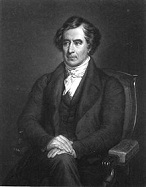
In 1824 French physicist Dominique Francois Jean Arago (1786-1853) discovers magnetic pull along with the fact that most bodies can be magnetized, also discovering rotary magnetism AKA Arago's rotations.

He's drunk with power? In 1824 French physicist Nicolas Leonard (Léonard) Sadi Carnot (1796-1832) pub. Reflexions sur la Puissance Motrice du Feu (Reflections on the Motive Power of Fire and on Machines Fitted to Develop That Power), which shows that the transformation of heat into motive power depends on the quantity of heat (caloric) and the temperature difference, while the efficiency of a steam engine is a function of the temperature difference between the hot and cold chambers (source and sink), the "free energy", a preliminary formulation of the Second Law of Thermodynamics; it also introduces the reversible Carnot Cycle and the Carnot heat engine; Carnot considers the Earth's atmosphere to be a giant heat engine, which ends up being ignored in the rush to frame CO2 on being the atmosphere's only heat engine?

On Oct. 21, 1824 Joseph Aspdin (1778-1855) of Britain patents Portland Cement.
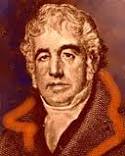
In 1824 Charles Macintosh (1766-1843) of Britain produces the first Mackintosh (coat not computer).

In 1825 Antoine Cesar Becquerel (1788-1878) of France invents the Differential Galvanometer for accurate measurement of electrical resistance.


In 1825 English physicist William Sturgeon (1783-1850) of the East India Co. College in Addiscombe, Surrey invents the first practical Electromagnet, a horseshoe-shaped piece of iron wrapped with wire; a 7 oz. horseshoe can lift 9 lbs. with the current from a single battery. In 1832 he invents the first DC Electric Motor with a Commutator.

In 1825 British (Cornish) inventor Sir Goldsworthy Gurney (1793-1875) invents the Oxy-Hydrogen Blowpipe, used for limelights, and the Bude Light, a very bright oil lamp pumped with oxygen, which is used to light the House of Commons for 60 years, along with Pall Mall and Trafalgar Square - so beloved of corned beef hams?

In 1826 German astronomer Heinrich Wilhelm Matthias Olbers (1758-1840) pub. Olbers' Paradox concerning the lack of brightness of the night sky if the Universe is infinite, eternal, and static.

In 1826 Anglican archbishop of Dublin (1831-) Richard Whately (1787-1863) pub. Elements of Logic, which spurs the study of logic in Britain and the U.S., making a fan of Charles Sanders Peirce (1839-1914).
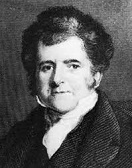
In 1827 London physician Richard Bright (1798-1858) first describes Bright's Disease (nephritis), characterized by albumin in the urine, causing him to become known as "the Father of Nephrology".


Young Guns, or Mathematical Brokeback Mountain? In 1827 Karl Gustav Jacob Jacobi (1804-51) and Niels Henrik Abel (1802-29) independently found the theory of elliptic (doubly periodic) functions.


No Pain No Gain for electrical circuits? In 1827 German physicist Georg Simon Ohm (1789-1854) pub. his famous Simple Simon Ohm's Law, stating that the ratio of electromagnetic force to current in an electrical circuit is a variable, er, constant, i.e. V = I * R (variable electromotive force = variable electric current times constant electrical resistance, independent of current and voltage).
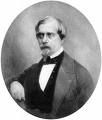
In June 1827 the first successful photograph (which he calls "heliograph") is produced by Joseph Nicephore Niepce (Nicéphore Niépce) (1765-1833) in France; it uses bitumen of Judea coated on pewter plates in a camera obscura facing a window of his estate, imaging a blurry bldg., tree, and barn after eight hours of exposure, becoming the oldest surviving photography of a real-world scene; he produced foggy photographs as early as 1822.

In 1827 English astronomer royal (1835-81) Sir George Biddell Airy (1801-92) invents the astigmatic (cylindrical) lens.
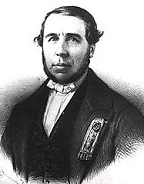
In 1827 French engineer Benoit Fourneyron (1802-67) invents the first practical water turbine, generating 6 hp from two sets of blades curved in opposite directions, winning him a 6K franc prize from the French Society for the Encouragement of Industry, going on to increase horsepower in 1837 to 60 at 2.3K rpm; in 1897 Fourneyron turbines are installed on the U.S. side of Niagara Falls.
In 1827 English-born U.S. engineer John Isaac Hawkins (1772-1854) invents the trifocal lens, along with a polygraph machine, and a mechanical penxil which Thomas Jefferson uses to write tens of thousands of letters; he later invents the upright (portable grand) piano.
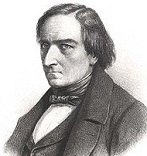
In 1827 German Bohemian engineer Josef Ludwig Franz Joseph Ludwig Franz (Josef Ludvik Frantisek) Ressel (1793-1857) patents the screw propeller for ships.

In 1828 German biologist Karl Ernst von Baer (1792-1876) pub. Uber Entwickelungsgeschichte der Theire, claiming that embryonic development is the history of increasing specificity, founding modern comparative embryology.
In 1828 Nicotine is first isolated in pure form by Wilhelm Hienrich Posselt (1806-77) and Karl Ludwig Reimann (1804-72) of Heidelberg, Germany from the leaves of the tobacco plant.

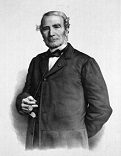
In 1828 German chemist Friedrich Wohler (Wöhler) (1800-82) isolates the pure light gray metal element Beryllium (#4) (Be) (discovered in 1798); he also synthesizes the organic chemical urea from the inorganic chemical ammonium cyanate, founding organic chemistry and dealing a death blow to the vitalistic theory that there is a vital force in living materials which creates an impassible gulf with inorganic ones; too bad, the vitalists get a reprieve when they find that he cheated and got his raw material from bones, and it takes until 1850 to kill vitalism completely; French chemist Antoine Alexandre Brutus Bussy (1794-1882) independently isolates beryllium. In 1832 Wohler and Justus von Liebig (1803-73) pub. a collaborative study of oil of bitter almonds (benzaldehyde), establishing the existence of organic radicals.
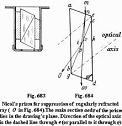
In 1828 Scottish inventor William Nicol (1768-1851) invents the Nicol Prism, useful for obtaining polarized light.


In 1828 Anyos Jedlik (1800-95) of Hungary invents the electric motor?
In 1828 Dutch candymaker Casparus van Houten (1770-1858) and his son Coenraad Johannes van Houten (1801-87) patent a process for removing the fat from roasted cocoa beans to make cocoa powder, and make the first chocolate candy; the first chocolate bar is produced in 1847 by J.S. Fry & Sons of England - I want to be born after this year?

In 1829 German chemist Johann Wolfgang Dobereiner (Döbereiner) (1780-1849) pub. the existence of a simple relationship among the atomic weights of elements having similar properties - he's got the columns but not the rows?

Science reaches a new plateau? In 1829 Belgian physicist Joseph Antoine Ferdinand Plateau (1801-83) discovers Stroboscopic Movement. In 1832 he invents the Phenakistoscope (spindle-viewer), the first moving picture device.

In 1829 Geneva-born French mathematician Jacques Charles Francois Sturm (1803-55) of France discovers Sturm's Theorem for finding the number of distinct real roots of a polynomial.
In 1829 Josef Ressel, inventor of the ship propeller attains a speed of six knots with his screw-propeller driven speedboat Civetta in Trieste.
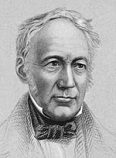
In the 1830s Glasgow-born Scottish chemist Andrew Ure (1778-1857) invents the bi-metallic Thermostat (Gr. "thermos" + "statos" = hot + stationary).

In 1830 Scottish botanist Robert Brown (1773-1858) discovers the cell nucleus in plants, along with Brownian Motion.

In 1830 English optician Joseph Jackson Lister (1786-1869) develops an achromatic lens for microscopes, getting rid of the colored halos surrounding objects and making them effective for the first time, even though it takes decades before skeptics accept microscope evidence as scientific proof.
In 1830 the first Lawnmower is invented by Edwin Beard Budding of England; it is imported to the U.S. in 1855.

In 1830 English adm. ("the Sea Wolf") Thomas Cochrane, 10th Earl of Dundonald (1775-1860) develops Compressed Air for use in engines - he should think of using it in diving?
In 1830 English optician Joseph Jackson Lister (1786-1869) develops an achromatic lens for microscopes, getting rid of the colored halos surrounding objects and making them effective for the first time, even though it takes decades before skeptics accept microscope evidence as scientific proof.
In 1830 James Perry of England receives a patent for a machine-made steel point pen with a center hole at the top of a central slit plus additional slits on each side; next year William Joseph Gillott stamps the nibs from sheets of rolled medal.

In 1830 poor French Parisian chemistry student Marc Charles Sauria (1812-95) invents the phosphorus-based Friction Match after changing the sulfur-reeking antimony sulfide of British chemist John Walker with white phosphorus, and the latter patents it for him and puts it into production; by the time of his death 3M of his matches are produced worldwide; too bad, the 1906 Internat. Berne Convention outlaws white phosphorus in 1906 - the Saurian conspiracy?


In 1830 Augustus Siebe (1788-1872) of Germany invents the first Closed Diving Suit, made of rubberized fabric.



On July 17, 1830 French tailor Barthelemy (Barthélemy) Thimonnier (1793-1857) patents the first practical Sewing Machine, using a hook-tipped needle and foot treadle, and receives a contract from the French army to make uniforms; too bad, local tailors fearing for their livelihood burn his plant down and put him out of biz. In 1832 Walter Hunt (1796-1859) of New York City invents a true sewing machine, introducing an eye-pointed needle and interlocked stitch, but refuses to apply for a patent because of fear of "injuring society" by throwing seamstresses out of work (either that or he gets snubbed by a few investors); meanwhile he has many other inventions under development, incl. the safety pin (which he sells for $400), knife sharpener, fountain pen, street sweeping machine, revolver, and repeating rifle.

In 1831 Scottish-born British explorer Sir John Ross (1777-1856) (uncle of Sir James Clark Ross) discovers the location of Earth's magnetic North Pole near Ellesmere Island in Canada on his 2nd Arctic expedition (ends 1833); starting in 1904, the pole begins shifting NE at about 9 mi. a year, speeds up again in 1989, and by 2007 is heading toward Siberia at 34-37 mi. a year.


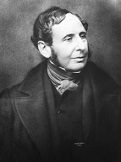
The original Skipper and Gilligan set out for Christmas '31? On Dec. 27, 1831 (Tues.) (11:00 a.m.) after having his interest in natural studies piqued by Cambridge botanist John Stevens Henslow (1796-1861), young biologist and bird shooter Charles Darwin (1809-82) sets out in HMS Beagle, captained by Robert FitzRoy (1805-65) (introduced to him by Henslow) for a 5-year cruise to Patagonia in South Am., New Zealand, and Australia (ends Oct. 2, 1836) to study flora and fauna and gather info. (ends 1836); his 17-day stay on the Galapagos Islands in fall 1835 takes him over the top, esp. the Galapagos tortoise, and the "obvious" natural selection among the 13 (14?) (15?) species of Darwin's finches (actually, passerine birds not related to finches), and his revulsion at the "hideous-looking" Galapagos marine iguana, with the soundbyte: "They are as black as the porous rocks over which they crawl and seek their prey from the Sea. Somebody calls them 'imps of darkness'. They assuredly well become the land they inhabit" (actually they eat seaweed); it takes for 1973 for a real scientific study of Darwin's finches to be made by Peter and Rosemary Grant - evolution or devolution?



In 1831 Samuel Guthrie (1782-1848) of N.Y. (inventor of percussion powder, which makes the flintlock musket obsolete, plus a process for converting potato starch into molasses in 1830), Justus von Liebig (1803-73) of Germany, and Eugene (Eugène) (1797-1859) of France independently discover Chloroform (CHCl3). In 1839 Soubeiran and Hyacinthe Captaine discover Cubebin.
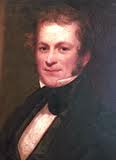
In 1831 James Bogardus (1800-74) of New York City invents a mechanized engraving machine for engraving dies for bank notes. In 1832 he invents the Eccentric Universal Mill, used for grinding lenses and finishing ball bearings. In 1851 after building his first cast iron bldg. facades in New York City last May 7, Bogardus builds the first three cast iron frame bldgs. in Washington, D.C., patenting his invention.


In 1831 Robert Hall McCormick (1780-1846) of Walnut Grove, Va. invents the Mechanical Reaper, and his son Cyrus Hall McCormick (1809-84) markets it, turning wheat farming into a big agribusiness; he receives a patent on June 21, 1834, and leaves it to his son, who later claims he invented it?

On May 31, 1832 French mathematician Evariste (Évariste) Galois (b. 1811) dies in Paris after a duel, leaving revolutionary papers giving necessary and sufficient conditions for the solution of equations by radicals using invariant (normal) subgroups, founding mathematical Group Theory; super-mathematician Gauss looks the stuff over and shrugs it off?

In 1832 English physicist Joseph Henry (1797-1878) discovers self-induced currents (inductance), and in 1842 he discovers the oscillatory character of electrical discharges.

In 1832 Irish inventor John Howard Kyan (1774-1850) patents the Kyanizing Process for preserving wood, canvas, cloth etc. using a solution of bichloride of mercury.
In 1832 the Cigarette is invented by an Egyptian artilleryman in the Egyptian-Turkish War after first inventing the use of paper tubes for holding cannon gunpowder rounds.
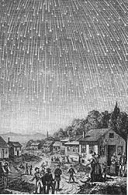
On Nov. 12/13, 1833 (night) the Great Leonid Meteor Storm of 1833 sees meteor showers all over North Am. E of the Rocky Mts. at a rate of 240K in 9 hours, sparking a serious scientific study of meteor showers; Leonid meteor showers radiate from the Constellation Leo, and are associated with Comet Temple-Tuttle, recurring about every 33 years, occuring on Nov. 6-30 with peak on Nov. 17; Uncompaghre Ute chief Ouray is born this night, his name meaning "arrow".

In 1833 English astronomer Sir George Biddell Airy (1801-92) proves an inequality in the motions of Venus and Earth that extends over 240 years, getting the Royal Astronomical Society's gold medal and a promotion to astronomer royal in 1835 (until 1881).

In 1833 English physician Marshall Hall (1790-1857) discovers the nervous reflex, going on to found the field of Neurology.
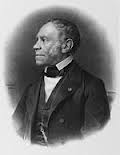
In 1833 French chemist Anselme Payen (1795-1871) proves that the fermentation of starch in grain to sugar is catalyzed by the watery material surrounding the grain, which contains no living microorganisms, calling the active principle "diastase" (from Gr. "separation"), which eventually causes all organic catalysts to be named with the suffix "-ase".


In 1833 English scientist Samuel Hunter Christie (1784-1865) invents the Wheatstone Bridge for the precise comparison of electrical resistances, capacitances, and inductances; it is not used until 1843 by Sir Charles Wheatstone (1802-75) (prof. at King's College, London since 1834), who ends up getting credit for it. In 1829 Wheatstone patents the Concertina. In 1834 Wheatstone measures the speed of electrical discharge in a conductor using a revolving mirror. In 1838 Wheatstone invents the Stereoscope.

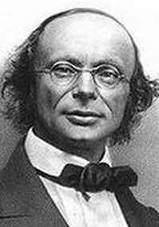
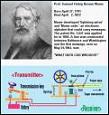




In 1833 Carl Friedrich Gauss (1777-1855) and Wilhelm Eduard Weber (1805-91) of Germany invent the Electromagnetic Telegraph, testing it up to 9K ft. In 1835 New York U. art prof. Samuel F.B. Morse (1791-1872) invents and demonstrates the Morse Electric Telegraph based on prior work of Germans Carl Friedrich Gauss and Wilhelm E. Weber; he and his associate Albert Vail (1807-59) build and test it in Speedwell Ironworks in Morristown, N.J.; in 1837 he exhibits it at the City College of New York, and invents Morse Code, which he can send at a shocking 10 words per min.; Morse and Maine Dem. rep. (1833-9) Francis Ormond Jonathan Smith (1806-76) lobby Congress for federal funding to build his telegraph system, and on May 1, 1844 after Congress appropriates $30K for a 37-mi. line, Morse sends the first telegraph message between Washington, D.C. and Baltimore, Md., officially opening the line on May 24 while demonstrating it to a crowd of dignitaries in the chambers of the U.S. Supreme Court, sending the message "What hath God wrought" to Alfred Vail. Meanwhile in 1837 English inventor Sir William Fothergill Cooke (1806-79) and Sir Charles Wheatstone (1802-75) patent an electric telegraph that is widely used in Britain.

In 1834 German physiologist (histologist) Theodor Schwann (1810-82) discovers the catalytic role of pepsin (from Gr. "digestion") in gastric juice - too early to be given the "-ase" suffix. In 1837 he recognizes that the yeast cell is a living organism, naming it saccharomyces (Gr. "sugar fungus") for its sweet tooth, also recognizing that fermentation is an anaerobic process, helping turn beer brewing into a science, going on to generalize that cells are the common structural and functional unit of all living organisms - and likes to paint his trucks mustard yellow? In 1839 the vitalist theory of animal life is dumped, and the cell-growth theory of biology is boosted with his discovery of animal cells, consisting of protoplasm separated by membranes, all mature tissues of animals being traceable to embryonic, nucleated cells.

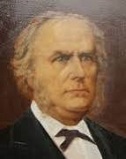
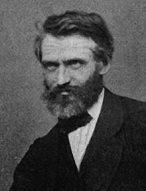
In 1834 Newburyport, Mass.-born inventor Jacob Perkins (1766-1849) develops the first workable refrigeration machine using the vapor-compression refrigeration cycle with ammonia, which is patented next Aug. 14; in 1856 Scottish-born James Harrison (1816-93) of Australia patents a vapor-compression refrigeration system that uses ether, and installs his first ice machine in a brewery; in 1859 French inventor Ferdinand Philippe Edouard Carre (Carré) (1824-1900) patents a modification to Harrison's design that uses ammonia instead of ether; in 1868 the Siebe Brothers of Lambeth, England install a Perkins machine in Truman's Brewery in London, and the same year Am. engineer Francis V. DeCoppet installs one in the New Orleans, La. brewery of George Mertz, finding that the Perkins design doesn't work well with ammonia, causing him to design his own, which he installs in 1869, receiving U.S. patent #148,675 on Mar. 17, 1874; earlier in the decade Perkins developed the Perkins Tube (Heat Pipe), which is later used in central heating systems - is it perkin'?

In 1835 French physicist Gustave Gaspard de Coriolis (1792-1843) first pub. a description of the curving deflection of winds caused by the Earth's rotation, AKA the Coriolis Effect (counterclockwise in the N Hemisphere). In 1829 he becomes the first to call the product of force and distance "work", and to point out that it is more convenient to speak of one-half of m times v squared for kinetic energy.

On Aug. 28, 1835 (Fri.) the first article in the Great Moon Hoax series by Richard Adams Locke (1800-71) (descendant of British philosopher John Locke) appears in the New York Sun, claiming that a new telescope has revealed that the Moon is inhabited by 4-ft.-tall flying man-bats along with unicorns and beavers; Edgar Allan Poe claims he was plagiarized.

In 1835 Belgian mathematician Adolphe Quetelet (1796-1874) pub. Sur l'Homme det le Developpement de ses Facultes, ou Essai de Physique Sociale, applying the theory of probability to the statistics of society, which he calls Social Physics, where the "average man" (l'homme moyen) is characterized by the mean values of measured variables following a normal distribution, pissing-off Auguste Comte, who coins the term "Sociology" in opposition.


In 1835 Scottish geologist Sir Roderick Impey Murchison (1792-1871) and British geologist Adam Sedgwick (1785-1873) pub. On the Silurian and Cambrian Systems, Exhibiting the Order in which the Older Sedimentary Strata Succeed each other in England and Wales, which defines the succession of Paleozoic strata in Wales, with Murchison defining the Silurian system (1839), and Sedgwick (Charles Darwin's teacher) defining the Cambrian system, laying the foundation for the modern Geological Time Scale; in 1840 after the Great Devonian Controversey, Murchison discovers a new layer between the Silurian and Carboniferous, which he calls the Devonian system.

In 1835 Samuel Colt (1814-62) of the U.S. invents the automatic revolver, and takes out an English patent for a single-barreled pistol and rifle; on Feb. 25, 1836 he receives a U.S. patent for a firearm with a revolving cylinder (revolver) - too late for Alamo use?


On May 15, 1836 English astronomer Francis Baily (1774-1844) first observes Baily's Beads during an annual solar eclipse in Inch Bonney, Roxburghshire.
On Oct. 24, 1836 Alonzo Dwight Phillips of Springfield, Mass. patents the white phosphorus loco foco or lucifer, the Friction Match, which can be struck on any rough surface, made by hand from chalk, glue, phosphorus, and sulfur; by the 1860s 1M matches a day are being manufactured.
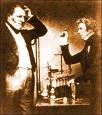
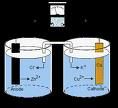
In 1836 English scientist John Frederic Daniell (1790-1845) develops the Daniell Cell (AKA Gravity Cell, Crowfoot Dell), a voltaic cell that cures the polarization problem of the Voltaic Pile by isolating the copper and zinc ions from each other with a semipermeable membrane, allowing longer operation.
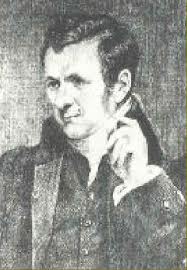
In 1836 English chemist (in Ireland) Edmund Davey (1785-1857) discovers acetylene gas, recognizing its value as an illuminating gas; too bad, it is forgotten until Marcellin Berthelot rediscovers it in 1860 after a zillion whales are butchered for their lousy tallow.
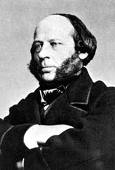
In 1836 Swedish-born Am. inventor John Ericsson (1803-89) patents a screw propeller, which is first used on the London-built SS Francis B. Ogden in 1837.
In 1836 English chemist (in Ireland) Edmund Davey (1785-1857) discovers acetylene gas, recognizing its value as an illuminating gas; too bad, it is forgotten until Marcellin Berthelot rediscovers it in 1860 after a zillion whales are butchered for their lousy tallow.
In 1836 Edward Hitchcock pub. an article about fossil footprints in the Conn. River Valley.
In 1836 Czech physiologist Jan Evangelista Purkinje notes the protein-digesting ability of pancreatic extracts.
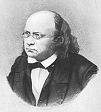
In 1836 German naturalist Karl Friedrich Schimper (1803-67), known for proposing his scientific ideas in poetic form and never getting an academic appointment begins researches into the Pleistocene Epoch - the first beatnik scientist?

In 1836 English physicist William Henry Fox Talbot (1800-77) discovers Talbot's Carpet, an interference pattern created when light passes through a series of parallel slits; in 2013 Martin McCall et al. of Imperial College London use it to create a way to cloak info. in data streams.
In 1836 New York State sponsors a natural history survey (ends 1842), which establishes U.S. geologists as a force; Maine sponsors a geologic survey (ends 1844).

In 1837 Vermont blacksmith Thomas Davenport (1802-51) develops the first DC Electric Motor.

In 1837 Ill. blacksmith John Deere (1804-86) invents a steel-tipped wrought-iron plow, which slowly becomes the standard for the U.S. prairie; his co. logo is in agricultural green and yellow, and features an antlered animal (don't say deeer?); by 1839 he makes a total of 10 plows.



In 1838 astronomers Friedrich Wilhelm Bessel (1784-1846) of Germany, Friedrich Georg Wilhelm von Struve (1793-1864) of Germany, and Thomas Henderson (1798-1844) of Scotland measure stellar parallax for the first time this year and next in binary star system 61 Cygni with measurements 6 mo. apart, giving the heliocentric theory its final proof.

In 1838 Dutch chemist Fox Mulder, er, Gerardus Johannes Mulder (1802-80) finds nitrogen and sulfur atoms in albuminoids, and decides that their structure is more complex than carbohydrates and lipids, causing Jons Jakob Berzelius to suggest the name "protein", from the Greek word for "of primary importance".
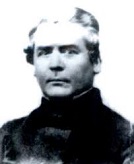
In 1838 the Bedford Level Experiment sees English inventor Samuel Birley Rowbotham (1816-84) use a 6-mo. stretch of the Old Bedord River in Cambridgeshire, U.K. to prove that the Earth is flat, later pub. the book "Zetetic Astronomy: Earth Not a Globe" under the alias Parallax (1849), containing the soundbyte: "The Earth is an enclosed plane, centered at the North Pole and founded along its outward edge by a wall of ice, with the Sun, Moon, planets, and stars only about 3,000 miles above the surface of the Earth (4,800 km) and the Glass Firmament at about 3,100 miles (5,000 km), only about 100 miles away from the Sun and the Moon."
In 1838 German botanist Matthias Jakob Schleiden (1804-81) pub. "Failures to Contribute to Phytogenesis", announcing that plants are composed of cells.
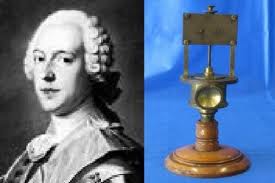
In 1838 French engineer-physicist Baron Charles Cagniard de la Tour (1777-1859) theorizes that yeast is composed of tiny living spherules which bud and produce more spherules.

In 1838 after reading Thomas Malthus' "An Essay on the Principle of Population" (1798), French mathematician Pierre Francois Verhulst (1804-49) pub. the Logistic Equation to model pop. growth; in 1925 Alfred J. Lotka names it the Law of Pop. Growth.
In 1838 David Bruce of New York City invents the Pivotal Typecasting Machine, capable of producing 6K pieces of type an hour, revolutionizing the biz by replacing men who acted as handcasters, causing a mini Luddite revolt; he patents it in 1845. Also in 1838 Moritz Hermann Jacobi of St. Petersburg, Russia invents Electrotyping (Galvanoplastics) to make duplicate plates for relief printing. Also in 1838 Charles Babbage of England invents the Cow Catcher, attached to the front of a train to clear obstacles off the track.


In 1839 French Parisian physicist Antoine Cesar Becquerel (1788-1878) and his son Alexandre Edmond Becquerel (1820-91) discover the Photoelectric (Photovoltaic) Effect.
On Feb. 24, 1839 Pelham, Mass.-born William Smith Otis (1813-39) of Philly (older cousin of elevator man Elisha Otis) patents the Steam Shovel, then dies on Nov. 13.

In 1839 Welsh inventor Sir William Robert Grove (1811-96) invents the Platinum-Zinc Battery (Grove Cell), and uses it to power an electric arc light in the Finsbury Circus in London.


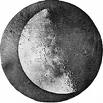

In 1839 English-born Am. scientist John William Draper (1811-82) becomes the first person in N.Y. to use the Daguerre process, and makes photographs of the Moon; a photo he makes next year of his sister Dorothy Catherine Draper becomes the oldest photographic portrait to survive to modern times; meanwhile after Louis Daguerre's invention is announced on Jan. 7, English inventor William Henry Fox Talbot (1800-77) claims priority (1835) over Daguerre in photography and argues his case before the Royal Society.
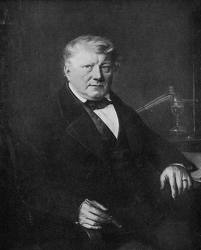
In 1839 German-Swiss chemist Christian Friedrich Schonbein (1799-1868) discovers and names ozone. In 1846 he discovers guncotton (cellulose nitrate).
In 1839 Berlin apothecary Eduard Simon discovers Polystyrene in storax, the resin of the Turkish sweetgum tree Liquidambar orientalis.


In 1839 Am. inventor Charles Goodyear (1800-60) invents the Vulcanization Process for Rubber, which he patents on June 15, 1844, leading to the mass production of rubbers, AKA condoms; denture bases, previously made of gold, become affordable to the masses; too bad, English scientist Thomas Hancock (1786-1865) patents vulcanization of rubber on May 21, 1844, and Goodyear only comes up with his 1839 story in his 1853 autobio. Gum-Elastica; starting in 1890 Brazil experiences a rubber boom, going from 31 tons exported in 1839 to 27K tons in 1900. Meanwhile in 1845 Robert William Thomson (1822-73) of England invents the rubber pneumatic tire for bicycles, patenting it in 1847.


In 1839 the first Velocipede (a Draisienne with pedals on the rear wheels) is invented by Scottish inventor Kirkpatrick Macmillan (1810-78).
About 1840 the Second Industrial Rev. begins, bringing railroads, large-scale steel production, increased use of steam power and petroleum, mass production, and factory electrification.




In Feb. 1840 German physician Julius Robert von Mayer (1814-78) sails from Rotterdam in the 3-masted ship Java, and after docking at Surabaya he notices that the venous blood of sailors he's bleeding is brighter red, indicating less oxygen being consumed than in colder climates, causing him to have a bright idea that food is oxidized to create not only animal heat but work, hence that heat and work are interchangeable in some way. In 1842 he announces an improved value for the mechanical equivalent of heat, calculated by an apparatus pulled by a horse that stirs paper pulp in a cauldron, and proposes the law of conservation of energy, which holds even for living systems, and also states that the Sun is the ultimate source of energy on Earth; too bad, not being a recognized scientist (member of a prof. assoc. of stuffed shirts), he is ignored; he says that a weight falling 365m will lose enough potential energy to warm an equal weight of water by 1 deg C, corresponding to a mechanical equivalent of heat of 3.56 Joules per calorie, not far from the real figure of 4.184. The tendency of learned societies of know-nothings to keep newbies out follows the dismal example of established churches? In 1843 British (Manchester) brewer and obsessive amateur scientist James Prescott Joule (1818-89) calculates the first fairly accurate value (41.54M ergs or 4.154 Joules per calorie) for the mechanical equivalent of heat; later 10M ergs is called a Joule in his honor; at first his work is disregarded since he's not a recognized academic, and is refused by the Royal Society and learned journals, forcing him to get it pub. in 1847 in a Manchester newspaper on which his brother is the music critic; a few mo. later he is allowed to present it at a scientific gathering, and 23-y.-o. Scottish physicist William Thomson (1824-1907) (later Lord Kelvin) gets it accepted, causing it to be taken up by respectable German scientist Hermann Ludwig Ferdinand von Helmholtz (1821-94), who ends up getting credit for the law of conservation of energy instead of amateurs Joule and Mayer in 1847; Joule finally gets to present his paper to the Royal Society in 1849, making him look like a beer-brewing copycat? In 1852 Joule and Thomson discover the Joule-Thomson Effect, a change in temperature of a non-ideal gas or liquid when forced through a valve (throttle) or porous plug in an adiabatic environment. Meanwhile in 1840 James Prescott Joule pub. the I^2*R law for the heat given off by a conductor of resistance R carrying a current I (Joulean heat) - the reason Easy-Bake Ovens work?
In 1840 English surgeon John Wright of Birmingham invents Electroplating using silver cyanide in a potassium cyanide solution, which is patented by manufacturer George Richards Elkington (1801-65).

In 1840 Cambridge historian-philosopher William Whewell (1794-1866) coins the word "scientist" (Lat. "scire" = to know, Lat. "scindire" = to cut, Gr. "schizein" = to split) ("We need very much a name to describe a cultivator of science in general. I should incline to call him a scientist"); he also coins the term "physicist".

In 1841 Scottish physician James Braid (1795-1860) coins the term "hypnotism", becoming the first to use it in the modern sense as a "psycho-physiological" rather than occult phenomenon.


In 1841 Carlo Matteucci (1811-68) of Italy discovers a difference of electrical potential between an excised nerve and damaged muscle, leading Emil du Bois-Reymond (1818-96) to found a German school of physiologists seeking to reduce physiological phenomena to physico-chemical processes.
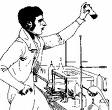
In 1841 after returning from India, Irish physician Sir William Brooke O'Shaughnessy (1809-89) introduces cannabis sativa (hashish, marijuana) to Western medicine.

In 1841 English mechanical engineer Sir Joseph Whitworth (1803-87) devises the British system of standard screw threads - it's not worth a whit?
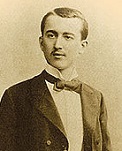
In 1842 French mathematician Joseph Alphonse Adhemar (Adhémar) (1797-1862) pub. Revolutions of the Sea, proposing the astronomical theory of Ice Age causation, which evolves into the theory of Milkanovich Cycles in the 1920s by Serbian mathematician Milutin Milankovic (Milankovitch) (1879-1958).


In 1842 Austrian physicist Christian Andreas Doppler (1803-53) pub. the first explanation of the Doppler Effect (Shift). In 1845 Dutch scientist Christoph Hendrik Diederik (Christophorus Henricus Diedericus) Buys Ballot (1817-90) first tests the brand-new Doppler effect by having an orchestra of trumpeters perform in an open railroad car as it speeds through the countryside on the Utrecht-Amsterdam line.

In 1842 Robert Wilhelm Eberhard von Bunsen (1811-99) of Germany invents the carbon electrode battery, far less expensive than William Robert Grove's platinum electrode battery. Too bad, in 1843 he loses the use of his right eye in a cacodyl cyanide explosion, and, remembering two near-deaths from arsenic poisoning, he decides to switch from organic to inorganic chemistry.







On Mar. 30, 1842 Ga.-born U. of Penn. Medical School grad. (1839) Crawford Williamson Long (1815-78) pioneers surgical ether anesthesia during a minor operation to remove a neck tumor from James M. Venable, followed by eight more operations over the next four years, but fails to announce his results until 1849, allowing William T. Morton to grab the glory, after which he has U.S. Sen. William Crosby Dawson present his claims to Congress in 1854; his statue ends up in the crypt of the U.S. Capitol as one of two to represent the state of soporific Magnolia-blossom Jawjaw. On Dec. 10, 1844 Vt.-born medical student Gardner Quincy Colton (1814-98) first demonstrates nitrous oxide for anesthesia to Hartford, Conn. dentist Horace Wells (1815-48), then leaves for the Calif. Gold Rush, letting Wells take the credit; too bad, next year Wells gives a public demonstration in a Boston hospital and pulls the patient's tooth before the anesthetic takes effect, causing him to be laughed at, then generously offers the discovery to the public domain with the soundbyte that pain relief should be "as free as the air" - go be my Luca Brazzi? In Oct. 1846 the first surgery using sulfuric (diethyl) ether for anesthesia is performed at Mass. General Hospital on tumor removal patient Gilbert Abbott by Dr. John Collins Warren after dentist William Thomas Green Morton (1819-68), pupil of ether pioneer Charles Thomas Jackson (1805-80) suggests it; Green and Jackson then make a public demonstration of ether's anesthetic properties, claiming the discovery of "letheon", causing Conn. rival Dr. Horace Wells to get into a bitter claim for priority and end up committing suicide in 1848 in New York City - I said it's better with a spray? In 1848 Sir James Young Simpson (1811-70), who discovered the soporific properties last year first uses Chloroform for anesthesia during childbirth, after which in 1853 John Snow (1813-58) uses it during the delivery of Queen Victoria's son Leopold, causing Simpson to become the first person to be knighted for services to medicine; meanwhile Dr. Horace Wells tries it on himself for a week in Jan., goes crazy and throws sulfuric acid on two hos, causing him to be committed to Tombs Prison in N.Y.; when he comes to, he takes more chloroform, then slits a leg artery with a razor and commits hari kari.

In 1842 the rare earth element Yttrium (Y) (#39) (obtained from monazite sand, known for use in red phosphors for color TVs and garnet crystals) is discovered by Swedish chemist Carl Gustaf (Gustav) Mosander (1797-1858), who also discovers the rare metallic element didymium in cerite, but later finds that it's just a mixture of the elements neodymium and praseodymium.


In 1843 French mathematician Adhemar Jean Claude Barre (Adhémar Jean Claude Barré) de Saint-Venant (1797-1886) pub. the first correct derivation of the Navier-Stokes Equations for viscous flow, and becomes the first to identify the coefficient of viscosity as the multiplying factor for velocity gradients in the flow; too bad, English physicist Sir George Gabriel Stokes (1809-1903) ends up getting credit after he asks his Cambridge students to solve it for prize exams in 1854, even though he got the solution in 1850 from Lord Kelvin.
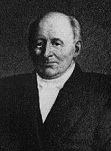
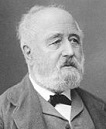
In 1843 German astronomer Samuel Heinrich Schwabe (1789-1875) discovers 11-year Solar Cycles of sunspot counts, with Cycle 1 set in 1755-66 by Swiss astronomer Johann Rudolf Wolf (1816-93) in 1848, who devises the Wolf (Zurich) (Internat. Sunspot) (Relative Sunspot) Number for the number of visible sunspots and sunspot groups; in 1852 Wolf et al. discover the link between the Wolf Cycle and geomagnetic activity on Earth.
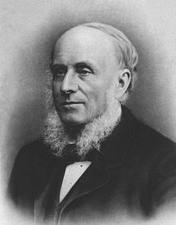
In 1843 Scottish inventor Alexander Bain (1811-77), inventor of the electric clock invents the facsimile (fax) machine, using electric clock pendulums to produce a back-and-forth line-by-line scanning mechanism.

In 1843 British judge and physicist Sir William Robert Grove (1811-96) invents the Fuel Cell; the expense causes them to rest dormant until the Space Age, when they are used to power spacecraft.
In 1843 French scientist Lucien Vidie invents the Aneroid Barometer, which uses a beryllium-copper capsule instead of mercury.
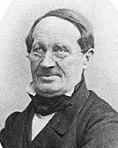
In 1844 German chemist Karl Ernst Claus (1796-1864) discovers the greyish-white metallic element Ruthenium (Ru) (#44) in platinum ores.
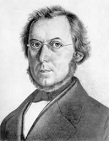
In 1844 German botanist Hugo von Mohl (1805-72) identifies and names protoplasm as the source of movements in the nucleus.
In 1844 Elijah Galloway of Britain invents waterproof easy-to-clean gray-brown rubber and powdered cork Kamptulicon (Gr. "kampto" = flexible) (the first lineoleum), which is used to line the floors of the British Parliament; real lineoleum is patented in 1863; too bad, increases in rubber prices drive the co. out of business.
In 1844 Gustaf Erik Pasch (Berggren) (1788-1862) of Sweden patents a safety match with red phosphorus on the striking surface; too bad, the red stuff is too expensive, and he goes broke.
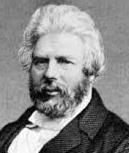
In 1844 Scottish geologist Robert Chambers (1802-71) anon. pub. Vestiges of the Natural History of Creation, which prepares many people to come out of the closet and accept Darwin's Theory of Evolution, while chicken Darwin satisfies himself by privately circulating a long essay on his theory - so it's now OK to try some of those new condom thingies on their new lineoleum floors while getting high on laughing gas?
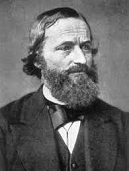
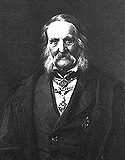
In 1845 German physicist Gustav Robert Kirchhoff (1824-87) proposes Kirchhoff's Circuit Laws, generalizing the work of Georg Simon Ohm and preparing the way for the work of James Clerk Maxwell; meanwhile his teacher, German physicist Franz Ernst Neumann (1798-1895) pub. a mathematical justification of the law of electromagnetic induction.
On Mar. 17, 1845 the first Rubber Band made of vulcanized rubber is patented by Stephen Perry of London, England.In 1845 Sir William George Armstrong (1810-1900) of England patents a hydraulic crane driven by a piston engine.
In 1845 Erastus Brigham Bigelow (1814-79) of the U.S. invents a power loom for carpet manufacturing, going on to turn Clinton, Mass. into a manufacturing center.
In 1845 Am. Tom Thumb builder Peter Cooper (1791-1883) patents a gelatin dessert which in 1897 is marketed as Jell-O.
In 1845 Joshua Heilman (1796-1848) of France patents a machine for combing cotton and wool.


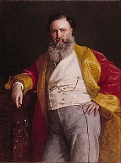
In 1845 Am. inventor Elias Howe (1819-67) invents the modern high-speed Sewing Machine ("the queen of inventions"), with eye-pointed needle, two strands of thread, and a shuttle lock stitch process, receiving a patent next Sept. 10, and quickly revolutionizing the shoe, boot, and textile industries, dropping the labor for a man's dress shirt from 14 to 1.25 hours, and for a woman's dress from 10 to 1 hour; after failing to stir interest in the U.S., he goes to England and sells several to a corset maker, then returns to find that his idea has caught on but his patents were stolen blind, causing him to consume years in litigation with Isaac Merritt Singer (1811-75), Wheeler & Wilson, Grover & Baker, et al., making his lawyers rich, although he gets rich too; in 1856 he and the four other leaders form the Sewing Machine Combination, which controls the industry until their patents expire in 1877, making him and Singer millionaires with the first mechanical device to enter homes, helped by the hire-purchase (installment) plan introduced by Singer, who sells 43K machines a year by 1867 (5K more than #2), growing to 1M a year by the year 1900.
In 1845 W.A. Miller invents Spectrum Analysis using colored flames, but his work is largely ignored because the alcohol flames used are too weak.

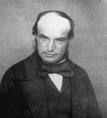
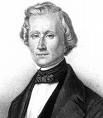

On Sept. 23, 1846 planet Neptune is discovered by German astronomer Johann Gottfried Galle (1812-1910) and Heinrich Ludwig d'Arrest (1822-75) after its position is independently predicted mathematically in 1843-5 by English mathematician-astronomer John Couch Adams (1819-82) (pr. cooch) of Cambridge U. in England (not to be confused with U.S. pres. John Adams) and independently in 1846 by Urbain Le Verrier (1811-77) of France; Adams' prediction is less than 2 deg. from the actual location, making him BMOC in 19th cent. astronomy; in July 2011 it makes its first orbit around the Sun since discovery; on Oct. 10 (17 days after the discovery of Neptune), English astronomer William Lassell (1799-1880) discovers Triton, Neptune's largest moon (retrograde). In 1851 Lassell discovers Uranus' moons Ariel and Umbriel, starting the tradition of naming Solar System moons after Shakespeare's characters, causing Queen Victoria to ask to meet him when she visits Liverpool, after which he builds a 48-in. telescope in Malta to discover glorious new make-benefit moons for the Queen; no astral body is named after Shakespeare himself until ?

In 1846 Italian chemist Ascanio Sobrero (1812-88) invents the volatile explosive nitroglycerine, made from nitric acid, sulfuric acid and glycerine, then keeps it secret for a year because of its horrible potential uses; his student Alfred Nobel takes it back to his family's defunct armament factory and plays around with it and making it less dangerous to handle - Father, I want to kill you; mother, I want to...?

In 1846 Oliver Allen of Norwich, Conn. patents the shoulder-fired Bomb Lance (AKA Brand Gun), with an exploding tip for a closer-range whale kill; luckily Abraham Gesner (1797-1864) from thrifty Nova Scotia first distills kerosene from coal oil, saving the whales as lamps can now be lit with it instead of whale oil, and more cheaply.


In 1846 Richard March Hoe (1812-86) of New York City, son of English immigrant printer Robert Hoe (1784-1833) invents the Rotary Press, using revolving cylinders instead of flat beds, becoming known as the lightning press; in 1848 he invents the Web Press, which prints on both sides of the sheet and cuts and folds it, making modern newspapers possible.

In 1847 Carl F.W. Ludwig (1816-95) of Germany invents the Kymograph (Gr. "wave writer") to record blood pressure, boosting the study of physiology.

In 1847 Austrian-Hungarian physician Ignaz Philipp Semmelweis (1818-65) discovers the connection between childbed fever and puerperal infection, and pisses-off physicians by suggesting that their filthy hands and instruments are killing their patients - be hot and stay cool?
In 1848 Louis Pasteur separates tartaric acid into its two racemates, components with mirror-image structures, founding Stereochemistry.
In 1848 English scientist Capt. Henry Piddington (1797-1858) coins the word "cyclone" to refer to a storm that blew his freighter in circles in Mauritius in Feb. 1845.
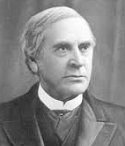
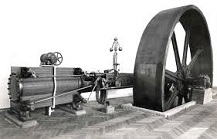
In 1848 Easton, N.Y.-born engineer George Henry Corliss (1817-88) of Providence, R.I. invents the Corliss Steam Engine, and patents it next Mar. 10, delivering 30% more fuel efficiency than previous steam engines.

In 1849 after planting 22K seedlings of the indigestible hard-skinned fox (skunk) grape Vitis labrusca in an attempt to develop a palatable wine from "pure" native Am. species to get around the "debauched" European and Semitic species Vitis vinifera, the slip-skin Concord Grape is invented by Boston-born gold leaf artisan and amateur farmer Ephraim Wales Bull (1806-95) of Concord, Mass.; too bad, after he fails to obtain a patent others begin growing and selling them; his epitaph reads "He sowed others reaped."
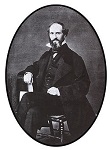
In 1849 English botanist Richard Spruce (1817-93) begins an expedition to South America (ends 1864), discovering yage (ayahuasca), the hallucinogenic drink used by Amazonian tribes that is prepared from the bark of giant flowering vines (Banisteria caapi).
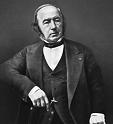
In 1850 French physiologist Claude Bernard (1813-78) discovers the glycogenic function of the liver; next year he establishes the existence of vasomotor nerves, and formulates the concept of milieu interieur (homeostasis).

The original Rudolf the Red-Nosed Rain On Your Parade, Dear? In 1850 German physicist Rudolf Julius Emanuel Clausius (1822-88) formulates the Second Law of Thermodynamics, and the Kinetic Theory of Gases. In 1865 he coins the term "entropy", and reformulates the Second Law of Thermodynamics using it: "The entropy of the Universe is constantly increasing to an eventual maximum" - that sounds good and bad at the same time?

In 1850 French physicist Jean Bernard Leon Foucault (1819-68) proves that light travels more slowly in water than in air, and that the speed varies inversely with the index of refraction. In 1851 he wows the crowds with his 220-ft. (67m) wire pendulum suspended from the dome of the Pantheon in Paris, proving that the Earth really rotates on its axis.

In 1850 German scientist Adolph Wilhelm Hermann Kolbe (1818-84) produces acetic acid using zinc and chloroacetic acid, thus transforming one organic substance into another without needing a living system, driving a final nail into the coffin of vitalism (not that its proponents don't stick with it till their deaths); "How is it that scientific theories change when some scientists, who are allegedly the most logical of men, continue to adhere to their pet beliefs in the face of all evidence?" (Max Planck)

About 1850 Swedish inventor (in Russia) Immanuel Nobel (1801-72) (father of Alfred Nobel) invents the Rotary Lathe, making possible the manufacturing of Plywood.

In 1850 English sociologist Herbert Spencer (1820-1903) pub. Social Statics, or The Conditions Essential to Happiness Specified, and the First of Them Developed, founding modern Sociology; "It is clear that man can become adapted to the social state, only by being retained in the social state." In 1852 he pub. The Developmental Hypothesis, containing the first use of the the all-powerful catchword "evolution". In 1864 he pub. The Principles of Biology, which coins the term "survival of the fittest"; "The survival of the fittest implies multiplication of the fittest."
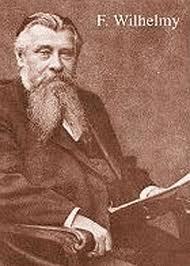
In 1850 German scientist Ludwig Ferdinand Wilhelmy (1812-65) pioneers the study of chemical kinetics in the inversion of cane sugar, and observes that the rate is proportional to the concentration of undecomposed sugar, while the rate constant is dependent on the concentration of the acid catalyst.

In 1850 Carl Kellner (1826-55) of Germany invents the 3-lens Kellner Eyepiece, the first modern achromatic eyepiece, and founds the Leitz Co., which in 1913 produces Leica brand cameras.

In 1851 English astronomer royal (1835-81) Sir George Biddell Airy (1801-92) establishes the 4th Prime Meridian at Greenwich, which becomes internationally recognized in 1884. In 1854 he establishes the specific density of the Earth as 6.566 after placing a pendulum at the bottom of Harton Pit near Brooke, er, South Shields; the true value is 5.515.

In 1851 French mathematician Joseph Liouville (1809-82) proves the existence of transcendental numbers, whose decimal expansions neither terminate nor repeat.

The lukewarm Love Train, or, There are only two kinds of people, those who think that there is a God, and those who believe they are God? Right in your face mask? In 1851 English physicist William Thomson (1824-1907) (later Lord Kelvin) begins pub. papers on the laws of conservation and dissipation of energy, generalizing Carnot's 1824 paper and formulating the Second Law of Thermodynamics, the idea of degradation of energy and the eventual heat death of the Universe, in which there is a uniform temperature throughout, hence none of its energy can be converted into useful work; "Though the total energy of the Universe is constant, the amount of free energy decreases steadily"; luckily there is still enough free energy left for trillions of years?

On May 6, 1851 Am. physician John Gorrie (1802-55) of Apalachicola, Fla. patents (U.S. Patent #8080) the first Refrigerator (ice machine) to help his patients fight tropical diseases; the first demonstration is made to ice champagne for a cotton buyer; too bad, the machine is never produced commercially because of opposition by ice merchants, and he dies broke and humiliated; meanwhile in June the Northern Railroad of N.Y. puts its first "icebox on wheels" into service, and the Ogdensburg and Lake Champlain Railroad begins shipping butter to Boston, Mass. in freight cars carrying ice; too bad, they only work in winter, and dressed beef can't be shipped on ice or it will discolor and lose taste.

In 1851 Japanese inventor Tanaka Hisashige (1799-1881) invents the Myriad (10,000-Year) Clock.

In 1851 German scientist Hermann Ludwig Ferdinand von Helmholtz (1821-94) invents the Opthalmoscope for examining the retina, leading to the medical specialty of opthalmology.

In 1851 Dutch army surgeon Antonius Mathysen (Mathijsen) (1805-78) invents the Plaster of Paris Cast.

In 1851 Isaac Merritt Singer (1811-75) of Boston, Mass. invents the continuous stitch sewing machine.
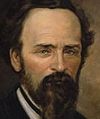
On May 6, 1851 Linus Yale Jr. (1821-68) of Newport, N.Y. patents the Yale Pin-Tumbler Cylinder Lock (U.S. Patent #8,071).
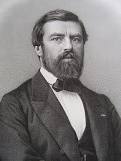
In 1852 Leopold Delisle (1826-1920) of France pioneers modern paleography.

In 1852 Irish physicist Sir George Gabriel Stokes (1819-1903) describes the phenomenon of fluorescence as exhibited by fluorspar and uranium glass, which converts invisible UV rays into lower frequency visible rays.
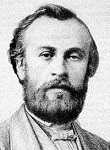
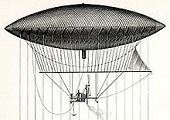
The first dirigible, combining balloons with engines? On Sept. 24, 1852 French engineer Baptiste Jules Henri Jacques Giffard (1825-82) launches the first successful engine-powered man-carrying dirigible; it is 144 ft. long and 39 ft. in diam., is inflated with 88 cu. ft. of coal gas, uses a steam engine and propeller, and flies 20 mi. from Paris to Trappe at up to 6.7 mph, becoming the first passenger-carrying airship.

On July 14, 1853 New York City opens the Great Exhibition of Art and Industry (World's Fair) in its own Crystal Palace in Bryant Park, where Vt.-born civil (bed factory) engineer Elisha Graves Otis (1811-61) demonstrates his automatic safety device for stopping an elevator after its supporting cables snap, setting up a manufacturing plant in Yonkers, N.Y. (until 1983); too bad, the fair is a financial failure and loses $300K. In 1861 Graves patents the steam-powered Safety Elevator, then dies on Apr. 8, leaving Otis Elevator Co. to his sons.
In Oct. 1853-Feb. 1856 the Crimean War, caused by Russia's attempt to grab Eastern Orthodox areas of the ailing Muslim Ottoman Empire while France, Britain, and Sardinia try to stop them becomes noted for "confusion of purpose" and "notoriously incompetent international butchery".
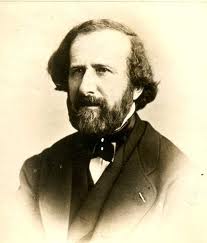
In 1853 French physicist Armand Hippolyte Louis Fizeau (1819-96) first describes the use of the capacitor (condenser) to increase the efficiency of an induction coil.
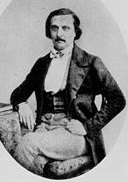

In 1853 French chemist Charles Frederic (Frédéric) Gerhardt (1816-56) discovers Acetylsalicylic Acid, the active ingredient in willow bark, but sets it aside as impractical after his formulation proves unstable; in 1878 Felix Hoffman rediscovers it. In 1890 the non-addictive topical anesthetic Benzocaine is isolated in Germany, and given the trade name Anesthesin. In 1898 Bayer Pharmaceutical Products (founded Aug. 1, 1863) of Darmstadt, Germany begins marketing a new, rather habit-forming cough suppressant formula (good also for laryngitis and TB), with its trademarked drug heroin (diacetylmorphine) as it main ingredient ("Heroin, the medicine for coughs"); the name is derived from the German word heroisch (large, powerful); German chemist Heinrich Dreser (1860-1924) is dir. of research. In 1899 Bayer Co. of Germany patents and trademarks Aspirin, from the "a" in acetyl, and the "spir" in Spiraea ulmaria, the willowleaf meadowsweet, later calling it the "Wonder Drug"; it is sold in powder form, the first tablets being sold in 1915; as part of the 1919 Versailles Treaty Bayer gives up its patents on aspirin and heroin - WWI was one giant headache?

In 1853 Scottish engineer William John Macquorn Rankine (1820-72) coins the term "potential energy" - beam me up?


In 1853 Alexander Wood (1817-84) of Edinburgh, Scotland and Charles Gabriel Pravaz (1791-1853) of France independently develop hypodermic syringes; too bad, they mistakenly believe that morphine that bypasses the stomach isn't addictive, spreading addiction.

In 1853 Condensed (evaporated) milk is invented by Norwich, N.Y.-born Gail Borden Jr. (1801-74) of New York City, and patented on Aug. 19, 1856, marketed under the name Eagle Brand; he goes on to open plants in Conn. and Ill., and sell large quantities to the U.S. military in the U.S. Civil War.
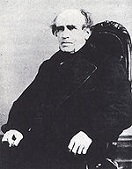
On Sept. 1, 1854 Scottish-born Am. astronomer James Ferguson (1797-1867) discovers 31 Euphrosyne, 12th largest and 5th most massive asteroid in the asteroid belt, named after Greek goddess Euphrosyne (Euthymia) (one of the Three Graces or Charites), becoming the first asteroid discovered from North Am.

On Nov. 27, 1854 Andre-Adolphe-Eugene Disderi (André-Adolphe-Eugène Disdéri) (1819-89) of Paris, France patents Carte-de-Visite Photography, which produces a thin paper photograph mounted on a thicker visiting card-sized (6cm x 9cm) paper card, which doesn't sell until Disderi pub. photos of Emperor Napoleon II in 1859, making it into an overnight success, leading to a worldwide boom in portrait studios known as Cardomania; too bad, he fails to patent it, and after getting wealthy dies broke in an asylum.

In 1854 Pierre Eugene Marcellin Berthelot (1827-1907) of France pub. a doctoral dissertation establishing the structure of fats and glycerin, methods of synthesis, and the nature of polyhydric alcohols. In 1856 he synthesizes methane, becoming the first hydrocarbon prepared in the lab from its basic elements. In 1860 he turns sucrose into glucose and fructose (invertase) with a non-living ferment made from mashed yeast cells, theorizing that all ferments are non-living, but is overruled by Louis Pasteur, who claims a distinction between soluble and cell ferments.
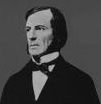
In 1854 English mathematician George Boole (1815-64) of Queen's College in Cork, Ireland pub. An Investigation of the Laws of Thought, on Which Are Founded the Mathematical Theories of Logic and Probabilities, founding Boolean Algebra.

In 1854 Scottish engineer John Elder (1824-69) invents the compound steam engine with two cylinders, which uses one-third less coal; in July the SS Brandon, the first ship with the new engine sails.

In 1854 Spanish singing teacher Manuel Patricio Rodriguez Garcia II (1805-1906) invents the Laryngoscope.
In 1854 German watchmaker Heinrich Goebel invents the first electric light bulb.

In 1854 U.S. Navy doctor Edward Robinson Squibb (1819-1900) invents a method for safely distilling ether for use as an anesthetic, and refuses to patent it; in 1858 he founds E.R. Squibb & Sons to manufacture ether, chloroform, and other pharmaceuticals.

In 1855 German chemist Robert Wilhelm Eberhard Bunsen (1811-99) invents the gas Bunsen Burner, and magnanimously refuses to file a patent application; actually technician Peter Desaga invents it but he takes the credit?

In 1855 pure cystalline Cocaine is extracted from perishable cocoa beans by German chemist Friedrich Georg Carl Gaedcke (1828-90); he calls it erythroxyline.
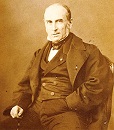
In 1855 French sociologist Pierre Guillaume Frederic le Play (1806-82)Les Ouvriers Europeens, 36 monograms based on his observations of 300 influential royal families during his travels in 1829; his exhaustive observations spawn the method of case study, esp. when scientists try to work out his bugs.



In 1855 Sir Henry Bessemer (1813-98) of England patents the Bessemer Process for mass production of steel by blasting air through molten pig iron in a large Bessemer container to burn away carbon and other impurities, causing English steel production to zoom, and bringing him total royalties of over £1M, plus all the perks, incl. a knighthood; he even begins manufacturing steel strings for pianos. In 1856 German-born British inventor Sir Charles William Siemens (1823-83) invents the Regenerative Furnace to make ductile steel for high pressure boiler plating. In 1861 he and French engineer Pierre Emile Martin (1824-1915) simultaneously invent the Siemens-Martin Regenerative Open Hearth Process for making steel, which recycles coal gas to preheat the fuel and uses less coal than the Bessemer Process, allowing steel and iron to be produced on a whole new level of quantity and quality, replacing it by 1910.

In 1855 German physicist Johann Heinrich Wilhelm Geissler (1814-79) invents the sealed glass Geissler Tube, which emits a bluish glow when excited by an induction coil, becoming the ancestor of the fluorescent lamp.

In 1855 British-born Ky. music prof. David Edward Hughes (1831-1900) invents the printing telegraph, which is adopted by Western Union and becomes an internat. standard.

In Mar. 1856 18-y.-o. English chemist William Henry Perkin (1838-1907) (later sir), a student of August Wilhelm von Hofmann discovers Mauveine, the first synthetic aniline (coal tar) dye while trying to produce quinine, and files for a patent in Aug., with its cool purple color causing a commercial bonanza, as from ancient times royal Tyrian purple could only be made from mollusc mucous, making him rich and gaining him a knighthood; after Euro countries go into the dye biz, many startling new low-priced colors follow, but unfortunately few are stable and don't fade like his.
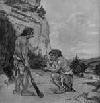
In Aug. 1856 the mentally-challenged Neanderthals are discovered in Feldhofer Cave in the Neander Valley between Dusseldorf and Wuppertal in Germany, why did it have to be Germany in Aug.? - white supremacists now have the problem that if they call somebody a Neanderthal they're implicating the modern German white race as stupider than all other modern races?

In 1856 French scientist Louis Pasteur (1822-95) discovers that fermentation is caused by microorganisms, and tries to help the French industry figure out how to stop wine from turning sour (finished 1860). In 1857 he proposes the Germ Theory of Disease, claiming that anthrax is caused by a bacillus; in 1861 he pub. Memoire sur les Corpuscles Organises qui Existent dans l'Atmosphere, discrediting spontaneous generation and promoting the Germ Theory of Disease, making him the world's most famous scientist. In 1860 after grape growers near Tarascon in S France notice decay in vineyards where they may have experimented with cuttings of U.S. vines resistant to powdery mildew, Louis Pasteur proves that abiogenesis doesn't work, and invents Pasteurization for wine, raising it to 120F to kill the smaller type of yeast cells that survive alcohol and keep changing the sugar to lactic acid and turning it sour. In 1865 he is summoned to Alais in S France to investigate a disease that is killing silkworms, and discovers the bacilli causing silkworm disease, then stops the spread of the disease by having infected silkworms killed and removed from contact with the healthy ones, saving the French silk industry.

In 1856 British astronomer Norman Robert Pogson (1829-91) proposes a quantitative scale of stellar magnitudes based on a 100:1 ratio of incoming light energy for every five magnitudes, meaning that each increment of magnitude corresponds to an energy decrease of the fifth root of 100 (2.512); Alpha Centauri comes in at +0.1, Sirius at -1.5, the Moon at -12.5, and the Sun at -26.5; the naked eye can see down to +6.

In 1856 German botanist Nathanael Pringsheim (1823-94) observes sperms entering algae ova - get a life?

In 1856 Parkesine (celluloid), the first manmade plastic is invented by English metallurgist Alexander Parkes (1813-90).

In 1857 English naturalist Philip Henry Gosse (1810-88) pub. Omphalos: An Attempt to Untie the Geological Knot; just as Adam must have had a navel even though he had no mother, so when God created the Big U, he would have created it with a perfectly recursive past?; "The argument is not that fossils were put into rocks to make the world seem older, to confuse geologists or to test people's faith; merely that if the world was created by divine fiat, it could only be created as a going concern, with a created (not faked) past." (Eric Korn); The Westminster Review calls his book "too monstrous for belief", and it is a flop - yet if the Big U is a galactic computer, he would be right?
In 1857 Joseph Gayetty (Coyetty) of the U.S. invents gay, er, Toilet Paper, selling it in packs of 500 for 50 cents, with aloe added as a lubricant, billed as a treatment for hemorrhoids - the ultimate white-black interface, use after coyettus?

In 1858 Stanislao Cannizzaro (1826-1910) of the U. of Genoa first explains the difference between an atom, molecule, and compound, permitting reliable atomic weights to be determined.


In 1858 German chemist Friedrich August Kekule (Kekulé) von Stradonitz (1829-96) and Scottish chemist Archibald Scott Couper (1831-92) independently pub. the theory of chemical bonds, suggesting that carbon is tetravalent, and that carbon-carbon bonds are the key structural feature of organic compounds, becoming the key insight that gets modern organic chemistry cooking? In 1865 von Stradonitz develops Benzene Ring Theory to explain the properties of aromatic compounds, based on a dream about a snake swallowing its own tail.



In 1858 German mathematician August Ferdinand Mobius (Möbius) (1790-1868) and German mathematician Johann Benedict Listing (1808-82) independently discover the Mobius (Möbius) Band (Strip); he doesn't pub. it until 1865 - after exhausting all the military possibilities?
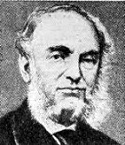
In 1858 Scottish physicist Balfour Stewart (1828-87) pub. the fact that radiation takes place throughout the interior of a radiating body, and that there is a microbalance between radiation and absorption throughout.
On Feb. 2, 1858 Edwin Holmes of Boston, Mass. patents the first practical electric burglar alarm after improving the first patent issued to Augustus Russell Pope on June 21, 1853.
In 1858 the eraser-top pencil is patented by Hyman Lipman of Philadelphia, Penn. - pencil in lip jokes here?
In 1858 Baltimore, Md. mechanic Charles Moncky invents the monkey wrench - just in time to celebrate Darwin?
In 1858 the can opener is patented by Ezra J. Warner of Waterbury, Conn.; it is shaped like a bent bayonet, and is so dangerous that it is operated only by clerks at grocery stores; the first safe can opener is patented in 1870 by William Lyman of West Meriden, Conn.


On Nov. 30, 1858 Am. tinsmith John Landis Mason (1832-1902) of Philly receives U.S. patent #22,186 for an airtight watertight screw-top glass fruit Mason Jar, useful for storing sweetmeats; its use for preserves causes white sugar to replace maple sugar and molasses for home cooking, and causes white sugar usage to double in the U.S. by 1915; he also invents the screw-top salt shaker to make sure that hypertension and diabetes go hand-in-hand?; too bad, his patent expires in 1879, and competitors steal it, and he ends up dying in poverty in a New York City tenement house in 1902.

In 1858 Conn.-born mathematician Elizur Wright (1804-85) reforms life insurance by getting a law passed in Mass. requiring insurance cos. to hold reserve funds based on a formula he discovered, becoming known as "the Father of Life Insurance and Insurance Regulation".

In Aug. 1859 German mathematician Georg Friedrich Bernhard Riemann (1826-66) makes his famous mathematical conjecture known as the Riemann Hypothesis at the Berlin Academy of Science, which is tied with the nature of prime numbers and makes John Nash and a zillion other math geeks spin their wheels all their lives trying to get a $1M prize: "All nontrivial zeroes of the Riemann Zeta Function have real parts equal to 1/2."

On Sept. 1-2, 1859 the Solar (Super) Storm of 1859 (Carrington Event) sees a solar storm induce a geomagnetic solar storm in the Earth's magnetsphere, creating auroras that can be seen from Cuba to Hawaii, so bright that people in the NE U.S. can read their newspapers by its light, and creating an EMP that interferes with telegraphs, but doesn't shut them down; it is all recorded by London, England-born amateur astronomer Richard Christopher Carrington (1826-75), proving the existence of solar flares; in 1863 his observations of sunspots reveal the differential rotation of the Sun.


The Book That Shook the World? Big year for Bible skeptics, secularists, atheistic scientists, anybody against the ancien regime, as Jehovah, the Source of Life Breathed Into Mud is challenged by Godless Evolution, Mud Coming to Life by Itself After It Bubbles Long Enough? The biggest V for the Devil since Eden? The new 95 Theses, but Darwin is smart enough not to publish it on Halloween? On Nov. 24, 1859 (Thur.) English naturalist Charles Robert Darwin (1809-82) pub. On the Origin of Species By Means of Natural Selection, Or, The Preservation of Favoured Races in the Struggle for Life; the 1st ed. sells out in 1 day; the 1872 6th ed. shortens the title to "The Origin of Species"; the decider, which causes evolutionary "survival of the fittest" theory to triumph among the intelligentsia; English Anglican minister and Cambridge U. prof. of modern history Charles Kingsley (1819-75), who received an advance copy on Nov. 18 writes that he had "long since, from watching the crossing of domesticated animals and plants, learnt to disbelieve the dogma of the permanence of the species", which Darwin adds to the next ed. of his book in a modified form: "He had gradually learned to see that it is just as noble a conception of the Deity to believe that He created a few original forms capable of self-development into other and needful forms, as to believe that He required a fresh act of creation to supply the voids caused by the action of His laws"; Darwin pub. it after spending eight years dissecting barnacles in his basement, then inexplicably switching to the Galapagos finch?; catches on first in Germany among atheists?; "If it could be demonstrated that any complex organ existed, which could not possibly have been formed by numerous, successive, slight modifications, my theory would absolutely break down"; Louis Agassiz of the U.S. opposes Darwin, preferring a theory of "Epochs of Creation", based on the absence of missing links between layers of well-formed fossil ecosystems; the phrase "I'll be a monkey's uncle" is coined by Darwin skeptics; "There is a grandeur in this view of life that, whilst this planet has gone cycling on according to the fixed law of gravity, from so simple a beginning endless forms most beautiful and most wonderful have been, and are being, evolved"; what was that about "my theory would absolutely break down" if anything is found that can't be explained by "numerous, successive, slight modifications"?; in practice Darwinism becomes a religion which denies that there is intelligent design in Nature, and therefore tries to deconstruct any evidence of it they find as they go along, yet clings to the notion of common descent, almost as if there was some original, er, accident, and ends up turning into a narrow naturalistic dogma by the end of the 20th cent., taking over U.S. and other Western educational systems with a chilling priesthood? In 1860 after failing to fit it into his Theory of Evolution, Darwin writes the immortal soundbyte: "The sight of a feather in a peacock's tail makes me sick." On Feb. 1, 1871 he writes a Letter to Sir Joseph Dalton Hooker, with the soundbyte: "It is often said that all the conditions for the first production of a living organism are now present, which could ever have been present. But if (and oh! what a big if!) we could conceive in some warm little pond, with all sorts of ammonia and phosphoric salts, light, heat, electricity, &c., present, that a protein compound was chemically formed ready to undergo still more complex changes, at the present day such matter would be instantly absorbed, which would not have been the case before living creatures were found." On Feb. 24, 1871 he pub. The Descent of Man, and Selection in Relation to Sex, which applies his theory of evolution to humans; "The Simidae then branched off into two great stems, the New World and the Old World monkeys; and from the latter at a remote period, Man, the wonder and glory of the universe, proceeded"; "We civilized men... do our utmost to check the process of elimination; we build asylums for the imbecile, the maimed, and the sick; we institute poor laws; and our medical men exert their utmost skill to save the life of everyone to the last moment... Thus the weak members of civilized societies propagate their kind. No one who has attended to the breeding of domestic animals will doubt that this must be highly injurious to the race of man. It is surprising how soon a want of care, or care wrongly directed, leads to the degeneration of a domestic race; but excepting in the case of man himself, hardly anyone is so ignorant as to allow his worst animals to breed"; attempts to scientifically establish white racial supremacy, with the soundbytes: "Western nations of Europe immeasurably surpass their former savage progenitors and stand at the summit of civilization"; "American aborigines, Negroes, and Europeans differ as much from each other in mind as any three races that can be named"; "Looking to future generations, there is no cause to fear that the social instincts will grow weaker, and we may expect that virtuous habits will grow stronger, becoming perhaps fixed by inheritance... [so that] virtue will be triumphant"; "It is the most closely allied forms... which, from having nearly the same structure, constitution, and habits, generally come into the severest competition with each other; consequently, each new variety of species, during the progress of its formation, will generally press hardest on its nearest kindred, and tend to exterminate them"; "This is the book that contains the foundation in natural history for our view" (Marx to Engels); this book is later used by Eugenicists to justify euthanasia of misfits, using soundbytes incl. "We civilized men... do our utmost to check the process of elimination; we build asylums for the imbecile, the maimed, and the sick; we institute poor laws; and our medical men exert their utmost skill to save the life of everyone to the last moment... Thus the weak members of civilized societies propagate their kind. No one who has attended to the breeding of domestic animals will doubt that this must be highly injurious to the race of man. It is surprising how soon a want of care, or care wrongly directed, leads to the degeneration of a domestic race; but excepting in the case of man himself, hardly anyone is so ignorant as to allow his worst animals to breed.... All do good service who aid toward this end."

In 1859 Heidelberg U. profs. Robert Wilhelm Eberhard Bunsen (1811-99) (1855 inventor of the Bunsen Burner) and Gustav Robert Kirchhoff (1824-87) team up and begin experimenting with spectrum analysis after Kirchhoff's Three Laws of Spectroscopy is announced, that if a body absorbs light of a certain wavelength, it emits the same wavelength (thus the dark Fraunhaufer lines in the solar spectrum are caused by elements in the Sun absorbing various wavelengths, and if one can find elements on Earth that give bright emission lines at these same wavelengths, the composition of the Sun can be deduced without having to visit it and vaporize first). In 1860 they discover the elements Cesium (Cs) (#55) (most electropositive element) and Rubidium (Rb) (#37), both of which ignite spontaneously in air, becoming the first time that spectroscopic identification is used to prove the existence of new elements; their book Chemical Analysis by Observation of Spectra causes spectral analysis to become an instant sensation.


In 1859 German physician Albert Niemann (1834-61) of the U. of Gottingen improves the coca purification process and names the alkaloid cocaine, the active agent in the leaves of the coca plant, first isolated in 1855; its molecular formula C17H21NO4 is pub. in 1863 by colleague Wilhelm C. Lossen (1838-1906).
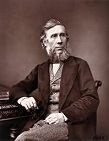
In 1859 Irish physicist John Tyndall (1820-93) discovers that gases incl. water vapor and CO2 can absorb infrared radiation, and suggests that they could be used to bring climate change, AKA the Greenhouse Effect, going further in a lecture on Feb. 7, 1861, claiming that changes in CO2 and H20 in the atmosphere explain all climate changes so far identified by geological research - all ahead full?


On Apr. 19, 1860 the first sound recording is made on a Phonautograph (which records sound visually not aurally), a 10-sec. recording of "Au Clair de la Lune" by 1857 inventor Edouard-Leon Scott de Martinville (1817-79), a Parisian typesetter; in Mar. 2008 Lawrence Berkeley Nat. Lab scientists convert it to sound.
On Sept. 3-5, 1860 the Karlsruhe Congress in Germany of Euro scientists utilizes the results of the work of Stanislao Cannizzaro of Italy to standardize the atomic weight of hydrogen as about 1, helping chemistry leap ahead.


In 1860 Ludwig Boltzmann (1844-1906) of Austria and James Clerk Maxwell (1831-79) of Scotland begin the development of Statistical Mechanics, treating gas as a collection of huge numbers of billiard balls obeying Newton's Laws of Motion. In 1861 Maxwell pub. the paper On Physical Lines of Force in Philosophical Mag., first describing Maxwell's Equations, four partial differential equations which contain a combined theory unifying all partial theories of electricity and magnetism, showing that a magnetic field generates an electric field and vice-versa, forming a pulse which propagates at the speed of light, and that therefore light is an electromagnetic wave, and furthermore that light can only travel at the speed c, and furthermore that the speed of the source of the light doesn't affect it, becoming one of the greatest leaps of thought in history; they are first pub. as a distinct group in 1884 by Oliver Heaviside and Willard Gibbs - the potato salad of physics?

In 1860 Dutch opthalmologist Franciscus Cornelis Donders (1818-89) introduces prismatic and cylindrical lenses for treatment of astigmatism.
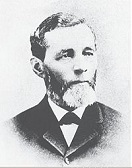

On Oct. 16, 1860 the .44 cal lever-action Henry Repeating Rifle is patented in the U.S. by Benjamin Tyler Henry (1821-98), making the breech-loading rifles look lame, but is slow to be adopted because it is thought to waste expensive ammo, and the first ones are used by the U.S. Army in mid-1862; Oliver Winchester steals the design for the Model 1866 repeating rifle, with an added loading gate on the side and a wooden forearm; too bad, the Sioux and Cheyenne get their hands on some, and use it against Custer at the June 1876 Battle of Little Bighorn.


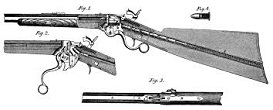
In 1860 Christopher Spencer invents the .56-56 magazine-fed lever-operated Spencer Repeating Rifle, which the U.S. military is slow to adopt despite Pres. Lincoln requesting a personal demo on the White House lawn soon after the Battle of Gettysurg, and ordering Gen. James Wolfe Ripley (1794-1870) to adopt it for production, who stalls, causing him to be replaced as head of the ordnance dept. on Sept. 15, 1863; meanwhile some units purchase the rifles independently, and it proves popular; the fact that his nephew Roswell Sabine Ripley (1823-87) is a brig. gen in the Confed. army has nothing to do with it?

In 1860 "Autocrat of the Breakfast Table" Oliver Wendell Holmes Sr. (1809-84) of the U.S. invents an improved hand-held Skeleton Stereoscope, and donates it to the public domain, with the soundbyte "It is no toy; it is a divine gift, placed in our hands by science"; by 1869 it becomes popular.


In 1860 Samuel Archer King (1828-1914) and William Black take the first aerial photographs, two Photos of Boston, Mass. from a Balloon, which survive to modern times.
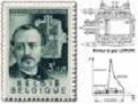



Fat whitey won't have to ride a horse much longer? In 1860 Jean Joseph Etienne Lenoir (1822-1900) of Luxembourg constructs the first practical internal-combustion engine, an 18 liter 1-cylinder 2-stroke mechanism burning coal gas and air and ignited by a "jumping spark" ignition system, producing 2 hp at 4% efficiency; he forms the Gauthier Co. to produce a 3-wheeled automobile, which, although noisy and unreliable causes Scientific American to pronounce the Steam Age at an end; by 1865 he builds 143 of them; meanwhile in 1863 he adds a carburetor; too bad, he fails to keep up with Nikolaus Otto et al. and his design becomes obsolete, and he dies broke. In 1862 German engineer Nikolaus August Otto (1832-91) patents a crude 2-stroke internal combustion gasoline engine with a carburetor based on the 1860 illuminating gas engine of Etienne Lenoir of Belgum; German entrepreneur Eugen Langen (1833-95) partners with him to found NA Otto & Cie, the world's first engine factory; the 1867 Paris World Exhibition awards the engine their grand prize; too bad, the factory goes bankrupt, and Eugen goes on to found the Deutz factory, which later becomes Kloeckner-Humboldt-Deutz (KHD), later renamed Deutz AG.
On Aug. 28, 1860 Hamilton E. Smith of Philly patents (#29830) a hand-cranked Washing Machine with paddles that push the laundry through the water; it takes until 1910 to add an electric motor.
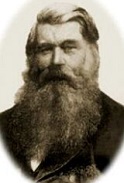
In 1860 English inventor Sir Joseph Wilson Swan (1828-1914) invents the Carbon-Filament Incandescent Lightbulb, but it is defective (partial vacuum only) and he doesn't perfect it until 1878, receiving patent #4933 on Nov. 27, 1880.
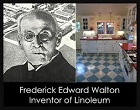
In 1860 English rubber manufacturer Frederick Edward Walton (1834-1928) patents Linoleum, (Lat. "linum" + "oleum" = flax + oil) made of linseed oil, which he calls Kampticon to compete against rival Kamptulicon (patented in 1843), patenting it in 1863; it becomes the first widely-used smooth surface floor covering. In 1877 he invents Lincrusta, a heavily embossed wall covering made from gelled linseed oil and wood flour that becomes popular in royal homes and railway carriages.

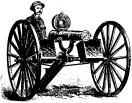
On Apr. 12, 1861-May 9, 1865 the horrific U.S. Civil War sees the invention of the first modern weapon when N.C.-born agricultural equipment maker Richard Jordan Gatling (1818-1903) patents the 10-barrel hand-cranked hundreds-of-rounds-per-min. Gatling Gun (the first practical machine gun) just in time for use on some Johnny Rebs; it is first used by the Union Army in 1864, but luckily never sees extensive use.

In 1861 French neurologist Pierre Paul Broca (1824-80) discovers Broca's Area in the brain, the first to be connected with a specific function, the faculty of speech.

On Mar. 30, 1861 Sir William Crookes (1832-1910) of England (who inherited a fortune in 1856 and set up his own lab in London) uses a spectroscope to discover soft bluish-white metallic element Thallium (Tl) (#81) (Gr. "thallos" = green shoot or twig, from its bright green spectral line) (Thalia = Greek muse of comedy and pastoral poetry) in selenium ore; it is also present in flue dust from the burning of pyrites; it goes on to become a favorite poison of crookes and spies (KGB, etc.), and a good rat poison.

In 1861 Austrian chemist Johann Joseph Loschmidt (1821-95) extends Archibald Scott Couper's idea of using single lines to represent single bonds in organic chemical formulas to using double lines for double bonds, etc. - clarity with no loss of schmidt?

In 1861 German physiologist Karl von Voit (1831-1908) demonstrates that different foods do not provide energy for different body functions, and that proteins break down at the same speed whether or not work is being done. In 1865 he shows that the pathways by which food is converted to energy are complicated, and food is not simply burned to produce energy, but many intermediate reactions take place.

In 1862 Swedish physicist Anders Jonas Angstrom (1814-74) proves that the Sun's atmosphere contains hydrogen. In 1867 he becomes the first to examine the spectrum of the aurora borealis, and detects its characteristic bright line in the yellow-green region, falsely claiming it also shows up in the zodiacal light. In 1868 he pub. Researches on the Solar Spectrum, a monumental work mapping the Solar spectrum, giving the wavelengths of 1K Fraunhofer lines to six significant figures in units of 10**-10 (10E-6) m, which is later named the Angstrom unit.

In 1862 German botanist Julius von Sachs (1832-97) discovers that starch is produced by photosynthesis. In 1865 he discovers that chlorophyll in plants is found only in small bodies (later termed chloroplasts), and that chlorophyll is the key compound in combining carbon dioxide and oxygen to produce starch while releasing more oxygen.


In 1862 Dutch opthalmologist Hermann Snellen (1834-1908) introduces the Snellen Chart to test visual acuity, consisting of 11 lines of "optotypes" (specially-designed letters, using only CDEFLOPTZ; line #8 is for 20/20 vision).
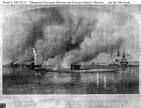



On Mar. 8, 1862 in a Confed. attempt to raise the blockade of the James and Elizabeth Rivers, the Battle of Hampton Roads, Va. sees the rebels' secret veapon, the ironclad ship Merrimack (Merrimac) (renamed Virginia) (first U.S. Navy ship with rotating gun turrets), commanded by Franklin Buchanan (1800-74) (whose portrait bears a striking resemblance to Hollywood actor Dennis Hopper (1936-)?) destroy the Congress and three smaller vessels, then ram and sink the Cumberland, proving the superiority of ironclads over wooden warships; but never fear, during the night the Yankee secret counterweapon, ironclad ship Monitor arrives, and on Mar. 9 the two battlestars. er, ironclads fight the Battle of the Ironclads for 5-6 hours to a draw (or a Union V, depending on who tells it) (blame it on the tides?); the Union Monitor, built by the Rensselaer and Corning Iron Works in Troy, N.Y., owned by John F. Winslow (1810-92) (ancestor of TLW?), and which is used as the pattern for 60 more Union Civil War ironclads founders off the coast of Cape Hatteras on Dec. 31 while being towed; it is located in 1973 at 230 ft., and the 120-ton turret raised in June, 2002.
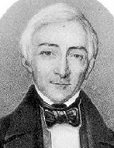
In 1863 German chemists Ferdinand Reich (1799-1882) and Hieonymus Theodor Richter (1824-98) discover the metallic element Indium (In) (#49) using spectroscopy - rich rectal spectroscopy?

In 1863 Scottish chemist Thomas Graham (1805-69) invents a process for separating gases by atmolysis based on Graham's Law of Gas Diffusion (Effusion).
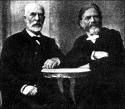
In 1863 Cato Maximilian Guldberg (1836-1902) and Peter Waage (1833-1900) of Norway first describe chemical equilibrium as a dynamic condition where the rates of forward and reverse reactions are equal. In 1864 Waage pub. the Chemical Law of Mass Action - who first published the political one?

In 1863 English chemist John Alexander Reina Newlands (1837-98) (who just returned from fighting for Giuseppe Garibaldi in Italy) pub. the first Periodic Table of the Elements arranged in order of relative atomic masses, leaving open the possibly of undiscovered elements, and predicting the existence of germanium, scooping Dmitri Mendeleyev of Russia, although he is ridiculed.

In 1863 Henry Clifton Sorby (1826-1908) of Sheffield, England discovers the microstructure of steel, founding the science of Metallurgy.
In 1863 German chemist Julius Bernhard Friedrich Adolph Wilbrand (1839-1906) invents TNT (Trinitrotoluene) as a yellow dye; it takes until ? to use it as an explosive; the German army begins using it for artillery shells in 1902, followed by the British in 1907.
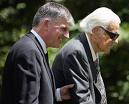
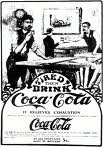
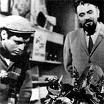
In 1863 Corsican-born Italian chemist Angelo (Ange-Francois) Mariani (1838-1914) develops Vin Mariani, containing Bordeaux wine and cocaine, which becomes a hit with Queen Victoria, Pope Pius X, Thomas Edison, and Pope Leo XIII, who awards it a Vatican gold medal; in 1865 after being wounded in the Battle of Columbus, Ga. in Apr. 1865, Atlanta, Ga. pharmacist John Styth (Stith) Pemberton (1831-81) creates his own version also containing damiana (alleged impotence cure) and kola nut (source of caffeine) called Pemberton's French Wine Coca, which is reformulated in 1885 to take out the alcohol but not the cocaine or caffeine, becoming "the pause that refreshes" Coca-Cola.

On Feb. 20, 1864 Washington, D.C. dentist Mahlon Loomis (1826-86) pub. the earliest description of an Electromagnetic (Radio) Transmission System (Wireless Telegraphy), containing the soundbyte: "A process by which telegraphic communications may be made across the ocean without any wires, and also point to point on the earth, dispensing with wires", demonstrating it in Oct. 1866 between two kites 14 mi. apart in Bear's Dean, Loudoun County; on July 20, 1872 he receives U.S. patent 129,971 ("Improvement in Telegraphing"), making him the inventor of radio? On July 20, 1872 he patents Wireless Telegraphy, U.S. patent 129,971 ("Improvement in Telegraphing"): "What I claim as my invention or discovery, and desire to secure by Letters Patent, is: The utilization of natural electricity from elevated points by connecting the opposite polarity of the celestial and terrestrial bodies of electricity at different points by suitable conductors, and, for telegraphic purposes, relying upon the disturbance produced in the two electro-opposite bodies (of the earth and atmosphere) by an interruption of the continuity of one of the conductors from the electrical body being indicated upon its opposite or corresponding terminus, and thus producing a circuit or communication between the two without an artificial battery or the further use of wires or cables to connect the co-operating stations"; too bad, he never builds any apparatus, and his claim is jumped by William Henry Ward, who receives a patent on Apr. 30; in Jan. 1872 the U.S. Congress hears Loomis' plea to charter the Loomis Aerial Telegraph Co. and turns him down.

In 1864 George Mortimer Pullman (1831-97) of the U.S. invents the Railroad Sleeping Car - a Pullman Sleeping Car, almost as good as Boyle's Law and Hooke's Law for perfect surname to go with invention? When he dies, he is entombed in a room-sized block of concrete to prevent angry railroad workers from getting to him.
In 1864 Maine-borne shoemaker Benjamin Franklin Sturtevant (1833-90) invents the first commercially-successful rotary exhaust fan, patenting it in 1867, building the world's largest manufacturing plant in Jamaica Plain, Mass. in 1878, with 400 workers; after he dies his son-in-law Eugene Noble Foss takes over the business, moving it to Hyde Park, N.Y. around 1900 then resigning to become gov. of Mass. in 1910-13, with the plant going on to manufacture Am. Napier automobiles in 1904-9 and military aircraft in 1915-18 before being purchased by Westinghouse in 1945.

In 1865 Sir William Huggins (1824-1910) of England demonstrates spectroscopically that light from the Andromeda Galaxy (M31) comes from stars and not from gas clouds, although other nebulae produce light that is characteristic of glowing gases. In 1868 he calculates the radial velocity of the star Sirius from its slight red spectral shift.

In 1865 after reading Louis Pasteur's 1861 paper and creating a sprayer to create a mist of carbolic acid (phenol), English surgeon Sir Joseph Lister (1827-1912) performs the first antiseptic surgery in Glasgow during the treatment of a compound fracture; in 1867 he pub. On the Antiseptic Principle in the Practice of Surgery; his method goes on to reduce the surgical death rate from 45% to 15%; too bad, it's too late for U.S. Civil War use.





In 1865 Austrian Augustinian monk (abbot) Gregor Johann Mendel (1822-84) pub. Mendel's Laws of Heredity ("In any given pair of contrasting traits, one trait is dominant and the other recessive" et al.), establishing the principle of basic units called genes, based on laborious experiments begun in 1857 on peas in the monastery garden in Brunn, incl. the principles of unit characters, dominance and recessiveness, segregation, and free assortment; pub. in the obscure Transactions of the Brunn Nat. History Society, they go almost unnoticed by biologists until 1900; meanwhile Charles Victor Naudin (1815-99) of France finds certain regularities in the inheritance of characteristics in plant hybridization experiments, but misses the big picture - and then it's McDonald's McGriddles, breakfast snack for you, bedtime snack for me? It's a breeze to correct the botanists who laid an egg? Skipping ahead, in 1900 European botanists Hugo Marie De Vries (1848-1935) of Holland, Karl (Carl) Erich Correns (1864-1933) of Germany, and Erich Tschermak von Seysenegg (von Tschermak-Seysenegg) (1871-1962) of Austria discover and confirm Mendel's 1865 research reports concerning pea plants and how inherited traits are determined by two "hereditary units", leading them to connect the new chromosomes discovered this year in cell nuclei to his work; English botanist William Bateson (1861-1926) becomes the main popularizer, coining the term "genetics" in 1905; Erich's brother Armin Eduard Gustav Tschermak von Sysenegg (1870-1952) also contributed, but didn't take credit? - this morning my hair was straight, then Greg called?

In 1865 Belgian scientist Jean Servais Stas (1813-91) produces the first modern table of atomic weights, using oxygen as the index (set at 16), and shows conclusively that atomic weights are not always integral.


In 1865 Prussian-born German mathematician Karl Weierstrass (1815-97) proves the Bolzano-Weierstrass Theorem, that every bounded infinite set of points in a Euclidean space has at least one accumulation point, for which every neighborhood of that point contains a point in the set; it was proved earlier by Austrian Roman Catholic priest-mathematician Bernhard (Bernardus Placidus Johann Nepomuk) Bolzano (1781-1848), so they share credit; the theorem becomes the basis of the modern theory underlying mathematical limits, the unyummiest subject for college math students.

In 1865 Irish historian William Edward Hartpole Lecky (1838-1903) pub. A History of the Rise and Influence of Rationalism in Europe, describing the fall of Church-think to the onslaught of Science; makes it sound like Science is the way out of all our problems?


See why everyone is talking about Veronica Bismars and Needle Dick? On Apr. 8, 1866 Prussian PM (since 1862) Otto von Bismarck (1815-98) allies Prussia with Italy, then on June 9 sends Prussian troops from Schlesweg into Holstein to drive Austria out and annex it, starting the Seven Weeks' War between Prussia and Italy against Austria when Austria chickens out and withdraws its forces from Holstein without a battle, Bismarck waits for it to make a mistake, and on June 14 the Diet of Frankfurt passes a Bavarian motion to mobilize all non-Prussian and non-Austrian forces, causing Bismarck to declare the Federal Act violated and start a war with the South German states, quickly winning, then along with Italy declaring war on Austria; on June 15 the Prussians defeat Hanover at the Battle of Bad Langensalza; on June 24 the Italians under Gen. Enrico Calidini are defeated at the Battle of Custozza; Austria, thinking it can kick Prussia's butt easily, makes a secret treaty with France to sit it out; too bad, the Prussians under Gen. Helmuth von Moltke surprise the Austrians with secret veapons, viz. the use of railroads for rapid troop deployment, the use of breech-loading Needle Guns which can fire 4x as fast as the Austrian muzzle-loaders, and pre-measured mobile bridges in case the Austrians destroy the real ones, and on July 3 they win a decisive V at the 450K-man Battle of Koniggratz (Sadowa) (in NW Czech. near modern-day Hradec Kralove) despite massed steel-rifled cannon barrage fire, ending the effectiveness of cavalry regiments and presaging the fun to come in WWI; "The needle gun is king" (London Times).

In 1866 non-Jewish Swedish chemist Alfred Nobel (1833-96) discovers dy-no-mite Dynamite, which he calls "Improved Explosive Compound", uttering the immortal soundbyte: "I should like to invent a substance or machine with such terrible power of mass destruction that war would thereby be made impossible forever"; he receives a patent on Nov. 25, 1867, insuring vast riches as his prediction proves to work out the opposite, and in 1888 after reading his obituary he decides to create the Nobel Prizes in his will - sorry, you can't take it with you to Hell?

In 1866 German inventor Ernst Werner von Siemens (1816-92), brother of Sir Charles William Siemens (1823-83) and Carl Heinrich von Siemens (1829-1906) invents the Electric Dynamo, which uses electromagnets instead of permanent magnets, causing the Siemens Co. (founded 1847) to grow into a giant.

In 1866 English engineer Robert Whitehead (1823-1905) invents the self-propelled Underwater Torpedo - combined with dynamite, this will make war possible for a long time to come?
In 1866 the breech-loaded rifle is developed in the U.S., England, France, and Germany, replacing the muzzle-loaded rifle developed ca. 1475.



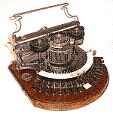
In 1867 Mooresburg, Penn.-born inventor Christopher Latham Sholes (1819-90) of Milwaukee, Wisc. invents the modern Sholes Typewriter ("Type-Writer"), and receives a patent on June 23, 1868; too bad, it prints on the reverse side of the paper; he also devises the infamous QWERTY keyboard arrangement in 1874, and adds upper and lower case letters in 1878. In 1873 the gunmaking firm of E. Remington & Sons (founddd 1816) begins to produce Sholes and Glidden typewriters using the QWERTY keyboard arrangement of Christopher Sholes; they still print on the reverse side of the paper. In 1880 Am. journalist James Bartlett Hammond (1839-1913) of Vt. patents one of the first typewriters constructed on scientific principles with a typewheel and true alignment, and begins marketing it in 1884, making a fortune. In 1893 the Underwood No. 1 Typewriter goes on sale, featuring visible typing on the front side of the paper, plus an accelerating sublever for faster speed, taking the market from Remington; it still uses the QWERTY keyboard arrangement.

On Oct. 11, 1868 Thomas Alva Edison (1847-1931) applies for his first little patty pat patent, an Electrical Vote Recorder, then quits Western Union next year to go full-time in the inventing biz.
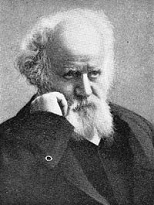


In 1868 after an eclipse, French astronomer Pierre Jules Cesar (César) Janssen (1824-1907), along with English chemist Sir Edward Frankland (1825-99) and English astronomer Sir Joseph Norman Lockyer (1836-1920) of England discover a new element in the Sun's chromosphere which they call Helium (He) (#2); it takes until 1895 for Sir William Ramsay to prove that it exists on Earth.

In 1868 English naval engineer William Froude (1810-79) pub. the definition of the Froude Number (ratio of inertial force on a fluid element to its weight), a kind of Mach number for ships that allows model ships to be used in hull design tests.
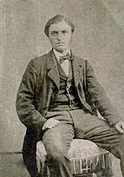
In 1868 the first remains of the Cro-Magnons are discovered in Les Eyzies, Dordogne, France by French paleontologist Louis Lartet (1840-99), declaring them the first homo sapiens in Europe, and the successor of Neanderthal man, living about -45K; later the term European Early Modern Humans is preferred.

In 1868 Detroit, Mich. meatpacker George Henry Hammond (1838-86) patents a refrigerator car that suspends beef carcasses above an ice-salt mixture, building sales to $2M by 1875, and causing the town of Hammond, Ind. to be named after him before moving to Omaha, Neb. and building up to 800 cars; too bad, the carcasses swing when going around curves, causing derailment.



On Nov. 28, 1868 French inventor Louis Arthur Ducos du Hauron (1837-1920) patents color photography; in 1872 he takes the color photo Landscape of Southern France (Angouleme) using the subractive method (yellow-cyan-magenta); meanwhile on May 7, 1869 French poet Charles Cros (1842-88) pub. Solution Generale du Probleme de la Photographie des Couleurs, an independent invention of color photography; in 1877 he invents Paleophone, which reproduces recorded sound using photoengraving, beating Thomas Edison to the punch but failing to build a working model.
In 1868 the first traffic signal is installed outside the Houses of Parliament in London, consisting of two semaphore arms plus red-green gas lamps for night use; too bad, it soon blows up, killing a bobby.
In 1868 George F. Green of the U.S. devises a pneumatic Dental Drill, followed by an electric drill in 1874, which he patents Jan. 26, 1875.
On Mar. 5, 1868 Charles Henry Gould patents the Stapler - 3-5-68, staple that in your 7 golden memories?
In 1868 John K. Mayo invents Plywood - sounds like a termite sandwich?


In 1868 Edmund McIlhenny (1815-90), who moved in with his in-laws on their ruined plantation on Avery Island, La. (known for its salt mines) after the U.S. Civil War and began planting C Am. peppers begins making Tabasco brand pepper sauce, obtaining a patent in 1870.
In 1868 Ernest Sylvain of France patents the Eolienne Bollee (Éolienne Bollée), a wind turbine with a stator and rotor like a water turbine.


On Mar. 1, 1869 (Feb. 17 Old Style) Russian chemist Dmitri Ivanovich Mendeleyev (Mendeleev) (1834-1907) pub. the Periodic Law and the Periodic Table of the Elements, which future chemistry students are face-forked with, boldly making room for the missing element gallium; its appearance is influenced by the new game of Solitaire? - so, village atheist, if everything happened by chance, and there is no intelligent designer, why is there a mathematical code behind matter itself? In 1871 Mendeleyev pub. The Periodic Regularities of the Chemical Elements, which boldly predicts that some accepted atomic weights are grossly in error, and other elements yet to be discovered will plug up gaps in his Periodic Table. Which chemical element is named for a cock? In 1875 using zinc blende from the Pyrenees, French chemist Paul-Emile (Francois) Lecoq de Boisbaudran (1838-1912) discovers the metallic element Gallium (#31) (Ga), which resembles aluminum but can be cut with a knife (melting point 30.15 deg C), right where Mendelyeev had predicted an element with these properties would be found in a gap in the Periodic Table; he suggests the name "eka aluminum" for it, but the name gallium is chosen as a pun on the Latin word gallus (cock).
On Nov. 4, 1869 Thomas Henry Huxley and Joseph Lockyer begin pub. Nature mag. in England, going on to become the world's most cited scientific journal by the 21st cent.

In 1869 Russian chemist Vladimir Vasilyevich Markovnikov (Markownikoff) (1838-1904) develops the "rich get richer, poor get poorer" Markovnikov's (Markownikoff's) Rule, which states that in reactions of alkenes (olefins) (molecules containing a carbon-carbon double bond) and vinyl halides (H-X), the nucleophilic halide X group tends to attach to the carbon atom in the double bond with the fewest hydrogen atoms bonded to it, while the acidic proton H tends to attach to the carbon atom in the double bond with the most hydrogen atoms attached to it, e.g., CH3-CH=CH2 + HBr -> CH3CBrHCH3, because the left C has 1 H and the right C has 2 Hs (the CH3 is irrelevant); the rule extends to reactions of an alkene with an alcohol, with the hydroxyl (OH) group bonding to the C in the double bond with the greatest number of C-C bonds, and the H bonding to the C at the other end of the double bond.

In 1869 German physicist Ernst Karl Abbe (1840-1905) invents the Refractometer for determining the relative refractive index of substances.
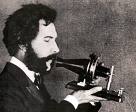
In 1869 Belgian engineer Zenobe Theophile (Zénobe Théophile) Gramme (1826-1901) invents the Gramme Machine, a DC dynamo capable of generating smoother and higher voltages; in 1873 he accidentally discovers that it spins when connected to a DC power supply,creating the first electric motor powerful enough for industrial use. In 1879 he and Hippolyte Fontaine invent the Electric Alternator.

In 1869 John Wesley Hyatt (1837-1920) of N.Y. (1865 inventor of the Parkesine Composition Billiard Ball) patents a process for mass-producing celluloid, which becomes the first industrial plastic.

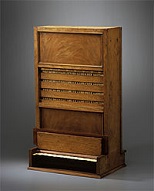
In 1869 English economist William Stanley Jevons (1835-82) invents the Logic Piano, a mechanical computer.

In 1869 Margaret E. Knight (1838-1914) of Springfield, Mass. invents the machinery to produce the Flat-Bottomed Paper Bag, which becomes a commercial phenomenon, although she receives so little compensation that her estate is valued at $275.05 at her death. On June 12, 1883 Charles Stilwell of Fremont, Ohio patents a machine to mass-produce brown paper bags with square bottoms and pleated sides called "S.O.S." (self-opening sacks); by 2000 40B are used in the U.S. each year.
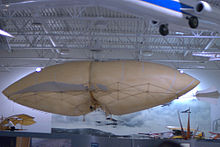
On July 2, 1869 after founding the Aerial Steam Navigation co. in 1866, English-born Am. inventor Frederick Marriott (1805-84) conducts a public test of his flying machine The Flying (Hermes) Avitor Jr., becoming the first powered flight of a heavier-than-air craft on the Am. side of the Atlantic, inventing the term "aeroplane", intending to build an airline to shuttle passengers between New York City and Calif. until the stock market crashes on Sept. 24, 1869.
On June 8, 1869 Ives W. McGaffey of Chicago, Ill. patents the Manually-Powered Vacuum Cleaner ("sweeping machine").

In 1869 French chemist Hippolyte Mege-Mouries (Mège-Mouriés) (1817-80) invents Oleomargarine (Margarine) to win a prize offered by emperor Louis III Napoleon.
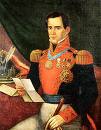
In 1869 exiled ex-Mexican pres. (1833-55) Antonio Lopez de Santa Anna (1794-1876) of Alamo fame introduces Chicle Chewing Gum (an old Aztec favorite) to Yankee Thomas Adams of Staten Island, N.Y., who puts it on sale in drug stores in Feb. 1871 for 1 cent apiece; in 1889 he forms the Am. Chicle Co., and by 1929 it has $60M sales, and $140M in 1942; too bad, chicleros begin adulterating their product, causing artificial chicle to replace it by the 1960s.
In 1869 Am. Baptist minister Jonathan Scobie allegedly invents the Rickshaw in Yokohama, Japan to transport his invalid wife through the city streets.

On Feb. 2, 1870 the Cardiff Giant, discovered in Cardiff, N.Y. on Oct. 16, 1869 and believed by experts to be a petrified human is revealed to a carved gypsum hoaxy hoax ha ha ha hoax, carved in 1868 from gypsum beds in Ft. Dodge, Iowa on the Des Moines River by tobacconist George Hull, an atheist who got into an argument with a Bible-thumper over Gen. 6:4 ("There were giants in the Earth in those days"); he invests $2.6K to make it and gets $37.5K from Syracuse businessmen to exhibit it.

In 1870 French surgeon Alphonse Guerin (Guérin) (1816-95) introduces the practice of using cotton-wool (cotton wadding) bandages for the prevention of wound infections.
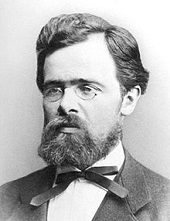
In 1870 German engineer Carl Paul Gottfried von Linde (1842-1934) invents the first commercially viable refrigeration equipment, completing the first working model of an ammonia cold machine in 1873 before founding a co. in 1878, patenting it on June 1, 1880, and selling 747 machines by 1890, helping the growth of the beermaking, meatpacking and other industries, shifting drinking patterns away from whiskey and filling cities with saloons, pissing-off temperance activists; the first Linde ice machine is installed in 1875 in the Spaten Brewery in Munich, Germany; the first Linde ice machine imported to the U.S. is purchased in Switzerland in 1885 by Schlitz Brewing Co.
In 1870 William Lyman of West Meriden, Conn. patents the first safe can opener - thank you for nothing says how many thousand severed fingers?

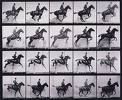
In 1872 the first time-sequence photography of a horse in motion is made by English-born Am. landscape photographer Eadweard James Muybridge (1830-1904) using his zoopraxiscope to win a $25K bet over whether all four hooves ever leave the ground at the same time (yes); he only comes up with a single still shot this year, but shoots a galloping sequence by 1878.

In 1871 St. Petersburg, Russia-born German mathematician Georg Ferdinand Ludwig Philipp Cantor (1845-1918) founds the Theory of Point Sets, then next year becomes a prof. at the U. of Halle, going on to develop the Theory of Transfinite Numbers, which are larger than all finite numbers, but not necessarily absolutely infinite. In 1873 he proves that the rational numbers are countable (can be put into 1-1 correspondence with the natural numbers), and that the real numbers are not - that would make them unreal, or does real mean not natural? In 1878 he proposes the Continuum Hypothesis, that there is no set whose cardinality is strictly between that of the integers and that of the real numbers, which his teacher Leopold Kronecker vehemently opposes, causing him to spend the rest of his life vainly trying to prove it, driving him insane. On Jan. 6, 1918 German "funky infinities" mathematician Georg Cantor (b. 1845) dies in a sanatorium after going mad trying to prove his 1878 Continuum Hypothesis; in 1940 Kurt Godel proves that it can't be disproven using the axioms of Zermelo-Fraenkel Set Theory, and in 1963 Paul Cohen proves that it can't be proven.
In 1870 William Lyman of West Meriden, Conn. patents the first safe can opener - thank you for nothing says how many thousand severed fingers?

In 1870 Am. architect William Robert Ware (1832-1915) invents the Instant-Running Voting System, which is adopted in several English-speaking countries.
in 1870 the Middling Purifier, with a roller processor to separate bran from flour is invented in Minneapolis, Minn., producing superior flour.
In 1870 the Navel Orange is developed in Riverside, Calif. from a pair of Brazilian saplings.
In the 1870s steel blades are developed for windmills in the U.S., increasing their efficiency; between 1850 and 1970 over 6M windmill machines are installed in the U.S. Baked porcelain inlays come into use for filling large cavities.
In 1871 the first Electronic (Telegraph) Money Transfers become available from Western Union.

In 1871 Simon Ingersoll (1818-94) of the U.S. invents the Pneumatic Rock Drill; in 1905 his Ingersoll Rock Drill Co. merges with the Rand Drill Co. to form Ingersoll-Rand - finally immigrant Chinese have something to do besides cook and wash and hook?

In 1871 Francis Herbert Wenham (1824-1908) of the U.S. invents the Wind Tunnel.

In 1872 German-Austrian surgeon Christian Albert Theodor Billroth (1829-94) makes the first Resection of the Esophagus. In 1874 he discovers Streptococci and Staphylococci.

In 1872 Richard Dedekind (1831-1916) rigorously defines irrational numbers arithmetically via the Dedekind Cut, a downward closed set without a greatest element, i.e., (-infinity, b) and [b, +infinity) - sounds like the coup de grace?
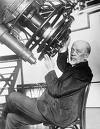

In 1872 Am. astronomer Asaph Hall (1829-2907) pub. an article on the experimental determination of pi by throwing a fine steel wire randomly onto a plane surface ruled with equidistant parallel lines, with pi being equal to 2 * (l/d) * (n/i), where l = length of wire, d = distance between lines, n = # of trials, and i = # of intersections. On Aug. 12, 1877 while not throwing steel wires onto a wooden plane, Am. astronomer Asaph Hall (1829-2907) discovers Mars' moons Deimos (Mars II) (smaller and farther, rises in the E and sets in the W), followed on Aug. 17 Phobos (Mars I) (larger and closer, rises in the W and sets in the E) (closest moon to its primary in the Solar System), with English chemist Henry George Madan (1838-1901) suggesting the names after Book 15, Line 119 of Homer's Iliad, where Ares (Mars) summons Dread (Deimos) and Fear (Phobos); Madan's grand-niece Venetia Phair (nee Burney) later names Pluto in 1930; meanwhile Italian astronomer Giovanni Virginio Schiaparelli (1835-1910) first observes the canals (canali) of Mars, sparking the public's imagination. In 1889 Schiaparelli discovers the synchronous rotations of planets Mercury and Venus.


In 1872 German astrophysicist Johann Karl Friedrich Zollner (1834-82) pub. a paper criticizing the Panspermia (Lithopanspermia) Theory of William Thompson, Lord Kelvin on the grounds that it begs the question of where life came from in the first place, plus apostrophe, apostrophe, meteors don't seem to be a good way for life to come in through the atmosphere considering the little problem of high temp thermal entry? In 1874 he pub. a paper showing that Mercury's low albedo means that it has no atmosphere, hence no life.



In 1872 Am. mechanical engineer George Brayton (1830-92) of R.I. patents a 2-cylinder 2-stroke kerosone stationary engine that he calls Brayton's Ready Motor, which becomes the first safe and practical oil engine; he displays it at the 1876 Philadelphia Centennial Exposition; too bad, the 1876 Otto Engine becomes more popular. On May 8, 1879 George B. Selden (1846-1922) files the first U.S. automobile patent, based on the Brayton Engine of 1872; too bad, his filing of amendments delays things, and it's not granted until 1895.

In 1872 Am. horticulturist Luther Burbank (1849-1926) of Lunenberg, Mass. perfects the Burbank Potato, followed by over 800 strains of improved fruits, vegetables, and flowers, incl. the Freestone Peach, edible thornless Opuntia Cactus, and Plumcot (plum-apricot); in 1875 he moves to Santa Rosa, Calif., raising over 1M plants a year for his experiments; too bad he goes for the Lamarckian Theory of the Inheritance of Acquired Characteristics? - the womb as its own tiny emergency room?

In 1872 Am. inventor Thomas Alva Edison (1847-1931) perfects the 2-way Duplex Telegraph, originally invented in 1853 by Julius Wilhelm Gintl, that sends two messages simultaneously over the same wire. In 1875 he invents the Mimeograph.
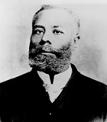
In 1872 African-Canadian inventor Elijah J. McCoy (1843-1929) receives U.S. Patent #129,843 on July 23 for an automatic lubricator for steam engines, which comes to be known as the "Real McCoy".
In 1872 English clergyman Charles Meade Ramus (1822-) invents the Hydroplane.
On Oct. 20, 1872 Am. physician William Robinson invents the Electric Closed Track Circuit for Railroads.

On Mar. 5, 1872 Am. engineer George Westinghouse Jr. (1846-1916) patents the failsafe Automatic Railroad Air Brake.
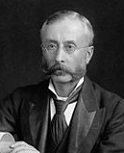
In 1873 Scottish neurologist Sir David Ferrier (1843-1928) begins experimenting with electrical stimulation of the cerebral cortex of animals, discovering a map for motor functions.
In 1873 G.A. Hansen of Norway discovers the leprosy (Hansen's Disease) bacillus Mycobacterium leprae.

In 1873 Dutch physicist Johannes van der Waals (1837-1923) pub. the Van der Waals Equation of State for imperfect gases.

In 1873 French mathematician Charles Hermite (1822-1901) proves that e is transcendental, i.e., not a root of any algebraic equation with rational coefficients.

In 1873 French statistician Alphonse Bertillon (1853-1914) invents the Bertillon System for scientific ID of criminals using anthropometric measurements and personal characteristics: body (standing/sitting height, reach), head (length and width of head and right ear), and limbs (length of left foot, left middle finger, left little finger, left forearm); the U.S. begins using it in 1887; fingerprinting later supersedes it.

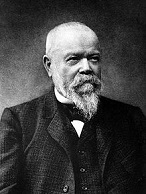
In 1873 Belgian engineer Zenobe Theophile (Zénobe Théophile) Gramme (1826-1901) and Hippolyte (Francois-Hypolite) Fontaine (1833-1910) invent the Gramme Machine, becoming the first commercially useful electric motor, utilizing a ring armature with multiple overlapped coils and multiple commutator contacts; after Fontaine accidentally discovers that the motor is reversible, the first Electric Alternator is created, transmitting electricity 2 km via copper wires.

On Apr. 29, 1873 former Confed. army maj. Eli Hamilton Janney (1831-1912) patents the Janney Knuckle Coupler (U.S. Patent #138,405) for railroad cars, becoming the 2nd most important safety invention for railroads after the Westinghouse Air Brake.

In 1873 Thaddeus Sobieski Constantine Lowe (1832-1913) of the U.S. invents the Water Gas Process, which creates large amounts of hydrogen gas for clean heating by passing steam over hot coal.

In 1873 English-born pharmacist Charles Henry Phillips (1820-82) of Stamford, Conn. patents Phillips' Milk of Magnesia (magnesium hydroxide), and begins marketing it in blue bottles in 1880 (until 1976), becoming the first commercial liquid laxative; "Take MOM in the PM for BM (bowel movement) in the AM"; good antacid too, if you don't mind the side effects?

In 1873 modern riveted denim jeans are patented by Levi Strauss (1829-1902), a German Jew who immigrated to the U.S. in 1847 during the Calif. Gold Rush; denim and indigo originally came from India; he hates the word "jeans" and his co. doesn't use it until 58 years after his death?
In 1873 Robert William Thomson (1822-73) patents the wire-spring mattress, invented on his deathbed - which wasn't well-sprung?

In 1873 the Winchester Model 73 repeating rifle begins production, becoming known as "the Gun that Won the American West".

In 1874 Fulton County, Penn.-born meteorologist William Ferrel (1817-91) pub. Tidal Researches, which explains his tide prediction machine that works on the principle of harmonic motion. In 1877 he pub. Meteorological Researches, which states Ferrel's Law, that moving objects are deflected to the right in the N hemisphere and left in the S hemisphere, explaining cyclones and anticyclones and Foucault's Pendulum.

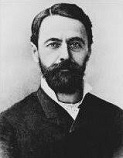
In 1874 Dutch physical chemist Jacobus Henricus van't Hoff (1852-1911) and French physical chemist Joseph Achille Le Bel (1847-1930) independently suggest that the four bonds in most carbon compounds are directed toward the corners of a tetrahedron, thus founding the study of Stereochemistry, and winning van't Hoff the first-ever Nobel Chem. Prize in 1901.

In 1874 German physicist Friedrich Wilhelm Georg Kohlrausch (1840-1910) demonstrates that an electrolyte has a definite constant value of electrical resistance, and goes on to to verify the independent migration of ions.

In 1874 Irish physicist George Johnstone Stoney (1826-1911) of the Nat. U of Ireland coins the word "electron"; actually he named it "electrine", and changed it in 1891 - don't ask why a Gaelic wants to use Greek?

In 1874 Othmar Zeidler (1859-1911) of the U. of Strasbourg first prepares DDT, but doesn't suspect its insecticidal qualities; it takes until 1939.
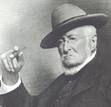
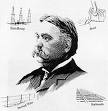
Devil's Rope cuts the Am. Great Plains into a danger-filled maze? In 1874 Joseph Farwell Glidden (1813-1906) of De Kalb, Ill. (who grew up on a farm in N.Y.) modifies the patented barbed wire design of Henry M. Rose (a strip of wood with spikes attached to a plain wire fence) with a new way to hold the barbs in place using two twisted wire strands, creating The Winner, and in 1874 he and merchant Isaac L. Ellwood form the Barb Fence Co., becoming the first barbed wire manufacturer, with five tons produced the first year, and, after hiring salesmen Henry B. Sanborn (relative of Glidden) and John Warne "Bet-a-Million" Gates (1855-1911) sales take off, producing 1.5K tons in 1876 and 25K tons in 1879, causing the Great Plains (which lack rocks and trees) to be fenced in, and prices to fall from 20 cents to 2 cents per lb. by 1893; Glidden never visits the West to see how his Devil's Rope causes severe injuries to cattle, screwworm infestation et al.?
In 1874 A.K. Shriver of Baltimore, Md. patents the Pressure Cooker (Retort) for food canning; it doesn't come into gen. use until 1935.

In 1874 John William Draper (1811-82) pub. History of the Conflict Between Religion and Science, which becomes a big hit with Rationalists.

In 1875 Am. chemist-physicist ("Founder of Chemical Thermodynamics") Josiah Willard Gibbs (1839-1903) of Yale U. pub. the Gibbs Phase Rule, applicable to the phases of water, carbon dioxide, etc.: f = c - p + 2, i.e., number of degrees of freedom (number of intensive state variables that can be independently varied without changing the number of phases) equals the number of components - number of phases + 2; thus, for a 1-component system, f = 3 - p, and if there is just one phase in equilibrium it takes a 2-dim. graph to describe it (P vs. T, P vs. V), if there are two it takes a 1-dim. "tie line", and for three phases in equilibrium there is a 0-dim. "critical point".


In 1876 the English analytical philosophy journal Mind is founded by Scottish philosopher Alexander Bain (1818-1903), ed. by his student, Scottish philosopher George Croom Robertson (1842-92) (until 1892), taking on the problem of whether psychology should be classified as a science.


On Mar. 7, 1876 after a physician friend donates a human ear, which he experiments on in summer 1874, Scottish-born Alexander Graham Bell (1847-1922) receives a patent in Boston, Mass. for the articulating telephone ("visible speech"); on Mar. 10 the first successful voice transmission over Bell's telephone takes place in Boston, Mass. as Bell spills acid on his clothes and tells his assistant, "Mr. Watson, come here! I want you!"; music is later sent down the line - soon lazy American white people can visit without getting up off their white lardasses, becoming their jealously-guarded lifestyle? In 1873 Elisha Gray (1835-1901) of Chicago, Ill. invents a telephone that works over short distances, and loses out on patenting the telephone by hours to Alexander Graham Bell, then loses a U.S. Supreme Court case over it, but goes on to build up the Western Electric Co., founded in 1872 with Western Union backing; in 2007 Seth Shulman pub. The Telephone Gambit: Chasing Alexander Graham Bell's Secret, which claims that Bell secretly copied part of Gray's invention, and that the patent office goofed up - every great fortune is built upon a great crime? In 1880 Bell discovers that solids can emit sounds when exposed to sunlight, infrared, or ultraviolet radiation. In 1885 Bell experiments with his phonographic equipment, leaving the oldest known recording of his voice.

In 1876 German physician Heinrich Hermann Robert Koch (1843-1910) (pr. coke) of Wollstein isolates the bacterium causing cattle disease anthrax, validating the germ theory of disease and spurring searches for new agents responsible for TB, cholera, etc. In 1877 he develops the Koch Technique for staining and identifying bacteria - he does it by hand? In 1882 after become a prof. at the Berlin School of Medicine, he isolates the tuberculosis (TB) bacillus. In 1883 he pub. a method for preventive inoculation against anthrax, and identifies the comma bacillus as the cause of cholera while on an official mission to Egypt and India.

In 1876 German physiologist Wilhelm Friedrich Kuhne (1837-1900) coins the word "enzymes" (from Gr. "in yeast") for soluble ferments made from cell extracts, as opposed to catalytic substances in intact cells, which should still be called ferments.
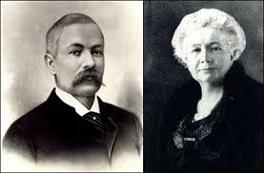
In 1876 Am. china shop owner Melville Reuben Bissell (1843-89) of Grand Rapids, Mich. invents the Bissell Carpet Sweeper to help his wife Anna get rid of the dusty straw her china comes packed in.
In 1876 George R. Carey (1851-1906) of Boston, Mass. proposes a television system using a selenium photocell array based on an 1873 discovery by Willoughby Smith.
In 1876 the toothpaste tube is introduced by Dr. Washington Wentworth Sheffield, who allegedly invented toothpaste in 1850.


In 1876 Nikolaus August Otto (1832-91) and Eugen Langen (1833-95) of Germany invent the gasoline-powered 4-stroke Otto Engine, the first internal combustion engine to efficiently burn fuel in a piston chamber; meanwhile fellow German Gottlieb Daimler invents the surface-type carburetor.

In 1876 Irish engineer James Thomson (1822-92), brother of Lord Kelvin invents the Analog Differential Analyzer for solving differential equations.


On Dec. 22, 1877 French physicist Louis-Paul Cailletet (1832-1913) and Swiss physicist Raoul Pictet (1846-1929) simultaneously send telegrams to the Academy of Science in Paris announcing their invention of machines for liquefying oxygen; Picet goes on to liquefy nitrogen and demonstrate that radiation from a cold object cannot heat a warmer object - picture their yipee-yo-cay-yay?
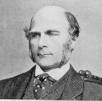
In 1877 Sir Francis Galton (1822-1911) of England (Charles Darwin's half-cousin) invents Statistical Regression; he also invents eugenics, fingerprinting, the weather map, and the silent dog whistle - sounds like's he's ready to tag and bag them inferior darkies from Darkest Africa?
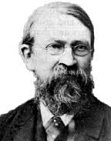
In 1877 Austrian (Moravian) physicist Ernst Waldfried Josef Wenzel Mach (1838-1916) pub. a paper announcing Mach Numbers, the ratio of flow velocity past a boundary to the local speed of sound.


In 1877-9 German bacteriologist Julius Richard Petri (1852-1921) becomes asst. to Robert Koch in Berlin, inventing the Petri Dish; actually, he only was the first to pub. it in 1887?



In 1877 the first Phonograph, along with a (carbon) microphone and audible sound recording are made by hard-of-hearing Am. inventor Thomas Alva Edison (1847-1931), a snippet of a Handel oratorio recorded on a wax cylinder; too bad, on Apr. 30 French poet-inventor Charles Cros (1842-88) submits a letter to the Academy of Science in Paris describing his invention of the phonograph, but Edison beats him to a working model, and receives a patent on Feb. 19, 1878. On Oct. 21, 1879 Edison invents the Electric Incandescent Light (light bulb), then gets it patented in the U.S. on Jan. 27, 1880, and tries to take all the credit, even though British inventor Sir Joseph Wilson Swan (1828-1914) already patented it in Britain in 1878, and he was knowingly copying it; he privately demonstrates it in Menlo Park, N.J. on Dec. 20, then publicly demonstrates it there on Dec. 31, scoring two firsts by putting on the first public display of Christmas lighting so that people coming on the nearby railroad tracks will get a thrill; he doesn't think to put them on a Christmas tree; in 1883 Edison and Swan set up a joint Edison & Swan United Electric Light Co. to sell lamps made with Swan's cellulose filament, which he invents in 1881, while the Edison Co. continues to use inferior bamboo filaments until it merges with Gen. Electric in 1892. In 1882 the first Electric Cristmas Tree Lights are invented by Edward H. Johnson, vice-pres. of the Edison General Electric Co.: 80 red, white, and blue lights made and wired by hand. In 1901 the General Electric Co. begins selling prewired "Christmas tree lamps" to the public (nine white bulbs per string) at a cost of an avg. person's weekly wages; it takes until the 1920s for holiday lights to become affordable to the gen. public.


In 1877 Louis-Paul Cailletet (1832-1913) of France and Raoul Pictet (1846-1929) of Switzerland independently invent machines for liquefying oxygen - picture their yipee-yo-cay-yay?
In 1877 the first public telephones in the U.S. become available; Edwin T. Holmes, son of burglar alarm inventor Edwin Holmes installs the first telephone switchboard burglar alarm in Boston, Mass. on May 17.

In 1877 James Starley (1830-81) of Sussex, England invents the differential gear for tricycles, becoming the father of the bicycle industry.
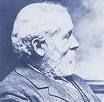
In 1877 Sir John Isaac Thornycroft (1843-1928) of Britain, whose facility is on the Thames River at Chiswick receives the first patent for an air-cushioned Hovercraft - why not the air-cushioned thornycraft? In 1935 Finnish engineer Toivo Juhani Kaario (1912-70) develops Thornycroft's 1877 Hovercraft patent into something more useful.
On Oct. 7, 1877 the Aftabeh asshole washing douche can is invented in Masshad, Iran by Haj Seyyed Gholamhossein Hasani Nejad, allowing Muslims to keep clean and sweet for their daily prayers sans toilet paper - no wonder it's the home of the assaholas?

In 1878 Paul Bert (1833-86) pub. La Pressions Barometrique (Barométrique), which describes and diagnoses Decompression Sickness after discovering that decompression bubbles are mostly nitrogen.

In 1878 English scientist Sir William Crookes (1832-1919) invents the Cathode Ray (Crookes) Tube (CRT), which requires a vacuum of one twenty-thousandth of atmospheric pressure (0.03 mm Hg), and shows that the rays travel in straight lines that can be deflected by a magnet, then uses the beam to heat metals, turn a small wheel, and excite fluorescence - Star Trek coming right up?

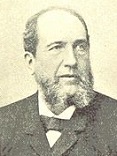
In 1878 Swiss chemists Marc Delafotaine (1837-1911) and Jacques-Louis Soret (1827-90) discover rare-earth element Holmium (Ho) (#67) (43rd most abundant element in the Earth's crust) in the spectrum of gadolinite; in 1879 Swedish chemist Per Teodor Cleve (1840-1905) chemically separates it from thulium and erbium - so rare it would take a Holmes to find it?

In 1878 Swiss chemist Jean Charles Galissard de Marignac (1817-94) isolates soft silver metallic rare earth element Ytterbium (Yb) (#70) from pure erbia, and names it after Ytterby, the Swedish town where he found it.
On Feb. 21, 1878 the first Telephone Directory is issued by the District Telephone Co. of New Haven, Conn.; it lists 50 names.

In 1878 Internat. Standard Time (IST) is invented by Scottish-born Sir Sandford Fleming (1827-1915) of Canada.

In 1878 Welsh inventor David Edward Hughes (1831-1900) uses a "clockwork transmitter" to transmit and receive Morse code using radio waves; he also invents the carbon microphone.

In 1878 Litchfield, Conn.-born Frederick Eugene Ives (1856-1937), dir. since age 18 of the Cornell U. photo lab invents the Half-Tone Photoengraving Process, patenting it in 1881 - where's Currier?

In 1878 Internat. Standard Time (IST) is invented by Scottish-born Sir Sandford Fleming (1827-1915) of Canada.

In 1879 Swedish chemist Lars Fredrik Nilson (1840-99) discovers metallic element Scandium (#21) (Sc) in wolframite eight years after Dmitri Mendeleyev predicted its existence based on the periodic law and predicted its properties as similar to boron.


On Feb. 27, 1879 Johns Hopkins U. chemist Ira Remsen (1846-1927) discovers Saccharin after noting that a coal tar derivative on his fingers makes a dinner roll taste sweet; too bad, his Russian-born research partner Constantin Fahlberg (1850-1910) names and patents it and leaves Remsen out, causing them to bitterly fall out.

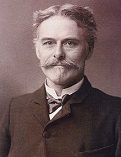
In 1879 Yale U. paleontologist Othniel Charles Marsh (1832-99) discovers and names the bones of the Brontosaurus in Wyo.; he and Philly-based rival Edward Drinker Cope (1840-97) launch the Bone_Wars, spending their wealth to discover 142 new species of dinosaurs by 1892, only 32 of which are found to be scientifically valid; despite the creation perennially winning the People's Choice award, in 1975 it is proved that it was actually the body of an apatosaurus with the head of a camarasaurus, and that the apatosaurus is the brontosaurus; in 2015 the name brontosaurus is rehabilitated.
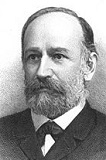

In 1879 using experimental data from Irish physicist John Tyndall, Austrian (Carinthian Slovene) mathematician-physicist Josef Stefan (1835-93) pub. the paper Über die Beziehung zwischen der Wärmestrahlung und der Temperatur (On the relation between heat radiation and temperature), announcing the Stefan (Stefan-Boltzmann) Law, that the total energy per unit time radiated from a black body per unit surface area is directly proportional to the fourth power of its thermodynamic temperature, using it to calculate the temp of the Sun's surface as 5,430C (9,810F); in 1884 Austrian physicist Ludwig Eduard Boltzmann (1844-1906) (founder of Statistical Mechanics, and coiner of the term "ergodic") pub. Ableitung des Stefan'schen Gesetzes, betreffend die Abhängigkeit der Wärmestrahlung von der Temperatur aus der electromagnetischen Lichttheorie (Derivation of Stefan's Law, concerning the dependency of heat radiation on temperature, from the electromagnetic theory of light), extending Stefan's Law to grey body emissions.

In 1879 German psychologist Wilhelm Wundt (1832-1920) sets up the first Experimental Psychology Lab at the U. of Leipzig, attracting students from all over the world - get your haircut and Skinner Box right here?
In 1879 Swedish chemist C.F. Dahl discovers the Sulfate Method of Making Paper from wood pulp - zillions of acres of trees are doomed to be turned into pulp fiction?

In 1878 Stephen Deadly Field, er, Stephen Dudley Field (1846-1913) of Stockbridge, Mass. invents an electric elevator. In 1979 he invents the Third Rail Electric Streetcar (trolley railway), which is successfully tested in New York City; he also becomes the first to apply dynamos to telegraphy.
In 1879 Ivory Soap (originally called the "White Soap") begins to be marketed in July by James N. Gamble, with the slogan "99 and 44/100th percent pure"; it floats because air is pumped into it.
In 1879 Edwin James Houston and Elihu Thomas of the U.S. invent Arc Lighting.
In 1879 Swedish engineer Carl Gustaf de Laval invents the Centrifugal Separator for removing cream from milk, causing industrial production of butter to ramp-up.
In 1879 Joseph Lawrence and Jordan Wheat Lambert of the U.S. invent tasty tangy germ-killing mouthwash Listerine.

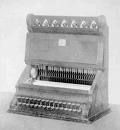
In 1879 Swedish chemist and Dayton, Ohio tavern owner James Jacob Ritty (1836-1918) of Dayton, Ohio invents the Cash Register, nicknamed the Incorruptible Cashier, which is patented on Nov. 4, 1880, leading to the 1884 founding of the National Cash Register Co. (NCR).

In 1879 English "Alice in Wonderland " author Lewis Carroll (Charles Lutwidge Dodgson) (1832-98) pub. Euclid and his Rivals, which defends Euclid's Elements as the best textbook for geometry, dissing the Assoc. for the Improvement of Geometrical Teaching (founded 1871); he goes on to pub. 10+ books on recreational matehamatics, along with serious research on linear algebra, symbolic logic, probability, determinants, proposing Dodgson Condensation, and voting systems, proposing Dodgson's Method.
In Feb. 1880 Science: A Weekly Record of Scientific Progress is founded by John Michaels with financial backing from Thomas Edison and Alexander Graham Bell, becoming the official journal of the Am. Assoc. for the Advancement of Science in 1900, reaching 130K subscribers and 570K readers by modern times.
In 1880 Charles Darwin (1809-82) and Francis Darwin (1848-1925) pub. The Power of Movement in Plants, which proves that seedlings grow toward the light.


In 1880 German chemist Richard August Carl Emil Erlenmeyer (1825-1909) (1861 inventor of the Erlenmeyer Flask) formulates the Erlenmeyer Rule, that alcohols which have a hydroxyl group directly attached to a double-bonded carbon atom become aldehydes or ketones.

In 1880 French physician Charles Louis Alphonse Laveran (1845-1922) discovers the parasite that causes malaria after being sent to Algeria to study it in 1878, winning the 1907 Nobel Med. Prize.


In 1880 responding to a $75K reward, James Albert Bonsack (1859-1924) of Va. develops the Bonsack Machine (U.S. patents #238,640 and #247,795 in 1881), the first machine for making yummy-sexy cigarettes; in 1884 devout Methodist James Buchanan "Buck" Duke (1856-1925) of Durham, N.C. buys two Bonsack machines and produces 744M cigarettes by the end of the year, underselling all competitors and creating a monopoly - a greater mass murderer than Attila the Hun?
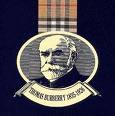
In 1880 English draper Thomas Burberry (1835-1926) of Basingstroke invents Gabardine, using weatherproofed yarn to make it water-resistant, tough, and breathable; he patents it in 1888.
In 1880 the Paige Typesetter is invented by James W. Paige, attracting a $300K investment by Mark Twain; too bad, by 1894 the Linotype kills it, leaving Twain strapped.


In 1880 English geologist John Milne (1850-1913) (whose portrait bears a striking resemblance to Am. comedian Dick Smothers (1939-)?) invents the Smothersgraph, er, Seismograph.
In 1880 the British Perforated Paper Co. sells the first commercial Toilet Paper; it comes in squares in a box, not rolls.


In 1880 Am. decorative artist Louis Comfort Tiffany (1848-1933) obtains a patent for a glass which changes colors with light, and goes on to design cool lamps using it - do they holly golightly?


In 1880 James Wimshurst (1832-1903) of England invents the Wimshurst Machine (an electrostatic generator), but fails to patent it.
On Feb. 2, 1880 the first electric streetlight is installed in Wabash, Ind., which on Mar. 1 becomes the electrically-lit city on Earth; some New York streets are lit by electricity this year, and Broadway by 1882.
On Feb. 24, 1880 the SS Columbia is launched on the Delaware River in Chester, Penn.; on May 22 it is lit up for the first time at the foot of Wall St. in New York City, becoming the first outside usage of Edison's incandescent light bulb.

In 1881 Cuban scientist Dr. Carlos Juan Finlay y Barres (Barrés) (1833-1915) presents the Mosquito Theory of Yellow Fever Transmission to a scientific convention in Havana, and is greeted with stony silence, becoming known as the Mosquito Man, and failing to gain acceptance for 20 years (until 1900), while the search for the yellow fever bacterium goes on in vain, because it's caused by a virus too small to be seen in a microscope and everybody wants to become the next Pasteur?
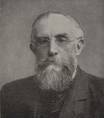

In 1881 English opthalmologist Waren (Warren) Tay (1843-1927) first describes the red spot in the retinas of people suffering from Tay-Sachs Disease, which in 1887 Jewish-Am. neurologist Bernard Sachs (1858-1944) notes is prevalent among Am. Jews of E European (Ashkenazi) descent.

In 1881 English logician John Venn (1834-1923) introduces Venn Diagrams.

In 1881 French inventor Clement Ader (1841-1925) invents the Theatrophone, with a separate channel for each ear, performing the first stereo transmission of an opera performance over a distance of 3km (2 mi.)

In 1881 John Boyd Dunlop (1840-1921) of the U.S. acquires the patent for a hollow (pneumatic) tire made of rubber and cloth; because of this, tire makers become the #1 consumer of natural rubber. In 1888 he patents the first practical pneumatic bicycle tire, but an 1845 patent by Robert William Thomson is soon granted precedence.
In 1881 Irish-born U.S. inventor John Philip Holland (1840-1914), an Irish nationalist wanting to help the U.S. Navy destroy British sea power gets money from the Fenians and launches his first successful submarine Fenian Ram on the Hudson River; too bad, its power system is too defective for long sea voyages and he goes back to the drawing boards.
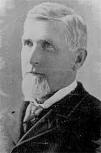
In 1881 Santa Cruz, Calif. judge James Harvey Logan (1841-1928) develops the Loganberry by accidentally crossing a blackberry and raspberry.

In 1882 after studying a horse parasite, Belgian biologist Edouard Van Beneden (1846-1910) discovers that every species has a characteristic number of chromosomes.


In 1882 Viennese physician Joseph Breuer (1842-1925) uses hypnosis to treat hysteria, founding the field of Psychoanalysis; meanwhile French neurologist Jean-Martin Charcot (1825-93) sets up the first neurology clinic in Salpetriere, where he loves to exhibit hysterical women, esp. "Blanche" (Marie Wittman), and grooms French-Polish student Joseph Jules Francois Felix Babinski (1857-1932) - here's how to turn porno into respectable science?

In 1882 German mathematician Carl Louis Ferdinand von Lindemann (1852-1939) proves that pi is transcendental (non-algebraic), i.e., not the root of any algebraic equation with rational coefficients, although, duh, irrational numbers such as the square root of 2 can be algebraic (solution of x^2 - 2 = 0).

In 1882 French chemist Francois-Marie Raoult (1830-1901) pub. Raoult's Law of freezing point depression of solutions by solutes.

In 1882 Am. inventor Amos Emerson Dolbear (1837-1910) patents a wireless telegraph that uses ground transmission up to a distance of 0.5 mi., then in 1886 patents a voice transmission system, preventing Guglielmo Marconi from operating in the U.S. until he buys him out.
In 1882 the Bordeaux Mixture, the first herbicide (fungicide) (also an insecticide) is developed in France from lime and copper sulfate (bluestone); the usual formula is 4 lb. of each in 50 gal. of water; also in 1882 Parqauat (made from sodium, anhydrous ammonia, and chloromethane) is first synthesized; its herbicidal properties aren't recognized until 1955, and it is first marketed commercially for weed killing in 1961.

In 1883 German-Am. immigrant Julius Schmid (1854-1935) begins making condoms, later sold under the brand name Ramses (named after Pharaoh Ramses II, who fathered 150+ children), becoming the "king of condoms"; the originals are made of lamb cecum - ask any Scot?

In 1883 the first Dirigible, a balloon powered by an electric motor is developed by brothers Albert Tissandier (1839-1906) and Gaston Tissandier (1843-99) of France.
In 1883 Albert Robida pub. the novel The Twentieth Century, which predicts the electric aircar, glass buildings, billboards, and Telephonoscope.
On Oct. 13, 1884 the Internat. Meridian Conference of delegates from 25 nations in Washington, D.C. adopts the SE London suburb of Greenwich (pr. GREN-ich) as the location of the Prime Merdian, to be used in a worldwide system of time zones; San Domingo votes against, and France and Brazil abstain; the old Arago (Paris) Rose Line passing through Paris (Church of Saint-Sulpice) is abandoned by every country except France, which doesn't get with it for several decades- like living in a sexless marriage?

In 1884 English theologian Edwin Abbott Abbott (1838-1926) pub. the novel Flatland: A Romance of Many Dimensions, in which A Square encounters a Sphere from another world; it is ignored until Einstein's Theory of Relativity comes out, after which it becomes a classic.
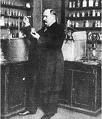
In 1884 Swedish chemist Svante August Arrhenius (1859-1927) proposes the ionic theory of chemistry in his doctoral dissertation, pointing out that solutions of salt in water are better conductors than pure salts or pure water, and dissociation into ions is practically complete even when there is no passage of electric current; his teachers barely pass him, but he later wins the 1903 Nobel Chem. Prize.

In 1884 Edward Goodrich Acheson (1856-1931), an asst. of Thomas Edison since 1880 invents Carborundum (crystalline silicon carbide) (#2 hardest surface next to diamond) (named after corundum or aluminum oxide) during experiments for producing artificial diamonds by heating a mixture of clay and coke with a carbon arc, and receives a patent in 1893, although his electric batch furnace patent goes to Electric Smelting and Aluminum Co. - of Topeka?

In 1884 Norwegian inventor Jens William Aegidius Elling (1861-1949) patents the first Gas Turbine, which produces 11 net hp; it takes until 1903 to build one that produces excess power.



In 1884 Am. inventor Herman Hollerith (1860-1929) submits a patent for the punched card reader, called the Electric Tabulating Machine, initially used by the U.S. Census and later used on computers, going on to found Internat. Business Machines Co. (IBM) (originally the Computing-Tabulating-Recording Co.) on June 16, 1911; in 1914 after being fired from the Nat. Cash Register Co. (NCR), Thomas John Watson Sr. (1874-1956) becomes pres. #1 (until 1956), revolutionizing its sales force with sales incentives, pep talks, and an insistence on being well-groomed, wearing a dark suit with white shirt and tie, creating the slogan "THINK"; in 1943 he shows what that means with the soundbyte: "I think that there is a world market for maybe five computers" - complete with hanging chads?

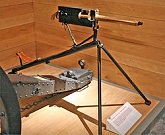
In 1884 U.S.-born English engineer Sir Hiram Stevens Maxim (1840-1916), after giving up on competing with Thomas Edison takes a friend's 1883 advice "If you want to make your fortune, invent something to help these fool Europeans kill each other more quickly", and in June-July patents the portable recoil-operated automatic quick-fire Maxim (Machine) Gun (600 rounds a min.) and founds the Maxim Gun Co. in Crayford, Kent to produce it, which is bought out in 1896 by Vickers Corp., causing it to become known as the Vickers Gun, becoming the standard British machine gun, also adopted by the Russians; after it becomes responsible for killing half the Japanese in the Russo-Japanese war, he is knighted by Queen Vicky in 1901 - trench warfare when when when?


In 1884 Am. inventor Ottmar Mergenthaler (1854-99) invents the Linotype, which produces a solid line of type at a breathtaking 4 lines per min. (up to 15 by 1945), becoming the greatest advance in info. technology since Gutenberg?; the New York Tribune begins using it commercially on July 1; the two left-hand vertical rows of the keyboard form the sequences "etaoin shrdlu"; an English trade journal runs a cartoon of a robot setting type, expressing Luddite fears among printers.



In 1884 French neurologist Georges Albert Edouard Brutus Gilles de la Tourette (1857-1904) first medically describes g-d-d-mned-f-ck-in-g (coprolalia) (shit-speaking) (tic malady) Tourette's Syndrome; actually it was called Brissaud's Disease for French physician Edouard Brissaud (1852-1909) after he pub. a description in 1896, but later Jean Martin Charcot (1825-93) restores credit to Tourette - it would have to be Brutus?

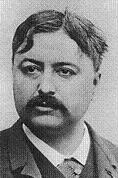

On Aug. 9, 1884 Arthur Constantin Krebs (1850-1935) and Charles Renard (1847-1905) pilot the electric-powered French army airship La France in Chalais Meudon in Paris, covering 8 km (5 mi.) in 23 min., becoming the first round-trip fully controlled takeoff and landing free-flight. In 1888 Krebs and Gustave Zede (Zédé) (1825-91) construct the 60-ft.-long electric Gymnote, the first submarine with hydroplanes (horizontal rudders), which help it descend, plus the first naval periscope and electric gyrocompass; it goes on to force a naval blockade in 1890. In 1891 Krebs designs the 3.5K-franc Panhard, the first practical gasoline-powered automobile, with four wheels, a front-mounted engine and rear-wheel drive, a crude sliding-gear transmission with an electromagnetic gearbox, and the first castor-angled front wheels, all of which he patents in May 1896; in 1898 Krebs replaces the tiller with an inclined steering wheel with non-reversible steering, and engine balance; in 1901 he begins using nickel steel alloys; in 1902 he invents the automatic diaphragm carburetor; in 1906 he invents the shock absorber; in 1905 he invents the electric brake dynamometer for engine testing; in 1907 he invents the multi-disc clutch; in 1911 he invents the elastomeric flexible coupling (Flector joint); in 1915 he invents the worm gear differential; in 1898-1902 Panhard et Levassor builds 500 cars under license, going on to become one of the largest automobile manufacturers before WWI.

In 1884 English engineer Charles Algernon Parsons (1854-1931) invents the first practical steam turbine engine, showing it off in June 1897 by powering his yacht Turbinia at an unheard of 34 knots (vs. 27 knots for the fastest Royal Navy ships of the day), getting knighted for it in 1911.

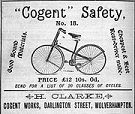
In 1884 John Kemp Starley (1854-1901) of Coventry, England invents the Rover Safety Bike, with diamond-shaped frame, two wheels of identical size (26 in.), and a chain-driven rear wheel, using a large front cog and small rear cog, which "sets the pattern to the world", making the penny-farthing seem like a needless risk; no seat or brakes yet.


In 1885 German engineer Karl Friedrich Benz (1844-1929) invents the modern automobile (a 3-wheeled carriage with an internal-combustion engine), which he patents on Jan. 29, 1886, and drives through the streets of Munich; meanwhile fellow German Gottlieb Wilhelm Daimler (1834-1900) patents an internal-combustion engine, which is initially used to power a motorcycle, causing the two Master Race Volk to share the credit for the first working automobile; the Benz has electric ignition, a water-cooled engine, and a carburetor, and despite a top speed of 8 mph he runs the vehicle into a brick wall, becoming the world's first automobile accident.

In 1885 Swiss girls' high school teacher Johann Jakob Balmer (1825-98) pub. a mathematical relation between the spectral frequencies of atomic hydrogen lines in the visible spectrum, showing them converging to a limit which is later called the Balmer Series.

In 1885 German organic chemist Adolf von Baeyer (1835-1917) of the U. of Munich pub. the notion of Steric Strain, which destablizes small-ring organic compounds, and has more pronounced effects the larger the rings become.

In 1885 self-educated Vt. farmer Wilson Bentley (1865-1931), "the Snowflake Man" becomes the first to take a closeup photo of an individual snowflake crystal, proving that each one is different; he sells some of his photos to a jeweler to use for design patterns; he also measures raindrops and proves that different kinds of storms produce different sizes.

In 1885 German bacteriologist Theodor Escherich (1857-1911) discovers the Escherichia coli (E. coli) bacterium - if his name were easier to pronounce, they wouldn't have to abbreviate it?

On Aug. 20, 1885 Supernova 1885 (S Andromedae) is discovered by German astronomer Carl Ernst Albrecht Hartwig (1851-1923) in the Andromeda Galaxy (M31) (in the N Hemisphere S of Cassiopeia and W of Perseus), going magnitude 9 to 6 in less than 1 mo., then fading to magnitude 16 in Feb. 1890, becoming the first known supernova beyond the Milky Way Galaxy.

In 1885 William Seward Burroughs (1855-98) invents an Adding Machine, and next year founds the Am. Arithmometer Co., which goes on to become the #1 adding machine co. in the U.S.
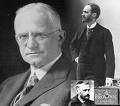
In 1885 George Eastman (1854-1932) of Rochester, N.Y. manufactures coated photographic paper. In 1888 the first hand-held Kodak Box Camera, containing a roll of flexible paper-based film, and patented in 1881 by D.H. Houston (named for his home state of N.D.) is marketed by Eastman; after exposing the film, the entire camera is sent to the factory for processing, and a reloaded camera is sent back along with the developed photos; "You push the button, we do the rest" - some day my prints will come? On Aug. 27, 1889 Am. chemist Henry M. Reichenbach of Eastman Kodak develops the first roll film using celluloid substrate, and on Dec. 10 George Eastman is granted a patent for flexible celluloid film.

In 1885 Galileo Ferraris (1847-97) of Turin, Italy invents the Polyphase Electric Motor.

On July 14, 1885 former slave Sarah E. Goode (1850-) patents the hideaway bed, which doubles as a desk or shelf, becoming the first African-Am. woman to receive a U.S. patent - is she related to Johnny B. Goode?
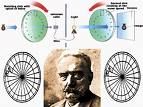
In 1885 Paul Julius Gottlieb Nipkow (1860-1940) of Germany patents the rotating Nipkow Disk, a system for a crude television (transmitting pictures by wire), later (1925) adapted by John Logie Baird for TV.

In 1885 Francois Eugene Turpin (1848-1927) of Colombes, France patents Melinite, pressed-cast picric acid (a derivative of phenol) with gun cotton, which is used extensively in WWI; in 1887 Britain steals it and calls it Lyddite, and Japan follows suit with Schimose.

In 1885 Karl (Carl) Auer von Welsbach (1858-1929) of Germany invents the Auerlicht incandescent gas mantle, consisting of guncotton impregnated with Actinophor (60% magnesium oxide, 20% lanthanum oxide, and 20% yttrium oxide), which gives off a bright green light when heated; in 1890 he tries 99% thorium dioxide and 1% cerium IV oxide, which gives off whiter light, and becomes a pre-Edison hit. The first noctilucent clouds, caused by ice in the upper atmosphere that catch sunlight after the Sun goes down are observed by an amateur astronomer.

On Feb. 6, 1886 the hard, brittle, reflective grey chemical element Germanium (#32) (Ge) is discovered by German chemist Clemens Alexander Winkler (1838-1904) in argyrodite after he figures out that the main components silver and sulfur only take up 93% of the mass, and initially calls it ekasilicon because it is chemically related to silicon; it ends up being named after Germany.
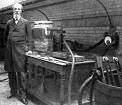
On June 26, 1886 French chemist Henri Moissan (1852-1907) isolates pure pale yellow Fluorine (F) (#9) (Lat. "fluo" = to flow) gas, earning him a prize of 10K francs from the French Academy of Science. In 1892 he invents the electric arc furnace, and uses its 3.5K C temp to produce tiny artificial diamonds along with new carbide, silicide, and boride compounds, winning the 1906 Nobel Chem. Prize.

In 1886 Latvian-born German surgeon Ernst von Bergmann (1836-1907) uses steam to sterilize surgical instruments, starting the practice of aseptic surgery.
On June 20, 1886 after obtaining it from his brother in Mexico, physician John Raleigh Briggs (1851-1907) of Dallas, Tex. eats one-third of a peyote button, and next year describes it for the first time in the medical lit., with the soundbyte "I know of nothing like it except opium and cocaine"; next year he sends a sample to German pharmacologist Dr. Louis Lewin (1850-1929), who distributes it around Germany for analysis and pub. the first scientific analaysis, causing it to be named Anhalonium lewinii.

In 1886 French chemist Paul-Emile (Francois) Lecoq de Boisbaudran (1838-1912) discovers the metallic rare earth element Dysprosium (Dy) (#66), known for the highest magnetic susceptibility of the rare earths.


In 1886 Swiss chemist Jean Charles Galissard de Marignac (1817-94) discovers rare-earth (#40) chemical element Gadolinium (#64) (Gd), and names it after Finnish chemist Johan (John) Gadolin (1760-1852), who isolated gadolinite, the ore in which it is found near Falun, Sweden, Hitra Island, Norway, et al.


On Dec. 28, 1886 Josephine Garis Cochran (Cochrane) (1839-1913) of Shelbyville, Ill. (whose mother Irene is the daughter of steamboat inventor John Fitch) patents an automatic dishwasher that wins first prize at the 1893 Chicago World's Fair, and is later marketed by KitchenAid to restaurants and hotels when it proves too expensive for home use; in the 1950s new Am. suburban homes come equipped with extra plumbing to handle the hot water, making them a common household device.


In 1886 German chemist Friedrich Otto Schott (1851-1935) and German microscope maker Carl Zeiss (1816-88) invent a new type of optical glass that can utilize the Abbe sine condition, making possible apochromatic (apo) microscope objectives, which bring three wavelengths into focus in the same plane rather than two like achromatic lenses. In 1887-93 Schott develops borosilicate glass (ends 1893), which can take heat and thermal shock and resist chemicals.


In 1886 Am. self-taught chemist Charles Martin Hall (1861-1914) of Thompson, Ohio and French chemist Paul Louis Toussaint Heroult (Héroult) (1863-1914) independently invent processes for producing aluminum by electrolysis. In 1888 Alcoa (Aluminum Co. of Am. (originally the Pittsburgh Reduction Co.) in Pittsburgh, Penn. is founded to produce aluminum using the 1886 Hall Process.

In 1886 French engineer Paul Vieille (1854-1934) invents smokeless gunpowder, which he calls Poudre B, which is 3x more powerful than black gunpowder (Poudre Noire); it is adopted by the French army for the Lemel Rifle.
In 1886 David H. Wilson of Tex. obtains U.S. patent #343,939 for the Electric Fence, constructing a 30-mi. one energized by a water wheel, which is not successful; they are not improved until the 1906 Russo-Japanese War and WWI.


In spring-summer 1887 after Polish-Am. physicist Albert Abraham Michelson (1852-1931) makes an experimental determination of the Earth's speed through the ether in Potsdam in 1881, and the results (zero) are so unexpected that he repeats the experiments in Cleveland, Ohio in partnership with Edward Williams Morley (1838-1923), the results of the Michelson-Morley Experiment throw the physics world on its head with its apparent proof of the non-existence of Leibniz's stationary ether (aether) (or the disturbing conclusion that the Earth carries the ether along with it); the world must wait for Einstein to figure out that instead of time and space being invariant and the speed of light variable, it's the other way around, and both space and time are variable (relative to inertial speed).
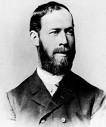
In Nov. 1887 German physicist Heinrich Rudolf Hertz (1857-94) pub. the paper "On Electromagnetic Effects Produced by Electrical Disturbances in Insulators, showing that James Clerk Maxwell's 1865 paper theorizing the existence of electromagnetic waves is correct, causing the unit of frequency cycles per sec. to be named in his honor; he observes that a spark jumps a gap more easily when the electrodes are illuminated by light from another spark gap, becoming the first observation of the photoelectric effect, which Einstein finally explains in 1905 by proposing that radiation is quantized, and when light quanta hit metal they overcome the attractive potential holding electrons in, and convert their remaining energy into kinetic energy of the ejected electrons.

In 1887 German chemist Friedrich August "Fritz" Raschig (1863-1928) develops the Raschig Process

In 1887 English paleontologist Harry Govier Seeley (1839-1909) discovers a dichotomy in the classification of dinosaurs because of different pubic bones, causing him to divide them into the bird-hipped Ornithischia and the lizard-hipped Saurischia.



In 1887 Lick Observatory on Mount Hamilton E of San Jose, Calif. is founded from a bequest left by James Lick (1796-1876) (wealthiest man in Calif.), whose body is buried under the site; the 36-in. lens is ground by Am. astronomer Alvan Clark (1804-87), who goes on to grind the 40-in. lens for Yerkes Observatory.
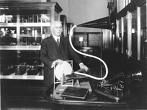
In 1887 German immigrant Emile Berliner (1851-1929) patents the Gramophone in Washington, D.C. on Nov. 8, using cylinders, which he upgrades to discs in 1888, and begins marketing in Europe in 1889 to toy companies while he works to improve audio quality; musicians now have to struggle with copyright pirates like authors do?





In Oct. 1888 Milan, Ohio-born (pr. MY-lin) Thomas Alva Edison (1847-1931) files a preliminary patent (caveat) for his Kinetoscope (Gr. "kineto" + "scope" = motion + watch) "optical phonograph" motion picture camera, which does "for the Eye what the phonograph does for the Ear", filing a 2nd caveat in Mar. 1889 which first names it; in 1889-90 the first crude Monkeyshines are shot at Edison Labs in N.J. by Scottish-born William Kennedy Laurie Dickson (1860-1935) and William Heise after Dickson decides on celluloid film and selects 35mm as the std. size; on May 20, 1891 the first working prototype is unveiled at the Nat. Federation of Women's Clubs, showing the 3-sec. Dickson Greeting from a small pine box filled with film on rollers and a 1-in. peep show viewer on top; on Feb. 21, 1893 after most of his application is denied based on prior art, Edison receives a patent governing the intermittent movement of film in the Kinetograph; on Mar. 14, 1893 Edison receives patent #493,426 for the exhibition device; on May 9, 1983 the final version is unveiled at the Brooklyn Inst. of Arts and Sciences, showing The Blacksmith Scene; too bad, Edison goes on to try to force every new movie studio to pay him royalties, holding the industry back for years; in 1895 Thomas Edison invents the Kinetophone, which links a Kinetoscope with a cylinder phonograph, making talking movies possible; meanwhile on May 2, 1887 Episcopal priest Hannibal Williston Goodwin (1822-1900) of Newark, N.J. patents celluloid film for use in Bible teaching, and it ends up being used in Edison's Kinetoscope and being stolen by George Eastman; when Goodwin dies in a street accident in 1900 his patent is sold to Ansco, which settles with Eastman Kodak for $5M for patent infringement.

In 1888 German Bavarian biologist Theodor Heinrich Boveri (1862-1915) discovers the centrosome, which he calls the "special organ of cell division", later discovering the phenomenon of chromatin diminution; in 1902 he proposes that a cancerous tumor starts with a single cell in which the chromosome makeup becomes scrambled, causing it to divide uncontrollably, caused by radiation, chemicals, or pathogens, which is proved true in 1915 by Thomas Hunt Morgan.

In 1888 Wilhelm Franz Ludwig Hallwachs (1859-1922) of Germany discovers the Hallwachs Effect, produced when ultraviolet light falls on a negatively charged body in a vacuum and discharges it.

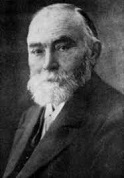

In 1888 German mathematician David Hilbert (1862-1943) pub. Hilbert's Basis Theorem, that a polynomial ring over a Noetherian ring is Noetherian, becoming the first "constructive proof", proving the existence of something without being able to display it, using the Law of the Excluded Middle (principium tertii exclusi) (tertium non datur) ("Either P or not P"), causing the ed. of Mathematische Annalen to comment: "This is not mathematics, this is theology", after which he adds "I have convinced myself that even theology has its merits"; the Intuitionist School of Mathematics ("the proof is the object") takes off with this idea and runs with it. In 1900 he announces Hilbert's 23 Unsolved Problems of Mathematics at the Internat. Congress of Mathematicians, which take the rest of the cent. to assimilate; meanwhile fellow German mathematician Friedrich Ludwig Gottlob Frege (1848-1925) disputes his whole approach, based on his 1884 book The Foundations of Arithmetic (Die Grundlagen der Arithmetik), which makes fans of Bertrand Russell and Ludwig Wittgenstein - Math is a Battlefield? In 1920 he proposes Hilbert's Program, an attempt to prove that all of mathematics follows from a finite set of axioms, and is consistent; too bad, Kurt Godel blows the program out of the water in 1931 with his Incompleteness Theorem. In 1970 Russian mathematician Yuri Vladimirovich Matiyasevich (1947-) proves that Hilbert's Tenth Problem (1900) is unsolvable.
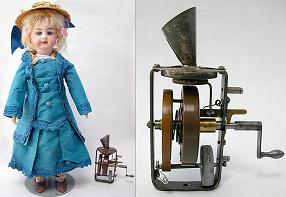
In 1888 Thomas Edison invents a Talking Doll with a small phonograph in its body that can recite a dozen nursery rhymes when continuously cranked ("the voices of the little monsters were exceedingly unpleasant to hear"); they are offered for sale on Apr. 7, 1890, costing $10 with a simple chemise, $20-$25 with full dress; he manufactures hundreds before finding that he had already sold the rights to phonograph toys to another firm, and has them destroyed, and only two survive?


In 1888 German opthalmologist Adolf Eugen Fick (1829-1901) creates the first Contact Lenses for patients with Keratoconus; next year German medical student August Mueller (Müller) (1864-1949) invents contact lenses made of glass discs, which are improved by French opthalmologist Eugene Jean Baptiste Kalt (1861-1941); too bad, they are made from impermeable glass, and cover the whites of the eye until 1948, making them impossible to wear for more than 4-5 hours.
On Aug. 7, 1888 Theophilus von Kannel (1841-1919) of Philadelphia, Penn. patents the "noiseless" Revolving Door.

In 1888 Am. physician John Harvey Kellogg (1852-1943) of the Battle Creek, Mich. Sanitarium gives the world's first Oxygen Enema to a lucky plucker - did he tear his pants?

On Oct. 14, 1888 French inventor ("the Father of Cinematography") Louis Aime (Aimé) Augustin Le Prince (1841-90) shoots The Roundhay Garden Scene in the garden of his father-in-law Joseph Whitley in Roundhay Leeds, West Yorkshire, England on a 2.1-in.-wide paper roll from Eastman Kodak, running 10-12 frames per sec. shot through a single-lens combi camera-projector, becoming the oldest surviving motion picture film; on Sept. 16, 1890 before he can demonstrate it in the U.S., Le Prince disappears from a train in Dijon, and Thomas Edison claims credit for the invention; in 1898 his son Adolphe Le Prince testifies in court for his father in a suit brought by Edison against the Am. Mutoscope Co., but is barred from presenting his dad's two cameras as evidence, and Edison wins, but a year later the judgment is overturned.
In 1888 Marvin Chester Stone of Washington, D.C. patents a process for making Drinking Straws by winding strips of paraffin-coated paper around a pencil and gluing them together; manufacturing is done by hand until 1906.
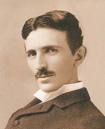
The first year people have the AC-DC option? In 1888 Croatian-born Nikola Tesla (1856-1943) of the U.S. invents the Alternating Current (AC) Electric Motor, which is manufactured by George Westinghouse; Thomas Edison, a DC man, facetiously bet him he couldn't do it, and then reneged on a $25 a week raise in 1885, causing a lifelong grudge? In 1891 Tesla first demonstrates alternating current for commercial use at the Ames Power Plant in Colo. between Silverton and Telluride; he goes on to build a weird funky lab in Colo. Springs in 1899 to develop wireless transmission of electrical power using Tesla Coils. Tesla dies on Jan. 6/7, 1943 in New York City; he was murdered by Otto Skorzeny and Reinhard Gehlen to steal his revolutionary military inventions incl. the gravity motor?; he was strangled by fellow free energy enthusiast Viktor Schauberger?; his property is seized by the U.S. govt. Office of Alien Property, then examined by Pres. Donald Trump's MIT prof. uncle John G. Trump, who concludes: "[Tesla's] thoughts and efforts during at least the past 15 years were primarily of a speculative, philosophical, and somewhat promotional character", but "did not include new, sound, workable principles or methods for realizing such results"; electrifying conspiracy rumors about suppressed inventions incl. anti-gravity flying machines fly around to modern times: "The scientists of today think deeply instead of clearly. One must be sane to think clearly, but one can think deeply and be quite insane"; "When wireless is fully applied, the Earth will be converted into a huge brain, capable of response in every one of its parts"; "To me, the Universe is simply a great machine which never came into being and never will end. The human being is no exception to the natural order. Man, like the Universe, is a machine"; "It is a mere question of time when men will succeed in attaching their machinery to the very wheelwork of nature."

In 1889 Spanish histologist Santiago Ramon y Cajal (1852-1934) discovers the mechanisms of gray matter nerve cells, then in the next two years isolates Cajal's Cells (Cajal-Retzius Cells) near the brain surface, and demonstrates the changes they undergo while functioning, founding modern neuroscience and winning the 1906 Nobel Med. Prize.
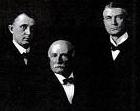
In 1889 brothers William James Mayo (1861-1939) and Charles Horace Mayo (1865-1939), sons of William Worrall Mayo (1819-1911) (all surgeons) found the Mayo Clinic at St. Mary's Hospital in Rochester, Minn.; on Sept. 30 Charles H. Mayo performs the first modern surgical procedure, the removal of a cancerous growth - you can almost taste the hotdog?

In 1889 Italian mathematician Giuseppe Peano (1858-1932) pub. the Peano Axioms, which define the natural numbers in terms of sets.
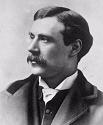
On June 21, 1889 after making the first moving pictures on celluloid film last year in Hyde Park, London, Bristol-born English portrait photographer William Freeze-Frame, er, William Friese-Greene (1855-1921) receives patent #10,131 for his Chronophotographic Camera, which can take 4-5 (up to 10?) photographs per sec. using peforated celluloid film, and sends info. on it to Thomas Edison, who is busy developing his Kinetoscope; too bad, the low frame rate causes it to become a flop, and he goes bankrupt in 1891; he then invents Biocolour, using B&W film with two different colored filters, and alternate frames of the monochrome print stained red or green.
On Aug. 13, 1889 William Gray of Hartford, Conn. patents a coin-operated telephone box, and installs the first one at a bank in Hartford.
In 1889 the first working electric elevator is installed in the Demarest Bldg. in New York City at 339 Fifth Ave., Manhattan.

In 1889 English chemist Sir Frederick Augustus Abel, 1st Baronet (1827-1902) invents Cordite smokeless propellant (58% nitroglycerine, 37% guncotton, 5% petroleum jelly), which is used in 303 British Mark I and Mark II rifle cartridges in 1891-1915, and the detonation system of the Little Boy a-bomb dropped on Hiroshima in Aug. 1945.
In 1889 reaper-mower machine manufacturer Jacob Hiram Myers (1841-1920) of Rochester, N.Y. receives a patent for the Automatic Voting Machine (AVM), which catches on and becomes a monopoly until 1936, when the Shoup Voting Machine Corp. (founded 1905 by Samuel R. Shoup becomes a competitor, introducing the Model 2.5 in 1935, which takes over,. selling 100K machines by 2000.


In 1889 N.Y.-born Kansas City, Mo. undertaker Almon Brown Strowger (1839-1902) of the U.S. invents an automatic electromechanical telephone switching device, and patents it in 1891, opening the first commercial telephone exchange on Nov. 3, 1892 in La Porte, Ind. with 75 subscribers (cap. 99).
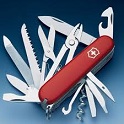
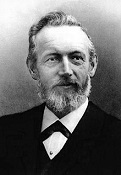
In 1890 the Swiss Army Knife is born when the Swiss Army decides that every soldier needs to carry a knife with a screwdriver to disassemble his Schmidt-Rubin rifle and a can opener for canned food, producing the Model 1890, which incl. a reamer, with a handle made of dark oak and/or ebony; the first lot of 15K is delivered in Oct. 1891 by Wester & Co. of Solingen, Germany; the red handle has a Swiss cross and shield; in 1891 surgical equipment maker Karl Elsener (1860-1918) of Ibach gets the contract to manufacture it, establishing the Victorinox Co. in 1909 after his mother Victoria dies, combining her name with "inox" (Fr. "acier inoxydable"), meaning stainless steel; in 1908 Paul Boechat & Co. of Belermont splits the contract 50-50, becoming Wenger Co., owned by Theodore Wenger, with Victorinox producing the Original Swiss Army Knife and Wenger the Genuine Swiss Army Knife; which is acquired by Victorinox on Apr. 26, 2005, continuing to produce both brands until announcing on Jan. 30, 2013 that only Victorinox will be produced; in WWII U.S. soldiers change the name from Offiziersmesser because it's too hard to pronounce; Victorinox sets up a factory in Monroe, Conn., which produces more and more models with more and more blades, incl. saw, scissors, file, pliers, tweezers, bottle openers, corkscrew, knife chain, belt clip et al.



The unbearable lightness of Behring? In 1890 Emil Adolph von Behring (1854-1917) discovers antitoxins in the Berlin lab of physician Robert Koch (1843-1910) while working with Shibasaburo Kitasato (1853-1931) of Japan, and formulates Behring's Law, that blood serum from an individual who had contracted and survived a disease can be used to produce immunity to the same disease in another individual; he first applies it to tetanus, then diphtheria, then cattle TB; meanwhile Koch produces a substance he calls tuberculin, claiming it to be a cure for TB, but later finds it useful only in diagnosis; von Behrin wins the 1901 Nobel Med. Prize for the discovery of the diphtheria antitoxin serum, while Kitasato is snubbed.

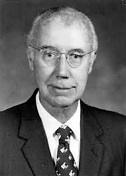
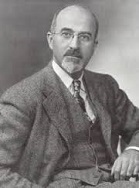

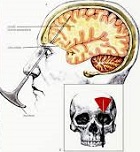

In 1890 Swiss psychiatrist Johann Gottlieb Burckhardt (1836-1907) performs the first lobotomy (frontal lobe removal) operations; too bad, one patient dies after the operation, another is found dead in a river 10 days later, and the rest exhibit altered behavior. On Nov. 12, 1935 Portuguese neurologist Antonio (António) Caetano de Abreu Freire Egas Moniz (1874-1955) performs the first prefrontal leucotomy (lobotomy) by drilling holes in the patient's head and injecting alcohol to destroy the tissue, later using a leucotome (retractable wire loop) - so alcoholics are just trying to give themselves leucotomies? On Sept. 14, 1936 after Watts loses his license to perform surgery when his patient dies on the operating table, Am. neurosurgeon James Winston Watts (1904-94) is directed by Am. physician Walter Jackson Freeman II (1895-1972) to perform their first frontal lobotomy on housewife Alice Hood Hammatt of Topeka, Kan., going on to popularize it in the U.S. The Uline Ice Co. presents Doctor Egomaniac AKA Doctor Eager Money? In 1949 after U.S. doctors Walter Freeman and James W. Watts adopt the technique of Egas Moniz, who claimed a 30% success rate and became the country's first (only) Nobel Prize in Medicine winner for his barbaric "apple corer", and Freeman develops the nasty ice pick technique for prefrontal lobotomies, charging only $25 and wearing no surgical gloves or mask, one is performed on Rosemary (Rose Marie) Kennedy (1918-2005), daughter of Joseph P. Kennedy and Rose Kennedy, which leaves her childlike and in need of institutionalization; by 1951 18K+ lobotomies are performed in the U.S. alone; they are not discontinued in favor of drug treatment until the 1960s after Freemon is banned from performing surgery in 1967.

In 1890 German chemist Julius Wilhelm Theodor Curtius (1857-1928) produces azoimide from organic sources using the Curtius Rearrangement.

About 1890 French-born Belgian paleontologist Louis Antoine Marie Joseph Dollo (1857-1931) formulates Dollo's Law of Irreversibility, which states that in evolution an organism never returns to its exact former state, i.e., complex structures once lost are never regained in their original form.


In 1890 Willoughby Dayton Miller (1853-1907) pub. the microbial theory of dental cavities (caries).



In 1890 Italian mathematician Gregorio Ricci-Curbastro (1853-1925) invents Tensor (Absolute Differential) Calculus (Analysis), which uses contravariant (superscript) and covariant (subscript) array indices to represent physical objects independent of coordinate systems; in 1898 German physicist Woldemar Voigt (1850-1919) coins the term "tensor"; Ricci-Curbastro's student Tullio Levi-Civita (1873-1941) popularizes it in a 1900 textbook, and Albert Einstein later uses it in his Gen. Relativity Theory after taking 10 slow years to learn it, along with elliptic geometry from his friend Marcel Grossmann (1878-1936) - just move on up to relieve?

In 1890 German-born English industrialist Ludwig Mond (1839-1909) discovers a new method of purifying nickel (element #28) by treating it with carbon monoxide, leading to many advances in industrial catalysts; in 1900 he founds Mond Nickel Co..

On Aug. 6, 1890 (7:00 a.m.) after Thomas Edison helps nix his appeal in hopes that the use of Westinghouse's AC rather than his DC will give them a bad name, convicted common-law wife hatchet murderer William Kemmler (b. 1860) becomes the first person to be executed on an Electric chair as N.Y. tries out its brand-new 1888 model in Auburn Prison; after being zapped for 17 sec. with 1K volts, he is still breathing, so they juice it up to 2K volts for 70 sec., during which time he catches fire and nauseated witnesses run for it - the original Green Mile?

On Oct. 9, 1890 Clement Ader (1841-1925) makes his first flight in his steam-powered fixed-wing aircraft Ader Eole in Satory, France, flying 50m (160 ft.) at a height of 20 cm., becoming the first takeoff of an airplane solely under its own power.
In Dec. 1890 Thomas Edison's talking dolls become a rage at Christmas; they sound like they're possessed?; too bad, they are almost all damaged in shipping, causing him to sell them sans guarantee.

In 1891 Am. surgeon William Bradley Coley (1862-1936) successfully treats a tumor by injecting the patient with streptococcal cultures, later killing the bacteria first, pioneering Immunotherapy.
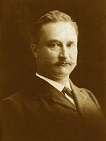
In 1891 Dutch paleoanthropologist Marie Eugene Francois Thomas Dubois (1858-1940) discovers Java Man in Java, Indonesia, naming it Pithecanthropus erectus after becoming convinced that the human species originated in the tropics, becoming the first early hominid specimens to be found outside Africa or Europe, making him world famous; too bad, after fighting the scientific establishment for acceptance and gaining ground, he dies a bitter man; his specimens are later classified as Homo erectus erectus - he went ape?

In 1891 antibodies are first proposed as responsible for disease immunity by German scientist Paul Ehrlich (1854-1915). In the 1900s he pioneers the treatment of diseases with chemicals. In 1910 he introduces Salvarsan (Arsphenamine) as a specific remedy for pesky syphilis - save our sanity, this will sound like a bad joke, but if only more Germans went into science instead of the Wehrmacht? In 1912 he introduces the topical antiseptic Acriflavine.
In 1891 C.F. Cross, C. Beadle and E.J. Bevan of Courtalds Ltd. in Britain discover how to manufacture Viscose Rayon, and patent it next year.

In 1891 French physicist Louis Arthur Ducos du Hauron (1837-1920) invents Anaglyph Stereoscopic Printing, in which left/right red/blue channels are fed separately to the eye, which combines them into a 3-D image.

In 1891 French physicist Gabriel Jonas Lippmann (1845-1921) invents the Lippmann Plate for color photography, winning the 1908 Nobel Physics Prize.
In 1891 the explosive PETN (PENT) (pentaerythrigol tetranitrate) is synthesized in Germany by Bernhard Christian Gottfried Tollens (1841-1918) and P. Wigand; it is patented in 1912, and used in WWI.
In 1891 Am. dentist Greene Vardiman Black (1836-1915) of Chicago, Ill. begins advocating a scientific cavity preparation to prevent recurrence of decay around the margins of the fillings.

In 1891 Irish-born Baltimore, Md. Quaker William Painter (1838-1906) invents the crown bottle cap, and patents it on Feb. 2, 1892 (#468,226, 468,258), forming the Crown Cork and Seal Co. in Baltimore, Md. and becoming a millionaire, going on to invent a crown bottle cap opener, a bottle capping machine, a paper-folding machine, a safety ejection seat for passenger trains, and a machine for detecting countefeit currency; not until the 1960s does the twist-off cap offer any serious competition.

In 1892 Rudolf (the Red-Nosed?) Diesel (1858-1913) of Munich, Germany patents an internal combustion engine using low-cost fuel (peanut oil), and goes on to perfect the first commercial Diesel Engine at the Krupp factory in Essen.
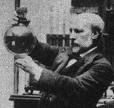
In 1892 James Dewar (1843-1923) of Scotland patents the thermos, getting knighted in 1904.
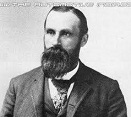
In 1892 the first successful gasoline-powered farm tractor is developed by John Froelich (1849-1933) in Iowa; it has a 16 hp motor and can go in reverse; John Deer & Co. purchases the patent in 1918 for a song, and Froelich dies broke.
On Mar. 15, 1892 Jesse Reno of the U.S. patents the first inclined elevator (moving stairs), and in 1895 he sets up a 25 deg. angle escalator ride at Coney Island.

In 1893 Irish physicist George Francis FitzGerald (1851-1901) of Trinity College, Dublin suggests that a body undergoing motion contracts in the direction of motion, but doesn't explain why - that would take an Einstein?
In 1893 Frank J. Kellogg markets the first weight-loss pill, a thyroid extract called the "safe fat reducer"; too bad, its use can cause sudden death.

In 1893 German psychiatrist Emil Kraepelin (1856-1926) founds modern psychology with the clinical approach based on syndromes (patterns of symptoms), classifying psychosis into manic depression and dementia praecox ("sub-acute development of a peculiar simple condition of mental weakness occurring at a youthful age") - so that's why psychiatry is full of krap?

In 1893 Karl Pearson (1857-1936) invents statistical moments and standard deviation.

In 1893 Daniel Hale Williams (1856-1931), 1891 founder of Provident Hospital in Chicago, Ill., the first interracial hospital and training school for black nurses and interns performs the first pericardial sac repair operation.
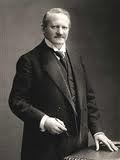
In 1893 Thermite, a mixture of aluminum and iron rust powder is invented by German chemist Hans Goldschmidt (1861-1923); it burns at 2.5K C and can be used for welding; he patents it in 1895.

In 1893 English-born Am. chemist Edward Weston (1850-1936), competitor of Thomas Edison invents the Weston Cell, a cadmium-mercury battery that is so stable it becomes the internat. standard for EMF in 1911, after which he waves his patent rights since he has 308 other patents.


In 1894 the bacillus Pasteurella pestis (Yersinia pestis) that causes the bubonic plague (Black Death) is discovered independently by Kitasato Shibasaburo (1853-1931) of Japan and Alexandre Emile Jean Yersin (1863-1943) of Russia.

In 1894 Simon Lake (1866-1945) develops the first modern submarine, the Argonaut Jr.

In 1894 German "Glider King" Karl Wilhelm Otto Lilienthal (1848-96) files for a patent on a triangle control frame hang glider, the Derwitzer, going on 2K+ flights and learning how to hover against a 10 mph updraft, inspiring the Wright Brothers; too bad, on Aug. 10, 1976 he hits a sudden downdraft, crashes, and dies in Berlin.

On June 1, 1894 Sir Oliver Joseph Lodge (1851-1940) of England demonstrates the use of a Coherer for detecting radio signals, becoming a big breakthrough for vacuum tube technology.
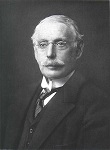
On Aug. 2, 1894 after London-born Anglo-Irish inventor Sir Charles Algernon Parsons (1854-1931) invents the modern compound steam turbine in 1884, his steamship Turbinia ("the Ocean Greyhound") is launched, becoming the first steam turbine-powered steamship, and the world's fastest ship (until ?) (34 knots), paving the way for the next generation of steamships incl. the dreanoughts after the cavitation problem is solved by the cavitation tunnel.

In 1894 Serbian-born Am. physicist Michael Idvorsky (Mihajlo Idvorski) Pupin (1858-1935) invents the Pupin Loading Coil, which greatly extends the range of long distance telephones by adding distributed inductance to the line; the patent is later acquired by AT&T.


On Feb. 13, 1895 brothers Auguste Lumiere (Lumière) (1862-1954) and Louis Lumiere (Lumière) (1864-1948) of Lyon, France, who with their Haute-Saone, Ormoy-born photographer father Charles-Antoine Lumiere (Lumière) (1840-1911) (Fr. "lumiere" = light) set up a photographic equipment factory in Lyons, France in the 1880s patent the Cinematograph camera-projector combo, one of the first motion picture cameras, using a perforated film, and the first showing movies to an audience instead of an individual viewer like Edison's "peepshow" kinetoscope; their first film Leaving the Lumiere Factory in Lyon (Sortie de l'usine Lumiere de Lyon), the almost first true motion picture debuts at L'Eden Cinema in La Ciotat on Sept. 28, 1895, followed by Paris on Dec. 28, 1895.

On Dec. 28, 1895 after producing and detecting them for the first time on Nov. 8, German physicist Wilhelm Konrad (Conrad) Roentgen (Röntgen) (1845-1923) of Wurzburg U. in Germany pub. Eine Neue Art von Strahlen, announcing the discovery of X-Rays (X for unknown, like in algebra) (AKA Roentgen Rays) the year before while fooling around with a Crookes Tube (CRT) when a photographic plate enclosed in a dark box came out fogged, proving that the box walls are transparent to them; he soon is taking X-ray photos of the hand, launching a new era in medicine - imagine what else?

In 1895 Boston, Mass.-born astronomer Percival Lawrence Lowell (1855-1916) pub. Mars, which claims that there are "non-natural features" on Mars incl. canals and oases of that are signs of past intelligent life, turning on the public while pissing-off prof. astronomers; followed by "Mars and Its Canals" (1906), "Mars as the Abode of Life" (1908); in 1909 the 60-in. Mount Wilson Observatory telescope in South Calif. becomes operational, showing the canals to have irregular features showing they are geological in origin.

In 1895 French physicist Jean Baptiste Perrin (1870-1942) proves that cathode rays are made of corpuscles with negative electric charge.

In 1895 French polymath mathematician-physicist ("the last Universalist" - Eric Temple Bell) Henri Jules Poincare (Poincaré) (1854-1912) pub. the paper Analysis Situs, defining Poincare Duality, proposing the Poincare Conjecture (solved in 2003), and founding Algebraic Topology, later applying it to celestial mechanics.


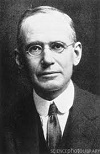
In 1895 English Argonauts, er, scientists John William Strutt, 3rd Baron Rayleigh (1842-1919) and Sir William Ramsay (1852-1916) discover the first "noble" (inert) gas, chemical element Argon (Ar) (#18), isolated from air; Ramsay proves that helium (discovered in the Sun's atmosphere in 1868) exists on Earth in the uranium ore elevite; later it is found that it exists in all radioactive minerals as a result of radioactive decay, which emits alpha particles (helium nuclei). In 1898 the rare gas elements Krypton (Kr) (#36) (1 part in 20M in the atmosphere), Neon (Gr. "new") (Ne) (#10) (1 part in 65K in the atmosphere), and Xenon (Xe) (#54) are discovered by British chemists Sir William Ramsay and Morris William Travers (1872-1961) in liquid air.

In 1895 Russian physicist Konstantin Tsiolkovski (1857-1935) discovers the principle of rocket reaction propulsion - impulse engines, Scotty?

In 1895 Russian-Latvian-German chemist Paul Walden (1863-1957) discovers Walden Inversion, the first Stereoinversion Reaction; in the early 1900s Christopher Ingold finds that it doesn't work with tertiary alcohols, which is solved in the Sept. 12, 2013 issue of Nature by Ryan A. Shenvi et al. of the Scripps Research Inst.

In 1895 Italian Baron Guglielmo Marconi (1874-1937) invents radio telegraphy, with a contraption that can ring a bell a few yards away in his yard in Bologna; next year he travels to London to stir up interest. On June 2, 1896 Marconi receives the first patent for a communication system by means of electromagnetic waves (radio). In 1899 he wows the world by broadcasting the America's Cup race on wireless. On Dec. 12, 1901 he receives the first trans-Atlantic wireless radio message in St. John's, Newfoundland from Cornwall, England: the letter "S" (dot dot dot). Too bad, in 1943 the U.S. Supreme Court rules that all of Marconi's radio patents are invalid, and awards them to Nikola Tesla.
In 1895 G.V. Black standardizes cavity preparation and manufacture of silver fillings.


On Nov. 5, 1895 George B. Selden (1846-1922) of N.Y. is granted a U.S. patent for the gasoline-powered automobile after filing on May 8, 1879; local bank teller George Eastman was used as a witness; in 1899 he sells a license to William Collins Whitney (1841-1904) (U.S. secy. of the Navy in 1885-9), owner of the monopolistic Electric Vehicle Co. (1897-1907), and works to collect a 0.75% royalty from all cars sold by the Assoc. of Licensed Automobile Manufacturers, later founding Selden Motor Vehicle Co.; after Ford Motor Co. is founded in 1903, they take him on in a mammoth 8-year case that generates 14K case pages, and Selden wins, but Ford wins the appeal on Jan. 10, 1911 because his engines are based on the 1876 German Otto Engine, not the 1872 Brayton Engine of R.I. inventor George Brayton (1830-92).

In 1895 the roll-operated Pianola is invented by Edwin Votey (1856-1931) of Detroit, Mich.

In Apr. 1896 Swedish chemist Svante August Arrhenius (1859-1927) pub. On the Influence of Carbonic Acid in the Air upon the Temperature of the Earth, which first describes the effect of CO2 in raising atmospheric temps via the greenhouse effect, calculating the effect of a doubling of atmospheric carbon dioxide (CO2) to be an increase in surface temp of 5C-8C, while a halving of it would produce a new ice age; "If the quantity of carbonic acid increases in geometric progression, the augmentation of the temperature will increase nearly in arithmetic progression"; in 1906 he pub. The Probable Cause of Climate Fluctuations, amending his views, lowering his estimates to 1.6C-3.9C and considering increased CO2 to be beneficial.

In 1896 French physicist Antoine Henri Becquerel (1852-1908) (grandson of Antoine Cesar Becquerel) discovers radioactivity after wrapping a photographic plate in black paper, placing a thin crystal of a uranium salt on the paper and finding that the developed plate is darkened where radiations from the uranium strike it; he finds that the radiation can also pass through aluminum and copper sheets - peeking under God's didies?
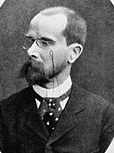
In 1896 French chemist Eugene-Anatole Demarcay (1852-1903) discovers the hard silvery metallic element Europium (Eu) (#63) in samples of samarium, taking until 1901 to isolate it; meanwhile in 1898 he uses spectroscopy to confirm that Marie Curie has discovered the element radium.


In 1896 Belgian mathematician Charles Jean Gustave Nicolas Baron de la Vallee Poussin (Charles-Jean Étienne Gustave Nicolas Le Vieux, Baron de la Vallée Poussi) (1866-1962) and French mathematician Jacques-Salomon Hadamard (1865-1963) independently prove the Prime Number Theorem, that all natural numbers are the product of one or more primes.

In 1896 German physicist Wilhelm Wien (1864-1928) pub. Wien's Displacement Law, that the wavelength of the peak of the emission of a black body is inversely proportional to its temperature, with the constant of proportionality being approx. 3 mm-K, winning him the 1911 Nobel Physics Prize; for the Sun (surface temp 6,000K) the wavelength is 500 nm (middle of the range of visible light), for the human body (300K) it's .01 mm (far infared), and for the Cosmic Microwave Background (3K) it's 1mm (microwave region); the law breaks down at long wavelengths, giving Max Planck his big idea for quantum theory in 1900.

In 1896 Scottish physicist Charles Thompson Rees Wilson (1869-1959) invents the principles behind the Cloud (Wilson) Chamber, which uses air saturated with water vapor to expose the tracks of ionizing radiation; he constructs the first one in 1911, and receives the Nobel Prize in 1927.


In 1896 Dutch physicist Hendrik Antoon Lorentz (1853-1928) and his student Pieter Zeeman (1865-1943) discover the Zeeman Effect, the splitting of an electromagnetic spectrum line in a moderately strong magnetic field into 2-3 polarized lines (normal effect) or many polarized lines (anomalous effect); Lorentz supplies the theoretical interpretation, and both win the 1902 Nobel Physics Prize.

In 1896 Cornell U. co-founder Andrew Dickson White (1832-1918) pub. A History of the Warfare of Science with Theology in Christendom (2 vols.), which became popular and won the argument with the public. based on his 1869 lecture "The Battle-Fields of Science"; "In all modern history, interference with science in the supposed interest of religion, no matter how conscientious such interference may have been, has resulted in the direst evils both to religion and to science, and invariably; and, on the other hand, all untrammelled scientific investigation, no matter how dangerous to religion some of its stages may have seemed for the time to be, has invariably resulted in the highest good both of religion and of science."

On June 4, 1896 Henry Ford (1863-1947) makes his first successful pre-dawn test-drive of his horseless carriage Quadricycle on the streets of Detroit, Mich.; meanwhile Charles B. King manufactures the first automobile in Detroit.

On May 17, 1897 County Clare, Ireland-born engineer John Philip Holland (1841-1914) and his Holland Torpedo Boat Co. of Elizabethport, N.J. launch the USS Holland (SS-1) (originally the Holland VI), a submarine with internal combustion engines for surface operation and electric motors for undersea operation, selling it to the U.S. Navy, becoming the first sub they formally commission; on Feb. 7, 1899 new owner Isaac Leopold Rice renames it the Electric Boat Co.; Holland resigns in Apr. 1904, after which the co. get into a scandal by selling submarines to the Japanese as well as the Russians, British, and Dutch; after WWII ends in 1945, the co. workforce shrinks from 13K to 4K by 1946; in 1946 it buys Canadair from the Canadian govt. for $10M, going on to win defense contracts from the Canadian govt.; on Apr. 24, 1952 it reorganizes as General Dynamics; in Mar. 1953 it purchases Convair, makers of the Atlas ICBM, becoming the #4 defense contractor on Earth by 2010.
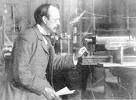
In 1897 the discovery of the electron (the first subatomic particle) and the similarity of its motion to visible light is first described by English physicist Sir J.J. (Joseph John) Thomson (1856-1940), who experimentally determines the ratio of its mass to its charge, making him "the Father of the Electron"; he has been dir. of the Cavendish Laboratory at Cambridge U. (founded 1874) since 1894, and it goes on to generate 14 Nobel Prize winners, who discover the atomic nucleus, cloud chamber, and atom smasher. In 1908 Hans W. Geiger and A. Marsden, under the direction of Ernest Rutherford aim alpha particles at thin foils, disproving J.J. Thomson's model of the atom (electrons moving in "a sphere of uniform positive electrification") when a small percentage (1 in 8K) of the particles is scattered at an angle of 90 degrees; "It was about as credible as if you had fired a 15-in. shell at a piece of tissue paper and it came back and hit you" (Rutherford, 1936). In 1910 J.J. Thomson deflects "positive rays" (alpha particles) in a magnetic field. Cavendish Lab is the place for nerds to be? In 1919 Ernest Rutherford becomes dir. of the Cavendish Lab at Cambridge U., and uses alpha particles to bombard nitrogen molecules in air, transmuting them into oxygen and hydrogen; the ancient dream of alchemists is achieved, proving that the atom is not the ultimate building block of the Universe? In 1919 J.J. Thomson pub. a paper laying the foundation of the modern theory of atomic structure, postulating the existence of an atomic "nucleus" (a term he coins next year), where all the positive charge is concentrated in a small region.


In 1897 German chemist Eduard Buchner (1860-1917) observes bubble formation in sugar-filled yeast extract in experiments of his bacteriologist brother Hans Ernst August Buchner (1850-1902), and breaks up yeast cells with hundreds of atmospheres of pressure, fine quartz sand, and filter paper and still obtains fermentation, laying to rest Pasteur's theory that only living yeast cells can do it, discovering zymase, the first enzyme, and later receiving the 1907 Nobel Chem. Prize.

In 1897 Am. physicist Amos Emerson Dolbear (1837-1910) pub. Dolbear's Law, that a male (snowy) cricket chirps a number of times in 15 sec. equal to the temp in Fahrenheit minus 40 (e.g., 30 times at 70F).

In 1897 German pharmacologist-chemist Arthur Carl Wilhelm Heffter (1859-1925) isolates Mescaline, the hallucinatory agent in peyote cactus, and becomes the first "psychonaut", willing to test the stuff on himself.

In 1897 English biochemist Sir Frederick Gowland Hopkins (1861-1947) proves that a lack of vitamins causes disease, winning him the 1929 Nobel Med. Prize along with Christiaan Eijkman, while the real discoverer, Polish biochemist Casimir Funk is snubbed - that's what I tell my wife?

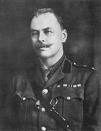
In 1897 after Scottish physician Sir Patrick Manson (1844-1912) suggests the hypothesis, Indian-born English physician Sir Ronald Ross (1857-1932) discovers in Secunderabad, India that malaria isn't caused by breathing bad air, but by a parasite (bacillus) transmitted by the Anopheles (Gk. "useless") mosquito, which he finally isolates on Aug. 21 after having one bite patient Hussain Khan, then using birds to trace out its life cycle, winning him the 1902 Nobel Med. Prize.


In 1897 Yerkes Observatory in Williams Bay, Wisc., designed by Chicago, Ill.-born astronomer George Ellery Hale (1868-1938), and financed by streetcar magnate Charles Tyson Yerkes (1837-1905) begins operation, with the largest refracting telescope on Earth, a whopping 40 in.

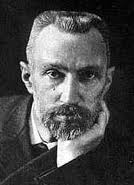
In 1898 Polish-born French brain babe Marie Curie (1867-1934) coins the term "radioactivity"; she and her hubby Pierre Curie (1859-1906) discover the radioactive elements Radium (Ra) (#88) (named after radioactivity) (Dec. 21) and Polonium (Po) (#84) (named after her native Poland) in pitchblende from the St. Joachimsthal mines in Bohemia, winning them the 1903 Nobel Physics Prize; early medical uses found for radioactivity in cancer treatment cause it to be billed as a fountain of youth until its cancer-causing power is discovered; too bad, she dies on July 4, 1934 of leukemia caused by overexposure to radiation, and her lab has to be torn down brick by brick and her papers banned for half a cent. as too dangerous to handle without signing a medical release.

In 1898 German physicist Friedrich Ernst Dorn (1848-1916) of Halle discovers radioactive noble gas Radon (Rn) (#86) as a gas given off by radium, becoming the 3rd radioactive element discovered after radium and polonium.

In 1898 German gunsmith Wilhelm Brenneke (1865-1951) invents the Brenneke Slug, the first modern shotgun slug.
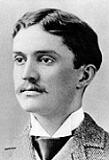
In 1898 Washington, D.C.-born engineer Edson Fessenden Gallaudet (1871-1945), son of Gallaudet U. founder Edward Miner Gallaudet builds a kite with the first warping-wing mechanism, going on to found the Gallaudet Engineering Co. in Norwich, Conn. in 1908, which test-flies an all-metal aircraft at Wright Field on June 20, 1923 before selling its assets in 1924.

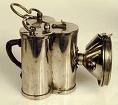

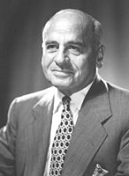

On Jan. 10, 1899 Russian New York City immigrant (1891) Conrad Hubert (Akiba Horowitz) (1856-1928) of the Am. Electrical Novelty and Manufacturing co. patents a clover-leaf bicycle flashlight (#617, 592), changing the name in 1905 to Am. Ever Ready Co.; in 1914 it merges with the Nat. Carbon Co., shortening the trademark to Eveready; in 1917 it merges wth Union Carbide to form the Union Carbide and Carbon Co., using the trademark "DAYLO" for flashlights and batteries until 1921; in 1958 it introduces the Eveready Alkaline Battery, which on Mar. 1, 1980 is renamed the Energizer, with the Energizer Bunny ad campaign helping it reach a 52% market share by 1986, when the battery products div. is acquired by Ralston Purina Co., becoming the Eveready Battery Co. Inc., which is spun-off in 2000 as Energizer Holdings Inc.; meanwhile Hubert's partner Joshua Lionel Cowen (1877-1965) (who invented the flashlight for illuminating a flower pot and sold it to him) patents a device for igniting a photographer's flash, patents a device for igniting a photographer's flash, and in 1900 founds Lionel Corp. to market toy trains (until 1993).

In 1899 Norwegian scientist Kristian Olaf Bernhard Birkeland (1867-1917) leads the Norwegian Polar Expedition (ends 1900), which makes the first measurements of ground magnetic fields. In 1913 he proposes that space is filled with plasma; in 1916 he proposes that solar wind particles come in both polarities (protons and electrons); in 1919 Frederick Lindemann of Britain independently proposes it.

In 1899 French chemist Andre Louis Debierne (1874-1949) discovers the radioactive element Actinium (#89) (Ac) in pitchblende, in which it occurs in the proportion of 1 part per 5B; it is discovered independently in 1902 by Friedrich Oskar Giesel (1852-1927) in Germany, which he calls emanium.



In 1899 Austrian physician Sigmund Freud (1856-1939), who coined the term "psychoanalysis" in 1896 pub. The Interpretation of Dreams (Traumleutung), launching a scientific craze-cult, which goes on to this day; he gets a whopping $200 for it - not enough porno in it to pay more? In 1905 he pub. Three Contributions to the Theory of Sex, which links sex to anxiety, and claims that childhood experiences determine sexual orientation - shocks the Victorianism out of readers? In 1907 Austrian-born Am. psychiatrist Abraham Arden Brill (1874-1948) performs tests with Carl Jung at the Zurich Psychiatric Clinic which corroborate the theories of Sigmund Freud (1856-1939), also of Zurich; next year Brill returns to the U.S., becoming the first to introduce Freudian psychoanalysis to the U.S. In 1912 Carl Gustav Jung (1875-1961) pub. Psychology of the Unconscious (Wandlungen und Symbole der Libido), breaking with Freud.

On Oct. 19, 1899 17-y.-o. Worcester, Mass.-born New England teenie Robert Hutchings Goddard (1882-1945), fresh from reading H.G. Wells' 1895 novel "The War of the Worlds" climbs a cherry tree and gets his big inspiration to "make some device which had even the possibility of ascending to Mars", and devotes his life to making rockets, calling Oct. 19 his "anniversary day" - Millennium Fever works in reverse on a sci-fi fan? Right ideas, wrong world war? In 1914 he patents the Multi-Stage Rocket, and a rocket fueled with gasoline and liquid nitrous oxide. On Nov. 9, 1918 he demonstrates the first Bazooka at Aberdeen Proving Ground in Md. two days before the signing of the Armistice.


In 1899 Am. electrical engineer Robert Bowie Owens (1870-1940) and English physicist Ernest Rutherford (1871-1937) discover radioactive gaseous element radon (Rn) (#86) and alpha rays. Inn 1906 Rutherford in Canada observes that alpha particles are scattered when passing through a thin sheet of metal, but he doesn't carry the experiment further to determine how much. In 1921 Ernst Rutherford and James Chadwick disintegrate all the known elements except carbon, oxygen, lithium, and beryllium in an attempt to split the atom.

In 1899 Austrian mathematician Georg Alexander Pick (1859-1942) pub. the cool Pick's Theorem, giving the area of a simple lattice polygon as the number of interior points plus half the number of boundary points minus 1 for burgers.

In 1899 Boston, Mass.-born astronomer William Henry Pickering (1858-1938) discovers Saturn's 9th moon Phoebe; in 1905 claims to discover its 10th moon Themis, which later turns out not to exist.

In 1899 Danish engineer Valdemar Poulsen (1869-1942) invents the first magnetic tape recorder, the steel-wire drum Telegraphone (U.S. patent #661,619).
In 1900 there about 1K physicists in the world, of which one-fourth are in the U.S. (the most).
In 1900 Swiss metallurist J.A. Brinell (1849-1925) proposes the Brinell Hardness Test, pressing a small chromium steel ball into a specimen and measuring the diam. of the indentation.

In 1900 French psychologist Emile Coue (Coué) (1857-1926) begins studying hypnotism, soon coming up with a new technique he calls Conscious Autosuggestion, where the patient keeps repeating the soundbyte "Every day in every way I am getting better and better" (Tous les jours a tous points de vue je vais de mieux en mieux) - I pledge to watch football only 6 days a week?

In the early 1900s Am. neurosurgeon Harvey Williams Cushing (1869-1939) develops basic modern brain surgery techniques.

In 1900-1 Austrian-born Jewish-Am. scientist Karl Landsteiner (1868-1943) discovers A-B-AB-O blood grouping based on the presence of agglutinins, winning him the 1930 Nobel Med. Prize. In 1909 he, Constantin Levaditi (1874-1953) of Romania, and Erwin Popper (1879-1955) of Austria discover the Polio Virus.

In 1900 French mathematician Henri Leon Lebesgue (1875-1941) formulates the Mathematical Theory of Measure, followed by the Lebesgue Integral (1902-4).

In 1900 French chemist Francois Auguste Victor Grignard (1871-1935) pub. the Grignard Reaction, using magnesium-containing Grignard reagants to add a carbonyl group to an aldehyde or ketone, forming carbon-carbon bonds, winning him the 1912 Nobel Chem. Prize.

In 1900 German chemist Friedrich Wilhelm Ostwald (1853-1932) discovers the Ostwald-Brauer Process (patented in 1902) for oxidizing ammonia to prepare nitric acid for explosives, which Germany uses in WWI to beat the Allied blockade of nitrates.


In 1900 English physicist John William Strutt, 3rd Baron Rayleigh (1842-1919) pub. the Rayleigh-Jeans Law (improved by Sir James Jeans in 1905), claiming that the spectral radiance (emission at a single frequency) of a "black body" (perfect absorber of radiation, radiating an amount equal to that which it is absorbing) is proportional to the frequency to the fourth power, which heads toward infinity as the frequency approaches infinity, causing the Ultraviolet Catastrophe, the prediction that a black body emits radiation with infinite power; on Oct. 19 after ruminating not on that but on why Wien's 1896 Displacement Law breaks down at low frequencies, German physicist Max Planck (1858-1947) announces to the Berlin Physical Society his revolutionary Planck's Radiation Law, proposing the (Old) Quantum Theory to account for the radiation from a black body, explaining that it is emitted in discrete quanta, each being of an energy value equal to Planck's constant h times the frequency, and violating the ancient maxim "Natura non facit saltum" (Nature doesn't make jumps); as he can't explain the meaning of his new constant, he delves into atomic theory to try and find a clue; meanwhile herr Wilhelm Wien proposes the formula E = (3/4) * M * C^2 for the relation between electromagnetic mass and electromagnetic energy - don't complain about the wienie in your neighbor's eye when you have a planck in your own?



In 1900 U.S physician Walter Reed (1851-1902) of the Army Medical College in Washington, D.C. heads a commission sent to Cuba to investigate the cause and transmission of yellow fever, and discovers that it is transmitted by the mosquito Aedes aegypti, just like old Carlos Finlay had claimed back in 1881, allowing William Crawford Gorgas (1854-1920) to virtually eliminate the disease from Havana within 3 mo.; meanwhile four people, incl. U.S. physician James Carroll (1854-1907) allow themselves to be infected to help research treatment; the idea that insects cause disease still finds little public acceptance?
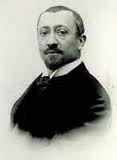
In 1900 French physicist Paul Ulrich Villard (1860-1934) discovers Gamma Rays (energies above 100KeV).
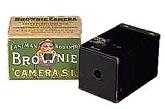
In Feb. 1900 the $1 Kodak Brownie camera is introduced, featuring a simple meniscus lens that takes 2.25 in. square pictures on 117 roll film; "You push the button, we do the rest"; named after the Palmer Cox cartoons.

In 1901 Bavarian-born German psychiatrist Alois Alzheimer (1864-1915) of Frankfurt discovers Alzheimer's Disease after patient Auguste Deter (1850-1906) tells him "I have lost myself" - old timer's disease?

In 1901 Russian physiologist Ivan Petrovich Pavlov (1849-1936) develops the concept of the conditioned reflex using his salivating dogs.
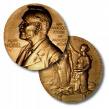







On Dec. 10, 1901 (St. Lucia's Day) (5th anniv. of Alfred Nobel's death) (4:30 p.m.) the first Nobel Prizes are awarded in the Stockholm Concert Hall after a rehearsal; Red Cross founder Jean Henri (Henry) Dunant (1828-1910) of Switzerland and Frederic Passy (1822-1912) of France win the first Nobel Peace Prize (done that, it's passe?); Rene Francois Armand Sully Prudhomme (1839-1907) of France wins for Literature; 6 of the first 9 lit. winners wear beards (Giosue Carducci's is the most bristly and pointy); Wilhelm Konrad (Conrad) Roentgen (Röntgen) (1845-1923) of Germany wins for Physics [X-rays]; Jacobus Henricus van't Hoff (1852-1911) of the Netherlands wins for Chemistry [stereochemistry], and Emil Adolph von Behring (1854-1917) of Germany wins for Medicine and Physiology (antitoxins); the first Nobel Prize Medals (23-carat, 2.5 in. diam., .25 kg), designed by Swedish artist Erik Lindberg (1873-1966) are minted next year, with a bas-relief of Alfred Nobel on the obverse, and Isis and the genius of Science (lifting a veil from her face) on the reverse; women only get 34 of the first 800?
TLW's Nobel Prizes Historyscope

In 1901 the amino acid Tryptophan (found in turkey meat) is discovered by English biochemist Frederick Gowland Hopkins (1861-1947).

In 1901 the hormone Adrenalin is first isolated and patented by Japanese-born. "samurai chemist" Jokichi Takamine (1854-1922) of the U.S., becoming the first purified animal gland hormone.
In 1901 German scientist Richard Fiedler invents the modern Flamethrower (Flammenwerfer) for the German army.
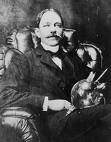
In 1901 Am. engineer Peter Cooper Hewitt (1861-1921) invents the Mercury Vapor Lamp.

In 1901 German scientist Adolf Miethe (1862-1927) invents Panchromatic Film for a 3-color camera he designs, which is built in 1903 by Wilhelm Bermpohl.

On Aug. 14, 1901 Bavarian-born Gustave Albin Whitehead (Gustav Albin Weisskopf) (1874-1927) makes the first powered flight in his No. 21 aircraft in Fairfield, Conn., flying 0.5 mi. and reaching 50 ft. alt.; historians later dispute it and give the credit to the Wright Brothers. On June 5, 2013 the Conn. Senate passes a bill officially recognizing him as the first to fly.

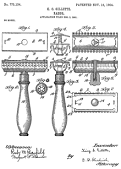
On Sept. 28, 1901 after spending seven years inventing the $5 Gillette Safety Razor, with disposable wafer-thin stamped slivers of cheap steel held in a safety clamp, Crown bottle cap salesman King Camp Gillette (1855-1932) founds Am. Safety Razor Co., changing it next July to Gillette Safety Razor Co.; his first sale (1903) is 51 straight razors and 168 blades; in 1904 sales zoom to 90K razors and 1.24M blades.
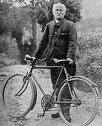
In 1901 French bicyclist Paul de Vivie (1853-1930) AKA Velocio begins perfecting the Derailleur (which may have already existed in Britain?), causing him to become known as the Father of Bicycle Touring.




On Jan. 16, 1902 the existence and function of hormones are discovered by English physiologist Ernest Henry Starling (1866-1927) of University College, London; Starling and English physiologist Sir William Maddock Bayliss (1860-1924) discover the hormone secretin; Am. geneticist Walter Stanborough Sutton (1877-1916) and German biologist Theodor Heinrich Boveri (1862-1915) independently (via work with sea urchins) propose the Boveri-Sutton Chromosome Theory that chromosomes contain genetic info.; Sutton coins the term "gene"; Boveri theorizes that a cancerous tumor starts with a cell that gets its chromosomes scrambled; also in 1902 Bayliss discovers the Bayliss Effect (Myogenic Response), whereby blood vessels contract or distend based on blood pressure to create an autoregulation mechanism.

In 1902 French meteorologist Leon Teisserenc de Bort (1855-1913) uses instrumented balloons to discover a point in Earth's atmosphere at about 40K-50K ft. (0.1 bar) where the air stops cooling and begins growing warmer, which he calls the Tropopause, also coining the terms Stratosphere for the layer above and Troposphere for the layer below (down to ground level).


In 1902 English physicist Oliver Heaviside (1850-1925) and Am. electrical engineer Arthur Edwin Kennelly (1861-1939) independently discover the Kennelly-Heaviside Layer (E-Layer) of the Earth's atmosphere, which conducts radio waves, theorizing that it's caused by ionized gas - from the dog kennel to heaven's side?

In 1902 French physician Charles Robert Richet (1850-1935) discovers Anaphylaxis, winning him the 1913 Nobel Med. Prize.



In 1902 the first Tyrannosaurus Rex (T-Rex) skeleton is discovered in Hell Creek, Mont. by fossil hunter Barnum Brown (1873-1963), and housed in the Carnegie Museum of Nat. History in Pittsburgh, Penn.; Henry Fairfield Osborn (1857-1935) makes the First Drawing of a T-Rex - and his boy was named Sue?
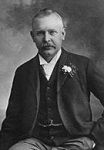
On Feb. 15, 1902 British inventor Daniel "Dan" Albone (1860-1906) files a patent for the first commercially successful gasoline-powered farm tractor, forming Ivel Agricultural Motors Ltd. and selling them for £300 and building 500; in 1903 Charles W. Hart and Charles H. Parr begin marketing a 2-cylinder gasoline engine tractor in Charles City, Iowa, dooming the 20M horses and mules on U.S. farms to obsolescence over the next 20 years.

In 1902 French chemist-physicist-engineer ("the Edison of France") Georges Claude (1870-1960) invents the Neon Lamp; true neon signs are only red; the first neon sign is introduced in France in 1910; he receives a patent on Jan. 19, 1915.

In 1902 French inventor Arthur Constantin Krebs (1850-1935) invents the Automatic Diaphragm Carburetor to provide a constant air-fuel ratio during acceleration, causing a dramatic improvement in fuel economy. Also in 1902 Frederick W. Lanchester of the U.K. is granted the first patent for hydraulic power steering.


In 1902 Danish engineer Valdemar Poulsen (1869-1942) invents the Poulsen Arc Transmitter, which is widely used in radio until the advent of vacuum tubes.
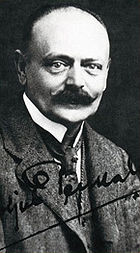
In 1903 Croatian inventor Slavoljub Eduard Penkala (1871-1922) patents the rubber hot water bottle, which calls the "Termofor"; previously they were made of metal or porcelain' in 1906 he invents an improved mechanical pencil, which he calls the automatic pencil, followed in 1907 by the first solid ink fountain pen, founding the Penkala-Moster Co. with entrepreneur Edmund Moster, which becomes one of the world's biggest pen-pencil factories.
In 1903 the Oxyacetylene torch is invented in France by Edmond Fouche and Charles Picard, revolutionizing welding.
In 1903 German physician Carl Joseph Gauss (1875-1957) develops the Freiburg Method of "Twilight Sleep" using a combo of morphine and scopolamine as a surgical anesthesia to replace chloroform during childbirth.
In 1903 Am. horticulturist Hebert John Webber (1865-1946) coins the word "clone" to mean a colony of organisms derived via asexual reproduction from a single progenitor.

Blondlots have more fun? In 1903 French physicist Rene Prosper Blondlot (1849-1930) of the U. of Nancy claims to discover N-Rays, a new form of radiation that causes changes in brightness of electric sparks in spark gaps; by 1905 the idea is rejected by the scientific community after debunking by Am. physicist Robert Williams Wood (1868-1955).
In 1903 German biologist Hermann Henking (1858-1942) discovers and names the X chromosome, identifying it as a sex chromosome in 1903.

In 1903 Hungarian physicist Philipp Lenard (1862-1947) observes that swift cathode rays can pass through metal sheets, proving that a large portion of the atom consists of empty space, winning him the 1905 Nobel Physics Prize.
In 1903 barbiturates (derivatives of barbituric acid) are introduced into medicine in Germany.
In 1903 Dr. Moises Santiago Bertoni discovers the Stevia rebaudiana natural sweetener herb in Paraguay.
In Nov. 1903 Mary Anderson patents the first windshield wiper; it uses a handle inside the car; it takes until 1916 before they become std. equipment on U.S. cars.
In 1903 French chemist Edouard Benedictus invents Laminated Safety Glass after a glass flask coated with cellulose nitrate is dropped; it is first used in gas masks during WWI, and widespread use in autos comes after the war, using an interlayer of polyvinyl butyral (PVB).


In 1903 after his electromagnetic cannon of 1901 proves a dud, Norwegian physicist Kristian Olaf Birkeland (1867-1917) hooks up with Norwegian engineer Samuel "Sam" Eyde (1866-1940) and uses it as the basis of a machine for producing artificial fertilizer; too bad, he is passed over for a Nobel Prize because the device makes money?

In 1903 Willem Einthoven (1860-1927) of Holland invents the heavy-magnet Electrocardiograph, and takes the first electrocardiogram (ECG) (EKG), winning him the 1924 Nobel Med. Prize; he invents Einthoven's Triangle on the chest as the points to attach the leads, along with the PQRST terminology for the various deflections.

In 1903 Ludwig Roselius (1847-1943) of Bremen, Germany invents the first commercially successful decaffeination process.

In 1903 Karl Auer von Welsbach (1858-1929) of Germany patents Lighter Flints, composed of a 70-30 alloy of cerium and iron that give off sparks when struck, becoming popular for cigarette lighters.
In 1903 Richard Adolf Zsigmondy (1865-1929) invents the Ultramicroscope for the illumination of smoke particles, fog droplets, etc., winning him the 1925 Nobel Chem. Prize.



Here kitty kitty kitty? 12 sec. 120 feet? On Dec. 17, 1903 (10:35 a.m.) the Wright Brothers from Dayton, Ohio, incl. Wilbur Wright (1867-1912) and Orville Wright (1871-1948) make the first powered human flight of 120 ft. in 12 (13?) sec. on 90-ft. Kill Devil Hill near Kitty Hawk, N.C. on the Outer Banks (chosen for sand dunes and high winds) in Wright Flyer I, which is made of muslin, wood, and steel, and weighs 605 lb.; the wingspan of a Boeing 747 jumbo jet is 195.7 ft.; prior to this they achieved a 59-ft. flight in Bird of Prey; Orville won the 50-cent coin toss with heads and got to do the flying, after which they take turns; the pilot must crawl between the wings and fly in a prone position while the other opens the throttle of their homemade 12 hp. engine, and they make four flights at low altitudes, taking until 1905 to master controlled flight; later the same day Wilbur ups the record to 59 sec., covering 852 ft.; they had been coming to Kitty Hawk every year since 1900 testing their gliders; the Airplane Waltz is created as a novelty; meanwhile earlier in the year rivals Samuel Pierpont Langley (1834-1906) and Charles Manly (1876-1927) fail in two trials with their piloted plane, and run out of funding; later it is discovered that the plane worked, and was given inadequate room for takeoff - how could they sleep after that?

In 1903 Willem Einthoven (1860-1927) of Holland invents the heavy-magnet Electrocardiograph, and takes the first electrocardiogram (ECG) (EKG), winning him the 1924 Nobel Med. Prize; he invents Einthoven's Triangle on the chest as the points to attach the leads, along with the PQRST terminology for the various deflections.

In 1904 using the Hallwachs Effect of 1888, Julius P.L. Elster (1854-1920) of Germany invents the first practical Photoelectric Cell.

In 1904 English engineer Sir John Ambrose Fleming (1849-1945) becomes the first to use a thermonic (vacuum) tube to generate radio waves.
About 1904 Ford Motor Co. employee Louis Goldenberg of New Brunswick, N.J. invents the electric washing machine.
In 1904 Arthur Korn (1870-1945) of Germany telegraphically transmits the first photographs from Munich to Nuremberg. Lumiere brothers Louis and Auguste develop a 3-color screen process for color photography using dyed starch granules as filters and a photographic emulsion sensitive to the entire visible spectrum.
In 1904 Austrian priest-physicist August Musger (1868-1929) patents the slow-motion effect in films, using a mirrored drum as a synchronization mechanism;
In 1904 David Roberts of Grantham, England patents the continuous track for use on tractors; in 1907 Benjamin Holt of Calif. patents the crawler type tread tractor; in 1914 (WWI) they start out being used to transport artillery, and in 1915 British Lt. Col. Ernest Swinton of the Royal Engineers proposes to the War Office that they should be used in an armored track vehicle that can destroy German guns, which is adopted by Winston Churchill, who calls them "land ships".



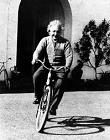

Every time I tried to tell you the words just came out wrong, so I had to tell you in a relativistic song? In 1905 while working in the Swiss Patent Office in Bern, Austria-born Jewish physicist Albert Einstein (1879-1955) has his Miracle Year of 1905, publishing five theoretical physics papers in Annalen der Physik, three of which are key to the development of 20th cent. physics: on the photoelectric effect (going beyond Planck to explain aborption as well as emission of radiation, and deriving the famous equation E = M * C^2, which goes beyond Maxwell and Planck, who showed how energy can be described by Fourier waveforms, and suggests that matter and energy are waveforms that can be mutually transformed), on statistical mechanics, and on the Special Theory of Relativity, which suggests abandoning the idea of absolute time and space by turning the speed (distance of travel divided by elapsed time) of light upside down as the real absolute (which, like Newton's theory, becomes a religious and political lost-shaker-of-salt hot potato because of its revolutionary social implications to some deep thinkers?); he also pub. a theoretical explanation of Brownian motion in terms of atoms, which is experimentally verified by French physicist Jean Baptiste Perrin, ending the dispute over John Dalton's Atomic Theory; he formulates the Relativistic Mirror Gedankenexperiment, claiming that the reflection from a mirror moving close to c would produce bright light pulses in the short wavelength range, which is confirmed in 2013; he incl. his wife Marity's name on the papers and gives her the Nobel Prize money; she really did all the math for him?; for the next five years few read or respond to the articles, until one day the great man himself, Max Planck becomes a groupie and invites him into the club, launching Lazy Eye's meteoric rise through Zurich U., Berlin, his Nobel (for the photoelectric effect, not relativity), and soon I've been everywhere, man, but I still haven't found what I'm looking for, a Unified Field Theory (UFT), AKA the Theory of Everything, a set of five equations attempting to unify electromagnetism and gravity, which he pub. in 1954. On Nov. 25, 1915 Einstein pub. his Gen. Theory of Relativity, stating that a uniform gravitational field is equivalent to a uniform acceleration, and reducing all gravitational physics to 4-dimensional geometry; too bad, atheists and Darwinian evolutionists seize on it and try to make it too general, expanding it to all philosophy, psychology, morals and ethics?; Einstein was actually a plagiarist, stealing "E=MC^2" from an 1903 paper by Olinto de Pretto and another 1904 paper by Friedrich Hasenhorf, the special theory of relativity from an 1878 Encyclopedia Britannica article by James Clerk Maxwell, a 1889 paper by George Fitzgerald, and an 1898 paper by Henri Poincare, the quantum theory from a 1900 paper by Max Planck and Wilhelm Wien, the photoelectric effect from an 1888 paper by Heinrich Hertz, the deflection of the light around the Sun by Sir Isaac Newton ca. 1700, Brownian motion from an 1827 paper by Robert Brown, plus more from an 1801 paper by Johann Georg von Soldner? On May 29, 1919 an eclipse is photographed by two British expeditions, one in Africa and the other in Brazil, the latter manned by English astronomer Sir Arthur Stanley Eddington (1882-1944), and Einstein's Theory of General Relativity is claimed to be confirmed. In 1950 Einstein pub. his General Field Theory; "Time and space and gravitation have no separate existence from matter"; "Physical objects are not in space, but these objects are spatially extended (as fields). In this way the concept 'empty space' loses its meaning... The field thus becomes an irreducible element of physical description, irreducible in the same sense as the concept of matter (particles) in the theory of Newton... The physical reality of space is represented by a field whose components are continuous functions of four independent variables - the co-ordinates of space and time. Since the theory of general relativity implies the representation of physical reality by a continuous field, the concept of particles or material points cannot play a fundamental part, nor can the concept of motion. The particle can only appear as a limited region in space in which the field strength or the energy density are particularly high."



Just upload your catchphrases at Moron.com? In 1905 the Binet-Simon IQ Test is developed by French psychologists Alfred Binet (1857-1911) and Theodore Simon (1872-1961); too bad, to take it you have to speak French, but never fear, in 1908 East Vassalboro, Maine-born God's-gift psychologist Henry Herbert Goddard (1866-1957), dir. (1906-8) of the Vineland Training School for Feeble-Minded Girls and Boys in Vineland, N.J. trans. it into English and distributes 22K copies, introducing the term "mormon", er, "moron" and promoting not only intelligence testing to weed them out, but proposing IQ labels on May 18, 1910 (moron is actually the top of the food chain, with IQ of 51-70, i.e., mental age of 8-12, followed by imbecile at 26-50 and oh no, dumber-than-a-donut idiot at 0-25), then helping write the first U.S. law is founded requiring special segregated education for them in public schools along with the blind and deaf; in 1912 he pub. The Kallikak Family: A Study in the Heredity of Feeble-Mindedness; now listen while I tell you a story about a man named Martin, whose Appalachian descendants get into inbreeding and become "a race of defective degenerates", causing him to call for eugenics programs incl. compulsory sterilization and segregation for the feeble-minded; in 1913 he tests IQs of 172 Euro immigrants on Ellis Island, finding that he correctly matches 80% of feeble-minded immigrants with those classed that way before they left; in 1914 he becomes the first U.S. non-moron psychologist to lend his high IQ to testify in court that being a moron should limit criminal responsibility of defendants; he also utters the unmoronly soundbyte: "Democracy means that the people rule by selecting the wisest, most intelligent and most human to tell them what to do to be happy" - what, me worry, here comes another "There are two kinds of people" messiah - not, since now morons ain't even human (you need a toupee with some brains in it, nyuk nyuk?)

In 1905 French surgeon Alexis Carrel (1873-1944) emigrates to the U.S., going on to develop new methods of suturing blood vessels and grafting veins and arteries. In 1922 he discovers white corpuscles.

In 1905 Italian physician Aldo Castellani (1877-1971) discovers the cause of the infectious tropical disease Yaws (which causes disfiguring raspberry-like skin lesions) as the spirochete Treponema pertenue, which is closely related to the syphilis spirochete.


In 1905 German zoologist Fritz Schaudinn (1871-1906) and German dermatologist Erich Hoffmann (1868-1959) of Germany isolate Spirochaeta pallida, the organism causing syphilis at the Berlin Charite Clinic - too late for superman Nietzsche?


In 1905 German chemist Alfred Einhorn (1857-1917) uses Benzocaine to invent non-addictive Procaine, AKA Novocaine (Novocain) (Lat. "new" + caine meaning alkaloid used for an anesthetic); in 1907 German dentist Heinrich Friedrich Wilhelm Braun (1862-1934) introduces it into dentistry to replace addictive cocaine.

In 1905 Austrian physicist Robert von Lieben (1878-1913) invents the thermionic valve for amplifiers.
In 1905 the Popsicle is invented by 11-y.-o. Frank W. Epperson (1894-1983) of Calif. after leaving a frozen drink out over night with a stirring stick in it; he waits until the 1920s to go in biz with it, originally calling it Epsicle until his kids start calling it "pop's sicle"; it is patented in 1924.

In 1905 Am. novelist Morgan Robertson (1861-1915) pub. The Submarine Destroyer, which describes his invention of the periscope, which he sells to the Holland Submarine Co. for $50K.
In 1905 Rayon yarn is first manufactured through a viscose process. In 1924 the Du Pont Co. introduces Rayon, a synthetic fiber manufactured from the cellulose fiber of natural wood pulp; in 1936 the first colored Hawaiian aloha shirts are produced, proliferating like tropical vines?


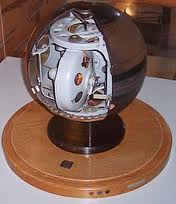
In 1905 Elmer Ambrose Sperry (1860-1930) of the U.S. and Hermann Franz Joseph Hubertus Maria Anschutz-Kaempfe (Anschütz-Kaempfe) (1872-1931) of Germany invent the Gyrocompass; in 1910 Sperry founds the Sperry Gyroscope Co. in Brooklyn, N.Y.; in 1914 Anschutz-Kaempfe sues Sperry for patent infringement and wins.

In 1906 Romanian botanist Aaron Aaronsohn (1876-1919) discovers Triticum diococcoides ("mother of wheat") while on a field trip to Mount Hermon, making him an internat. celeb., which he uses to help him work for the Allies and Zionists in WWI.

In 1906 Am. radiochemist Bertram Borden Boltwood (1870-1927) discovers the element Ionium, and shows it to be chemically identical to thorium, proving the existence of isotopes; in 1907 he uses the decay of uranium to lead to date rocks to ages between 400M and 2.2B years, becoming the first successful use of Radiometric Dating; the Nat. Academy of Sciences officially adopts it in 1926.

In 1906 Am. geologist Clarence Edward Dutton (1841-1912) pub. a theory, based on studies in Hawaii, Calif., and Ore. that volcanism is caused by radioactivity.

In 1906 English biochemist Arthur Harden (1865-1940) discovers cases of catalysis among enzymes, going on to win the 1929 Nobel Chem. Prize.

In 1906-12 German chemist Walter Hermann Nernst (1864-1941) formulates the Third Law of Thermodynamics, that the entropy of a system approaches a constant value as its temperature approaches absolute zero.

In 1906 Italian economist Vilfredo Federico Damaso Pareto (1848-1923) makes the observation that 20% of the pop. owns 80% of the property in Italy, which is generalized as the Pareto Principle.

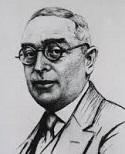
In 1906 Austrian pediatrician Clemens von Pirquet (1874-1929) and Hungarian-born Jewish Am. pediatrician Bela Schick (1877-1967) coin the term "allergy", from the Greek "allos" + "ergon" = other + reaction.


In 1906 the rare earth metal element Lutetium (Lu) (#71) is discovered by French chemist Georges Urbain (1872-1938) after he separates ytterbia (discovered in 1878 by Jean de Marignac) into neoytterbia (ytterbium) and lutecia (lutetium); Karl (Carl) Auer Freiherr von Welsbach (1858-1929) of Germany independently does the same thing, calling them aldebaranium and cassiopeium.

In 1906 German bacteriologist August von Wassermann (1866-1925) devises the Wassermann (Wasserman) Test for pesky syphilis - was up er, man?
In 1906 the ancient site of Hatti is discovered in the village of Bogazkoy (Boghazkeui) (Hattushash) in Turkey 150 mi. S of Sinop, incl. the royal archives containing 10K Hittite cuneiform documents.
In 1906 the Queen Alexandra's Birdwing, largest butterfly in the world is discovered in Papua New Guinea by Albert Stewart Meek (1871-1943), and named next year in honor of Edward VII's wife.
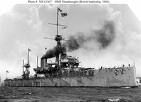

On Feb. 10, 1906 the revolutionary 17.9K-ton 21-knot HMS Dreadnought, the first modern battleship is launched, designed by British top adm. John Arbuthnot "Jackie" Fisher, 1st Baron Fisher (1841-1920) ("the second Lord Horatio Nelson"), featuring 11-in. armor and 10 12-in. guns ("all big-gun battleship"); by May the Germans decide to build six of their own dreadnoughts, voting to widen and deepen the Kiel Canal to allow their passage.
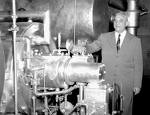
In 1906 Am. engineer Willis Carrier (1876-1950) patents his first cooling system, going to make air conditioning popular and help populate the U.S. Sunbelt.


On Dec. 24, 1906 (Xmas Eve) Canadian-born Reginald Aubrey Fessenden (1866-1932) (the Thomas Edison of Canada?) broadcasts the first radio program consisting of voice and music in Brant Rock, Mass. using a 75 Khz 500 watt Alexanderson High Frequency Alternator designed by Swedish-born engineer Ernst Alexanderson (1878-1975); the transmission is heard as far away as the Caribbean Sea.

In 1906 Am. inventor Lee De Forest (1873-1961) invents the Audion Triode Vacuum Tube, spurring the development of radio. In 1919 he invents the Phonofilm System for recording sound on motion picture film as parallel lines of variable density shades of gray.

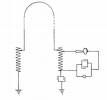
In 1906 Maine-born Am. engineer Jean-Luc Picard, er, Greenleaf Whittier Pickard (1877-1956) discovers the rectifying properties of crystals, causing the first Cat's Whisker Crystal Radio sets to be made, becoming popular by the end of the decade.
In 1906 George Albert Smith (1864-1959) of England invents Kinemacolor, the first successful color motion picture process, using a 2-color additive color process that projects B&W film behind alternating red and green filters; it is used commercially until 1914.

In 1906 Am. race car driver Ray Harroun (1879-1968) develops the spring-mounted automobile bumper.
In 1906 Belgium-born George Constant Louis Washington (1871-1946) of New York City invents Red E Coffee during a trip to Central Am., returning and marketing it in 1909, becoming the first mass-produced Instant Coffee.
In 1906 Ex-Lax (phenolphthalein) begins to be marketed, becoming the first commercial laxative in tablet form; in 1995 studies are pub. linking the active ingredient to cancer in mice.

In 1907 Am. radiochemist Bertram Borden Boltwood (1870-1927) uses the decay of uranium to lead to date rocks to ages between 400M and 2.2B years, becoming the first successful use of Radiometric Dating.


In 1907 English astronomer Sir George Howard Darwin (1845-1912) (son of Charles Darwin) and Am. astronomer William Henry Pickering (1858-1938) speculate that the Moon was created by breaking away from the Pacific Ocean; Pickering also proposes that Am., Asia, Europe, and Africa were once a single continent, and drifted after the Moon separated.

In 1907 German chemist Hermann Emil Louis Fischer (1852-1919) discovers Peptide Chains, consisting of amino acids that fold in three dims. to produce proteins.

In 1907 Irish physicist Arthur William Conway (1875-1950) proposes that spectral lines are created by single electrons, each in an "abnormal state", producing vibrations of a specific frequency, which is later used by Niels Bohr to develop quantum mechanics.

Does the name Pavlov ring a bell? In 1907 a Nobel Prize under his belt for digestion, Ivan P. Pavlov (1849-1936) studies conditioned reflexes with his salivate-on-cue Pavlov's Dogs.
In 1907 the first Blood Transfusion of matched (typed) blood takes place.
In 1907 a single jaw is found in Germany, which scientists decide is a new hominoid species termed Homo heidelbergensis (Heidelberg Man), dating it to -150K, and deciding that it is a direct ancestor of the Neanderthal - meet the Flintstones?

The Age of Plastic begins with something baking? In 1907 Bakelite (pr. BAY-ka-lite), a plastic made out of phenol and formaldehyde, and first sold as a synthetic substitute for shellac is invented and manufactured (baked?) by Leo Hendrik Baekeland (1863-1944), who came to the U.S. in 1889, and invented Velox photographic paper in 1893, and sold his patent to Kodak for $1M; it is so versatile and superior in its chemical, mechanical, and physical qualities that it can be molded into any unbreakable shape, and is a perfect insulator, making possible the first automobile self-starters.

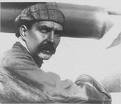


On Sept. 19, 1907 French Nobel Prize winning physiologist Charles Robert Richet (1850-1935) makes a successful ascent of about 2 ft. in a tethered aircraft with four biplane rotors in Douai, France, becoming the first successful helicopter, designed by Louis Charles Breguet (1880-1955) and his brother Jacques Breguet, and named the Gyroplane Laboratoire. On Nov. 13 French aviator Paul Cornu (1881-1944) makes a 6-ft.-high, 20 sec. free flight in a homemade tandem-rotor helicopter in Lisieux.

In 1907 French chemist Eugene Schueller (1881-1957) invents a new hair dye which he calls Aureale, founding L'Oreal (originally Societe Francaise de Teintures Inoffensives pour Cheveux), which grows into a cosmetics giant.

In 1907 Am. janitor James Murray Spangler (1848-1915) invents the "suction sweeper" using an old fan motor, a soap box, broom handle, and pillow case, obtaining a patent next June and founding the Electric Suction Sweeper Co; an early buyer is his cousin, whose hubby William Hoover goes on to purchase the rights from him and found the Hoover Co., starting out offering a 10-day free home trial of its first model, the $125 ($60?) Model O (complete with steel casing, casters, and attachments), and er, sweeping the U.S. market, making "hoover" into a verb, adding a "beater bar" in 1919 (with the slogan "It beats as it sweeps as it cleans"), disposal filter bags in the 1920s, and an upright model in 1926; his son Herbert William Hoover Sr. (1877-1954), who helped all along takes over after the Boss dies.
In 1907 Chicago dentist H. William Taggart adapts the disappearing wax technique of jewelers to the making of accurate gold dental inlays, and later discovers that he had been preceded by 25 years by Dr. Philbrook of Dennison, Iowa.

In July 1907 William Willett (1856-1915) of England pub. the pamphlet The Waste of Daylight, proposing Daylight Savings Time, with clocks advanced by 20 min. at 2 a.m. each Sunday in Apr. for a total of 80 min., then retarded likewise in Sept.; despite Winston Churchill's backing, Parliament rejects it until WWI forces them to reconsider.
In 1907 Persil becomes the first commercially marketed laundry detergent.

In 1908 Japanese scientist Kikunae Ikeda (1864-1936) discovers L-glutamic Acid, the active ingredient in kombu seaweed, whose taste he calls umami, causing its salt monosodium glutamate (MSG) to begin to be used as a flavor enhancer; during WWII the U.S. finds out about it, and it is introduced to the U.S. food industry after the war.

In 1908 Am. astronomer Henrietta Swan Leavitt (1868-1921) discovers the correlation between period of variability and absolute luminosity of star Delta Cepheid, and goes on to confirm the value of all Cepheid variables by 1912, allowing galactic distances to be calculated, after which in 1915 Harlow Shapley uses Cepheid Variables to form a rough size-shape for the Milky Way and the Sun's position within it - allowing male astronomers to rush in to steal her Nobel Prize from Leavitt to Beaver?

In 1908 German mathematician Hermann Minkowski (1864-1909) formulates a 4-dim. geometry, which is later adapted by Albert Einstein for his relativity theory.

On July 10, 1908 the first liquid helium is created by Heike Kamerlingh Onnes (1853-1926) in Leiden, Holland, becoming the last gaseous element to be liquified.

In 1908 Swiss physicist Walther Ritz (1878-1909) follows up the work of Arthur Conway and proposes the Rydberg-Ritz Combination Principle, that the spectral lines of any element incl. frequencies that are either the sum or the difference of the frequencies in two other lines, which is later used by Niels Bohr to develop the idea of quantum numbers; meanwhile he begins the Ritz-Einstein Argument with Albert Einstein over the reversibility of time, and by next year they end up agreeing to disagree before Ritz irreversibly kicks off.
In 1908 Austrian physicist Otto Tumlirz (1890-1957) proves that the Coriolis Force determines the direction of the vortex in a draining liquid only if it is allowed to settle long enough before the plug is pulled.


On Oct. 1, 1908 the Ford Motor Co. of Henry Ford (1863-1947) begins producing the epoch-making Model T Ford (Leaping Lena) (Flivver) (Tin Lizzie, named for a reliable servant) in Dearborn, Mich. (until May 27, 1927), becoming the first affordable automobile, causing them to come rapidly into use by the masses; for $825 you get 20 hp, top speed of 45 mph, and gas economy of 13-21 mpg, with the ability to run on gasoline, kerosene, or ethanol; a trembler coil system replaces expensive magnetos, but requires a starting battery and AC alternator; it sells 10.6K units the first year, with Henry Ford writing the soundbyte in 1909: "Any customer can have a car painted any color that he wants so long as it is black", although they come in grey, green, blue, and red until 1912, then midnight blue with black fenders, finally black-only in 1914, with 30 different types of black paint used; the Model T doubles as a tractor and portable engine for farm use; mass-production lowers the price to $300 by 1926, and 15M are eventually sold; long-distance transportation of passengers and goods are not done by road until 1914; the days of horses and buggies come to a quick end, transforming the entire U.S. On Jan. 14, 1915 after viewing newsreels of people butchering people on an assembly-line basis in Europe, Henry Ford (1863-1947) develops the Assembly Line Method of producing automobiles, using a chain to pull each chassis along at his new Highland Park Ford Plant near Detroit, Mich., known as the Crystal Palace, which becomes the first to use a moving (conveyor belt) assembly line, reducing the time needed to produce a Model T from 1.5 days to 93 min. (sensationalized as "one a minute"), achieving an output of 1K cars a day; on Jan. 5 Ford announces the new 40-hour workweek at a pay of $5 per day, up from $2.34; with Thomas Edison's help he creates the first charcoal Barbecue (BBQ) Briquettes using wood scraps and sawdust from his Model T factory.
In 1908 German housefrau Melitta Benz makes a coffee filter out of her son's notebook paper on June 20, inventing the Drip Coffeemaker.
In 1908 the flat-folded paper Dixie Cup (originally Health Kup) is invented by Boston, Mass. atty. Lawrence Luellen; he begins distributing them on Mar. 23, 1912 with Hugh Moore.

In 1908 after 10 years of research, Swiss chemist and textile engineer Jacques Edwin Brandenberger (1872-1954) patents machinery for manufacturing Cellophane.

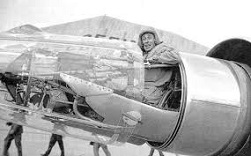
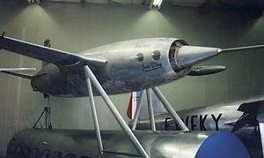
In 1908 French engineer Rene Lorin (1877-1933) patents the Ramjet; it is only good for subsonic speeds, and he never actually succeeds in making one work, allowing French engineer Rene Leduc (1898-1968) to get his supersonic ramjet patented in 1933, building the Leduc 0.10, the first ramjet aircraft, which makes its first flight on Nov. 19, 1946.
In 1908 Eugene Sullivan of Corning Glass Works develops Nonex borosilicate glass for battery jars and lantern globes; in 1913 Pyrex ("pie" as in pie plate + "ex") brand glass is invented by Jesse Littleton of Corning when he uses a cut-down Nonex battery jar for a casserole dish; it is introduced commercially in 1915 to compete with the Duran borosilicate glass of Schott AG in Germany.
In 1908 E.E. Perkins files U.S. patent #7168101 for "sexual armor", a metal-plated unisex chastity belt designed to prevent masturbation in teens and thus lower the nat. rate of "insanity and feeble-mindedness".

In 1908 Scottish engineer Alan Archibald Campbell-Swinton (1863-1930) first proposes using a cathode ray to scan a TV image as an alternative to mechanical scanning devices in the June 18 issue of Nature - I'm givin' the warp engines all she's got, captain?

In 1909 Danish mathematician Agner Krarup Erlang (1878-1929) pub. "The Theory of Probabilities and Telephone Conversations" to describe probabilities of equipment use in the Copenhagen telephone exchange, founding Queueing Theory; he follows it in 1917 with "Solution of Some Problems in the Theory of Probabilities of Significance in Automatic Telephone Exchanges".

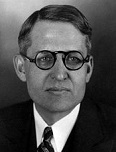
In 1909 Am. physicists Robert Andrews Millikan (1868-1953) and Harvey Fletcher (1884-1981) perform the Millikan Oil-Drop Experiment to establish that electric charge consists of integral multiples of a unit charge; after Fletcher agrees to let him in return for using the results on his 1911 U. of Chicago dissertation (becoming their first student to earn a Ph.D. summa cum laude), Millikan takes all the credit, winning the 1923 Nobel Physics Prize; Fletcher goes on to work at Bell Labs and become "the Father of Stereophonic Sound".
In 1909 Iranian telegraph operator Joseph (Yusef) becomes the first to propose an earthquake early warning system, giving 6 sec.of warning.

In 1909 Dr. Frederick S. McKay (1874-1959) of Colo. Springs, Colo. discovers the concept of water fluoridation to prevent cavities. In 1967 the 20-year Evanston Fluoridation Study in Ill. shows that fluorides in the water supply reduce dental caries by 58%.
In 1909 Oliver P. Smith of St. Louis, Mo. invents the Mechanical Rabbit for greyhound racing.


In 1910-13 British mathematician-philosophers Bertrand Athur William Russell, 3rd Earl Russell (1872-1970) and Alfred North Whitehead (1861-1947) pub. Principia Mathematica, which attempts to reduce arithmetic to logic, founding the calculus of propositions and modern symbolic logic, becoming king locomotive of the county until Godel's Theorem derails them?


In 1910 Danish astronomer-chemist Ejnar Hertzsprung (1873-1967) and Am. astronomer Henry Norris Russell (1877-1957) play around the discovery of Am. astronomer Henrietta Swan Leavitt about Cepheid variables, along with the double stars in the Pleiades, and devise the Hertzsprung-Russell Diagram, which groups stars by absolute magnitude and spectral type, along with a theory of stellar evolution (1911-3) - skinny pants, you can shove it up your butt?


In 1910 Belgian attys. Paul Otlet (1868-1944) and Henri La Fontaine (1854-1943) found the Mundaneum to gather and classify all the world's knowledge using their Universal Decimal Classification based on the Dewey Decimal Classification System, which later leads to the Internet.

About 1910 French chemist Paul Sabatier (1854-1941) discovers the Sabatier Process (Reaction), the reaction of hydrogen with carbon dioxide at high temps (300C-400C) and high pressure in the presence of a nickel catalyst to produce methane and water, winning him the 1912 Nobel Chem. Prize.

On Jan. 13, 1910 Enrico Caruso (1873-1921) sings in the first experimental Radio Broadcast by vacuum tube inventor Lee De Forest in New York City.


In 1910 Sir John Murray (1841-1914) of Canada and Johan Hjort (1869-1948) of Norway undertake the first Deep-Sea Oceanographic Research Expedition in the Michael Sars.
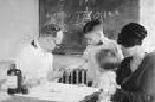
In 1910 Hungarian-born Austrian Jewish pediatrician Bela Schick (1877-1967) develops the Schick Test for susceptibility to diphtheria. In 1928 he begins a massive 5-year campaign in conjunction with the Metropolitan Life Insurance Co. that virtually eliminates diphtheria in the U.S.; in 1928 it attacks 100K Americans and causes 10K deaths; the 85M brochures handed out are created by German-born artist Gerta Ries.
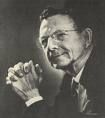
In 1910 Am. chemist William David Coolidge (1873-1975) of G.E. invents the tungsten coil filament light bulb. In 1913 he patents the Coolidge Tube for medical X-rays.

In 1910 Robert von Lieben (1878-1913) of Austria invents the Triode vacuum tube, the key to radio and TV.
In 1910 Am. roller-coaster designer John A. Miller (1872-1941) invents the Safety Chain Dog (Ratchet), which prevents cars from rolling backwards on the lift hill if the pull chain breaks, causing the clacking sound on wooden coasters. In 1919 he patents the Miller Under Friction Wheel (AKA Upstop Wheel), consisting of a wheel running under the track to keep roller-coaster cars from flying off, making exciting drops and turns possible.
The original Planet of the Apes without claiming copyright? In 1911 Piltdown Man, the "missing link" between humans and apes is finally discovered by amateur anthropologist Charles Dawson (1864-1916) in the 50K-y.-o. 10-ft. Piltdown Quarry in Lewes (near Uckfield), East Sussex, England, and dated to the Pliocene and labeled as "Eoranthropus", dated to 500K B.C.E.; oops, after 40+ years it is proved to be a hoax (jawbone of an ape no more than 50K y.o.) in 1953 after ending up in the Farmer's Museum in Cooperstown, N.Y. in 1948; meanwhile desperate anthropologists look to save face (see 1921).

On July 24, 1911 the Incan city of Machu Picchu is discovered by Honolulu, Hawaii-born Yale U. lecturer on South Am. history Hiram Bingham III (1875-1956) of Yale U.; too bad, he loots it of artifacts in 1912-15, causing a cent.-long dispute that is finally settled with their return in 2011.

In 1911 Swiss psychiatrist Paul Eugen Bleuler (1857-1939) ditches Freudian psychoanalysis in favor of organic causes of mental illness, coining the term "schizophrenia" for Gr. "schizein" + "phren" = "split mind" to replace dementia praecox.



In 1911 Polish chemist Casimir (Kazimierz) Funk (1884-1967) coins the term "vitamine" (changed to vitamin in 1920) after reading an article by Dutch physician Christiaan Eijkman (1858-1930) claiming that people who eat brown rice are less vulnerable to beriberi than those who eat white race, er, rice, causing him to isolate vitamin B1, which has an amine group, cogito ero sum; meanwhile English biochemist call-me-sir Frederick Gowland Hopkins (1861-1947) goes on to conduct experiments which discover other vitamins, gaining him and Eijkman the 1929 Nobel Med. Prize.

In 1911 Dutch physicist Heike Kamerlingh Onnes (1853-1926) discovers Superconductivity.

In 1911 after studying the fruit fly Drosophila, Am. biologist Thomas Hunt Morgan (1866-1945) (Doubting Thomas Hunts for More Gain?) of Columbia U. announces his theory of Genes (a word he coined in 1904), and how they are linearly arranged on the chromosome and can be mapped, winning the 1933 Nobel Med. Prize.
In 1911 Francis Peyton Rous (1879-1970) of the U.S. discovers a viral cause of cancer.


In 1911 English physicist Ernest Rutherford (1871-1937) ditches J.J. Thomson's Plum Pudding Model and proposes the Planetary Nuclear Model of the Atom, a small positively-charged nucleus containing most of the mass and orbited by electrons, like the Sun and planets; too bad, classical physics makes its existence impossible, since it would radiate electromagnetic energy until it runs down and the electrons spiral down to the center; John Nicholson of Cambridge U. applies Rutherford's model of the atom to spectra and suggests that quantum jumps take place between definite states corresponding to Walther Ritz's 1908 term values - can you spot what's wrong with this picture, God repeats himself? In 1913 Danish physicist Niels Bohr (1885-1962), who came to England in 1911 to study under J.J. Thomson and Ernest Rutherford uses quantum theory to modify Rutherford's planetary model of the atom in which electrons orbit the nucleus, requiring that the atom only exist in a discrete set of stationary states; it contradicts classical electromagnetic theory but predicts the spectrum of hydrogen, winning him the 1922 Nobel Physics Prize - so I'm loving it?

In 1911 Hugo Gernsback (1884-1967) pub. the article Ralph 124C41+ in Modern Electrics mag., which coins the term "science fiction" (sci-fi).
In the Feb. 1911 issue of Cosmopolitan, Thomas Edison boasts that he could make a 40K-page book 2 in. thick weighing 1 lb. by printing the pages on thin pieces of nickel metal.

In 1911 Am. physicist Robert Hutchings Goddard (1882-1945) of Clark U. in the U.S. patents the first vacuum tube able to amplify a signal.


In 1911 German chemists Fritz Haber (1868-1934) and Carl Bosch (1874-1940) develop the Haber-Bosch Process for synthesizing ammonia on an industrial scale from hydrogen and air, freeing the production of fertilizer and explosives from natural ammonia deposits such as sodium nitrate (calich) (which is monopolized by Chile), and averting global famine, winning Haber the 1918 Nobel Chem. Prize; too bad, brainy Jew Haber, who coulda been a contender stinks himself up by plunging into poison gas research, finding a way to turn science from good to bad - break out my quills I'm going to wax poetic?

In 1911 the Electric Self-Starter for the automobile is invented by GM engineer Charles Franklin Kettering (1876-1958) in Dayton, Ohio (home of the Wright Brothers and other inventors), based on his design of a mechanism for opening cash register drawers; the first is installed on Feb. 17, and he sells 8K of them to Cadillac, "the standard of the world"; within a few years they are standard equipment on all cars, and the days of the dangerous hand crank are over.
In 1911 Arthur Constantin Krebs of France invents elastomeric flexible coupling, AKA the Flector Joint, which is used in the power transmission for his Tracteur Chatillon-Panhard, a 4-wheel drive 4-wheel steering all-terrain truck, used as artillery tractors in WWI.
In 1911 the first parachute jump from an airplane is made by Grant Morton and/or Capt. Albert Berry; Italian inventor Pino invents the pilot or drogue chute, improving on Leonardo da Vinci's original 1495 design.

In 1912 Danish chemist Niels Bjerrum (1879-1958) pub. On the Infared Spectra of Gases showing that infared absoption by molecules is caused by uptake of rotational and vibrational energy in definite quanta, becoming the first correct application of quantum theory to interpretation of spectra.

In 1912 German-Am. anthropologist Franz Uri Boas (1858-1942) reports striking differences in cranial form between U.S.-born children and their Euro-born parents, showing that environment has a large effect on skull shape, shocking the fat-headed racist scientific world.

In 1912 Am. brain surgeon Harvey Williams Cushing (1869-1939) discovers an endocrinological syndrome caused by malfunction of the pituitary gland, which in 1943 is named Cushing's Syndrome.

In 1912 Dutch physicist Peter Joseph William Debye (1884-1966) of the U. of Zurich pub. the Debye Theory of Specific Heat of Solids, which modifies Einstein's theory to threat vibrations of the atomic lattice as phonons in a box instead of non-interacting quantum harmonic oscillators, becoming one of the first theoretical successes of quantum theory.

In 1912 English physicist William Henry Eccles (1875-1966) proposes that solar radiation is responsible for the difference in night and day radio wave propagation.

In 1912 Italian mathematical statistician Corrado Gini (1884-1965) pub. the paper "Variability and Mutability", defining the Gini Coefficient, which is later used as a measure of inequality of income or wealth distribution, as well as biodiversity, with a 0 value indicating a perfectly equal distribution, and a 1 value a perfectly unequal distribution (one individual has it all); too bad, Gini later stinks his name up by claiming to scientifically back up Fascism.

In 1912 Austrian-born Am. physicist Victor Francis Hess (1883-1964) discovers Cosmic Rays with a hot air balloon during a near-total eclipse, measuring rising radiation at rising altitudes despite the Moon blocking most of the Sun's visible radiation, winning him the 1936 Nobel Physics Prize; "The results of my observation are best explained by the assumption that a radiation of very great penetrating power enters our atmosphere from above."


In 1912 German Merck chemist Anton Kollisch (Köllisch) (1888-1916) synthesizes MDMA (Ecstasy) to stop abnormal bleeding; it is patented on May 16, 1914; its potential as a recreational drug is first publicized in 1978 by Russian-Am. chemist Alexander Theodore "Sasha" Shulgin (1925-) of UCB.

In 1912 German physicist Max von Laue (1879-1960) of the U. of Zurich discovers X-ray Diffraction, making it possible to directly observe the atomic structure of crystals, winning him the 1914 Nobel Physics Prize.
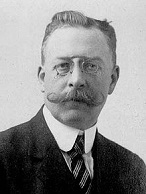
In 1912 French chemist Louis Camille Maillard (1878-1936) pub. the Maillard Reaction between the carbonyl group of sugar and the nucleophilic amino group of amino acid at 140C-165C that gives browned food a desirable flavor.

In 1912 Am. pharmacist Wilbur Lincoln Scoville (1865-1942) devises the Scoville Organoleptic Test and associated Scoville Scale to measure the hotness of chili peppers based on the amount of sugar water needed to dilute away the heat.

In 1912 English radiochemist Frederick Soddy (1877-1956) of the U. of Glasgow coins the term "isotope".

In 1912 German geophysicist Alfred Lothar Wegener (1880-1930) pub. The Origin of Continents and Oceans (Die Entstehung der Kontinente und Ozeane); proposes the theories of plate tectonics and continental drift, and the supercontinent Pangaea - Brazil fits neatly into the Gulf of Guinea in W Africa, so post fit ergo propter fit?

In 1912 Frederick Gardner Cottrell (1877-1948) of the U.S. Bureau of Mines invents the Cottrell Electrostatic Precipitator for removing suspended matter from gases using 50K-75K volts DC.


In 1912 Jason Christian Ellehammer (1871-1946) of Denmak invents the Ellehammer Helicopter, the first helicopter capable of flight, based on C. Renard's articulated rotor blade of 1904 and G.A. Crocco's cyclic pitch control of 1906.
In 1912 the German govt. patents PETN (Pentaerythritol tetranitrate) explosive, the least stable of common military explosives, which lasts longer in storage.
In 1912 German publisher Reclams Universal-Bibliotheck introduces book vending machines in Germany.
In 1912 Franz Reichelt dies after jumping off the first deck (60m) Eiffel Tower in Paris to test his parachute overcoat.

In 1913 German physical chemist Max Ernst August Bodenstein (1871-1942) formulates the concept of the chemical chain reaction - that is what makes this country dynamic?
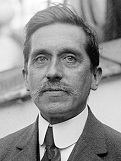
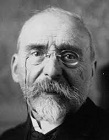
In 1913 after the spectrum of radiation from the Sun is found to be blocked 97%-99% at 200nm-315nm in the ultraviolet end, French physicists Maurice Paul Auguste Charles Fabry (1867-1945) and Henri Buisson (1873-1944) discover the Earth's Ozone Layer, located at 12-19 mi. (20-30km) above the surface, containing 10 ppm of ozone (O3), compared to 0.3 ppm for the rest of the atmosphere.
In 1913 Boskop Man, a hominid with a brain 30% larger than modern humans is discovered in South Africa by Frederick William FitzSimons (1870-1951), reversing the theory of evolution by showing apparent devolution of human IQ over the last 10K-30K years.
In 1913 Bucharest-born psychatrist Jacob Levy Moreno (Iacob Levy) (1889-1974) pioneers Group Psychotherapy (Therapy) in Vienna, which evolves into Psychodrama and Sociometry; in 1921 he conducts the first large scale public Psychodrama session in the Komedienhaus in Vienna, moving to New York City in 1925; he later tells about a 1912 encounter with Freud: "I attended one of Freud's lectures. He had just finished an analysis of a telepathic dream. As the students filed out, he singled me out from the crowd and asked me what I was doing. I responded, 'Well, Dr. Freud, I start where you leave off. You meet people in the artificial setting of your office. I meet them on the street and in their homes, in their natural surroundings. You analyze their dreams. I give them the courage to dream again. You analyze and tear them apart. I let them act out their conflicting roles and help them to put the parts back together again.'"
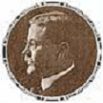

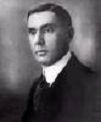
In 1913 Yale U. biochemists Thomas Burr Osborne (1859-1929) and Lafayette Benedict Mendel (1872-1935) isolate fat-soluble Vitamin A in butterfat and water-soluble Vitamin B in milk; discovered independently by U. of Wisc. biochemists Marguerite Davis (1887-1967) and Elmer Verner McCollum (1879-1967) (known for establishing the first colony of white lab rats in the U.S.), who gives them the letter names and refuses to their being called vitamins (vitamines) because they're not any more vital than other nutrients and are not true amines; he later refuses to take vitamin supplements; in 1922 he discovers Vitamin D.

In 1913 boyish-looking English physicist Henry Gwyn Jeffreys Moseley (1887-1915) discovers Moseley's Law, a relationship between X-ray spectra and atomic number, convincing the last skeptics of the atomic theory; too bad, he ends up KIA in Gallipoli in 1915, costing him a Nobel Prize and causing the British and other govt. to quit allowing their precious scientists to enlist for combat duty.
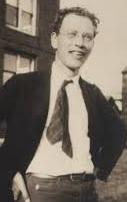
In 1913 Am. geneticist Alfred Henry Sturtevant (1891-1970) constructs the first genetic map of a chromosome after determining that they are arranged in a linear fashion like beads on a necklace, with each gene in a fixed location (locus).

In 1913 German chemist Richard Willstatter (Willstäter) (1872-1942) uses chromatography to discover the composition of chlorophyll.



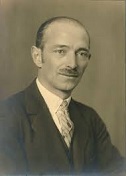
In 1913 the dense silver-gray radioactive metallic element Protactinium (Pa) (#91) (protoactinium until 1949) (naturally occurring in pitchblende) is discovered at the lab of Ernest Rutherford in Manchester, England by Polish chemist Kasimir (Kazimierz) Fajans (1887-1975) and German chemist Oswald Helmuth Goehring (Göhring) (1889-1915), who call it brevium because of its short half-life; in 1917 German physicists Otto Hahn (1879-1968) and Lise Meitner (1878-1968) discover a more stable isotope, and give it the name proto-actinium, which is changed to protoactinium in 1949 by IUPAC, meaning parent of actinium; it becomes a product of nuclear reactors, but has no known uses; in 1915 Scottish chemist John Arnold Cranston (1891-1972) discovered the most stable isotope, but delayed announcement after being called into military service for WWI.

In 1913 German chemist Friedrich Karl Rudolf Bergius (1884-1949), student of Fritz Haber and Carl Bosch develops the Bergius Process, which hydrogenates lignite coal to produce oil for use as synthetic fuel, winning him the 1931 Nobel Chem. Prize; he later develops a process for converting wood into sugar.

On Aug. 13, 1913 the first Stainless (Chrome) Steel is created by Harry Brearley (1871-1948) in Sheffield, England.

In 1913 Am. psychologist John Broadus Watson (1878-1958) coins the word "Behaviorism", the rejection of the concept of mind and consciousness - no wonder it's like a party in here?
In 1913 Sir George Alfred Julius (1873-1946) of Australia invents the Tote Board (Automatic Totalisator) for Parimutuel Betting at horseraces; the first installed at Ellerslie Racecourse in Auckland, New Zealand; it is introduced into the U.S. in 1929 at Hialeah Park in Fla., turning the failing industry around.
In 1913 Oakland inventors devise the formula for household bleach, and found the Clorox Co.

In 1913 German physicist Johannes Wilhelm "Hans" Geiger (1882-1945) invents the cool-sounding Geiger Counter for alpha rays. In 1928 Geiger and his asst. Walther Mueller (Müller) (1905-79) of Germany invent the Geiger-Mueller Tube for measuring ionizing radiation (beta particles and gamma rays).
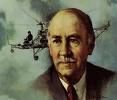
In 1913 Ukrainian-born aviator Igor Ivanovich Sikorsky (1889-1972) designs Le Grand, the first 4-engine (multiengine) airplane.
In 1913 Brillo Pad ("bright", "shining") steel wool soap pads are patented to clean aluminum pots and pans, which blacken easily over coal fires.
In 1913 the $900 Domelre ("domestic electric refrigerator"), the first electric refrigerator, invented by Fred Wolf is marketed in Chicago, Ill.; too bad, it's so inefficient that buyers place it on top of their iceboxes, and it only sells 40 units in two years; it is mainly used to refrigerate blood for transfusion?

In 1913 Swedish-born engineer Otto Frederick Gideon Sundback (1880-1954) of Hoboken, N.J. in Dec. invents the modern Zipper, which he calls the "separable fastener", and is later called "zipper" by B.F. Goodrich; he receives a patent in 1917; it is initially only used for boots and tobacco pouches, and doesn't officially beat the button for men's trousers until 1937 - millions of penises and scrotums are waiting to get caught?
In 1913 techniques for welding steel pipe sections are developed, making large scale pipelines possible.




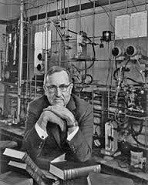
On Aug. 4, 1914 - Nov. 11, 1918 the horrific World War I causes 15M deaths and 39M military casualties. and destroys the Old Order of white formerly Christian Europe. On Feb. 26-28, 1915 the Germans first use a Flamethrower (Flame Projector) in the village of Douaumont, France near Verdun, becoming the first of 653 flamethrower attacks in the war. On Apr. 1, 1915 French aviator Roland Garros (1888-1918) becomes the first pilot to shoot down an aircraft using a deflector gear, which allows shooting through the propeller; after more Vs against German aircraft on Apr. 15 and Apr. 18, he is shot down and the Germans capture his plane, after which Dutch designer Anthony (Anton Herman Gerard) Fokker (1890-1939) clones then improves the deflector gear into the synchronization (interrupter) gear, mounting them on the new Fokker E.I. in Aug., beginning the Fokker Scourge (Scare) as they shoot down nearly every enemy aircraft they encounter and generate the first German aces, incl. Max Immelmann (1890-1916); next year the French counter with the Nieuport 11 Bebe (Bébé), in which the gun is mounted on the top wing clear of the prop, and the British with the Royal Aircraft Factory F.E.2b and Airco DH.2 (Feb. 1916), which mount the engine backwards with the prop in back, causing them to be called "pushers", ending the Fokker Scourge by spring 1917. In 1915 arsenic-based vomiting-sneeze gas Adamsite (DM) (diphenylaminechlorarsine) is synthesized by German chemist Heinrich Otto Wieland (1877-1957); in 1918 Am chemist Roger Adams (1889-1971) duplicates it, and both sides stockpile it, but it is allegedly never used on the battlefield. On Mar. 22, 1916 the British have their first success with their new Depth Charge off the SW coast of Ireland, destroying a German U-boat. Are you used to Hell yet, try this? On Sept. 15, 1916 Winston Churchill's pet project the Tank (Russian Water Closet) (Char-Schneider) is first used by the Brits in the Somme.
On Mar. 27, 1914 Belgian physician Albert Hustin (1822-1967) performs the first non-direct blood transfusion.


In 1914 Am. engineer Edwin Howard Armstrong (1890-1954) invents the (Super)regenerative Radio Circuit, which feeds part of the output of a tube back to the input for amplification at the expense of stability; it eventually replaces weak crystal radios and makes loud squealy home family radios possible; too bad, there is one dial for each stage of amplification, which must be tuned simultaneously. In 1918 he invents the quantum leap Superheterodyne (Superhet) Radio Receiver, which blows his own super-regenerative feedback circuit of 1912 away. In 1923 he invents the suitcase receiver, the world's first portable radio. In 1922 RCA buys his superheterodyne patent, creating a monopoly for the rest of the decade as it only requires one dial and everybody ditches the multi-dial regenerative models for it, causing RCA in 1930 to be forced by Congress to share its patent; in 1930 Motorola introduces the first commercial car radio, an add-on (aftermarket) superheterodyne designed by William Powell "Bill" Lear (1902-78), the profits from which help him found Lear Developments to produce aerospace electronics, incl. radio direction finders and autopilots.

In 1914 S. Duncan Black and Alonzo G. Decker of Baltimore, Md. file their first patent for a Handheld Electric Drill; in 1917 they get a patent for the pistol grip and trigger switch, and open their first factory in Towson, Md.

In 1914 German-born Am. inventor Edward Ernst Kleinschmidt (1876-1977) invents the Teletypewriter, founding Teletype Corp., and selling it to AT&T for $30M in 1930.
On Mar. 3, 1915 the Nat. Advisory Committee for Aeronautics (NACA) is founded by the U.S. govt. to promote aeronautical research; on Oct. 1, 1958 it is replaced by NASA.

On Apr. 1, 1915 French aviator Roland Garros (1888-1918) becomes the first pilot to shoot down an aircraft using a deflector gear; after more Vs against German aircraft on Apr. 15 and Apr. 18, he is shot down and the Germans capture his plane, after which Dutch designer Anthony (Anton Herman Gerard) Fokker (1890-1939) clones then improves the deflector gear into the synchronization (interrupter) gear, mounting them on the new Fokker E.I. in Aug., beginning the Fokker Scourge as they shoot down nearly enemy aircraft they encounter and generate the first German aces, incl. Max Immelmann; by next year the French counter with the Nieuport 11 Bebe (Bébé), in which the gun is mounted on the top wing clear of the prop, and the British with the F.E.2b and D.H.2 (Feb. 1916), which mount the engine backwards with the prop in back, causing them to be called "pushers", stopping the source by spring 1917.



In 1915 Am. astronomer Harlow Shapley (1885-1972) determines that the Sun is not in the center of the Milky Way Galaxy but out towards the edge; astronomers still believe that ours is the only galaxy; German astronomer Carl Wirtz proposes that the nebulae are systematically moving away from the solar system. On Apr. 26, 1920 the Shapley-Curtis (Great) Debate rocks the learned halls with an argument over the size of the Universe, with Heber Doust Curtis (1872-1942) curtly claiming that the Sun is at the center of the Milky Way, and Shapley shapily claiming that it's in a nondescript location; too bad, Harlow goes too far and claims that globular clusters and spiral nebulae are also inside the Milky Way; in the 1920s German astronomer Maximilian Franz Joseph Cornelius "Max" Wolf (1863-1932) studies the Milky Way, proving the existence of clouds of dark matter, and showing that spiral and gaseous nebulae have different absoption spectra - like Romulus and Remus suckling on wolf milk?


In 1915 Polish mathematician Waclaw Franciszek Sierpinski (1882-1969) pub. the Sierpinski Triangle (Gasket) (Sieve), followed next year by the Sierpinski Carpet plane fractal universal curve, going on to generalize it as the Sierpinski Curve; he also invents the Sierpinski Number.




In 1915 Am. efficiency expert Frederick Winslow Taylor (1856-1915) dies, and Frank Bunker Gilbreth Sr. (1868-1924) and his wife Lillian Moller Gilbreth (1878-1972), and Charles Eugene Bedaux (1887-1944) go on to develop Motion Economy for industry, besting Winslow's, er, Taylor's work by looking for more efficient motions rather than just looking at a stopwatch - TLW/GTT jokes here?


In 1915 the bacteria-killing Bacteriophage, a virus that infects bacteria is discovered by British physician Frederick William Twort (1877-1950); in 1917 French-Canadian microbiologist Felix d'Herelle (d'Hérelle) (1873-1949) independently discovers it.

In 1915 Am. engineer John Renshaw Carson (1886-1940) invents Single-Sideband (SSB) Modulation to save transmitter power; after the U.S. Navy experiments with it before WWII, it enters commercial service on Jan. 7, 1927 in a public transatlantic radiotelephone circuit between Rocky Point, N.Y. and Rugby, England; in 1930 telephone cos. begin using it, followed in 1946 by amateur radio operators; in 1957 U.S. Strategic Air Command (SAC) establishes it as the std. for its aircraft.

In Dec. 1915 German engineer Hugo Junkers (1859-1935) builds the first all-metal fighter airplane, the Junkers J 1 AKA the Blechesel (Sheet Metal or Tin Donkey); its first flight is on Jan. 18; despite sheet steel construction, its sleek monocoque design gives it low drag, allowing it to reach speeds of 100 mph with a 120 hp Mercedes D II inline 6-cyl. engine; Junkers Aircraft (Junkers Flugzeug und Motorenwerke AG) (JFM), founded by Junkers in Dessau, Germany in 1895 to manufacture radiators and boilers goes on to produce planes for the Luftwaffe in WWII even after the Nazis remove him in 1934.

On June 10, 1915 Am. film dir. Edwin Stanton Porter (1870-1941) and Am. cinematographer William E. Waddell demonstrate stereoscopic red-green anaglyph (requiring red and green spectacles to view) 3-D Movies at the Astor Theater in New York City, showing their short film Niagara Falls, which features dancing girls; too bad, they never follow it up, and Porter leaves Famous Players and the film business in 1916 after 250+ films, going back to manufacturing Simplex projectors as pres. of the Precision Machine Co. in 1917-25.
In 1915 the Stokes Mortar is invented by British inventor Sir Frederick Stokes, and used by British troops in WWI and WWII.

In 1915 Russian-born British Jewish chemist Chaim Azriel Weizmann (1874-1952) (first pres. of Israel in 1949-52) invents the ABE (Acetone-Butanol-Ethanol) Process, which extracts acetate from British chestnuts for production of the low-grade explosive Cordite, used as a propellant in explosive shells, replacing distillation of birch, beech, and maple wood, which is only available in large enough quantities in Germany, Austria, Canada, and the U.S., leaving Britain out of luck in WWI until manufacturing is cranked up in Feb. 1916.
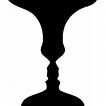
In 1915 Danish psychologist Edgar John Rubin (1886-1951) pub. a work on Figure-Ground Perceptions, introducing Rubin's Vase/Face, a mentally-reversible goblet.

In 1915 German physicist Walter Hans Schottky (1886-1976) (working for Siemens) invents the Screen-Grid Vacuum Tube, followed by the Tetrode in 1919.

In 1916 Am. astronomer Edward Emerson Barnard (1857-1923) discovers the 9.5 magnitude Barnard's Star, with a proper motion of more than 10 arc sec. per year, becoming the fastest known (until ?).

In 1916 Romanian surgeon Thoma Ionescu (1860-1926) pioneers Cervical Sympathectomy for the relief of angina pectoris.




In 1916 Am. chemist Gilbert Newton Lewis (1875-1946) pub. his Lewis Dot Structures, founding modern valence (covalent bond) theory, which is expanded on by Irving Langmuir (1881-1957), who in 1919 pub. The Arrangement of Electrons in Atoms and Molecules, proposing the concentric theory of atomic structure and defining the concept of valence shells. In 1923 Danish physical chemist Johannes Nicolaus Bronsted (Brønsted) (1879-1947) and English physical chemist Thomas Martin Lowry (1874-1936) independently pub. the Bronsted-Lowry Theory of Acids and Bases, defining an acid as a compound tending to give up a proton, and a base as one tending to take one up.
In 1916 German chemist Fritz Gunther invents the first Synthetic Surfactant for use in detergents; too bad, it's too harsh for household use, and is used only by industry, and it takes until 1933 to introduce household detergents in the U.S.
In 1916 the Hudson Motor Co. of Detroit, Mich. introduces its Hudson Super Six, featuring the first fully balanced crankshaft and a 5:1 compression ratio, allowing it to reach 100+ mph, starting an engine power race with other automakers after it sells a record 26,393 units this year.

In 1916 Paul Langevin (1872-1946) of France constructs an underwater ultrasonic "pinger" for submarine detection.

On June 27, 1916 William L. Murphy (1876-1959) of the U.S. patents the Murphy Bed, with no box springs, which swings up or folds into a closet or cabinet when not in use; it is used as a joke in so many movies that the trademark is ruled to be void in 1989 - looks like a coffin with a returning GI in it?
On Nov. 2, 1917 the 100-in. 100-ton Hooker Reflecting Telescope at Mount Wilson Observatory in Los Angeles County, Calif. near Pasadena sees first light, becoming the world's largest telescope until 1949, going on to be used by Edwin Hubble to prove that the Universe goes beyond the Milky Way Galaxy in 1923, and that it is expanding in 1929.

In 1917 Dutch astronomer Willem de Sitter (1872-1934) uses Albert Einstein's Gen. Theory of Relativity to prove that the Universe is expanding, and will ultimately result in the diluted De Sitter Universe.

In 1917 Bessarabia-born William (Wolf) Frederick Friedman (1891-1969) cracks enemy communications for the U.S., becoming the father of U.S. codebreaking.
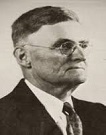
In 1917 Am. pathologist David Marine (1888-1976) and his asst. O.P. Kimball begin giving iodide to a large group of schoolgirls in Ohio until 1922, after which they note a reduction in the development of goiter, leading to the iodization of marine, er, salt.

In 1917 Austrian egghead Julius Wagner-Jauregg (1857-1940) treats syphilitic paralysis by injecting malarial parasites, winning the 1927 Nobel Med. Prize.
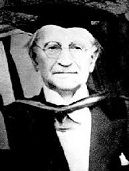
In 1917 Polish philosopher Jan Lukasiewicz (1878-1956) introduces Three-Valued (Trivalent) (Ternary) (Trilean) (3VL) Propositional Calculus, based on trits, becoming the first axiomatized non-classical logical calculus.

In 1917 Clarence Birdseye (1886-1956) of the U.S. pioneers Quick-Freezing of Food in small containers, going commercial in 1929.
In 1917 Rand-McNally (founded 1856) introduces a Numbering System for Highways that is later adopted by the U.S. govt.
In 1917 during WWI the U.N. Navy coins the term "radio shack".

On Dec. 1, 1918 the Central Aerohydrodynamic Inst. (TsAGI) is founded in Moscow by Russian aviation pioneer Nikolai Yegorovich Zhukovsky (Joukovsky) (1847-1921), going on to produce the Yuriev-Cheremukhin TsAGI-1-EA, the first successful single lifting rotor helicopter in 1931-2.


In 1918 English physiologist Ernest Henry Starling (1866-1927) and German physiologist Otto Frank (1865-1944) propose Starling's Law of the Heart, that the mechanical energy set free in the passage from the resting to the active state is a function of the length of the fiber, therefore the stroke volume of the heart increases in response to an increase in the volume of blood filling the heart (the end diastolic volume) when all other factors remain constant.

In 1918 English physicists William Henry Eccles (1875-1966) and Frank Wilfred Jordan (1882-?) patent the Flip-Flop circuit, which later becomes the basis of computer memory devices.
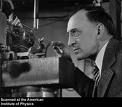

In 1918 Canadian-Am. physicist Arthur Jeffrey Dempster (1886-1950) develops Mass Spectrometry, followed next year by English chemist-physicist Francis William Aston (1877-1945) (J.J. Thomson's asst.), who constructs the first Mass Spectograph, which uses electromagnetic fields to bring particles of the same mass to a focus at the same fine line, and uses it to verify the whole number rule, which states that all atomic weights are integers, and that fractional atomic weights are due to the presence of two or more isotopes, each of which has an integral atomic weight; he goes on to improve its resolution 20x by 1937, winning the 1922 Nobel Physics Prize.

In 1918 Utah-born John Moses Browning (1855-1926) patents the Browning Automatic Rifle (BAR), a light machine gun that sees service at the end of WWI - let's try it out on krauts?
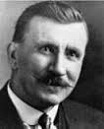
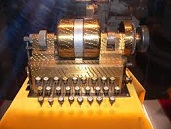
In 1918 Ill.-born inventor Edward Hugh Hebern (1869-1952) patents the Hebern Rotor Machine, which uses parts from a std. mechanical and electrical typewriter, becoming the first rotor machine for encryption.

In 1919 Norwegian meteorologist Jacob Aall Bonnevie Bjerknes (1897-1975) discovers that cyclones originate as waves in the sloping frontal surfaces separating different air masses.

In 1919 Polish mathematician Theodor Kaluza (1885-1954) suggests that space may be 4-dimensional; Albert Einstein writes to him that this notion had never occurred to him; Oskar Klein develops his work into the Kaluza-Klein Theory.

In 1919 Am. industrial chemist Irving Langmuir (1881-1957) pub. The Arrangement of Electrons in Atoms and Molecules, proposing the concentric theory of atomic structure, and defining the concept of valence shells.

In 1919 Am. astronomer William Henry Pickering (1858-1938) predicts the existence and position of "Planet X" based on anomalies in the positions of Uranus and Neptune; when Clyde Tombaugh discovers Pluto in 1930, he flatters himself that the name is an abbreviation for "Pickering-Lowell"; the anomalies later turn out to be accounted for by the masses of Uranus and Neptune and don't actually reflect the influence of tiny Pluto.
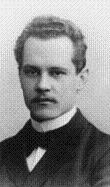
In 1919 Konigsberg, Prussia-born theoretical physicist Arnold Johannes Wilhelm Sommerfeld (1868-1951) pub. Atombau und Spektrallinien, a std. work on spectroscopy which becomes the Bible of atomic theory for a new gen. of physicists incl. Werner Heisenberg, Wolfgang Pauli, Peter Debye, and Hans Bethe; pub. after co-discovering the Sommerfeld-Wilson Quantization Rules in 1915, introducing the fine-structure constant in 1916, and co-discovering the Sommerfeld-Kossel Displacement Law this year, and succeeding Albert Einstein as chmn. of the Deutsche Physikalische Gesellschaft (DPG) last year, founding Zeitschrift fur Physik this year to allow established physicists to pub. new physics research papers in as little as two weeks sans peer review.

In 1919 Bohemian immigrant Joseph Bulova (1851-1936) begins producing clocks and pocket watches in New York City, becoming a hit and setting up a plant next year in Bienne, Switzerland, going on to introduce men's jeweled wristwatches in 1919.
In 1919 Lockheed Co. co-founder Malcolm Loughead of the U.S. invents the first Hydraulic Brakes, which are first used on the 1921 Model A Duesenberg.
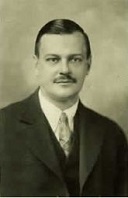
In the 1920s Am. geneticist Clarence Cook "C.C." Little (1888-1971) of Harvard U. pioneers the use of lab mice for cancer research, founding the Jackson Laboratory in 1929 to sell them to researchers, and getting them named as the official animal model in the 1973 U.S. Nat. Cancer Inst. Act.

In the 1920s after he got the idea that variations in the Earth's orbit could have a major effect on the climate, and found that solar flux in July at 65 deg. N lat. can vary by as much as 35%, Serbian scientist Milutin Milankovic (1879-1958) proposes Milankovitch Cycles to explain long-term climate changes by the position of the Earth vis a vis the Sun, namely that during an ice age there will be more or less ice depending on these orbital cycles, but if the Earth is too warm, they basically won't do anything in terms of growing ice.

In 1920 Polish mathematician Stefan Banach (1892-1945) introduces the concept of Banach Space, founding modern Functional Analysis.

In 1920 English astrophysicist Sir Arthur Stanley Eddington (1882-1944) pub. Space, Time, and Gravitation: An Outline of the General Relativity Theory, which proposes that stellar energy is liberated by nuclear fusion in the formation of helium from hydrogen.

In 1920 Am. mathematician Edward Kasner (1878-1955) coins the word "Google" to mean 1 followed by 100 zeroes (ten duotrigintillion); the name was thought up by his 9-y.-o. nephew Milton Sirotta (1911-81). In 1940 he and James Roy Newman (1907-66) pub. Mathematics and the Imagination, which introduces the term googol, and claims that it would take a human 10 years of calculation to compute the value of pi to 1K places.

In 1920 Polish mathematician Jan Lukasiewicz (1878-1956) invents Polish (Lukasiewicz) (Warsaw) (Prefix) Notation, which dispenses with parentheses and places operators before operands to make for unambiguous parsing, becoming popular with computer scientists, who use it with a last-in first-out recursive stack computer memory.
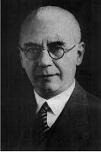
In 1920 Carl Ulrich Franz Mannich (1877-1947) and Helene Lowenheim (Löwenheim) of Germany first synthesize Hydrocodone; it is approved by the FDA for sale on Mar. 23, 1943; since it is 6x (VI) as strong as codeine, it is later marketed under the trade name Vicodin.

In the 1920s Austrian meteorologist Heinrich von Ficker (1881-1957) stresses the importance of the stratosphere in weather phenomena.

In 1920 Am. astronomer Francis Gladheim Pease (1881-1938) of Mt. Wilson Observatory becomes the first to use an interferometer to measure the diam. of a star, Betelgeuse, the big red magnitude-1 star in Orion, which varies from 180M-260M mi. diam. (0.047 arc-sec.).

In 1920 English scientist Ernest Rutherford names the proton after scientist William Prout (1785-1850).
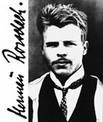

In 1920 Zurich-born Swiss psychiatrist Hermann Rorschach (1884-1922), nicknamed "Kleck" (inkblot) for his interest in art invents the Rorschach Inkblot Test, based on a series of 10 inkblot plates.

In 1920 German chemist Hermann Staudinger (1881-1965) discovers polymerization of small molecules into plastics (polymers), and coins the term "macromolecule", going on to pub. 700+ papers in this field by 1950 - macromind?


In 1920 Band-Aids are invented by Earle Dickson (1892-1961) of Johnson & Johnson after his wife cuts her finger and puts crinoline (woven horse hair and linen or cotton thread) on some gauze before sticking it to tape; they are first marketed in 1924 in 3 in. x 18 in. rolls.


In 1920 Frederick Samuel Duesenberg (1876-1932) and August Samuel Duesenberg (1879-1955) introduce the first production straight 8-cylinder engine and hydraulic front brakes on their new Duesenberg Model A automobile, made in Indianapolis, Ind., which next year becomes the first U.S.-made car to win the Grand Prix at Le Mans, France, beating the entire field by 14 min.
In 1920 Kimberly-Clark Co. begins selling Kotex ("cotton" + "texture") sanitary napkins in a hospital blue box, 12 for 60 cents; prudishness causes the product to er, swim against the tide until Montgomery Ward begins advertising them in its 1926 catalog, reaching $11M sales in 1927 in 57 countries; it becomes one of the first self-service items in Am. retailing after it is strategically placed on countertops with a special payment box so that the woman doesn't have to ask a clerk for it and touch hands; belts are needed until the 1970 introduction of Stayfree by Personal Products Co. and New Freedom Pads by Kimberly-Clark; Tampax appears in 1936.

In 1920 Am. inventor Arthur H. Pitney (1871-1933) and English-born entrepeneur Walter Bowes (1882-1957) invent the Model M Postage Meter, which the U.S. Postal Service approves on Nov. 16.

In Oct. 1920 Russian physicist Leon Theremin (Lev Sergeyevich Termen) (1896-1993) invents the Theremin electronic musical instrument, later used for outer space effects in movies; Lenin loves it so much he sends him on a world tour to demonstrate Soviet superiority, allowing him to patent it in the U.S. in 1928.


In 1920 retired U.S. Army officer John Taliaferro Thompson (1860-1940), who has been working since WWI to develop a "trench broom" finally patents the .45-cal. Thompson Submachine Gun (Tommy Gun), and since the Great War is over he begins marketing it to law enforcement agencies, meaning that the criminals get all they want; after gangs adopt it, it becomes known as the Chicago Typewriter.


On Jan. 25, 1921 Prague-born Karel Capek (1890-1938) (pr. CHAP-ek) debuts his play R.U.R. (Rossum's Universal Robots) in Prague, which introduces the word "robot", from Russian "robotatch", meaning to work, coined by his brother Josef Capek (1887-1945) - somehow robots and Commies get fouled up conceptually in time? R.U.R. (Rossum's Universal Robots) (Jan.) (Prague);


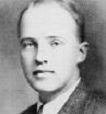

In 1921 Canadian physiologists Frederick Grant Banting (1891-1941), James Bertram Collip (1892-1965), and Charles Herbert Best (1899-1978), working under the direction of Scottish physiologist and diabetes researcher John James Rickard Macleod (1876-1935) discover and isolate Insulin, and share the 1923 Nobel Med. Prize, except for Best, who is snubbed, pissing-off Banting, who shares half of his prize money with him - macleodly banting the best part of the dough?


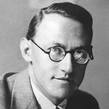
In 1921 French mathematician Felix Edouard Justin Emile (Félix Édouard Justin Émile) Borel (1871-1956) begins pub. a series of papers on Game Theory, becoming the first to define games of strategy. In 1928 Budapest, Hungary-born Am. mathematician John von Neumann (1903-57) pub. On the Theory of Parlor Games, announcing the Minimax Theorem; "As far as I can see, there could be no theory of games... without that theorem... I thought there was nothing worth publishing until the Minimax Theorem was proved." In 1944 von Neumann and Gorlitz, Germany-born Austrian School economist Oskar Morgenstern (1902-77) pub. Theory of Games and Economic Behavior, which treats cooperative multiplayer games with decision-making under uncertainty, founding Mathematical Game Theory.


In 1921 Johannes Nicolaus Bronsted (1879-1947) of Denmark and Georg Charles de Hevesy (1885-1966) of Hungary develop a method for separating isotopes.

In 1921 Am. physicist Thomas Townsend Brown (1905-85) discovers the Biefeld-Brown Effect while experimenting with a Coolidge X-ray tube, finding that a tube with asymmetrical electrodes exerts a force when connected to a high-voltage source, later claiming that it might be used by ETs to create anti-gravity machines.



In 1921 the BCG (Bacillus Calmette-Guerin) Vaccine for TB, developed by French bacteriologist Leon Charles Albert Calmette (1863-1933) and French immunologist Jean-Marie Camille Guerin (Guérin) (1872-1961), with help from Norwegian physician Kristian Feyer Andvord (1855-1934), in development since 1906 is perfected and tested on newborns in the Paris Charite; too bad, in 1930 a bad batch causes 72 children in Lubeck, Germany to contract TB, freaking out Calmette, who dies the next year, after which production techniques are tightened.

In 1921 Edgar Dacque (Dacqué) (1878-1945) of the U. of Munich pioneers phylogentically-oriented paleontology, becoming especially interested in the origin of human bipedalism, but eventually goes off the deep end into mythology and gets a bad rep? - Wacque Dacque?

In 1921 Friedrich Dessauer (1881-1963) of Germany develops medium-voltage X-ray therapy, and in the 1930s flees to Turkey, giving them his knowledge.

In 1921 English economist John Maynard Keynes (1883-1946) pub. Treatise on Probability, which proposes that probabilities are truth values intermediate between simple truth and falsity, and pioneers the d ecision weight approach and the interval approach.


In 1921 German pharmacologist Otto Loewi (1873-1961) discovers the chemical transmission of nerve impulses, later tracing it to acetylcholine after a dream on Easter Sat. night 1923, making him the "Father of Neuroscience"; English neuroscientist Sir Henry Hallett Dale (1875-1968) discovers it too, and they share the 1936 Nobel Med. Prize.

In 1921 Thomas Midgley Jr. (1889-1944) of Charles F. Kettering's Delco Co. discovers that Tetraethyl Leaded Gasoline prevents engine knock - while poisoning the environment? In 1922 leaded gasoline goes on sale in the U.S.; the first lead poisoning deaths occur in Du Pont's Deepwater, N.J. plant.

In 1921 Indian astrophysicist Meghnad Saha (1893-1956) pub. the Saha Thermal Ionization Equation, and applies it to stellar spectra.

In 1921 German embryologist Hans Spemann (1869-1941) postulates an organizer principle responsible for the formative interaction between neighboring embryonic regions, causing embryologists to start searching for the inductive chemical molecule. In 1928 he conducts the first nuclear transfer experiment, going on to win the 1935 Nobel Med. Prize.


In 1921 German physicists Otto Stern (1888-1969) and Walther Gerlach (1889-1979) conduct the Stern-Gerlach Experiment, splitting a beam of atomic silver in two instead of merely broadening it like classical physics predicts by passing it through a nonhomogeneous magnetic field, proving space quantization and opening physics up to unimaginable possibilities such as bar code scanners, CDs, and the decoding of the human genome; it had something to do with a bad cigar?

In 1921 Beaver, Utah-born Rigby H.S. student Philo Taylor Farnsworth (1906-71) conceives the basic features of the electronic television (TV) system for his science teacher Justin Tolman, who encourages him to pursue it, launching his career - tell all the world to join into the Love Train? In 1927 he invents the image dissector tube for TV cameras, becoming the first functional all-electronic image pickup device, and first fully functional and complete all-electronic TV system.
On Oct. 18, 1921 Charles P. Strite (1878-1956) receives U.S. patent #1,394,450 for the Automatic Pop-Up Toaster, which ejects the toast afterwards.
In 1921 Danish-born Am. blacksmith Vilhelm "Bill" Petersen of DeWitt, Neb. patents vice-grip locking pliers.


In 1922 the rare (#47) metallic element Hafnium (Lat. "Copenhagen") (#72), naturally occuring in most zirconium minerals (5% strength) is discovered in Copenhagen by Dutch physicist Dirk Coster (1889-1950) and Hungarian chemist George Charles de (Georg Karl von) Hevesy (1885-1966) based on Niels Bohr's prediction that it should resemble zirconium in structure, causing them to look in guess what kind of ores.

In 1922 Vitamin E (antisterility factor X) (alpha-tocopherol) is discovered by Am. embyrologist Herbert McLean Evans (1882-1971) and his asst. Katherine S. Bishop of the U. of Calif.; named by E.V. Shute in 1924.

In 1922 Czech chemist Jaroslav Heyrovsky (1890-1967) of Charles U. in Prague invents Polarography during investigations of the electrode potential of aluminum, pioneering the electroanalytic method and the field of Electrochemistry, winning him the 1959 Nobel Chem. Prize.
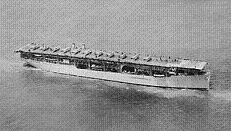
On Mar. 20, 1922 converted coal carrier USS Langley (CV-1) (originally commissioned Apr. 7, 1913 as USS Jupiter and renamed for Samuel Pierpont Langley) becomes the first aircraft carrier; on Oct. 17 Lt. Virgil C. Griffin takes off in his Vought VE-7 from it, launching the aircraft carrier era.

On July 16, 1922 German-born Jewish-Am. gramophone inventor Emile Berliner (1851-1929) and his son Henry Adler Berliner (1895-1970) demonstrate a working helicopter to the U.S. Army on July 16, consisting of a Nieuport 23 fighter aircraft fuselage with two horizontal rotors mounted on a truss, becoming the first working helicopter; in 1923 he adds triple wings as a backup; too bad, it never reaches an elevation higher than 15 ft.


In 1922 the first Snowmobile is built by Joseph-Armand Bombardier (1907-64) of Canada, who goes on to patent it in 1937, calling it the B-7, featuring a sprocket caterpillar half-track in the back and skis in front, followed by the 12-passenger B-12 in 1942.
In 1922 German inventors Josef Engl (1893-1942), Joseph Massolle (1889-1957) and Hans Vogt (1890-1979) develop the Tri-Ergon (Gr. "work of three") sound film system using photoelectric cells, but can't perfect it, and sell it to Fox Movie Corp., who hire Theodore Willard Case (1888-1944) to perfect it, creating the Fox Movietone Sound-on-Film System in 1927.


In 1922 Anton Flettner (1885-1961) of Germany invents the cool-looking look-ma-no-sails Flettner Rotorship, based on the Magnus Spin Drift Effect, which causes a rotating object to move through the water in a constant direction perpendicular to the airflow; in 1924 constructs the 3-masted 960-ton roto schooner Buckau, which works fine but wears out before it can pay for itself, causing the rotor ship idea to fizzle (until ?); in 1926 Anton Flettner's Magnus effect rotor ship Baden-Baden sails from Hamburg to New York City, causing a sensation.

In 1922 Chelsea, Mass.-born engineer Herbert Thomas Kalmus (1881-1963) develops Technicolor, the first commercially successful color process for motion pictures; he names it in tribute to his alma mater MIT; ex-wife Natalie Kalmus (1878-1965) appears as "color coordinator" on virtually every Technicolor film from 1934-49, becoming unpopular on sets for trying to make them make colors more bland while being unable to fire her.
In 1922 Stephen Poplawski invents the Blender (Liquidiser), putting a spinning blade at the bottom of a container to make soda fountain drinks.
In 1922 English aviator Maj. J.C. Savage invents Skywriting after watching WWI airplanes leaving smoke trails.

On Oct. 21, 1923 the first Planetarium opens in Munich, Germany at the Deutsches Museum, built by Carl Zeiss Co. based on a 1910 proposal by German astronomer Maximilian Franz Joseph Cornelius "Max" Wolf (1863-1932), who goes on to help pioneer astrophotography.

In 1923 Arthur Holly Compton (1892-1962) of the U. of Chicago discovers the Compton Effect, a change in X-ray wavelength when scattered by matter, indicating that the rays are corpuscular in nature, bolstering the proton theory.


In 1923 Dutch physical chemist Peter Debye (1884-1966) and German physical chemist Erich Armand Arthur Joseph Huckel (Hückel) (1896-1980) of Germany extend the Arrhenius Theory of Ionization of salt in solution to the crystalline solid state, producing the Debye-Huckel Theory of electrolyte ionization to aid in the calculation of activity coefficients.

In 1923 husband-wife Am. physicians (with names like that they better be married?) George Frederick Dick (1881-1967) and Gladys Rowena Henry Dick (1881-1963) isolate the cause of scarlet fever to a toxin produced by a strain of Streptococcus bacteria, going on to create an anti-toxin for immunization - too late for poor Beth March?

In 1923 German engineer Max Schuler (1882-1972) first describes Schuler Tuning, the need to tune a gyrocompass to the orbital period of a satellite orbiting just above the surface of the Earth (84.4 min.).
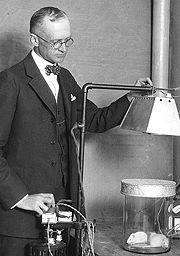
In 1923 Am. biochemist Harry Steenbock (1886-1967) discovers that UV irradiation increases the Vitamin D content of foods, esp. milk (how convenient he lives in Wisc.?), and patents the invention, virtually eliminating rickets in the U.S. by the time it expires in 1945.
In 1923 Juan de la Cierva of Spain invents the Autogiro.

In 1923 Swedish chemist Theodor H.E. "The" Svedberg (1884-1971) develops the use of the 1M g Ultracentrifuge in distinguishing proteins from each other, winning the 1926 Nobel Chem. Prize.

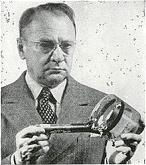

TV has its birth pangs in the Twenties? In 1923 Russian-born Am. RCA-Westinghouse engineer Vladimir Kosmich Zworykin (1889-1982) patents the Iconoscope (Gr. "ikon" + "skopion" = image + look at) TV camera tube; all he needs now is a TV receiver tube - is it zworykin? On Oct. 30, 1925 Scottish inventor John Logie Baird (1888-1946) transmits human features by television in the first TV broadcast of moving objects (in England), using a mechanical system based on Paul von Nipkov's 1886 rotating disk. In 1928 both inependently develop color TV, Zworykin's electronic, Baird's mechanical.

In 1923 Romanian-born German physicist Hermann Julius Oberth (1894-1989) coins the term "space station" in his dissertation "By Rocket into Planetary Space", which is rejected, causing him to utter the soundbyte: "Our educational system is like an automobile which has strong rear lights, brightly illuminating the past, but looking forward, things are barely discernible." In 1923 he pub. By Rocket Into Planetary Space, which is expanded in 1929 into Ways to Spaceflight; modern astronautics is born.

In 1924 English scientist Sir Edward Victor Appleton (1892-1965) utilizes short wavelength radio waves (shortwaves) to penetrate the Heaviside (E-Layer) in the upper atmosphere at about 100 km, proving the existence of the ionosphere, winning him the 1947 Nobel Physics Prize; radar is born.

In 1924 Indian physicist Satyendra Nath Bose (1894-1974) gets Albert Einstein's help to pub. a paper deriving Planck's quantum radiation law without any reference to classical physics, and Einstein becomes co-author, creating Bose-Einstein Statistics, which predicts a new form of matter known as the Bose-Einstein Condensate (BEC), which is experimentally verified in 1995; too bad, blackish-skinned doctorateless Bose is snubbed for a Nobel Prize.

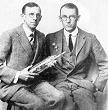
In 1924 French physicist Prince Louis Victor Pierre Raymond, 7th Duc de Broglie (1892-1987) pub. his Wave Theory of Matter, a mathematical analysis of matter based on the assumption that particles of matter have wavelike properties (de Broglie waves), or are essentially superpositions of waves of all wavelengths; in 1923-7 Am. physicists Clinton Joseph Davisson (1881-1958) and Lester Halbert Germer (1896-1971) of Western Electric experimentally verify it in the Davisson-Germer Experiment, winning Davisson a share of the 1937 Nobel Physics Prize - but I don't like broccoli?

In 1924 the Taung Baby (Child), Australopithecus africanus is discovered in South Africa by Australian anthropologist Raymond Dart (1893-1988).
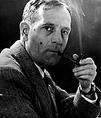
In 1924 English astrophysicist Sir Arthur Stanley Eddington discovers a Mass-Luminosity Relation for stars; meanwhile Am. astronomer Edwin Powell Hubble (1889-1953) uses Cepheid Variables to determine the absolute brightness of a star as a guide to finding its distance, causing him to announce that stars in the Andromeda Galaxy are not inside the Milky Way Galaxy, and that the latter is just one of many in a vast cosmic sea, throwing Earth centrists into a tizzy; in 2010 it is discovered that they shrink in mass, affecting calculations.

In 1924 the 3:2 aspect ratio Leica (Leitz) Camera, developed by Oskar Barnack (1879-1936) of the Leitz Co. in Wetzlar, Hesse, Germany begins production, becoming the first mass-marketed 35mm camera (36 exposures per roll), with the motto "Small negatives - large images"; he invented it in 1913, but the war delayed production.





On Mar. 21, 1925 Tenn. Dem. gov. (1923-27) Austin Peay (1876-1927) signs the Butler Act, passed on Mar. 13, prohibiting the teaching of Darwin's Theory of Evolution (Darwinism) in public schools, along with sex education (repealed in 1967); on May 5 after a group of Dayton, Tenn. businessmen approach him about being a test case, substitute teacher John Thomas Scopes (1900-70) of Rhea County High School (who attended high school in William Jennings Bryan's hometown of Salem, Ill., where Bryan gave his commencement address) becomes its first victim (or victory) as he is arrested for teaching the evolution chapter in the textbook "Civic Biology" by Hunter (1914); on July 10-25 the Scopes Monkey Trial in Tenn. forever sensationalizes and trivializes the issues for the public as Scopes' atty. Clarence Darrow (1857-1938) puts self-proclaimed Bible expert William Jennings Bryan (1860-1925) and the Bible itself on a cross of gold, er, trial; fair, impartial Judge John T. Raulston has a sign that says "Read Your Bible" on the wall behind his bench; Darrow asks Bryan "Did you ever discover where Cain got his wife?", to which Bryan replies, "No, sir; I leave the agnostics to hunt for her"; these and other smug answers are allegedly a disaster for the fundamentalist cause, and are touted as proving the soundness of evolution?; on July 21 Scopes is convicted, fined $500, then later acquitted on the technicality that the judge set the fine instead of the jury; the Butler Act is not repealed until 1967; Scopes never actually taught the chapter but his students were coached to lie on the witness stand to make him their test case?
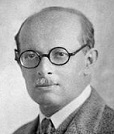
On Oct. 22, 1925 Austrian-born German-Am. physicist Julius Edgar Lilienfeld (1882-1963) patents the first Field-Effect Transistor (1,745,175); on Aug. 29, 1931 he patents the Electrolytic Capacitor (#2,013,564).





Think of all the possibilities? The German Physics Establishment makes a quantum leap in the physics of the atom? In 1925 German physicists Max Born (1882-1970), Werner Karl Heisenberg (1901-76), and Ernst Pascual Jordan (1902-80) create Matrix Mechanics, using an infinite matrix representing the position and motion of an electron in an atom as the columns, and the quantum numbers of the old quantum theory as the rows, then manipulating it to calculate spectral line frequencies and other observable quantities; meanwhile in late 1925 Austrian-Irish physicist Erwin Rudolf Josef Alexander Schroedinger (Schrödinger) (1887-1961) develops Wave Mechanics AKA the Schroedinger (Schrödinger) Equation, using a 2nd order differential equation in place of the old quantum theory concept of the atom, which, when restricted by eigenfunctions yields discrete solutions identical with the old quantum numbers, and is exactly solvable for the hydrogen and helium atoms, which the old theory stumbled on; meanwhile on Dec. 12, 1926 Albert Einstein (1879-1955) writes a Dicey Letter to Max Born, containing the immortal soundbyte "God (The Old One) does not play dice" (with the Universe), which is part of his reasoning to discard the entire program of quantum physics for life; Born's Rule, that the probability of finding a quantum object at a certain place and time equals the square of its wave function, meaning that interference occurs in pairs of possibilities, not higher order, isn't experimentally verified until 2010. As a topper, in 1927 Heisenberg discovers the Heisenberg Uncertainty (Indeterminacy) Principle, which states that the position and momentum of a particle cannot be known precisely, but have a probability distribution - but is he certain about it? In 1935 after corresponding with Einstein, Schroedinger pub. his famous Schroedinger's (Schrödinger's) Cat Paradox to illustrate the absurdity of quantum physics, showing a scenario where a cat is both dead and alive.


In 1925 Dutch physicists Samuel Abraham Goudsmit (1902-78) and George Eugene Uhlenbeck (1900-88) discover the phenomenon of Electron Spin.

In 1925 Walter Noddack (1893-1960) and Ida Noddack (1896-1978) of Germany discover the metallic element Rhenium (Rh) (#75); too bad, they also claim to isolate long-missing element #43, which they call masurium after Walter's family home in E Prussia, but their results can't be duplicated, and some get pissed-off at their nationalism, so others get credit in 1937 for technetium (Tc); in 1998 U.S. researchers confirm their results, so now what?
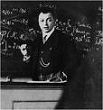
In 1925 Austrian physicist Wolfgang Pauli (1900-58) pub. the Pauli Exclusion Principle, stating that no two electrons can have exactly the same set of quantum numbers, winning him the 1945 Nobel Physics Prize.

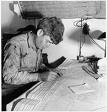
In 1925 a German oceanographic expedition sent to recover gold to repay the war debt uses sonar to discover the 10K-mi. Mid-Atlantic Ridge, which runs from the tip of South Am. to Iceland to the Antarctic Circle; German oceanographer Georg Adolf Otto Wust (Wüst) (1890-1977) becomes chief oceanographer on the research vessel Meteor, developing the idea of the ocean's core layer. In 1953 Am. oceanographer William Maurice "Doc" Ewing (1906-74) discovers the great rift running down the middle of the Mid-Atlantic Ridge.

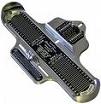
In 1925 Charles F. Brannock (1903-92) of Syracuse, N.Y. invents the Brannock Device for measuring human feet (improving on the RITZ Stick), and patents it next year.

In 1925 French astronomer Henri Chretien (Chrétien) (1879-1956) invents the CinemaScope process for creating widescreen films using special Hypergonar anamorphic lenses, which is adapted by 20th Cent. Fox in 1952.

In 1925 Russian-born Jewish inventor Anatol M. Josepho (Josephewitz) (1894-1980) opens the first Photomaton studio in New York City at 1659 Broadway in Sept., and patents the invention of the photo booth, selling it for $1M in 1927, then giving half to charity.
In 1925 Arthur Sicard of Canada invents the Snowblower.


In 1926 Yakov Ilyich Frenkel (1894-1952) of Russia proposes the concept of Frankel Point Defects in crystals (silver chloride, etc.) to explain the ease with which atoms can move in them; in 1930 Walter Hermann Schottky (1886-1976) of Germany proposes another type of point defect where pairs of vacancies have opposite signs.

In 1926 English physicist Sir James Jeans (1877-1946) pub. a new stellar theory defining the Jeans Length, the critical radius of an interstellar cloud to be able to condense into a star, which depends on its temperature, density, and component masses; too small, no star; too large, it will collapse.

In 1926 Am. chemist Gilbert Newton Lewis (1875-1946) coins the term "photon" for the smallest unit of radiant energy; every photon of light is an identical unit of action (energy multiplied by time) given by Planck's constant.



In 1926 George Richards Minot (1885-1950), William Parry Murphy (1892-1987), and George Hoyt Whipple (1878-1976) of Harvard U. discover the liver extract treatment for pernicious anemia; it takes over 20 years to find the active ingredient cobalamin (vitamin B12).

In 1926 the first plant hormone, Auxin is discovered by Dutch biologist Frits Warmolt Went (1903-90).
In 1926 Antonio Buzzacchino invents the Permanent Wave (Perm) to produce curls in hair, increasing the variety of hair fashions for both genders - as the husband is the head so the wife is the body?

On Mar. 16, 1926 (Tues.) after 25 years of work since his big inspiration of Aug. 19, 1899, Worcester, Mass.-born U.S. physics prof. Robert Hutchings Goddard (1882-1945) makes the first successful test of the liquid fuel rocket named Nell at Aunt Effie's farm in Auburn, Mass., with it landing in a cabbage field after rising 41 ft. in 2.5 sec.; his first tests were in Sept. 1921; after another launch in July 1929 gets nat. publicity, Charles Lindbergh takes up his cause, attempting to get investors interested, only to run up against the Oct. 1929 Stock Market Crash, but luckily Daniel Guggenheim invests $100K and he's up and away, moving to Roswell, N.M. in 1930, after which Wernher von Braun of Germany copies his plans and begins building his A-1 and A-2 prototype rockets in the early 1930s; the Mass. launch site later becomes part of a golf course fairway - he moves to Roswell to get technical advice from ETs?
In 1926 postal carrier Rudolph Hass of in La Havre Heights, Calif. develops the Hass Avocado Plant, which he patents in 1935, becoming the only avocado variety that is produced year-round; the mother plant is cut down on Sept. 11, 2002.
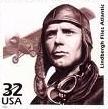
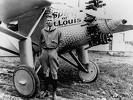



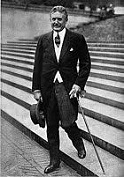




Think of all those hard sea journeys over the Pond made into jokes by one white barnstormer? On May 20-21, 1927 (Fri.-Sat.) after U.S. aeronautics official (asst. commerce secy. since Aug. 11, 1926) William P. MacCracken Jr. (1889-) (who was issued federal pilot license #1 on Apr. 6 after Orville Wright declines) comes close to grounding him for reckless flying for four bailouts and crackups in his barnstorming and mail delivery days, and after coaching by naval aviator Richard E. Byrd (1888-1957), lily-white straight Christian church-going male Charles Augustus Lindbergh (1902-74) (sponsored by a St. Louis newspaper) becomes the 118th person to cross the Atlantic by air and the first person to cross it solo in the W-E direction in the Spirit of St. Louis (AKA the Ryan NYP for New York to Paris), built by Ryan Airlines in San Diego, Calif., founded by Tubal Claude Ryan (1898-1982) from Roosevelt Field in Long Island, N.Y. to Paris (Orly Airport) in 33.5 hours, where he is greeted by an enthusiastic crowd, and received by U.S. ambassador (former Ohio Repub. gov. in 1904-6) Myron Timothy Herrick (1854-1929); he and his plane return home from France on the cruiser (commissioned in Feb. 1925) USS Memphis, arriving on June 11; on June 13 he is honored with a ticker tape parade in New York City; a check for $25K dated June 17 is presented to him by Bryant Park Bank of New York City, representing the $25K Orteig Prize offered since 1919 for the first nonstop Paris-NY flight in either direction by French-born New York City hotel owner Raymond Orteig (1870-1939) via the Aero Club of Am.; he is the 67th person to fly the Atlantic, the previous ones by dirigibles and twin-engine mail planes (81 incl. passengers); nobody flies solo in the harder against-the-wind W-E dir. until 1932; the Lindy Hop dance craze is born in Harlem, N.Y. at the Savoy Ballroom with black inventor "Shorty" George Snowden and his foot-taller black partner ("I like them small your honor, and the reason is") Big Bea; Clarence Duncan Chamberlin (1893-1976) might have done it first in his Wright-powered Bellanca monopolane Columbia, but its owner Charles Albert Levine (1897-1991) is tied up in court with an injuction filed by the former navigator, causing him on May 21 to announce that his plane will fly farther into Europe and carry a passenger, himself, and they leave from Roosevelt Field in Long Island on June 4, flying nonstop to Eisleben, Germany on June 6 (3,911 mi. in 42 hours 31 min.) after running out of fuel 43 mi. short of the goal of Berlin - it would have to be a Jew jokes here?
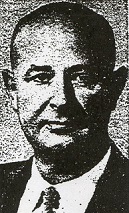
In 1927 the first commercial amphetamines are synthesized by pharmacologist Gordon Albert Alles (1901-63) in Los Angeles, Calif., who notes the "stimulating effect on the central nervous system"; the Benzedrine (amphetamine sulfate) inhaler is introduced in 1932.

In 1927 Bell Labs employee Harold Stephen Black (1898-1983) invents the negative feedback amplifier, which trades gain for linearity to reduce distortion, becoming the most important invention in the field of electronics of the 20th cent.
In 1927 English astronomer Arthur Stanley Eddington coins the term "Arrow of time".


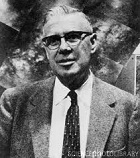
In 1927 Belgian Roman Catholic priest-physicist Georges Lemaitre (1894-1966) proposes the Big Bang (Expanding Universe) Theory of the creation of the Universe, both as a way to explain the red shift in spectra from distant galaxies and as a way to prove the existence of God - do you think your kids are scared of you? In 1929 Am. astronomers Edwin Powell Hubble (1889-1953) and Milton Lasell Humason (1891-1972) observe large red shifts in the spectra of extragalactic nebulae, and conclude that all galaxies are moving away from each other and that the Universe is expanding, later called Hubble's Law, and present it as hard evidence in support of the Big Bang creation theory, causing Albert Einstein to give up the Cosmological Constant that he introduced in 1917 to his Gen. Relativity Theory (which opposed gravity and kept the Universe stable), declaring it to be the biggest blunder of his career; meanwhile, since the Roman Catholic Church had proposed the Big Bang as evidence of the existence of God, the scientific establishment covers up Catholic priest Georges Lemaitre's work and gives the credit to Hubble, and God becomes a political football? - they put him in a mask lined with spikes and burned him at the stake?
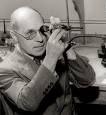
In 1927 Am. geneticist Hermann Joseph Muller (1890-1967) discovers that the rate of appearance of mutations in fruit flies is increased by exposure to X-rays, and pub. the paper "The Problem of Genetic Modification" at the Fifth Internat. Congress of Genetics in Berlin, making him an internat. celeb; by the 1950s this isn't such good news?

In Apr. 1928 Am. astronomer George Ellery Hale (1868-1938) pub. the article "The Possibilities of Large Telescopes" in Harper's Mag., obtaining funding from the Rockefeller Foundatin to found the (Mount) Palomar Observatory in the Palomar Mountain Range 90 mi. SE of Los Angeles, Calif. in San Diego County, Calif., which ends up operated by Caltech; it goes on to operate the 18-in. Schmidt Telescope (1936), the 48-in. Samuel Oschin Telescope (1948), the 200-in. Hale Telescope (1949), and the 60-in. Oscar Mayer Reflecting Telescope (1970).

In 1928 Am. chemist Edwin Joseph Cohn (1892-1953) concentrates raw liver juice 50x-100x, allowing practical treatment of pernicious anemia.

In 1928 after being predicted theoretically in 1923 by Adolf Smekal, Indian physicist Chandrasekhara Venkata "C.V." Raman (1888-1970) discovers the Raman Effect (Scattering), the inelastic scattering of light by molecules of a transparent gas, liquid, or solid substance, causing the scattered photons to have a lower frequency than the incident photons.


In 1928 German chemists Otto Paul Hermann Diels (1876-1954) and Kurt Alder (1902-58) pub. their discovery of the Diels-Alder Reaction for diene synthesis of complex aromatic organic ring compounds and plastics - more ways Dirt Devil helps you fight dirty?

In 1928 English physicist Paul Adrien Maurice Dirac (1902-84) pub. the Dirac Equation, a relativistic wave equation that replaces the single 2nd-order wave equation with four simultaneous first-order equations, and proves that matrix and wave mechanics are equivalent formulations of the one and only quantum mechanics, which is nice for a theory, but becomes hideously complicated to solve even for a helium atom in an age before computers; the equation implies the existence of antimatter, and permits the introduction of four complex numbers called bispinors, explaining spin as a consequence of the union of relativity and quantum mechanics, leading to the discovery of the positron and winning him the 1933 Nobel Physics Prize - stop thinking and start enjoying flawless color?



The Syph meets its match with a Flaming Chain of Flowers fighting Sir Inflammation? On Sept. 15,1928 while studying influenza, Scottish researcher Sir Alexander Fleming (1881-1955) discovers Penicillin (originally "mold juice") after observing that Penicillium notatum westling bacteria does not grow on nutrient agar surrounding orange mold, and announces it next year, becoming the first to propose its use as an antibacterial agent in medicine, although it takes until WWII to get it developed (1943); in 1945 he shares the Nobel Prize in Medicine with German-born British biochemist Sir Ernst Boris Chain (1906-79) and Australian pathologist Sir Howard Walter Florey (1898-1968), who learn how to prepare it, and clinically prove its effectiveness as an antibiotic; during WWII methods of obtaining pure penicillin are perfected - as long as hos don't start popping P-pills like candy?

In 1928 Russian-born physicist George Gamow (1904-68) pub. a quantum theory of the atomic nucleus.

In 1928 French chemist Rene-Maurice Gattefosse (René-Maurice Gattefossé) (1881-1950) coins the term Aromatherapy after using lavender oil to help heal his 3rd degree burns.

In 1928 Austrian chemist Friedrich Adolf Paneth (1887-1958) founds radiochemistry, then later turns to geochemistry and cosmochemistry.
In 1928 Peruvian archeologist Julio Tello discovers the 300 elongated Paracas Skulls in a tomb in the Paracas Peninsula in S Peru, dating back 3K years, the world's longest elongated skulls, mainly with red hair.
In 1928 Am. sociologists William Isaac Thomas (1863-1947) and D. S. Thomas pub. the Thomas Theorem: "If men define situations as real, they are real in their consequences."
In 1928 the Astronomical Congress of 1928 officially recognizes 88 constellations, and pub. a description of their boundaries in Cambridge, England in 1930 under the title Atlas Celeste.
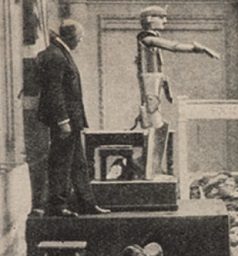
In Dec. 1928 Popular Science contains an article about Eric, billed as the "U.K.'s first robot".

In 1928 Walter E. Diemer (1905-98) of the Frank H. Fleer Co. accidentally invents Dubble Bubble brand bubble gum in Aug., selling $1.5M the first year; too bad, they fail to Bill Gates, er, patent it.

In 1928 Am. chemical engineer Philip Drinker (1894-1972) and moonshiner Louis Agassiz Shaw Jr. (1886-1940) develop the Iron Lung (Drinker Respirator) - drink up that fresh air? In 1931 John Haven "Jack" Emerson (1906-97) invents an oxygen tent, along with an improved iron lung, causing Drinker to sue him, backfiring and causing his patents to be declared invalid.
On July 30, 1928 George Eastman (1854-1932) first demonstrates his color motion picture process.

In 1928 German-born Am. inventor Paul Kollsman (1900-82) founds Kollsman Instruments Co.in Brooklyn, N.Y., which goes on to produce the first altimeters; the altimeter setting window in the NASA Apollo Program is later named the Kollsman Window.

In 1928 German inventor Fritz Pfleumer (1881-1945) invents magnetic tape for pfleuming tape recorders (German patent 500,900); they are first used at the pfleuming Blattner Studios in England in 1929, which later becomes Joe Rock Productions, then Elstree Studios.

In 1928 Am. jeweller Otto Frederick Rohwedder (1880-1960) patents an automatic bread-slicing machine, which he had been working on since 1912, the trick being to quickly wrap the bread to keep it from going stale; the first machine is bought by the Chillocothe (Mo.) Baking Co., and they sell their first loaf on July 7 - what's the greatest invention since sliced bread?

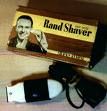
In Nov. 1928 Col. Jacob Schick (1877-1937) patents the dry shaver electric razor; the first ones are marketed on Mar. 18, 1931.

On June 28, 1928 Austrian-born Friedrich Schmiedl (1902-94) launches his first experimental rocket.
In 1928 a machine that bones and cleans kippers begins operation in Fleetwood, England - if it were mackerel it'd be the first Fleetwood Mac?

In 1929 British physicist R. d'E. Atkinson and German physicist Friedrich Georg "Fritz" Houtermans (1903-66) pub. the theory that solar thermonuclear fusion reactions at 15M-30M C might account for their energy output.

In 1929 German neurologist Hans Berger (1873-1941) of the U. of Jena invents Electroencephalograpy (EEG), proving that the mind exhibits continuous electrical activity, casting doubt on the Pavlovian model of perception and response; in 1934 B.C.H. Matthews and Edgar Douglas Adrian verify his conclusions by tracing a single impulse in a single nerve fiber using a galvanometer.

In 1929 Czech-born Am. husband-wife scientists Carl Cori (1896-1984) and Gerty Cori (1896-1957) discover the Cori Cycle, explaining the movement of energy in the body from muscle to liver and back via lactic acid and glucose.


In 1929 chemists Edward Adelbert Doisy (1893-1986) of the U.S. and Adolf Friedrich Johann Butenandt (1903-95) of Germany independently isolate the female hormone estrone - I bet that was hard work?

In 1929 German physician Werner Forssmann (1904-79) performs the first human cardiac catherization, on himself, winning him a share of the 1956 Nobel Med. Prize.


In 1929 English biologist J.B.S. Haldane (1892-1964) pub. the Primordial Soup Theory of the Origin of Life, claiming that UV radiation converted methane, ammonia, and water into the first organic compounds in the oceans, from whence life somehow arose; in 2010 William Martin et al. reject the theory, with the soundbyte: "Soup has no capacity for producing the energy vital for life", and instead claim that life arose in deep-sea hydrothermal vents, with the needed energy supplied by hot gases, incl. hydrogen, CO2, nitrogen, and hydrogen sulfide.


In 1929 Am. astronomers Edwin Powell Hubble (1889-1953) and Milton Lasell Humason (1891-1972) observe large red shifts in the spectra of extragalactic nebulae, and conclude that all galaxies are moving away from each other and that the Universe is expanding, later called Hubble's Law, and present it as hard evidence in support of the Big Bang creation theory, causing Albert Einstein to give up the Cosmological Constant that he introduced in 1916 to his Gen. Relativity Theory (which opposed gravity and kept the Universe stable), declaring it to be the biggest blunder of his career; meanwhile, since the Roman Catholic Church had proposed the Big Bang as evidence of the existence of God, the scientific establishment covers up Catholic priest Georges Lemaitre's work and gives the credit to Hubble, and God becomes a political football? - they put him in a mask lined with spikes and burned him at the stake?
In 1929 German scientist Fritz Lickint pub. the first statistical evidence linking tobacco use to lung cancer; a 1950 article in the Journal of the Am. Medical Assoc. (JAMA) confirms it.
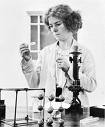
In 1929 Irish crytallographer Kathleen Lonsdale (1903-71) establishes the structure of benzene by X-ray diffraction, followed by hexachlorobenzine by Fourier spectral methods in 1931.

In 1929 Swedish-Am. physicist Harry Nyquist (1889-1976) (pr. NEE-kvist) pub. the Nyquist Theorem, stating that the highest frequency that can be accurately represented by a sampled signal is one-half of the sampling rate, which later proves basic to Digital Audio Processing.


The original Star Trek-Worf Hypothesis of intergalactic languages gets off to a slow start? In 1929 Prussian-born Am. linguist Edward Sapir (1884-1939) (student of Franz Boas) pub. the Sapir-Whorf Hypothesis, that languages constrain the way people think; in 1931 he hooks up with well-fixed linguistic dabbler Benjamin Lee Whorf (1897-1941), and they go on to develop the theory into a form that is slowly accepted by the academic community, boosted by the posth. pub. of Whorf's writings in 1956 - Russians can't say "I have", only "by me is", therefore they naturally go Commie? Brits have the "the/a" game to play with, therefore they naturally build a snooty class society? Americans think of time as something to "spend" or "save", hence they are always in a rush?


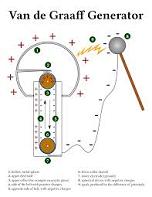 <
<In 1929 Tuscaloosa, Ala.-born Robert Jemison Van de Graaff (1901-67) of Princeton U. builds the first electrostatic Van de Graaff Accelerator (Generator), which produces 80K volts; by 1931 he's up to 7M volts, and eventually 30M volts is reached with tandem generators; after WWII he and John George Trump (1907-85) (uncle or real estate magnate Donald Trump) found the High Voltage Engineering Corp. (HVEC), going on to produce one of the first 1M volt X-ray generators.
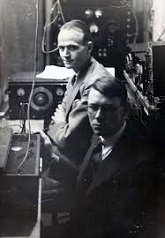
In 1929 Ernest Glen Wever (1902-91) and his asst. Charles William Bray of Princeton U. make a cat telephone to test how sound is perceived by the auditory nerve, discovering the Wever-Bray Phenomenon and the cochlear microphonic, which reproduce a human voice with high fidelity.
In 1929 W.E. Gericke of the U. of Calif. pioneers commercial Hydroponics (Lat. "working with water"), coining the term.
In 1929 a mutant grapefruit in McAllen, Tex. leads to the Ruby Red strain being developed, after which white "inferior" grapefruit is eliminated and only red grapefruit grown.

In Sept. 1930 Am. nuclear scientists Ernest Orlando Lawrence (1901-58) and Niels E. Edlefson of the U. of Calif. pub. the idea behind the Cyclotron (magnetic resonance accelerator); next year Lawrence and his student Milton Stanley Livingston (1905-86) build the first (80 Kev) working model at the U. of Calif.

In 1930 Indian astrophysicist Subrahmanyan Chandrasekhar (AKA Chandra) (1910-95) (paternal nephew of C.V. Raman) calculates the Chandrasekhar Limit of 1.44 solar masses for the max. mass of a white dwarf star that can collapse into a neutron star or black hole after a supernova.

In 1930 English mathematician-geophysicist Sydney Chapman (1888-1970) describes the photochemical mechanisms underlying the Earth's ozone layer; early in this decade he and his student V.C.A. Ferraro predict the existence of the magnetosphere.

In 1930 Am. chemist Thomas Midgley Jr. (1889-1944) of GM invents non-toxic, non-explosive Freon (dichlorodifluoromethane), a chlorinated fluorocarbon (CFC); too bad, it causes little problem with the ozone layer when it is released into the atmosphere, which takes decades to recognize and deal with.

In 1930 Am. biochemist John Howard Northrop (1891-1987) crystallizes the enzyme pepsin, and shows that it is a protein; he does the same with trypsin in 1932, and chymotrypsin in 1935; it is later found that all enzymes are proteins, and he wins the 1946 Nobel Chem. Prize for it.

In 1930 Dutch-Am. biologist Cornelius Bernardus (Kees) Van Niel (1897-1985) works out the process of photosynthesis in green algae, proving that CO2 and water are converted in the presence of sunlight to chemical energy along with waste O2.
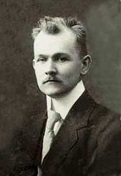
In 1930 Estonian-born German optician Bernhard Woldemar Schmidt (1879-1935) builds the first coma-free 14-in. wide field-of-view Schmidt Mirror Telescope for the Hamburg Observatory.


In 1930 Otis Barton of the U.S. designs the Bathysphere, making the first dive with Am. scientist Charles William Beebe (1877-1962); in 1934 Beebe descends 3,028 ft. into the ocean off Bermuda - and emerges transformed into a squid? On May 27, 1931 Swiss-Belgian scientist Auguste Piccard (1884-1962) and his asst. Charles Knipfer ascend in a balloon from Augsburg, Germany, reaching a height of 51,793 ft. in a 17-hour flight, landing on a glacier near Innsbruck, Austria, becoming the first human flight into the stratosphere; temps of -76 F are recorded; next year he tries again, reaching 55,577 ft. In 1947 Auguste Piccard constructs FNRS-2 (Fonds National de la Recherche Scientifique), the first Bathyscape (Bathyscaph). In 1953 Auguste Piccard and his son Jacques set a depth record of 10,334 ft. in their bathyscape in the Tyrrhenian Trench off Ponza Island, Italy.

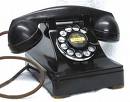
In 1930 Am. industrial designer Henry Dreyfus (1904-72) wins a competition to design the sleek Western Electric 302 tabletop telephone for Bell Labs, going on to become a top industrial designer, designing the Hoover Model 150 vaccum cleaner in 1936, the Westclox Big Ben alarm clock in 1939, and co-founding the Society of Industrial Designers in 1944. In 1959 he designs the Princess Phone, with a petite size to appeal to teenie girls.

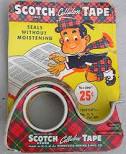
On Sept. 8, 1930 3M Co. of the U.S. ships its first sample of Scotch Cellophone Tape, invented by African-Am. physician Charles Richard Drew (1904-50) to a Chicago firm that wraps bakery goods; to cut costs stingy 3M applies adhesive only to the edges of the tape, causing a St. Paul, Minn. auto dealer to attribute it to stingy Scotch bosses; in 1944 kilt-wearing Scotty McTape first appears, followed by the plaid design in 1945.

In 1930 after emigrating to the U.S., Eugene Jules Houdry (1892-1962) of France develops the Houdry Catalytic Cracking System for petroleum (1930-5) for Sun Oil's Marcus Hook refinery in Penn., becoming the first commercially viable process.

In 1930 German chemist Walter Julius Reppe (1892-1969) makes artificial fabrics from acetylene.
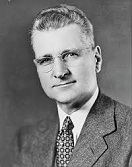
In 1930 Am. chemist Ernest Henry Volwiler (1893-1992) et al. of Abbott Laboratories discover the short-acting barbituate Pentobarbital, which becomes a favorite for execution of convicts; on Mar. 8, 1934 after being discovered by Volwiler et al., physician Ralph M. Waters begins clinical tests of the fast-acting gen. anesthetic Sodium Thiopental (Pentothal), which becomes the anesthetic of choice to initiate surgery, as well as a "truth serum" and legal injection.

In 1930 Jean (Eugenia) Rosenthal (1912-69) pioneers the concept of Theatrical Stage Lighting.
In 1930 GM sales exec Carl Smith gets an idea from the chef on the Southern Pacific Railroad to make biscuits from a premixed bag of ingredients, introducing "wife-saver" Bisquick mix next year.
In 1930 Owen Nacker (1883-1959) of Cadillac develops the perfectly-balanced V-16 Engine; in 1936 he develops the Cadillac V-8 Engine, which is so smooth and powerful that production of the Cadillac V-12 is discontinued.

In 1930 Dutch-born physicist Fritz Zernike (1888-1966) of the U. of Groningen in Germany invents the Phase Contrast Microscope, making possible detailed study of living cells by biologists, winning him the 1953 Nobel Physics Prize.

In 1931 Am. mathematician George David Birkhoff (1884-1944) proposes the Ergodic Theorem, that an individual particle will go through all the states seen in an infinite pop. at an instant in time.

In 1931 after improving his high pressure apparatus, Am. physicist Percy Williams Bridgman (1882-1961) of Harvard U. pioneers research on materials at high pressures (100K atm.).

In 1931 German chemist Adolf Friedrich Johann Butenandt (1903-95) isolates Androsterone, the first crystalline male hormone, later discovered to be a pheromone - Adolph's butt hunt? In 1934 he synthesizes the male hormone testosterone, produced by male testes - whinny?
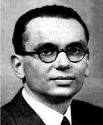
In 1931 Brunn, Austria-born mathematical logician Kurt Friedrich Godel (Gödel) (1906-78) pub. the paper On Formally Undecidable Propositions in 'Principia Mathematica' and Related Systems I, showing that in any axiomatic mathematical system there are propositions that cannot be proved or disproved within the axioms of the system, because a Godel numbering scheme can be devised which allows the proposition to be constructed that "This theorem is false", which is like when Capt. Kirk talks the computer into blowing itself up?; the paper proves to be so good that he decides against a "II".

In 1931 Norman, Okla.-born physicist-engineer Karl Guthe Jansky (1905-50) builds a radio telescope on a farm in N.J. out of aerials and old car wheels, calling it his merry-go-round, using it at first to investigate static in long-distance radio; in Aug. he discovers radio astronomy as the hisses reach a peak four min. earlier each day, matching the period of the Earth's rotation with respect to the stars, causing him to conclude that he is receiving cosmic radio waves.
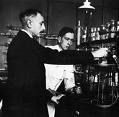
In 1931 Moscow-born Swiss chemist Paul Karrer (1889-1971) of the U. of Zurich isolates Vitamin A, found in carrots - what's up, Doc? In 1935 he synthesizes Riboflavin (Vitamin B2). He shares the 1937 Nobel Chem. Prize with Walter Haworth.


On June 27, 1931 Ukrainian-born Igor Ivanovich Sikorsky (1889-1972) files U.S. patent 1,994,488 for the technology behind the helicopter. On May 13, 1940 he makes the first free flight in the Vought-Sikorsky VS-300, giving the U.S. heli power.

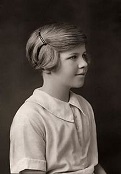

On Feb. 18, 1931 the existence of the 9th solar system planet Pluto is confirmed by Streator, Ill.-born astronomer Clyde William Tombaugh (1906-97) at the Lowell Observatory in Flagstaff, Ariz., using a telescope made out of parts from a cream separator and an old Buick, becoming the first U.S. citizen to discover a planet; it is named by 11-y.-o. Venetia Katharine Douglas Burney (1918-2009) of England, granddaughter of Falconer Madan, brother of English chemist Henry George Madan, who named Deimos and Phobos, and gleefully accepted by Tombaugh because it starts with the initials of astronomer Percival Lowell, who predicted its existence; Mickey Mouse's dog (bloodhound) Pluto debuts in the Disney cartoon The Chain Gang (voice of Jim MacDonald) (he is called Rover in his first two cartoons, and Tombaugh's 11-y.-o. son suggests the name); at 70% rock and 30% ice, and seven solar system moons bigger, is it a planet or a comet of the Kuyper Belt?; the discovery of a planet named after the god of death and the underworld at the time of the rise of the dictators Hitler, Stalin, Mussolini, and Hirohito is no accident? In 2003 2.5km-diam. Eris, a Solar System dwarf planet 27% more massive than Pluto is discovered by Michael E. "Mike" Brown (1965-) of Palomar Observatory, causing Pluto's status as a planet to be reconsidered, and leading to its demotion to dwarf planet.
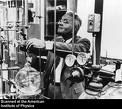
In 1931 Am. physical chemist Harold Clayton Urey (1893-1981) discovers the hydrogen isotope Deuterium (Gk. "deuteros" = second) (heavy hydrogen, incl. a neutron in the nucleus), winning him the 1934 Nobel Chem. Prize.


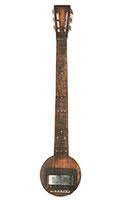


In 1931 the Electric Guitar is invented for jazz musicians by George Delmetia Beauchamp (1899-1941), who founds the Ro-Pat-In (Electro-Patent-Instrument) Co. in Los Angeles, Calif. along with Swiss-born Adolph Rickenbacker (1886-1976) and Paul Barth; Rickenbacker invents the Frying Pan (Pancake) Guitar, made of cast aluminum, first produced in 1932, and discontinued in 1939 after 2.7K are made; the first solid body Spanish style electric guitar is made by Vivi-Tone in 1934, followed by the Electro Spanish, made of Bakelite and marketed by Rickenbacker in 1935 after they change the co. name to Rickenbacker Electro Stringed Instrument Co. In 1939 Am. guitarist Les Paul (1915-2009) invents the Log, one of the first solid-body electric guitars, along with Charles Leonidas "Leo" Fender (1909-91), whose electric guitar is the first to be mass-produced.
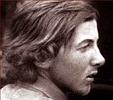
In 1931 Am. composer Henry Dixon Cowell (1897-1965) invents the Rhythmicon (Polyrhythmophone), the first electronic rhythm machine.
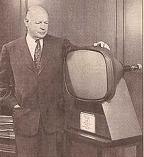
In 1931 Brooklyn, N.Y.-born Allen Balcom DuMont (Du Mont) (1901-65) invents a long-lasting cathode-ray tube (CRT) for use in TV sets, and the Magic Eye Tube in 1932, selling the first commercially practical all-electronic TV set, the Model 180 in June 1938, becoming the first millionaire in the TV business.

In 1931 after Charles Stark Draper inspires him, MIT engineer Harold Eugene "Doc" Edgerton (1903-90) Strobe Photography.
In 1931 Karl Foster (Forster) invents the Foster Slug, a shotgun slug designed to be fired through a smooth bore shotgun barrel, originally used for deer hunting in the Depression, becoming known as "American slugs", and later adopted by police agencies.

In 1931 Roman Catholic priest Rev. Julius Arthur Nieuwland (1878-1936) of Notre Dame U. invents a process for producing Neoprene (polychloroprene), the first synthetic rubber, used for wet suits and fishing boots - love dolls for priests on the way?

In 1931 Harry Ferdinand Olson (1901-82) of RCA develops the RCA 44 Series Ribbon Microphone, which is adopted by CBS.
On Mar. 18, 1931 Schick Inc. of the U.S. markets the first Handheld Electric Razor.
In 1931 the coin-operated Pinball Machine is invented by Automatic Industries, and called the Whiffle Board - life is good between world wars?
In 1931 the first full-scale (30 ft. x 60 ft.) Wind Tunnel is built in Langley Research Center in Va.

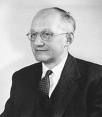


1932: The Annus Mirabilis for Nuclear Physics? On Apr. 14, 1932 after a team at Cavendish Laboratory at Cambridge U. led by Sir John Douglas Cockcroft (1897-1967) and Ernest Thomas Sinton Walton (1903-95) invent the Particle Accelerator, they split the atom, transmuting lithium into helium, winning them the 1951 Nobel Physics Prize; English physicist Sir James Chadwick (1891-1974) discovers the neutron, opening the road to building an atomic bomb; on Aug. 2 Swedish-Am. physicist Carl David Anderson (1905-91), a student of Robert Andrews Millikan (1868-1953) discovers positrons (positive electrons) while analyzing cosmic rays, confirming Paul Dirac's 1930 prediction of the existence of matter and winning him the 1936 Nobel Physics Prize.
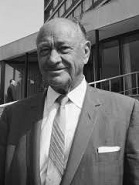
On Apr. 24, 1932 the Apollo Asteroid (1862 Apollo) is discovered by German Heidelberg U. astronomer Karl Wilhelm Reinmuth (1892-1979); on Dec. 5, 1972 the Sisyphus Asteroid is discovered by Paul Wild of Zimmerwald Observatory, and they are traced to the same group, called Apollo Asteroids.

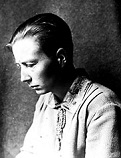
In 1932 Budapest, Hungary-born Am. mathematician John von Neumann (1903-57) pub. The Mathematical Foundations of Quantum Mechanics, which describes operator theory (Neumann algebras), and proves that no "realistic" (hidden-variable) theory can match the predictions of quantum physics; too bad, German mathematician Grete Hermann (1901-84) finds a flaw in his proof in 1935, which remains unknown until it is independently pub. in 1966 by John Stewart Bell.
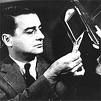
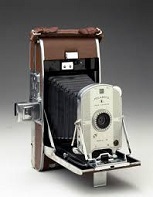
Everybody can own a pic of Edwin-burgh? In 1932 Am. chemist Edwin Herbert Land (1909-91) invents Polaroid Glass, the first practical synthetic light-polarizing material. On Feb. 21, 1947 he publicly demonstrates his Polaroid Land Camera, which develops its own B&W photo in 60 sec.; it goes on sale next Nov. on the day after Thanksgiving at Jordan Marsh Dept. Store in Boston, Mass., launching a craze; it takes until 1962 to go color; Land retires in 1982, and the name is dropped in 1983.
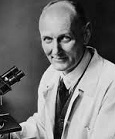
In 1932 chemists Fritz Mietzsch (1896-1958) and Josef Klarer (1898-1953) of Bayer Co. in Germany patent Sulfa Drugs (sulfonamides), the first effective antiobiotic and first bioactivated medicine; too bad, they lose their patent because the active molecule sulfonilamide was discovered in 1906, causing a boom in usage; a team led by physician Gerhard Johannes Paul Domagk (1895-1964) of Bayer Co. in Germany discovers Prontosil, the first sulfa drug for treating streptococcal infections, and the first commercial antiobiotic, winning the 1939 Nobel Med. Prize; English physician Leonard Colebrook (1883-1967) introduces it as a cure for puerperal fever.

In 1932 August Dvorak (1894-1975) of the U. of Washington in Seattle (a distant cousin of Czech composer Antonin Dvorak) invents the Dvorak Keyboard, which beats the QWERTY keyboard hands down for speed; too bad, it is not accepted (until ?).
On Mar. 9, 1932 after its super-popular 4-cylinder Model A shows signs of competition eating its lead away, losing its #1 position to Chevrolet and its stylish 6-cylinder low-price cars, causing Henry Ford to lay off 75K workers and close 25 of 36 plants and commission an all-out secret effort to invent it on July 29, 1931, Ford Motor Co. produces its first Flathead V-8 engine with a single-block casting, which is publicly unveiled on Mar. 31, and is used in 1932-53 Ford models; watch video.


In 1933 after computing the avg. mass of galaxies inside the Coma galaxy cluster to be 160x what is expected from their luminosity alone, Swiss astrophysicist Fritz Zwicky (1898-1974) proposes Dark Matter, which isn't widely accepted until 1998 - too many racial undertones? In 1934 he and Walter Baade (1893-1960) of Caltech coin the term "supernova", and hypothesize that they are caused by normal stars turning into neutron stars, and are the source of cosmic rays. In 1937 he proposes that galaxies can act as graviational lenses via the Einstein Effect, which is confirmed in 1979 by Twin Quasar Q0957+561.

In 1933 "Mr. Radio" Edwin Howard Armstrong (1890-1954) of the U.S. invents static-free Frequency Modulation (FM) radio broadcasting, which varies the carrier frequency while keeping the amplitude constant; he demonstrates it in 1935; RCA, which is heavily invested in the inferior AM radio technology gives him a hard time?
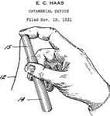
On Sept. 12, 1933 Denver, Colo. physician Earle Haas (1888-1981) patents the first Tampon with applicator (#1,926,900), selling it on Oct. 16 to Gertrude Tenderich (tender itch?) of Denver, Colo. for $32K, who founds the Tampax Co.; in 1935 Kimberly-Clark turns it down for $7.2K; the first deodorant tampon is introduced by Playtex in 1971; the Nat. Assoc. of Broadcasters bans them from TV until 1972.

In 1933 Frederick J. "Fred" Osius invents the Waring "Miracle Mixer" Blender, and in 1936 gets financing by jazz bandleader Fred Waring (1900-84), introducing it in 1937 for $29.75 retail, changing peoples' eating habits.
In 1933 Steenbergen Co. of Germany introduces Exakta, the first 35mm single-lens reflex (SLR) camera, with a trapezium shape.


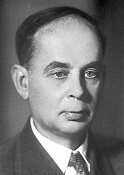
In 1934 after English physicist Oliver Heaviside predicts it in 1888, Soviet physicist Pavel Chekov, er, Pavel Alekseyevich Cherenkov (1904-90) discovers Cherenkov Radiation, caused by charged atomic particles moving faster than the speed of light in a local medium, winning him the 1958 Nobel Physics Prize, along with Soviet physicists Igor Yevgenyevich Tamm (1895-1971) and Ilya Mikhailovich Frank (1908-90), who explain the phenomenon in relativistic terms.

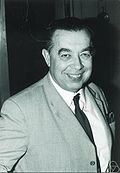
In 1934 Russian mathematician Alexander Osipovich Gelfond (1906-68) and German mathematician Theodor Schneider (1911-88) independently prove the Gelfond-Schneider Theorem, that an algebraic number to the power of an algebraic irrational number is transcendental, e.g., 2 to the power of the square root of 2 (the Gelfond-Schneider Constant), finally providing an infinite number of funky transcendental numbers to play with and answering Hilbert's Seventh Problem (1900) affirmatively; e to the pi power, known as Gelfond's Constant is also transcendental, and since it comes out to 23.14069... that proves that The Number 23 is the Answer to Life, the Universe, and Everything?
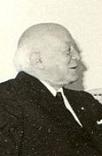
In 1934 Romanian aerodynamicist Henri Marie Coanda (1886-1972) patents the Coanda Effect, the "deviation of a plain jet of a fluid that penetrates another fluid in the vicinity of a convex wall", i.e., the tendency of a fluid jet to be attracted to a nearby surface; it is later used for hovercraft.

In 1934 French husband-wife team Irene Joliot-Curie (1897-1956) (daughter of Marie Curie) and Jean Frederic Joliot-Curie (1900-58) discover that all elements can be made radioactive by subjecting them to bombardment with alpha particles (artificial radioactivity); later other fast particles produced by accelerators are found that do this trick.

In 1934 the U.S. Public Health Service, led by dentist Dr. Henry Trendley Dean (1893-1962) begins a study to determine the optimal level of fluoride in water; in 1942 the study concludes that 1 PPM is the magic number.
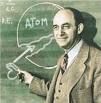
In 1934 Enrico Fermi (1901-54) of the U. of Rome proposes that neutrons and protons are the same fundamental particles in two different quantum states.


In 1934 Am. chemist Paul John Flory (1910-85) introduces the concept of excluded volume for polymers to explain several puzzling experimental results, winning him the 1974 Nobel Chem. Prize; Swiss chemist Werner Kuhn (1899-1963) coins the term.

In 1934 Dutch mathematician-economist Tjalling Charles Koopmans (1910-85) pub. Koopmans' Theorem, that the first ionization energy of a molecular system is equal to the negative of the orbital energy of the highest occupied molecular orbital.
In 1934 John S. Lundy of the Mayo clinic first demonstrates the use of the anesthetic Thiopental (Sodium Pentothal), which becomes the anesthetic of choice to initiate surgery, as well as a "truth serum".
In 1934 the board game Monopoly is marketed by Parker Brothers, claiming it was invented by Clarence Darrow, who sold them the rights; when it is later discovered that the game goes back to at least 1903, its trademark is ruled generic in 1979.

In 1934 Smith and Wesson begins marketing the .357 Magnum revolver, "the most powerful handgun in the world"; it uses a modified .38 Special cartridge, whose 1K fps cartridge velocity is just high enough to get through a bulletproof vest as well as car doors, making it popular with police to use against gangsters.
In 1934 Canadian-born Am. Springfield, Mass. Armory consulting engineer John Cantius Garand (1888-1974) (pr. ga-RAAH) patents the M1 Garand Rifle, becoming the first successfull semi-automatic rifle to be put into active military service; he never receives any royalties.
In 1934 Wiley Post tests the first practical high altitude rubberized pressure suit developed for him by B.F. Goodrich Co. on Sept. 5, and reaches an alt. of 40K ft. over Chicago, later reaching 50K ft. and discovering the Jet Stream - you're looking at the secret of hassle-free travel?
In 1934 the fiber-based laxative Metamucil begins to be marketed by G.D. Searle & Co., competing with tablet-form Ex-Lax (1906) and liquid-form Milk of Magnesia (1880), not to mention bran.
In 1934 Henry F. Phillips (1890-1958) of Portland, Ore. patents the Phillips-Head Screw, selling it to Ford Motor Co. in 1945 for $45M.


In 1934 after urging by the German DAF (Worker's Front) of Robert Ley, Adolf Hitler and Ferdinand Porsche (1857-1952) begin work on the Volkswagen ("people's car"); when the German auto industry can't sell it for 1K marks or less, the DAF takes it over completely, and gets Porsche to build a factory in Fallersleben, paid for by appropriating DAF member dues; the first models appear in Feb. 1939, but the outbreak of WWII causes all 340K of the paid customers to get stiffed.

On Apr. 24, 1934 Laurens Hammond (1895-1973) patents the Hammond Organ (no vibrating parts, reeds or pipes).
In 1934 Elizabeth S. Kingsley (1851-1957) invents the Double-Crostic, which first appears in the Saturday Review.
In 1934 George P. Nissen (1914-) of Iowa invents the Trampoline (named after the Sp. word for springboard) using an angle iron, canvas bed, and rubber springs.
In 1934 Phthalocyanine Dyes are first prepared.

In 1935 Carl Peter Henrik Dam (1895-1976) of the Polytechnic Inst. in Cophenhagen, Denmark discovers vitamin K, which cures a disease in chickens causing hemorrhages.
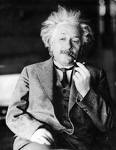


In 1935 Albert Einstein (1879-1955) and Nathan Rosen (1909-95) pub. a paper describing the Einstein-Rosen Bridge, which is later called a Wormhole; they and Boris Yakovlevich Podolsky (1896-1966) formulate the EPR Paradox that shows that quantum mechanical theory is incomplete; after Erwin Schrodinger coins the term "entanglement", Einstein describes it as "spooky action at a distance" (spukhafte Fernwirkung), launching the theory of Quantum Entanglement; in 2008 Swiss physicists measure the speed of spooky action at a distance as at least 10K times c, which is is confirmed by Chinese physicists in Mar. 2013, leading to a theory of a subluminal, superluminal, or transluminal universe, or universe behind the universe where our physical laws don't apply?

In 1935 Dutch physicist Wander Johannes de Haas (1878-1960) et al. of the Kamerlingh Onnes Lab at the U. of Leiden reach a record low temp of 0.005K.
In 1935 Erik Jorpes of the Karolinska Inst. in Sweden isolates the anticoagulant Heparin (Gr. "liver"), and pioneers its use with patients suffering from thrombosis; it has the highest negative charge density of any biological molecule.

In 1935 Charles Francis Richter (1900-85) of Cal-Tech pub. the logarithmic Richter Scale for earthquakes, using measurements on a Wood-Anderson torsion seismometer; his partner Beno Gutenberg (1889-1960) shies away from getting credit - the Gutenbergs already have enough good press?

In 1935 Am. biochemist William Cumming Rose (1887-1985) discovers threonine, the last of the 20 amino acid molecules in proteins; the first were discovered in 1820.
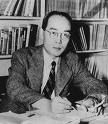
In 1935 Japanese physicist Hideki Yukawa (1907-81) prostulates a new nuclear particle, the Pi Meson (Pion), intermediate in mass between an electron and proton (200x electron mass), for which he becomes the first squint-eyed, er, Jap, er, Japanese flower child to win a Nobel Prize (1949). In 1936 Carl David Anderson, S.H. Neddermeyer et al. in the U.S. demonstrate in cosmic rays the presence of positively and negatively charged mesons as predicted by Yukawa in 1935.
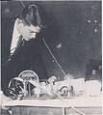
On Feb. 2, 1935 Am. detective Leonarde "Narde" Keeler (1903-49) demonstrates the Keeler Polygraph on two criminals in Portage, Wisc.; they are convicted of assault after the results are used in court.
In 1935 Am. inventor R. Stanton Avery (1907-97) invents self-adhesive labels, founding Avery-Dennison Co..

In 1935 Am. Dupont chemist Wallace Hume Carothers (1896-1937) invents Nylon thread by squeezing a chemical solution through a hypo needle; it is originally known as Polymer 66, renamed after the main Dupont HQs in NY and London, and patented in 1937, but deliberately not trademarked - they don't want people to call it humeon or carotheron? On Feb. 24, 1938 the first nylon products, toothbrushes are marketed in N.J. by Dupont, which doesn't announce the name "nylon" for its new synthetic yarn until Oct. 27. On Oct. 24, 1939 nylon stockings are sold publicly for the first time in Wilmington, Del.

In 1935 Kodak introduces Kodachrome, the first multi-layered color film, developed by Leopold Godowsky Jr. (1900-83) (whose father Leopold Godowsky Sr. was a violinist and good friend of Albert Einstein) and Leopold Mannes (1899-1964); next spring it is introduced in 8mm movie film size, followed by 35mm size in Aug.-Sept., 1936; it is discontinued in 2009.

In 1935 after rumors of a Nazi death ray get the program started, Scottish-born British engineer Robert Alexander Watson-Watt (1892-1973) pioneers the use of radar equipment for detecting aircraft, becoming known as "the Father of Radar" and getting knighted in 1942 - one of the reasons Scots get a rep for being good engineers?
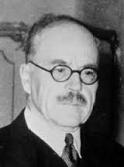
In 1935 the Royal Radar Establishment (TRE) is founded in Orfordness (near Ipswich), England by Sir Henry Thomas Tizard (1885-1959) to do research and development of radar for the defense of Britain; the word "Boffin" is first used by their scientists to describe themselves, based on the char. Nicodemus Boffin in Charles Dickens' "Our Mutual Friend", who is described as a "very odd-looking old fellow indeed", becoming a more flattering word than "geek" or nerd".



On Nov. 2, 1936 the world's first regular television (TV) broadcasting service is launched by the BBC at Alexandra Palace in London, with a startlingly high definition of 240 lines as a result of work done by Italian-born Guglielmo Marconi (1874-1937) and Romanian-born Isaac Jacob Schoenberg (1903-90); Buck and Bubbles perform live, becoming the first African-Am. TV artists.

In 1936 colorless, odorless organophosphate Tabun (GA), the first nerve agent is synthesized by German I.B. Farben scientists led by Gerhard Schrader (1903-90); after adding fluorine, Sarin follows in 1938, Soman (GD) in 1944, and super-dangerous persistent non-volatile Cyclosarin (GF) in 1949.
In 1936 the first Blood Bank in the U.S. is established at Cook County Hospital in Chicago, Ill. by Bernard Fantus.

In 1936 Viennese-born Canadian physiologist Hans Selye (1907-82) discovers evidence that mental stress affects the physical state of the body.
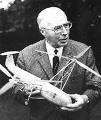

In 1936 the Focke Wulf Fw 61, the world's first fully controllable practical helicopter makes its first flight on June 26, test-flown by German pilot Hanna Reitsch (1912-79) in Bremen; too bad, designer Heinrich Focke (1890-1979) is ousted from his own co. by the stockholders in order to begin manufacturing Me 109 aircraft for the govt., but the govt. later decides to let him set up a new heli co., the Focke-Achgelis Co. next Apr. 27 along with Gerd Achgelis, causing the heli to also be called the Fa 61.

In 1937 Austrian Jewish physicist Marietta Blau (1894-1970) uses a photographic plate to examine cosmic radiation at high altitude and uncover new fundamental particles; too bad, the Nazis force her to flee to Mexico, where her friend Albert Einstein gets her a job at the Polytechnical Inst. in Mexico City, followed by the U.S. in 1944, and in 1950 she is snubbed for the Nobel Prize for her photographic method of particle detection in favor of all-male Cecil Powell.

In 1937 German-born English Jewish biochemist Hans Adolf Krebs (1900-81) identifies the 8-step Citric Acid (Krebs) Cycle, the metabolic pathway for cellular oxidation of carbohydrates and fats.
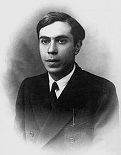
In 1937 Italian physicist Ettore Majorana (1906-60) proposes the Majorana Fermion (Particle), which is its own antiparticle, in contrast to the Dirac fermion; first detected in 2017.

In 1937 Italian mineralogist Carlo Perrier (1886-1948) and Italian physicist Emilio Gino Segre (Segrè) (1905-89) of the U. of Palermo in Sicily discover the metallic element Technetium (Tc) (#43) in discarded molybdenum foil from cyclotron parts of the Lawrence Radiation Lab, becoming the first artificially-produced element; the name panormium, after the Latin name for Palermo (Panormus) is chucked.


In 1937 Dutch botanist Frits Warmolt Went (1903-90) pub. the theory that the plant hormone Auxin helps plants bend toward the light; Soviet scientist Nikolai Grigoryevich Cholodny (1882-1953) independently pub. the same theory; proved in 2013.

In 1937 Seattle-Wash.-born physicist (son of an immigrant Swedish barber) Chester Floyd Carlson (1906-58) perfects the xerographic (Gr. "dry writing") electrostatic photocopier in the back room of his mother-in-law's beauty salon in Queens, N.Y.; on Oct. 28, 1938 he demonstrates his patented photocopier in Queens, N.Y., but can't get any existing corp. (IBM, RCA, Kodak et al.) to back him; the first photocopy says "10-28-38 Astoria"; he finally sells the invention in 1947 to the Haloid (later Xerox) Co. and becomes a millionaire; the first copier ends up in the Smithsonian Inst. On Sept. 16, 1959 the 650 lb. $29.5K Xerox 914 Copier is introduced at a televised demonstration at the Sherry-Netherland Hotel in New York City, making six plain paper 9 in. x 14 in. copies per min. (1 each 26.4 sec.) (136 copies an hour) (100K copies per mo.), creating a rev. in paper reproduction with the first successful commercial plain paper copier; Haloid Xerox leases them for $75 a mo. plus 5 cents a copy (over 2K), quickly grabbing 97% of the market, and changing the co. name to Xerox in 1961.
In 1937 Edward Farber (1914-82) of the U.S. invents the "stop-action" Stroboscopic Flash Unit for still cameras.
In 1937 Okla. City supermarket owner Sylvan Nathan Goldman (1898-1984) introduces his new invention, the Shopping Cart into his Standard Supermarkets on June 4; the oddly appealing patent (compared to parking meters) makes him a millionaire.
In 1937 James Hillier and Albert Prebus of the U. of Toronto unveil an Electron Microscope with 7Kx magnification.
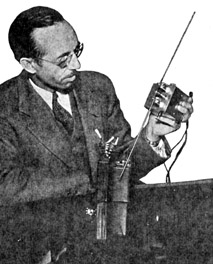
In 1937 English-born Canadian inventor Donald Lewes "Don" Hings (1907-2004) invents the first 2-way radio for Australian Bush pilots, and files a U.S. patent in 1937; during WWII U.S. journalists rename it the Walkie-Talkie.

In 1937 English engineer Sir Frank Whittle (1907-96) builds the first gas turbine jet engine.

In 1938 Walter Baade (1893-1960) of Caltech proposes using supernovae as "standard candles" to estimate cosmological distances in deep space; when the scale proves nonlinear with Type IA supernovae, the expansion rate of the Universe is claimed to be accelerating.

In 1938 Am. electrical engineer Frank Albert Benford Jr. (1883-1948) pub. a paper announcing Benford's Law, that in tables of statistics the digit 1 tends to occur with a probability of about 30% - we're all trying to become one?


In 1938 German-born U.S. physicist Hans Albert Bethe (1906-2005) et al. discover the Carbon Cycle of Nuclear Fusion and the Proton-Proton Chain, two nuclear reactions which generate the energy of main sequence stars; Carl Friedrich von Weizsacker (Weizsäcker) (1912-2007) of Germany, who later becomes a leader of Germany's dud nuclear bomb project independently proposes the same reactions.
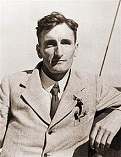
In Apr. 1938 using 147 widespread land-based weather stations, Montreal, Canada-born British steam engineer Guy Stewart "G.S." Callendar (1898-1964) pub. the paper The artificial production of carbon dioxide and its influence on temperature (submitted May 19, 1937) in the Quarterly Journal of the Royal Meteorological Sociey, announcing the Callendar (Greenhouse) Effect caused by the burning of fossil fuels, assessing climate sensitivity at 2°C and claiming that it would be beneficial, delaying a "return of the deadly glaciers", meeting with widespread skepticism until 1950 then leading to attempts to measure atmospheric CO2 concentrations in Hawaii in 1958; only about 60 stations are needed?; "By fuel combustion man has added about 150,000 million tons of carbon dioxide to the air during the past half century. The author estimates from the best available data that approximately three quarters of this has remained in the atmosphere. The radiation absorption coefficients of carbon dioxide and water vapour are used to show the effect of carbon dioxide on 'sky radiation.' From this the increase in mean temperature, due to the artificial production of carbon dioxide, is estimated to be at the rate of 0.003°C. per year at the present time. The temperature observations at 200 meteorological stations are used to show that world temperatures have actually increased at an average rate of 0.005°C. per year during the past half century."



In Apr. 1938 Italian neurologist Ugo Cerletti (1877-1963) and Italian psychiatrist Lucio Bini (1908-64) of Rome discover Electroconvulsive (Electric Shock) Therapy - Rome, home of the Inquisition? On Nov, 19, 1975 Milos Forman's One Flew Over the Cuckoo's Nest debuts, based on the 1962 Ken Kesey novel, starring Jack Nicholson as two-bit crook Randle Patrick McMurphy, who fakes insanity to get sentenced to a cushy nuthouse, and Louise Fletcher as mean, cunning head nurse Ratched, who gets in a war of wills and finally turns him into a drugged, shocked-out lobotomized mush-head, after which Big Chief Bromden (Will Simpson) smothers him with a pillow to put him out of his misery, and escapes to Canada; film debuts of Sampson, Brad Dourif (as suicidal Billy Bibbit), and Christopher Lloyd (as Jim Taber); wins five Academy Awards (most since "It Happened One Night" in 1934); Kirk Douglas is hurt when his son Michael, the producer, passes him over for Nicholson as too old, since he originated the role onstage; #3 grossing film of 1975 ($46.6M). The film gives electric shock treatment a permanent stigma, despite improvements making it virtually pain-free.

On Dec. 23, 1938 a Coelacanth, a large lobe-finned fish thought to have been extinct for 65M years is fished out of the Indian Ocean off the E coast of South Africa in a trawler's net, and the discovery made by Marjorie Eileen Doris Courtenay-Latimer (1907-2004), curator of the East London (South Africa) Museum; in 1939 South African ichthyologist James Leonard Brierley Smith (1897-1968) confirms it, and names the species Latimeria after her.




In 1938 German radiochemists Otto Hahn (1879-1968) and Friedrich Wilhelm "Fritz" Strassmann (1902-80) bombard uranium with neutrons and find a barium isotope in the product; Lise Meitner (1878-1968) and her nephew Otto Robert Frisch (1904-79) (Jews) explain the result by fission of the uranium nucleus, with the mass difference accounted for by Einstein's formula E=MC^2, and nuclear fission is a reality; Hahn wins the 1944 Nobel Chem. Prize, becoming known as "the Father of Nuclear Chemistry"; Meitner is snubbed; Niels Bohr goes on to develop the theory of fission, and is the first to point out that U-235 is responsible for observed fission phenomena; meanwhile Lisa Meitner escapes from Berlin to Copenhagen with the help of Dutch physicist Dirk Coster, then goes to Sweden - the Allies won WWII right there?
In 1938 Karter, Salomon, and Fritzsche chemically identify Vitamin E (Alpha-Tocopherol).

In 1938 the psychedelic drug LSD (lysergic acid diethylamide) is first synthesized by Swiss physician and chemist Albert Hofmann (1906-2008) at Sandoz Labs in Basel from ergot, a fungus that grows on rye; on Apr. 19, 1943 (Bicycle Day) he becomes the first person to take an acid trip, experiencing the most intense systems while bicycling home from his lab, uttering the soundbyte: "There surged upon me an uninterrupted stream of fantastic images of extraordinary plasticity and vividness and accompanied by an intense, kaleidoscopelike play of colors."

In 1938 English psychiatrist Lionel Sharples Penrose (1898-1972) pub. the Colchester Survey, a study of the genetics of mental retardation, finding that the relatives of patients with severe retardation are usually unaffected, but sometimes have severe retardation, while relatives of patients with mild retardation tend to stick with mild or borderline retardation.

In 1938 amateur radio astronomer Grote Reber (1911-2002) of Wheaton, Ill. detects shortwave radiation coming from the Milky Way at 160 MHz, going on to make a radio frequency sky map by 1941.

In 1938 Am. pyschologist Burrhus Frederic Skinner (1904-90) invents Operant Contingency to produce and define purposive behavior. In 1958 he becomes prof. of psychology at Harvard U., going on to become the most influential psychologist of the 20th cent., promoting his Radical Behaviorism philosophy of science, with the soundbyte "Behave is what organisms do." In 1971 he pub. Beyond Freedom & Dignity, which claims that the fetish for individualism, free will, and moral autonomy stands in the way of using scientific methods to modify behavior to make a better happier society.

In 1938 German embryologist Hans Spemann (1869-1941) pub. Embryonic Development and Induction, containing the first description of the possibility of cloning by nuclear transfer?

In 1938 French philosopher Gaston Bachelard (1884-1962) pub. The Formation of the Scientific Mind (La Formation de l'Esprit Scientifique), which introduces the epistemological obstacle, epistemological rupture, and epistemological break.

In 1938 sci-fi writer H.G. Wells (1866-1946) pub. World Brain, describing a microfilm-based World Encyclopedia as part of a NWO, which is outside the "highly conservative and resistant university system", which he compares to "men who go out in armour with bows and arrows to meet a bombing aeroplane" and are "floating over the general disorder of mankind like a beautiful sunset over a battlefield."
In 1938 Vitamin B6 (Pyridoxine) is isolated by three independent research teams, then synthesized next year.
On Feb. 17, 1938 the first Baird Color TV is demonstrated at the Dominion Theatre in London.

In 1938 the Ballpoint Pen is patented by Hungarian journalist Laszlo (Lajos) (Ladislao) Jozsef Biro (1899-1985) (pr. BEE-row) and his brother Georg (George) Biro, who emigrate to Argentina; in 1940 the British RAF adopts the pens for pilots, since they don't leak at high altitudes - tell us about the prosthetic leg?
In 1938 Alfred M. Butts (1900-93) invents the game of Scrabble, which game manufacturers reject until Macy's discovers it in 1952, after which it sells 100M sets by his death - buttheads?

In 1938 Roy J. Plunkett (1910-94) of DuPont Co. invents Teflon (polytetrafluoroethylene).

In 1938 English engineer Alec Harley Reeves (1902-71) of Western Electric patents Pulse-Code Modulation (PCM); too bad, it's too expensive for all but govt. higher-ups to use until the advent of the transistor in the 1950s.

In 1938 Russell Games Slayter (1896-1964) of Owens-Corning Co. invents the first commercial Fiberglass.







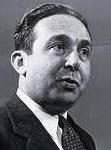




On Jan. 22, 1939 the atom is first split at Columbia U.; in Mar. the possibility of a nuclear chain reaction accompanying the fission of uranium by neutrons, uncovered by German Jewish radiochemists Lise Meitner (1878-1968) and her nephew Otto Robert Frisch (1904-79) is discussed by French physicists Frederic Joliot-Curie (1900-58), Hans Heinrich von Halban (1908-64) and Lew Kowarski (1907-79) and Italian-born U.S. physicist Enrico Fermi (1901-54), exciting considerable interest among scientists about the possibility of a nuclear bomb; Fermi wins the 1938 Nobel Physics Prize for his work on induced radioactivity by neutron bombardment and the discovery of transuranic elements, becoming known as "the Architect of the Nuclear Age". On Aug. 2, 1939 after Hungarian-immigrant Jewish physicists Leo Szilard (Leó Szilárd) (1898-1964) (who had produced a nuclear chain reaction in his lab at Columbia U.) and Eugene Paul Wigner (1902-95) (both of whom are put up to it by Niels Bohr) drive to the summer vacation cottage on Old Cove Rd. on Nassau Point in Cutchogue, Long Island (sunniest spot in N.Y.) of pipe-smoking bike-riding Albert Einstein (1879-1955) to persuade him to help the U.S. develop the atomic bomb in the fear that Germany could build one first, asking directions of a 7-y.-o. boy on the street to find him, Szilard explains the concept of a nuclear chain reaction to him, and replies "I never thought of that" (Daran habe ich gar nicht gedacht), then signs the famous Aug. 2, 1939 Letter to Pres. Roosevelt urging the creation of an atomic weapons research program, which after Jewish-Am. economist (friend of Einstein) Alexander Sachs (1893-1973) meets with FDR on Oct. 11 and delivers it becomes the Manhattan Project. On Sept. 17, 1939 a meeting is held in the Army Ordinance HQ in Berlin to launch the German A-bomb Project, led by physicists Werner Karl Heisenberg (1901-76) and Carl Friedrich von Weizsaecker (Weizsäcker) (1912-2007), based in Strasbourg. Nerds win in Chi town? In fall 1939 the U. of Michigan plays the U. of Chicago at Stagg Field in Chicago and wins by a score of 85-0; the next day UC pres. (1929-45) Robert Maynard Hutchins (1899-1977) bans jock-friendly football and turns the stadium over to nerdy scientists, who go on to create the first atomic pile.

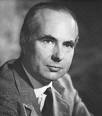

In 1939 English physiologists Sir Alan Lloyd Hodgkin (1914-98) and Sir Andrew Fielding Huxley (1917-2012) (half-brother of Aldous Huxley) pub. the first recording of an Action Potential. In 1953 they and Australian neurophysiologist Sir John Carew Eccles (1903-97) determine that the movement of ions into and out of neurons is the basis of nerve signal transmission, winning them the 1963 Nobel Med. Prize.




In 1939 Soviet mathematician-economist Leonid Vitaliyevich Kantorovich (1912-86) invents Linear Programming for the optimal allocation of resources, receiving the 1975 Nobel Econ. Prize; Linear Programming is kept secret until 1947, the same year that Portland, Ore-born mathematician George Bernard Dantzig (1914-2005) pub. the Simplex Method, and Budapest, Hungary-born Am. mathematician John von Neumann (1903-57) pub. the theory of Duality. On June 30, 1945 John von Neumann et al. pub. the First Draft of a Report on the EDVAC, describing the Von Neuman (Princeton) Architecture for a Digital Computer, the first pub. description of a stored-program computer, which uses a single bus for the instruction fetch and the data operation, contrasting with the Harvard Architecture for a Digital Computer, which uses two or more buses, first proposed by Howard Hathaway Aiken (1900-73) in Nov. 1937 and used in the Harvard Mark I Computer in 1944.


In 1939 Russian-born Am. physiologist Nathaniel Kleitman (1895-1999) of the U. of Chicago pub. Sleep and Wakefulness. In 1953 he and his grad student Eugene Aserinsky (1921-98) discover Rapid Eye Movement (REM) Sleep, and study it using an electroencephalograph, correlating it with dreaming and a gen. increase in brain activity, founding modern Sleep Research.

In 1939 Am. scientists Philip Levine (1900-87) and Rufus E. Stetson (1886-1967) discover the Rh factor in human blood, named for rhesus monkeys.

In 1939 French mathematician Paul Pierre Levy (Lévy) (1886-1971) introduces the concept of Martingales into probability theory, where the expectation of the next value in a sequence is the present observed value, modeling fair games.

In 1939 Am. biochemist Karl Paul Link (1901-78) discovers Dicumarol in sweet clover, a derivative of coumarin with anti-clotting qualities.

In Sept. 1939 Swiss Geigy Co. pesticide researcher Paul Hermann "Pauly" Muller (Müller) (1899-1965) discovers the insecticidal powers of the synthetic chemical DDT (Dichloro-Diphenyl-Trichloroethane) to control clothes moths, patenting it in Switzerland (1940), England (1942), and the U.S. (1943), after whch Merck & Co. manufactures it for Allied troops to control louse-borne typhus, which dramatically cuts deaths from malaria, causing WHO in May 1955 to launch its Global Malaria Eradication Campaign (GMEC), with DDT use peaking in 1962 (160M lbs.) after saving 500M human lives; too bad, in 1962 Rachel Carson pub. "Silent Spring", calling DDT carcinogenic and claiming that its continued use would wipe out "practically 100 percent" of the human pop. in a single generation, and create a race of super-insects, leading to the poisoning of the entire food chain while severely hampering bird reproduction by thinning the egg shells; in 1967 malaria is eradicated from all developed countries, which doesn't stop the U.S. from banning it on Jan. 1, 1972, and WHO in 1975; after Carson's claims are shown to be moose hockey, but stubbornly clung to by Malthusians who love the idea of reducing pop. growth, it takes until Sept. 2006 for WHO to resume use - heads, shoulders, knees and toes, knees and toes?

In 1939 Am. physicist Julius Robert Oppenheimer (1904-67) and his graduate student Hartland Snyder propose the idea of a Black Hole, but are ignored until the 1960s - a case of black discrimination?

In 1939 a rabbit, the first animal conceived by not-so-good not-so-fun Artificial Insemination is displayed at the 12th Annual Graduate Fortnight at the New York Academy of Medicine on Nov. 1 by U.S. biologist Dr. Gregory Goodwin Pincus (1903-67) (pink as in pink wabbit?) of Clark U.
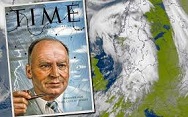
In 1939 Swedish-born Am. meteorologist Carl-Gustaf Arvid Rossby (1898-1957) of the U.S. Weather Bureau and U. of Chicago discovers Rossby Waves in the Earth's atmosphere, due to the variation in the Coriolis effect with latitude, leading to large-scale meanders of the Jet Stream (which he also identifies) that cause masses of cold or warm air to detach and become low-strength cyclones and anticyclones, driving daily weathern patterns at mid-latitudes, making the E coast of the U.S. colder than the W coast at a given latitude.

In 1939 Am. Antarctic explorer Paul Allman Siple (1908-68) coins the term "wind chill" in a dissertation.
In 1939 Dutch scientist Evert Verwey discovers that the electrical conductivity of magnetite decreases abruptly and dramatically at 125K (-150C), turning into an insulator; it takes until late 2011 to discover why, namely, that the chemical structure reararranges, causing electrons to be trapped inside groups of three iron atoms.

In 1939 John Archibald Wheeler (1911-2008) of Princeton U. hosts quantum mechanics philosopher king Niels Bohr, and together they devise the Liquid Drop Theory of the Nucleus; it elongates into a peanut shape then snaps in two after a neutron hits it.
In May 1939 the first Fully Automatic Transmission, the Hydra-Matic Drive, invented by Earl A. Thompson is introduced commercially in Oldsmobiles.



On Aug. 27, 1939 the first Turbojet Airplane, the 4.4K-lb. German Heinkel He-178, powered by a Heinkel S3B turbojet, designed by Hans Joachim Pabst von Ohain (1911-98) is test-flown at Marienehe in N Germany by pilot Capt. Erich Warsitz (1906-83); on Nov. 1 it is demonstrated to the German Air Ministry - if they hadn't yawned it off the war might have turned out differently?

In 1939 German physicist Ernst August Friedrich Ruska (1906-88) of Siemens-Reiniger-Werke AG develops the first commercial Electron Microscope providing 400x magnification. On Apr. 20, 1940 RCA of Camden, N.J. publicly demonstrates the first Electron Microscope that permits direct visualization of viruses.

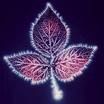
The mass horrors of the Nazi era are captured on what kind of film? In 1939 Kirlian Photography (not Kirilian) (AKA Bioelectric Photography) is invented by Russian-Armenian inventor Semyon Davidovich Kirlian (1898-1978), using a high-voltage electric field to capture images of auras allegedly given off by living things. Also in 1939 the Nazis invent the Haunebu Anti-Gravity Engine for their flying saucers?

In Nov. 1939 Sir John Turton Randall (1905-84) of Birmingham, England invents the Cavity Magnetron microwave transmitter, which is 1000x more powerful than previous transmitters, becoming the basis of radars and microwave ovens - winning the Battle of Britain?



On Sept. 1, 1939 - Sept. 2, 1945 the horrific $3.5T World War II results in 24M military and 49M civilian deaths, and features the low point of the Jewish Holocaust (Shoah) by the German Nazis - I guess it was the Jews' fault for not ransoming themselves to go to Israel before they could round them up for the camps? The whole experience turns Jews from lovers into fighters, ramping up the Zionist movement with full world sympathy and support by new world superpower U.S., which has its own guilt trip because on Nov. 24, 1942 Budapest-born Am. Zionist leader Rabbi Stephen Samuel Wise (1874-1949) announces in a press conference in Washington, D.C. that he was authorized by the U.S. State Dept. to confirm that the Nazis had murdered 2M Jews as part of a plan to exterminate all Jews in Europe; too bad, the nat. newspapers don't consider it front page news, and the U.S. govt. does nada. After the war ends and Americans tour the concentration camps in horror, Polish-born Jewish scholar Raphael Lemkin (1900-59), who single-handedly led an unsuccessful campaign to get the League of Nations to give internat. protections against genocide starting in 1933 finally gets what he wanted after his own people got it, namely the Dec. 9, 1948 U.N. Convention on the Prevention and Punishment of the Crime of Genocide (Gen. Assembly Resolution 260), which doesn't come in force until Jan. 12, 1951, and which the U.S. still doesn't ratify until 1988.
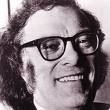

The last year that the U.S. govt. doesn't copy the Gestapo? In winter 1939 acting on tips, the U.S. Secret Service raids the home of a group calling themselves the Futurians with guns drawn, hoping to catch a counterfeiting ring; finding that it is just the home of a group of teenie fledgling science fiction authors, incl. Isaac Asimov (1920-92), and Frederik Pohl (1919-), who pub. their works on a private printing press, they quietly tuck their tails in and leave without seizing anything or arresting anybody? - wish they had iPhones to send pictures?
In Feb. 1940 German exiles (in England) Otto Frisch and Rudolf Peierls discover that an A-bomb can be made with a few kg of U-235, ending the insoluble problem of the need for a moderator for U-238 to slow neutrons down; too bad, the natural ore ratio is 0.7% of U-235 to 99.3% of U-238, making chemical separation extremely difficult.




In 1940 after Egon Bretscher (1901-73) and Norman Feather (1904-78) of the Cavendish Lab discover that a slow neutron reactor fueled with uranium can produce substantial amounts for use in an atomic bomb, the element Neptunium (Np) (#93) is first synthesized by Edwin Mattison McMillan (1907-91) and Philip Hauge Abelson (1913-2004) of the Berkeley Radiation Lab, becoming the first transuranic element synthesized; Neptune follows Uranus, therefore neptunium follows uranium?

In the 1940s Am. chemist Edwin Joseph Cohn (1892-1953) develops the Cohn Blood Fractionation procedure to recover albumin from blood plasma, which is used as an excellent substitute for human plasma in WWII.
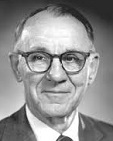
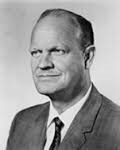

In 1940 Dale Rraymond Corson (1914-2012), Kenneth Ross MacKenzie (1912-2002), and Emilio Gino Segre (Segrè) (1905-89) of UCB synthesize the radioactive halogen element Astatine (At) (#85) (Gr. "astatos" = unstable).

In 1940 African-Am. physician (inventor of Scotch Tape) Charles Richard Drew (1904-50) invents the Blood Bank to provide blood for Britain; too bad, he is prohibted by segregation laws from donating his own blood; after having an auto accident in 1950 he bleeds to death, causing a false rumor that he had been refused treatment by a hospital because he was black.

In 1940 Am. bacteriologist Alfred Day Hershey (1908-97) observes that when two different strains of bacteriophage infect the same bacteria, the two viruses may exchange genetic info.
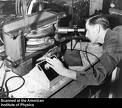
In 1940 U.S. physicist Donald William Kerst (1911-93) of the U. of Ill. invents the Betatron magnetic induction accelerator to accelerate electrons to high energies, shooting them into a doughnut-shaped vacuum chamber between the poles of an electromagnet carrying an alternating current to produce X-rays.

In the 1940s U.S. astronomer Carl Keenan Seyfert (1911-60) discovers Seyfert Galaxies, spiral galaxies with small, bright nuclei which emit strong broad spectral lines.

In 1940 French mathematician Andre (André) Weil (1906-98) pub. the Weil Conjectures about the generating (local zeta) functions derived from counting the number of points on algebraic varieties over finite fields, which aren't answered until 1974.
The pasteurization of milk in the U.S. reduces the number of cases of brucellosis from 6.5K in 1940 to only 70 in 1994; not that raw milk isn't healther if certified; in 1946 the Vacuum Pasteurization Method is perfected, followed by the Ultra-High Temperature Pasteurization Method in 1948.

In 1940 German-Hungarian engineer Peter Carl Goldmark (1906-77) of Columbia Broadcasting System (CBS) demonstrates a sequential method of color television (TV), which is commercialized in the 1950s.

In 1940 Karl Probst (1883-1963) of Bantam Automotive allegedly invents the Jeep for the U.S. Army in two days, and after it is built in 49 days he tests it from Toledo, Ohio to Butler, Penn.


On Mar. 28, 1941 Glenn Theodore Seaborg (1912-99) and Edwin Mattison McMillan (1907-91) of the U.S. discover Plutonium (Pl) (#94), named after the planet not the dog.


In July 1941 English chemists John Richard Whinfield (1901-66) and James Tennant Dickson of the Calico Printer's Assoc. in Manchester patent the polyester fiber Terylene (Dacron) (polyethylene terephthalate) (PET), which is tougher and more resilient than nylon; in 1946 Du Pont purchases the patent and begins large scale U.S. production in 1953.



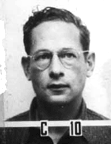
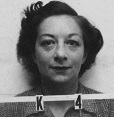

In 1941 James Bryant Conant (1893-1978), pres. of Harvard U. since 1933 becomes dir. of the Nat. Defense Research Committee (founded 1940), and deputy dir. of the Office of Scientific Research and Development, which develops the atomic bomb et al.; in 1942 the $2B U.S. Manhattan Project begins, leading to the first atomic bomb; it employs as many as 130K people, and is headed by Pentagon builder Gen. Leslie Richard Groves Jr. (1896-1970) and big brain physicist Julius Robert Oppenheimer (1906-54); Philly-born physicist Robert Serber (1909-97) writes The Los Alamos Primer, which is distributed in Apr. 1943 to all scientific staff, causing the NYT to call him "the intellectual midwife at the birth of the atomic bomb"; his wife (since 1933) Charlotte Serber (1911-67) is appointed the project's librarian, her leftist background getting both of them into hot water for awhile; Jewish-Am. physicist Theodore Alvin "Ted" Hall (1925-99) passes atomic secrets to the Soviets allegedly to keep the U.S. from having a monopoly, and is never caught, admitting it to CNN in 1998 right before his death; by 1951 67.5K nuclear missiles are built, and by 1964 the total cost of the program reaches $1T; the U.S. nuclear arsenal ends up costing $5.5T by 1996 ($21.6K per capita); the HEPA (High Efficiency Particulate Arrestance) Filter is developed for the Manhattan Project to prevent the spread of airborne radioactive contaminants, and commercialized in the 1950s. Hello, welcome to The View? On July 16, 1945 (5:29 a.m.) the $2B 48-mo. Manhattan Project (begun 1942), dir. by Sanskrit-reading brain man Julius Robert Oppenheimer (1906-54) succeeds as the first Atomic Bomb (A-Bomb), AKA the Gadget is detonated at the Trinity test site Jornada del Muerto (Journey of the Dead Dan) near Alamogordo ("fat poplar") Air Base near Albuquerque in C New Mexico, yielding the explosive power of 21K tons of TNT; "I am become death, the destroyer of worlds" (Oppenheimer, quoting the Bhagavad-Gita) - from this day white is no longer necessarily right, unless it's in a mushroom cloud?


In 1941 George Wells Beadle (1903-89) and Edward Lawrie Tatum (1909-75) of the U.S. pub. an experimentally-determined relationship between specific mutant genes in bread mold and particular stages in the metabolic process, formulating the "One Gene, One Enzyme Hypothesis", winning them the 1958 Nobel Med. Prize.
In Mar. 1942 Nazi Dr. Sigmund Rascher begins using Jews in experiments of high-alt. exposure, concluding after killing 80 of 200 that it is "impossible" to survive sans oxygen and pressure suits above 12km.
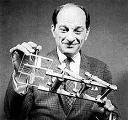

On Dec. 2, 1942 after Ukrainian-born Jewish-Am. mathematician Stanislaw Marcin Ulam (1909-84) proposes the concept, the first Nuclear Chain Reaction occurs in an atomic pile at the Univ. of Chicago, built under a squash court at Stagg Field under the dir. of Italian-Am. physicist Enrico Fermi (1901-54).


In 1942 Am. physician George Herbert Hitchings (1905-98), and Am. biochemist Gertrude Belle Elion (1918-98) of Wellcome Research Labs begin working on chemotherapy drugs, going on to develop pyrimethamine for malaria, thioguanine and 6-mercaptopurine for leukemia, allopurinol for gout, azathioprine for organ transplanation, and co-trimoxazole for bacterial infections, leading the way to research for antiviral drugs for herpes (acyclovir) and AIDS (zidovudine), winning them the 1988 Nobel Med. Prize.


In 1942 German-born devout atheist evolutionist biologist Ernst Mayr (1904-2005), collaborator of devout Christian evolutionist Theodosius Dobzhansky (1900-75) proposes a new biological species concept that is accepted in scientific circles as the answer to the "species problem", incl. genetic drift, natural selection, and peripatric and allopatric speciation - evolution is just a scientific explanation for a natural process, you can do this?
In 1942 the first Electronic Digital Computer is completed at Iowa State U. to perform ballistic computations for the military.

In 1942 Am. chemists Harold Wesley "Harry" Coover Jr. (1917-2011) and Fred Joyner of Kodak Labs. invent Cyanoacrylate by accident while trying to develop an optically clear plastic for gunsights; in 1951 they rediscover it, along with its adhesive properties, creating Eastman 910 AKA Super Glue in 1958.
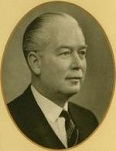
In 1942 British civil engineer Arthur Clifford Hartley (1889-1960) of the Imperial College in London invents the FIDO (Fog Investigation and Dispersion) device for clearing fog from airfields.


In 1942 Brainy Vienna-born Hollywood sex goddess Hedy Lamarr (Hedwig Eva Maria Kissler) (1913-2000) and Am. inventor George Johann Carl Antheil (1900-59) patent Frequency Scrambling, which later becomes the basis for cellular telephones.
In 1942 Max Mueller of Junkers Aircraft in Germany develops the first production turbo-prop engine.

In 1942 English Jewish inventor Geoffrey Nathaniel Pyke (1894-1994) proposes giant half-mi.-long "ice ships" with 30-ft. hulls to be used as floating mid-Atlantic airstrips, getting the govt. to launch Project Habbakuk (Hab. 1:5); it proves too costly and is abandoned.

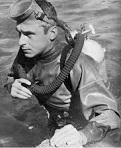
In winter 1942/3 the Aqua-Lung is invented in Paris by French navy diver lt. Jacques-Yves Cousteau (1910-97) and French engineer Emile Gagnan (1900-79), becoming the first SCUBA (self-contained underwater breathing apparatus) to reach worldwide commercial success.


On Feb. 1, 1943 after 1K families are given 3 mo. to move in Sept. from 59K acres of farmland protected by a ridge, and a new town is started to house 75K, ground is broken for the 92-acre Y-12 Manhattan Project uranium refinement plant at Oak Ridge, Tenn., which eventually employs 82K (mainly h.s. grad women AKA the Calutron Girls, who don't know what's going on), houses nine huge concrete-steel 300' x 500' industrial bldgs. costing $427M incl. the world's largest bldg., and operates 1,152 huge Calutron electromagnet assemblies whose wire requires 14K tons of silver from the U.S. Treasury, and whose operation takes one-seventh of the total electrical power generated in the U.S. for one year to manufacture 100 lbs. of U-235 for the A-bomb; the first workers move in on July 27; a type A house with utilities and garbage pickup incl. is $38/mo. In summer 1943 construction of a gaseous diffusion plant for production of enriched U-235 for the Manhattan Project is begun in Oak Ridge, Tenn. (later called the "Energy Capital of the World"); it is operational two years later after many problems are solved; U.S. physicist Arthur Jeffrey Dempster (1886-1950) discovered U-235 using his mass spectrograph (developed in 1918), and U.S. physicist John Ray Dunning (1907-75) of Columbia U. et al. proved that slow-moving neutrons cause U-235 to fission, and developed the method for isolating it which was put into large scale production there.
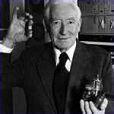

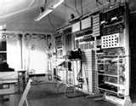
In 1943 Thomas Harold "Tommy" Flowers (1905-98), Alan Mathison Turing (1912-54) et al. of Bletchley Park in Milton Keynes, Buckinghamshire, England build the Colossus, the first large-scale electronic programmable computer to break the German Fish code; it contains an astounding 1.5K (1.8) valves (vaccum tubes); next June 1 the 2.4K-valve Colossus Mark 2 begins operation, with a 5x faster speed.

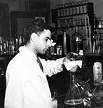

In 1943 the antibiotic Streptomycin, effective in treating TB and bubonic plague is isolated from Streptomyces by Russian-born Jewish-Am. microbiologist Selman Abraham Waksman (1888-1973), who receives the 1952 Nobel Medicine Prize for it, and his Jewish-Am. asst. Albert Israel Schatz (1920-2005), who isn't given credit until he takes Waksman to court and wins; at first effective against bacteria resistant to penicillin, the pesky little buggers develop resistance, and the race for new antibiotics never ends (until ?); Jewish concentation camp survivor Inge Auerbacher (1934-) becomes one of the first to receive the new antibiotic, going on to become a chemist.

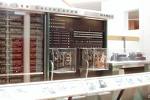
In Feb. 1944 with funding from IBM, and based on his 1937 concepts, Howard Hathaway Aiken (1900-73) of Harvard U. builds the electromechanical Mark I Automatic Sequence Controlled Calculator for computing ballistic data for the U.S. Navy Bureau of Ships, becoming the first fully automatic computer and first universal calculator; it is officially presented to Harvard U. on Aug. 7; it is 51 ft. long, 8 ft. high, and 2 ft. deep, weighs 10K lbs., and has 765K parts, incl. 1,464 10-pole switches, 3.5K multi-pole relays with 35K contacts, 2,225 counters, and a 50-ft. rotating shaft driven by a 5hp 4KW electric motor, with clutches, strung together with 500 mi. of wire; it contains 72 adding machines each with 23 decimal digits, and can do three additions or subtractions per sec., one multiplication in 6 sec., one division in 15.3 sec., and a log or trig function in 1 min.; it reads instructions from a 24-channel punched paper tape without conditional branching instructions; Norman Bel Geddes designs a streamlined case for it, causing some to call it a waste of govt. funds; Grace Hopper is one of its first programmers; the Mark II comes out in 1947-8, followed by the Mark III/ADEC in Sept. 1949, featuring magnetic drum memory, and the all-solid state Mark IV in 1952, featuring magnetic core memory.
On July 1, 1944 after the Nat. Inst. of Health (NIH) demonstrates its value in creating a typhus vaccine and proving the lifesaving value of plasma in WWII, the U.S. Public Health Service Act authorizes the NIH to award grants and fellowships; in 1948 the NIH becomes the Nat. Insts. of Health, growing to a $17B annual budget by the end of the cent., 80% going to research grants.

In 1944 Austrian pediatrician Hans Assburger, er, Hans Asperger (1906-80) first describes Asperger's Syndrome, a high-functioning form of autism.
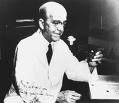


In 1944 Canadian-born Am. physician Oswald Theodore Avery Jr. (1877-1955), Canadian-Am. geneticist Colin Munro MacLeod (1909-72), and Am. geneticist Maclyn McCarty (1911-2005) determine that nuclear DNA acts as the carrier of genetic info., and transmutes one type of pneumococcus bacteria into a 2nd type by DNA transfer, founding Molecular Biology - how many years until we're all mixed bags of DNA from Noah's Ark?

In 1944 Austrian-German scientist Richard Kuhn (1900-67) develops the deadly nerve agent Soman, given the designation GD to add it to the list with GA (tabun), GB (sarin) and GF (cyclosarin).
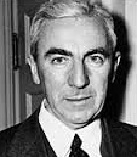
In 1944 Harvard researcher John Rock (1890-1984) and his team perform the first In Vitro Fertilization (IVF) of human embryos.
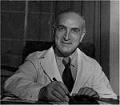
In 1944 German gynecologist Ernst Grafenberg (Gräfenberg) (1881-1957) hypothesizes the existence of the G-spot (Grafenberg Spot), a primo hot female erogenous zone inside the you know what, which is scientifically proved next year; the name G-spot is coined in 1981 by Addiego et al. - he's against it, but it's so good that it sticks?

In 1944 Ancel Benjamin Keys (1904-2004) of the U. of Minn. performs the Minn. Starvation Experiment using 32 conscientious objectors who decrease their body weight by 35%, and finds a correlation between coronary heart disease and diets high in animal fats.
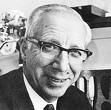
In 1944 Dutch-born Am. physician Willem Johan "Pim" Kolff (1912-2009) invents Kidney Dialysis using sausage casings and orange juice cans, making him "the Father of Artificial Organs"; he goes on to co-invent the Jarvik-7 artificial heart in 1982 with Robert Jarvik.
In May 1944 the first natural uranium/heavy water nuclear reactor is constructed at Argonne Nat. Lab, generating 300KW of power (dismantled in Jan. 1950); in May the first "water boiler" nuclear reactor (using U-235) goes into operation at Los Alamos Scientific Lab in Los Alamos (Sp. "poplars") in NC N.M. near Santa Fe; the site was chosen by J. Robert Oppenheimer because he attended a boarding school nearby - and wanted revenge? On Sept. 5, 1945 (3:45 p.m.) ZEEP (Zero Energy Experimental Pile) near Chalk River, Ont., Canada (110 mi. NW of Ottawa) becomes the first nuclear (uranium/heavy water) reactor outside the U.S. to go critical.
In 1944 Erwin Schrodinger pub. What Is Life, in which he suggests that quantum mechanics and coherent ringing in an "aperiodic crystal" might be at the basis of all biochemical reactions.

In July 1945 Am. engineer Vannevar Bush (1890-1974), dir. (1940-6) of the U.S. Office of Scientific Research and Development (formerly the Nat. Defense Research Committee) pub. As We May Think in the Atlantic Monthly, predicting hypertext; he also pub. Science, the Endless Frontier, a report to the U.S. pres. recommending that the U.S. govt. get into science education and research bigtime, resulting in the 1950 creation of the Nat. Science Foundation (NSF).
In 1945 Johnson and Johnson Co. develops Duct (Duck) Tape for use by the U.S. military.

On Dec. 7, 1945 after developing a simpler magnetron that can be mass-produced, the Microwave Oven is patented by Raytheon Co. factory worker Percy Lebaron Spencer (1894-1970); in 1947 Raytheon demonstrates the Radarange, the first commercial microwave oven - he noticed in 1940 that every time he was exposed to microwaves they melted the candy bars in his pockets?

In 1945 Russian electronic music founder Leon (Lev) Theremin (1896-1993) invents the Buran ("Snowstorm") Device, the first infrared microphone for the KGB, which uses it to home in on the windows of foreign embassies in Moscow, winning him the Stalin Prize in 1947; meanwhile he disguises "The Thing", an electronic listening device in a Great Seal of the U.S. carved in wood, and it is presented by Soviet school children to the U.S. ambassador as a gesture of friendship for helping them win WWI; it hangs in his office in Moscow until it is accidentally discovered in 1951.
In 1945 Unit Packaging of foodstuffs using plastic packaging films is pioneered, leading to the U.S. "convenience food" habit.

In 1945 GE engineer (New Haven, Conn.) James Wright (1874-1961) invents Silly Putty (Bouncing Putty) ("a liquid solid") while trying to make synthetic rubber for the war effort by substituting sulfur for carbon in the formula, mixing silicon oil with boric acid; in 1949 Peter C. Hodgson (-1976), a copywriter for a small ad agency borrows $147 to market it out of a converted barn in North Branford, Conn. and ships it in pasteboard egg crates; Hodgson dies in 1976 leaving an estate of $140M; in 1977 Binney & Smith (makers of Crayola and Liquitex) buys the rights; by 1990 it sells 200M eggs (3K tons); in 1990 it comes out in four new fluorescent colors.
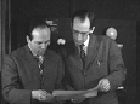


On Feb. 1, 1946 a press conference is held at the U. of Penn. to unveil the "Giant Brain" ENIAC (Electronic Numerical Integrator and Calculator) digital computer, developed by physicist John William Mauchly (1907-80) and electronics engineers John Adam Presper "Pres" Eckert Jr. (1919-95) and Arthur Walter Burks (1915-2008); it performs 5K additions per sec., and consists of 18K vacuum tubes, 70K resistors, 10K capacitors, and 5M hand-soldered joins, taking 15K sq. ft. of floor space and weighing 30 tons; when it is first switched on the lights all over Philly allegedly dim; six Philly women are recruited to do the nasty job of operating it; the patent suit Honeywell Inc. v. Sperry Rand Corp. awards John Vincent Atanasoff (1903-95) priority over ENIAC in Oct. 1973 as the inventor of the modern electronic digital computer, invalidating ENIAC's 1964 patent and putting it into the public domain.

Long after the Indians showed them the Rain Dance? On July 14, 1946 after pioneering work by Am. chemist-physicist Irving Langmuir (assoc. dir. of research at Gen. Electric in 1932-50), his asst., self-taught Am. chemist-meteorologist Vincent Joseph Schaefer (1906-93) of GE Labs in Schenectady, N.Y. pioneers the principle of Cloud Seeding on Mt. Washington in N.H.; on Nov. 13 the first Artificial Snow is produced by seeding clouds with crushed dry ice at Mt. Greylock, Mass. in the Berkshire Mts., causing a major snowstorm; next Oct. 13 Project Cirrus is begun by the USAF, U.S. Office of Naval Research, and the U.S. Army Signal Corps to seed a hurricane with 180 lb. of crushed dry ice, after which the hurricane changes direction and makes landfall near Savannah, Ga., causing the public to blame them and the project to be canceled, with the govt. not admitting it had seeded it until 1959; in 1962 NOAA launches Project Stormfury to weaken cyclones by flying aircraft into them and seeding them with silver iodide; too bad, it doesn't work, and the last flight is flown in 1971, and the project canceled in 1983; in 2010 Pinhas Alpert et al. of Tel Aviv U. review past data and conclude that cloud seeding isn't very effective.

In 1946 English physicist Sir Edward Victor Appleton (1892-1965) discovers that sunspots emit radio waves.

In 1946 English radio astronomer Sir Martin Ryle (1918-84) of England builds the first Multi-Element Astronomical Radio Interometer and pub. the first interferometric astronomical measurements at radio wavelengths, later fighting claims from others and ending up with the 1974 Nobel Physics Prize.


In 1946 Am. physicist Edward Mills Purcell (1912-97) and Felix Bloch (1905-83) of the U.S. independently develop the Nuclear Magnetic Resonance (NMR) technique for measuring the magnetic fields of atomic nuclei to liquids and solids, winning them the 1952 Nobel Physics Prize - freshness with a spin, plug it in plug it in?
On Feb. 16, 1946 the first commercially-designed helicopter is tested at Bridgeport, Conn.
On Sept. 11, 1946 the first mobile long-distance car-to-car telephone conversation takes place.
On Oct. 9, 1946 the first manufactured electric blanket goes on sale for $39.50.
In 1946 DEET insect repellant is developed for military use; commercial use begins in 1957.
In 1946 Fairey Aviation Co. invents a pilotless rocket missile.
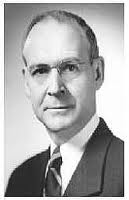
In 1946 Vitamin C, isolated by Am. chemist Charles Glen King (1896-1988) is first marketed in pill form.
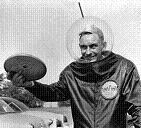
In 1946 Utah-born Calif. inventor Walter Frederick "Fred" Morrison (1920-2010) invents the Frisbee (original name Whirlo-Way, then Pluto Platter in 1955) (originally a popcorn can lid then a cake pan), selling the rights to Wham-O in 1957 and going on to sell 200M units by 2009.


In 1946 airtight Tupperware, based on the indented rim of a paint can is invented by Am. inventor Earl Silas Tupper (1907-83), who pioneers direct marketing via the Tupperware Party.

In 1946 Marion Donovan (1917-) invents the Boater, a waterproof covering for disposable cloth diapers.
In 1946 high quality frozen orange juice concentrate is perfected by Minute Maid.

In 1947 English physicist Patrick Maynard Stuart Blackett (1897-1974) proposes the theory that all massive rotating bodies incl. the Earth are magnetic.


In 1947 Dutch physicists Hendrik Brugt Gerhard Casimir (1909-2000) and Dirk Polder (1919-2001) propose the Casimir-Polder Force between two polarizable atoms and between a polarizable atom and a conducting plate; next year Casimir proposes the Casimir Effect, a force between neutral conducting plates.


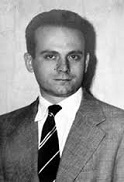
In 1947 after being predicted in 1935 by Japanese physicist Hideki Yukawa (1907-81), mu meson (muon) is verified by English physicist Cecil Frank Powell (1903-69); Cesare (Cesar) Mansueto Giulio Lattes (1924-2005) proves the existence of two kinds of mesons in cosmic rays, the pi meson (pion) and the mu meson (muon); the pion spontaneously transforms into a muon then decays into an electron or positron; K-mesons are also identified, which decay into pions or muons, or directly into electrons; Yukawa receives the 1949 Nobel Physics Prize, and Powell receives the 1950 Nobel Physics Prize.
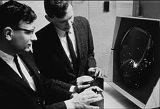
On Jan. 25, 1947 Greenville, S.C.-born physicist Thomas Toliver Goldsmith Jr. (1910-2009) and Estle Ray Mann file for a patent for the first Cathode Ray Tube Amusement Device, which is granted on Dec. 14, 1948 (#2,455,992).
On May 11, 1947 B.F. Goodrich Co. of Akron, Ohio announces the development of the Tubeless Tire.

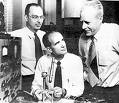
On Dec. 16, 1947 the revolutionary Bipolar Junction Transistor is invented by Bell Lab scientists William Bradford Shockley (1910-89), John Bardeen (1908-91), and Walter Houser Brattain (1902-87), winning them the 1956 Nobel Physics Prize; they don't officially announce the invention until July 1, 1951; meanwhile Gerald L. Pearson (1905-875) improves it by replacing the metal leads with thin semiconductor filaments to reduce noise, creating the point-contact transistor.
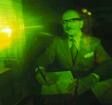
In 1947 Hungarian-British engineer-physicist Dennis Gabor (1900-79) invents Holography with electrons in an attempt to improve resolution of electron microscopes; it takes until 1963 to make holograms with laser light sources.
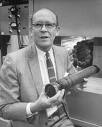
In 1947 Grand Valley, Colo.-born Willard Frank Libby (1908-80) of the U. of Chicago Inst. of Nuclear Studies discovers the C-14 Radiocarbon Dating Method just in time for the Dead Sea Scrolls, which are dated between -167 and +233, winning the 1960 Nobel Chem. Prize; the Before Present (BP) time scale is calibrated for Jan. 1, 1950.
In 1947 the herbicide Glyphosate is introduced, becoming the active ingredient in Monsanto's Roundup, and the most-used agricultural chemical on Earth; too bad, the first case of glyphosate resistance is documented in 1997, spreading to 20 weed species by 2010.
In 1947 French chemist Jacques Masquelier discovers Oligomeric Proanthocyanidins (OPCs), a flavonoid found in grapes, apples, red wine, berries, cocoa beans, cinnamon bark, and tea in peanut skins; they are later linked to reduced risk of coronary heart disease and lower mortality.
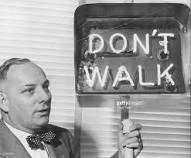
In 1947 traffic engineer Henry A. Barnes (1906-68) comes to Denver, Colo. from Flint, Mich. to unclog city streets, and soon invents (or adapts) the Barnes Dance, AKA the pedestrian scramble, a traffic light that stops all traffic at an intersection to allow pedestrians to cross; it is soon adopted worldwide.

In 1948 the antiobiotics Aureomycin and Chloromycetin are discovered by U.S. scientist Benjamin Minge Duggar (1872-1956) et al. of Lederle Labs.


In 1948 Paul Kirkpatrick (1894-1992) of Stanford U. and his grad student Albert V. Baez (1912-2007) (father of singer Joan Baez) invent the X-ray Reflection Microscope for examining living cells.




In 1948 to counter Russian-Am. physicist George Gamow (1904-68), who proposed the Big Bang Theory of the creation of the Universe, Am. astronomers Fred Hoyle (1915-2001), Thomas Gold (1920-2004), and Sir Hermann Bondi (1919-2005) counter with the Steady-State Theory of the Universe, which uses common sense to view the Universe as without beginning or end; too bad, they have to claim that matter is constantly being created at the rate of a few hydrogen atoms per cubic meter per billion years to explain the constant expansion - jeepers creepers, where did you get those peepers? In 1950 Big Bang critic Hoyle coins the term Big Bang in sarcasm in a radio broadcast, but it's so good that it sticks.


In 1948 Drexel Inst. of Tech. students Norman Joseph Woodland (1921-), Bernard Silver (1924-62), and Jordin Johanson overhear a supermarket exec asking the dean of students to design a system for automating product checkout, and design the Barcode System using a 2-dim. Morse Code (thin lines = dots, thick lines = dashes) read via movie soundtrack technology, applying for a patent next Oct. 20 and receiving U.S. Patent #2,612,994 on Oct. 7, 1952 ("Classifying Apparatus and Method"), incl. both linear and bullseye printing patterns; RCA buys the patent 1952, installs a bullseye barcode system in a Kroger store in Cincinnati, Ohio in 1967, then watches the patent expire in 1969, after which in 1971 Woodland works for IBM to turn it into the Universal Product Code (UPC) for the Nat. Assoc. of Food Chains.
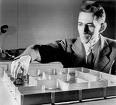
In 1948 Am. mathematician Claude Elwood Shannon (1916-2001) pub. the paper "Communication Theory of Secrecy Systems", founding modern cryptography; he also pub. A Mathematical Theory of Communication, which becomes the Magna Charta of the Information Age.



In 1948 Columbia, Mo.-born mathematician Norbert Wiener (1894-1964) pub. Cybernetics; or, Control and Communication in the Animal and Machine, defining Cybernetics (Gr. "steer", "navigate") as "the scientific study of control and communication in the animal and the machine", anticipating the Computer Rev. His Anselmo, Neb.-born student Jay Wright Forrester (1918-) founds System Dynamics. His Vienna, Austria-born student Heinz von Foerster (1911-2002) comes up with the Doomsday Equation, predicting that world. pop. will become infinite on Nov. 13, 2026 (Fri.); the Soviet Union bans the book until the death of Joseph Stalin on Mar. 5, 1953, then does a 180 and begins embracing computers.



In 1949 German-born Am. physicist Maria Goeppert-Mayer (1906-72), Budapest, Hungary-born Am. physicist Eugene Paul "E.P." Wigner (1902-95), and German physicist Johannes Hans Daniel Jensen (1907-73) of the new (1946) Argonne Nat. Lab. in Lemont, Ill. develop the Shell Model of the Nucleus, which explains the "magic numbers" of nucleons that make a nucleus stable via spin orbit coupling, winning them the 1963 Nobel Physics Prize; "Think of a room full of waltzers. Suppose they go round the room in circles, each circle enclosed within another. Then imagine that in each circle, you can fit twice as many dancers by having one pair go clockwise and another pair go counterclockwise" (Goeppert-Mayer).

In 1949 Am. astronomer Jesse Leonard Greenstein (1909-2002) demonstrates that the magnetic field in the Milky Way Galaxy is aligned with its spiral arms, as seen from polarized starlight scattered off interstellar dust grains aligned in a magnetic field. In 1978 he pub. a theory of how a red giant star evolves into a white dwarf star.


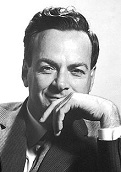
In 1949 Am. physicist Julian Seymour Schwinger (1918-94) of Harvard U. calculates the self-energy of an electron as an infinite series, permitting renormalization to be calculated; Japanese physicist Sin-Itiro (Shinichiro) Tomonaga (1906-79) independently derives the same result; after attending a conference in the Poconos Mts. in Penn. in Mar. and failing to convince the other physicists of the soundness of his methods, next year Am. physicist Richard Phillips Feynman (1918-88) of Cornell U. introduces Feynman Diagrams in an article in Physical Review; all three share the 1965 Nobel Physics Prize.


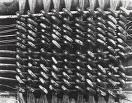
In 1949 Am. engineer Jay Wright Forrester (1918-) invents Magnetic Ferrite Core Memory for computers, patenting it on May 11, 1951; they are installed in the IBM Type 704 and 705 computers in 1954 after Kenneth Harry "Ken" Olsen (1926-2011) builds the Memory Test Computer, the first computer equipped with them, used for the U.S. SAGE program; in 1957 Olsen and Harlan Anderson (1929-) found Digital Equipment Corp. (DEC), which trademarks the word Digital and becomes the #2 computer co. after IBM before going defunct in 1998 - now it's just a packaging problem?
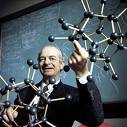
In 1949 Am. chemist Linus Carl Pauling (1901-94) demonstrates that sickle cell anemia is caused by a specific genetic mutation and is inherited, becoming the first disease attributed to a specific genetic modification, viz., a single base substitution in the DNA sequence of the gene encoding the beta chain of hemoglobin.
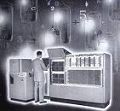
In 1949 Remington Rand Corp. of Rowayton, Conn. (founded 1927) designs the Remington Rand 409, the world's first business computer, introducing it as the Univac 60 in 1952 and the Univac 120 in 1953, becoming the first computer used by the IRS and the first installed in Japan.

In 1949 Am. mechanical engineer Robert Henry 'Bob' Abplanalp (1922-2003) invents the 7-part leakproof plastic aerosol valve, founding the Precision Valve Corp. to produce it; he later becomes one of Richard Nixon's closest friends, while his freon gas-releasing products chip away at the Earth's ozone layer.

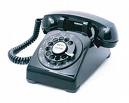
In 1949 Am. industrial designer Henry Dreyfuss (1904-72) invents the Model 500 Desk Telephone, which becomes the U.S. std. until 1994.

In 1950 Australian-born British surgeon Norman Rupert "Pasty" Barrett (1903-79) first describes Barrett's Esophagus, a first step toward esophageal cancer.


Chemistry evolves from mere mathematical formulas to the odd hassle of 3-D diagrams? In 1950 English chemist Sir Derek Harold Richard Barton (1918-98) shows that organic molecules can be assigned a preferred conformation based on the work of Norwegian chemical physicist Odd Hassel (1897-1981), founding Conformational Analysis, winning them the 1969 Nobel Chem. Prize.

In 1950 Austrian-born Am. biochemist Erwin Chargaff (1905-2002) of Columbia U. pub. Chargaff's Rule 1, that the number of adenine and thymine bases, and the number of cytosine and guanine bases are equal to each other, surmising that "they could very well serve as one of the agents, or possibly the agent, concerned with the transmission of inherited properties"; he also proves Chargaff's Rule #2 that the composition of DNA varies between species.

In 1950 Italian physicist Enrico Fermi (1901-54) formulates the Fermi Paradox, that despite the seeming vastness of the Universe there's still no evidence of intelligent life anywhere but lucky lucky Earth.
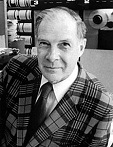
In 1950 Am. mathematician Richard Wesley Hamming (1915-98) pub. a paper introducing the concept of Hamming Distance, allowing error-correcting codes to be created.
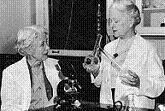
In 1950 Elizabeth Lee Hazen (1885-1975) and Rachel Fuller Brown (1898-1980) of the N.Y. State Dept. of Health isolate the powerful antifungal agent Nystatin from Streptomyces noursei, becoming the first non-toxic treatment for fungal infections in humans.

In 1950 Am. chemist Michael Kasha (1920-) proposes Kasha's Rule, that when light is shined on a molecule, it will only emit light from its lowest energy excited state; many exceptions are later found.

In 1950 Am. maize geneticist Barbara McClintock (1902-92) pub. her discovery of Transposons, AKA Jumping Genes, genetic elements that can move from one plasmid or its chromosome to another; too bad, her work is ignored until the gender-transposing jumping 1970s, and in 1974 she and Am. scientists Alan E. Jacob, and Robert W. Hedges officially discover Transposons, and McClintock wins the 1983 Nobel Med. Prize.

In 1950 Arthur Nobile (1920-2004) of the U.S. uses bacteria to turn cortisone and hydrocortisone into the superior anti-inflammatory drugs Prednisone and Prednisolone, creating a new industry.
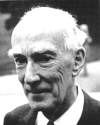
In 1950 Dutch astronomer Jan Hendrik Oort (1900-92) proposes the Oort Cloud orbiting the Sun beyond Pluto's orbit at 50K AU (1 l.y.) as the source of long-period comets.



In 1950 Am. physicist Leo James Rainwater (1917-86) of Columbia U. pub. a paper explaining non-spherical properties of the atomic nucleus beyond the 1949 Nuclear Shell Model; Danish physicist Aage Niels Bohr (1922-2009) (son of Niels Bohr) comes up with the idea independently, and works with Ben Roy Mottelson (1926-) to verify the new model with experimental data, winning them all the 1975 Nobel Physics Prize.


In 1950 Soviet physicists Andrei Dmitrievich Sakharov (1921-89) and Igor Yevgenyevich Tamm (1895-1971) propose the Tokamak nuclear fusion reactor, using torus-shaped magnetic fields to confine hot ionized plama; next year Sakharov invents Magnetocumulative (MC) Generators for compressing magnetic fields with explosives.

Californicating with the basic elements again? On Mar. 17, 1950 U. of Calif. (Berkeley) scientist Glenn Theodore Seaborg (1912-99) announces the creation of the radioactive element Californium (#98) (Cf) by intense neutron bombardment of plutonium (curium?); in 1949 the chemical element Berkelium (#97) (Bk) was prepared by bombarding americium with high-energy alpha particles in a cyclotron; it is later prepared by neutron bombardment of plutonium.



In 1950 motorcycle-loving English geneticist Oliver Smithies (1925-) discovers Gel Electrophoresis, a technique for separating protein molecules using an electric current applied to a starch gel matrix; actually, sucrose was used for it way back in the 1930s, but this process works better.

In 1950 Harvard U. astronomer Fred Lawrence Whipple (1906-2004) proposes the Dirty Snowball (Icy Conglomerate) (Icy Dirtball) Model of comet composition.

In 1950 Rosalyn Sussman Yalow (1921-2011) of the U.S. pioneers Radioimmunoassay, but refuses to patent it.
In 1950 the "farmer's dream" comes true as the first calves are born as a result of Artificial Insemination using frozen semen.
On Dec. 11, 1950 the tranquilizer Chlorpromazine (CPZ) (AKA Thorazine) is synthesized by French chemist Paul Charpentier at Rhone-Poulenc Labs in Paris, becoming the first with specific antipsychotic action, leading to less use of electroconvulsive therapy and psychosurgery, and a movement toward deinstitutionalization.
In May 1950 the tranquilizer Miltown (Meprobamate), AKA Don't-Give-a-Damn Pills is synthesized by Wallace Labs; in 1955 it hits the market bigtime in Madison Ave. and Hollywood, going on to become the #1 selling drug in the U.S.; Milton Berle quips "I'm thinking of changing my name to Miltown Berle."

On Aug. 3, 1950 Russian Jewish scholar Immanuel Velikovsky (1895-1979) pub. the NYT bestseller Worlds in Collision, claiming that a comet-like object was ejected from Jupiter in the 15th cent. B.C.E., changing the Earth's orbit and axis and causing catastrophes that are described in the Bible, then settled down as the new planet Venus, after which in the 8th-7th cents. B.C.E., Mars acted up, causing more catastrophes, after which everything settled down and here we are let me tell you all about it?; an imaginative erudite pseudo-scientific Bible-thumping alternative to standard science that pisses-off the scientific establishment (Harlow Shapley, Carl Sagan et al.) so much that they begin a boycott of Macmillan's textbooks, causing them to drop it in 2 mo. despite being a bestseller, after which Doubleday says ka-ching ka-ching thanks.
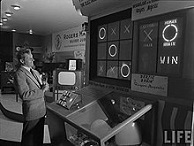
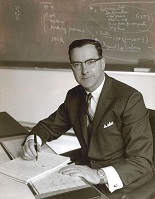
On Aug. 25, 1950 the 13-ft.-tall tic-tac-toe-playing digital computer game Bertie the Brain is released, designed by Vienna, Austria-born Canadian engineer Josef Kates (Josef Katz) (1921-2018) for the 1950 Canadian Nat. Exhibition, with a display consisting of light bulbs; it uses his invention, the Additron Tube, which does the work of ten regular vaccum tubes to make a 1-bit digital full adder, but is kept from commercialization by the advent of the transistor.
In 1950 Helene Curtis begins marketing Spray Net, coining the term "hair spray".

In 1950 the Lazy Bones, the first (non-wireless) TV Remote Control is invented by Robert Adler (1913-2007) and Eugene Polley (1916-) of Zenith Radio Corp.; the photoelectric Flashmatic is introduced in 1955, followed by the ultrasonic Zenith Space Command (first commercially successful wireless) in 1956, with the slogan "Nothing between you and the TV but space"; the couch potato gen. is launched; Adler and Polley are awarded an Emmy for Space Command in 1997.
In 1950 the Karpen Voltaic Pile, a "uniform temperature thermoelectric pile" (patented in 1922) is built by Vasile Karpen in Romania as a perpetual motion machine, and keeps working continuously until ?.
In 1950 after actor Fred Barton Jr. asks 20th Cent. Fox vice-pres. Irving Berlin Kahn (nephew of Irving Berlin) for it, the TelePrompTer is invented by Hubert "Hub" Schlafly (1919-2011) of 20th Cent. Fox in New York City, making its debut on the TV soap opera "The First Hundred Years".
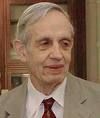
In Sept. 1951 Bluefield, W. Va. -born mathematician John Forbes Nash Jr. (1928-2015) pub. the article Non-Cooperative Games in The Annals of Mathematics, becoming the first to define a Nash Equilibrium for non-zero-sum games, winning a share of the 1994 Nobel Econ. Prize.





Speaking of Mexicans breeding like rabbits, on Oct. 15, 1951 the progestin Norethindrone (norethisterone), an artifical substitute for progesterone that is key to the creation of an oral contraceptive pill was synthesized by Austrian-born chemist Carl Djerassi (1923-) of the U.S., Luis Ernesto Miramontes (1925-2004) of Mexico, and George (Gyorgy) Rosenkranz (1916-) of Hungary at Syntex in Mexico City, and on May 9, 1960 the U.S. Food and Drug Admin. (FDA) approved the contraceptive Enovid (Enavid), AKA the birth control pill, developed by Carl Djerassi of G.D. Searle & Co. of Chicago for American birth control (really negative eugenics, to keep the poor and therefore inferior from outbreeding the good guys?) advocate Margaret Higgins Sanger (1879-1966) and funded by heiress Katharine Dexter McCormick (1875-1967), saying that it has proved 100% effective in a 4-year test by 1.5K women. The cost was only $10-$11 per mo. for 20 pills, and for the first time in history women were liberated to have sex without fear of pregnancy, causing a run on pharmacies by non-Catholics and Catholics alike, despite the prohibition of birth control pills for Roman Catholics by Vatican II in 1962-5. By 1961 500K women were using it, and 10M by 1973. In 1966 the U.S. FDA releases a Report on the Pill, finding "no adequate scientific data at this time proving these compounds unsafe for human use"; too bad, most U.S. women are still leery of using oral contraceptives because of side effects, while France and other Catholic countries still prefer onanism, i.e., coitus inerruptus, although when Onan did it in the Bible, God killed him (Gen. 38:8-10)?
On Nov. 27, 1951 the first rocket intercept of an airplane is performed at White Sands, N.M.
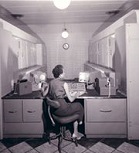
Commercial computers are off to the races? In Feb. 1951 Manchester U. in England unveils its Manchester Ferranti Mark I Computer.
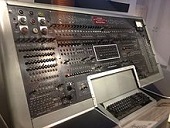
On Mar. 31, 1951 Remington Rand Corp. sells the first UNIVAC (Universal Automatic Computer) I to the U.S. Census Bureau in Sutland, Md., which dedicates it on June 14, cutting the work of humans from 200K to 28K hours; it is not delivered until 1952; machine #5 is used by CBS-TV to predict the 1952 U.S. pres. election, using a 1% sample to predict a landslide for Eisenhower; it is retired in 1963.
In 1951 Top 40 Radio is invented by Todd Storz and Bill Stewart when they are hired by KOWH radio in Omaha, Neb. In 1951 J. Andre-Thomas invents the heart-lung machine. In 1951 Am. cinematographer Fred Waller (1886-1954) invents the Cinerama widescreen process, which projects three synchronized 35mm images onto a huge curved screen with 146 deg. of arc, plus a 6-track stereo sound system.

In 1951 White-Out typewriter eraser fluid is invented by secy. Bette Nesmith Graham (nee Bette Clair McMurray) (1924-80) (mother of Monkees member Michael Nesmith) for her IBM electric typewriter from white tempera water-based paint, and begins marketing it as "Mistake Out" in 1956; when she dies in 1980 he inherits half of her $50M estate.
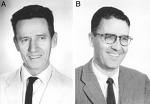
In 1952 Am. biologists Robert Briggs (1911-83) and Thomas J. King (1921-2000) clone northern leopard frogs using nuclear transfer, becoming the first Cloned Animal, causing a research feeding frenzy.
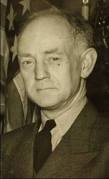
On Aug. 4/5, 1952 (night) British nutrition biochemist Sir Jack Cecil Drummond (b. 1891) (known for naming Vitamins A and B and dropping the e from vitamine) is brutally murdered along with his wife Ann and 10-y.-o. daughter Elizabeth in their car near Lurs (75 mi. from Aix) in Provence, France; 18 mo. later 75-y.-o. French peasant farmer Gaston Dominici (1877-) is convicted and given the guillotine, which is reduced to life, and is let out in 1959 by Pres. Charles de Gaulle after cries of a a frameup and possible spy hanky-panky - take that for Dunkirk?
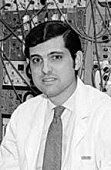
The Big 100 Year in Science? In 1952 the synthetic elements Einsteinium (Es) (#99) and Fermium (Fm) (#100) are discovered in the debris of the first H-bomb explosion by Albert Ghiroso (1915-2010) et al. of UCB and the Argonne Lab.
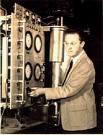
In 1952 Am. physicist Donald Arthur Glaser (1926-) invents the Bubble Chamber for use in particle physics experiments, winning him the 1960 Nobel Physics Prize.


The Big 100 Year in Science? In 1952 the synthetic element Fermium (Fm) (100) is discovered in the debris of the first H-bomb explosion by Albert Ghiroso (1915-2010) et al. of UCB and the Argonne Lab. In 1955 Ghiorso produces the element Mendelevium (Md) (#101) by bombarding einsteinium with high-energy alpha particles in a cyclotron. In 1958 Ghiorso produces the chemical element Nobelium (No) (#102) by the radioactive bombardment of curium in Stockholm. By 1968 a total of 105 elements have been discovered, which are adopted as a std.
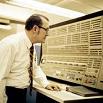
In 1952 J. Halcombe "Hal" Laning Jr. (1920-2012) of MIT develops George, the first algebraic compiler on the Whirlwind computer, translating algebraic expressions into programs for a floating-point interpreter.

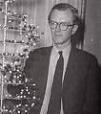

The Science of Biology gets its Trinity of Watson-Crick-and-I-forget? On Feb. 28, 1953 Chicago-born U.S. biologist James Dewey Watson (1928-) and British Cambridge U. model-making molecular biologist Francis Harry Compton Crick (1916-2004) announce their discovery of "the secret of life", the neat transvestite double-helix structure of DNA, then pub. a 1-page article in the Apr. 25 issue of Nature, drooling "This structure has novel features that are of considerable biological interest", later sharing the 1962 Nobel Med. Prize for it with Kiwi physicist Maurice H.F. Wilkins (1916-2004), who verifies the structure with X-ray diffraction; meanwhile Wilkins' colleague Rosalind Elsie Franklin (1920-58) of Kings College, who also pub. an article in the Apr. 25 issue on her X-ray diffraction studies, and whose work allowed the discovery is left out of the prize - no wonder girls hate math?
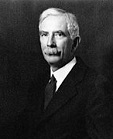
In 1953 Wilton, N.H.-born astrophysicist Charles Greeley Abbot (1872-1973) (former asst. of Charles Pierpont Langley), dir. since 1907 of the Smithsonian Astrophysical Observatory (inventor of the solar cooker, solar boiler, and solar still) discovers a link between sunspot cycles and Earth climate, claiming to be able to predict climate patterns 50 years in advance.
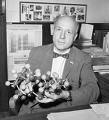
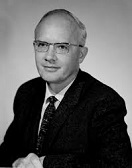
In 1953 the light-independent carbon-fixation Calvin (Calvin-Benson) (Calvin-Benson-Bassham) Cycle is discovered by UCB chemists Melvin Ellis Calvin (1911-97), James Alan Bassham (1922-2012), and Andrew Alm Benson (1917-2015), explaining the path of carbon in photosynthesis, winning Calvin the 1961 Nobel Chem. Prize.



On Nov. 11, 1953 the polio virus is identified and photographed for the first time in Cambridge, Mass.; meanwhile John Franklin Enders (1897-1955), Thomas Huckle Weller (1915-), and Frederick Chapman Robbins (1916-2003) of Children's Hospital in Boston, Mass. pioneer the growing of polio virus cultures in test tubes, winning the 1954 Nobel Med. Prize; meanwhile Enders and his asst. Thomas Peebles pioneer measles vaccine - enders those peebles on your face?

In 1953 French microbiologist Andre-Michael Lwoff (1902-94) discovers that a bacteriophage virus attaches itself to the chromosome of a bacterium, causing it to produce copies of the virus.

In 1953 British zoologist Peter Brian Medawar (1915-87) discovers Acquired Immunity after finding that animals injected early in life with cells from another animal accept tissue grafts from the same animal in adulthood, winning him the 1960 Nobel Med. Prize.


In 1953 Polish-Am. mathematician Jerzy Neyman (1894-1981) and Elizabeth Leonard Scott (1917-88) of the U.S. discover the existence of superclusters (clusters of clusters) of galaxies - I wish I could find the sexual connotations?

In 1953 Romanian-Am. physiologist George Emil Palade (1912-) first describes Ribosomes.


In 1953 Vienna-born Cambridge U. I-smell-a-Nobel molecular biologist Max Ferdinand Perutz (1914-2001) introduces the technique of adding an atom of a heavy element (gold etc.) to an organic molecule to improve X-ray diffraction and show phase as well as amplitude info, aiding his 16-year (since 1937) quest to determine the structure of hemoglobin (ends 1959). In 1959 Perutz and his asst. Sir John Cowdery Kendrew (1917-97) develop the first atomic model of a protein, hemoglobin, using blood from a sample of whale meat from Peru - Peru, Perutz, can do?

In 1953 Soviet astronomer Josef Shklovsky (1916-85) explains the radio emission from the Crab Nebula as being caused by synchrotron radiation (electrons in magnetic fields moving close to the speed of light).

In 1953 Denver-born U. of Colo. Medical School surgeon Henry Swan II (1913-96) pioneers Cryosurgery, lowering the body temp in order to slow circulation and permit dry-heart surgery.


In 1953 Harold Clayton Urey (1893-1981) and Stanley Lloyd Miller (1930-2007) of the U.S. create an alleged sample of the Earth's early atmosphere (sans oxygen) in a mixture of hydrogen, methane, ammonia, and water, using electrical discharges to produce a "primordial soup" of amino acids and nucleotide bases which they claim may have formed the first living organisms - daddy, is that you?

In 1953 Am. biochemist Vincent du Vigneaud (1901-78) assembles in exact order the eight amino acids in the small protein molecule of the cyclic peptide hormone oxytocin (which he had determined in 1947), the main initiator of contraction of the uterus and secretion of milk, becoming the first synthesis of a hormone, winning him the 1955 Nobel Chem. Prize.

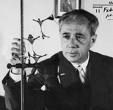

In 1953 Karl Ziegler (1898-1973), dir. of the Max Planck Inst. for Coal Research in Germany develops the first Nickel-Based Catalyst that combines monomers into a polymer in a regular fashion, producing a much stronger and more resistant polyethylene, and at atmospheric pressure instead of the 30K psi required by the 1935 ICI process; Giulio Natta (1903-79) of Italy uses his idea to develop the first isotactic polymers (long repeated hydrocarbon molecules that have a carbon chain with attachments all on one side), polymerizing propylene into polypropylenes, winning him the 1963 Nobel Chem. Prize; the Age of Plastic begins, a new era of high quality low cost plastics for the masses - add Dustin Hoffman and you have the Plastic Trinity?
On Apr. 11, 1953 the Tacoma News Tribune pub. the article There'll Be No Escape in Future from Telephones, quoting Pacific Telephone & Telegraph pres. Mark R. Sullivan predicting cellphones.


On Sept. 16, 1953 Henry Koster's The Robe debuts; based on the 1942 novel by Lutheran minister Lloyd Cassell Douglas, it is the first movie filmed in the widescreen CinemaScope process of Henri Chretien (1879-1956); stars chicken-legged Richard Burton as Roman tribune Marcellus Gallio, Victor Mature as his Christian slave Demetrius, Richard Boone as Pontius Pilate, Jean Simmons as Diana, and Jay Robinson as Caligula in a role acted so well that he later has to see a pshrink; the only movie given 8 stars by the New York Daily News, 4 for the film and 4 for the process (4 is the usual max); the wide, wide color screen saves the industry, which was losing customers because of the new boob tube (TV), although many claim it almost kills the art; "It's fine if you want a system that shows a boa constrictor to better advantage than a man" (George Stevens); "The worst shape ever devised" (Rouben Mamoulian); "It is a formula for a funeral, or for snakes, but not for human beings" (Fritz Lang); "It wrecked the art of film for a decade" (Leon Shamroy).
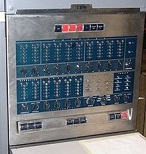
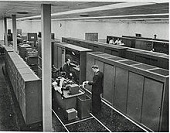
In 1953 the two-address bi-quinary coded decimal IBM 650 Magnetic Drum Data-Processing Machine is introduced, becoming the first computer to be manufactured in quantity; derived from the punched card monster IBM 701, it initially has a memory of 1K 10-byte words; 1.5K units are sold by 1969; in Oct. the Univac 1103 becomes the first commercial computer with random access memory (RAM) for blinding speeds.

In 1953 Robert Frank Borkenstein (1912-2002) of lovely Indiana invents the Breathalyzer, a portable device for measuring the blood alcohol percentage from exhaled gases.
On Feb. 16, 1953 the first artificial diamonds are made in Sweden using high heat and pressure; too bad, they don't announce their discovery, letting GE get the credit in 1955.
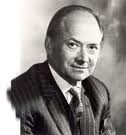
In 1953 the Pilkington Process to produce a continuous ribbon of "float glass" on a molten tin bath is developed by Sir Alastair (Lionel Alexander Bethune) Pilkington (1920-95) of the U.K., becoming the first commercially successful method for manufacturing high quality flat glass to replace more expensive plate glass.

In 1953 a USAF B-29 equipped with the new triple-gyro inertial guidance system designed by MIT engineer Charles Stark Draper (1902-) takes off from Bedford, Mass. carrying eight MIT profs. on Feb. 8, and flies for 12 hours without anyone touching the controls before the crew take over 10 mi. from Los Angeles, Calif. and lands it.

On May 6, 1953 Am. surgeon John H. Gibbon Jr. (1903-73) becomes the first to use a heart-lung machine during an operation, keeping Cecelia Bavolek alive while operating on her heart.
In 1953 John W. Hetrick of Newport, Pann. patents the first Air Bag ("safety cushion assembly") as a safety device for autos.
In 1953 Denver, Colo. concert violinist Frank Marugg invents the Denver Boot, used by the police to immobilize cars whose drivers haven't paid their tickets.
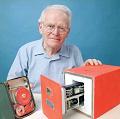
In 1953 Australian inventor David Warren (1925-2010) invents the Black Box Flight Data Recorder.
In 1953 Michelin of France and Pirelli of Italy introduce Radial-Ply Tires.
In 1953 Chicago, Ill.-born Norman Bernard Larsen (1923-70), founder of the Rocket Chemical Co. of San Diego, Calif. invents WD-40 (Water Displacement Formula 40) for use on Atlas rockets; it is supplied in an aerosol can in 1958.

In 1953 Austrian engineer Eugen Sanger (Sänger) (1905-64) proposes photon propulsion for spaceships, eventually resulting in the Solar Sail.
In 1953 Tektronix develops the first Plug-In Oscilloscope.



In 1953 Charles Hard Townes (1915-2015) et al. of Columbia U. develop the first ammonia Maser (microwave amplification by stimulated emission of radiation"), where molecules are first put into excited states by absorbing incoming photons, after which further photons cause the excited molecules to give up their photons in exact phase with the new photons, creating a more powerful collimated beam; Soviet physicists Nikolay Gennadiyevich Basov (1922-2001) and Alexander Mikhailovich Prokhorov (1916-2002) discover the maser simultaneously, and all three share the 1964 Nobel Physics Prize.
In 1954 Ernest L. Wydner (1922-99) pub. a paper supporting the theory that male circumcision prevents cervical cancer in women - what causes cancer?

In 1954 Chicago, Ill.-born psychologist James Olds (1922-76) and Peter Milner of McGill U. discover the Brain Reward System in rats, involving the Brain Pleasure Center, driving drug addiction et al., later finding it in other animals and humans.


Speaking of the pleasure center of the brain? On Feb. 10, 1954 the U.S. govt. starts going after Austrian-born psychoanalyst Wilhelm Reich (1897-1957), who has been building and selling silly metal-plated wooden booths called Orgone Accumulators (the original porno peek booths?), seeking an injunction preventing their interstate shipment, incl. all associated lit.; after he fails to contest it, it is granted on Mar. 19 by the puppet judge, then used to have him arrested in May 1956, after which he dies in a federal pen, already neatly diagnosed by a govt. psychiatrist as "paranoia manifested by delusions of grandiosity and persecution and ideas of reference" - jailed for the federal crime of booth-shipping or a thought crime?




In 1954 Hartford, Conn.-born neuropsychologist Roger Wolcott Sperry (1913-94) becomes a prof. at Caltech, where he begins experiments on Split-Brain Research with students incl. Michael S. Gazzaniga (1939-). In 1981 Sperry shares the Nobel Med. Prize with David Hunter Hubel (1926-) and Torsten Nils Wiesel (1924-).
In 1954 the organophosphate insecticide Amiton (BG), developed by Lars-Erik Tammelin of the Swedish Inst. of Defense Research, and Ranajit Ghosh of Imperial Chem. Industries is first marketed, but is later withdrawn after it proves too toxic, after which the V Nerve Agents are developed from it, incl. VX (English) and V-Gas (Soviet), all 10x more toxic than the G agents such as sarin (most toxic known).
In 1954 the first successful Kidney Transplant is performed on the identical Herrick twins in Boston, Mass.; by 1973 10K transplants are performed.

On Jan. 6, 1954 German-born mathematician Hans Peter Luhn (1896-1964) of IBM files a patent for the mod 10 Luhn Algorithm (ISO/IEC 7812-1), a mathematical formula for a checksum digit that corrects almost all single-digit errors; the patent is granted on Aug. 23, 1960, and ends up being used on credit cards after the patent expires; Luhn goes on to create the KWIC (Key Words In Context) indexing system.

In Oct. 1954 Regency of the U.S. introduces the first consumer transistor radio, the TR-1, with 4 transistors and a 22.5 volt battery that lasts 20 hours, all for $49.95; too bad, the Japanese soon take over the market with far cheaper models.
In 1954 RCA makes its first commercial Stereophonic Recordings in Feb. of the Boston Symphony Orchestra, conducted by Charles Munch, which performs "The Damnation of Faust" by Hector Berlioz.
On June 27, 1954 the world's first commercial nuclear reactor (5MW) goes operational at Obninsk in the Soviet Union; the first Nuplex (cluster of industrial facilities around a nuclear reactor) is established?
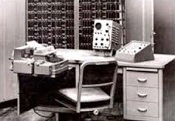
In June 1954 the Swedish ALWAC II (Axel L. Wenner-Gren Automatic Computer) is shipped, followed by the ALWAC III in Dec. 1955, featuring fewer parts and a lower price than its competitor the IBM 650; too bad, only 30 units are sold by the time that magnetic core memory makes it obsolete.
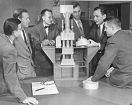

On Dec. 16, 1954 the first repeatable process for producing Artificial Diamonds is developed by scientists at Gen. Electric (GE) in Schenectady, N.Y., led by Howard Tracy Hall (1919-2008), using graphite with an iron sulfide catalyst at 1.6K C (4.8K F) and 70K atm (1.5M psi) for 38 min.; GE allegedly Hall with a $10 savings bond; in 1955 he becomes a prof. at Brigham Young U.
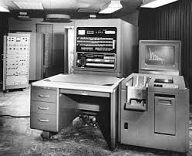
In 1954 IBM upstages the UNIVAC with its more powerful IBM Model 704 computer, the first with floating point arithmetic hardware.


In 1954 an IBM team led by John Warner Backus (1924-2007) of Dartmouth College develops the FORTRAN (Formula Translation) computer language for scientific use, which works especially well with floating point calculations; it is released commercially in 1957. In 1959 as an alternative to FORTRAN, "Amazing" Grace Murray Hopper (1906-92) of the U.S. Navy inflicts, er, invents the gawd-awful COBOL (Common Business-Oriented Language) computer language for business programming; the first official specs are pub. in Apr. 1960; on Sept. 9, 1947 she discovered a moth stuck in relay #70 panel F in the Mark II Computer at Harvard U., and invented the terms "computer bug" and "debugging"?; the moth ends up in the Smithsonian Inst. Nat. Museum of Am. History; she ends up getting promoted to er, rear adm.

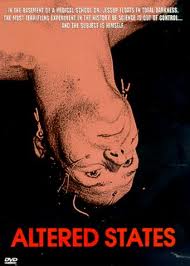
In 1954 after displaying brain patterns on a CRT using implanted electrodes in 1951, St. Paul, Minn.-born neuroscientist John Cunningham Lilly (1915-2001) of the Nat. Inst. of Mental Health invents the isolation tank, going into dolphin research and human-dolphin communication; in 1961 he and other scientists at the Green Bank Observatory in W. Va. form the Order of the Dolphin to discuss the use of radio astronomy to detect evidence of extraterrestrial intelligent life; in 1972 Lilly pub. The Center of the Cyclone: An Autobiography of Inner Space, about his LSD and ketamine trips in isolation tanks, and his spiritual training by Oscar Ichazo in Chile, helping him achieve the maximum dgree of Satori-Samadhi consciousness. On Dec. 25, 1980 Ken Russell's film Altered States, based on the 1978 Paddy Chayefsky novel about Lilly's work stirs, er, stars William Hurt (1950-) in his film debut as acid-zonked isolation tank psychoresearcher Edward "Eddie" Jessup, who undergoes an Ayahuasca ceremony in Mexico with Banisteriopsis caapi root, reverses his own evolution, and has cosmic sex with wife Emily Jessup (Blair Brown); also stars Bob Balaban; also the film debut of Drew Barrymore; score by John Corigliano, who loses the Oscar for sound to "The Empire Strikes Back"; dir. William Penn, SFX man John Dykstra, and screenwriter Paddy C. all end up leaving the project - must have gone outta their minds?
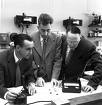
In 1954 the Silicon Photovoltaic (Solar) Cell is invented by Gerald L. Pearson (1905-87), Daryl Chapin (1906-95), and Calvin Souther Fuller (1902-94) of Bell Labs; it is 6% efficient, and is first demonstrated in Americus, Ga. on Oct. 4, 1955; too bad, they are too expensive for most uses such as powering homes.


In 1954 the first 10 Zambonis (ice rink resurfacers) are delivered by Eureka, Utah-born inventor Frank Joseph Zamboni Jr. (1901-88) to the city of Boston, Mass.
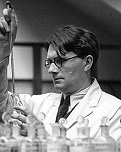
You can't fake steak? In 1954 British scientist-historian Noel Joseph Terence Montgomery Needham (1900-95) begins pub. Science and Civilisation in China (27 vols.) (1954-2015), which tries to explain Needham's Grand Question, why China stagnated in science and technology and allowed the Western barbarians to pass them up; too bad, he bends over backwards to cover for the Chinese POV?
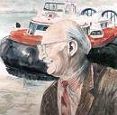
On Dec. 12, 1955 British mechanical engineer Sir Christopher Sydney Cockerell (1910-99) files a patent for the Hovercraft, with an annular ring and skirt to maintain an air cushion; initially it can only handle a 100 lb. payload, but in the 1960s it increases to 1K lb.

In 1955 English-educated Sikh scientist Narinder Singh Kapany (1926-) of Punjab, India invents Fiber Optics.

In 1955 Spanish-born Am. biochemist Severo Ochoa de Albornoz (1905-93) pioneers RNA synthesis, winning the 1959 Nobel Med. Prize.

In 1955 Scottish biochemist Sir Alexander Robertus Todd (1907-97) determines the chemical makeup of nitrogenous bases, synthesizing adenosine triphosphate (ATP) and flavin adenine dinucleotide (FAD); he also determines the structure of Vitamin B12, going on to do ditto for Vitamin B1 and Vitamin E, contributing to the scientific knowledge of nucleotides and nucleotide co-enzymes and winning the 1957 Nobel Chem. Prize.
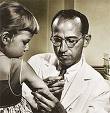
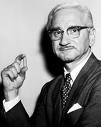
In 1955 Am. physician Jonas Edward Salk (1914-95) announces the success of his killed-virus Salk Polio Vaccine, and mass immunization begins; polio claimed 1 out of 5K in the U.S. during the preceding decade. In 1957 the "shotless" live-virus Sabin Oral Polio Vaccine of Russian-born Dr. Albert Bruce Sabin (1906-93) of the U. of Cincinnati, Ohio is introduced by the World Health Org. (WHO) to worldwide testing; it is endorsed by the Am. Medical Assoc. in 1961, and supplants the Salk vaccine by 1966, ending polio epidemics worldwide - say "bin"?
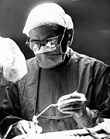
In 1955 neurosurgeon Harold Cornelius Voris (1902-80) et al. of Mercy Hospital and Medical Center in Chicago, Ill. perform the first successful separation operation for Siamese (conjoined) twins.


In 1955 Am. cardiologist Paul Maurice Zoll (1911-99) et al. invent the Artificial Cardiac Pacemaker, the Electrodyne PM-65, containing an electrical pulse generator and electrocardiograph on a portable cart.
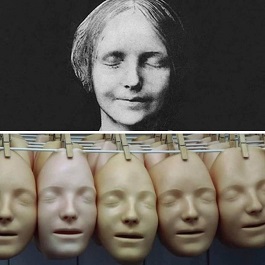
In 1955 the CPR doll is created by toymaker Asmund Laerdal and physicians Peter Safar and James Elam from L'Inconnue de la Seine (Unknown Woman of the Seine), a plaster death mask of an anon. woman who drowned in the Seine River in the 1880s, becoming known as Rescue Anne (Resusci Anne), the most kissed-face on Earth.
In 1956 radioactive chemicals are used to solve problems of soil-plant relationships; Deinococcus radiodurans, the "toughest bacterium in the world" is discovered by Arthur W. Anderson in cans of irradiated meat in Oregon.

In 1956 Vernon Martin Ingram (1924-2006) and John A. Hunt of Cambridge U. determine that a single amino acid exchange in hemoglobin causes the sickle cell disease trait, becoming the first time that such an exchange is proved to cause a disorder, founding the new field of Molecular Medicine.

In 1956 John Larry Kelly Jr. (1923-65) of Bell Labs invents the Kelly System of Wagering (Criterion), based on maximizing the logarithm of capital.

In 1956 Am. biochemist Arthur Kornberg (1918-2007) pioneers DNA synthesis with enzymes and nucleotides, winning him the 1959 Nobel Med. Prize.
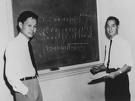
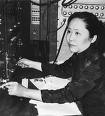
In 1956 Chinese-born Am. physicists Tsung-Dao Lee (1926-) and Chen-Ning Franklin Yang (Yang Zhenning) (1922-) of the Princeton Inst. for Advanced Study discover that parity is not conserved in nuclear reactions, suggesting that the Universe has a kind of "twist" and is not perfectly symmetrical, winning them the 1957 Nobel Physics Prize; too bad, their female coworker Chien-Shiung Wu (1912-97) ("the Madame Curie of China"), who was instrumental in devising the 1956 Wu Experiment that showed that beta particles emitted by cobalt-60 are more likely to be emitted in a particular direction depending on the spin of the nuclei is snubbed for being you know what - it had to be Siamese twins?

In 1956 Chinese-born biochemist Choh Hao Li (1913-87) of the U. of Calif. Medical Center in San Francisco first isolates and purifies Human Growth Hormone (HGH) (Somatotropin), going on to discover its structure in 1966 and synthesize it in 1970 - ask Hao?


In 1956 a team at the Los Alamos Lab led by Am. physicists Frederick Reines (1918-98) and Clyde Lorrain Cowan Jr. (1919-74) become the first to detect neutrinos, which were first theoretically predicted by Wolfgang Pauli in 1930; meanwhile Cork, Lambertson, Piccioni, and Wenzel discover the antineutrino. In Mar. 1980 Reines announces that the neutrino has mass, and Valentin Lubimov et al. of the Soviet Union claim to measure it at 14-46 ev, causing Reines to win the 1995 Nobel Physics Prize.
In 1956 Amniocentesis is first used for the detection of prenatal genetic disorders by St. Mary's Hospital in England.

In 1956 Sir William Rede Hawthorne (1913-) invents the Dracone, a floating barge made of rubbered cloth that can be filled with crude oil and towed, named after Frank Herbert's novel "Dragon in the Sea"; too bad, nightmares of it leaking cause it to be killed.
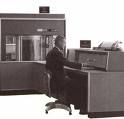
On Sept. 13, 1956 IBM introduces the IBm 305 RAMAC (Random Access Memory Accounting) System, becoming the first computer with a disk drive, the IBM 350 Disk File, with a humongous capacity of 5M 7-bit chars.; it stands 5 ft. 8 in. high, 5 ft. wide, and 29 in. deep; 14 models are introduced before they are discontinued in 1969.

In 1956 German physicist Erwin Wilhelm Muller (Müller) (1911-77) develops the Field Ion Microscope.


In 1956 Am. computer scientists Allen Newell (1927-92) and Herbert Alexander Simon (1916-2001) develop the Logic Theory Machine (Logic Theorist), the first artificial intelligence (AI) program, which proves 38 of the first 52 theorems of Bertrand Russell and Albert North Whitehead's "Principia Mathematica", followed next year by the academically useful but practically useless Gen. Problem Solver (GPS), using the Info. Processing Language (IPL) - it's alive, weird science?
In 1956 the sedative Thalidomide from German pharmaceutical co. Grunenthal begins to be marketed (until 1961) in almost 50 countries until it ends up getting banned for causing birth defects in 10K children.




Red Moon Rising, Or, The long Eisenhower Siesta ends, and now the smug Americans become desperate to keep up with the Russkies or be buried? On Oct. 4, 1957 the Soviet Union launches the beach ball-sized (22.8 in. diam.), 183.9 lb. Sputnik I, the first manmade satellite, which orbits the Earth every 96.2 min.; Operation Moonwatch, organized by Am. astronomer Fred Lawrence Whipple tracks its movements; on Oct. 4 the Soviet news agency Tass announces it, with the soundbyte "Artificial earth satellites will pave the way for space travel, and it seems that the present generation will witness how the freed and conscious labor of the people of the new Socialist society turns even the most daring of man's dreams into reality"; Americans, who had believed that all Russians did was steal their inventions are shocked; Khrushchev utters the soundbyte "People of the whole world are pointing to the satellite... saying that the U.S. has been beaten"; Clare Boothe Luce calls the Sputnik's beep an "outer-space raspberry to a decade of American pretensions that the American way of life is a gilt-edge guarantee of our national superiority"; after Pres. Eisenhower's Speech on Science in Nat. Security on TV on Nov. 7, the U.S. launches a massive $100B catch-up effort; Sputnik I is a sphere the size of a beach ball (22.8 in. diam.), weighing 183.9 lbs., and orbiting the Earth once every 96.2 min. (18K mph) at an apogee of 583 mi. to a perigee of 143 mi. while emitting 1 watt A-flat beeping sounds at 20-40 MHz from four radio antennas, launched from a Russian rocket with 200K lbs. of thrust, which is all far better than the planned U.S. Vanguard project, a 21.5 lb. satellite designed to be lifted to a 300 mi. orbit with a 27K lb. thrust rocket; the course of Sputnik takes it over most of the inhabited Earth so that as many people as possible can see it with binoculars, shifting 4 deg. a day, and purposely designed so that Americans are the last to be able to view it (Oct. 20); the batteries wear out after three weeks; no sooner does that happen than on Nov. 3 cone-shaped 1,129.29 lb. Sputnik II is launched, orbiting at 1,056 mi. alt., filled with scientific instruments, along with a female part-Samoyed terrier named Kudryavka (Russian for Little Curly), later changed to Laika (1954-7) (Russian for Barker) (who runs out of oxygen and dies within two days), scaring Americans that the Commies will get to the Moon first and attack Earth from it?; Sputnik II reenters Earth's atmosphere on Apr. 14 after 162 days in orbit; as the news breaks, Ike is returning from a West Point class of 1915 reunion and homecoming football game, and when he refuses to rush into the space program, his public approval plummets from 71% to 57%; the death of Laika pisses-off the Nat. Canine Defence League (founded 1891); the brains behind the Soviet space program is Lt. Gen. Kerim Aliyevich Kerimov (1917-2003), whose identity is kept secret for decades; by the year 2000 over 25K objects are put into orbit, of which almost 9K remain orbiting; Sputnik eventually falls onto the middle of 8th St. in Manitowoc, Wisc., where a brass ring is placed.

In 1957 Am. physicists John Bardeen (1908-91), Leon N. Cooper (1930-), and John Robert Schrieffer (1931-) develop BCS Superconductivity Theory, which explains low temperature (30 Kelvin and under) (Type I) superconductivity as resulting from condensation of electron (Cooper) fermion pairs into bosons, winning them the 1972 Nobel Physics Prize; too bad, in 1986 a new kind of high temperature superconductivity (up to 130 Kelvin) is discovered, which this theory can't explain, and is not understood until ?.



In 1957 Swedish scientist Arvid Carlsson (1923-) proves that dopamine is a brain neurotransmitter and not just a precursor to norepinephrine, winning him the 2000 Nobel Med. Prize. In 1967 Greek-born Am. neurologist George Constantin Cotzias (1918-77) develops L-Dopa (levo-3,4,-dihydroxyphenylalanine) therapy for dopamine-deficient patients suffering from manganese poisoning, gradually increasing the oral dosage so that they can develop tolerance to the toxic side effects until they get enough in their system to pass the blood-brain barrier and turn into dopamine. In 1973 London-born neurologist Oliver Wolf Sachs (1933-2015) pub. Awakenings, about his use of L-Dopa on encephalitis lethargica patients at Beth Abraham Hospital in Bronx, N.Y., which is filmed in 1990 starring Robin Williams and Robert De Niro.

In 1957 Gordon Dobson (1889-1976) of Oxford U. discovers the Ozone Layer.
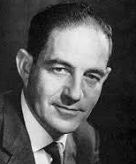
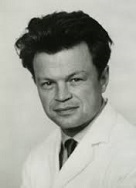
In 1957 Scottish virologist Alick Isaacs (1921-67) and Yugoslavian-born Swiss virologist Jean Lindenmann (1924-2015) discover the antiviral protein Interferon.
In 1957 French physician Jean Sterne pub. the first clinical trial of Metformin (first synthesized in the 1920s then forgotten) as a treatment for diabetes; after being approved in the U.K. in 1958, Canada in 1972, and the U.S. in 1995, it becomes one of the most popular drugs in the world; in 2012 it is discovered to fight cancer.


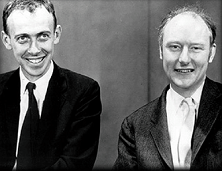
In 1957 Am. biologists Matthew Stanley Meselson (1930-) and Franklin William "Frank" Stahl (1929-) prove that DNA replication is semi-conservative, i.e., each daughter cell contains one DNA strand from the original helix.

In 1957 German physicist Rudolph Moosehair, er, Rudolph Ludwig Mossbauer (Mössbauer) (1929-2011) discovers the Mossbauer Effect, the resonant recoil-free emission and absorption of gamma rays by atoms in solids, winning him the 1961 Nobel Physics Prize.

On Feb. 1, 1957 German self-taught engineer Felix Heinrich Wankel (1902-88) successfully tests the compact lightweight smooth hi-rpm rotary Wankel Engine.
In 1957 several of William Shockley's associates at Shockley Semiconductor bolt to form Fairchild Semiconductor, leading to the creation of Silicon Valley and the greatest wealth boom since Holland in the 17th cent.; too bad, shock Shockley ends up sharing in none of it?
In 1957 Mobile Oil Corp. introduces the Baggie plastic bag made out of petroleum derivatives.
In 1957 Bubble wrap is invented by Alfred Fielding and Marc Chavannes in an attempt to create 3-D plastic wallpaper; in 1960 Fielding founds Sealed Air Corp.
In 1957 Bendix Corp. invents the first commercial Electronic Fuel Injection System, which is first offered on June 15 by Am. Motors (AMC) on its Rambler Rebel muscle car for $395.
In 1957 Norman Bier invents Methacrylate Corneal Contact Lenses.

In 1957 Ing Fioriti of Turin, Italy builds the 8-ft.-tall 1K-lb. Cygan (Gygan) robot, which runs up to 4.5 hours on a 28V battery and can move 10 ft. per min. forwards or backwards, and crush tin cans with its claws.
In 1957 the RCA Mark II Sound Synthesizer, designed by Harry Ferdinand Olson (1901-82) and Herbert Belar is introduced, becoming the first programmable electronic music synthesizer, and is installed at Columbia U. for the Columbia-Princeton Electronic Music Center.
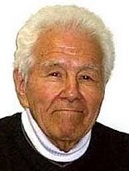
In 1957 Tang brand powdered orange drink is developed in Brooks City, Tex. for NASA by Am. food chemist William A. "Bill" Mitchell (1911-2004) of Gen. Foods Corp.; it is first marketed in 1959; sales are poor until it is used on John Glenn's Mercury flight in Feb. 1962; Mitchell goes on to develop quick-set Jell-O, Cool Whip, powdered egg whites, and Pop Rocks astronauts get all the tang they want on the ground?
On Jan. 3, 1957 Hamilton Watch Co. introduces the first Battery-Powered Watch, that doesn't need winding ("the watch of the future"); in development since 1946, it has reliability problems, and is discontinued in 1969.
In 1957 John Borden invents the 300K rpm Air-Driven Dental Drill, shrinking the time for filling a tooth to mere minutes.
In 1957 the first Wearable External Cardiac Pacemaker is invented by Clarence W. Lillehie and Earl Bakk, the Medtronic, followed by the first reliable long-term implantable system in 1960.
In 1957 Swiss engineer George de Maestral invents Velcro after pulling burdock cockleburs from his dog's fur.


On July 1, 1957-Dec. 31, 1958 the Internat. Geophysical Year (IGY) is participated in by 67 nations, who cooperate to sponsor research on the year's high solar sunspot activity; the idea was originated in 1950 by scientists James Alfred Van Allen (1914-2006) of the U. of Iowa, and British geophysicist Sydney Chapman (1888-1970) on England; the Antarctic is the initial focus of activity with Operation Deep Freeze (1955-6) using a network of 60 research stations; on Sept. 18, 1958 the temp. in the Antarctic reaches a record low of -102.1 F (-74.5 C).

On Jan. 31, 1958 the U.S. enters the Space Age by successfully launching its first satellite into orbit, 31-lb. Explorer (Futura) 1, followed on Mar. 5 by Explorer 2 (which fails to reach Earth orbit), and on Mar. 26 by Explorer 3 (Gamma 1) (launched in conjuction with the IGY); meanwhile on May 15 the Soviets launch the 7K-lb. Sputnik III, but the U.S. follows on July 26 with Explorer 4, allowing Am. physicist James Alfred Van Allen (1914-2006) of the U. of Iowa to discover the two doughnut-shaped Van Allen Radiation Belts around Earth using Geiger counters placed aboard; in Sept. 2012 a third ring between the other two briefly appears; the Van Allen Radiation Belts of highly-charged particles will turn into X-rays when they hit metal, making it impossible for humans to travel through it, leading to the conclusion that the Apollo lunar landings were faked?

In Mar. 1958 Am. chemist Charles David Keeling (1928-2005) begins measuring atmospheric CO2 on Mauna Loa, Hawaii for the Internat. Geophysical Year, obtaining an initial reading of 314 ppm, which grows to 387 ppm in 50 years, becoming known as the Keeling Curve.

In 1958 Am. physicist Philip Warren Anderson (1923-) proposes Anderson Localization, a novel containment of electrons in a highly disordered medium, winning him the 1977 Nobel Physics Prize.

In 1958 Scottish scientist SirJames Whyte Black (1924-2010) develops Inderal (Propranolol), the first successful beta blocker for treatment of hypertension, which is approved by the U.S. FDA in 1976. In 1976 SmithKline's revolutionary gastric acid inhibitor Tagamet (Cimetidine), developed by Black is first marketed in Britain; Black is awarded the 1988 Nobel Medicine Prize for it and Propanolol; the U.S. FDA approves it on Aug. 23, 1977 after 200K patients in the U.K., Canada, and Mexico receive it.
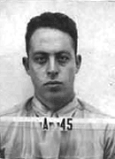
In 1958 Am. physicist ("the Father of the Neutron Bomb")_ Samuel Theodore Cohen (1921-2010) of Lawrence Livermore Nat. Lab develops the concept of the infrastructure-saving Neutron Bomb enhanced radiation weapon, which releases its energy as neutron radiation rather than feeding it back to create more explosive power; in 1963 it begins underground tests in Nevada, is shelved by Pres. Carter in 1978 after news that it will be deployed in Europe causes protests, and is reinstated by Pres. Reagan in 1981, after which Pres. G.W. Bush starts dismantling them, completed in 2003; meanwhile France tests its first neutron bomb on June 24, 1980, but also dismantles them.
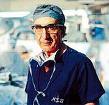
In 1953 Am. surgeon Michael Ellis DeBakey (1908-2008) performs the first successful Carotid Endarterectomy (removal of material from the inside of an artery). In 1958 he performs the first Patch-Graft Angioplasty using Dacron grafts.
In 1958 Am. researcher F.S. Steward grows complete carrot plants from differentiated carrot cells, proving the possibility of cloning people?
In 1958 the U.S. govt. establishes Project Orion to develop a spaceship powered by atomic bombs; the Aug. 1963 Nuclear Test Ban Treaty kills it.
In 1958 David Paul Gregg of MCA invents the transparent mode Laserdisc, and patents it in 1961, then sells it to MCA in 1968; after Philips develops a reflective mode version, the two cos. join efforts and demonstrate the first videodisc in 1972.


On Sept. 12, 1958 Am. electrical engineer Jack St. Clair Kilby (1923-2005) of Texas Instruments demonstrates the first Integrated Circuit (IC) chip, winning him the 2000 Nobel Physics Prize; 6 mo. later Robert Noyce (1927-90) of Fairchild independently develops a better one, going on to co-found Intel Corp. in 1968, giving Silicon Valley its name.


In 1958 Aaron Bunsen Lerner (1920-2007) et al. at Yale U. isolate the hormone Melatonin from the pineal glands of rats, which turns out to regulate the Circadian Rhythm. In 1994 Japanese-born Am. neurobiologist Joseph Takahashi (1951-) discovers the genetic basis for the mammalian circadian clock, and in 1997 identifies the Clock gene.

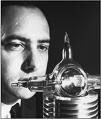

In 1958 the Laser (Light Amplification by Stimulated Emission of Radiation) is invented at Bell Labs by Charles Hard Townes (1915-) and Arthur Leonard Schawlow (1921-99); they receive a patent on Mar. 22, 1960. On May 16, 1960 U.S. physicist Theodore Maiman (1927-2007) of Hughes Research Labs in Malibu, Calif. (brother-in-law of Schawlow, who came up with the idea of building a cavity out of synthetic ruby to serve as an amplification chamber) first demonstrates the Optical Ruby Laser. In 1957 Am. physicist Gordon Gould (1920-2005) proposes the theory of the laser and coins the name; too bad, as a former Communist the govt. won't give him clearance to work on the development, allowing Theodore Maiman at Hughes Research Labs to beat him to it, and his U.S. patent is stolen, although he obtains patents in other countries; in 1977 he finally obtains U.S. patent #4,053,845 on optically-pumped laser amplifiers, freaking out the $400M/year laser industry, which fights him in court, until he wins a big V in 1987 and ends up with 48 patents and makes millions and his name becomes as gordon gould?

In 1958 Am. statistician John Wilder Tukey (1915-2000) coins the term "software" in a Jan. 9 article in the Am. Mathematical Monthly, with the soundbyte that it is "at least as important to the modern electronic calculator as its 'hardware' of tubes, transistors, wire, tapes and the like"; the term hardware was coined by Paul Niquette in 1953, but this is the first time it's used in print.
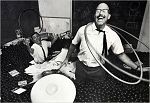
In 1958 Wham-O Manufacturing Co., founded after WWII by Richard Knerr (1926-2008) and Arthur "Spud" Melin (1925-2002) in San Gabriel, Calif. with less than $1K in capital to make slingshots, which bought the patent rights last year to the Frisbee (flying disc) (originally a popcorn can lid then a cake pan) by Walter Frederick "Fred" Morrison (1920-2010), going on to sell 200M units by 2009.
In 1958 Bell Labs introduces the Bell 101 Modem (modulator-demodulator) for transmitting computer data along analog lines at 110 bps (baud) using frequency shift keying (FSK), and the Baudot Code patented in 1874 by French telegraph engineer Jean Maurice Emile Baudot (1845-1903); in 1962 it introduces the 300 baud Bell 103 Modem, the 2nd commercial modem.
In 1958 New Orleans-born Donald C. "Don" Wetzel (1929-) invents the idea of the Automated Teller Machine (ATM) while waiting in line at a bank.
In 1958 the ALGOL (Algorithmic Language) 58 computer language is developed in Zurich, Switzerland by an internat. committee to avoid perceived problems with FORTRAN, becoming the first with nested function definitions and lexical scope, and the first with a formal language definition, the Algol 60 Report, which introduces the Backus-Naur Forms; ALGOL 58 is followed by ALGOL 60 and ALGOL 68.
In 1958 Taiwan-born Momofuko Ando (1920-2007) invents wheat noodle Ramen (Jap. "pull noodles") as "student noodles".

In 1958 Lego, founded in 1932 in Denmark patents its stud-and-tube coupling system for its plastic bricks.


In 1958 Isaac Asimov (1920-92), who received a Ph.D. in Chem. in 1948 for enzyme research ("The Kinetics of the Reaction Inactivation of Tyrosinase During Its Catalysis of the Aerobic Oxidation of Catechol"), but proved no good at research is fired from his job at a small medical school for wanting to teach instead, leaving him to pursue his real love of cranking out writing? 1950 was the year that sci-fi emerged from magazines to book form; Isaac Asimov pub. his first novel Pebble in the Sky, #1 in the Galactic Empire series (1950-2); he also wrote I, Robot, actually, a screenplay that perennially failed to get filmed.

On May 7, 1959 English physical chemist-novelist C.P. (Charles Percy) Snow, Baron Snow (1905-80) gives the speech The Two Cultures and the Scientific Revolution in the Senate House, Cambridge U., which claims that literary intellectuals and scientists don't understand or trust each other, and that there is an impassable gulf based on the problem that "the scientific mind was progressive and the literary mind was reactionary" - is there a way to reunite them with a 21st cent. historyscoping education, or did I get ahead of myself?
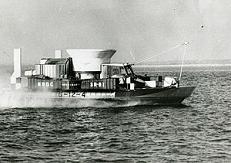
On July 25, 1959 the Saunders-Roe SR.N1, the first civilian hovercraft crosses the English Channel in 20 min.; in Dec. the Duke of Edinburgh talks them into letting him fly it, and he flies it too fast, dishing in the bow, creating the "Royal Dent".
On Sept. 19, 1959 Nature pub. a paper by Giuseppe Cocconi and Philip Morrison claiming that terrestrial radiotelescopes are sensitive enough to detect radio signals from other stars; the SETI (Search for Extra-Terrestrial Intelligence) program is born.
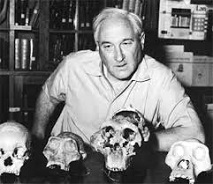
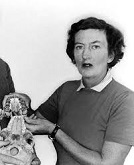
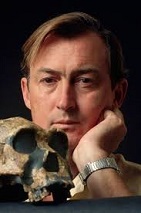
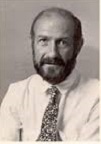
On July 17, 1959 after leading expeditions to 30 mi.-long Olduvai Gorge on the E Seregeti Plains in the Great Rift Valley 25 mi. N of Laetoli, Tanganyika since Nov. 1931, Kenyan-born British archeologist Louis Seymour Bazett Leakey (1903-72) (former British missionary, who tries to cling to Christianity and Darwinism at the same time), and his wife (since 1936) Mary Leakey (1913-96) discover the skull of 1.7M-y.-o. Nutcracker Man (Olduvai Hominid 5) (Paranthropus boisei) (Zinjanthropus in Tanganyika, which becomes the first hominin to be dated using K-Ar dating; tools found nearby are later traced to Homo Habilis, which has a larger brain, and is unearthed in 1961; the big discovery makes them famous, allowing them to finally get good funding; the Zinjanthropus cranium ends up in the Hall of Man at the Nat. Museum of Tanzania in Dar es Salaam. In 1972 Kenyan-born anthropologist Richard Erskine Frere Leakey (1944-) (son of Mary Leakey and Louis Leakey, who dies this year, leaving him to carry on) and South African anthopologist Glynn Llywelyn Isaac (1937-85) discover a human skull in Koobi Fora Ridge on the E shore of Lake Turkana in N Kenya dated to 1.8M to 2.4M B.C.E., the oldest yet, making Leakey into a celeb. In 1975 Mary Leakey uncovers jaws and teeth of 11 Australopithecis afarensis (direct ancestor of Homo habilis) skeletons in Laetoli, Tanzania, 25 mi. S of Olduvai Gorge, claiming that they are 3.75M-y.-o. and have human (Homo) characteristics; in 1978 she uncovers the 3.65M-y.-o. fossilized Australopithecus afarensis Laetoli Footprints in volcanic ash, claiming proof that human ancestors walked upright; it takes until 1981 to uncover all of it - you don't want to say Hail Mary around these parts?
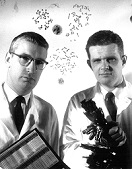
In 1959 Philly-born cancer researcher Peter Carey Nowell (1928-2016) and Brockton, Mass.-born researcher David A. Hungerford (1927-93) independently discover the Philadelphia Chromosome (Translocation), an easy-to-detect genetic abnormality of chromosome 22 of lukemia patients, which aids diagnosis.
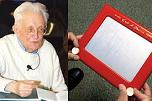
Good year for Baby Boomer toys and gadgets? In 1959 the aluminum-dust-filled Etch A Sketch (originally L'Ecran Magique) is invented by Andre Cassagnes (1926-2013) of France, and purchased by the Ohio Art Co. of the U.S., where it becomes a Baby Boomer hit next Xmas, the #1 seller of the season; by 2013 100M are sold.
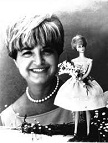

In 1959 Barbie Dolls, invented by Ruth Handler (Mosko) (1917-2002) of Mattel, Inc. (named after her daughter Barbara) go on sale for the first time; they become the most successful toy line of all time, even though Barbie's proportions are a little tough to attain in real life.
In 1959 Pantyhose made of spandex, and girdles made of lycra are first marketed commercially.
The 1960s becomes the Pharamaceutical Decade as blood pressure, tranquilizer, and other drugs hit the market bigtime, starting with the anti-anxiety sedative-hypnotic Benzodiazepines (BZDs) incl. Librium (Chlordiazepoxide) (AKA Librax, Libritabs, Mesural, Multum, Novapam, Sonimen, Tropium, Angirex, Elenium, Klopoxid et al.) of Hoffmann-La Roche Labs, which was discovered accidentally in 1955 by Leo Sternbach and receives FDA approval on Feb. 24; in 1963 it markets the benzodiazepine drug Diazepam AKA Valium; in 1977 the benzodiazepine drug Lorazepam is introduced, becoming known for its ability to induce sleep and amnesia, making it the date rape drug of choice - my mother used to look like this?
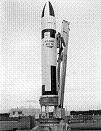
On Jan. 7, 1960 a U.S. 2-stage solid fuel Polaris Missile is test-launched from Cape Canaveral; on Apr. 14 one is launched underwater for the first time; on July 20 a missile is successfully test-fired into the air from a submarine, after which it becomes known as a fleet ballistic missile (FBM); in 1961 Holy Loch in the Firth of Clyde in Argyll, Scotland becomes a Polaris base.


On Feb. 16-May 10, 1960 the 447-ft. USS Triton twin-reactor nuclear submarine, captained by "Run Silent, Run Deep" (1955) author Edward Latimer "Ned" Beach (1918-2002), with a crew of 176 plus six scientists completes the first submerged circumnavigation of the Earth in 84 days (30,708 mi.), tracing the same route used by Ferdinand Magellan in 1519; they cheat and surface on Mar. 5 to transfer a sick crewman to heavy cruiser Macon off Montevideo before rounding Cape Horn - looking for lost loot?
In 1960 Irving Friedman (1920-2005) et al. of the U.S. Geological Survey invent Obsidian Hydration Dating based on absorption of water over time.





The thrill of breaking things becomes Big Science? In Jan. 1960 Murray Gell-Mann (1930-) of Caltech pub. his Eightfold-Way Theory, proposing that all of the 100+ nuclear particles, incl. subnuclear hadrons (baryons and mesons) are made up of Quarks (named after James Joyce's "Finnegans Wake", "Three quarks for Muster Mark!/ Sure he hasn't got much of a bark/ And sure any he has it's all beside the mark"), which come in various flavors (up, down, strange, charm, top, bottom), and are permanently confined by forces coming from the exchange of Gluons, and calling for a search for a nuclear particle called Omega Minus; the same mo. Yuval Ne'eman (1925-2006) of Israel pub. a similar theory; too bad, Gell-Mann is awarded the 1969 Nobel Physics Prize, but Ne'eman is snubbed. In 1969 evidence of the existence of the elusive quark is finally discovered at the Stanford Linear Accelerator Center by Jerome Isaac Friedman (1930-), Henry Way Kendall (1926-99), and Richard Edward Taylor (1929-), who share the 1990 Nobel Physics Prize. In 1972 Gell-Mann develops Quantum Chromodynamics to link quarks and color forces; Gell-Mann and Harald Fritsch propose Gluonium (Glueballs) (Gluon-Balls), composed entirely of gluons (i.e., pure force); verified by researchers at TU Wien in 2015?
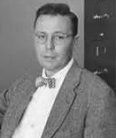
In 1960 Cambridge, Mass.-born physicist John Hamilton Reynolds (1923-2000) of UCB sets the age of the Solar System at 4.95B years based on an excess of xenon-129 in the Richardton Meteorite and other meteorites resulting from beta decay of iodine-129 to xenon-129 in its early years.
In 1960 G.N. Robinson of Beecham Co. of Britain discovers the semi-synthetic penicillin Methicillin (Meticillin) (originally Celbenin), which is toxic to humans but can kill Staphylococcus aureus in the lab.

In 1960 English surgeon Michael Francis Addison Woodruff (1911-2001) performs the first successful Kidney Transplant in the U.K. at the Edinburgh Royal Infirmary, getting knighted for it in 1969.

In 1960 Am. chemist Robert Burns Woodward (1917-79) (the model for nerds of the future?) announces the synthesis of chlorophyll, winning him the 1965 Nobel Chem. Prize.
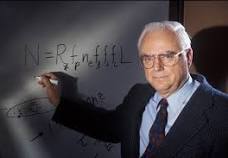
The first Jodie Fosters with those accents they try so desperately to shed, pure West Virginia are already into Carl Sagan's Contact? In 1960 Project Ozma is founded by Chicago, Ill.-born astronomer Frank Donald Drake (1930-) of Cornell U. in Green Bank, W. Va., doing the first research for the SETI program, looking for signs of extraterrestrial life on the 1.420 GHZ band. In 1961 Drake develops the Drake Equation to estimate the number of detectable civilizations in the Milky Way Galaxy. The U.S. govt. stops funding SETI in 1995.
In 1960 dinosaur fossils are found in Zhucheng in Shandong Province in E China, which climbs to 7.6K fossils in 2008, making it the richest dino fossil site on Earth.

In 1960 the Bussard Ramjet, a rocket that uses electromagnetic fields to compress hydrogen until it fuses is proposed by physicist Robert W. Bussard (1928-2007) as a method of spacecraft propulsion - why do I keep picturing a space buzzard?
In 1960 Kazuo Hashimoto (-1995) of Phonetel develops the Ansafone, which becomes the first telephone answering machine sold in the U.S.


In 1960 Soft Contact Lenses using HEMA (hydrogel-poly-hydroxyethyl methacrylate) are invented using an Erector Set and a phonograph (a children's spincasting kit?) on his kitchen table by Czech chemist Otto Wichterle (1913-98) and Drahoslav Lim (1925-2003); even though they are more comfortable than hard contacts (introduced in 1939), the FDA doesn't approve them until Mar. 18, 1971; in 1976 Bausch and Lomb begins marketing them; by the end of the cent. 100M worldwide are wearing them, even though they only last about a year.
On Oct. 25, 1960 Bulova introduces the Accutron 360 Hz tuning fork watch, the first Electronic Wristwatch, with a retro analog display; in 1963 they introduce the Spaceview, with a transparent dial so the tuning forks can be observed.
In 1960 IBM introduces the 1405 Disk Storage unit, available with 25 or 50 disks for 10MB or 20MB storage capacity, with a 17.5 KB per sec. read/write rate; the CIA uses it for their Walnut info. retrieval system; it is discontinued in 1970.
In 1960 Imperimerie Nat. of Paris, France pioneers Computer Typesetting.

On Mar. 9, 1960 Am. physician Belding Hibbard Scribner (1921-2003) of the U. of Wash. implants the first outpatient kidney dialysis Teflon Scribner Shunt in 39-y.-o. machinist Clyde Shields (1921-71); the operating room version was developed in 1944 by Willem J. Kollf; too bad, now that people with renal failure have an easier way out, the ethical dilemma of who will and won't be treated arises, and in 1962 Scribner founds the 12-patient Seattle Artificial Kidney Center, the world's first outpatient dialysis treatment center, with an anon. committee deciding which of 60 patients get treatment.
In 1960 the PLATO (Programmed Logic for Automated Teaching Operations) computer-assisted education system is built at the U. of Ill. by Donald Bitzer, pioneering online forums, message boards, e-mail, chat rooms, picture languages, instant messages, multiplayer games, and remote screen sharing; it is shut down in 2006.





1961 - The U.S.-Soviet Space Race gives Round 2 to the Soviets again, who send one Commie into orbit, while another Commie in tights leaps to freedom, and another jumps a fence to freedom for great heartwarming TV moments, countering the feeling that the Space Race is being won by the Gagarins? On Jan. 31, 1961 37 lb. Ham the Chimpanzee (1956-83) becomes the first animal put by the U.S. into orbit aboard Mercury-Redstone 2 to test the Project Mercury capsule. On Apr. 12, 1961 (100th anniv. of the opening of hostilities at Ft. Sumter) orange-spacesuited Soviet cosmonaut Yuri Alekseyevich Gagarin (1934-68) becomes the first human to orbit the Earth in his 6-ton spacecraft Vostok (East) 1, making a single orbit at 17.5K mph in 108 min. at alt. 203 mi. while humming a patriotic song with the lines "The Motherland hears, the Motherland knows/ Where her son flies in the sky"; after welcoming him back to Earth, Nikita Khrushchev says that Gagarin "didn't see any God up there", which was misquoted as by Gagarin himself. The original 15 minutes of fame? On May 5, 1961 (Fri.) after uttering "Shepard's Prayer" ("Don't fuck up, Shepard") ("Oh Lord, don't let me fuck up"), Navy cmdr. Alan Bartlett Shepard Jr. (1923-98) (known for impersonating Jose Jimenez) becomes the 2nd person and 1st American in space as he makes a 15-min. suborbital flight down the Atlantic Missile Range on a Redstone Rocket ("every part of this ship was built by the low bidder"), reaching an alt. of 116.5 mi. in the Project Mercury Freedom 7 capsule launched from Cape Canaveral, Fla.; after waiting too long on the launchpad and peeing in his spacesuit, he utters the immortal soundbyte "What a beautiful view!"; on his return, he is greeted as a nat. hero and given parades in New York City, Washington, D.C., and Los Angeles, and meets with Pres. Kennedy; he uses a bar of Dial brand soap, which ends up in the Smithsonian; too bad, in early 1964 he is diagnosed with Meniere's Disease, causing him to be removed from flight status until May 1969 after corrective surgery, when he becomes the oldest astronaut in the U.S. space program, then gets to command Apollo 14 in 1971, becoming the 5th person to walk on the Moon. On May 25, 1961 Pres. Kennedy gives his Man on the Moon Speech to a joint session of Congress, asking Americans to help put an American (white, straight, male, non-Communist) on the Moon and return him safely by the end of the decade; former pres. Eisenhower utters the soundbyte "Anybody who would spend $40B in a race to the Moon for national prestige is nuts." On July 21, 1961 U.S. Air Force Capt. Virgil Ivan "Gus" Grissom (1926-67) becomes the 2nd Americanski to rocket into a suborbital pattern around the Earth, flying for 16 min. on the Mercury-Redstone 4 Liberty Bell 7; too bad, the capsule sinks in the Atlantic Ocean 302 mi. from Cape Canaveral when the hatch blows prematurely, and bobbing Grissom is rescued by heli; the capsule is not recovered until 1999, and Grissom's career is tainted by allegations that he screwed the pooch, although he claims the explosive bolts went off by themselves in an equipment malfunction. The original Dudley Doright Eagle Scout Lily-White Straight Married American Hero? On Feb. 20, 1962 (Tue.) U.S. Marine Lt. Col. John Herschel Glenn Jr. (1921-) becomes the first American to orbit the Earth (3x) in the Mercury Atlas 6 Friendship 7 capsule in a mission lasting 4 hr. 55 min. 23 sec., reaching an alt. of 162 mi., and uttering the soundbyte "Oh, that view is tremendous!"; the pop. of Perth, Australia turn their lights on and off simultaneously as he passes over them, and he thanks them; he claims to see firefly-like objects swarming over his capsule; after a "Landing Bag Deployed" light starts blinking, causing the heat shield to be suspected of being loose, the planned seven orbits are scrapped, and he has to reenter without jettisoning the retro rockets so they will hold his heat shield on; on Mar. 1 he is given a ticker tape parade in New York City (3,529 tons of ticker tape); he is given a 2nd ticker tape parade on June 18, 1999; Samuel Shenton (-1971), founder of the Flat Earth Society (1956) sends Glenn a telegram: "OK wise guy"; in Jan. 1964 6 weeks after the assassination of personal friend JFK he retires from NASA to go into politics.
In 1961 Beecham Co. of Britain begins marketing the antiobiotic Ampicillin (Penbritin).
In 1961 Ibuprofen is patented by Boots Co. of Britain, and approved for prescription use to treat rheumatoid arthritis in 1969, followed by the U.S. in 1974; it becomes an over-the-counter drug in the U.K. in 1983; unlike aspirin, it is stable in solution and can be applied as a topical gel for sports injuries to bypass the digestive tract.

In 1961 Christian Boehmer Anfinsen Jr. (1916-95) of the Nat. Insts. of Health shows that ribonuclease can be refolded after denaturation with enzyme activity preserved, suggesting that the info. required by protein to reach its final conformation is encoded in its primary structure, winning him the 1972 Nobel Chem. Prize.




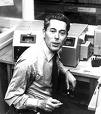
In 1961 South African biologist Sydney Brenner (1927-), French biologist Francois Jacob (1920-2013), and Am. biologists Matthew Stanley Meselson (1930-) and Franklin William Stahl (1929-) use phage-infected bacteria to show that ribosomes are the site of protein synthesis and are stable, proving the existence of Messenger RNA (mRNA), and elucidating the triplet nature of the code of protein translation, incl. how frameshift mutations occur when a number of nucleotides not evenly divisible by three are inserted or deleted; Jacob and Jacques Lucien Monod (1910-76) propose that control of enzyme levels in cells occurs through feedback on transcription, becoming the first example of a transciptional regulation system, winning them the 1965 Nobel Med. Prize; Brenner later discovers that the 1mm roundworm Caenorhabditis elegans is an ideal model organism for studying the genetics of animal development, winning him the 2002 Nobel Med. Prize.

In 1961 Cryosurgery is first performed by Am. neurosurgeon Irving Spencer Cooper (1922-85) on Parkinson's disease patients to reduce tremors.


On May 15, 1961 German biochemist J. Heinrich Matthaei (1929-) of NIH in Bethesda, Md. performs the Poly-U Experiment, becoming the first person to understand the genetic code, going on to work with Am. biochemist Marshall Warren Nirenberg (1927-2010) to synthesize repeated nucleotide sequences leading to the production of repeated single amino acids; too bad, Matthaei is snubbed for a Nobel Prize - something about the Nuremberg Trials?


In 1961 after 302 cases of phocomelia (seal-flipper limbs) in newborns in West Germany, Australian physician William Leon McBride (1938-) traces it to the tranquilizer Thalidomide (originally developed by the Nazis as an antidote to the nerve gas Sarin, and used since 1956 in 50 countries to treat morning sickness during pregnancy) (actually only one of the two isomers, left and right-handed, causes fetal abnormalities, but it is marketed in a 50-50 mixture), causing the ministry of health to issue a warning to physicians, after which the U.S. FDA on the advice of reviewer Frances Kathleen Oldham Kelsey (1914-) rejects approval, and McBride becomes a hero, earning several awards; too bad, 10K-12K children are born with phocomelia by the time its use is stopped; too bad, McBride claims that the drug alters DNA so that the affliction can be passed to children, and he is discredited in 1993 for falsifying the records on another morning sickness drug and struck from the Australian Medical Register.

In 1961 French-Australian physician Jacques Francis Albert Pierre Miller (1931-) proves that the thymus is part of the immune system by removing it from newborn mice, who fail to develop white blood cells or lymph nodes and accept grafts without rejection.

In 1961 Am. psychologist Neal Elgar Miller (1909-2002) proposes the use of Biofeedback to control heart rate and other involuntary functions.

In 1961 English biochemist Peter Dennis Mitchell (1920-92) pub. the Chemiosmotic Theory to explain energy storage in plants and animals via a proton gradient across a vesicular membrane that generates an electric field, countering the prevailing purely chemical phosphorylation theory and winning him the 1978 Nobel Chem. Prize after ATP synthase is discovered.

In 1961 Canadian scientists James Edgar Till (1931-) and Ernest Armstrong McCulloch (1926-) prove the existence of Stem Cells by using radiation to destroy the blood cells of lab mice, then injecting bone marrow from genetically identical mice and observing that all types of blood cells are formed - talk about getting your strong arm and hand in the eager till and McCulling in earnest?
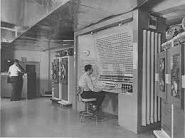
In 1961 Burroughs introduces the Burroughs 5000, featuring a stack-driven architecture with reentrant code that exclusively supports high-level programming languages, becoming a programmer's dream; all system software is written in ALGOL 60; ruggedized (militar spec.) modules plug into the backplane.
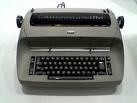

On July 23, 1961 IBM Corp. introduces the electric IBM Selectric Typewriter, invented by architect Eliot Fette Noyes (1910-77), which uses a replaceable golfball-shaped typing element to allow easy changing of fonts; in 1964 IBM introduces a magnetic tape to turn it into a word processor, for a mere $10K; the IBM Pavilion in the 1964 New York World's Fair is shaped like a Selectric type element; in Oct. 1969 IBM introduces the IBM Mag Card Selectric Typewriter.
In 1961 David Flexer of Inflight Motion Pictures develops a 16mm film system for commercial aircraft, replacing 30-in.-diam. film reels; on July 19 "By Love Possessed" by John Sturges becomes the first movie shown on a regular commercial airline flight on TWA.
In 1961 Grecian Formula hair dye is introduced by Combe Inc. of er, White Plains, N.Y., becoming a hit with the graying set because it is colorless and works gradually because it is really lead acetate and sulfur, which penetrates the hair shaft and turns dark black; after daily treatments for 1-2 weeks, it only has to be applied once a week.
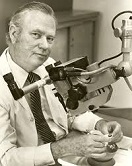
In 1961 Am. physician William Fouts House (1923-2012) invents the Cochlear Implant (bionic ear) for deaf people, which stimulates nerves inside the inner ear with electric currents; it is first marketed commercially in 1972.

In 1961 John Larry Kelly Jr. (1923-65) of Bell Labs uses an IBM 704 computer for Human Speech Synthesis, having it sing the song Daisy Bell, which Arthur C. Clarke witnesses, using it in his 1968 film "2001: A Space Odyssey".
In 1961 Jack Lippes invents the inert plastic Intrauterine Device (IUD) for birth control, becoming up to 99.9% effective and lasting up to 10 years.
In 1961 Am. electrical engineer Eugene F. Lally of JPL invents Digital Photography as a way for manned missions to photograph Mars.
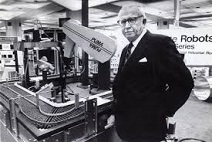
In 1961 George Charles Devol Jr. (1912-2011) receives U.S. patent #2,988,237 (filed 1954) for Unimate, the first industrial robot, which begins operation at a GM plant in Ewing Township, N.J. welding die castings onto auto bodies.
In 1961 Wham-O begins marketing Slip 'n Slide, a fun way to use your garden hose in your yard to keep cool.
On Apr. 24, 1962 MIT achieves the first satellite relay of a TV signal between Camp Parks, Calif., and Westford, Mass. On May 9, 1962 a laser beam is successfully bounced off the Moon for the first time.

On July 10, 1962 (night) the Bell Labs Telstar I, the world's first privately-funded commercial communication satellite is launched from Cape Canaveral, carrying 12 voice circuits with a combined throughput of 768K bps; on July 23 the first transatlantic broadcast of a TV signal occurs between Earth stations in Andover, Maine, Goonhilly, Cornwall, and Pleumeur-Boudou, France; although the first images were supposed to be of JFK in a trans-Atlantic press conference, he isn't ready on time so a ML ballgame between the Philadelphia Phillies and Chicago Cubs at Wrigley Field actually shows Ernie Banks first, with BBC broadcaster Richard Dimbleby uttering the soundbyte "There is a face - it's a man's face!" (and yes, it's black); meanwhile this year the U.K. transmits the first color TV pictures via satellite.
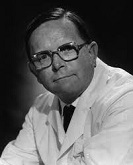
In Nov. 1962 Sir John Charnley (1922-82) of Britain perfects Hip Replacement Surgery, AKA Low Frictional Torque Arthroplasty (LFA), using high molecular weight polytethylene (HMWP), which is more durable than Teflon (polytetrafluorethylene); in 1969 the first hip replacement surgery in the U.S. is performed at the Mayo Clinic.

In 1962 Neil Bartlett (1932-) of the U. of British Columbia in Canada ends the belief that all noble gases are nonreacting by combining xenon with fluorine and platinum to create xenon-platinum hexafluoride.

In 1962 the 1-shot Enders Vaccine for measles is perfected by 1954 Nobel Med. Prize winner John Franklin Enders (1897-), causing U.S. measles cases to drop from 400K this year to 22,231 in 1968.

In 1962 Cincinnati, Ohio-born Thomas Samuel Kuhn (1922-96) pub. the bestseller The Structure of Scientific Revolutions, which introduces the term "paradigm shift".

In 1962 Mich. college physics teacher Robert Chester Wilson Ettinger (1918-2011) pub. The Prospect of Immortality, which launches the don't-cry-freeze Cryonics Movement, devoted to preserving people's hopes of being cured through cryogenic freezing until science advances enough to cure them, given that they can be successfully unfrozen; the first volunteer (man) is cryopreserved in liquid nitrogen in 1967.


In 1962 Am. physicist Richard Phillips Feynman (1918-88) discovers a theory of Quantum Gravity, which is independently discovered by Steven Weinberg and Bryce DeWitt; too bad, they can't get rid of derivatives higher than second order, requiring the equations to have an infinite number of terms, causing them to reject it; in 2005 Am. physicist Frank J. Tipler (1947-) claims that if the Big Bang and Omega Point are incl., it becomes correct. In 1968 Feynman develops a theory for quarks based on (dolly?) Partons, hypothetical hard particles inside the nucleus, winning a share of the 1965 Nobel Physics Prize - so that's what's inside? "The scientist has a lot of experience with ignorance and doubt and uncertainty, and this experience is of very great importance, I think. When a scientist doesn't know the answer to a problem, he is ignorant. When he has a hunch as to what the result is, he is uncertain. And when he is pretty darned sure of what the result is going to be, he is in some doubt. We have found it of paramount importance that in order to progress we must recognize the ignorance and leave room for doubt. Scientific knowledge is a body of statements of varying degrees of certainty - some most unsure, some nearly sure, none absolutely certain."

In 1962 Italian-born Am. astronomer Riccardo Giacconi (1931-) discovers X-rays in astronomical sources using an instrumented rocket, winning him the 2002 Nobel Physics Prize.

In 1962 English biologist Sir John Bertrand Gurdon (1932-) of Oxford U. claims to have created cloned frogs from adult cells, sparking a public debate on cloning.

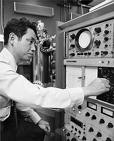

In 1962 22-y.-o. British physicist Brian David Josephson (1940-) discovers the Josephson Effect, the quantum mechanical tunneling of paired electrons (Cooper Pairs) through a thin barrier between semiconductors, after which Japanese-born physicist Leo (Reona) Esaki (1925-) of Sony Corp. and Norwegian-born Am. physicist Ivar Giaever (1929-) of Gen. Electric use the effect to increase transistor switching speeds by 10x-100x, winning them the 1973 Nobel Physics Prize.



In 1962 Jewish-Am. physicists Leon Max Lederman (1922-), Melvin Schwartz (1932-2006), and Jack Steinberger (1921-) discover the Muon Neutrino using the 30 GEV proton accelerator at Brookhaven, N.Y., winning them the 1988 Nobel Physics Prize.
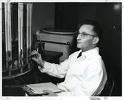
In 1962 Am. molecular biologist Sol Spiegelman (1914-83) develops the technique of Nucleic Acid Hybridization, allowing the detection of specific DNA and RNA molecules in cells. In 1966 he helps discover an enzyme that allows RNA molecules to duplicate themselves - Pandora's Box is opened?



On Apr. 13, 1962 Am. chemist Richard Williams (1928-) discovers the principle behind Liquid Crystal Displays (LCDs), causing Am. engineer George Harry Heilmeier (1936-) of RCA Labs to create the first LCD in 1964.
In July 1962 during the Star Fish Prime above-ground nuclear test at 680 ft. alt., 300 streetlights are disabled 898 mi. away in Hawaii, setting off numerous burglar alarms and damaging a telephone co. microwave link, causing the U.S. govt. to discover the gamma ray Electromagnetic Pulse (EMP), caused by a nuclear blast.
In 1962 Willard S. Boyle (1924-) and Donald F. Nelson of Bell Labs invent the first Continuously Operating Ruby Laser - how did you get the nickname Hot Pants?


In 1962 UCB political science prof. Joseph Pratt Harris (1896-1985) and UCB mechanical engineering prof. William "Bill" Rouverol (1918-) invent the Votomatic automated vote-counting system using punched card ballots, which is used in Calif. and Ore., and spreads to 20% of all U.S. election districts; too bad, a non-recommended butterfly ballot is used in the 2000 U.S. Pres. Election, causing the infamous "hanging chad" problem that disenfranchizes 19K voters and gives George H.W. Bush's son George W. Bush the presidency.
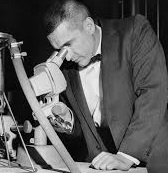
In 1962 the first visible-spectrum Light-Emitting Diodes (LEDs) are developed by Nick Holonyak Jr. (1928-) of Gen. Electric.
In 1962 Yukio Horie et al. of Tokyo Stationery Co. of Japan introduce the Pentel, the first acrylic-tipped (fiber-tipped) felt pen, employing capillary action.
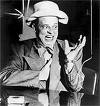
In 1962 Earl William "Madman" Muntz (1914-87) of the U.S. invents the Muntz Stereo Pack, a 4-track tape cartridge player, launching the car stereo market.
In 1962 the RS-232 (Recommended Standard 32) for serial data exchange between electromechanical typewriters and modems is introduced; in 1969 RS-232C for computers and peripherals (modems, etc.) is introduced.

In 1962 sci-fi writer Arthur C. Clarke (1917-2008) pub. Profiles of the Future, containing the essay "Hazards of Prophecy", in which he proposes Clarke's Laws of Sci-Fi: 1. When a scientist says that something is possible, he is probably right, but when he says it's impossible, he's probably wrong. 2. The only way of discovering the limits of the posible is to venture into the impossible. In 1973 he adds 3. Any sufficiently advanced technology is indistinguishable from magic, adding "As three laws were good enough for Newton, I have modestly decided to stop there."


In May 1963 white British-born high-IQ Am. Nobel Physics Prize winner William Bradford "Bill" Shockley (1910-89) gives a Shocking Speech on Race vs. IQ at Gustavus Adolphus College in Minn. suggesting that the people least competent to survive in the world are reproducing the fastest; a year later he claims in an interview with U.S. News and World Report that U.S. blacks as a group score 15 points lower on IQ tests than U.S. whites, and suggests that the cause is hereditary intellectual inferiority, stirring up a firestorm of controversy - and that therefore black genes are like a computer virus and if you want a better Internet, belong to White America Online with all the Bells and Whistles and Virus Protection, or is there an inverse relationship between IQ and penis size, and evolution is somehow stepping on its own dick? In 1966 English psychologist Sir Cyril Burt (1883-1971) pub. his research on 53 pairs of monozygotic twins, indicating that IQ levels are determined mainly by inheritance; too bad, he burns his records before he dies, allowing his critics (who are rocked to their socks by the implications, esp. with loose cannon William Shockley on deck) to claim that he falsified his data, while not wanting any more research done of course, until other studies reproduce his results, after which they only become more entrenched?

1963 - A year in which science really digs the letter Q, and mathematics discovers its own queer stuff? In Nov. 1963 the search for the Omega Minus particle begins at Brookhaven's 80-in. bubble chamber, using Kappa Minus particles, finally finding the first one on Jan. 27, 1964 after taking 300K photos (95,089th expansion), showing it decaying into a negatively charged pi particle and make a downward turn (also an invisible neutral xi particle); the search now turns for the elusive fundamental building block particle, the quark, "the greatest adventure of our time" (Murray Gell-Mann); Russian-born Am. physicist George Zweig (1937-) contributes to the concept.
On Apr. 18, 1963 Am. surgeon James Campbell performs the first human nerve transplant.
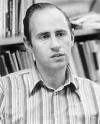
In 1963 Am. mathematician Paul Joseph Cohen (1934-2007) answers the first of the 23 famous problems of David Hilbert of 1900, proving that the negation of the 1870s Cantor's 1878 Continuum Hypothesis is consistent with classical (Zermelo-Fraenkel) set theory, proving the independence of the Axiom of Choice and the Continuum Hypothesis from Zermelo-Fraenkel Set Theory using his new technique of Forcing, winning him the Fields Medal in 1966, becoming the first awarded for mathematical logic (until ?); Kurt Godel already proved in 1938 that the hypothesis itself is consistent with classical set theory; thus, there are two types of mathematics possible, one that claims the hypothesis is true and another that says it is false, freaking out philosophers with the revelation that math can neither prove nor disprove well-known concrete mathematical assertions - hey sugarfoot, how do you like your new home?
In 1963 Am. physician Vincent J. Freda (1928-2003) et al. of Columbia U. discover that the Rhogam Vaccine stops an Rh-negative woman's body from attacking her fetus' blood cells when the father is Rh-positive.
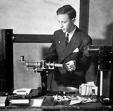
In 1963 Jewish-Am. physicist Roy Jay Glauber (1925-) creates a theoretical model for photodetection, winning him the 2005 Nobel Physics Prize.

In 1963 New York City-born social psychologist Stanley Milgram (1933-84) pub. an article about the Milgram Experiment, showing people obeying authority figures even when ordered to punish the innocent; the Lost Letter Experiment finds that letters addressed to "Friends of the Communist Party" etc. will be reposted far less than letters addressed to "Medical Research Associates" etc.


On Nov. 18, 1963 after research by South African-born John Elias Karlin (1918-2013) of Bell Labs determines the correct shape, size, and placement of buttons and numbers (1-2-3 on the top instead of on the bottom like in calculators, along with all-number dialing), Touch-Tone Telephone Service is introduced in the U.S. in Carnegie and Greensburg, Penn. with the Western 1500 Touch-Tone phone.
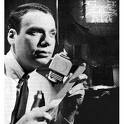
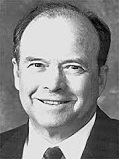
In 1963 Steven R. Hofstein of RCA pub. the basic idea of the Metal Oxide Field-Effect Transistor (MOSFET), constructed on a silicon planar process platform; in 1965 Am. applied physicist Robert W. Bower (1936-) of Hughes Research Labs adds a self-aligned gate; in 1965 Hofstein patents the first Liquid Crystal Display (LCD) electronic watch.



In 1963 U. of Mich. engineers Emmett Leith (1927-2005), Juris Upatnieks (1936-), and Pieter van Heerden of Polaroid Labs invent Lensless Holography using the newfangled laser as a coherent light source, based on 1947 theoretical work of Hungarian-born British physicist Dennis Gabor (1900-79), who wins the 1971 Nobel Physics Prize for it.

In 1963 Am. opthalmologist Charles D. Kelman (1930-) develops Ultrasonic Phacoemulsification to liquify cataracts with an ultrasonic probe and then suction them out without having to remove the lens, reducing a 10-day hospital stay to an outpatient procedure; in the 1970s he develops artificial lenses.


In 1963 the cyanide-containing anti-cancer drug Laetrile, derived from amygdalin in apricot pits, first isolated in 1830 by Pierre-Jean Robiquet (1780-1840), and promoted as "Vitamin B-17" by San Francisco physician Ernst T. Krebs Sr. (1877-1970) and his son Ernst T. Krebs Jr. (1912-96) is banned, making it more popular?; in 1972 Memorial Sloan-Kettering Cancer Center puts cancer researcher Kanematsu Sugiura (1890-1979) onto the task of proving it doesn't work, but his results indicate that it might, causing the hospital to stage a coverup, which leaks in 1973, pumping up Laetrile advocates.

In 1963 Am. geneticist Joshua Lederberg (1925-2008) (1958 Nobel Med. Prize) coins the term "euphenics" for a movement seeking to improve the human species through prenatal chemical manipulation of genes - Joshua fit the Battle of Playing God?

In 1963 after his 12-variable computer weather model gives grossly different weather patterns depending on minute variations in the initial values of the variables, Am. mathematician Edward Norton "Ed" Lorenz (1917-2008) pub. the paper Deterministic Nonperiodic Flow, in which he describes the Lorenz Attractor, and coins the term Butterfly Effect, issuing the soundbyte: "One meteorologist remarked that if the theory were correct, one flap of a seagull's wings could change the course of weather forever", with Ray Bradbury's butterfly (from a 1952 short story) later substituted, becoming the beginning of Chaos Theory, the behavior of dynamical systems that are highly sensitive to initial conditions; unsung heroines Ellen Fetter and Margaret Hamilton program the big clunky Royal McBee LGP-30 computer for him at MIT. In 1987 James Gleick pub. Chaos: Making a New Science, which introduces the Chaos Theory of Edward Norton Lorenz to the public.

In 1963 Am. biologist Alexander Rich (1924-) discovers Polysomes, clusters of ribosomes that read a single strand of mRNA simultaneously.

In 1963 Dutch-born Am. astronomer Maarten Schmidt (1929-) discovers the first Quasar (Quasi-Stellar Radio Source) (3C 273) using the Mount Palomar Telescope in Calif.; it is 1B l.y. from Earth, has a large red shift indicating that it is receding at a high speed (30K mi. per sec.), and is 200x as bright as the entire Milky Way Galaxy; by the mid-1970s 2K quasars are found - Galileo Galileo Galileo Figaro?

In 1963 Hyron Spinrad (1934-) of UCB confirms the absence of liquid water on Mars.


In 1963 Am. physicians Thomas Earl Starzl (1926-) and Francis Daniels Moore (1913-2001) perform the first Liver Transplant in Denver, Colo.

In 1963 Croatian-born Jewish-Am. chemist Leo Henryk "Xanman" Sternbach (1908-2005) of Roche Labs in N.J. develops the anti-anxiety drug Valium (Diazepam), the first "blockbuster drug", which in 1969-82 becomes the most prescribed drug in the U.S. (2.3B in 1978); although he makes zillions for Roche, he never becomes wealthy.

In 1963 Azerbaijan-born, Iranian-raised electrical engineer Lofti Asker Zadeh (1921-) of UCB pioneers Fuzzy Sets, pub. his first paper on them in 1965, then going on to invent Fuzzy Logic in 1973.
In 1963 Am. engineer George Grover (1915-96) of the Los Alamos Nat. Lab invents the Heat Pipe. On Jan. 11, 1968 GEOS (Geodetic Earth Orbiting Satellite) II (Explorer 36) is launched from Vandenberg AFB, Calif., becoming the first satellite equipped with an integral heat pipe.

In 1963 Nobutoshi Kihara (1926-) of Sony develops the CV-2000, the first video tape recorder for home use, introduced next Aug. for $695 with 0.5 in. wide reel videotape.


On Oct. 7, 1963 after Hannibal, Mo.-born William Powell "Bill" Lear (1902-78), co-inventor in the 1920s of the car radio founds Lear Jet Corp. to produce jets for private and business use, it test-flies the $650K 8-passenger 560 mph Learjet 23, a modified Swiss-built military jet fighter, becoming the first mass-produced business jet. In 1964 he leads a consortium that invents 8-Track Tape players; in 1966 they are offered as factory equipment in Fords (first available in Sept. 1965), followed by GM and Chrysler vehicles in 1967; by 1970 the Muntz 4-track system is kaput.


In 1963 Ermal Cleon "Ernie" Fraze (1913-89) of Dayton, Ohio patents the push-in pull-back Pull Tab opener for aluminum cans, eliminating the need to discard tabs, selling the rights to Alcoa and Piitsburgh Brewing Co., makers of Iron City brand beer; in 1964 Royal Crown Cola Co. introduces it on their R.C. Col and Diet-Rite Cola brands.
In 1963 AVID Airline Products develops and manufactures the first Pneumatic Hollow Tube Headset for use on airlines, starting with TWA.

In 1963 Shell Oil Co. introduces the bright yellow fly-killing Shell No-Pest Strip, containing DDVP (Vapona); too bad, the toxicity combined with carcinogenic potential causes it to be withdrawn from the U.S. market in 1979, but it continues to be marketed in Mexico (until ?).
In 1963 Dow Chemical Co. introduces the Ziploc plastic bag to compete with Mobil Oil Corp.'s 1957 Baggie.
In 1963 Friction Welding is invented by TWI Ltd. in Cambridge, England.
In 1963 United Computing is founded in Torrance, Calif. to produce Computer-Aided Manufacturing (CAM) software, eventually releasing UNI-GRAPHICS; in 1976 it is acquired by McDonnell Douglas.
On Apr. 22, 1964 Pres. Johnson opens the 1964-1965 New York World's Fair in Queens (ends Oct. 17, then reopens from Apr. 21-Oct. 17, 1965), while Congress of Racial Equality (CORE) protesters try to drown him out; being within 10 years of the 1962 Seattle World's Fair, some countries bug out, saving up for Expo 67 in Montreal, and the Bureau of Internat. Expositions refuses to sanction it, further diminishing the power of N.Y. planning czar Robert Moses; it features the futuristic 140-ft.-high 120-ft.-diam. 350 ton Unisphere, and a house made of formica; the Ma Bell pavilion features a picture phone; the IBM pavilion hosts a multimedia show of how a computer works, and coins the term "word processing"; the It's A Small World (After All) exhibit by Disney is a hit, along with an audio-animatronic Abraham Lincoln in the Ill. Pavilion, both moved later to Disneyland; the strawberry and whipped cream "Bel-Gem" Belgian waffle is a hit; sci-fi writer Isaac Asimov (1920-92) pub. an article on the 2014 World's Fair, with the soundbytes: "Robots will neither be common nor very good in 2014, but they will be in existence", "Communications will become sight-sound and you will see as well as hear the person you telephone. The screen can be used not only to see the people you call but also for studying documents and photographs and reading passages from books"; "In 2014, there is every likelihood that the world population will be 6,500,000,000 and the population of the United States will be 350,000,000"; "A larger portion [of the U.S.] than today will be deprived and although they may be better off, materially, than today, they will be further behind when compared with the advanced portions of the world. They will have moved backward, relatively"; "General Electric at the 2014 World's Fair will be showing 3-D movies of its 'Robot of the Future,' neat and streamlined, its cleaning appliances built in and performing all tasks briskly. (There will be a three-hour wait in line to see the film, for some things never change.)"
The Apr. 1964 issue of Aerosol Age reports that the amounts of vinyl chloride in hairspray cans found in salons may be higher than amounts that cause cancer in lab animals; it takes until 1971 for Union Carbine to admit that beauty operators are at greater risk than chemical workers for cancer because of constant exposure.
On June 5, 1964 DSV Alvin, a 3-person deep-ocean research submersible vehicle that can dive to 15K ft. (4.5 km) is commissioned, and used by the Woods Hole Oceanographic Inst. in Mass. for sea floor exploration.
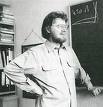
In 1964 Irish physicist John Stewart Bell (1928-90) of CERN (European Particle Physics Lab) in Switzerland pub. his paper On the Einstein Podolsky Rosen Paradox, dealing with "spooky action-at-a-distance", and deriving Bell's Theorem (Inequality), disproving the idea of hidden variables in quantum mechanics (such as a factor that tells a radioactive atom when to decay), and establishing that reality is non-local; "The concept of 'measurement' becomes so fuzzy on reflection that it is quite surprising to have it appearing in physical theory at the most fundamental level... Does not any analysis of measurement require concepts more fundamental than measurement? And should not the fundamental theory be about these more fundamental concepts?"

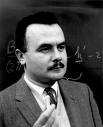
In 1964 Am. nuclear physicists James Watson Cronin (1931-2016) and Val Logsdon Fitch (1923-2015) of Princeton U. show that the decay of K-mesons is not invariant under the CP (charge conjugation and parity) operation, i.e., running the reaction in reverse doesn't retrace the path of the original reaction, winning them the 1980 Nobel Physics Prize.

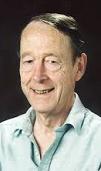


In Aug. 1964 Belgian physicist Francois Englert (1932-) and Am. physicist Robert Brout (1928-2011) of Belgium propose the Higgs Mechanism, which gives mass to vector bosons; in Oct. British physicist Peter Ware Higgs (1929-), Sir Thomas Walter Bannerman "Tom" Kibble (1932-) et al. theorize broken symmetry in electroweak theory, requiring the Higgs Boson (God Particle) (originally called the Goddamn Particle by Leon Lederman until his publishers change it, launching it into the New Age world), a massive scalar particle whose existence would explain the difference between the massless photon (which causes electromagnetism) and the massive W and Z bosons (which cause the weak force); without it, the Standard Model of Particle Physics can't explain how particles have mass; after an exhaustive hunt, evidence of its existence is found in July 2012 by physicists at CERN in Switzerland, who on Mar. 14, 2013 announce confirmation, winning Englert and Higgs the 2013 Nobel Physics Prize.

In 1964 Romanian psychologist-chemist Corneliu E. Giurgea (1923-95) synthesizes the learning-memory enhancing drug Piracetam; in 1972 he coins the term Nootropic for intelligence enhancing or smart drugs.

In 1964 English evolutionary biologist William Donald "Bill" Hamilton (1936-2000) pub. Hamilton's Rule of Genetics (Inclusive Fitness Theory), that a costly action should be performed if its cost in fitness to the actor is less than the genetic relatedness between the actor and the recipient multiplied by the fitness benefit to the recipient; founds the field of Social Evolution.
In 1964 Jerome Horowitz synthesizes the anti-viral drug Zidovudine (ZDV) (AZT) (Retrovir), later used to treat HIV - Curly did it?


In 1964 English astronomer Sir Fred Hoyle (1915-2001) and Indian astronomer Jayant Vishnu Narlikar (1938-) of Cambridge U. pub. the Hoyle-Narlikar Theory of Gravitation, combining Einstein's Theory of Relativity with Mach's Principle and postulating that the inertial mass of a particle is a function of the masses of all other particles multiplied by a coupling constant that is a function of cosmic epoch, giving a gravitational constant decreasing strongly with time and therefore a steady-state Universe - having a backup plan, priceless?


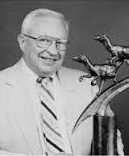
Oh, what a rush! Here come the new tag team champions? In Aug. 1964 speedy 10-ft. 150 lb. stripey early Cretaceous Deinonychus (Gk. "terrible claw"), a pack-hunting dino with a 3-fingered grasping hand and a foot with an inner toe that sticks out like a sharply curved sickle is discovered by Yale U. paleontologist John Harold Ostrom (1928-2005) and his asst. Grant E. Meyer in S Mont.; in his research report, Ostrom describes it as a raptor, killing its prey by leaping and slashing with its claw, suggesting a high metabolism rate and thus warm-blooded system, in 1969 resurrecting Thomas Henry Huxley's theory that birds evolved from dinosaurs; the dino-bird link excites a new generation of researchers to reinvigorate a fossilized, er, moribund field. In 1970 Ostrom discovers a miscatalogued specimen of archaeopteryx among pterosaurs in a museum in Haarlem, Netherlands, prompting him in 1976 to repopularize the 19th cent. hypothesis that carnivorous dinos are direct ancestors of today's birds, which is deflated by a 2009 discovery by researchers at Oregon State U. about how birds breathe; by 2005 only 10 archaeopteryx specimens are found; one specimen sells for $1.3M in 1999; another ends up in the private Wyoming Dinosaur Center in Thermopolis, Wyo. in 2005; in 2009 Gregory M. Erickson of Fla. State U. claims that its slow bone growth makes a feathered dino not capable of flight - it's my favorite movie?

On July 18, 1964 Am. scientist Judith Graham Pool (1919-75) pub. her discovery of Cryoprecipitation, the concentration of blood clotting factors to extend the lives of hemophiliacs.
In 1964 the Omega-minus elementary particle is discovered using the Nimrod Cyclotron.
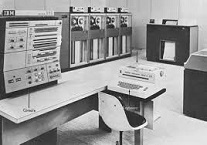
On Apr. 7, 1964 IBM (in time for the New York World's Fair) introduces the 32-bit System/360 a transistorized mainframe computer, which permits upgrade from lower to higher cost models and becomes their bestseller, cementing their monopoly on mainframes; later, when the microcomputer comes along, their "Think" motto gets stuck, and they go down thinking that it will be a fad and that the mainframe will always rule?
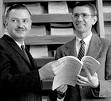
On May 1, 1964 (4:00 a.m.) Dartmouth math. profs. Thomas Eugene Kurtz (1928-) and Hungarian-born John George Kemeny (1926-92) run their first program written in the (in)famous BASIC (Beginner's All-Purpose Symbolic Instruction Code) computer language, which runs with an interpreter, allowing full floating point math, but also implements loops using the interpreter, keeping them way slower than assembly language.

In 1964 Leonard "Len" Cutler (1928-2007) et al. of Hewlett-Packard design the H-P 5060A Cesium Beam Clock, the first atomic clock, increasing the synchronization of U.S. Naval Observatory and Swiss time from 1 millisecond to 1 microsecond, after which it is flown around the world, becoming known as the "flying clock"; in 1991 the HP 5071A Cesium Beam Clock achieves a stability of 1 sec. in 1.6M years; in 1972 and 1976 H-P cesium clocks are used to verify Einstein's Theory of Relativity.
In 1964 Keishi Ogura of Japan Radio develops an improved microwave tube, allowing Amana Refrigeration of Amana, Iowa (a subsidiary of Raytheon) to begin marketing the first Compact Microwave Oven in 1967 for $495.
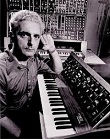
In 1964 Robert Arthur "Bob" Moog (1934-2005) of the U.S. invents the Moog Synthesizer, going on to introduce the Minimoog Model D in 1971.

In 1964 Robert Haig Weitbrecht (1920-) invents the Telephone Typewriter (TTY) (AKA Telecommunications Device for the Deaf) to help deaf people communicate over phone lines.

In 1964 Charles Bernard Willock (1915-2001) invents the Home Dialysis Machine.
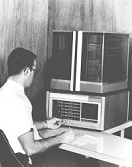
On Mar. 22, 1965 Digital Equipment Corp. (DEC) of the U.S. begins marketing the $18.5K 12-bit PDP-8, a computer that can be rolled around on a cart, the first commercial minicomputer, whose design spurs the creation of the Intel 4004 microcomputer; it sells 50K units by 1979.
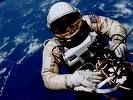


On June 3, 1965 lily-white Tex.-born USAF Lt. Col. Edward Higgins White II (1930-67) becomes the first American to make a spacewalk during the flight of Gemini 4, during which he loses a glove, which stays in orbit at a speed of 28K km per hour for 1 mo., becoming the most dangerous garment in history?; on June 7 Gemini 4 splashes down after completing 62 orbits - the reason Michael Jackson, no?



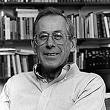
In 1965 German-born Arno Allan Penzias (1933-) and Tex.-born Robert Woodrow Wilson (1936-) of Bell Labs pub. their discovery of the 3 deg. Kelvin Cosmic Microwave Background Radiation (CMBR), supporting the Big Bang Theory, originally proposed in 1927 by Belgian Roman Catholic priest Georges Henri Joseph Edouard Lemaitre (1894-1966), and taking it into primetime after the discovery of blue galaxies is announced on June 12, the blue color taken to mean that they're billions of light years away and therefore in the bloom of youth, winning them the 1978 Nobel Physics Prize; Am. physicist Robert Henry Dicke (1916-97) and Canadian-Am. physicist Phillip James Edwin "Jim" James Peebles (1935-) of Princeton U. independently derive the CMBR, and are in the process of building a radiometer to verify it when Penzias-Wilson scoop them just mi. away, and end up giving them more verification; better microwave detectors later lead know-it-all physicists to attempt to reconstruct the entire scenario in computers - it's complicated, it's complicated? In 1969 E.K. Conklin measures the absolute motion of the Sun through the CMBR as 308 km per sec.


In 1965 Austrian math student Bruno Buchberger (1942-) develops the theory of Grobner (Gröbner) Bases for polynomial rings, named after his adviser Wolfgang Grobner (Gröbner) (1899-1980), which become important for computer algebra and integer programming, and finally provide an example to go with David Hilbert's "theological" 1888 Basis Theorem.
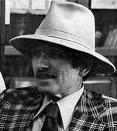
In 1965 British Jewish mathematician Irving John Good (Isadore Jacob Gudak) (1916-2009) pub. the papers "Speculations Concerning the First Ultraintelligent Machine" and "Logic of Man and Machine", in which he proposes a future "intelligence explosion" when smart machines will begin designing even more intelligent machines, eventually leaving the human race behind in the "technological singularity"; he is hired by Stanley Kubrick as a consultant for his 1968 film "2001: A Space Odyssey"; "Let an ultraintelligent machine be defined as a machine that can far surpass all the intellectual activities of any man however clever. Since the design of machines is one of these intellectual activities, an ultraintelligent machine could design even better machines; there would then unquestionably be an 'intelligence explosion,' and the intelligence of man would be left far behind. Thus the first ultraintelligent machine is the last invention that man need ever make" - Adam and Eve already heard that one?


In 1965 philosophy of science opponents Karl Popper (1902-94) and physicist Thomas Samuel Kuhn (1922-96) debate at the London School of Economics, struggling for the soul of Science, with Kuhn defending his "paradigm shift" model of scientific progress, and Popper repudiating the old observation/induction method in favor of empirical falsification and critical rationalism, "the first non-justificational philosophy of criticism in the history of philosophy", which he extends to a defense of liberal democracy and the open society; Kuhn claims that when a result fails to conform to the central paradism, a scientist blames himself not the paradigm, and forgets about Popper's empirical falsification BS, and only after a series of anomalous results builds up to a crisis does a new central paradigm get formulated by revolutionary scientists who risk burning at the stake et al. until it gets accepted - are they arguing about reality or sci-fi novels they've read?
In 1965 the molecular structure of Transfer RNA (tRNA) is determined.



In 1965 Am. mathematicians James William Cooley (1926-) and John Wilder Tukey (1915-2000) discover the cool Cooley-Tukey Fast Fourier Transform (FFT) (Butterfly) Algorithm for computers, radically speeding up the calculation of Fourier Transforms and permitting real-time computer spectral analysis; it was actually discovered in 1805 by German mathematician Carl Friedrich Gauss; the FFT becomes the most important computer algorithm of the 20th cent.
In 1965 Artemisinin is isolated by Chinese army scientists from annual wormwood (Artemisia annua), and found to be effective against malaria, causing it to be used throughout China and Southeast Asia; too bad, they take 10 years to pub. the discovery, and won't cooperate with Western scientists for fear of Capitalist exploitation?


In 1965 Am. engineer James T. Russell (1931-) of Battelle Memorial Inst. in Wash. invents the Compact Disc (CD), a 0.004" thick round piece of acrylic plastic 12 cm in diam. that stores up to 700MB of data as bumps; he patents it in 1970; at first it is only used for audio data, and isn't commercially introduced until Oct. 1982.

In 1965 Portland, Ore.-born engineer Ray Milton Dolby (1933-2013) invents Dolby Noise Reduction (NR), separating sound into two channels to reduce tape noise.
In 1966 the Committee on Data for Science and Technology (CODATA) is established by the Internat. Council of Scientific Unions to determine internationally-accepted values for all fundamental physical constants - oh my God?

In 1966 CIA polygraph expert Buck Blackster, er, Grover Cleveland "Cleve" Backster Jr. (1924-2013) begins experiments on plant consciousness by hooking one up to the leaves of a philodendron and observing that the electrical resistance changes when it is harmed or even threatened with harm; he also claims that human thoughts and emotions can be sensed by plants - macho carrots are bigger liars?
In 1966 Am. microbiologist Tom Brock studies the thermal springs in Yellowstone Nat. Park, discovering Thermus aquaticus, which yields the enzyme Taq polymerase, which later becomes useful for amplifying DNA.

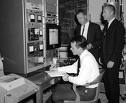

In 1966 Am. geophysicists Allan Verne Cox (1926-87), Richard Doell (1923-2008), and G. Brent Dalrymple (1937-) of Stanford U. determine that the Earth's magnetic field has undergone periodic reversals - it means it doesn't matter where you start, it all comes together, it all falls apart?

In 1966 Am. physician Daniel Carleton Gajdusek (1923-2008) of the U.S. transfers the New Guinea cannibal disease Kuru (AKA laughing sickness and mad human disease) from humans to chimps, becoming the first prion disease to be described, winning him the 1976 Nobel Med. Prize; too bad, in 1996 he is convicted of child molestation - after getting it himself?
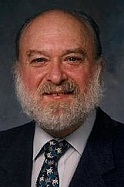

In 1966 New York City-born physicist Leo Philip Kadanoff (1937-2015) develops a block spin technique for magnets, breaking down an Ising grid into fewer blocks repeatedly to rescale or renormalize the material properties, applying the concept to second-order phase transitions, making him a star, after which in 1971 Kenneth Geddes "Ken" Wilson (1936-2013) combines his idea with his teacher Murray Gell-Mann's 1954 idea of combining an electron's infinite theoretical charge with its finite measured charge to create an effective charge that varies with distance to create the concept of < a href="https://en.wikipedia.org/wiki/Renormalization_group">Renormalization Group, which allows systematic investigation of the changes in a physical system as viewed at different6 scales, winning him the 1982 Nobel Physics Prize.
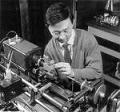
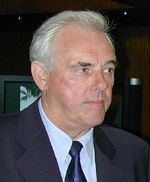
In 1966 Chinese-born engineer-physicist Charles Kuen Kao (1933-) ("Father of Fiber Optics") and British engineer George Alfred Hockham (1938-2013) of Standard Telecommunications Labs in England demonstrate the practicability of Fiber Optics by proving that high losses are caused by impurities in the glass and not by the glass itself, winning Kao a share of the 2009 Nobel Physics Prize.

In 1966 Terje Lomo of Norway first describes Long-Term Potentiation (LTP), the putative cellular mechanism of memory and learning, which he observes in a rabbit hippocampus.




In 1966 Am. biochemists Marshall Warren Nirenberg (1927-2010), Har Gobind Khorana (1922-2011), and Robert William Holley (1922-93) of the U.S. crack the Genetic Code, determining which sequences of three nucleotides correspond to each of the 20 amino acids, and demonstrating the existence of Messenger RNA (mRNA), winning them the 1968 Nobel Med. Prize; meanwhile Am. molecular biologist Sol Spiegelman (1914-83) et al. of the U.S. discover an enzyme that allows RNA molecules to duplicate themselves - Pandora's Box is opened?


In 1966 Paul Douglas Parkman (1932-) and Harry Martin Meyer Jr. (1928-2001) of the Nat. Insts. of Health (NIH) in Auburn, N.Y. develop the first effective inexpensive Rubella (German Measles) Vaccine, causing the U.S. rubella epidemic of 1963-5 to be the last (until ?); in the 1970s it becomes a component of the measles-mumps-rubella (MMR) vaccine given to infants at 15 mo.; too bad, other countries are slow to use it, causing frequent epidemics as late as 1998-9 in Greece.
In 1966 Am. neurologists Fred Plum (1924-2010) and Jerome B. Posner coin the term Locked-In Syndrome (LIS)for a vegetative state with higher order brain functions intact.

In 1966 Michael B. Sporn et al. of Dartmouth College discover that aflatoxins caused by the Aspergillus flavus mold growing on peanuts cause liver damage and cancer.
In 1966 High Lysine Corn is developed in the U.S.; meanwhile refined sugar (sucrose) has 86% of the U.S. sweetener market, and High Fructose Corn Syrup, which is pioneered next year by Clinton Corn Processing Co. of Clinton, Iowa has 0% (0 lbs. per capita), after which it begins its rise to #1, reaching 55% of the market (62.6 lbs. per capita) in 2001.

On Feb. 3, 1966 the U.S. launches Environmental Science Services Admin. (ESSA) I, the first weather satellite capable of viewing the entire Earth, taking the frst whole-Earth geostationary satellite weather image; the satellite is based on the spin-scan concept of Verner E. Suomi (1915-95) of the U. of Wisc., who becomes the Father of Satellite Meteorology; on Dec. 6 the Applications Technology Satellite (ATS) I satellite is launched, containing a spin-scan radiometer.
On Feb. 10, 1966 the 2-mi. Stanford Linear Accelerator Center (SLAC) linear particle accelerator (begun 1962) begins operation; it is officially dedicated next Sept. 9.
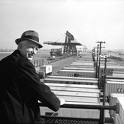
In Apr. 1966 transatlantic container ship service begins with the sailing of the SS Fairland from Port Elizabeth, N.J., reaching Rotterdam four weeks earlier than previous ships, causing a rev. in shipping with rectangular containers that can be hauled by trucks or trains, although it costs a lot of dockworkers their jobs; the containerization concept is from trucking co. magnate Malcom (Malcolm) Purcell McLean (1913-2001), who designed the first container in 1956 but took a decade to get ports built with enough cranes in N.J., Rotterdam, Bremen, and Grangemouth, Scotland; next year they begin service to South Vietnam, which produces 40% of their revenues until 1969, when they are acquired by R.J. Reynolds Co. and expand to Hong Kong and Taiwan, followed by Singapore, Thailand, and the Philippines in 1971, reaching 27K containers with 36 ships and 30 ports; on May 10, 1968 SS Fairland is hit by rockets in the Long Tau River shipping channel 31 mi. from Saigon, sustaining light damage, and again on May 15, but the supply line keeps on truckin'.

In 1966 Robert Dennard (1932-) of IBM invents the 1-transistor Dynamic Random Access Memory (DRAM), which has to be continuously refreshed, and is later called the crude oil of the Info. Age because they are cheaper and use less space than static RAMs; they are first produced commercially in 1970; by 1979 the Japanese have a 42% market share.

In 1966 Swiss-born Richard Robert Ernst (1933-) and Weston A. Anderson of Varian Assocs. in Calif. invent Fourier Transform Nuclear Magnetic Resonance (NMR) Spectroscopy, winning Ernst the 1991 Nobel Chem. Prize.

In 1966 Frederick A. Mosby (1924-) of Gen. Electric invents the Tungsten Halogen Lamp, which uses iodine in a quartz heat lamp to increase life and efficiency over an incandescent lamp.
In 1966 Martin Richards of Cambridge U. designs the Basic Combined (Computer) Programming Language (BCPL), the first curly bracket programming language, which later is used to develop the C programming language.

In 1966 German-born Jewish-Am. computer scientist Joseph Weizenbaum (1923-2008) (Einstein lookalike?) invents the ELIZA computer program (chatterbot) (taken from G.B. Shaw's "Pygmalion"), which mimics an empathic psychologist, and later becomes a popular computer game; too bad, users take the pattern-matched stereotyped responses seriously, setting Weizenbaum off into a philosophical search for the meaning of AI.
In 1966 Hewlett-Packard invents GaAsP LEDs (gallium arsenide phosphide light-emitting diodes), which are used in street and automobile lighting applications.

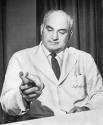
A big year for people with bad hearts? On Dec. 3, 1967 the first successful Human Heart Transplant is performed by Dr. Christiaan Neethling Barnard (1922-2001) in Cape Town, South Africa on Jewish grocer Louis Washkansky (b. 1913), who lives 18 days (until Dec. 21) with a heart from a 25-y.-o. brain-dead accident victim; on Dec. 7 New York City surgeon Adrian Kantrowitz (1918-2008) performs the first U.S. heart transplant, after which 260 more transplants are tried worldwide over the next seven years, with only 20% surviving more than one year, and some for over six years; meanwhile U.S. prosecutors threaten to arrest surgeons taking organs from brain-dead individuals - maybe you'll feel better after having some dirty sex?
In 1967 English zoologist Henry Bennet-Clark discovers that fleas store the energy for a jump in a unique elastic protein called resilin; it takes until 2001 to discover that they jump by pushing off their toes not knees, reaching up to 100g and 1.9m per sec.
In 1967 Am. microbiologist Allan M. Campbell (1929-) discovers that plasmids can carry genetic info. between bacteria, helping them resist antibiotics.

In 1967 Am. psychiatrist Sidney Cohen (1910-87) et al. reports that LSD can produce breaks in chromosomes, creating the possibility of genetic abnormalities in their children.


In 1967 Vincent P. Dole (1913-2006) and his wife Marie Nyswander (-1986) of the U.S. create the Methadone Treatment for heroin addiction; too bad, methadone is just as addictive?


On Nov. 30, 1967 Argentine-born surgeon Rene Geronimo Favaloro (1923-2000) of the U.S. performs the first planned Coronary Artery Bypass Surgery for coronary disease, using a vein from a leg; the first bypass procedure was performed in 1962 by Johns Hopkins U. surgeon David C. Sabiston Jr. (1925-2009) u nder emergency conditions, and in 1964 Michael E. DeBakey and H. Edward Garnett of Tex. performed another emergency bypass.

In 1967 Am. psychologist Michael S. Gazzaniga (1939-) of the U. of Calif. reports that people with severed brain halves can operate each half independently.
In 1967 Am. mathematicians Ernest P. Specker (-2011) and Simon Kochen pub. the Kochen Specker Theorem, which states that in quantum mechanics it's incorrect to assume before measurements are made that the results of an experiment are already determined.
In 1967 the George, er, Dubna Inst. in Russia creates the radioactive element Dubnium (Db) (#105) (longest-lived transactinide isotope - half life 28 hours) by shooting neon atoms at americium; on Apr. 27, 1970 U. of Calif. physicists synthesize it.
In 1967 after his daughter gets mumps in 1963, Am. microbiologist Maurice Ralph Hillerman (1919-2005) of Merck & Co. develops the Jeryl Lynn Mumps Vaccine.
In 1967 Marburg Virus (a near relative of Ebola) infects 31 lab workers in West Germany and Yugoslavia, and seven die; the source proves to be African green monkeys.
In 1967 Mammography is introduced for detecting breast cancer.
In 1967 Clomiphene (Clomifene) is introduced to increase fertility, also resulting in an increase in multiple births; Ahnuld, er, steroid-taking athletes soon begin using it at the end of their steroid cycle to reduce the effects of estrogen in causing breast growth (gynecomastia) and to restore the natural production of testosterone.
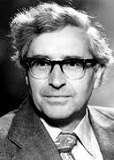
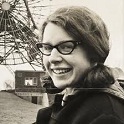
On Nov. 28, 1967 the first Pulsar (pulsating radio star), CP 1919 in Velpecula is discovered with a radio telescope by Jewish British radio astronomer Anthony Hewish (1924-) and his astrophysics student Susan Jocelyn Bell Burnell (1943-) at Cambridge Observatory; thinking it might be a signal from extraterrestrials, it is named LGM-1 (little green men), and the results are not pub. until Feb. 1968; too bad, although she actually discovers it first, and is named second in the scientific paper in Nature, he gets the 1974 Nobel Physics Prize and she gets diddly, causing pissed-off astronomer Fred Hoyle to complain in vain - the snow may fall but I don't mind at all because you keep me winter-warm?

In 1967 Japanese pediatrician Tomisaku Kawasaki (1925-) first describes Kawasaki Disease, which strikes infants between 18-24 mo., and becomes the #1 cause of acquired heart disease in U.S. children, passing up rheumatic fever.
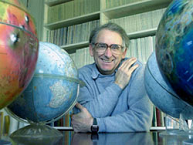
In 1967 English geophysicist Dan Peter McKenzie (1942-) and R.L. "Bob" Parker pub. a paper proposing the concept of Plate Tectonics, making it mathematically precise using Euler's Rotation (Fixed Point) Theorem, later breaing the Earth's lithosphere into seven plates: Africa, North Am., South Am., Eurasian, Australian, Antarctic, and Pacific.

In June 1967 Austrian-born Australian biologist Sir Gustav Victor Joseph Nossal (1931-) proposes that antibodies work by detecting the size and shape of their target molecule in order to attach themselves to an antigen.

In 1967 Am. psychologist Martin E.P. Seligman (1942-) of Cornell U. finds that dogs unable to escape electric shocks "learned helplessness", extending this to humans and developing Positive Psychology to emphasize mental wellness rather than mental illness.

In 1967 Am. geneticist George Davis Snell (1903-96) discovers that tissue compatibility is determined by specific genes, introducing the concept of H antigens and the HLA major histocompatibility complex in humans, winning the 1980 Nobel Med. Prize.

In 1967 Am. relativity physicist John Archibald Wheeler (1911-2008) of Princeton U. coins the term "black hole" at a conference in New York City, where "space can be crumpled like a piece of paper into an infinitesimal dot... time can be extinguished like a blown-out flame, and ... the laws of physics that we regard as sacred, as immutable, are anything but"; he later calls them "gates of time", and eventually begins to think that the law of physics themselves evolve, since spacetime just happened and do you feel better now that she's gone into the ground? - he heard somebody say "black honky" on TV and put two and two together? In 1978 he pub. a paper pointing out the concept of Delayed Choice in the classic double-slit experiment, showing how the experimenter participates in creating the past, leading to the effort to reduce physics to information theory, "genesis by observership", "the participatory universe", "it from bit"; "The model of the universe [a giant U with an eyeball on top of one stem looking back at the other, with the skinny unadorned bend being the Big Bang] starts out all skinny and then gets bigger. Finally it gives rise to life and the mind and the power to observe, and by the act of observation of those first days, we give reality to those first days"; "No space, no time, no gravity, no electromagnetism, no particles. Nothing. We are back where Plato, Aristotle and Parmenides struggled with the great questions: How Come the Universe, How Come Us, How Come Anything? But happily also we have around the answer to these questions. That's us." (Jan. 29, 1993)
In 1967 Project Gasbuggy of the U.S. AEC's Project Plowshare attempts to stimulate production of natural gas by exploding a nuke underground near Farmington, N.M.; after it fails, they try again in 1969, and fail again - ask the Mexicans jokes here?
In 1967 the U.S. Vela Hotel satellites (orbiting to detect nuclear tests on Earth since 1963) discover cosmic gamma ray bursts deep in space; Los Alamos Nat. Lab scientists don't report it until 1973.
In 1967 Viroids, the smallest known agents of plant disease are first discovered in the potato (potato spindle tuber viroid).
In 1967 Enzyme DNA ligase, essential in recombinant DNA technology is isolated.
In 1967 Acesulfame K (Ace K) (E950) heat-stable zero-calorie sugar substitute (200x sweeter than sucrose, 66% as sweet as saccharin) is accidentally discovered by German chemist Karl Clauss and Harald Jensen of Hoechst AG; after Kraft patents the use of sodium ferulate to mask the aftertaste, it is marketed under the trade names Sweet One and Sunett, being used in Werther's sugar free caramel candies et al.
In 1967 dentists develop bonding using composite resins as an alternative to metal alloy tooth fillings.

In 1967 the U.S. A-12 (Archangel-12) spy plane, the first Stealth Aircraft is put into service as the successor to the U-2; it can fly at 2K mph and take photos at 90K ft. alt. that can resolve 1 ft. objects on the ground; too bad, it is decommissioned next year.

In 1967 Portland, Ore.-born Douglas Carl Engelbart (1925-2013) of the Stanford Research Inst. in Menlo Park, Calif. patents the Computer Mouse, a brick-shaped wood block with two perpendicular wheels underneath and a button on top; in 1966 NASA tests it and finds it to be better than other approaches to user input; on Dec. 9, 1968 it is first publicly demonstrated at a computer conference in San Francisco as part of his hypertexting system NLS (On-Line System), pioneering online education.

In 1967 Norwegian-Am. computer designer Gene Amdahl (1922-) pioneers Parallel Computer Processing.
In 1967 Bosch begins marketing its D-Jetronic system on the VW 1600 TL, becoming the first mass-produced Electronic fuel Injection System; it goes on to put advanced models on the Volvo, Cadillac Seville, and Porsche in the 1970s, and in 1982 introduces the LH-Jetronic system that directly measures air mass flow into the engine using a heated platinum wire. Motorola introduces an all-transistor color TV set.

In 1967 Johns Hopkins U. gynecologist Hugh J. Davis (1927-) invents the round bug with one large eye and legs on each side Dalkon Shield intrauterine device (IUD), selling the rights on June 12, 1970 to A.H. Robins Inc. (founded 1896) (who acquired Chap-Stick in 1963), who begin marketing it in Jan. 1971, selling 4M-5M by the time they withdraw it in June 1974 under FDA pressure, its tendency to "wick" causing pelvic inflammatory disease (PID) along with an outbreak of miscarriages, birth defects, and maternal deaths, leading to numerous lawsuits and millions of dollars in damage awards, bankrupting Robins, who sell out to Am. Home Products Corp. in 1989, the bad publicity killing copper IUDs also, although they were never proved dangerous; actually it was only the large size version of the Dalkon Shield for women who had given birth that had problems, and if the shark lawyers hadn't gone for the green, it coulda survived? - don't mess with Mother Nature jokes here?
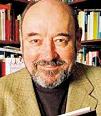
In 1967 English zoologist Desmond Morris (1928-) pub. The Naked Ape, which claims that the female orgasm evolved to increase pair-bonding, and that human women have big bazooms to look like an ass to the male during the missionary position.

In 1967 Japanese chemist Hideki Shirakawa (1936-) invents Polyacetylene Film, which has metallic properties incl. electrical conductivity and shiny surfaces, winning him the 2000 Nobel Chem. Prize.
In 1967 the first Handheld Calculator is invented by Texas Instruments.
In Dec. 1967 the first Electronic Quartz Wristwatch (retail price $550) is introduced by the Swiss Horological Electronic Center, a combo of 31 Swiss firms that spent $7M to develop it; too bad, they can't mass-produce it, and Seiko beats them to it in 1969 with their $1,250 model.
1968 - The Pulsar Year in Physics? The science community is now international and shows its grate powah? In 1968 using the new Cooley-Tukey FFT Algorithm, Richard V.E. Lovelace et al. of Cornell U. use the Arecibo Radio Telescope to find a pulsar with a period of 0.033 sec. in the center of the Crab Nebula in Taurus, the site of the famous supernova of July 4, 1054; meanwhile Bernard Yarnton Mills (1920-) et al. of the U. of Sydney in Australia identify the 11 Hz Vela Pulsar (PSR 0833-45), and Austrian-born Thomas Gold (1920-2004) of Cornell U. and Franco Pacini (1939-) of Italy explain pulsars as rapidly rotating neutron stars that produce beams of synchrotron radiation which become rapid on-off signals by the time they intersect the Earth; late in the year David H. Staelin et al. use the Green Bank Radio Telescope in W.V. to discover the Crab Pulsar, becoming the first to identify a visible star associated with a pulsar, which previously were known from radio signals only, thus connecting pulsars with neutron stars and supernovas.

In 1968 Werner Arber (1929-) of Switzerland discovers that bacteria defend themselves against viruses by producing restriction enzymes that randomly cut the virus DNA.


In 1968 George W. Clark, William L. Kraushaar (1920-2008), and Gordon P. Garmire (1937-) report the discovery, using NASA's Third Orbiting Solar Observatory (OSO-3) (launched Mar. 8, 1967) of a gamma-ray background coming from the Milky Way Galaxy, concentrated in its center.


In 1968 Walter Gilbert (1932-) and Mark Ptashne (1940-) of the U.S. independently identify the first Repressor Proteins for genes, which prevent them from operating.


In 1968 French-born Roger Charles Louis Guillemin (1924-) and Lithuanian-born Andrew Victor Schally (1926-) of the U.S. discover Corticotropin Releasing Factor (CRF), a simple peptide produced by the hypothalamus which signals the pituitary gland to produce the hormone cortisol, winning them the 1977 Nobel Med. Prize.
In 1968 Am. human ecologist Garrett James Hardin (1915-2003) pub. the article The Tragedy of the Commons, discussing the dilemma where people acting independently in their own self-interest can ultimately destroy a shared resource against their long-term self-interest.


In 1968 David Hunter Hubel (1926-) of Canada and Torsten Nils Wiesel (1924-) of Sweden use cat brains to discover that specific visual receptor cells respond to specific stimuli, stationary light sources for some and motion for others, winning them the 1981 Nobel Med. Prize.
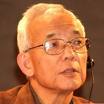

In 1968 Syukuro "Suki" Manabe (1931-) and Richard "Dick" Wetherald of Princeton U. warm, er, warn of the Greenhouse Effect caused by burning of fossil fuels, which can raise global temps by increasing the alt. at which the Earth radiates heat to space; in 1969 they demonstrate the role of oceanic transport.

In 1968 French mathematician Rene Frederic (René Frédéric) Thom (1923-2002) pub. the first paper describing Catastrophe Theory - good timing considering the Paris riots?
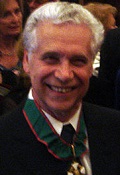
In 1968 Italian physicist Gabriele Veneziano (1942-) of CERN discovers that the physics of the strong nuclear force can be modeled by Euler's Gamma Function, which he finds in a book on the history of mathematics by chance, becoming the beginnings of Superstring Theory.



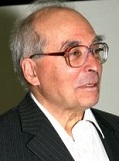
In 1968 Steven Weinberg (1933-) and Sheldon Lee Glashow (1932-) of the U.S., and Mohammad Abdus Salam (1926-96) of Pakistan reduce the number of basic interactions in Nature from four to three by theorizing that the weak and electrical forces are really the identical electroweak force, the apparent differences being due to the "present low temperature of the Universe", and create the Gauge Principle, which states that a correct theory of Nature must be the same regardless of arbitrary definitions, e.g., a theory of gravity must give the same numerical value of energy expended in climbing a cliff regardless of path, winning them the 1979 Nobel Physics Prize; meanwhile Russian physicist Vladimir Mikhailovich Lobashev (1934-2011) shows that the strong nuclear force also violates parity conservation - it's always better when I'm with you?

In 1968 Carl Richard Woese (1928-) pub. the The Genetic Code, first proposing the "RNA World Hypothesis", that life began with RNA and evolved into DNA; coined in 1986 by Walter Gilbert (1932-).
In 1968 David Zipser discovers the unique (out of 64) Stop Codon, made up of UGA (uracil, guanine, adenine), which serves as the termination signal Say Goodnight Gracie ("stop making this protein").
On Apr. 23, 1968 Martin A. Goetz of Applied Data Research receives the first U.S. software patent (#3380029), causing a flood of applications, even though the very idea of patenting software infringes on the age-old tradition that mathematical algorithms are public domain; the U.S. Supreme Court decides the issue in ?.
In 1968 Stephen A. Benton (1941-2003) of the U.S. invents the white light Rainbow Hologram, which can be embossed on a credit card and shows a 3-D image in ordinary light.

In 1968 the Bose 901 Speaker, developed by Am. MIT prof. (of Bengali Indian descent) Amar Gopal Bose (1929-) pioneers the use of "reflected sound" from walls and ceiling in an effort to bring concert-hall quality to home speaker systems; in 2011 he donates most of his co. stock to MIT.
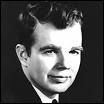
In 1968 Allen K. Breed (1927-99) patents the "sensor and safety system", the first electromechanical Airbag.

In 1968 Polish-born Jewish French physicist Georges Charpak (1924-2010) invents the Multiwire Proportional Chamber, a particle detector that allows the determination of high precision particle tracks in 3-D.
In 1968 a method for producing diamond from methane, later called Chemical Vapor Deposition is patented in the U.S.; too bad the diamond is mixed with graphite, making it of limited use.
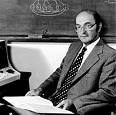


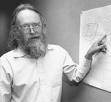


In 1968 English (Welsh) mathematician Donald Watts Davies (1924-2000), Polish-born Am. engineer Paul Baran (1926-), and Am. computer scientist Leonard "Len" Kleinrock (1934-) invent Packet Switching, helping to make computer communication possible, which is later adopted by the Arpanet and the Internet. On Sept. 2, 1969 the first two computer installations of the Arpanet (Advanced Research Projects Agency Network) are connected at the lab of Prof. Leonard "Len" Kleinrock (1934-) at UCLA by Bolt, Beranek & Newman (BBN Corp.) of Cambridge Mass; UCLA grad student Jonathan Bruce "Jon" Postel (1943-98) et al. work to link three univs. and develop internat. links with a new network router comm switch; on Oct. 29 (10:30 p.m.) the first message is sent by Charley Kline; by Nov. four nodes are operational; Postel goes on to become the "Boswell of the Internet". In Oct. 1971 the 29-node Arpanet (Advanced Research Projects Agency Network) is demonstrated publicly at the Hilton Hotel in Washington, D.C. by Robert Elliot "Bob" Kahn (1938-) and Raymond Samuel "Sam" Tomlinson (1941-) of Bolt Beranek & Newman, featuring the first e-mail, using the @ sign to separate the addressee from the computer host, triggered by the shift-2 combo on the Model 33 Teletype keyboard; by 1975 there are 100 nodes worldwide.
In 1968 Carl Engleman (1938-83), William A. Martin (1938-81), and Joel Moses (1941-) of MIT develop Macsyma-1, the first computer algebra system, performing 600+ types of mathematical operations, hosted on a PDP-6; it is put on the Arpanet, continuing development until 1982; it was originally (1964) called Mitre, then MATHLAB 68.


In 1968 Am. computer scientist Edward Albert Feigenbaum (1936-) and Am. molecular biologist Joshua Lederberg (1925-2008) of Stanford U. develop DENDRAL, an expert heuristic software AI system for the identification of chemical substances based on the results of spectrometric analysis.

In June 1968 the $700 Jacuzzi Whirlpool Roman Bath is introduced at the Orange County Fair in Calif. by the seven Italian-Am. Jacuzzi Brothers, starting a fad and a sexually loose lifestyle put together.
In 1968 San Francisco State U. student Charles Prior Hall invents the Waterbed, initially filling a vinyl bag with 300 lb. of liquid corn starch and calling it the "Incredible Creeping Chair", then trying Jell-O before settling on plain water; too bad, because waterbeds are described in sci-fi novels incl. "Stranger in a Strange Land" (1961-), the U.S. Patent Office rejects his patent, even though he's got the first working prototype?

In 1968 Paris newspaper cartoonist Franklin Loufrani (1943-) celebrates the end of the May student riots by creating the Smiley Face, a bright yellow circle with stretched polka-dot eyes and a wide smile, which he trademarks in France in Oct. 1971, followed by over 80 countries, although U.S. companies ignore his claims and U.S. Forrest Gump courts tell him to stuff it, allowing Murray and Bernard Spain of Philadelphia, Penn. to begin punching them out in Sept. 1970, selling 50M by 1972; the real inventor is Am. ad exec Harvey Richard Ball (1922-2001), who created it in 1963 for State Mutual Life Assurance Co. of Am. in Mass., and sold it to them for $45, never applying for copyright or trademark protection.

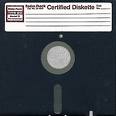
In 1968 the Computer Floppy Disk is developed by Alan F. Shugart (1930-2006) et al. of IBM; it is 8 in. wide and holds 322 kilobytes; the first units ship in Sept. 1976; in 1979 Shugart founds Seagate Technology; by 1980 the floppy is down to 5.25 in. and 720 kilobytes, and finally maxes out at 3.5 in. and 1.44 megabytes - what real man would want to be known as the inventor of the floppy anything?

In 1968 Spencer Ferguson Silver (1941-) of 3M develops a "low-tack" reusable pressure-sensitive adhesive, which is later used in invents canary yellow Post-it Notes, invented in 1974 by Am. chemical engineer Arthur "Art" Fry (1941-) of 3M using reusable pressure-sensitive adhesive as a way to anchor his bookmark in his hymnbook; a marketing attempt under the name Press 'N Peel in 1977 flops, but on Apr. 6, 1980 after free samples are given to residents of Boise, Idaho, they are reintroduced and become a hit, sold in 27 sizes, 18 colors, and 56 shapes.




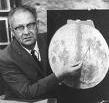

Glory Days, Glory Days, Glory Days pass you by? Just in time to make JFK's prediction come true, white IS right on the Moon on the anniv. of the creation of Washington D.C., the execution of Tsar Nicholas II, the installation of the first parking meters, and the first A-bomb explosion? On July 16, 1969 (Wed.) Apollo 11 blasts off from Cape You Know What, and goes into lunar orbit on July 19, then lands on the "place of magnificent desolation" (the Moon) on July 20 at 4:17 p.m. EDT in the Eagle landing module; as 600M worldwide watch on TV (Soviet TV snubs them), white, blonde-blue, straight Christian church-going Wapakoneta, Ohio-born WASP male Neil Alden Armstrong (1930-2012) (shoe size 9-1/2) (salary $30K a year) becomes the first human to set foot on the Moon at 10:56 p.m. EDT at Tranquility Base (total price tag $35B) after taking a recording of Antonin Dvorak's Symphony No. 9 in E minor, op. 95, B. 178 ("From the New World") with him; his first words are: "One small step for [a] man, one giant leap for mankind"; he rubs white-is-right in more by carrying a piece of fabric from the 1903 White, er, Wright brothers plane Flyer 1; Glen Ridge, N.J.-born U.S. Air Force Col. Edwin Eugene "Buzz" Aldrin Jr. (1930-) follows close behind, later uttering the soundbyte "Neil Armstrong was the first man to walk on the Moon, I am the first man to piss his pants on the Moon"; Presbyterian Aldrin performs a communion before Armstrong starts his walk, but due to a lawsuit by atheist Madalyn Murray O'Hair they black it out; meanwhile Rome, Italy-born U.S. Air Force Lt. Col. Michael "Mike" Collins (1930-) stays in orbit at 60-75 mi. in the Columbia Command Module (named after the cannon-fired Columbiad spacecraft in the 1865 Jules Verne novel "From the Earth to the Moon"), with the Mission Control Center in Houston, Tex. uttering the immortal soundbyte: "Not since Adam as any human known such solitude as Mike Collins during this 47 minutes of each lunar revolution when he's behind the Moon with no one to talk to except his tape recorder"; after the onboard computer fails from interference caused by the radar system as they are making their landing, Armstrong and Aldrin switch to manual control and display their hotdogging cowboy skills, landing with less than 1 min. of fuel left; the first moon walk confirms the prediction made in 1964 by Dutch-born U. of Ariz. astronomer Gerard Peter Kuiper (1905-73) (who helped identify lunar landing sites) that it would be "like crunchy snow"; Aldrin brings a copy of the 1941 poem A Prayer for Protection by Am. poet James Dillet Freeman (1912-2003), causing to be called the "Poet Laureate to the Moon"; after Aldrin plants a nylon flag on El Moono, and they have their romp, they return to Earth and splashdown on July 24 in the Pacific, and are brought aboard the USS Hornet (CV-12), then greeted personally by Pres. Nixon while on a round-the-world tour (July 23-Aug. 3) to try to get back some of the billions wasted, er, invested in a second industrial rev., er, wasted with some good Cold War propaganda; they then spend 65 hours inside the Mobile Quarantine Facility to prove they didn't acquire "Moon germs" under the July 16 U.S. Extra-Terrestrial Exposure Law, violation of which carries a 1-year sentence and $5K fine; Walter Cronkite makes CBS-TV the most-watched TV network for the missions, which follows through to Apollo 13; Thomas Otten Paine (1921-92) is the head of NASA in 1969-7 (first seven Apollo manned missions), and goes on to become pres. of Northrop Corp. in 1976-82; The New York Times finally apologizes for a 1920 article publicly scoffing at Robert Goddard's idea that a rocket can function in a vacuum; David Threlfal of Preston, Lancashire, England is awarded a £10K check by bookmaker William Hill, Ltd. for a £10 bet in 1964 that a man would land on the Moon by 1971 at 1000 to 1 odds; millions believe the whole thing is a staged govt. hoax, pointing to the "rippling flag", absence of blast craters, shadows suggesting stage lighting, etc.; millions more that all that money was "dumped into space", or that it would have been better spent reclaiming the deserts, developing agriculture, affordable housing and medicine, or jump-jiving woo woo woo?; the landing was faked to help the U.S. win the Cold War?; the dir. of the fake landing was Stanley Kubrick, who was told to keep his mouth shut, but gave it away in highly coded form in his 1980 film "The Shining"?; too bad, the astronauts leave radar corner reflectors, which can be seen from Earth, proving they were there, or just that unmanned ships made it there?; on July 16, 2009 NASA admits that it lost its original hi-res moonwalk footage, but is hiring guess-who Hollyweird to restore it, stoking conspiracy theorists; in the 20-zeds the NASA Lunar Reconnaisance Orbiter (LRO) allegedly takes hi-def photos of the landers and astronaut tracks, but it can hardly be called an independent witness?; the jury will be out until an independent group visits the Moon and verifies the junk they allegedly left?; on Jan. 13, 2017 after the Chinese Lunar Rover produces no evidence of Apollo Moon landings, 200 officials of the Chinese Space Program pub. a petition in the Beijing Daily Express asking NASA for an explanation; zonk, that's fake news :); the Apollo 11 astronauts appear on the first U.S. stamp to depict a living American, issued later in the year; "For one crowning moment we were creatures of the cosmic ocean" (Aldrin); "Slipped the surly bonds of Earth to touch the face of God" (Ronald Reagan); Aldrin later suffers from depression - buzzy Excedrin headache number?
In 1969 Am. microbiologist Jonathan Roger "Jon" Beckwith (1935-) et al. of Harvard U. become the first to isolate a single gene, one used by a bacterium in the metabolism of sugar.


On Apr. 4, 1969 Dr. Denton Arthur Cooley (1920-) of Tex. and Dr. Domingo Santo Liotta (1924-) of Argentina become the first to use an artificial heart as a stopgap measure in a human being, keeping patient Haskell Karp alive for 64 hours at the Texas Heart Inst. while waiting for a natural donor heart.

In 1969 British physiologist Robert Geoffrey Edwards (1925-) and British OBGYN Patrick Christopher Steptoe (1913-88) perform the first successful IVF (In Vitro Fertilization) of a human ovum; the first "test-tube baby" resulting from this technique is born in England in 1978 - the original Steptoe and Son?
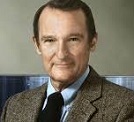


In 1969 Control Data Corp. (CDC) introduces the $5M 36.4MHz 65-bit 10 MFLOPS CDC 7600 supercomputer, designed by Seymour Cray (1925-96) as a successor to the 1965 CDC 6600 featuring an instruction pipeline and ICs, becoming the world's most powerful computer until the 1976 Cray supercomputer.
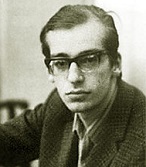
In 1969 U.S. Public Health Service virologist Robert Joseph Huebner (1914-98) pub. his Oncogene Theory, suggesting that viruses or single genes may trigger dangerous cell overgrowth, interacting with normal genes to produce cancer.

In 1969 Am. biochemist Robert Bruce Merrifield (1921-2006) synthesizes the first enzyme, ribonuclease, winning the 1984 Nobel Chem. Prize.
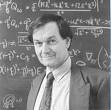


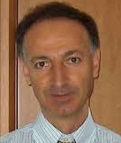
In 1969 English physicists Sir Roger Penrose (1931-) and Stephen William Hawking (1942-2018) prove that all matter within a black hole collapses to a singularity of infinite density and zero volume; Penrose proposes the Cosmic Censorship (Naked Singularity) Hypothesis, that singularities predicted by Einstein's Gen. Theory of Relativity can be "clothed" (restricted in their influence) by black holes, getting around the problem that "naked" singularities would destroy the Universe - if a singularity can destroy the U, it can create it? In 1971 Hawking suggests that black holes the size of a proton weighing 10 tons were formed following the Big Bang; the first black hole, Cygnus X-1 is discovered in spring 1971 - black swan jokes here? In 1972 Mexican-born Israeli physicist Jacob David Bekenstein (1947-) predicts that black holes should have a positive temperature and entropy. In 1974 Hawking proposes that black holes are not completely black, but are radiating black bodies that slowly evaporate away by emitting Hawking (Hawking-Bekenstein) Thermal Radiation, then explode. In 1980 Hawking claims that a Theory of Everything will be developed by the end of the cent.; in 2010 he reverses himself and says that a "family of interconnected theories" will emerge instead. In 2005 Penrose pub. The Road to Reality: A Complete Guide to the Laws of the Universe, which claims that the recognized laws of physics are incomplete, and "I do not believe that we have yet found the true 'road to reality'." In 2010 Penrose and Armenian physicist Vahagn "Vahe" Gurzadyan (1955-) pub. Cycles of Time: An Extraordinary New View of the Universe, which proposes Conformal Cyclic Cosmology, in which the U iterates through infinite cycles where the future timelike infinity of each iteration becomes the Big Bang singularity of the next; "Concentric circles in WMAP data may provide evidence of violent pre-Big-Bang activity."

In Mar. 1969 a team in Seattle, Wash. led by Edward Donnall "Don" Thomas (1920-) performs the world's first successful Bone Marrow Transplant on a leukemia patient using immune suppressant drugs, winning the 1990 Nobel Med. Prize.

In 1969 Joseph Weber (1919-2000) of the U. of Md. claims to observe gravitational waves in his Weber Bars, pairs of large well-insulated cylinders weighing several tons and located 1K km apart; too bad, nobody else can confirm him - there goes my Nobel?
On Sept. 18, 1969 the Murchison Meteorite lands near Murchison, Victoria, Australia, and is sent to the Apollo Moon Rock Lab, which finds the first amino acids of extraterrestrial origin - jacking off on a rock jokes here?
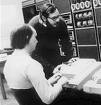
In summer 1969 the Unix Operating System (originally called "Unics", after the previous project "Multics") is invented by Bell Labs engineers Kenneth Lane "Ken" Thompson (1943-) and Dennis MacAlistair Ritchie (1941-2011); in 1972 it is translated from assembler language to Richie's new C programming language to make it more machine independent; in 1975 ITT makes it available to univs. to avoid antitrust problems, causing its development to accelerate.

On Oct. 17, 1969 Amherst, N.S., Canada-born physicistWillard Sterling Boyle (1924-2011) and White Plains, N.Y.-born physicist George Elwood Smith (1930-2025) of Bell Labs invent the Charge-Coupled Device (CCD); it is first commercialized by Fairchild Semiconductor in 1973, offering a chip providing 100 x 100 pixels, which begins to be used by astronomers at JPL and the U. of Ariz. in 1974, who use it to photograph the Moon; CCDs go on to make chemical photography obsolete; Boyle and Smith are awarded the 2009 Nobel Physics Prize.


In 1969 James L. Fergason (1934-2008) et al. of Kent State U. invent the Twisted Nematic Liquid Crystal, which becomes the basis for modern liquid crystal displays (LCDs), starting with a watch display for the $200 Gruen Teletime LCD Watch in 1972 after it is patented in 1971.
In Dec. 1969 Bubble Memory Devices are patented by Bell Labs for use in computers, retaining their info. when the power is turned off.

In 1969 New Orleans, La.-born Don Wetzel (1929-), vice-pres. of Docutel in Dallas, Tex. (maker of automated baggage handling equipment) et al. build the first modern (plastic card with magnetic strip and keyboard) Automated Teller Machine (ATM), which is installed at a Chemical Bank branch in Rockville Centre, N.Y. on Sept. 2; the first models are not linked with each other; he doesn't receive a patent until June 14, 1973, and the first one for the ATM goes to John D. White in 1973?

In 1970 George Arthur Akerlof (1940-) of UCB pub. the paper The Market for Lemons: Quality Uncertainty and the Market Mechanism, establishing the theory of info. assymetry in economics, e.g., when somebody won't pay a good price for a good car from a dealer because he thinks it might be a lemon, winning him the 2001 Nobel Econ. Prize.



In June 1970 Am. biologists David L. Baltimore (1938-), Howard Martin Temin (1934-94), and Renato Dulbecco (1914-2012) of MIT report the discovery of Reverse Transcriptase, an enzyme in RNA that can synthesize DNA, winning the 1975 Nobel Med. Prize; previously it was believed that only DNA can be used to manufacture more DNA; Retroviruses, which make DNA using an RNA template become a new field of research.

In 1970 Dutch chemist Paul Jozef Crutzen (1933-) pub. a paper showing that nitrous oxide (NO2) produced by soil bacteria rises into the stratosphere, and is split by sunlight into reactive NO compounds that break ozone down into breathable oxygen (O2), winning j, the 1995 Nobel Chem. Prize.
In 1970 Russian physicist Vitaly Efimov predicts a quantum mechanical version of the Borromean Rings, three linked rings that come apart if any one is removed; in 2009 his prediction is verified by Randy Hulet et al. of Rice U. using three lithium atoms.
In 1970 Francis Ivanhoe of the U. of London reports that European Neanderthals suffered from rickets, causing Creationists to jump and claim that they're really homo sapiens all along.

On June 3, 1970 U. of Wisc. researchers led by 1968 Nobel Med. Prize winner Har Gobind Khorana (1922-) announce the first complete synthesis of a yeast gene, alanine-transfer RNA, consisting of 77 nucleotide pairs (an avg. gene contains 1K); on Nov. 12 SUNY researchers James F. Danielli, Kwang W. Jeon, and I. Joan Lorch announce the first synthesis of a living cell by dismembering amoebas and making them into new amoebas, with Danielli noting the possibility of killer viruses being unleashed if abused. On Aug. 28, 1976 after getting around a Nat. Academy of Sciences ban on genetic manipulation of E. coli by using only the nucleotides, Khorana announces the first Artificial Bacterial Gene, which functions normally in an implanted living cell; on Oct. 14 the Internat. Council of Scientific Unions announces the formation of a committee to produce uniform regulations for rDNA research.
In 1970 after 32 years of research, Cho Hao Li (1913-87) and Donald Hiroshi Yamashiro (1928-2000) of the U. of Calif. Medical Center synthesize the 188 amino acid chain for somatropin, the human growth hormone (HGH) normally produced by the pituitary; next Mar. Hugh D. Niall et al. of the Mass. Gen. Hospital in Boston transpose 15 of the acids and add two more to make the chain more correct, but is still only 15% as effective as the natural hormone, but at least 650 cadavers aren't required to treat each pituitary dwarf child.



In 1970 Am. physicists Yoichiro Nambu (1921-), Leonard Susskind (1940-), and Holger Bech Nielsen (1941-) independently suggest the possibility that a theory of relativistic 1-dim. vibrating strings can explain particle physics; Nielsen is the first to call it String Theory.


In 1970 Am. biochemist Martin Rodbell (1925-98) discovers that Guanosine Triphosphate (GTP) is required for signal transmission between cells; he and Alfred Goodman Gilman (1941-) then discover G Proteins, which act like molecular switches by alternating between the inactive GDP and active GTP states, winning them the 1994 Nobel Med. Prize.

In 1970 Jewish-Am. astronomer Vera Cooper Rubin (1928-) reports anomalies in measurements of the Andromeda Galaxy known as the Galaxy Rotation Problem, which leads to a hunt for "missing mass" in the Universe, the most popular solution being the existence of Dark Matter. In 1974 she and W. Kent Ford Jr. (1931-) discover that the Milky Way Galaxy has a proper motion of about 300 mi./sec (500 km/s) with respect to distant galaxies; meanwhile U.S. radio astronomers discover that the microwave sky appears hotter in the direction of motion of the galaxy by 1 part per thousand, becoming known as "dipole anisotropy".
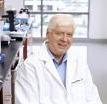


In 1970 Am. microbiologist Hamilton Othanel Smith (1931-) discovers Restriction Enzymes, which can break DNA molecules in predictable places, leading Am. microbiologist Daniel Nathans (1928-99) next year to break up a cancer virus, which eventually leads to its complete genetic mapping; Smith, Nathan, and Swiss microbiologist Werner Arber (1929-) later receive the 1978 Nobel Med. Prize for their work on restrictive enzymes.


Big year for biochemists into three-letter acronyms? In Jan. 1970 after finding natural ATP (adenosine triphosphate) to be too small for X-ray crystallography, scientists at Cambridge U. first successfully grow single giant crystals of ATP, then determine the 3-dim. structure; Creationists jump on its structure to claim that it is an example of irreducible complexity that even the simplest forms of life can't survive without; English chemist Sir John Ernest Walker (1941-) of Cambridge U. and Am. biochemist Paul Delos Boyer (1918-) later elucidate the enzymatic mechanism underlying ATP synthesis, winning them the 1997 Nobel Prize.

In 1970 Am. surgeon Robert Joseph White (1926-2010) performs the first head transplant on rhesus monkeys.
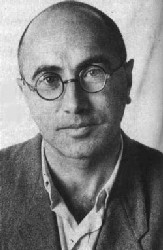

In 1970 Soviet physicist Yakov Borisovich Zeldovich (1914-87) discovers that rotating black holes spontaneously emit electromagnetic radiation, leading to the discovery of Quantum Evaporation of Black Holes (Hawking Radiation) by English physicist Stephen William Hawking (1942-2018) in 1974, who shows that when quantum effects are taken into account they glow and eventually explode, leading to the 1995 discovery by Ted Jacobson of Israel that Einstein's Theory of Gen. Relativity is just another way of stating the laws of thermodynamics, and that black holes are like holograms, because all the info. about what has been lost inside them is encoded on their surfaces; in 1972 Zeldovich et al. create a beam of time-reversed light using Brillouin Scattering; next year he meets with English physicist Stephen Hawking in Moscow, showing how rotating black holes should create and emit particles due to the Heisenberg Uncertainty Principle. In 1971 Hawking suggests that black holes the size of a proton weighing 10 tons were formed following the Big Bang; the first black hole, Cygnus X-1 is discovered next spring - black swan jokes here?
In 1970 the film colorization process is invented by Canadian engineer Wilson Markle (1938-), who sells it to NASA for use on the Apollo space program, and applies for a patent on July 11, 1983, receiving U.S. Patent #4,710,805 on Dec. 1, 1987.
In 1970 the U.S. FDA approves the use of Lithium as a treatment for bipolar disorder - superworld jokes here?
In 1970 the Long Day of Joshua Hoax begins circulating, to the effect that NASA scientists have proved the divine inspiration of the Bible by confirming the missing day in the Bible Book of Joshua 10:12-13 using computers.

On June 30, 1970 IBM announces the IBM System/370 mainframe computer, their first with microchips, and introduces the Relational Database with Structured Query Language (SQL), which becomes the industry std. for database access programs; meanwhile British-born IBM (San Jose) computer scientist Edgar Frank "Ted" Codd (1923-2003) pub. the paper "A Relational Model of Data for Large Shared Data Banks", inventing the Relational Database Mgt. System (RDBMS); too bad, IBM doesn't want to give up the revenue from their IMS/DB, but finally offers System R using the non-relational SEQUEL language, which is later copied by Larry Ellison for Oracle, beating IBM's SQL/DS to market.
In 1970 Xerox Corp. founds the Palo Alto Research Center (PARC) in Palo Alto, Calif., which goes on to develop the Graphical User Interface (GUI), the mouse, laser printer, and Ethernet, all of which are eagerly stolen by rivals Apple and Microsoft, while Xerox does little to take them to court.
In 1970 the ground-based VLF (10-14 KHz) Omega Navigation System (ONS) becomes the first worldwide radio navigation system for aircraft, operated by the U.S. Coast Guard with six partner nations, with six of nine stations becoming operational by next year; meanwhile the Global Positioning System (GPS) begins development, with the USAF Central Inertial Guidance Test Facility at Holloman AFB set up in 1972, and the first experimental satellite launched in 1978; it becomes fully operational in 1993 with 24-32 medium-orbit satellites, and the ONS is shut down on Sept. 30, 1997.
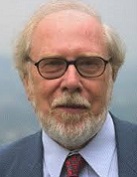
In 1970 Swiss computer scientist Niklaus Emil Wirth (1934-) pub. the simple and elegant ALGOL-based Pascal (originally ALGOL-W) programming language, which later becomes popular for PCs, but is abandoned as PCs become more powerful, after which it survives as a teaching language for newbies; "Whereas Europeans generally pronounce my name the right way, as Nick-Louse Veert, Americans invariably mangle it into Nickel's Worth. That is to say that Europeans call me by name, but Americans call me by value."
In 1970 the typewriter-like Daisy Wheel Impact Printer is introduced for use with PCs and word processors, with a speed of 30-55 cps, compared to 15 cps for an IBM Selectric typewriter.

In 1971 Am. biochemist Bruce Nathan Ames (1928-) of UCB devises the Ames Test to determine the carcinogenicity (mutagenicity of DNA in the test organism) of chemicals by measuring the rate of mutation in Salmonella typhimurium bacteria.

In 1971 Leon Ong Chua (1936-) of the U.S. proposes Memristors, "the missing link in electronics", which mimic the synaptic activity of the brain by remembering the amount of charge that flowed through them after the power is switched off; they are finally perfected in 2010 by Hewlett Packard.

In 1971 French rheumatologists Jacques Forestier (1890-1978) and R. Lagier become the first to diagnose Ankylosing Hyperostosis of the spine, AKA Diffuse Ideopathic Skeletal Hyperostosis (DISH), where the vertebrae fuse together and look like a dish of wax has been poured over them.

In 1971 after meeting with the Club of Rome, Anselmo, Neb.-born computer-systems engineer (System Dynamics founder) Jay Wright Forrester (1918-2016) pub. World Dynamics, which attempts to model the complex interactions of the world economy, pop., and ecology, founding the field of Global Modeling.


In 1971 Japanese-born Canadian cell biologist Yoshio Masui (1931-) of the U. of Toronto and Am. developmental biologist L. Dennis Smith of Purdue U. independently discover Maturation (Mitosis) Promoting Factor (MPF), which controls when mitosis or meiosis begins in cells.

In 1971 Russian-born Belgian chemist Ilya Romanovich Prigogine (1917-2003) develops Non-Equilibrium Irreversible Thermodynamics, and shows that the 2nd Law of Thermodynamics doesn't doom the Universe to a heat death, winning him the 1977 Nobel Chem. Prize.
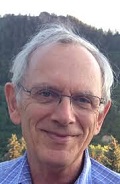
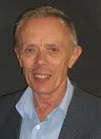
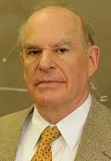
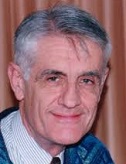
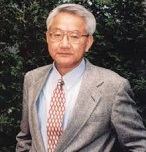
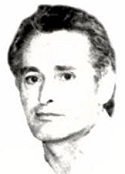
In 1971 French physicists Pierre Ramond (1943-) and Andre (André) Neveu (1946-), and Am. physicist John Henry Schwarz (1941-) develop String Theory, a string analog of the Dirac Equation incl. fermions and bosons; shortly thereafter French physicist Jean-Loup Gervais (1936-) and Japanese-born Am. physicist Bunji Sakita (1930-2002) show it to be a 2-dim. supersymmetry algebra via Dual Resonance Models; meanwhile Soviet physicist Yuri Abramovich Golfand (1922-94) and his student Evgeny P. Likhtman discover 4-dim. supersymmetry (SUSY) between bosonic and fermionic particles, opening up a possible Superworld.
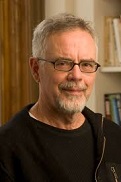
In 1971 Am. evolutionary biologist Robert Ludlow "Bob" Trivers (1943-) proposes the theory of Reciprocal Altruism, followed in 1972 by Parental Investment, followed in 1973 by facultative sex ratio determination (that mammals can determine the sex ratio of their offspring to maximize their own reproductive success) (proved in 2013), followed in 1974 by Parent-Offspring Conflict, followed in 1976 by self-deception as an adaptive evolutionary strategy, founding the field of Evolutionary Sociobiology; "The chimpanzee and the human share about 99.5 percent of their evoltuionary history, yet most human thinkers regard the chimp as a malformed, irrelevant oddity, while seeing themselves as stepping stones to the Almighty."

In 1971 British pharmacologist Sir John Robert Vane (1927-2004) et al. of Wellcome Research Labs. pub. their discovery that aspirin produces its pain-relieving and fever-reducing effects by inhibiting synthesis of Prostagalandins, lipid mediators; too bad, one type of prostaglandin protects the stomach and kidney; Vane goes on to win the 1982 Nobel Med. Prize and get knighted in 1984 - in vain?
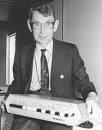

In early 1971 John V. Blankenbaker (1930-) begins marketing the Kenbak-1, the first commercially-available personal computer, with 256 bytes of memory, using switches for input and lights for output; he takes it off the market in 1973 after selling 62 units.
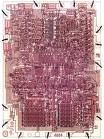
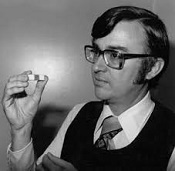



In Mar. 1971 Intel Corp. of Santa Clara, Calif. delivers the 4-bit Intel 4004, the world's first microprocessor chip, with 2.3K transistors and the computing power of the ENIAC (60KHz CPU), designed by Marcian Edward "Ted" Hoff Jr. (1937-), Italian-born Federico Faggin (1941-), and Japanese engineer Masatoshi Shima (1943-), with software design by Stanley Mazor (1941-); it is announced commercially on Nov. 15; the memory chip stores 1K bits of data; perf. increases 8x by 1974.

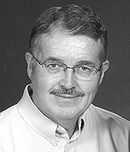
In Sept. 1971 Gary W. Boone (1945-2013) and Michael James Cochran of Texas Instruments develop the 4-bit TMS 1000 microprocessor, obtaining the first microprocessor patent on Sept. 4, 1973, and introducing it in 1974; TI uses it in its first handheld scientific calculator, the TI-3000, which is marketed next year, becoming popular with students.

In 1971 the $250 Bowmar Brain electronic calculator is introduced, featuring an embedded microchip.
On Mar. 14, 1971 Creeper, the world's first computer virus is launched; at first an academic exercise, hackers and prankers increase the number of instances to 1.3K in 1990, 50K in 2000, and 200M in 2010; by 2005 they become monetized for commercial gain.
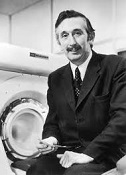
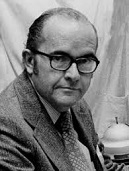
In 1971 English electrical engineer Sir Godfrey Newbold Hounsfield (1919-2004) uses medical X-rays to reconstruct a 3-D image, improving on the CAT scan method previously discovered by Allan MacLeod Cormack (1924-98) and William Henry Oldendorf (1925-92) to create X-Ray Computed Tomography (CT Scan).
In 1971 Centron Corp. of the U.S. introduces the first Dot Matrix Printer.

In 1971 India-born Dabbala Rajagopal "Raj" Reddy (1937-) of Carnegie Mellon U. develops Helen Reddy, er, Hearsay, the first software program for Computer Speech Recognition.
In 1971 Sam Hurst of Elographics develops the first Touch Sensor, which he turns into the first transparent touchscreen in 1974.
In 1971 Sony Corp. introduces the Videocassette for home recording of TV programs, starting a fight over copyright violations.
In Apr. 1971 the Soviet Union puts the first industrial Magnetohydrodynamic (MHD) Power Generator in operation, producing 25MW.
In 1972 Teletext is invented for use by BBC-TV.


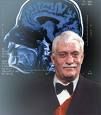
In 1972 MRI (Magnetic Resonance Imaging), based on energy absorption by nuclei is pioneered by Am. chemist Paul Christian Lauterbur (1929-2007) in his farmhouse basement in Sidney, Ohio by making fuzzy 2-D images of water in small glass tubes, getting rejected by Nature as trivial, then refined by English physicist Sir Peter Mansfield (1933-), for which they are awarded the 2003 Nobel Physics Prize; they are introduced in Britain in 1982, and the FDA approves them for the U.S. in 1984; they cost 50% more than CAT-scanners, but are superior in permitting blood flow to be viewed; Armenian-Am. Harvard medical grad student Raymond Vahan Damadian (1936-) of the U.S. started it all, coming up with the idea in 1969 and applying for the first patent in 1971, and receiving it in 1973, then performing the first full body scan July 2, 1977, although without a mechanism for generating images - is there a doctor in the house?

In 1972 after inserting a human gene into bacterial DNA, the first Recombinant DNA (rDNA) molecules are synthesized by Paul Berg (1926-) et al. of Stanford U., winning him the 1980 Nobel Chem. Prize; in 1974 fearing the creation of a virulent drug-resistant strain, a committee of 139 scientists from the U.S. Nat. Academy of Sciences led by Berg calls for a temporary worldwide ban on rDNA genetic manipulation experiments involving the bacterium Escherichia coli (found in the human digestive tract), then lift it on June 23, 1976 with a ban on other forms of genetic experimentation.

In 1972 UCB asst. math prof. Stephen Arthur Cook (1939-) proves that the Boolean Satisfiability Problem in formal logic is NP-Complete, solvable in nondeterministic polynomial time; too bad, he leaves open the question of whether complexity classes P (solvable in polynomial time) and NP (solvable in nondeterministic polynomial time) are equivalent, and the math dept. at UCB stinks itself up by refusing to give him tenure, after which he moves to the U. of Toronto.
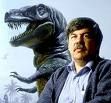

In 1972 Am. paleontologists Stephen Jay Gould (1941-2002) and Niles Eldredge (1943-) pub. the Theory of Punctuated Equilibrium to explain why evolution seems to occur in short bursts not continually, claiming it does it via one species splitting into two species (cladogenesis), without explaining how it works or turns on and off?
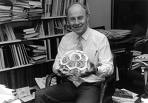
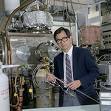
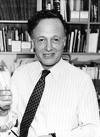
In 1972 Am. chemist Dudley Robert Herschbach (1932-), Taiwanese chemist Yuan Tseh Lee (1936-), and Hungarian-Canadian chemist John Charles Polanyi (1929-) develop a supermachine for Crossed Molecular Beam Spectroscopy to study elementary reaction processes at the molecular level, winning them the 1986 Nobel Chem. Prize.
In 1972 Am. psychiatrist David S. Janowsky et al. determine that manic depression (bipolar disorder) is caused by an imbalance between andrenergic and cholinergic transmitters.

In 1972 Am. geophysicist William Jason Morgan (1935-) of Princeton U. pub. the theory that the Hawaiian Islands were formed as the Pacific Plate moved over the Emperor Seamounts.

In Apr. 1972 Cornell U. graduate student Douglas Dean Osheroff (1945-) discovers that Helium-3 becomes a superfluid at very cold temps, winning him a share of the 1996 Nobel Physics Prize.


In 1972 Am. physicist Burton Richter (1931-) of Stanford U. et al. build the 3 GeV Stanford Positron-Electron Assymetric Ring (SPEAR) for research into subatomic particles, going on in 1974 to discover the J/Psi Meson (Psion), consisting of a 4th quark, the Charm Quark (about 1.5Kx as massive as an electron), plus its antiquark, which is 3.5x as massive as a proton, and is the first in a class of massive long-lived mesons, winning the 1976 Nobel Physics Prize; Samuel Chao Chung Ting (1936-) discovers it independently in 1974, calling it the J Particle, and shares the prize, becoming the first to deliver an acceptance speech in Chinese - j/psi sounds Chinese anyway?
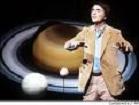
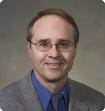

In 1972 Am. astronomers Carl Edward Sagan (1934-96) and George Mullen propose the Faint Early (Young) Sun Paradox (Problem), that the Earth's climate has been fairly constant for the last 4B years yet the Sun's radiation has increased by 35%-30%; in 1993 Am. scientist Jim Fraser Kasting (1953-) concludes that CO2 was 30% of the Earth's atmosphere, creating a greenhouse effect; in 2010 Danish scientist Minik Rosing et al. propose that the cloud layer was thinner in the past, allowing more rays to reach the Sun, and that the CO2 levels were only 0.1%.
In Apr. 1972 Intel Corp. introduces the Intel 8008, the first 8-bit microprocessor, containing 3.5K transistors, compared to 2.3K in the 4004.
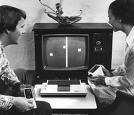



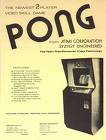
On May 24, 1972 Magnavox introduces the Magnavox Odyssey home video game system, designed by German-born Jewish-Am. engineer Ralph Henry (Rudolf Heinrich) Baer (1922-2014), which uses an RCA TV screen and sells 100K the first year; meanwhile after founding Atari Corp. (Jap. "check in the game of Go") on June 26, investing $250 each with his friend Ted Dabny, and hiring engineer Allan Alcorn (1949-) to design and program it, Utah-born Nolan Bushnell (1943-) installs the first of 6K $1K Atari Pong video game machines in Andy Capp's Tavern in Sunnyvale, Calif. in Sept.; the first version of Pong has a B&W Motorola TV screen and costs 25 cents per play, with the instructions "Avoid missing ball for high score"; the video game industry is launched, becoming a 1980s social phenomenon; in 1975 Atari starts selling through Sears & Roebuck stores; too bad, clone makers and pirates soon fracture the market, preventing a Microsoft, er, monopoly from being created, but the example gives crafty Bill Gates the idea of creating one?
On June 30, 1972 at midnight GMT one second is added to clocks worldwide to bring them in line with atomic clocks, becoming the first time in history that a leap second is added to clocks - just like a mini-Armageddon, starting time over?
The June 1972 issue of the Calif. mag. Ramparts pub. the schematics of a Blue Box, used by techno-geeks to gain free long distance access to U.S. phone lines by generating a 2600 Hz signal, causing the authorities to shut them down and seize all issues in a vain attempt to stop the practice, which only makes it more popular?
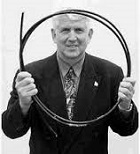
In July 1972 David Reeves Boggs (1950-) of Xerox's Palo Alto Research Center combines packet switching from the Arpanet and single wire broadcasting to lay the foundations for computer networks with the Ethernet system, which transmits data at 3M bits per sec.; on Sept. 30, 1980 the IEEE pub. the first draft of the DIX (Digital/Intel/Xerox) std., specifying 10M bits per sec. and a global 16-bit type field.
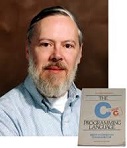
In 1972 Bell Labs engineer Dennis Ritchie (1941-2011) creates the C Programming Language for the Unix operating system; it goes on to become the language of choice for PC programmers.
In 1972 Scottish scientists devise the Maternal Serum Alpha-Fetoprotein Test for amniotic fluid to detect anencephaly and spina bifida.


In 1972 Lexitron introduces the first commercial Word Processing System, followed by Vydek Corp., which introduces the first with a CRT screen and printer, and Wang labs.
In 1972 scientists at Bell Labs develop the first narrow-linewidth Tunable Continuous-Wave Laser.

In 1972 Philips and MCA demonstrate the first Videodisc based on reflective mode Laserdisc technology.

In 1973 Italian astronomer Giovanni Fabrizio Bignami (1944-) discovers gamma rays coming from an invisible source, which in 1976 is named Geminga (It. "it's not there"); ' it turns out to be a neturon star approx. 552 l.y. (250 parsecs) from the Earth in the constellation Gemini, becoming the first known radio-quiet pulsar.
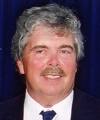

In 1973 the first Gene Splicing is performed by Herbert W. Boyer (1936-) and Stanley Cohen (1922-) of the U.S.
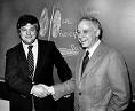
In 1973 Michael Stuart Brown (1941-) and Joseph L. Goldstein (1940-) of the U.S. discover that cells of the human body have surface receptors that trap and absorb bloodstream particles containing cholesterol (low-density lipoproteins), advancing the understanding of how atherosclerosis develops, winning them the 1985 Nobel Med. Prize.

In 1973 at a celebration of the 500th birthday of Nicolaus Copernicus, who was known for the Copernican Principle that the Earth doesn't occupy a privileged place in the Universe, Australian physicist Brandon Carter (1942-) coins the term "anthropic principle" for the idea that: "Although our situation is not necessarily central, it is inevitably privileged to some extent", and that the Universe we observe allows us to develop as humans, although other non-observable Universes might exist; it later evolves into attempts to claim that the four fundamental interactions in physics must be balanced to provide for the existence of life, etc. - the Bible strikes back?


In 1973 German-born Am. physicist Hans Georg Dehmelt (1922-2017) et al. develop the Penning Trap, which captures and holds in place a single electron while observers watch it make quantum leaps, causing physicists to revise their estimate of the size of an electron by a factor of 10K, winning them the 1989 Nobel Physics Prize; named by Dehmelt for Dutch physicist Frans Michel Penning (1894-1953). In 1979 Dehmelt et al. take the first photo of a single atom, and in 1980 they obtain a color photo of a single charged barium atom, which they name Astrid, appearing as a tiny blue dot on a black background.

In 1973 UCLA geography prof. Jared Mason Diamond (1937-) pub. Distributional Ecology of New Guinea Birds, announcing his discovery that similar birds occur in gradations where each bird is 30% larger than its smaller relatives in all dimensions, which later is shown to apply to inanimate objects.

In 1973 Russian-born Am. evolutionary biologist Theodosius Grygorovych Dobzhansky (1900-75) pub. Nothing in Biology Makes Sense Except in the Light of Evolution, which disses Bible creationism while supporting theistic evolution so he can stay a devout member of the Russian Orthodox Church, becoming the mantra of the keep-Creation-out-of-public-schools lobby; the reality that the facts of biology are interrelated proves evolution and not a Creator who used a common design kit?; "I am a creationist and an evolutionist. Evolution is God's, or Nature's method of creation. Creation is not an event that happened in 4004 B.C.; it is a process that began some 10 billion years ago and is still under way" - I know I was there?



In 1973 Princeton U. prof. David Jonathan Gross (1941-), and graduate students Frank Anthony Wilczek (1951-) and Hugh David Politzer (1949-) make the theoretical discovery of asymptotic freedom concerning the strong or color force that holds together quarks in protons and neutrons, proving that it gets stronger as the distance increases, like a rubber band, winning them the 2004 Nobel Physics Prize.

In 1973 British geneticist Hans Grueneberg (Grüneberg) (1907-82) of the U.S. discovers the Grueneberg Ganglion at the tip of mammal noses, which later is found to detect alarm pheromones emitted by others of the same species.

In 1973 Canadian computer scientists Brian Wilson Kernighan (1942-) and Shen Lin find a useful algorithm for solving the classic Traveling Salesman Problem.

In 1973 Mary-Claire King (1946-) of UCB demonstrates that human and chimpanzee DNA are 99% identical; later it is determined that 99.9% of human DNA is identical across all the world's pop.; in 2008 it is found that the DNA in identical twins is not 100% identical - science needs a woman's touch?
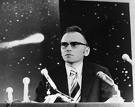
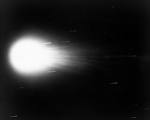
On Mar. 7, 1973 the large-orbit comet Kohoutek (period 75K years) is discovered by Czech astronomer Lubos Kohoutek (1935-) of Hamburg Observatory; it remains visible from Earth through early 1974.



In 1973 Norwegian physiologist Terje Lomo and British physiologist Timothy V.P. "Tim" Bliss add experimental support to the Neural Network Theory of Memory of Canadian psychologist ("Father of Neuropsychology and Neural Networks") Donald Olding Hebb (1904-85) by observing that high-speed bursts of electricity strengthen memory, and pub. the first detailed account of Long-Term Potentiation.



In 1973 Am. economist Robert Cohart Merton (1944-) pub. the Black-Scholes Options Pricing Model, based on work by Fischer Sheffy Black (1938-95) of the U.S. and Myron Samuel Scholes (1941-) of Canada, which implicitly prices an option when the stock is traded; it goes on to become the std. model used by global financial markets, winning them the 1997 Nobel Econ. Prize.

In 1973 Paul Musset (1933-85) et al. of CERN discover weak neutral currents in neutrino reactions, partially confirming the electroweak theory.


In 1973 Am. astrophysicist Jeremiah Paul "Jerry" Ostriker (1937-) and Canadian physicist Philip James Edwin "Jim" Peebles (1935-) propose the existence of Dark Matter to explain why galaxies don't fly apart - into striking pebbles?


In 1973 Indian physicist Jogesh C. Pati (1937-) and Pakistani physicist Mohammad Abdus Salam (1926-96) suggest theoretical reasons for protons to decay into other particles, winning Salam the 1979 Nobel Physics Prize, making him the first Pakistani and first Muslim to win a Nobel for science.

In 1973 Solomon H. Snyder (1938-) et al. of the U.S. discover the opiate receptors in the brain, and they put two and two together, leading to the discovery of several opiate-like endorphins in the brain.


In 1973 Am. immunologist George Davis Snell (1903-96), Venezuelan immunologist Baruj Benacerraf (1920-), and French immunologist Jean Baptiste Gabriel Joachim Dausset (1916-2009) identify genes controlling antibodies, along with cell surface structures regulating immunologic responses, advancing knowledge of autoimmune diseases and histocompatibility, winning them the 1980 Nobel Med. Prize.

In 1973 English embyrologist Sir Ian Wilmut (1944-) produces the first live birth of a calf (named Frosty 2) from a frozen embryo; Frosty 1 was from frozen sperm; by 1996 he's into lambs.

In 1973 Cornell U. physicist Kenneth Geddes Wilson (1936-) uses quantum field theory to analyze second-order phase transitions of materials in several dims. via the Renormalization Group, winning him the 1982 Nobel Physics Prize.
In 1973 scientists at CERN in Switzerland perform experiments revealing the existence of the neutral (zero-charge) Z Particle, a boson with 100x the mass of a proton that mediates interactions between electrons and neutrinos.



In early 1973 Realisation d'Etudes Electroniques (R2d) introduces Micral N, the world's first non-kit microcomputer, using an Intel 8008 chip, designed by French engineer Francois Gernelle (1944-) and Vietnamese-born French engineer Andre Truong Trong Thi (1936-2005); too bad, at $1,750 it doesn't sell well.
On Mar. 1, 1973 Xerox Corp. introduces the $15K Xerox Alto Computer, a personal computer (PC) with the first GUI (graphical user interface, complete with a mouse), licensed from Stanford Research Inst. for $45K; only 2K units are sold for research use; Steve Jobs visits the Xerox PARC facilities in 1979 and steals the GUI/mouse idea for the Apple Lisa and Macintosh.
On Apr. 2, 1973 the LexisNexis computerized legal research service of Mead Cata Central Co. begins operation in Dayton, Ohio.

On Apr. 3, 1973 the 30-bar 12-decimal-digit Universal Product Code (UPC), based on the 1948 design of Drexel Inst. of Tech. students Bernard Silver (1924-62) and Norman Joseph Woodland (1921-) (patented in Oct. 1952, then sold to RCA in 1952, and expired in 1969) is pub. by the U.S. Supermarket Ad Hoc Committee on a Uniform Grocery Product Code after the Nat. Assoc. of Food Chains asks Logicon to develop a Universal Grocery Products Identification Code in 1969, and they release it in summer 1970; after a multi-co. competition where RCA loses their lead dog status after it can't handle runs in ink, the final system is developed by Woodland and co-worker George Joseph Laurer (1925-) of IBM; each digit consists of 7 bits (bar for 1, space for 0 in the first half, reversed in the 2nd half), with never more than four consecutive 1s or 0s; the three guard bars cause Millennium Feverists to see the feared "666", which Laurer counters by noting that all three words in his name have six letters too. 6267408011067 hike? On June 26, 1974 (8:01 a.m.), the first retail item scanned with the new UPC Barcode is a 10-pack of Wrigley's Juicy Fruit chewing gum (67 cents) at Marsh's Supermarket in Troy, Ohio using a laser scanner from nearby NCR Corp; the lucky shopper is Clyde Dawson, and the lucky supermarket clerk is Sharon Buchanan; the pack of gum and receipt end up in the Smithsonian Inst.; shoppers and retailers resist the system at first, but by the end of the cent. 5B items a day are rung up using it.
On Oct. 19, 1973 the landmark patent case Honeywell Inc. v. Sperry Rand Corp., et al. invalidates the 1964 ENIAC patent, and acknowledges that the electronic digital computer was invented by John Vincent Atanasoff (1903-95), who didn't obtain a patent, throwing it into the public domain; pub. during the Nixon Saturday Night Massacre, it doesn't get much attention - but future monopolists Bill Gates et al. must have been jumping for joy?
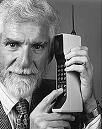
In 1973 the first 2.5 lb. $3.5K portable Cell Phone is introduced by Motorola, the Motorola DynaTAC (Dynamic Adaptive Total Area Coverage) (AKA the Brick); systems div. gen. mgr. Martin Cooper (1926-) (who claims that Capt. Kirk's communicator in "Star Trek" was their motivation) makes the first call on Apr. 3 to his rival Joel Engel of Bell Labs from the street; it has a talk time of 35 min. and recharge time of 10 hours; by 1980 there are 1M subscribers in the U.S.

In 1973 Am. computer scientist Gary Arlen Kildall (1942-94) develops PL/M (Programming Language for Microcomputers) the first high-level programming language for microcomputers, and uses it to create the CP/M (Control Program for Microprocessors) operating system for the Intel 4004 microprocessor by 1976, founding Intergalactic Digital Research Inc. in 1974 to market it.
In 1973 U.S. Atomic Energy Commission (AEC) reactor development dir. Milton Shaw (1921-2001) decides to cancel the Molten-Salt Reactor Experiment (MSRE) in favor of the proposed unsafe (flammable sodium coolant) Liquid Metal Fast Breeder Reactor (LMFBR), resulting in the $8B Clinch River Breeder Reactor Project, which proves a boondoggle and is cancelled in 1983, while spawning the LWR designs of Three Mile Island, Chernobyl, and Fukushima, while the MSRE could have spunoff the inherently safe Liquid Fuel Thorium Reactor (LFTR).
In 1973 the first Jet Skis are marketed by Kawasaki, creating the "personal watercraft" market.
In 1973 the first Optical Smoke Detectors are developed by NASA.
In 1973 Am. engineer Carl G. Sontheimer (1915-98) visits the Robot-Coupe restaurant supply co. in France and redesigns the food blender of Pierre Verdun, inventing the $140 Cuisinart food processor, which costs way more than $35 blenders, but gains endorsements from J ulia Child, James Beard, and other famous chefs, causing sales to boom.
In 1973 French engineer Michel Colomban (1932-) invents the Colomban Cri-cri (Fr. "cricket"), the smallest twin-engined manned aicraft, with a length of 13 ft. and wingspan of 16 ft.
In 1973 the Credit Card Currency Dispenser is patented by Nat. Cash Register (NCR), becoming the first modern ATM; BankAmericard launches it in Mar.; by 1997 there are 425K ATMs in use worldwide.
In 1973 Am. engineer Carl G. Sontheimer (1915-98) visits the Robot-Coupe restaurant supply co. in France and redesigns the food blender of Pierre Verdun, inventing the $140 Cuisinart food processor, which costs way more than $35 blenders, but gains endorsements from Julia Child, James Beard, and other famous chefs, causing sales to boom.

In 1973 South Korean artist Nam June Paik (1932-2006) (first-ever video artist) coins the term "Information Superhighway" in a paper for the Rockefeller Foundation.
On May 30, 1974 NASA launches the Fairchild ATS-6 (Applications Technology Satellite 6), becoming the world's first educational and experimental direct broadcast satellite, the first 3-axis stabilized spacecraft in geostationary orbit, and the first to use electric propulsion in orbit; it also carries the first heavy ion detector in geostationary orbit; it is decommissioned in July 1979.

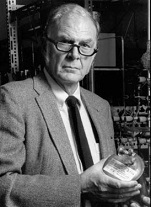
On June 28, 1974 Mexican-born Am. chemist Mario J. Molina (Jose Mario Molina-Pasquel Henriquez) (1943-2020) and Delaware, Ohio-born chemist Frank Sherwood "Sherry" Rowland (1927-2012) pub. a paper in Nature claiming that chlorofluorocarbon (CFC) propellants are accelerating the depletion of the ozone layer in the stratosphere, with one chlorine molecule able to destroy up to 100K ozone molecules, winning them the 1995 Nobel Chem. Prize; meanwhile high acidity in lakes in NE U.S. and E Canada are traced to coal-burning plants in the U.S. Midwest; in 1978 the U.S. bans CFC-based aerosols in spray cans.
On Nov. 16, 1974 the Arecibo Radio Telescope sends an interstellar radio message aimed at the M13 Great Globular Cluster in Hercules, which is expected to arrive around the year 27,000 C.E.



In 1974 Am. mathematicians Theodore P. Baker, John T. Gill III, and Robert Martin Solovay (1938-) demonstrate two classes of propositions which are equivalent based on one set of postulates but not equivalent based on another set, even though each postulate set is internally consistent - no way to solvy?
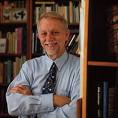


In 1974 Am. geneticists Gary K. Beauchamp, Kunio Yamazaki, and Edward A. Boyse (1923-2007) discover that mice can distinguish other mice that have the same genes for the Major Histocompatibility Complex, the part of the immune system that distinguishes between self and nonself; later it is traced to the sense of smell; Beauchamp determines that cats (order Panthera) have no preference for sugars because their sweet taste receptors are non-functional.

In 1974 H. Joachim Burhenne (1926-96) develops the Burhenne Technique for removing retained binary calculi (gallstones) through bile ducts; he performs the procedure on the Shah of Iran in 1979.
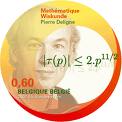
In 1974 Belgian mathematician Pierre Rene (René) Deligne (1944-) resolves three of Andre Weil's 1949 conjectures about using algebraic geometry, becoming the first mathematician in history to be commemorated on a postage stamp during his lifetime (until ?).

In 1974 Russian opthalmologist Svyatoslav Nikolayevich Fyodorov (1927-2000) of Russia perfects Radial Keratotomy for vision correction; it is introduced to the U.S. in 1978.

In 1974 English astrophysicist John R. Gribbin (1946-) and Stephen H. Plagemann pub. The Jupiter Effect: The Planets as Triggers of Devastating Earthquakes, claiming that the alignment of Solar System planets causes a 0.04mm rise in the high tide and triggers earthquakes in 179-year cycles, predicting an earthquake along the San Andreas Fault between 1979 and 1982 that will wipe out Los Angeles, later claiming it to be the 1980 Mt. St. Helens eruption, then fastening on Mar. 1982; Gribbin backs down in July 1980, calling it "too clever by half", but in Feb. 1982 they pub. The Jupiter Effect Reconsidered, claiming it had happened despite a lack of alignment; in 1999 Gribbin repudiates it once for all, with the soundbyte "I don't like it, and I'm sorry I ever had anything to do with it."
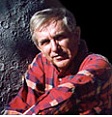
In 1974 Am. astronomers William Kenneth "Bill" Hartmann and Donald R. Davis of the Planetary Science Inst., and Alfred G.W. Cameron and William R. Ward of Harvard U. pub. the theory that the Moon split off from the Earth after a huge impact with some planet sized body (Thea), giving the Earth its lucky 23 deg. tilt.

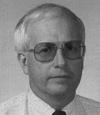
In 1974 British astronomer Sir Fred Hoyle (1915-2001), and Am. astronomers William Alfred "Willie" Fowler (1911-95) and Robert W. Wagoner calculate that the Big Bang Theory correctly predicts the amounts of deuterium and lithium in the observed Universe.


In 1974 Am. astronomers Russell Alan Hulse (1950-) and his thesis advisor Joseph Hooton Taylor Jr. (1941-) of the U. of Mass. Amherst discover the first binary pulsar PSR B1913+16 using the Arecibo Observatory in Puerto Rico, becoming known as the Hulse-Taylor Binary and winning them 1993 Nobel Physics Prize.

In 1974 the Joint Inst. for Nuclear Research in Dubna, Russia and Lawrence Livermore Lab in Calif. co-discover chemical element #106, a homologue to tungsten, which is named Seaborgium (#106) (Sg) in honor of UCB scientist Glenn Theodore Seaborg (1912-99)
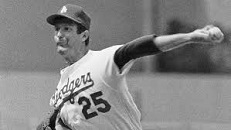
In 1974 Los Angeles Dodgers team surgeon Frank Jobe (1926-2014) performs the first Tommy John Surgery (ulnar collateral ligament reconstruction) (UCL) on ML pitcher Thomas Edward "Tommy" John Jr. (1943-), replacing the ligament in his left (pitching) arm with a tendon from his right forearm, after which John goes on to win 164 more games, becoming the oldest player in the ML in 1989-9, retiring in 1989 when Mark McGwire, a patient of his dentist father gets two hits from him, with the soundbyte "When your dentist's kid starts hitting you, it's time to retire."


On Nov. 24, 1974 Am. anthropologist Donald Carl Johanson (1943-) et al. discover a 3.5-ft.-tall female vegetarian tree-dwelling bipedal skeleton (AL 288-1) in 3M-y.-o. strata near the village Hadar, Ethiopia in the Awash Valley of the Afar Triangle, and name it Lucy (after the Beatles' song "Lucy in the Sky with Diamonds"), leading to the naming of a new race, er, genus, er, species, Australopithecus afarensis, dated to -3.2M - maybe it's one of the recent 100K+ famine victims?

In 1974 Lithuanian-born British chemist-biophysicist Sir Aaron Klug (1926-) et al. determine the crystal structure of Transfer RNA (tRNA); Klug wins the 1982 Nobel Chem. Prize, and is knighted in 1988.
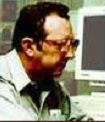
In 1974 Am. astronomer Charles Thomas Kowal (1940-2011) of Mount Palomar Observatory discovers Jupiter's moon Leda, followed next year by Themisto, followed on Nov. 1, 1977 by the tailless asteroid-comet 2060 Chiron (95P/Chiron), becoming the first recognized Centaur (minor planet).
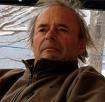
In 1974 French astronomer Antoine Emile Henry Labeyrie (1943-) builds the first Dual-Telescope Optical Interferometer, going on to invent Speckle Interferometry.


In 1974 the Laffer Curve, by Am. economist Arthur Betz Laffer (1940-), that shows how tax revenues are zero for tax rates of 0%, 100%, plus somewhere in between is explained to Nixon-Ford admin. officials Dick Cheney and Donald Rumsfeld by Laffer, who draws it for them on a napkin; the name is coined by Wall Street Journal writer Jude Thaddeus Wanniski (1936-2005), becoming a pillar of Pres. Reagan's Supply-Side Economics; vice-pres. George W. Bush calls it "voodoo economics".

In 1974 English mathematician Sir Roger Penrose (1931-) discovers Penrose Tiling of a plane using fat and thin rhombuses such that their ratio is an irrational number, the Golden Mean.

In 1974 German historian Arno Peters (1916-2002) discovers the Arno (Gall-Peters) Projection, which turns out to have been devised in 1855 by Scottish clergyman James Gall (1808-95), which retains the proportions of countries better than the Mercator and Van der Grinten map projections, and has the political effect of giving Third World countries a bigger presence.


In 1974 French physicist Joel (Joël) Scherk (1946-79) and Am. physicist John Henry Schwarz (1941-) pub. a paper in which they show that string theory is a theory of quantum gravity, and that it could describe the gravitational force if the tension in the string were very high, the string size is on the order of the Planck length (10^-33 cm), and the Universe has 10 dimensions; gravitational force is carried by gravitons; Japanese physicist Tamiaki Yoneya discovers the link independently; in 1978 Scherk, French physicist Eugene (Eugène) Cremmer (1942-), and French physicist Bernard Julia (1952-) construct the Lagrangian and supersymmetry transformations for supergravity in 11 dims, helping found M-theory; too bad, Scherk dies of a diabetic coma after attending a supergravity workshop at SUNY on Sept. 29, 1979 - you're my 11-dimensional mail order bride?

In 1974 Swedish scientists Lars Terenius (1940-) and Agneta Wahlstrom discover that certain small peptides naturally produced by the body act upon opiate receptors in the brain.

In 1974 Flushing, N.Y.-born physician Lewis Thomas (1913-93) pub. The Lives of a Cell: Notes of a Biology Watcher; bestseller of "Notes of a Biology Watcher" articles from New England Journal of Medicine, helping him get promoted to dean of NYU Medical School and Yale School of Medicine, and pres. of the Sloan-Kettering Inst.; "I have been trying to think of the earth as a kind of organism, but it is no go. I cannot think of it this way. It is too big, too complex, with too many working parts lacking visible connections. The other night, driving through a hilly, wooded part of southern New England, I wondered about this. If not like an organism, what is it like, what is it most like? Then, satisfactorily for that moment, it came to me: it is most like a single cell"; "We pass thoughts around, from mind to mind, so compulsively and with such speed that the brains of mankind often appear, functionally, to be undergoing fusion. Or perhaps we are only at the beginning of learning to use the system, with almost all our evolution as a species still ahead of us. Maybe the thoughts we generate today and flick around from mind to mind... are the primitive precursors of more complicated, polymerized structures that will come later, analogous to the prokaryotic cells that drifted through shallow pools in the early days of biological evolution. Later, when the time is right, there may be fusion and symbiosis among the bits, and then we will see eukaryotic thought, metazoans of thought, huge interliving coral shoals of thought."





In 1974 Harvard U. physicists Steven Weinberg (1933-), Mohammad Abdus Salam (1926-96) Howard Mason Georgi III (1947-), Sheldon Lee Glashow (1932-), and Australian-born Helen Rhoda Arnold Quinn (1943-) combine gauge theories and unification of forces, and propose the Grand Unified Theory (GUT), claiming that the strong, weak, and electromagnetic forces are really the same, but broke apart after the Big Bang, and make the first prediction for the lifetime of the proton, i.e., that it is not absolutely stable, winning them 1979 Nobel Physics Prize, all except Georgi and the woman that is - are you a hot lady and all you want to do is dance?
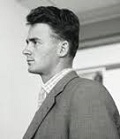
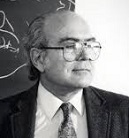
In 1974 Austrian physicist Julius Erich Wess (1934-2007) and and Italian physicist Bruno Zumino (1923-2014) pub. the Wess-Zumino Model of 4-Dim. Space-Time Supersymmetry (named by Abdus Salam and John Strathdee in 1974), which postulates that every fermion has a massive bosonic partner and vice-versa; the partners are first observed in 2003.
In Apr. 1974 Intel Corp. introduces the 2MHz (500K instructions per sec.) 8-bit Intel 8080 microprocessor, is 10x faster than the 8080 and is upward software compatible, featuring a 16-bit address bus and 8-bit data bus; it is based on enhancement-mode NMOS - makes them and Microsoft rich 10x richer than IBM?
In 1974 Motorola begins marketing the Pageboy consumer pager-beeper.
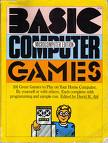



In 1974 Jonathan Titus pub. an article in the July issue of Radio Electronics describing how to build the MARK-8 Personal Minicomputer using an Intel 8008, which is turned into the Altair 8800 next year; meanwhile David H. Ahl (1939-) of DEC puts together a similar microcomputer, but the co. shows no interest, so he founds Creative Computing mag. (until Dec. 1985) for home computing hobbyists; in 1973 he pub. BASIC Computer Games, the first million-selling computer book. The PC revolution starts out slow and geeky after the U.S. govt. tries to prevent a monopoly, only to create another? In 1975 the U.S. Dept. of Justice antitrust suit against IBM (filed by the LBJ admin. in 1969) finally comes to trial, and is settled in IBM's favor even though it is the world's largest co. in terms of stock value, which is greater than the combined value of all the stock of all cos. listed on the Am. Stock Exchange; does fear of another lawsuit keep it from dominating the PC market, paving the way for the rise of future PC software monopoly Microsoft, which is founded in Albuquerque, N.M. on Apr. 4 by young Wash. State-born geeks William "Bill" Gates III (1955-) and Paul Gardner Allen (1953-) after seeing an article in the Jan. issue of Popular Electronics, causing them to drop out of Harvard U. to produce a BASIC interpreter for the first commercial microprocessor, the $379 MITS Altair 8800, introduced on Dec. 19, 1974 by 6'6" 300 lb. Miami, Fla.-born engineer Henry Edward "Ed" Roberts (1942-) of Micro Instrumentation Telemetry Systems (MITS) of Albuquerque, N.M. for mail-order enthusiasts, and named for the destination of the Starship Enterprise in "Star Trek: TOS"; it has 256 bytes of memory, toggle switch input, and display light output; MITS ships 2K computers a month; on Nov. 29 Gates first coins the name "Micro-soft" in a letter to Allen, and they leave MITS, then register their TM in N.M. next Nov. 26 (named after their private parts?), and win a lawsuit against Roberts to retain the rights to their software after he sells his co, then move back to Seattle, Wash. in 1978 and turn some property owned by Gates' daddy in Redmond into their campus; the Homebrew Computer Club is founded by Altair 8800 enthusiasts, spawning 23 computer cos., incl. Apple Computer; meanwhile in Sept. geeky Byte Mag. is founded for microcomputer enthusiasts (until July, 1998).


In 1974 Vinton Gray Cerf (1943-) and Robert Elliot "Bob" Kahn (1938-) pub. a key paper on the Internetwork, and devise the Transmission Control Protocol (TCP), which becomes the basis of Internet file and email byte transfer.

In 1974 French journalist Roland Moreno (1945-) invents the Smart Card, a credit card that stores info. on an IC instead of magnetic track.
In 1974 low acid Canola Oil (Canadian oil) is developed by Richard Keith Downey (1927-) and Baldur Rosmund Stefansson (1917-2002) from modified rapeseed with low erucic acid; it has the lowest saturated fat content of any major vegetable oil (6%, vs. 13% for corn oil and 15% for soybean oil); Downey and Stefansson become known as "the Fathers of Canola".

In 1975 Gunter (Günter) Blobel (1936-) of Rockefeller U. discovers Protein Targeting, the mechanism to carry newly-made proteins through cells to their proper locations via signal peptide address tags, winning him the 1999 Nobel Med. Prize.

In 1975 Am. mathematical physicist Mitchell Jay Feigenbaum (1944-) discovers the First Feigenbaum Constant (4.669201609103+), the ratio toward which the consecutive differences of almost any iterated function tends; in 1978 he discovers the 2nd constant.

In 1975 the term "fractal" is coined by Polish-born French-Am. mathematician Benoit B. Mandelbrot (1924-2010), who founds Fractal (Expanding or Evolving Symmetry) Geometry; in 1979 he discovers the Mandelbrot Set.



In 1975 Argentine biochemist Cesar Milstein (1927-2002) and his German-born student Georges Jean Franz Kohler (Köhler) (1946-95), and English-born Danish immunologist Niels Kaj Jerne (1911-94) of Cambridge U. discover the hybridoma technique for making Monoclonal Antibodies by injecting a mouse with a target protein and harvesting antibodies from its spleen, becoming the first breakthrough toward a "magic bullet" to target disease, winning them the 1984 Nobel Med. Prize.
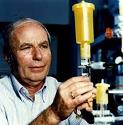


In 1975 Ubiquitin, a small regulatory protein found in all eukaryotic organisms is discovered; in 1980 Israeli scientists Avram Hershko (1937-), Aaron Ciechanover (1947-), and U.S. scientist Irwin A. Rose (1926-) pub. a paper revealing the role of ubiquitin in degrading and recycling proteins, winning them the 2004 Nobel Chem. Prize.
In 1975 scientists at the Nat. Inst. of Standards and Tech. in Md. propose Optical Molasses, the use of three intersecting laser beams to hold an atom in place and cool it down towards absolute zero.
In 1975 Rohypnol (Flunitrazepam) is first marketed as a sleeping pill for severe insomnia; it is 10x as powerful than Valium; too bad, it begins to be used as a date rape drug known as roofie, and the U.S. FDA never approves it (until ?) - thanks lover, see ya around?
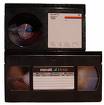
On May 10, 1975 Sony introduces the $789-$900 Betamax videotaping system in Japan (3 MHZ bandwidth, 240 lines) (named for the way the tape forms the Greek letter beta while running through the transport), becoming the first successful consumer video recorder; it is introduced in the U.S. in early Nov; it has a hi-fi audio mode with an 80dB dynamic range and less than 0.005% wow and flutter; in Sept. 1976 rival Matsushita/JVC introduces the technically inferior (but cheaper to manufacture, and able to record 3 hours, vs. 60 min. for Betamax) VHS (Video Home System) (3 MHZ bandwidth, 240 lines), starting the Betamax v. VHS Format War of one Japanese co. against another, with the U.S. not in the running, and VHS winning (1983 in the U.S., 2002 in Japan); in 1985 SuperBeta is introduced (290 lines), followed by VHS HQ (High Quality), then Super VHS in Apr. 1987 (5 MHZ, 250 lines); the fact that Sony prohibits porno is a factor because VHS permits people to view it in the privacy of their homes for the 1st time?; meanwhile next year Universal Pictures sues Sony for copyright infringement, and on Jan. 17, 1984 the U.S. Supreme Court rules 5-4 in Sony Corp. vs. Universal City Studios that home videotaping is legal fair use for purposes of recording for later viewing (time-shifting).
In Sept. 1975 IBM introduces the IBM 5100 PC, with 16KB of RAM; when the Microsoft DOS version is introduced in 1981, it is called the IBM 5150.

In Oct. 1975 John Cocke (1925-2002) et al. of IBM begin designing the RISC (Reduced Instruction Set Computing) computer, which concentrates on optimizing the instructions usually emitted by compilers for speed, coming out with the IBM 801, which is introduced in summer 1980, reaching 15 MIPS.
In 1975 the Amana Touchmatic Radarange is introduced, becoming the first microwave oven allowing programming of meals.
In 1975 Xerox introduces the Telecopier 200, the first laser plain-paper fax (facsimile machine), along with the IBM 3800, the first high-speed (20K lines/min.) laser printer, with quality comparable to photocomposition.
On June 19, 1976 NASA's Viking 1 goes into Martian orbit after a 10-mo. flight; on July 20 it becomes the first spacecraft to land on Mars, on the W slope of the Plains of Gold (Chryse Planitia), using a 53-ft. diam. polyester parachute, two radar systems for measuring alt., and a primitive computer to guide it to a 6 mph touchdown, and begins sending back the first (B&W) pictures from the surface, incl. the famous Face on Mars Photo on July 31, which on Apr. 5, 1998 is retaken by the Mars Global Surveyor and turns out to not be a face at all but a butte; the last transmission is on Nov. 11, 1982; it pours water on soil to test for life, and reports negative; on Aug. 7 Viking 2 enters Martian orbit, and on Sept. 3 it lands on the rocky Utopia Planitia to take the first close-up color photos of the planet's surface, and also tests for life, coming up negative; it makes its last transmission on Apr. 11, 1980; the 3rd backup Viking lander is put on display at the Smithsonian Inst.; in Jan. 2007 Dirk Schulze-Makuch of the U.S. suggests that Mars life might be based on a water-hydrogen peroxide mix, and that therefore the Viking experiment may have killed any alien microbes by pouring water on them.


In 1976 Am. mathematician Kenneth Ira Appel (1932-) and German mathematician Wolfgang Haken (1928-) solve the famous 4-Color Map Theorem, that four colors can color any planar map; too bad, they used a computer to number-crunch the possibilities, pissing-off some mathematicians while founding the new field of Experimental Mathematics.


In 1976 Soviet scientists in Dubna create synthetic chemical element Bohrium (Bh) (#107) (original names eka-rhenium and unnilseptium) by hitting chromium atoms with bismuth atoms; too bad, nobody can verify their results, and in 1981 a team at the Inst. for Heavy Ion Research (Gesellschaft fur Schwerionenforschung Darmstadt) (GSI) in Darmstadt, Germany, led by Peter Armbruster (1931-) and Gottfried Munzenberg (Münzenberg) (1940-) synthesizes it, becoming the ones who are officially recognized in 1992; since element #105 was given the name dubnium, the IUPAC goes with the German suggestion to honor Danish physicist Niels Bohr, but shorten the proposed name neislbohrium; Armbruster-Munzenberg go on to discover elements #108-#112.



In 1976 Am. mathematicians Bailey Whitfield "Whit" Diffie (1944-) and Martin Edward Hellman (1945-) pub. the paper "New Directions in Cryptography", introducing the Diffie-Hellman Key Exchange Algorithm for public-key cryptography; in 2002 the name of Ralph C. Merkle (1952-) is added.

In 1976 Czech.-born Am. scientist Martin Frank Gellert (1929-) et al. of the Nat. Insts. of Health discover the enzyme Gyrase that allows double-helix DNA to form supercoils by unwinding it first.

In 1976 Am. physicist Douglas Richard Hofstadter (1945-) predicts Hofstadter's Butterfly, a quantum fractal energy structure that emerges when electrons are confined to a 2-dim. sheet and subjected to a periodic potential energy and strong magnetic field; confirmed in 2013.

In 1976 English theoretical physicist Sir Thomas Walter Bannerman "Tom" Kibble (1932-) of Imperial College, London theorizes that long super-thin Cosmic Strings formed after the Big Bang.




In 1976 Kiwi chemist Alan Graham MacDiarmid (1927-2007), Am. physicist Alan Jay Heeger (1936-), and Japanese chemist Hideki Shirakawa (1936-) of the U. of Penn. discover that bromine doping greatly increases the electrical conductivity of polyacetylene, followed next year by iodine, winning them the 2000 Nobel Chem. Prize for Conductive Polymers; in 1978 MacDiarmid, L.E. Lyons, and Sir Nevill Francis Mott (1905-96) create Organic Semiconductors, consisting of carbon compounds doped with oxygen.

On Apr. 1, 1976 English amateur astronomer Sir Alfred Patrick Caldwell Moore (1923-) reports the Jovian-Plutonian Gravitational Effect on BBC Radio 2 as an April Fool's hoax, claiming that it is causing a noticeable short-term reduction in Earth's gravity, telling listeners to jump into the air at 9:47 a.m. to feel a floating sensation, and receiving hundreds of telephone calls claiming to confirm it.

In 1976 Japanese scientist Susumu Tonegawa (1939-) discovers that genes that produce antibodies move close together on a chromosome, recombine, and split into segments as needed to allow the immune system to adapt and produce millions of antibodies, winning him the 1987 Nobel Med. Prize.
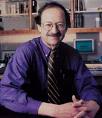

In 1976 Am. scientists Harold Elliot Varmus (1939-) and John Michael Bishop (1936-) discover Oncogenes, genes in normal cells that can mutate and cause cancer.

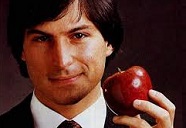

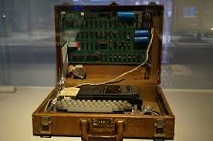

On Apr. 1, 1976 Apple Computer (Apple Inc.) is founded by college dropouts Steven Paul "Steve" Jobs (1955-2011) and Stephen Larry "Steve" "Woz" Wozniak (1950-) (a Freemason) to produce 200 units of their Apple I MOS 6502 1MHZ personal computer motherboard with 4K RAM, monochrome display, and no keyboard, which is introduced on Ap. 11 and which goes on sale in July for $666.66; after incorporation next Jan. 3 with $250K in funding by Armas Clifford "Mike" Markkula Jr. (1942-), and paying Stanford Research Inst. $45K for a lifetime license to their mouse technology, they introduce the Apple II, the first serious home computer on Apr. 16, 1977 at the West Coast Computer Fair, featuring color graphics and open architecture for only $1,298, plugging into users' TV screens and storing data on audiocassettes, becoming an instant hit; the first logo shows Isaac Newton sitting under an apple tree.
In Mar. 1976 the 8.5K-transistor 8-bit 2.5MHz 64K Zilog Z80 8-bit microcomputer chip is introduced, taking over the personal computer market to the end of the decade.
In June 1976 IBM introduces the IBM 4640 Inkjet Printer, which is used only for medical strip charts since it wastes a lot of ink; too bad, the jets clog, but next year Siemens introduces thermal drop-on-demand inkjets that solve the problem, and Canon switches to water-based inks, but it takes until 1984 for Hewlett-Packard to introduce the HP Thinkjet.

In 1976 the MOS Motorola 6502 Microprocessor is developed by Chuck Peddle (1937-), costing 15% as much as an Intel 8080, causing it to be selected for the Apple I computer.

In 1976 Japanese ANSA Fone inventor Kazuo Hashimoto (-1995) patents the first Caller ID; he receives a U.S. patent in Dec. 1980.

In 1976 MIT graduate Raymond "Ray" Kurzweil (1948-) invents the Kurzweil Reading Machine, the first "omni-font" optical char. recognition device, which turns text to speech for only $50K; he is bought out by Eastman Kodak in 1981. In 1990 he pub. The Age of Intelligent Machines, which predicts the World Wide Web and that a computer will defeat a world chess champ - but never actually invents anything? In 2005 he pub. The Singularity is Near: When Humans Transcend Biology, about how the PCs will equal human brains by 2020, mind uploading will begin in 2030, PCs will be 1Bx smarter than humans by 2045, and the Singularity will make humans #2 after machines, and the Universe will "wake up" as early as 2199 after the godlike chips figure out how to travel faster than the speed of light - dumbest book of the century, or, Isn't the Earth a tough place for any visiting intelligence to play?

In 1976 Am. physicist John M.J. Madey of Stanford U. invents the Free-Electron Laser, which uses a relativistic electron beam as the lasing medium, making it widely tunable, with the widest frequency range of any laser type, from microwave through X-ray frequencies; after Stanford lets him patent it, Madey later gets in a legal battle with Duke U. over the use of his patent for free in basic research, resulting in a 2002 U.S. Supreme Court decision in John M.J. Madey v. Duke U. in his favor that ends the 170-y.-o. practice of allowing scientists to freely borrow patented technologies for limited use in basic research not aimed at commercial use.
In 1976 Michael Shrayer releases the Electric Pencil program for the Altair microcomputer, becoming the first commercially marketed Word Processor; Wang Labs. begins marketing the multi-user Wang 1200 WPS word processor in June, followed by the Wang Office Info. System next year, with each workstation powered by a Z80 microprocessor with 64K of RAM.
In 1976 the baking-friendly artificial sweeter Sucralose (600x as sweet as sucrose) is discovered by scientists at Queen Elizabeth College in London, who replace three HO groups in sucrose with chlorine atoms; in 1999 it is introduced in the U.S. as Splenda.
In 1976 the SuperSlurper, a combination of starch and a synthetic chemical that absorbs hundreds of times its own weight in water is patented.
In 1976 the Threshold 600 by Threshold Tech. is introduced, with a 500-word voice recognition capability that takes up to 1 sec.

In 1977 the U.S. Navy 16-ton minisub DSV Alvin, (commissioned June 5, 1964), manned by John B. "Jack" Corliss (1936-), Kathleen Crane (1951-), and Robert Duane Ballard (1942-) begins exploring the Galapagos Rift Zone deep sea ocean rift hot water vents near the Galapagos Islands, diving 9K ft. and discovering previously unknown creatures thriving on bacteria living on sulfur from volcanic vents, incl. sulfur-eating bacteria, giant tube worms and clams, and other bizarre life forms; after writing a letter to Francis Crick on June 24, 1969, announcing that he wanted to use "the cell's 'internal fossil record' [RNA] to extend our knowledge of evolution backward in time by a billion years or so", U.S. scientist Carl Richard Woese (1928-) defines the new unicellular Archaea, the 3rd kingdom of life (after Bacteria, Eucarya), which can live in extreme conditions; later he and other scientists discover Methanogens, archaeons that produce methane in anoxic conditions; the discovery of a new limb on the tree of life suggests the possibility of Horizontal Evolution? In 1999 Ballard pub. Noah's Flood/ The Black Sea Expedition, claiming that the Mediterranean burst through to the Atlantic in 5K B.C.E.

In May 1977 the first Balloon Angioplasty is performed in St. Mary's Hospital, San Francisco, Calif. interoperatively during bypass surgery, followed on Sept. 16 by Swiss surgeon Andreas Roland Gruentzig (1939-85) on an awake 37-y.-o. insurance salesman in Zurich; by 1995 400K patients in the U.S. receive the procedure each year.

On Sept. 11, 1977 the Atari 2600 VCS (Video Computer System) game system is released, becoming the first to use software cartridges; the more advanced Atari 5200 is released in 1982.
In 1977 Swedish physician Tomas G.M. Hoekfelt (Hökfelt) (1940-) discovers that most neurons can transmit multiple neurotransmitters at the same time, which he calls the Coexistence Principle.


Big year for quark and lepton hunters? In 1977 Am. physicist Leon Max Lederman (1922-) et al. of the Fermi Nat. Accelerator Lab. in Batavia, Ill. discover a 5th quark, the Bottom (Beauty) Quark, which has a mass about 5Kx that of the electron, which with its antiquark forms the upsilon particle (psion), giving three quark families, up/down (ordinary matter), strange/charm (high energy), and beauty (bottom)/truth (top), and winning him the 1988 Nobel Physics Prize; the hunt is on for the last quark, the top or truth quark, 45Kx the mass of an electron, which is found in 1994; meanwhile Am. physicist Martin Lewis Perl (1927-) of Stanford U. studies frontal collisions between electrons and positrons in the Stanford Linear Accelerator, and in Aug. observes the first tau particles (tauons) (heavy leptons), which decay in less than a picosecond into neutrinos and an electron or muon, while an antitau particle decays into neutrinos and a positron or antimuon, winning him the 1995 Nobel Physics Prize; a tauon is a fat muon (3.5Kx the electron's mass), and a muon is a fat electron (200x the electron's mass), giving three families of leptons to match the three families of quarks.


In 1977 a team led by English biochemist Frederick Sanger (1918-) determines the exact DNA sequence of a bacteriophage, the first for any organism; Am. biochemist Walter Gilbert (1932-) independently develops a nucleotide sequencing technique, and they share the 1980 Nobel Chem. Prize.



In 1977 Philip Allen Sharp (1944-) of MIT and British-born Richard John Roberts (1943-) of Cold Spring Harbor Lab on Long Island independently discover Split Genes, genomic sequences (exons) interrupted by intervening sequences of meaningless info. (introns), found in organisms other than monerans (bacteria and algae). In 1979 Biogen Inc. is founded in Boston, Mass. by molecular biologists Philip Allen Sharp (1944-) and Walter Gilbert (1932-), who develop a way to sequence DNA, after which Gilbert shares the 1980 Nobel Medicine Prize and Sharp the 1993 Nobel Med. Prize.
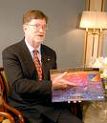

In 1977 Am. astrophysicists George Fitzgerald Smoot III (1945-) of Lawrence Berkeley Nat. Lab in Calif. and John Cromwell Mather (1946-) of NASA discover anisotropic temperature variations in the Cosmic Microwave Background Radiation (CMBR). On Nov. 17, 1989 the NASA Cosmic Background Explorer (COBE) is launched to measure the Cosmic Microwave Background Radiation (CMBR), the alleged remnants of the light created 380K years after the Big Bang, before which the Universe was allegedly opaque to light; it goes on to confirm a classic black body spectrum indicating uniform temperature, with tiny "lumps" .001% richer in matter than the surrounding space, from which galaxies allegedly arose; George Fitzgerald Smoot III (1945-) of Lawrence Berkeley Nat. Lab in Calif. and John Cromwell Mather (1946-) of NASA receive the 2006 Nobel Physics Prize for their work after scientists generally accept the Big Bang theory; meanwhile John Peter Huchra (1948-2010), Margaret J. Geller (1948-) et al. of the Harvard-Smithsonian Center for Astrophysics discover the Great Wall, a series of galaxies 500M l.y. long, 200M l.y. wide, and 15M l.y. thick, which would require 100B years to form from the Big Bang, casting more doubt on it; more than a dozen more Great Walls are later discovered, the biggest, called the Sloan Great Wall, 1.37B l.y. long requiring 250B years to form - a lot of bang for the buck?
On Apr. 22, 1977 Gen. Telephone and Electronics Co. makes the first large-scale demo of Fiber Optics (6 Mbps) to transmit live telephone calls.
In 1977 Herpes encephalitis becomes the first life-threatening viral infection to be successfully treated with a drug.
In 1977 a new Low-Radiation Dose Method for Mammography is patented, giving a 90% survival rate when the cancer is detected in the localized stage and hasn't spread to the lymph nodes, vs. 60% if it has.
In 1977 Munchausen Syndrome by Proxy, where mothers make their children sick in order to elicit sympathy for themselves is first identified - nothing that's formal, nothing that's normal, no recitations to recite?
On July 7, 1977 the Nestle Boycott sees the infant formula products of Nestle Corp. of Switzerland (sold in 140 countries) boycotted for discouraging breast-feeding and causing needless infant deaths; in 1981 the 34th World Health Assembly adopts the Internat. Code of Marketing of Breast-Milk Substitutes, and on Mar. 16, 1982 Nestle issues guidelines to comply, and promises to curtail distribution to hospitals, causing the boycott to be suspended in 1984; in 1988 after hospitals are flooded with free supplies, the boycott is reinstated (until ?).

In Apr. 1977 Hayes Corp. in Ga., founded by S.C.-born Dennis Carl Hayes (1951-) and Dale Heatherington begins marketing the first Hayes Modem for microcomputers, operating at 300 baud; in June 1981 they introduce the Hayes AT Command Set; in 1982 they sell 140K modems, with $12M in revenue; too bad, they end up filing bankruptcy in 1994 despite sales of $270M.


In 1977 Israeli computer scientists Abraham Lempel (1936-) and Jacob Ziv (1931-) pub. the Ziv-Lempel LZ77 Compression Algorithm for compressing computer info., which helps the fledgling computer communications industry by reducing the data load.


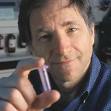
In 1977 Jewish computer scientists Ronald Linn Rivest (1947-) of the U.S., Adi Shamir (1952-) of Israel, and Leonard Max Adleman (1945-) of the U.S. invent the RSA Computer Encryption Algorithm, based on the difficulty of factoring large prime numbers, permitting public key encryption systems, and pub. it in Scientific American mag.; British scientist Clifford Cocks and two others develop it independently but don't get credit because their work is classified by the govt. - Classified Cocks?
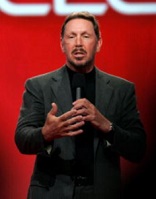

On June 16, 1977 Software Development Labs in Redwood Shores, Calif. is founded with $1.4K by ex-Ampex employee Lawrence Joseph "Larry" Ellison (1944-) and Robert N. "Bob" Miner (1942-94), who develop Oracle, the first commercially viable computer relational database language, and on June 16, 1977 found Software Development Labs., followed on Oct. 29, 1982 by Oracle Systems, which goes public on Mar. 12, 1986 after achieving $55M sales, which zoom to $584M in 1989.

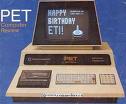
On Aug. 3, 1977 Tandy Corp. announces the TRS-80 Model I desktop microcomputer, fondly called the Trash-80. On Sept. 3, 1977 Polish-born Jewish Auschwitz survivor Jack Tramiel (Idek Trzmiel) (1928-) introduces the 8-bit Commodore PET (Personal Electronic Transactor) home computer, with the slogan "Computers for the masses, not the classes", reaching $700M sales in 1983 and $1B in 1984.

In 1977 the Bell XV-15, the first successful tiltrotor VTOL aircraft makes its first flight on May 3; the Model 1-G of 1947-54 was the first, but it was abandoned by the USAF.
In 1977 Mattel introduces Auto Race, the first handheld electronic game; in Nov. 1979 Milton Bradley's Microvision becomes the first handheld game console with interchangeable cartridges, designed by Jay Smith.

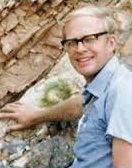
In 1978 Am. Nobel Prize-winning physicist Luis Walter Alvarez (1911-88), his geologist son Walter Alvarez (1940-) et al. propose the Asteroid Impact Theory of Dinosaur Extinction to explain the unusual abundance of iridium associated with the K-T Extinction Boundary (65M B.C.E.); 1990 studies of the impact crater of Chicxulub in the Gulf of Mexico lend support to their theory - asteroid theories are eco-friendly?

On June 22, 1978 800-mi.-diam. Charon (named after the ancient Greek ferryman of Hades), the only known moon of 1.4K-mi.-diam. Pluto is discovered by Am. astronomers James Walter "Jim" Christy (1938-) and Robert Sutton Harrington (1942-93) at the U.S. Naval Observatory in Flagstaff, Ariz., the same city where Pluto was discovered in 1930.



On July 25, 1978 5 lb. 12 oz. Louise Joy Brown (1978-), the first test tube baby via In-Vitro Fertilization (IVF) (ovule insemination in a Petri dish followed by reimplanation) is born in Oldham, England, causing a firestorm of controversy even though her mother Lesley Brown (1947-) was fertilized with sperm from her hubby; she was actually grown in a football-size jar; British gynecologist Patrick Christopher Steptoe (1913-88) and British physiologist Robert Geoffrey "Bob" Edwards (1925-) do the work, winning Edwards the 2010 Nobel Med. Prize.

In 1978 Paul Ekman (1953-) and Wallace V. Friesen pub. the Facial Action Coding System (FACS) to taxonomize human facial expressions; later used in the Fox Network TV show "Lie to Me" (2009-).

In 1978 German physicist Wolfgang Paul (1913-93) traps neutrons in a magnetic storage ring and measures the avg. lifetime of a free neutron at about 15 min.

In 1978 Peter H. Seeburg (1944-) et al. of the Univ. of Calif. identify the DNA for Human Growth Hormone (HGH) in the spring, for which the U. of Calif. files a patent; in Nov. Seeburg quits the U. of Calif. and goes to work for Genentech Corp., where a crash program is in progress to create a growth hormone drug, taking a sample of the DNA that the U. of Calif. is trying to patent on Dec. 31 and stashing it; meanwhile on May 23, 1977 Genentech discovers a way to trick E. coli bacteria into producing synthetic human insulin by inserting the human gene into it, and they go into production in a joint effort with the City of Hope Medical Center in Duarte, Calif., producing the first batch in 1979 and founding the biotech industry after the U.S. FDA approves its use in 1982. In July 1979 Genentech begins producing synthetic human growth hormone - how long till the baseball home run records begin to fall?
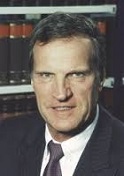
In 1978 German physicist Frank Steglich (1941-) discovers Unconventional Superconductivity in a heavy fermion superconductor mix of cerium, copper, and silicon.
On July 4, 1978 the Princeton Tokamak Fusion Test Reactor uses deuterium gas (available in seawater) to reach a temp of 60M F for .05 sec.; too bad, to produce workable sustainable nuclear fusion they need to reach 100M F for 1 sec., and it is dismantled in 1997.



In 1978 Eric F. Wieschaus (1947-) and Christiane Nusslein-Volhard (Nüsslein-Volhard) (1942-) identify the Sonic Hedgehog Gene (named after the Sega Genesis video game), which controls the growth of digits on limbs as well as the organization of the brain, and the loss of function of which causes embryos to be covered with hedgehog-like denticles; they both go on to work with Edward B. Lewis (1918-2004) to identify genes that control the segmentation pattern of fruit fly (Drosophila melanogaster) embryos in the first "Big Science" large-scale mutagenesis project in biological history, pub. in the Nov. 2, 1978 issue of Nature, winning them the 1995 Nobel Med. Prize.
In 1978 Ernest Ludwig Wynder (1922-99), John Weisburger, and Philippe Shubik (1921-2004) of Columbia U. pub. research in June indicating that greasy Am.-style cooking and eating contributes to 40% of cancer deaths; meanwhile George Lincoln Blackburn of Harvard U. claims that 1 in 10 cancer deaths is caused by malnutrition. Alison A. Paul and David A.T. Southgate (1932-2008) devise a method of determining the fiber content of foods, allowing research on the connection between fiber intake and colon cancer.
In 1978 Intel Corp. introduces the 16-bit Intel 8086 microprocessor, containing a whopping 29K transistors, setting the world std. for microprocessors for the next 20+ years - when it's powerball it's always a big jackpot, don't forget to play?


In 1978 the U.S. Dept. of Defense High Order Language Working Group, formed in 1975 to invent a single computer language to replace the 450+ high order languages in use for defense projects, led by Jean David Ichbiah (1940-2007) of Honeywell Bull in France et al. settles on Ada, named after Lord Byron's daughter Lady Augusta Ada King, Countess of Lovelace (1815-52), allegedly the first programmer (Charles Babbage really did it?); it becomes mandatory to use in 1983, but too bad, it's an uncool kitchen sink flying domesticated turkey language that ends up as a billion dollar boondoggle as the commercial sector refuses to accept it and develops far better languages, causing the mandate to be removed in 1997, leaving scads of Ada programmers out in the cold as a poor sister unemployable minority group? - if they'd only asked TLW?

In 1978 Japanese-born U.S. biophysicist Toyoichi Tanaka (1946-) of MIT invents polymer Smart Gels that can undergo huge (1Kx) reversible volume changes in response to changes in temperature, light, chemical and other stimuli.
On Feb. 16, 1978 the first Computer Bulletin Board System (BBS) goes online in Chicago, Ill., run by Ward Christensen and Randy Suess, after which they spread like wildfire, reaching 60K in 1994, after which the Internet makes them obsolete.

In June 1978 the Space Invaders arcade video game, designed by Tomohiro Nishikado (1944-) is released by Taito of Japan, whio licenses it to the Midway div. of Bally in the U.S. in July, becoming a giant money magnet in bars, earning $500M by 2007, causing a coin shortage in Japan, becoming the #1 arcade game of all time (until ?); in 1980 a version for the Atari 2600 becomes their first killer app., earning $2B a year by 1982.
On Nov. 22, 1978 the TCP/IP Protocol (Transmission Control Protocol/Internet Protocol) is successfully tested with 3 of 111 ARPANET nodes, becoming the std. Internet protocol; IP handles the low-level transmission of packets, TCP directs the high-level transmission of a stream of packets.
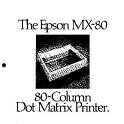
In 1978 Epson Co. introduces the low-cost 80-column Epson MX-80 impact dot-matrix printer, which revolutionizes home and office computing, becoming the de facto industry std.
In 1978 John Robbins "Rob" Barnaby develops the WordStar word processing system for the CP/M operating system, later adapting it for DOS and becoming the #1 word processing program of the early 1980s.
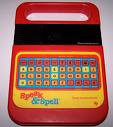
In 1978 the Speak and Spell handheld educational toy is introduced by Texas Instruments in June, becoming the first low-priced mass-produced consumer product with a human voice generated by a single microchip, the TMC 0280; it can pronounce 165 words with a 131,072-bit ROM; meanwhile the Nippon Electric Co. introduces the Voice Data Input Terminal that can recognize 120 words in group of up to five, with a 300ms delay.


In 1978 Polish-born Heidelberg U. prof. Gunther von Hagens (1945-) patents Plastination, a technique for preserving human bodies for study using silicon, epoxy and other plastics, which takes nearly a year, but creates dynamite gross-out public exhibitions which teach anatomy while raising moral questions.
On May 16, 1978 Clyde R. Vann and Roy R. Vann patent an Optical Fiber TV Screen in the U.S.
In 1978 Raytheon Missile Systems begins fielding the shoulder-fired solid-fuel Mach 2 (1.5K mph) FIM-92 Stinger infrared homing surface-to-air missile (first tested in 1975), which goes on to fame in Afghanistan (and the crash of TWA Flight 800) after debuting on May 21, 1982 in the Falklands War; after the Soviets withdraw from Afghanistan, the U.S. spends $55M trying to buy them back, obtaining about 300 of ?.
In 1979 Omeprazole proton pump inhibitor is discovered, getting marketed under the names Prilosec, Losec et al., getting on the WHO's list of essential medicines; too bad, on Feb. 15, 2015 Britta Haenisch et al. of the German Center for Neurodegenerative Diseases in Bonn pub. an article in JAMA Neurology announcing that people age 75+ who regularly take proton pump inhibitors (Prilosec, Nexium, Prevacid) have a 44% increased risk of dementia.

In 1979 German-born British geneticist Sir Walter Bodmer (1936) (knighted in 1986) founds Human Leukocyte Antigen (HLA) research to study the heredity of large human families and locate gene markers for specific traits.
In 1979 Am. mathematicians Robert Stephen "Bob" Boyer and J [no period] Strother Moore, developers in 1977 of the efficient Boyer-Moore String Search Algorithm develop the Boyer-Moore Theorem Prover Algorithm, which can churn out proofs by mathematical induction on a computer.


In 1979 Am. physicists Robert Henry Dicke (1916-97) and Philip James Edwin Peebles (1935-) propose that the Universe is flat in order to explain its smoothness on a large scale; in 1970 Dicke proposed that the Universe must have very nearly the critical density needed to stop it from expanding forever. In 2000 results from the 1998 BOOMERANG (Balloon Observations of Millimetric Extragalactic Radiation and Geophysical) experiment study of cosmic background radiation reveal that the Universe is flat, not curved.

In 1979 Harvard dropout Microsoft founder William Henry "Bill" Gates III (1955-) pub. his first (only) mathematical paper, "Bounds for Sorting by Prefix Reversal", on the Pancake Flipping (Sorting) Problem.

In 1979 Scottish physicist Peter LeComber (1941-92) et al. of the U. of Dundee show that amorphous silicon can be used to build Thin-Film Transistors to control liquid crystal displays (LCDs).


In 1979 Hertfordshire-born English chemist James Ephraim Lovelock (1919-) pub. Gaia: A New Look at Life on Earth, which proposes the Gaia Hypothesis, that the Earth functions as a superorganism, pissing-off Darwinian evolutionists, who smell a Creator or Intelligent Designer? In 1988 the First Chapman Conference on the Gaia Hypothesis in San Diego, Calif. puts forward the Gaia Hypothesis (Princeiple) (Theory) of English physical chemist James Ephraim Lovelock (1919-) and Am. biologist Lynn Margulis (nee Lynn Petra Alexander) (1938-2011)

In 1979 Alexander Rich (1924-) et al. of MIT grow the first crystalline DNA, and announce discovery of a left-handed form of DNA which they call Z-DNA, as opposed to normal B-DNA.
In 1979 Am. dentist Irwin Smiley, er, Irwin Smigel appears on ABC-TV's That's Incredible! and performs the first nationally televised demonstration of his invention of Cosmetic Tooth Bonding.
In 1979 English astronomer Dennis Walsh (1933-2005) of Jodrell Bank Observatory observes the first galaxy that acts like a Gravitational Lens.
On Mar. 7, 1979 the largest Magnetar (Soft Gamma Ray Repeater) event so far (until ?) is recorded.
In 1979 researchers at the Deutsches Elektronen Synchroton in Hamburg, Germany provide evidence for the existence of the Gluon, which carries the color force between quarks, confirming the theory of Quantum Chromodynamics.
In 1979 the 52g meteorite Yamato 791197 is found in Antarctica on Nov. 29, later being recognized as the first to have landed on Earth and found by scientists, allegedly from the Moon.
In Sept. 1979 Motorola introduces the 16/32-bit HMOS Motorola 68000 microprocessor chip, with a 24-bit memory address that can access up to 16 MB, which Apple uses for its Macintosh computer.
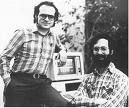
In Sept. 1979 the $100 spreadsheet program VisiCalc, by Software Arts Inc., founded by Jewish-Am. MIT pals Daniel Singer "Dan" Bricklin (1951-) and Robert M. "Bob" Frankston (1949-) is introduced for the Apple computer, becoming the first "Killer App" that causes business persons to buy the computer to run the software, and soon becomes available on the TRS-80, Commodore PET, and Atari 800; by 1985 they sell 800K copies; in 1986 it is bought by Lotus Corp.
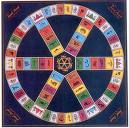
On Dec. 15, 1979 Canadians Chris Haney (1950-2010) and Scott Abbott invent Trivial Pursuit, a trivia game with a die that is rolled to pick the color category, which goes on to become a big hit in the U.S. after being released in 1984, reaching $256M in sales; Fred L. Worth, author of "The Trivia Encyclopedia" (1974) and "The Complete Unabridged Super Trivia Encyclopedia" (1977) sues after finding that they copied his errors, seeking $300M in damages, but loses in the U.S. Supreme Court in Mar. 1988 - sorry, can't copyright facts, even wrong ones?

In 1979 Danish computer scientist Bjarne Stroustrup (1950-) develops the C++ (C with Classes) programming language - already passing the U.S. govt. Ada turkey up?
In 1979 the first commercial Cellular Telephone System begins operation in Tokyo; Bell Lab follows with a test of a system on 2K users in Chicago, Ill.
In 1979 IBM introduces the 3310 Direct Access Storage System, which holds a stunning 64.5 MB on a single drive, and has a 27 millisec. access time; looking like a row of washing machines, the disks are sealed, and it comes for a low low price of $12,960; discontinued in 1986 - as Bill Gates laughs?
In 1979 the British Post Office launches the $30M Prestel interactive videotext (videotex) service, supplying 160K pages of info. via TV screens, incl. stock quotations, railway and airline schedules, etc.; after they can't sell the $2K TV sets, they lease them and bill for time used.
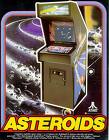
In 1979 the video game Asteroids by Atari, designed by Lyle Rains and Ed Logg becomes their bestselling game of all time; Logg goes on to design video games Centipede, Millipede, and Gauntlet.
On Sept. 24, 1979 CompuServe of Columbus, Ohio (founded 1969) begins operation as the first commercial computer information service providing commercial email; next year it is acquired by H&R Block; too bad, it charges by the hour instead of by the month, leaving the market wide open for America Online (AOL), which is founded in McLean, Va. in July by William F. Von Meister (1942-95) and Jack Taub, initially called the Source BBS (until 1983), causing Isaac Asimov to issue the soundbyte "This is the beginning of the information age"; AOL only has 55K subscribers by 1984, and peaks at 30M.
On May 8, 1979 Radio Shack releases the TRS-DOS (Trashdos) 2.3 (Tandy Radio Shack Disk Operating Ssytem) operating system for the Tandy TRS-80 line of 8-bit Zilog Z80 microprocessors.

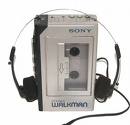
In 1979 the $199.95 Sony Walkman is first marketed, designed in 1978 by Nobutoshi Kihara (1926-) (inventor of the home video tape recorder in 1964) as a portable pocket hi-fidelity audio cassette player with earphones, and named in tribute to Superman, although chmn. Akio Morita hates the name, causing it to also be marketed under the names Soundabout, Freestyle, and Stowaway; it goes on to sell 220M units by the time it is discontinued in Apr. 2010; the first version has two earphone jacks since they assume people want to share, plus a cutoff button for conversation.
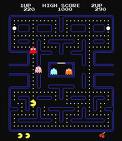
On May 22, 1980 the Pac-Man color video game by Namco, named after the big-eating Japanese folk hero Paku and the Japanese slang phrase "paku-paku taberu" meaning to open and close the mouth rapidly, and based on an idea from seeing a pizza missing a slice debuts in Japan, becoming a huge success (350K units) and launching the survival genre of video games; its yellow circle has a pellet-gobbling mouth and only requires 8 bits of computer memory; the original name was Puck Man, but the Bally div. of Midway changed it to prevent vandals from turning it into Fuck; on July 3, 1999 Billy L. Mitchell (1965-) of Hollywood, Fla. becomes the first player to achieve a perfect score of 3,333,360 points on all 255 levels.
On June 16, 1980 the U.S. Supreme Court rules 5-4 in Diamond v. Chakrabarty that microbes created by genetic engineering can be patented - arrest that crotch?

On Sept. 28, 1980 the 13-part Cosmos series, written and narrated by atheistic it's-all-right-Science-will-explain-everything Brooklyn, N.Y.-born astronomer Carl Edward Sagan (1934-96) debuts on PBS-TV; it is broadcast in 60+ countries to an audience of 400M, becoming the largest PBS audience until Ken Burns' "The Civil War" in 1990; makes the phrase "billions and billions" popular.
In summer 1980 IBM introduces its RISC (Reduced Instruction Set Computer) with the experimental IBM 801, reaching 15 MIPS.
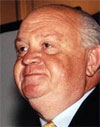
In 1980 Canadian scientists Adolpho J. de Bold (1942-) and Harald Sonnenberg demonstrate that the rat atrium produces a previously unknown atrial natriuretic polypeptide hormone that reduces blood pressure; Bruno Kirsh first observes the cell bodies that produce it; in 1984 de Bold isolates and analyzes Auriculin (Atriopeptin) (Cardionarin), AKA the heart hormone.
In 1980 Am. mathematician Robert Griess Jr. constructs the Monster Finite Simple Group, completing the classification of all finite simple groups begun in 1830.

In 1980 the Inflationary Universe Theory is proposed by MIT physicist Alan Harvey Guth (1947-), claiming that the Universe grew from a speck far smaller than a proton to grapefruit size in the first 10^-32 sec. after the Big Bang, and somehow gets around the Horizon Problem (the U looks the same on opposite sides of the sky) and the Flatness Problem (spacetime is flat, therefore it always sits on the dividing line between expansion and recollapse); "I call the Universe the ultimate free lunch" (Guth); in 1981 Russian physicist Andrei Linde (1948-) improves on his idea, and in 1983 he introduces a model for a chaotic inflationary Universe.
In 1980 Linn Mollenauer, Rogers H. Stolen, and James Gordon of Bell Labs show experimentally that Solitons can travel through optical fibers.
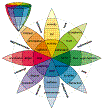
In 1980 Am. psychologist Robert Plutchik (1927-2006) proposes a 2-D/3-D wheel model to describe relations between human emotions.
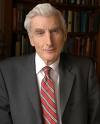
In 1980 Martin John Rees (1942-), Mitchell Begelman, and Roger Blanford predict the existence of Binary (Double) Black Holes.
In 1980 Charles Weissmann (1931-) of the U. of Geneva successfully uses a bacteria to produce human interferon.
In 1980 the antiobiotic Azithromycin (Zmax) (Zithromax) (Sumamed) is discovered by the Yugoslavian pharmaceutical co. Pliva, who patents it in 1981; in 1986 Pfizer obtains exclusive rights for distribution in W Europe and the U.S.
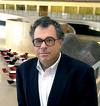

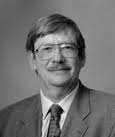
In 1980 In Apr. Am. biologist David Botstein (1942-), Am. biochemist Ronald Wayne "Ron" Davis (1941-), and Am. scientist Mark Henry Skolnick (1946-) propose DNA Sequencing to develop gene markers for genetic diseases based on a genetic linkage map using restriction fragment length polymmorphisms, leading to the Human Genome Project.
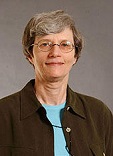
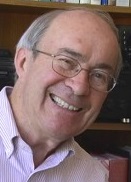
In 1980 Am. astronomers Susan Wyckoff and Peter A. Wehinger (1938-2015) of Germany discover a nebulous region around 3C 273, becoming the first known quasar, indicating that it might be in the center of a galaxy; Timothy J. Pearson et al. track a glowing blob ejected by the quasar from July 1977 to July 1980, and calculate an apparent speed of 9.6c, but reduce it to a real speed of 0.995c.
In 1980 U.S. geneticists discover Hypervariable Regions in Genes, short DNA sequences that repeat in the same chromosome.
In 1980 Eli Lilly Co. begins producing human insulin using genetically-altered bacteria that can be used by diabetics allergic to animal insulin.
In 1980 the Very Large Array (VLA) radio telescope in Socorro, N.M. begins operation, using 27 antennas to produce resolution equivalent to a 22-mi. (36km) dish.
On Sept. 30, 1980 the DIX (Digital/Intel/Xerox) std. for Ethernet is pub. by the IEEE, specifying 10M bits per sec. and a 16-bit type field.
In 1980 Sony, Philips, and PolyGram propose technical stds. for Compact Discs (CDs), which are accepted worldwide by next year, making commercial development possible.
In 1980 Hewlett-Packard introduces the first Laser Printer, the size of a desk and priced at $100K; they also introduce their first PC, the 8-bit 16KB RAM 32KB ROM HP-85.
In 1980 the first 1-900 pay-per-call telephone line in the U.S. is set up for the 1980 U.S. pres. debate by NBC-TV.
In 1980 the Group 3 Fax (Facsimile) Std. is created, allowing speeds of about 1 page per min.
In 1980 the French Post Office develops the $100M Telematique (Télématique) system to link telephones with centralized computerized phone directories, and raises the price of paper directories by 5x to discourage their use; telephone subscribers grow to 15M from 6M in 1974.

In 1980 Flash Memory, based on electrically-erasable programmable read-only memory (EEPROM) is invented by Fujio Masuoka (1943-) of Toshiba; the two basic types are NAND and NOR; it hits the market in 1988; by 1995 it has a storage capacity of 2MB.


In 1980 the WordPerfect 1.0 word processing program is introduced by Satellite Software Internat. in Provo, Utah, capturing more than half of the PC market until the clunkier Monopolysoft, er, Microsoft Word comes along; founders incl. Mormons Bruce Wayne Bastian (1948-) and his BYU instructor Alan C. Ashton (1942-).
In 1980 Arnold Klayman (1926-2008) patents the Sound Retrieval System, a psychoacoustic 3D audio technology based on head-related transfer functions to create a 3D effect using only two speakers; too bad, it doesn't save cheap stereo sets.
In 1980 Am. programmer Wayne Ratliff develops dBase II using the database program Vulcan I developed at the Jet Propulsion Labs in the late 1960s; it goes on to become the std. for PC filing systems.


In 1980 English inventor Sir Clive Marles Sinclair (1940-) develops the ultra-cheap £100 Sinclair ZX80/ZX81 computer, which is marketed in 1981 as the Timex-Sinclair, using a TV as a monitor and a home audio cassette recorder to store programs, along with a membrane keyboard; over 1M units are sold.
In 1980 IBM creates a voice recognition system using an IBM System 370/Model 168 computer, with a 1K-word vocabulary and 91% accuracy; Vortrax develops the SC-01 single-chip voice synthesizer with unlimited vocabulary using a separate chip to store phones with 6-bit words and a special circuit to turn phonemes into words.





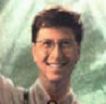




What do you have stamped on your forehead, the word Dopeface? The biggest business swindle of the century, or, every fortune has a crime behind it, or, Big Think IBM is out-IBMed and all's fair in love and war? On Dec. 1, 1980 after IBM employee William C. Lowe (1941-2013) convinces CEO Frank Cary to assemble the "dirty dozen" to build it, IBM delivers its first prototype PC, the IBM Model 5150 PC to its designer William Henry "Bill" Gates III (1955-), owner of Monopolysoft, er, Microsoft, who got their foot in the door via his mother Mary Maxwell Gates (1929-94), first woman chmn. of United Way, who talked fellow board member John Roberts Open (1925-2011) into giving him a contract, after which Bill talked the IBM lamers in Raton, Fla. into not patenting the design (based on Intel microprocessor chips), but instead to pitch it as an "open architecture" so that add-on hardware cos. will be attracted to it and hopefully every home and office in the world will end up with one one day; it is featured on the cover of issue #1 of PC Magazine; one little problemo, no operating system, and although he plans to supply his rinky-dink BASIC interpreters for it, Gates has never written a line of operating system code, so to make the deal go he does what he doesn't like and tells the IBM execs about competitor Gary Kildall (1942-94) of Digital Research, developer of the popular CP/M operating system for microprocessors, who has a Ph.D in computer science (vs. Gates, who is a college dropout), and owns all rights to his software; too bad, Killall, er, Kildall screws up his deal-of-the-century with them, allegedly standing up its reps to go flying, but not really, he just doesn't understand that Jaws is in the water nearby, and he has no lawyer daddy to help guide him through negotations, and is too easygoing and honest to believe he would be stolen blind, settling for an easygoing handshake deal and totally failing to see that just about everybody in the world will indeed end up having a PC one day; too bad, Big Blue IBM is also outfoxed for failing to see that mainframes (their main biz) are going to be made obsolete by PCS, and that opening the architecture will help their sales only at first, after which IBM PC clone manufacturers will move in like a school of sharks, creating a feeding frenzy and driving the margins down until only low-paid Third World workers will be making them, forcing high-price IBM out of the PC biz, while all PCs will have to host the operating system software, which thanks to internat. copyright laws can be squeezed for exorbitant profits forever, since it's just ones and zeroes and virtually all profit, and application software depends on it, making a new operating system design almost impossible; hearing that Kildall didn't shut him down with ironclad legal agreements in triplicate, on July 27, 1981 Jaws Gates takes his main chance and purchases the 4K-line QDOS (Quick and Dirty) Operating System (AKA 86-DOS) from software pirate, er, developer Tim Paterson (1956-) of nearby Seattle Computer Products (who reverse-engineered Kildall's software) for $25K, then changes a few lines of code, renames it to PC-DOS and MS-DOS, and tenaciously sucks the chrome, er, courts IBM via his board member mother until they sign an ironclad deal to market it with their PCs, after which IBM introduces the IBM PC on Aug. 12, 1981; poor Kildall doesn't figure it out for a year, by which time he's locked out, and then he proves he's no Bill Gates by not immediately going to court to sue for trade secret and copyright infringement and owning Microsoft, instead accepting a deal to market his operating system in parallel with Microsoft's, at an unaffordable price which nobody wants, letting Gates walk away with the store and get rich on his work while the judge wonders when he's going to get a case and never does; later, as Microsoft's Magic Carpet takes off without him and flies to the highest heavens, Kildall becomes a bitter alcoholic and suffers an early death; meanwhile stingy zillionaire-in-the-making Gates jealously guards his magic carpet, using the endless bucks coming in to hire programmers right out of college to pump-up "his" code to millions of lines and forcing PC customers to buy endless upgrades and new versions, while hiring a large legal staff to zealously guard his copyright and trade secret rights in the fear that yet others will clone his software and undercut him; he never actually sells software, only licenses it to end-users to use on one PC at a time, with the right only to make a single backup copy, thanks daddy you're a great lawyer?; of course, IBM blows it even worse, since they could have cloned the software themselves and done it all in-house, but they're too honest to be accused of stealing?; Microsoft later pays Seattle Computer Products $925K to settle out of court for the Deal of the Century, and bows to U.S. Dept. of Justice pressure by making its license non-exclusive to allow for DOS clones, which they make hard to create by constantly revising the software in endless versions; meanwhile closes-his-eyes-while-shaving Gates doesn't offer Kildall even a tiny piece of his action, or admit that he's made enough and release the source code to the public to allow the millions of eager programmers out there to take it over and make it free, so the next Rockefeller is born, calling himself the world's greatest genius; within years Gates goes public and now it would be a crime to give away the corporation's magic carpet ride as a betrayal of the stockholders, and Microsoft wouldn't even want to hire Kildall as a consultant because the industry has moved on and Kildall is considered obsolete?; hooray for Capitalism, the good guy lost?; but we're not done: now Monopoly Soft Gates invites potential software competitors to create and market application software for the IBM PC, pretending not to be in that business, even selling them the support software (assemblers and compilers, so all the application software will say Microsoft Inside), while insuring that only his software is preinstalled before a customer gets the PC, while competitive application software is forced into an aftermarket, which is subject to massive illegal copying, allowing him to eventually buy them out, repackage their software work as his own, and have it preinstalled too, creating a total software monopoly, meanwhile busily sending legions of lawyers out to pressure software dealers into agreeing only to preinstall their cruddy software in case application developers get ideas, while he fools the govt. into not intervening because it looks like everybody is free to create superior software, even though in the face of the rigged game he's set up they can't give away, until they go bust, give up and sell out to him; the fact that consumers are mainly computer illiterate makes it super-easy to push inferior Microsoft weeny-written software on them and keeps them immune to technical reviews that try to tell the customers what is best, when the dopes see the Microsoft logo every time they boot their PCs up, so they can't say no to Big Brother? - looking back on it, TLW coulda reverse-engineered MS-DOS and given it to the public for free, so sue me, but so could have a lot of people, and now it's too late, call 1-800-software-steamer? The real question is: if the Jews run the world what did they have to do with this, other than when it went public and absorbed it into their worldwide monetary system? What if Gates had been a neo-Nazi?
On Nov. 16, 1981 the U.S. FDA approves a vaccine for hepatitis B made from human blood by the Merk Inst. in Philly; the genetic code for the hepatitis B surface antigen is found; in 1986 the first genetically-engineered Hepatitis B Vaccine gains FDA approval.
In 1981 Beecham Co. of Britain introduces Augmentin, a broad spectrum antibiotic.
In 1981 the anti-ulcer stomach acid inhibitor drug Zantac (Ranitidine) is introduced by Glaxo Pharmaceuticals of Britain, competing with SmithKline's Tagamet approved by the FDA in 1977, claiming fewer side effects and becoming the world's largest-selling prescription drug by 1986.
In 1981 the genes for poliomyelitis and influenza A virus are sequenced.
In 1981 scientists at Ohio U. in Athens become the first to transfer genes from one animal species to another, transferring the gene for rat growth hormone to mice embryos, causing some to grow to double size.

In 1981 Elizabeth Helen Blackburn (1948-), Jack William Szostak (1952-), and Carolyn Widney "Carol" Greider (1961-) of the U.S. begin research on DNA; in 1982 Blackburn and Szostak discover Telomeres; 1984 Grider and Blackburn discover their role in aging and the role of the enzyme telomerase in protecting them from progressive shortening, winning them the 2009 Nobel Med. Prize.
In 1981 English scientist Sir Martin John Evans (1941-) discovers how to culture embronic stem cells, becoming the father of stem cell research.
In 1981 Alexander H. Harcourt et al. relate monogamy, polygny, and promiscuity in primate species to avg. body weight and testes weight, with large testes compared to body size correlating with promiscuity.
In 1981 Am. physicist Duncan Haldane predicts that at low temp electrons will split into two new types of particle called Spinons and Holons; verified in 2009 by physicists from Cambridge U. and the U. of Birmingham inside a quantum wire.

In 1981 Pakistani economist Mahbub ul Haq (1934-98) et al. propose the Human Development Index (HDI), combining life expectancy at birth, adult literacy rate, and standard of living to obtain a number from 0-1.

In 1981 Vienna-born Eric Richard Kandel (1929-) et al. of Columbia U. discover the role of serotinin as a neurotransmitter, and how protein kinase (PKA) acts in the biochemical pathway in response to elevated levels of cyclic AMP (cAMP), giving them a clue as to how short-term memories are converted into long-term memories.
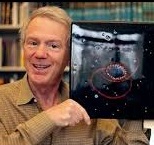
In 1981 Am. astronomers Robert P. Kirshner (1949-) of Harvard U., Augustus Oemler Jr. of Yale U., and Paul L. Schechter and Stephen A. Schectman of Mount Wilson and Las Campanas Observatories discover the spherical giant Bootes (Boötes) (Great) Void of 330M l.y. diam. in the constellation Bootes.

In 1981 German physicist Klaus von Klitzing (1943-) discovers the Integer Quantum Hall Effect, allowing the internat. value of the ohm to be defined, winning the 1985 Nobel Physics Prize.
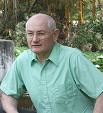
In 1981 Romanian-born Jewish Princeton U. physicist Mordehai Milgrom (1946-) proposes Modified Newtonian Dynamics (MOND) to elminate the need for dark matter.



In 1981 German geneticist Christiane Nusslein-Volhard (Nüsslein-Volhard) (1942-) and Am. biologist Eric F. Weischaus (1947-) identify genes in the fruit fly Drosophila that serve as markers for body shape and organ arrangement, winning them the 1995 Nobel Med. Prize along with Am. geneticist Edward B. Lewis (1918-2004).
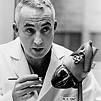
In 1981 Dr. Norman E. Shumway (1923-2006) and Dr. Bruce Reitz of Stanford U. perform the first Heart-Lung Transplant.


In 1981 Charles Gald Sibley (1917-98) and Jon Edward Ahlquist of Yale U. use DNA to revise the evolutionary relationships between flightless birds incl. the ostrich and emu.

In 1981 Hungarian-born George Streisinger (1927-84) et al. of the U. of Ore. produce a cloned zebra fish.

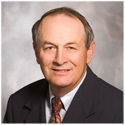
On Aug. 12, 1981 IBM unveils the IBM Personal Computer (PC) Model 5150, grabbing 75% of the market; it sells for $5K, has a 4.77MHz Intel 8080 CPU with 330KIPS throughput, 16KB-256KB of RAM, two 160KB floppy drives, and a B&W text mode monitor; the IBM development team is led by Lewis C. Eggebrecht (1944-). On Mar. 8, 1983 the IBM PC-XT is introduced, becoming the first PC with a built-in hard drive, initially 10MB; David Bradley invents the ctrl-alt-del system restart key combo. In 1984 the IBM PC/AT (Advanced Technology) features a 16-bit bus and 6MHz (later 8MHz) Intel 80286 microprocessor.


In 1981 the Scanning Tunneling Microscope (STM) is invented by IBM researchers Gerd Binnig (1947-) and Heinrich Rohrer (1933-).

In 1981 after being laid off from Boeing during an aerospace industry cutback, Peter Norton (1943-) of Seattle, Wash. buys one of the first IBM PCs and begins releasing Norton Utilities, starting with UnErase to recover deleted files, going on to create anti-virus software then sell out to Symantec Corp. in 1990 for $70M and use his profits to build a large modern art collection.

In 1981 San Francisco, Calif.-born David Cope (1941-) creates Experiments in Musical Intelligence (EMI), a computer music-composing program that emulates the style of great composers to tin ears.
In 1981 Adam Heller (1933-), Barry Miller (1933-), and Ferdinand A. Thiel of the U.S. invent a Liquid Junction Cell that converts 11.5% of solar energy to electricity.


In Apr. 1981 Bangkok-born U.S. engineer Adam Osborne (1939-2003) introduces the Osborne I, the first commercially successful portable PC, weighing 23.5 lb. and priced at $1,795, hosting the CP/M 2.2 operating system along with word processing and spreadsheet software; too bad, after preannouncing two advanced versions, causing customers to quit buying the model he has on the market, he goes bankrupt on Sept. 13, 1983, causing the term "Osborne Effect" to be coined.

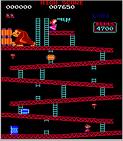

On July 9, 1981 Nintendo releases Donkey Kong (originally Jumpman), featuring Mario the Plumber, designed by Shigeru Miyamoto (1952-), which causes a video game rev.; on July 14, 1983 Ninetendo releases Mario Bros., featuring Mario and Luigi, who have to fight creatures coming out of the sewers by flipping them on their backs and kicking them away.
In 1981 Smith Corona (founded 1886) introduces its first word processor, with a tiny screen and a small memory that only holds a few lines of text; despite being priced way below a desktop PC, it is a dud and the co. goes bankrupt in 1995.
In 1981 Xerox releases the $16K Xerox Star 8010, becoming the first consumer GUI (graphical user interface) computer, using icons and a mouse; it flops.
In 1981 Luxor AB introduces the Luxor ABC 800 computer for office use, with a 3.58 MHz Z80 CPU, a CRT with 8-color 80x24 text mode capability, two 5.25 in.floppy disk units, and a built-in BASIC interpreter.
In 1981 the Sony Mavica electronic still camera records images on a mini-disc that can be connected to a TV monitor or color printer, becoming the first consumer quasi-digital camera.
In 1981 Visicorp releases Visicorp Vision, the first integrated software package for PCs, combining a word processor, spreadsheet, and database.
On Feb. 14, 1982 (night) Stanford U. physicist Blas Cabrera records the first detection of a Magnetic Monopole; too bad, no one else can confirm it (until ?).



On Aug. 29, 1982 Peter Armbruster (1931-) and Gottfried Munzenberg (Münzenberg) (1940-) of the Inst. for Heavy Ion Research (GSI) in Darmstadt, Germany synthesize the synthetic radioactive element Meitnerium (#106) (Mt), named after Austrian physicist Lise Meitner (1878-1968).

In 1982 French physicist Alain Aspect (1947-) et al. create the first pair of Entangled Polarized Photons in the lab, confirming Bell's 1964 theory of "spooky action at a distance".


In 1982 Am. chemist Thomas Robert Cech (1947-) discovers that RNA can act as a catalyst and participate in cellular reactions, incl. on ribosomes; in 1984 Sidney Altman (1939-) independently discovers Catalytic RNA, winning them the 1989 Nobel Chem. Prize.


In 1982 Western Australian physician Barry James Marshall (1951-) and pathologist John Robin Warren (1937-) of Royal Perth Hospital propose that the "unidentified curved bacillus" Helicobacter pylori is the cause of peptic ulcer and gastric cancer, not spicy foods or emotional distress, fighting skepticism for years until proving it, then winning the 2005 Nobel Med. Prize; 80% of ulcer patients are permanently cured with antibiotics.

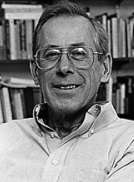



In 1982 Am. cosmologists Joel R. Primack (1945-), Phillip James Edwin "Jim" Peebles (1935-), George R. Blumenthal (1945-), pub. a theory of slow-moving (less than c) Cold Dark Matter, claiming that most of the matter in the Universe can't be observed, and explaining how it went from a smooth initial state to the current lumpy distribution of galaxies and clusters; in 1984 an influential review article by Primack, Blumenthal, Sandra Moore Faber (1944-), and Martin John Rees (1942-) popularizes the theory - Big Science's pie in the sky?
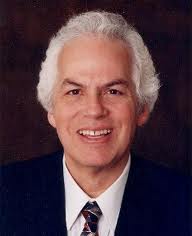
In 1982 a new infectious but non-replicating agent called a Prion (from "proteinaceous" and "infectious") is discovered by U. of Calif. neurologist Stanley Ben Prusiner (1942-) and proposed as the cause of spongiform encephalopathy diseases incl. scapie (in sheep), BSE (mad cow disease), and Creutzfeldt-Jakob Disease (humans), winning the 1997 Nobel Med. Prize.
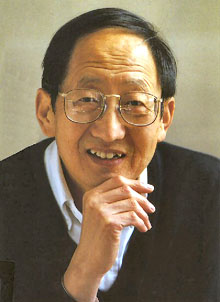


In 1982 physicists Daniel Chee Tsui (1939-) and Horst Ludwig Stormer (Störmer) (1949-) of Bell Labs first observe the Hall Effect in semiconductors close to absolute zero under powerful magnetic fields, discovering that it varies in fractional as well as stepwide increments; next year Robert Betts Laughlin (1950-) of Stanford U. discovers that the electron gas condenses to form a new type of quantum fluid where each electron combines with three flux quanta to form a boson, which can be excited by another electron to create fractionally charged quasiparticles, winning all three shares in the 1998 Nobel Physics Prize; in 2005 Laughlin pub. A Different Universe: Reinventing Physics from the Bottom Down; by the 1998 Nobel Prize Winner who doubts the existence of black holes; how the fact that there are simple laws doesn't help when trying to understand why football crowds suddenly begin singing in unison, arguing for emergence as the replacement for reductionism; "Physics is now in the midst of a crisis, an ideological battle. The most fundamental things you know may not be fundamental" - whoops there goes gravity?
On Jan. 13, 1982 Boeing introduces the Boeing 757 narrow-body twinjet airplane, capable of carrying 186-279 passengers up to 3.9K nautical mi.
In Aug. 1982 Royal Philips Electronics manufactures the world's first 120mm (4.7 in.) diam. plastic Compact Disc (CD) in Langenagen, near Hanover, Germany (where Emil Berliner produced the first gramophone record in 1889); on Aug. 17 the first ones are released to the public in Germany, followed on Oct. 1 by the Sony CDP-101 model in the U.S., launching a rev. in the music industry as it shifts from analog to digital. 186-279 passengers up to 3.9K nautical mi.


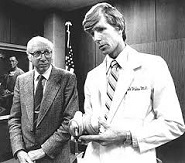

On Dec. 2, 1982 the aluminum-plastic Jarvik-7, the first artificial human heart, designed by Mich.-born engineer Robert Koffler Jarvik (1946-) and Dutch-born dialysis pioneer ("Father of Artificial Organs") Willem Johan "Pim" Kolff (1911-2009) is transplanted into retired dentist Dr. Barney Clark (1921-83) (inventor of kidney dialysis) by a good hands team of surgeons led by William Castle DeVries (1943-) from Cape Town, South Africa at the U. of Utah Medical Center in Salt Lake City; he lives 112 days with the device (until Mar. 23, 1983), which requires him to remain connected to a compressed-air machine.
In 1982 after his wife Judith notes that obese people consume carbohydrates to raise brain serotonin levels, Richard J. Wurtman receives a U.S. patent for the use of the French diet drug Dexfenfluramine for raising brain serotonin levels to help control obesity.
In 1982 a team of four Australian astronomers discovers a quasar hundreds of times brighter than the Milky Way Galaxy more than 10B l.y. from Earth and traveling at 180K mi. per sec. (nearly the speed of light) on Mar. 25 - Beelzebub has a son?
In 1982 Eli Lilly and Co. obtains FDA approval to market Humulin synthetic human insulin produced by Escherichia coli bacteria (developed by Genentech in 1978), becoming the first commercial genetic engineering product, and causing Recombinant DNA (rDNA) to go bigtime, causing a race to create new products, incl. Human Growth Hormone (HGH), Tumor Necrosis Factor (TNF), and Tissue Plasminogen Activator (TPA); the first genetically-engineered crop plant is developed, a tomato.
In 1982 Gaston Glock (1929-) of Austria introduces the 9mm Glock 17 plastic (polymer) semi-automatic pistol, freaking out security cos. with the ability to pass radar inspections; by 1992 350K have been sold.
In 1982 the 16-bit Intel 80286 microchip is introduced on Feb. 1, containing 134K transistors (vs. 29K for the 8088 in 1978).
In 1982 IBM releases PC-DOS Version 1.1 on May 8; meanwhile 10 mo. after the IBM PC is introduced, Columbia Data Products announces the first PC clone.
In 1982 Microsoft Multiplan (original name "Electronic Paper") PC spreadsheet program is introduced to compete with Visicalc (1979), using Microsoft's ability to bundle its application software with the operating system to systematically drive all rivals out of business.
In 1982 Elk Cloner becomes the world's first PC virus, spreading through Apple II floppy discs and displaying a poem by its author, a 9th grade student who did it for a practical joke - shoulda been awarded a Nobel, at least a Pulitzer?
In 1982 Texas Instruments engineer Gordon Matthews (1936-2002) patents Voicemail; in 1987 Gregory C. Carr (1959-) and Scott A. Jones (1960-) found Boston Technology, becoming the first to sell voicemail to telephone cos.
In 1982 the French Post Office launches the Minitel Videotex online service, accessed through telephone lines, becoming a precursor to the World Wide Web.
In 1982 Joseph H. "Joe" Condon and Ken Tompson (1943-) of Bell Labs develop the BELLE chess-playing computer, which contains 1.7K chips and can evaluate 160K positions per sec; it comes in 2nd at the 1982 U.S. Nat. Open Speed Chess Tournament.
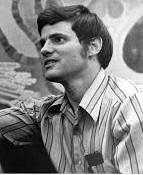
In 1982 Applied Biosystems begins marketing an automated gene sequencer based on the work of Leroy Edward "Lee" Hood (1938-) of Caltech that can sequence 18K uncorrected bases a day, compared to several hundred a year by hand.
In 1982 Alsace-born Am. astronomy student Martine Kempf (1959-) designs the Katalavox PC voice recognition system, which initially operates a car, followed next year by an electric wheelchair, followed in 1984 by microsurgery to permit physicians to operate a microscope by voice commands.
In 1982 John F. Shoch and Jon A. Hupp of Xerox Palo Alto Research Center in Calif. develop the first computer worm program that runs in segments on multiple computers.
In 1982 Christopher J. Nicholson of the Nat. Geographical Society develops a lightweight underwater robot camera that can handle 150m (500 ft.) depth.

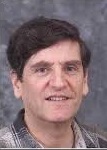
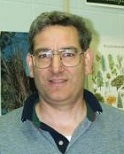
In 1983 Am. mathematicians Leonard Max Adelman (1945-), Carl Bernard Pomerance (1944-), and Robert Scott Rumely (1952-) of USC pub. the Adelman-Pomerance_Rumely Primality Test, an improved computer test for prime numbers, which is later improved by Henri Cohen and Hendrik Willem Lenstra; in 1994 Adelman uses DNA in a test tube to solve a simple 7-node mathematical problem, making DNA Computers a possibility.
In 1983 John Buster and Maria Bustilla of UCLA perform the first successful Human Embryo Transfer - Busta jokes here?
In 1983 Brazilian mathematics grad student Celso Costa mathematically describes the first new non-self-intersecting (embedded) minimal surface in over a cent.; James Hoffman of the U. of Mass. generates computer pictures proving him right - is that a 3 or 4-sheeter?
In 1983 Fernand Daffos becomes the first physician to use fetal blood for diagnosis of fetal disease.
In 1983 Kay Davies and Robert Williamson of Oxford U. discover a gene marker for Duchenne Muscular Dystrophy.
In June 1983 Jacques Genest et al. identify the hormone produced by the heart that regulates blood pressure; in Aug. it is synthesized by a team led by Ruth F. Nutt.
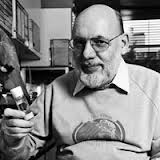
In 1983 Walter Jakob Gehring (1939-) et al. of the U. of Basel discover the Homeobox DNA sequence in genes in vertebrates and arthropods, which directs segmentation.
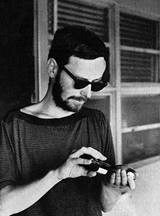
In 1983 German-born Am. psychologist Ralph Metzner (1936-) coins the term "empathogen" for chemical agents such as MDMA (Ecstasy) that produce feelings of empathy.



In May 1983 a team led by Luc Montagnier (1932-) of the Pasteur Inst. in France isolates the HIV-1 (human immunodeficiency) virus; Robert Charles Gallo (1937-) of the U.S. determines that it causes AIDS after Myron "Max" Essex becomes the first to link animal and human retroviruses to immunosuppresive disease and determine that HIV can be transmitted via blood and blood products; next Jan. 21 Montagnier pub. the genetic code of HIV-1, and next year Gallo develops a blood test for the virus that causes AIDS, which he calls HTLV-2,then on June 13, 1984 he pub. the genetic code for HTLV-3 (human T-cell leukemia virus type 3); next Aug. 6 the Centers for Disease Control report infecting chimpanzees with HIV, a key step toward developing a vaccine; they call HIV-1 lymphadenopathy-associated virus (LAV) until 1987 when HIV-2 is discovered by the same team; Montagnier wins the 2008 Nobel Med. Prize.

In 1983 Am. chemist Kary Banks Mullis (1944-) discovers DNA Amplification, splitting the DNA in a single cell into two strands then starting a Polymerase Chain Reaction (PCR) that creates millions of identical pieces, becoming a breakthrough for genetic research and winning him the 1993 Nobel Chem. Prize.

In 1983 British mathematician Howell Peregrine (1938-2007) discovers the Peregrine Soliton, a new nonlinear entity that may explain the formation of rogue waves in hydrodynamics that appear out of nowhere and disappear without a trace, and which becomes the defining object of nonlinear science; it takes until 2010 (3 years after his death) for the first physical example of it to be observed.
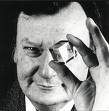

In Jan. 1983 a team at CERN in Geneva led by Italian physicist Carlo Rubbia (1934-) detects the charged W and neutral Z bosons, which are believed to carry the weak force causing radioactive decay in the atomic nucleus, and support the electroweak theory, ending a 40-year search; the discovery was made possible by Dutch physicist Simon van der Meer (1925-2011), who invented stochastic cooling; the W-particles are needed to make other particles interact in certain ways to aid the search for the Holy Grail of particles, the top quarks; Rubbia and van der Meer are awarded a quick 1984 Nobel Physics Prize.
In 1983 Jack William Szostak (1952-) of Mass. Gen. Hospital and Andrew W. Murray of Harvard U. create the Yeast Artificial Chromosome (YAC), the first artificial chromosome.
In Sept. 1983 Cambridge-educated anthropologist John Hathaway Winslow pub. an article with Alfred Meyer in Science 83 titled The Perpetrator of Piltdown, suggesting Arthur Conan Doyle as the man behind the Piltdown Hoax - elementary my dear Watson jokes here?
In 1983 T-10, the Theoretical Biology and Biophysics Group at Los Alamos Nat. Lab founds GenBank, a public genetic sequence database later used by the Human Genome Project.
In 1983 Amgen Inc. of Calif. (founded 1980) discovers the Erythropoietin (EPO) Gene, which promotes the growth of red blood cells, marketing it in 1989 and revolutionizing the treatment of anemia.
In Feb. 1983 an article in Annals of Internal Medicine claims that patients with surgically-removed small intestines experience Vitamin E deficiency, helping boost the popularity of supplements.
In July 1983 the Tevatron particle accelerator at Fermilab performs its first run, producing a record 412 Gev by subatomic particle collision.
In May 1983 the Proceedings of the Nat. Academy of Sciences, and Seminars in Oncology in Sept. pub. articles linking high rates of stomach cancer in Japan to fish preserved with nitrate-containing crude salt or saltpeter that produce nitrosamines.
On Nov. 10, 1983 the USDA approves the drug Etoposide for use in treatment of testicular cancer; on Nov. 14 they approve the immunosuppressant Cyclosporine (Ciclosporin) for use in organ transplants.
In 1983 scientists studying the South Pole find a "hole" the size of the U.S. in the ozone layer of the atmosphere over Antarctica; they report it in Mar. 1985.
In 1983 Ibuprofen, patented in 1961 by Boots Co. receives over-the-counter drug status in the U.K.
In 1983 a Neanderthal skeleton is dug up in Haifa, Israel - maybe he can settle who has the historical claim to it?
On Mar. 8, 1983 The IBM PC-XT is introduced, becoming the first PC with a built-in hard drive, initially 10MB.
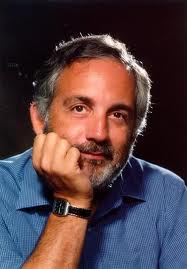

On Jan. 26, 1983 Lotus Development Corp., founded by Mitchell David "Mitch" Kapor (1950-) and programmer Jonathan Sachs (1947-) releases 1-2-3 spreadsheet software for the IBM PC to compete with Visicalc (1979) and Microsoft Multiplan (1982), featuring integrated charting/graphing and database capabilities (the 1-2-3 part), and becoming the IBM PC's first killer app, its speed coming from being coded in 8086 assembly language, becoming the first PC software to be advertised on TV; IBM buys the co. in 1995 for $3.5B.
In 1983 Knight Ridder newspapers launch their Viewtron system, becoming the first newspaper publisher to use videotex; too bad, after spending $50M on it, they discontinue it in 1986 because it is wooing away its print newspaper readers.
In 1983 Great Britain pioneers carbon-fiber aircraft wings. Biopol biodegradable polymer plastic is invented by ICJ Agricultural Div. in England. Cambridge Life Sciences in England pioneers biosensors.

In 1983 Japanese ANSA Fone inventor (1954) Kazuo Hashimoto (-1995) invents the digital telephone answering device.
In 1983 Apple Computer introduces the clunky Lisa (Local Integrated Software Architecture) home computer; it proves a market dud although its mouse-based GUI (graphics user interface) (stolen from the 1981 Xerox Star) becomes the basis of the 1984 Macintosh.
In 1983 Radio Shack introduces the Tandy/Radio Shack Model 100, the first laptop computer, running on four AA batteries, with an 8-row 40-col. LCD display.
In 1983 Nintendo introduces its first home video game console in Japan.
In 1983 Kodak introduces the Kodak Disk Camera, using an 8x11 mm frame, the same as in the Mintolta spy camera.
In 1983 Hal Roach Studios in Calif. pioneers Film Colorization, digitally coloring several Laurel & Hardy features, Frank Capra's "It's a Wonderful Life", and other popular B&W films.

In 1983 Australian-born electrical engineer Ronald Newbold Bracewell (1921-2007) of Stanford U. discovers the Fast Hartley-Bracewell Algorithm that can replace the Fast Fourier Transform (FFT).
On Sept. 27, 1983 the GNU Project is announced on the Internet to coordinate the release of free software source code, allowing a charge for distribution.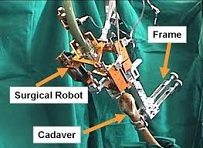
In 1983 Arthrobot, developed by engineer James McEwen, physician Brian Day (1947-) et al. of the U. of British Columbia becomes the first robot to assist in robot-assisted surgery in Vancouver, Canada.
On Jan. 17, 1984 the U.S. Supreme Court rules 5-4 in Sony Corp. v. Universal City Studios that home videotape recording doesn't infringe copyrights; Stevens writes the majority opinion, and Blackmun, Marshall, Powell and Rehnquist dissent.

On Feb. 3, 1984 John Edmond Buster (1941-) et al. of Harbor-UCLA Medical Center announce the first woman-to-woman embryo transfer resulting in a live birth.




In 1984 Peter Armbruster (1931-) and Gottfried Muenzenberg (Münzenberg) (1940-) of the Inst. for Heavy Ion Research (GSI) in Darmstadt, Germany synthesize the synthetic radioactive element Hassium (Hs) (#108), named after the German state of Hesse. In 1994 they discover the radioactive synthetic elements Darmstadtium (Ds) (#110) and Roentgenium (Rg) (#111), named after German physicist Wilhelm Konrad Roentgen (Röntgen) (1845-1923); in 1998 they discover the radioactive synthetic element Copernicium (Cn) (#112), named after Polish astronomer Nicolaus Copernicus (1473-1543).
In 1984 Michael G.L. Baillie et al. of Queen's U. in Belfast, Northern Ireland use Irish oak trees to establish an unbroken tree-ring chronology back 7,272 years.
In 1984 Andre Brahic, William B. Hubbard, Harold J. Reitsema et al. discover a partial ring around Neptune during a star occultation; meanwhile J.C. Bhattacharyya et al. of the Indian Inst. of Astrophysics discover two new rings of Saturn.

In 1984 Italian-born Am. scientist Mario Ramberg Capecchi (1937-), who started out as a feral child in WWII Italy and ended up a student of James D. Watson invents Homologous Recombination, allowing transgenic DNA to be injected into mammalian DNA to change its genetic makeup, going on to develop the first knockout mice with targeted mutations in 1989, winning the 2007 Nobel Med. Prize along with Italian-born scientist Oliver Smithies (1925-2017) and British biologist Sir Martin John Evans (1941-), who independently discover the technique.
In 1984 William H. Clewell of the U. of Colo. performs the first successful surgery on a fetus before birth.
In 1984 Elizabeth Craze (1982-) becomes the youngest patient to survive a heart transplant operation (by Dr. Norman Shumway of Stanford); she grows up to play high school volleyball.

In 1984 Robert Lull Forward (1932-2002) of Hughes Aircraft proposes using a sail for space travel propelled by a laser operating from an Earth orbit or the surface of the Moon that could reach nearby stars - lull forward jokes here?
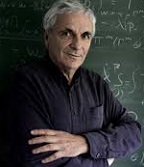

In 1984 British physicist Michael Boris Green (1946-) and Am. physicist John Henry Schwarz (1941-) prove that Superstring Theory is free from quantum anomalies if the space-time dimension is 10 and the quantum gauge symmetry is the mathematical group SO(32) or E8 x E8, making it suddenly popular with physicists.
In 1984 Jean-Marc Halbout and Daniel Grischkowsky of IBM develop a laser that emits pulses of 12 femtosec. length.

On Sept. 15, 1984 British geneticist Sir Alec John Jeffreys (1950-) of the U. of Leicester et al. announce that DNA sequencing is unique, and can be used for DNA Fingerprinting (Typing) Gel Electrophoresis); it becomes commercially available in 1987 after the discovery of the Polymerase Chain Reaction (PCR).
In 1984 Dennis L. Matthews builds the first successful Soft X-Ray Laser in a selenium plasma.

In 1984 Katharine Boynton "Katy" Payne (1937-) of Cornell U. discovers that elephants use infrasonic sounds to communicate that are too low for humans to hear.
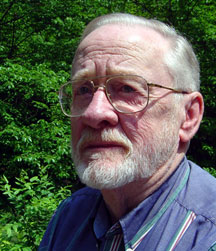

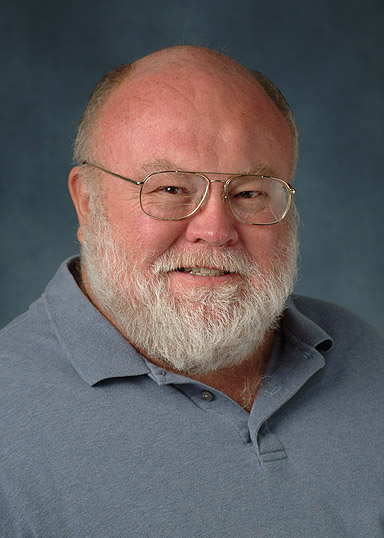
In 1984 the Sun's possible dim low-mass red or white dwarf star hidden companion Nemesis, orbiting at 50K-100K AU is proposed by Am. paleontologists David M. Raup (1933-) and J. John Sepkoski Jr. (1948-99) to explain an alleged 27M-y. cycle in mass extinctions; there's 16M years left before the next peak in the cycle; in 2010 Adrian L. Melott of the U. of Kan. et al. point out that if Nemesis existed its orbital period would change by 20%-50% due to gravitational attraction of nearby stars, killing the theory.
In 1984 Norman Rosenthal et al. identify Seasonal Affective Disorder (SAD).
In 1984 Dany Schechtman et al. of the Nat. Bureau of Standards discover the first Quasicrystal, an alloy of aluminum and manganese with fivefold symmetry.
In 1984 Robert Sinsheimer of the U. of Calif. at Santa Cruz proposes mapping all the genes in a human being, leading to the Human Genome Project.
In 1984 Am. geologist Roberta "Robbie" Score finds the Martian meteorite labeled Allan Hills (ALH) 84001 on Dec. 27 while snowmobiling in the Antarctic; later it is claimed that fossil evidence of Martian life is found in it.


In 1984 Charles Gald Sibley (1917-98) and Jon Edward Ahlquist of Yale U. find that gene sequences from humans and chimps react more strongly together than those from gorillas and chimps, and conclude that they diverged about 5M-6M years ago; later studies on gene sequences find a 1.6% human-chimp difference and a 2.1% gorilla-chimp difference; "More and more people are beginning to believe that chimpanzees and human beings are on one side of a great gulf, while the other apes are on the other side" (Isaac Asimov) - well throw clods out of my butt?
In 1984 Bradford A. Smith of the U. of Ariz. and Richard J. Terrile of NASA photograph a planetary system in formation around the star Beta Pictoris.

In 1984 Danish embryologist Steen Malte Willadsen (1944-) becomes the first to claim to clone a mammal (sheep) from differentiated cell embryos, causing biologists James F. McGrath and David Solter to pub. an article in Science on Dec. 14 saying that "The cloning of mammals, by simple nuclear transfer, is biologically impossible."
In 1984 Allan Wilson and Russell Higuchi of UCB become the first to clone genes from an extinct species, the quagga.
In 1984 the genomes of the virus that causes Hepatitis B and one of the common cold viruses (human rhinovirus type 14) are sequenced.
In 1984 the first transgenic farm animals (sheep and pigs) are born.
In 1984 astronomers at Cambridge U. use an 88-in. reflector in Hawaii to make the first astronomical measurements using interferometry.
In 1984 Soviet researchers reach the Earth's lower crust at 7.5 mi. (12km) in the Kola Hole.
In Jan. 1984 MacPaint by Bill Atkinson is released for the Apple Macintosh, becoming the first PC drawing program, with innovations incl. the paint bucket for filling closed areas with a pattern or color, and the lasso tool for selecting non-rectangular shapes; the graphics created can be used in other apps.
On Dec. 20, 1984 Bell Labs announces a 1MB RAM chip, 4x as big as anything previously available.
In 1984 the IBM PC/AT (Advanced Technology) is introduced, featuring a 16-bit bus and 6MHz (later 8MHz) Intel 80286 microprocessor.
In 1984 Bob Boie of Bell Labs develops the first Multitouch Screen Overlay.

In 1984 the Tech. U. of Berlin pub. the first study of computer viruses, incl. Friday 13, Holland Girl, Trojan Horse, and Christmas Tree; Am. computer scientists Leonard Max Adleman (1945-) and Frederick B. "Fred" Cohen coin the term "computer virus" in the paper Experiments with Computer Viruses; in 1987 Cohen proves that no algorithm can detect all possible viruses, and also coins the term "positive viruses" for viruses that do good.
In 1984 Paul Mockapetris of USC invents the domain name system for the Internet, incl. suffixes .com, .edu, and .gov.
In 1984 Hewlett-Packard introduces the $3.5K B&W HP Thinkjet, the first inkjet printer for PCs, originally developed at Xerox Parc in Calif. and licensed from Canon in Japan; next year Canon introduces the Canon BJ-80, the first Bubble Jet Printer; in Feb. 1988 HP introduces the $995 2 ppm HP DeskJet, the first mass-market inkjet printer.
In 1984 Prodigy, the first consumer online service is founded by CBS, IBM, and Sears.

In 1984 Kurzweil Music Systems, founded in 1982 by Raymond "Ray" Kurzweil (1948-) (who appeared on "I've Got a Secret" on CBS-TV in 1965 to perform a piano position composed by his homemade computer, then won first prize in the Internat. Science Fair for it) introduces the Kurzweil 250 portable digital keyboard that can store up to 30 instruments in ROM.
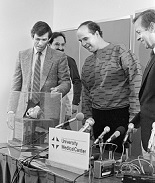
On Sept. 8, 1985 Michael Drummond (1960-90) undergoes an operation at the U. of Ariz. Medical Center in Tucson to replace his artificial heart with a real one from a donor in Tyler, Tex., becoming the first patient successfully given an artificial heart to buy time until he can receive a human one.
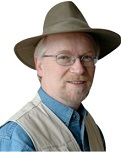
On Dec. 5, 1985 UCLA physics student Shawn Carlson (1960-) pub. the paper A double-blind test of astrology in Nature mag., proving that 28 top astrologers couldn't predict a person's personality based on date and time of birth better than random chance, effectively killing it as a serious scientific discipline.
In 1985 the first environmental release of genetically-engineered Ice-Minus Bacteria (Pseudomonas syringae) to protect crops from frost is approved in the U.S.


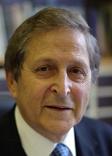
In 1985 Am. physicists Steven Chu (1948-) and William Daniel Phillips (1948-) of Stanford U., and Claude Cohen-Tannoudji (1933-) of France pioneer Doppler laser cooling, using intersecting laser beams to cool and trap atoms almost to absolute zero, slowing them from 4K km/hour to 1 km/hour, winning them the 1997 Nobel Physics Prize.
In 1985 Ron Davis et al. clone leprosy genes.
In 1985 Alessandro Guidotti and Erminio Costa discover the anxiety chemical of the human brain.



In 1985 English chemist Sir Harold Walter "Harry" Kroto (1939-) of the U. of Sussex, and Am. chemists Robert Floyd Curl Jr. (1933-), Richard Errett Smalley (1943-2005) et al. of Rice U. discover Buckminsterfullerenes (Buckyballs) (Carbon 60), for which they receive the 1996 Nobel Chem. Prize; Japanese physicist Sumio Iijima (1939-) of Ariz. State U. develops a tube-shaped variety, Carbon Nanotubes; one of the spinoffs is Buckypaper, which is 10x lighter and 500x stronger than steel.

In 1985 Erich Muhe (Mühe) (1938-) of Germany performs the first Laparoscopic Cholecystectomy, removing a patient's gall bladder sans major incisions.
In 1985 New York City opthalmologist Dr. Steven Trokel of Columbia U. performs the first laser eye surgery with an excimer "cool" laser, founding Photorefractive Keratectomy (PRK).
Late in the 1980s John Platten launches the E-FIT (Electronic Facial Identification Technique), which produces facial composites of wanted criminals from eyewitness descriptions.
In 1985 M. Sims and N.L. First report the first production of calves by transfer of nuclei from cultured embryonic cells.
In Oct. 1985 Intel introduces the 32-bit 275K-transistor 5 MIPS 80386 microprocessor, which is upward compatible with 16-bit x86 processors; it continues production until Sept. 2007.
On Nov. 25, 1985 Microsoft announces the retail shipment of the hopelessly clunky 16-bit Windows 1.01, its first attempt at a multi-tasking graphical user interface (GUI) operating environment for the PC; Microsoft also releases its Excel spreadsheet program to challenge Lotus 1-2-3, featuring user-selectable fonts and cell design along with intelligent cell recomputation using Visual Basic for Applications and extensive graphing capabilities; too bad, it only works on Apple Macintosh until Nov. 1987, but Lotus is slow to release a Windows version, allowing Microsoft to crush them.
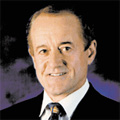
In 1985 Michael Cowpland (1943-) of Canada founds Corel Corp. (Cowpland Research Lab.), which in 1989 releases the CorelDRAW graphics program, which becomes the industry standard in desktop publishing; in 1996 they acquire WordPerfect.
In 1985 the Eiffel object-oriented programming language is introduced by Bertrand Mayer (1950-) of France.
In 1985 Sony introduces the JumboTron large-screen TV at the Expo '85 World's Far in Tsukuba, Japan.
In 1985 Apple Computer introduces the LaserWriter desktop publishing laser printer, which uses Adobe Systems' PostScript programming language and can be used with Aldus Corp.'s PageMaker program to produce prof. quality newsletters etc., helping launch the desktop publishing rev.

In 1985 Am. biophysicist (ex-Golden Gloves boxer) Michael Edward Phelps (1939-) of the U.S. invents Positron Emission Tomography (PET), which produces a 3-D image of a body via gamma rays emitted by a positron-emitting radionuclide tracer; James Van House and Arthur Rich are the first to pub. an image from a PET microscope.
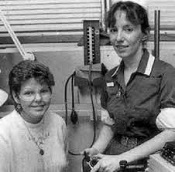
On Dec. 17, 1986 Davina Thompson (1947-98) becomes the world's first triple transplant patient when she receives a new heart, lungs, and liver at Papworth Hospital in Cambridge, England.
In 1986 Krystof Bankiewicz discovers that the reason L-Dopa stops working is too little aromatic L-amino acid decarboxylase (AADC) in the brain.


In 1986 Swiss physicist Karl Alexander "K. Alex" Muller (1927-) and West German physicist Johannes Georg Bednorz (1950-) of IBM pioneer High-Temperature Superconductivity in ceramics (copper oxide), winning them a fast hot Nobel Prize in Physics next year.
In Jan. 1986 Brain.a makes its appearance as the first computer virus for MS-DOS computers, leaving the phone number of the computer repair shop of Pakistani brothers Amjad Farooq Alvi and Basit Farooq Alvi; a genuine Muslim invention?
In 1986 the $6,449 Compaq Deskpro Model 40 is introduced, becoming the first PC utilizing the Intel 80386 32-bit microprocessor, with a 40MB hard disk drive; the $8,799 Compaq Model 130 has a 130MB hard drive.
In 1986 Am. marine biologist Greg Marshall invents Crittercam, which is later funded by Nat. Geographic, and used in Luc Jacquet's 2005 film March of the Penguins.
In 1986 Am. plastic surgeon G. Gregory Gallico III invents a synthetic human skin.
In 1986 Fujifilm introduces Utsurundesu (Jap. "It can take photos"), the first single-use camera.

The Original House, M.D.? On May 11, 1987 in a medical first, doctors in Baltimore transplant the heart and lungs of an auto accident victim to Clinton House, who gave up his own heart to a 2nd recipient; House, the nation's first living "heart swapper" dies 14 months later. In 1987 English surgeon Sir Roy Yorke Calne (1930-) performs the first liver, heart, and lung transplant, followed by the first intestinal transplant in the U.K. in 1992, and the first combined stomach, intestine, pancreas, liver, and kidney cluster transplant in 1994 - excuse me for not shaking hands?
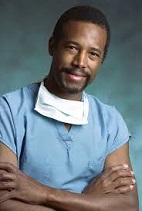
On Sept. 6, 1987 doctors at Johns Hopkins Hospital in Baltimore, Md. led by Benjamin Solomon "Ben" Carson (1951-) succeed in separating 7-mo.-old conjoined twins Benjamin Binder (1987-) and Patrick Binder (1987-) from Ulm, West Germany (who were joined at the head) after 22 hours of surgery.
In 1987 scientists at the U. of Calif. conclude from DNA studies that all modern humans trace their ancestry to one African female who lived 100K-200K years ago, whom they name Mitochrondrial Eve - she was what color?

In 1987 World Bank economist Augusto Daniel Odone (1933-2013) and his wife Michaela Teresa Murphy Odone (1939-2000) buck the medical research establishment and score a V for the renegade lone genius approach with their olive-grape-based Lorenzo's Oil for adrenoleukodystrophy (ALD), used to treat their son Lorenzo Odone (1978-2008); the medical establishment resists acceptance.


In 1987 Austrian-born Am. psychiatrist Karl H. Pribram (1919-) and Am. quantum physicist David Joseph Bohm (1917-92) (former asst. of Albert Einstein) propose the Holonomic Brain Model, which postulates that the brain stores all its info. about the past, present, and future in a "super hologram".

In 1987 German physicist Christof Wetterich (1952-) proposes Quintessence (dynamical dark energy) as an alternative to the cosmological constant to explain the expansion of the Universe; starting out attractive, it became repulsive about 10B years ago.

In 1987 English-born Am. mathematician Stephen Wolfram (1959-) founds Wolfram Research Inc., releasing Mathematica software algebra system for solving complex problems on June 23, 1988; on May 14, 2002 he pub. A New Kind of Science, which claims that simple digital programs not equations are needed to do science because the Universe is ultimately digital - a resounding thud is heard?
In 1987 the theory of Hydroseismicity is proposed, that the hydrologic cycle influences earthquakes.
In 1987 AZT (Azidothymidine) (Zidovudine) becomes the first drug to gain FDA approval for use in the treatment of AIDS.
In 1987 Human Donor Ova become available in the U.S.
In 1987 R.S. Lakes of the U. of Iowa pub. the article "Foam Structures with a Negative Poisson's Ratio" in Science, containing the first example of a synthetic Auxetic (Gr. "auxeticos" = that which tends to increase) material, which becomes thicker perpendicular to the applied force when stretched; in 1991 Ken Evans of the U. of Exeter coins the term.
On Nov. 10, 1988 the U.S. Dept. of Energy announces that Bushorado, er, Texas has been chosen as the home of the $4.4B atom-smashing Superconducting Supercollider; Congress kills it in Oct. 1993.
In 1988 British theoretical physicist John Cardy proposes the a-theorem, that the number of ways that quantum fields can be energetically excited is always greater at high energies than at low energies; it is not proven until ?

In 1988 Am. physicist Kip Stephen Thorne (1940-) of Caltech shows that a wormhole can be turned into a time machine if "exotic matter" with less then zero mass can be found for it - how does that throw Big Bang calculations off?


In 1988 Peter Gruenberg (Grünberg) (1939-) of Germany and Albert Fert (1938-) of France independently discover Giant Magnetoresistance (GMR), utilizing the spin states of electrons as well as their charge state to create the new field of "spintronics", which later makes multi-gigabyte hard disk drives possible.
In June 1988 the first CD-ROM is released by Sony and Philips; CD-Recordable is released in 1990.
In Mar. 1989 Univ. of Utah scientists Stanley Pons and Martin Fleischmann announce that they have achieved cold fusion; other researchers fail to verify it, and it is eventually labelled an "illusion" - too much cold brewsky in Mormonland?
On Apr. 12, 1989 the U.S. Patent and Trademark Office issues a patent to Harvard U. for a genetically-engineered mouse, becoming the first granted for an animal life form - if an animal has a baby, does it have to pay Harvard royalties?
In 1989 scientists comparing notes at the first Int. Conference on Herpetology discover the Frog Mystery, a sudden decline in many frog species around the world; nine species have become extinct since 1980, and another 113 species "can no longer be found"; almost one-third of the 5,743 known species are now considered endangered; Chytrid fungus is later implicated.
In 1989 living sperm is first gender-separated into male and female-producing batches - the first step towards designer sexual preference?
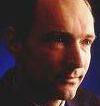
In Mar. 1989 English-born Sir Timothy John "Tim" Berners-Lee (1955-) of CERN in Switzeland invents the World Wide Web (WWW), which starts out as a company-only net called Enquire Within Upon Everything, and is released globally in 1991, based on the HTML (HyperText Mark-Up Language), URLs (universal resource locators), and HTTP (HyperText Transfer Protocol); the French trans. World Wide Web as "Toile d'Araignee Mondiale"; the Hebrew letter waw is equivalent to 6, so WWW equals 666? - could it have something to do with the Swiss love of fondue?
In 1989 Intel introduces the 1.18M-transistor 80486 microprocessor, which runs at 25 MHz.
On June 30, 1990 the Common Cold Research Centre in the Harvard Hospital near Salisbury, England (80 mi. W of London) (founded 1946) closes after conceding defeat in finding a cure for the common cold, saying that there are 200 different strains of the virus; 18K volunteers had undergone 10-day quarantine tests.
In 1990 the U.S. govt.-run Arpanet is decommissioned, and the Internet takes over and goes commercial, immediately being swamped with pornography Web sites, which make big bucks while driving millions of men crazy and ruining marriages and families?; Archie becomes the first Web search engine, followed next year by Veronica and Jughead.
In Apr. 1991 AT&T Bell Labs announces that carbon buckyballs (buckminsterfullerenes) (60 carbon atoms arranged at the corners of a 32-sided solid consisting of 20 hexagons and 12 pentagons) can be made superconducting at -427 deg. F by adding potassium atoms. In Sept. 5.3K-y.-o. Otzi (Ötzi) is dug up on the Tisenjoch Pass of the Otzal Alps in N Italy, complete with yew longbow, chamois quiver with 14 arrows, a copper axe, and a flint-bladed dagger in a woven sheath; he has bad teeth; his complete genome is pub. in 2012, allowing 19 people in Tyrol to identified as his descendants in 2013. Japanese cardiac surgeon Amano Atsushi (1955-) pioneers Off-Pump Coronary Artery Bypass Surgery; on Feb. 18, 2012 he performs a successful operation on Emperor Akihito. Blockchain is invented by cryptographers Stuart Haber and Scott Sornetta, who use it to timestamp digital documents to prove authenticity, launching the timestamping service Surety, whose main product is AbsoluteProof. The Robert C. Byrd Green Bank Telescope is built in Green Bank, W. Va. to replace the one that collapsed on Nov. 15, 1988, becoming the largest steerable radio telescope on Earth. Alex Wolszczan and Dale Frail find evidence of three extra-solar planets orbiting the spinning remains of Pulsar B1257+12, becoming the first planets discovered outside our solar system. The Human Genome Diversity Project, a sister to the Human Genome Project to look for genetic differences among world pops. and find how the DNA sequence in the human genome varies from one pop. to another is proposed by pop. geneticists, but runs into political opposition from those accusing it of racism, and others accusing it of being a "vampire project" for extracting medical info. from endangered tribes without paying them; it pub. its first major analysis in 2002.

In 1991 Wi-Fi is invented by NCR Corp./AT&T in Nieuwegein, Netherlands. On May 13 Apple releases Macintosh System 7.0, with a corrected floating-point unit. Linus Benedict Torvalds (1969-) of Finland creates the Linux operating system as an alternative to Windows, fighting a steep uphill battle to get people to use it when they already had to pay for Windoze whether they wanted it or not? BeOS is created by Be Inc. to run on BeBox hardware as a competitor to Mac OS and Microsoft Windows; too bad, it flops. Philip R. "Phil" Zimmermann Jr. (1954-) releases the first version of Pretty Good Privacy (PGP) personal computer software, bringing military-grade cryptography to the masses for free. All Nippon Airways becomes the first to offer in-flight video games to passengers. U. of Minn. researchers release the Honeycrisp Apple, followed by the early season cold climate Zestar Apple in 1998 ("a hint of brown sugar").
In 1992 Kodak introduces the PhotoCD for digitizing and storing photos in a CD. IBM begins marketing the ThinkPad laptop PC. Predictions are made that fiber-optic networks will lead to 500 channels with interactive programs, e-mail and telephony. Alkaline Hydrolysis is developed in the U.S. to get rid of animal carcasses by dissolving them in lye at 60 psi and 300F, then flushing the brown syrupy residue down the drain; in ? it becomes accepted for human bodies. John Hunter of Lawrence Livermore Nat. Lab designs a 425-ft. gun to test-launch hypersonic engines, and begins a program to build a 3.6K-ft. gun to launch objects into space cheaply. The first commercialized 6.3K-lb. 7-ft.-wide Hummers are manufactured in Ind. after Hollywood actor Arnold Schwarzenegger falls in love with the military version and talks their execs into redesigning them for the civilian market, then purchases the first two off the assembly line. The Kirby video game series is introduced by Nintendo. The Wolfenstein 3D PC video game is released by id Software on May 5, popularizing the first-person shooter genre.
In 1992 Belgium researchers develop ICSI, a method to produce human pregnancies by injecting a single sperm cell into an egg. The first complete DNA sequence of #6 of 16 chromosomes in a yeast is determined scientifically. A team at Harvard U. led by Gerald Gabrielse determines that protons and antiprotons have identical masses to within 40 parts in a billion, adding support to Einstein's Gen. Theory of Relativity. English physicist Stephen Hawking pub. the Chronology Protection Conjecture, that the fundamental laws of Nature prevent time travel on a macroscopic scale - duh? Estonian-born Am. psychologist Jaak Panksepp (1943-) coins the term Affective Neuroscience for the field that studies the neural mechanisms of emotion, claiming that animals incl. rats have them. On Aug. 21 a 5 in. x 7 in. (world's biggest) cherry-red square block crystal of rhodochrosite ("looks like a slab of Jell-O") is discovered in the Sweet Home Mine near Alma, Colo. (closes Oct. 2004), becoming the Colo. state mineral. The 2-horned Saola, AKA the Asian Unicorn is discovered in the forests of Southeast Asia; the first one is caught by villagers in Laos in 2010. Hacker St. Jude Milhon coins the term "cypherpunk".
On Mar. 22, 1993 Intel introduces the 75 MHz 3.1M-transistor Pentium (i586) single-core x86 microprocessor as the successor to their 4-times-slower 1.18M-transistor 486; meanwhile Motorola introduces their PowerStack RISC (Reduced Instruction Set Computer) chip set as competition.

In 1993 Waukesha, Wisc.-born Vernor Steffen Vinge (1944-) pub. The Coming Technological Singularity: How to Survive in the Post-Human Era, which describes the Singularity, AKA "Rapture of the Nerds" (Ken MacLeod), with the John the Baptist-like soundbyte "Within thirty years, we will have the technological means to create superhuman intelligence. Shortly after, the human era will be ended"; launches the Artificial Intelligence Technoreligion, popular in Silicon Valley, which confuses the exponential growth promised by Moore's Law of ICs with exponential growth of technology itself, resulting in cultlike predictions of computers suddenly growing smarter than humans and taking over the world; actually, computers have zero IQ, they are only fixed logic machines processing data according to programs created by humans, who can try to put their IQ into the computers, but actually can't, and Moore's Law is about the packaging density for the same old design, which never evolves; as late as 2009 it is easy to design captchas that allow Web sites to tell dumb computers from human beings.




In 1994 the "starvation hormone" Adiponectin, associated with fasting that controls sensitivity to insulin is discovered by Philipp Scherer; the appetite-suppressing hormone Leptin is discovered by Jeffrey M. Friedman (1954-), Rudolph Leibel (1942-), and Douglas L. Coleman (1931-); on Apr. 17, 2013 researchers at the U. of Tex. announce the identification of a protein that can block the brain's response to leptin.
The search for the leptons and quarks is complete before Armageddon, hot dog? In Apr. 1994 after an effort beginning in June 1991, physicists at Fermi Nat. Accelerator Lab. (Fermilab) in Batavia, Ill. announce that using their Tevatron 900 Gev accelerator they have found evidence of the top quark, the heaviest of the 12 fundamental building blocks of matter (six leptons and six quarks); up-down, strange-charmed, top-bottom with their anti-particles give 12 quarks, which together with the 12 less massive leptons (electron and its neutrino, muon and its neutrino, tauron and its neutrino) are thought to make up the entire Universe; electrons are leptons, quarks are found inside the nucleus, while protons and neutrons are combinations of up and down quarks (the two lightest); masses (electron masses): up: 5, down: 7, strange: 150, charmed: 1.5K, bottom: 5K, top: 200K (185 AMU); too bad, the Tevatron shuts down in 1993, leaving the U.S. without a particle collider, causing it to lose its dominance - guess it's time to switch fields?
The astronomical Out of Africa, or, The Search for Black Holes? In May 1994 astronomers at the Space Telescope Science Inst. in Baltimore, Md. report seeing a black hole at the center of elliptical galaxy M87 in the Virgo Cluster, about 50M l.y. from Earth; the disc of matter surrounding the small intense source of light is rotating at 1.2M mph, corresponding to an object containing 3B Sun masses.
On July 16-22, 1994 20+ fragments from Comet Shoemaker-Levy 9 hit Jupiter, causing the largest explosion yet witnessed by astronomers in the Solar System.
In Sept. 1994 Harvard U. astronomers using the NSF Very Long Baseline Array (VBLA) improve the accuracy of measurement of distant galaxies, indicating that the age of the Universe may be in the 7B-14B rather than 20B year range, which is curious because the oldest stars seem to be 15B-16B years old? - Bible creationists here's some ammo?

In 1994 Leonard Max Adelman (1945-) of USC uses DNA in a test tube to solve a simple 7-node mathematical problem, making DNA Computers a possibility.
In 1994 scientists at the GSI Helmoltz Centre for Heavy Ion Research in Darmstat, Germany discover the radioactive synthetic elements Darmstadtium (Ds) (#110) and Roentgenium (Rg) (#111), named after German physicist Wilhelm Roentgen (Röntgen) (1845-1923).

In 1994 applied mathematician Peter Williston Shor (1959-) of MIT invents Shor's Algorithm to factor large numbers in polynomial time (log N) using a quantum computer, making the cracking of the RSA public-key cryptography scheme possible in theory, causing the govt. and computer users to get a little nervous; in 2009 a silicon chip that implements Shor's Algorithm is demonstrated by the U. of Bristol.

In 1994 English mathematician Sir Andrew John Wiles (1953-) finally proves Fermat's Last Theorem after seven years locked up by himself, and also proves that all rational semistable elliptic curves are modular.
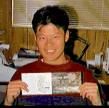

The Year of Internet Search Engines? In Jan. 1994 Infoseek is founded, allowing Webmasters to submit Web pages for indexing; in Dec. 1995 Netscape begins use it as its default search engine; in Dec. AltaVista is founded, becoming the first to allow natural language queries; it is purchased in Feb. 2003 by Overture, which is acquired by Yahoo! in 2003; in Apr. WebCrawler is founded., becoming the first to index entire Web pages, selling out to AOL in June 1995; in Apr. Stanford U. grad students Jerry Yang (1968-) (born in Taiwan) and David Filo (1966-) found the Internet search engine Yahoo.com (Yet Another Hierarchical Official Oracle?) in a campus trailer, and incorporate next Mar. 2; in 1997 Yang becomes the world's youngest billionare at age 29; urls are entered manually by their staff, causing a long wait to get listed in return for higher quality search results for users; in July Lycos is founded, becoming the first with ranked relevance retrieval, selling out to Daum Communications of South Korea in Oct. 2004; meanwhile Justin Hall of Swarthmore College starts an online diary called "Justin's Links from the Underground", becoming the first blog; in 1997 Jorn Barger coins the term "weblog"; Peter Merholz coins the short form "blog".
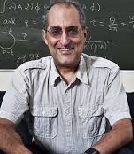
In spring 1995 Am. physicist Edward Witten (1951-) (who became the first physicist to be awarded a Fields Medal in 1990, and is considered the world's smartest theoretical physicist) gives a lecture at a USC conference in which he unifies the five separate string theories, founding M-theory and launching the Second Superstring Rev.. (ends 1997).


On July 23, 1995 Denver, Colo-born amateur astronomer Thomas J. "Tom" Bopp (1949-) and Japanese-born Am. prof. astronomer Alan Hale (1958-) discover Comet Hale-Bopp (C/1995 O1), AKA "The Great Comet of 1997"; as the comet reaches its brightest point, Bopp's brother and sister-in-law are killed in a car accident after photographing it.

In 1995 a new form of matter, a Bose-Einstein Condensate (BEC) is created by MIT physicist Wolfgang Ketterle (1957-), who wins a share of the 2001 Nobel Physics Prize. In 1997 Ketterle invents the atom laser, pulses of coherent matter rather than light, produced by two overlapping Bose-Einstein condensates, which behaves like a wave.

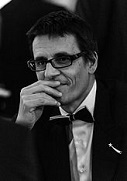
In 1995 Swiss astronomers Michel G.E. Mayor (1942-) and Didier Queloz (1966-) of the U. of Geneva announce 51 Pegasi b (AKA Helvetios), the first planet found orbiting a star other than the Sun (51 Pegasi) 50.9 l.y. from Earth after developing a technique to detect it through subtle distortions in the star's emissions; by 2009 350+ other extrasolar planets are discovered, with none proved to be habitable (until ?).
On May 26, 1995 Bill Gates sends a memo to his top execs telling them that the Internet is now Microsoft's top priority; on Nov. 22 (JFK assassination day) Microsoft unveils Internet Explorer 2.0; on Dec. 7 Gates unveils his Internet strategy to the public at an all-day session, causing millions to fear yet another monopoly in the making.
In 1995 the term 3D-Printing is coined by graduate students Jim Bredt and Tim Anderson at MIT.
In 1995 MP3 (MPEG-1/2 Audio Layer III) is invented by Fraunhofer Inst. to compress digital audio data using a form of lossy data compression.

In 1996 Argentine physicist Juan Martin Maldacena (1968-) proposes that 10-dim. String Theory is actually a Hologram in a 1-dim. flat Universe with no gravity; in 2013 it is computationally verified.
On Aug. 6, 1996 a NASA team led by biochemist David McKay announces that they have found evidence of ancient life (polycyclic aromatic hydrocarbons and hematite and iron sulfides) on Mars 3.6B years ago in the 4 lb. Allan Hills (ALH) 84001 meteorite that fell on Earth 16M years ago and was found on Dec. 27, 1984 in the Allan Hills of the Trans-Antarctic Mts. in Antarctica; "If the results are verified it is a turning point in human history" (Carl Sagan); skeptics say they're just nice rocks; by 2006 nonbiological explanations are found for every piece of evidence presented - not everybody goes for Prego?
In 1996 scientists in N.C. successfully grow the first human body part in a lab, a bladder.
In 1996 the USDA approves the marketing of the acetylcholinesterase inhibitor Donepezil for Alzheimer's patients, marketed by Esai Co. of Japan under the name Aricept.
In 1997 the Dot-Com Boom and Bust (Bubble) begins, with new cos. sprouting up and floating stock on little more than a Web site and an angle (ends 2001); despite big bucks invested by dopes, a string of spectacular dot-com flops results, incl. eToys.com, MVP.com (sporting goods), and Go.com (Disney); meanwhile the phenomenal growth of the World Wide Web leads to domain name speculation and instant wealth without needing big investment just by selecting a likely name, e.g., sex.com (sold for $13M in 2010), whitehouse.com, beer.com, pizza.com, and roses.com.

On Feb. 22, 1997 embryologist Ian Wilmut (1944-) et al. of the U. of Edinburgh in Scotland announce the cloning of an adult mammal, a Finn Dorset lamb named Dolly (named after singer Dolly Parton for her bodacious tatas) from the udder cell of an adult sheep; it later is put down after a short life marred by premature aging and disease, and when Wilmut reveals that the success rate is 1 in 40 tries, skeptics point out that the whole thing could be a false result; meanwhile on Aug. 7 a Wisc. cattle breeder announces the cloning of a calf in Feb. from stem cells removed from a cow fetus; meanwhile Wilmut also clones a sheep named Polly from a fetal cell that has the human blood clotting factor IX inserted; meanwhile researchers at the Univ. of Bath in England create headless tadpoles, adding to the controversy and stirring fears of coming organ factories - I reckon you ain't from these parts?
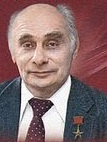
In 1998 Roy Bakay et al. of Emory U. in Atlanta, Ga. install a brain implant in Johnny Ray, who suffers from locked-in syndrome after a brain-stem stroke; he uses it to control a computer cursor with his thoughts.
In 1998 Monsanto Co. of the U.S. patents genetically-altered corn and soybean seeds that become a virtual monopoly on U.S. farms within a decade.
In 1998 the Galileo spacecraft observes volcanic plumes on Jupiter's moon Io, and discovers Jupiter's 24th moon Posiphae, named for the wife of King Minos (daughter of Helios and Perse).
On Mar. 5, 1998 Lunar Research Inst. scientists in Gilroy, Calif. announce that the unmanned NASA Lunar Prospector has detected evidence of water on the Moon, and that there may be sufficient quantities to sustain lunar colonies - smoke blowin' down from the cabin on the hill soon?
On Mar. 12, 1998 U. of Calif. and other scientists announce the discovery of a galaxy 12.2B light-years from Earth, the most distant yet observed - those photons were really getting old-looking?
On Mar. 25, 1998 a fossil of 113M-y.-o. Scipionyx samniticus is described by Italian paleontologists, becoming the first dino to be found in Italy; its liver, intestines, and windpipe are well preserved.
On Apr. 21, 1998 the JPL in Pasadena, Calif. reports that the first planets have been observed being formed from swirling gas and dust around a young star; on June 22 U.S. astronomers announce the discovery of a planet the size of Jupiter with twice its mass orbiting Gliese 876, a red dwarf star 15 l.y. from Earth, becoming the first planet discovered orbiting a common low-mass star in the Milky Way - the Federation of Planets is just around the corner?
On June 5, 1998 Japanese and U.S. physicists announce the discovery of the existence of mass in the ghostly neutrino, suggesting that neutrinos may indeed make up much of the mass of the Universe - does that make them the Holy Ghost?
In 1998 Andrew Zachary Fire (1959-) and Craig C. Mello (1961-) of the Carnegie Inst. discover that RNA can switch off genes in what is termed RNA interference (RNAi), winning them the 2006 Nobel Med. Prize after just eight years; in 2010 John DeVincenzo et al. of the U. of Tenn use it for the first time combat a human disease, the respiratory syncytial virus (RSV).
In Nov. 1998 Fred Gage of the Salk Inst. discovers Neurogenesis, proving that adult humans, even the elderly can generate new brain cells throughout life, which becomes known as Neuroplasticity.
On Dec. 8, 1998 Japanese scientists report that they cloned eight calves from cells from a single cow; only four survive.
On Dec. 11, 1998 scientists announce the first full decipherment of the genes of a multicelled animal, a microscopic roundworm.
In 1998 Saul Perlmutter (1959-) and Nicholas B. Suntzeff (1952-) of Lawrence Berkeley Nat. Lab and an independent team led by Brian P. Schmidt of Mount Stromio Observatory in Australia use observations of supernovae to suggest that the expansion of the Universe is accelerating, causing Adam Riess of NASA's Space Telescope Science Inst. to postulate the existence of dark energy or antigravity, theorizing that most of the energy of the Universe is contained in empty space, bringing back Einstein's cosmological constant, which he had called his biggest mistake?
In 1998 James Alexander "Jamie" Thomson (1959-) et al. of the U. of Wisc. pluck stem cells from human embryos, destroying the embroyos in the process and touching off a divisive sociopolitical debate; stem cells can turn into any of the 220 body cell types.
In 1998 Lancet pub. an article in the British Medical Journal (BMJ) by Dr. Andrew Wakefield linking childhood vaccinations with autism, spawning an anti-vaccine movement; on Feb. 2010 they retract it; in Jan. 2010 they call it an "elaborate fraud".
In 1998 the Int. Union of Pure and Applied Chemistry confirms six new elements added to the Periodic Table of the Elements: Rutherfordium (Rf) (#104) (1968), Dubnium (Db) (#105) (1970), Seaborgium (Sg) (#106) (1974), Bohrium (Bh) (#107) (1981), Hassium (Hs) (#108) (1984), Meitnerium (Mt) (#109) (1982) - rubadubdub in the boring sea tub, have some, mite? Scientists at the Flerov (Flyorov) Lab of Nuclear Reactions of the Joint Inst. for Nuclear Research in Dubna, Russia discover the superheavy artificial element Flerovium (Fl) (#114), named in honor of Russian (Soviet) physicist Georgy Nikolayevich Flyorov (1913-90).
In 1998 Clint Hallam (1951-) loses his hallam, er, hand in prison, and receives the world's first hand transplant; too bad, he fails to stick with anti-rejection drugs and has it removed in 2001 in London - disposable Lady Five Fingers?
In 1998 ? Lubman pub. an article in Journal of the Acoustical Society of Am. suggesting that if a person claps in front of the El Castillo Pyramid at Chichen Itza, Mexico, the resulting chirp sounds like the song of a quetzal bird, causing tourists to begin clapping in droves.

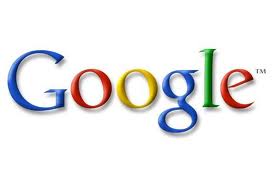

On Sept. 4, 1998 Stanford U. students Sergey Mikhailovich Brin (1973-) and Lawrence Edward "Larry" Page (1973-) (who built an inkjet printer out of Legos in college) found the search engine Web site Google in a garage in Menlo Park, Calif. with a staff of four people, originally calling it Backrub because it analyzes Web site links, then changing it to Google after the word Googol, coined in 1920 by Am. mathematician Edward Kasner (1878-1955); despite a crowded field of well-financed search engine sites, they find that a sucker trick of hiding the paid advertising from the user by making advertisers pay for the order their sites come up in listings, rather than the obvious but annoying approach of thumbnail aids that pop up on the search screens is a winner (despite the result that all search results are skewed by the rich?), making them go #1 and later turning them into 20-something billionaires with a dot.com that has little revenue and no real product, patent, or creativity behind it, but zillions of mindless eyeballs, who seemingly never ask for a CD or DVD of the search engine database so that they don't have to keep connecting with it every time they need a dollop of info. - the Internet helps a few amass huge fortunes, but makes nada for the little guy?
On Nov. 5, 1998 James A. Thomson of the U. of Wisc. announces the isolation of the first embryonic human stem cells; five days later a team led by John D. Gearhart at Johns Hopkins U. follows suit; they are believed to have potential for treating incurable diseases such as Parkinson's; in July R.G. Young, D.L. Butler et al. pub. an article in Journal of Orthopedic Research, announcing the use of stem cells for Achilles tendon repair.

In Mar. 1998 Philip J. Corso (1915-98) pub. The Day After Roswell, claiming the alien UFO technology from the 1947 Roswell Incident was used to pump up the U.S. defense industry with fiber optics, particle beams, and Star Wars technology.
In 1998 the Apple iMac features USB ports (designed by Intel in Jan. 1996), which become an industry std. MSN Search is founded; Open Directory Project (DMOZ) is founded to compete with Yahoo! with volunteer editors, selling out to Netscape in Nov., which is purchased by AOL for $4.5B; meanwhile Google files U.S. Patent #6,285,999, titled "PageRank System", and uses it to create a monopoly in Internet searching, making the idea of patenting software seem lamer than ever, going on to get venture funding from Sequoia Capital in 1999.
In 1998 the Iridium satellite system is launched, promising to give cell phones global coverage; too bad, it requires 77 satellites, and proves too expensive.
On May 15, 1998 Microsoft releases Windows 98, selling 1M units in 1 mo.
In 1998 the WWW Consortium approves XML, a generalized HTML for use on the World Wide Web.
In 1998 Dutch programmer Joannes Jozef Everardus van Der Meer patents the "Like Button"; on Feb. 5, 2013 patent troll Rembrandt Social Media sues Facebook over it.
In 1999 Shrinivas "Shri" Kulkarni and Joshua Bloom of Caltech link cosmic ray bursts to the collapse of massive stars.
In 1999 the USFDA approves the marketing of the acid inhibitor Rabeprazole for acid reflux and ulcers, marketed by Esai Co. and Johnson & Johnson Co. under the name AcipHex - has a big effect on your ass?
On May 17, 1999 SETI@Home is launched to search space for signs of ETs, becoming the first attempt to use distributed Internet PCs power; in 2002 it becomes BOINC; by 2009 it has 2.5M users giving a total of seven petaflops of computing power.
In 1999 the last official Morse code message is sent by the Globe Wireless master station S of San Francisco, Calif., ending an era.
In spring 2000 the Internat. Hydrographic Org. defines the Southern (Antarctic) (Austral) Ocean (20.327M sq km) as all water below 60 deg. S, making it the 4th biggest of the five oceans after the Pacific, Atlantic, and Indian, and bigger than the Arctic.


On June 26, 2000 (Mon.) at the White House Francis Sellers Collins (1950-), dir. of the Human Genome Project, and John Craig Venter (1946-), pres. of Celera Genomics Corp announce their separate First Drafts of the Human Genome, the epoch-making first sequencing (deciphering) of 95%-97% of the human genome, expected to revolutionize medicine, just in time for the 50th anniv. of the pub. of the double helix work by James D. Watson and Francis Crick, taking only 13 of 15 expected years, declaring that the human genome has 3.1B "letters" (chemical bases); Pres. Clinton calls it "the most wondrous map ever produced", comparing the HGP to the Manhattan and Apollo projects; the program has come in underbudget, and involved 1.6K scientists, and adding the religious soundbyte: "Today, we are learning the language in which God created life. We are gaining ever more awe for the complexity, the beauty and the wonder of God's most divine and sacred gift" after being put up to it be Collins, a theist; Collins and Venter continue their war to be the first to finish the sequencing; by the end of the decade a genome can be sequenced in a week; meanwhile insurance cos. and govt. agencies line up to find ways to get and use genetic makeups, while every Tom, Dick and Harry with a computer rushes to patent genes after roping them off like in the Okla. Land Rush?
On Sept. 3, 2000 the Very Large Telescope (VLT) in Cerro Paranal, Chile begins operation, consisting of four 8.2m (323 in.) mirrors, each with its own name (Antu, Kueyen, Melipal, and Yepun); they initially operate independently, but are linked with interferometry in 2001.

On Sept. 12, 2000 Miss Waldron's Red Colobus Monkey of West Africa becomes the first primate species to officially become extinct in this millennium as biologists give up their search; it becomes the first large primate to go extinct since 1800; the Pyrenean ibex wild mountain goat is declared extinct; in 2009 it is resurrected via cloning; the 2000 IUCN Red List of Threatened Animals and Plants lists 24% of mammals, 12% of birds, 30% of fishes, and 20% of amphibians on Earth as globally threatened with extinction.
On Sept. 15, 2000 after Am. biologist Steven Austad is quoted in Scientific American as saying: "The first 150-year old person is probably alive right now", he and Am. aging expert Stuart Jay Olshansky (1954-) make their Big Lifespan Bet, putting $150 each into an investment fund, with the money and interest to go to the winner on Jan. 1, 2150 if he is of sound mind; they later stake another $150 each.
In 2000 the superheavy synthetic radioactive element Livermorium (Lv) (#116) si discovered by the Lawrence Livermore Nat. Lab in Calif.; the name is adopted by IUPAC on May 30, 2012. In 2000 Leonid Khriachtchev (1959-), Markku Rasanen et al. of the U. of Helsinki in Finland report the first known stable compound of the inert noble gas argon, Argon Fluorohydride (HArF) by shining UV light on frozen argon containing a small amount of hydrogen fluoride, proving that it's not really so inert. In 2000 Indian astrophysicist Abhas Mitra announces Eternally Collapsing Objects (ECOs) as an alternative to Black Holes.
In 2000 an internat. team of biologists sequences the genome of a flowering plant, Arabidopsis thaliana, becoming the first flowering plant all of whose genes have been found.
On May 9, 2000 an internat. team led by Harry Ostrer of NYU pub. an article in Proceedings of the Nat. Academy of Science reporting that Jews and Arabs have been found to be genetically identical.
In 2000 chemists at the Naval Research Lab. in Washington, D.C. produce samples of Octanitrocubane, a long-sought hydrocarbon derivative expected to be the most powerful non-nuclear explosive.
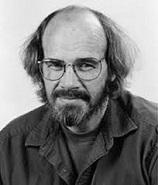
In 2000 Am. paleontologist John R. "Jack" Horner (1946-) of the Museum of the Rockies in Bozeman, Mont. and his team discover five separate T-Rexes, increasing the world collection by 35% - which makes you wonder about what?
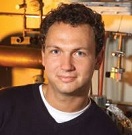
In 2000 after being hired by Bell Labs in 1997, German physicist Jan Hendrik Schoen (Schön) (1970-) begins pub. a series of papers proclaiming breakthroughs in semiconductor physics, receiving the Braunschweig Prize and other prizes before being exposed as a fraud in 2002, causing a scandal about the adequacy of peer review.
On Apr. 3, 2000 IBM announces a polymer-based low-k dielectric for reducing crosstalk in microprocessors, boosting speed and performance by as much as 30%.
In 2000 Intel Corp. releases the Pentium 4 chip, which has 42M transistors, compared to 24M in the Pentium III (1999), 7.5M in the Pentium II (1997), and 3.1M in the Pentium chip (1993); it is discontinued in 2008.
In 2000 the Bluetooth Wireless Application Protocol (WAP) and Bluetooth General Packet Radio System (GPRS) are developed, launching the wireless era of PCs.
In Oct. 2000 Toppan Printing Co. Ltd. produces a 2x1.5x1 cm 16-page ed. of the book titled The Twelve Horary Signs - Chinese Zodiac, becoming the smallest book yet printed.
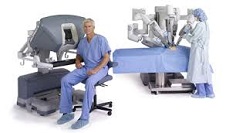
In 2000 the first FDA-approved robot surgery, the removal of a gallbladder is performed in Richmond, Va. using the da Vinci Surgical System by Intuitive Surgical; by 2012 3.1K units worldwide conduct 200K surgeries/year.
In 2000 prize dairy cow Lauduc Broker Mandy, EX-95 2E, the first clone ever sold at a public auction is purchased for $82K at the 2000 World Dairy Expo.
In 2000 Richard Montgomery of the U. of Calif. Santa Cruz and Alain Chenciner of France produce an exact solution to the Three-Body Problem for Equal Masses, showing that they can orbit each other in a figure-8 pattern where each body in turn passes between the other two.
By 2001 astronomers have discovered 30 suspected black holes in space, but the evidence remains circumstantial; on Nov. 28 the European Southern Observatory's Paranal Observatory discovers a black hole 14x the mass of the Sun about 40K l.y. from Earth, becoming the heaviest discovered to date - does that make it our brother?
On Jan. 11, 2001 researchers in Ore. announce the first genetically altered primate, a rhesus monkey named ANDi, having a jellyfish gene for fluorescence spliced into its DNA - it glows in the dark?
On Jan. 26, 2001 scientists announce that they have decoded the Rice Genome, which becomes the first major crop plant to have its genome decoded.
In Oct. 2001 fertility researchers Jerry Hall and Yang-Ling Feng announce a method for Parthogenesis, a way for women to have female babies without the need for sperm, making an all-female society possible in principle - isn't Jack in jail?
On Nov. 27, 2001 scientists using the Hubble Space Telescope announce the detection of the first star other than the Sun with an orbiting planet with a gas atmosphere, in the constellation Pegasus 150 l.y. away from Earth.
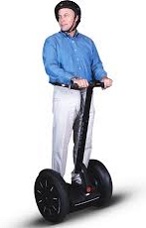
On Dec. 2, 2001 the 12.5 mph 24 mi. range Segway Human/Personal Transporter (HT/PT) (original names Ginger and IT) a revolutionary new personal gyroscooter is unveiled by Am. inventor Dean L. Kamen (1951-), son of a comic book illustrator; in 2009 Jimi Heselden (1938-2010) of Britain buys him out, then is killed when his out-of-control Segway drives over a cliff - add a seat and a parachute?
In 2001 Guillermo Gonzales of the U.S. pub. a theory that the Solar System is in the Galactic Habitable Zone, a narrow ring on the midplane of the Milky Way that is the only region where the conditions for life can exist; further, that the Earth is in an ideal place for the discovery of natural laws and the structure of the galaxy and Universe.
In 2001 British scientists discover that sheep have the ability to remember and recognize up to 50 faces, incl. that of the shepherd; could this prove they have consciousness? - ask a Scot?
In Nov. 2001 scientists announce the first cloned primate, a rhesus monkey - does this one glow too?
In 2001 Apple releases the iPod personal MP3 player, backed by digital music downloading service iTunes, changing the lifestyles of millions, and selling 67M units in 5 years, with 1.5B songs downloaded from their Web site; the 10 billionth song is downloaded on Feb. 24, 2010.

On Dec. 2, 2001 the Segway Personal Transporter, a revolutionary new personal gyroscooter is unveiled by Am. inventor Dean L. Kamen (1951-), son of a comic book illustrator; in 2009 Jimi Heselden (1938-2010) of Britain buys him out, then is killed when his out-of-control Segway drives over a cliff - add a seat and a parachute?
On Dec. 31, 2001 the world's first practical Magnetic Refrigerator is announced by scientists at Ames Lab.
In Feb. 2002 researchers in Texas announce that they are the first to successfully clone a domestic cat. The Mar. 21 issue of Nature reports the discovery in China of Lisoceratops, a dog-sized horned dinosaur that may be a cousin to the Triceratops. In Apr. the Earth Simulator supercomputer in Kanagawa, Japan achieves a computing speed of 35.61 teraflops, over 5x as fast as IBM's ASCI White at Lawrence Livermore Labs. On May 28 NASA's Mars Odyssey spacecraft discovers enormous quantities of ice on Mars. In the summer a week-long flood in Tex. causes Canyon Lake to spill over into the Guadalupe Valley, carving a new canyon in three days - giving Creationists a magic moment? In July scientists at Australian Nat. U. prove that the Second Law of Thermodynamics can be violated by nanomachines? In July scientists at the State U. of New York build a polio virus in the lab using public gene databases, becoming the first known infectious agent manufactured in a lab from scratch. In July French anthropologist Michel Brunet announces the discovery in Chad of a 6-7 M-y.-o. skull of a flat-faced hominid nicknamed Toumai ("hope of life"). In Aug. Swedish biologist Svante Paabo (Päabo) (1955-) pub. the discovery of the FOXP2 "language gene". In Aug. researchers report new evidence confirming the existence of ancient bacteria on Mars. In Aug. the first functioning penis (of a rabbit) is grown in a lab from cells at Harvard Medical School - the first artificial playboy bunny? In the fall the world's first carbon nanotube factory opens in Tokyo. In the fall the Rosetta Project produces its first Rosetta disk containing 1.4K of the world's 7K languages on a 3-in. nickel disk for future preservation. On Oct. 9 after an initial report in 2002, scientists at Joint Inst. for Nuclear Research (JINR) in Dubna, Russia and Lawrence Livermore Nat. Lab in Calif. announce the discovery of the synthetic element (a halogen) Ununoctium (Uuo) (#118). On Dec. 26 Clonaid announces the birth of 7 lb. Eve, the world's first cloned baby human. Michael Hall improves the Heisenberg quantum uncertainty relation to an equation rather than an inequality. The Human Genome Project pub. its first major analysis of blood samples from 52 world pops. converted into 1K cell lines, showing that the subjects' genomes fall into five major clusters corresponding to their continent of origin and therefore their race, and that all coalesce to a single root ancestral pop. that began to migrate from NE Africa 50K years ago. The Yukagir Mammoth is discovered in the permafrost in Siberia; its head is still covered with skin and tufts of hair. Textile expert Mechthild Flury-Lemberg claims that the Shroud of Turin has a herringbone weave common in the 1st cent. C.E. Middle East. Scientists at the Monterey Bay Aquarium Research Inst. discover mouthless worms who live in dead whale skeletons and feed off bacteria who eat their bones, causing biologists to create the new species Osedax, (Lat. "bone-eating") and theorize that they existed before whales and fed on dino bones; males live inside the bodies of the females, never developing past the larval stage. Mary Leitao proposes the name Morgellons Disease (Syndrome) for the infectious condition characterized by finding fibers on or under the skin along with skin lesions.
In 2002 Intel Corp. releases the Itanium chip, which has a staggering 220M transistors.

On Jan. 22, 2003 Chinese paleontologists announce the discovery of Microraptor gui, a 4-winged flying bird-like dinosaur NE of Beijing. On Mar. 28 Bernard La Scola, Didier Raoult et al. of the U. of the Mediterranean in Marseille pub. an article in Science reporting the discovery of Mimivirus (microbe mimicking virus), with 1.18M bases containing 900+ genes, the size of a small bacterium, overturning the belief that a virus is a simple inert particle and throwing the classification system into a tizzy until? In Apr. Japanese scientists announce the discovery of PQQ (pyrroloquinoline quinone), the first new vitamin discovered in 55 years - does it explain my impotence? On May 15 Michael Nitsche, Walter Paulus et al. of the U. of Gottingen pub. an article reporting that weak DC current applied to the motor regions of the human brain stimulates faster learning. On June 10 Spirit, the first of two Mars Exploration Rovers is launched, followed by Opportunity on July 7; Spirit lands next Jan. 4, and Opportunity next Jan. 25 on the opposite side of Mars. 2.5km-diam. Eris, a Solar System dwarf planet 27% more massive than Pluto is discovered by Michael E. "Mike" Brown (1965-) of Palomar Observatory, causing Pluto's status as a planet to be reconsidered, and leading to its demotion to dwarf planet. Adilson E. Motter of Northwestern U. conjectures that the expansion of the Universe right after the Big Bang was chaotic; he proves it mathematically in 2010. The first Definitive List of Scientific Predictions is produced by an internat. conference. The newly discovered armored dinosaur Crichtonsaurus bohlini is named in honor of "Jurassic Park" author Michael Crichton. UCLA astronomer Andrea Ghez discovers a supermassive black hole at the center of the Milky Way Galaxy, leading to the conclusion that most galaxies also have them, and that they both destroy and create stars, determining their structure and evolution. The sequencing of the human genome is finished. Swedish psychiatrist Lars Christopher Gillberg (1950-) et al. identify the genetic mutations in individuals with autism, two genes on the X chromosome. The Barcode of Life Initiative is launched to try telling species apart by using a very short gene sequence from a standardized position in the genome. The first human clone is planned by Prof. Panos Zavos of the U.S. and Dr. Severino Antinori of Italy. David C. Page et al. of Cambridge U. discover that Y chromosomes contain palindromes; in 2009 the palindrome system is discovered to have a simple weakness that explains sex anomalies incl. feminization and sex reversal - Madam, I'm Adam In Sept. the $140M SMART-1 (Small Mission for Advanced Research and Technology) spacecraft (a 3-ft. cube with solar panels) is launched into Earth orbit by an Ariane-5 booster rocket from Kourou, French Guiana, using its ion engine (using only 176 lb. of xenon fuel) to slowly raise its orbit for 14 mo. until the moon's gravity grabs it, and smashes into the Lake of Excellence on Sept. 3, 2006 after traveling 62M mi. On Dec. 3 Pres. Bush signs the U.S. 21st Century Nanotechnology Research and Development Act, authorizing nearly $4B for programs and activities supported by the Nat. Nanotechnology Initiative. William Ruddiman proposes that humanity's influence on climate began thousands of years ago, not during the Industrial Rev. The first intersex fish, male fish with female sexual traits (immature eggs in their testes) are discovered in the Potomac River, caused by pollutants - followed by intersex humans in ? The $173.5M NASA PICASSO-CENA (Climatologie Entendu des Nuages et des Aerosols) (Instruments for Cloud and Aerosol Observations) is launched to examine the role of clouds and aerosols in the Earth's radiation budget using Lidar (laser radar).

In Feb. 2004 the Diamond Star Lucy (BPM 37093) 50 l.y. from Earth is discovered, containing 10 billion trillion trillion (1E34) carats. On Mar. 23 NASA announces that its Mars Exploration Rovers have discovered evidence of past liquid water on the Martian surface after Opportunity's landing site Meridiani Planum shows evidence of being the shoreline of a long-gone salty sea. In Apr. a female mouse named Kaguya-hime (after a 10th cent. folk tale about a baby girl discovered in a bamboo stalk) becomes the first mammal created from the eggs of two other mice without a Mickey's help; mammalian parthenogenesis becomes a reality; in 2009 13 more are born; the mice live 28% longer than control mice. On May 24 scientists announce that the Universe has been measured at 156B l.y. wide - expanding raisin pudding jokes here? On Oct. 28 Australian and Indonesian scientists announce the discovery of Homo floresiensis (Flores Man), a clan of tiny humans standing about 30 in. tall, who lived in the isolated island of Flores in E Indonesia as recently as 18K years ago, until a volcanic eruption caused their extinction 12K years ago. In Nov. the Assoc. of Black Cardiologists pub. a 2-year study in The New England Journal of Medicine on BiDil, a new heart drug for blacks only, made by NitroMed Inc. of Lexington, Mass.; it becomes the first drug ever approved for only one racial group? In Nov. researchers at the Univ. of Colo. and the Caltech announce that they have found a key brain receptor, Alpha-4 Beta-2, responsible for the addictive effects of nicotine after it releases the neurotransmitter dopamine. The U.S. FDA approves the first biological therapy that blocks the formation of new blood vessels to tumors, pioneered by Judah Folkman (1933-2008) of the U.S. On Dec. 6 Encinitas, Calif. high school senior Aaron Goldstein wins the Siemens Westinghouse $100K college scholarship for inventing a gyroscopic device that converts ocean wave energy into electricity. Australian mathematician Terence "Terry" Chi-Shen Tao (1975) and English mathematician Ben Green prove the Green-Tao Theorem, that there are arbitrarily long arithmetic progressions of prime numbers. The Compressed (Compressive) (Sparse) Sensing is invented by Emmanuel Candes of Caltech, and Justin Romberg and Terry Tao of UCLA, based on L1 norms, permitting the Nyquist-Shannon Criterion to be surpassed and enabling noisy images to be startlingly sharpened. A species of lemur discovered in Madagascar is the first known primate to hibernate. The CMB Cold Spot is discovered, a region of the sky with unusually cold cosmic microwave background radiation. Jay McNeil of Ky. becomes the first amateur astronomer to find a new nebula. The FDA approves the use of Botox for excessive sweating. Scientists drop their estimate of the number of genes in the human genome from 30K-40K to 20K-25K; in contrast, Arabidopsis, a plant in the mustard family has about 27K, a fruit fly 13.6K, rice 45K, and maize 50K.
On Nov. 16, 2004 the 12-ft.-long unmanned air-breathing NASA X-43A scramjet flies under its own power above the Pacific Ocean for 10 sec., reaching Mach 9.7 (7K mph), the 3rd of its kind (#2 reached Mach 6.83 in Mar.); the SR-71 Blackbird is still the fastest air-breathing manned aircraft at Mach 3.
On Mar. 25, 2005 the journal Science pub. an announcement that soft tissues that resemble blood vessels and cells were recovered from the thighbone of an 18-y.-o. T-Rex known as MOR 1125, found in a sandstone formation in Montana. On Mar. 31 Palomar Observatory discovers plutoid Makemake in the Kuiper Belt. In Apr. scientists announce the discovery of the Laotian rock rat (kha-nyou) (Laonastes aenigmamus) in the Khammouan region of Laos, which has the face of a rat and the tail of a squirrel, and classify it as part of the Diatomyidae family that supposedly went extinct 11M years ago, "the coelacanth of rodents" (Mary Dawson) - doesn't everybody know that squirrels are tree rats? Where's the 11 million years of missing bones? In Apr. ornithologists announce the confirmation of the sighting of the elusive ivory-billed woodpecker (believed extinct since 1944) by a kayaker in the Cache River Nat. Wildlife Refuge in E Ark. in 2004; skeptics are convinced by audio recordings of its distinctive double rap (one echo, one close)? In May South Korean scientists use skin samples from patients to create embryonic stem cells; meanwhile, in Britain scientists produce a cloned embryo from which stem cells can be harvested. In May the Blue Brain Project is launched to reverse-engineer the mammalian brain down to the molecular level from lab data; on July 22, 2009 dir. Henry Markram of the Ecole Polytechnique in Switzerland utters the soundbyte: "It is not impossible to build a human brain and we can do it in 10 years." In June scientists at St. Thomas' Hospital in London release a study showing that 34% of the difficulty women face in reaching orgasm during intercourse is due to genes - wearing them too tight? In July a new planetoid orbiting the Sun at 9B mi. (3X the orbit of Pluto) named UB313 (nicknamed Xena) is announced, with an albedo of .6; it has methane ice on its surface, and has a moon. The Red Planet gets Americanized? In July NASA cancels the $500M Lockheed Martin Mars Telecommunications Orbiter, planned for a 2009 launch, to be the first of a network of Martian comm satellites on a 10-year mission in orbit 2.8K mi. above Mars in order to have a line of sight to Earth and pioneer the use of lasers for planet-to-planet communication; on Aug. 10 the Mars Reconnaissance Orbiter is launched, which will measure Mar in 8-12 in. scale and will serve as the main relay for the data to be returned by the Mars Science Lab, to be launched in 2009. In July the Ninth World Multi-Conference on Systemics, Cybernetics and Informatics in Orlando, Fla. is held, trying to live down ridicule from its early acceptance of the bogus computer-generated paper "Rooter: A Methodology for the Typical Unification of Access Points and Redundancy", submitted by MIT students Jeremy Stribling, Max Krohn, and Dan Aguayo as a joke to prove that academic conferences pander to academics looking to pad resumes with worthless alphabet alphabet soup papers that they spend all their time on instead of real research. Would-be Christopher Columbus sinks? On Aug. 3 the journal Nature reports that South Korean scientists, led by Hwang Woo-suk have created the Afghan hound Snuppy (Seoul Nat. U. puppy), the world's first cloned dog, after implanting 100+ dogs with more than 1K cloned embryos; in a May article in Science he announces creation of the technology to create patient-matched stem cells, and on Dec. 23 resigns from Seoul Nat. U. after admitting he had fabricated the results of 9 of the 11 stem cell lines involved, while still maintaining that the technology works; on Jan. 10 his school, Seoul Nat. U says that he did fake his results with human stem cells but that his cloned dog is genuine; on June 17, 2009 South Korea finally lifts its ban on human stem cell research despite opposition by the Catholic Bishops' Conference of Korea. On Aug. 11 the online ed. of Science pub. three reports reporting that old temp. records used to feed calculations indicating that there is no global warming contained errors, and that the troposphere has warmed during the last two decades; John Christy and Roy Spencer of the U. of Ala., who developed the original records concede the error, but say that the warming rate calculated is too small to be a concern? On Sept. 8 the first non-invasive pediatric procedure ever webcast is performed at Presbyterian/St. Luke Medical Center in Denver, Colo, as a 13-y.-o. undergoes a procedure to alleviate acid reflux. On Sept. 28 the Nat. Snow and Ice Data Center in Boulder, Colo. releases data that the Arctic ice cap is shrinking, reaching its smallest-ever size this summer, and that the cause is probably global warming from human-generated greenhouse gases; they also speculate that the change is becoming self-sustaining as the holes in the ice allow the sea to absorb solar energy; they also claim that the permafrost is disappearing, coastal areas are being inundated, and polar bears are losing hunting grounds. On Oct. 26 researchers from the U.S., Britain and Japan announce the completion of a new kind of DNA map in a 3-year $138M effort, a compilation of 5M different regions in the human genome where chemical sequences vary from person to person, in an effort to speed up gene-hunting searches. In the Nov. 11 issue of Science, Stanford U. researchers announce the discovery of a single human gene that produces two hormones with opposite effects, ghrelin, which stimulates appetite, and obestatin, which inhibits it. In Nov. Kevin Luhman of Penn. State U. announces the discovery of a brown dwarf (1% of the mass of the Sun) located 500 l.y. from Earth in the constellation Chamaeoleon, claiming it appears to be undergoing a planet-forming process. In Dec. Harvard and MIT announce the first complete deciphering of the genetic code of a dog, a boxer named Tasha; "Outside of a dog, a book is man's best friend. Inside of a dog, it's too dark to read. We're here to unveil the book of the dog", says Dr. Francis Collins, dir. of the Nat. Human Genome Research Inst.; in 2003 the DNA (2.4B chemical building blocks) of a male poodle named Shadow was partially decoded. In Dec. U. of Kan. researcher Johannes Feddema et al. in Science predict that the deforestation of Amazon jungles could strengthen the summer monsoon in the SW U.S., adding 2 in. to the precipitation and offsetting some of global warming's effects; global deforestation is going at a rate of 50K sq. mi. a year. On Dec. 12 Fred Gage et al. of the Salk Inst. in San Diego, Calif. announce the birth of mice with 0.1% of human cells in their brains after injecting 14-day-old embroys with 100K human embryonic stem cells. The British Journal of Psychology pub. an article by Paul Irwing and Richard Lynn showing that men average 5 more points on IQ tests than women, and that the disparity grows as IQ scores rise, with 2x as many at IQ 125, and 5.5x as many at IQ 155 - what about penis size? Merck & Co. announces that its new vaccine Gardasil is 100% effective in a 2-year test on 10K girls and women in preventing the most common forms of cervical cancer, caused by the human papilloma virus (HPV), which kills 300K women a year (only 3.7K in the U.S.). German-born British human geneticist Sir Walter Bodmer (1936-) is appointed to lead a £2.3M program at Oxford U. to study the genetic makeup of the U.K. Paralyzed patient Matt Nagle is taught to operate an artificial hand via a computer chip implanted in his head. Asteroid 87 Sylvia is found to have two moons. The Laser Interferometer Gravitational-Wave Observatory Scientific Collaboration (LIGO) begins measurements to detect gravity waves; too bad, it doesn't detect any until ? U. of N.C. physicist Laura Mersini-Houghton and Carnegie Mellon U. physicist Richard Holman predict anomalies in Big Bang radiation caused pull from other Universes; Mersini-Houghton claims proof in 2013. Eugene Koonin of the Nat. Insts. of Health et al. discover Clustered Regularly Interspaced Short Palindromic Repeats (CRISPR) (pr. "crisper"), in DNA, which implement an immune system against viral DNA. The Nat. Geographic Society and IBM begin a $40M 5-year project to reconstruct a genealogy of the world's pops. and the migration paths of early humans from their ancestral homeland in Africa by collecting and analyzing 100K blood samples from indigenous pops. around the world and analyzing them genetically. Scientists observe gorillas in the wild for the first time using tools when female gorilla Leah uses a stick to test the depth of the water in Nouabal De-Ndoki Nat. Park in the Repub. of Congo. Ramon Bonfil and Barbara Block Stanford U. announce that a great white shark (named Nicole) swam over 12K mi. from Africa to Australia and back, linking the shark pops. of the two continents - human meat makes good fuel? A record 21 surviving baby pandas are born in China's zoos and breeding centers this year using artificial insemination. KV 63, the 63rd tomb found in the Valley of the Kings near Luxor, Egypt is discovered by U.S. archeologists, becoming the first new tomb uncovered since King Tut's in 1922; in June, 2006 the tomb is opened, revealing embalming materials and woven flowers from the period of -1500 to -1000. New measurements of Mt. Everest indicate a height of 29,017 ft., down 12 ft. from 1975.
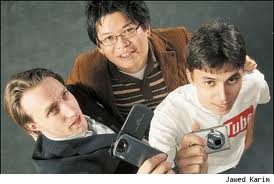

In July 2005 Rupert Murdoch purchases the artist community Web site MySpace.com for $580M from founders Tom Anderson and Chris De Wolfe, who launched it in Jan. 2004, and benefitted from the penetration of the Internet into homes; by the end of the year it has 42M registered users and has 550K musical artists with songs on the site; meanwhile 20-something geeks Chad Meredith Hurley (1977-), Jawed Karim (1979-), and Steve Shih Chen (1978-) found YouTube.com for sharing homemade videos on the Web, and within a year receive a $11.5M venture capital investment from Sequoia Capital of Menlo Park, Calif., the same firm that helped launch Google, and ramp up its San Mateo, Calif. site to 9M visitors a mo. by Feb. 2006; both sites get into trouble with either sexual predators or copyright violation issues, but in 2007 Google buys YouTube for $1.76B - but but but they're the future? In Oct. 2005 the Kansas School Board becomes the first in the U.S. to back Intelligent Design as a subject to teach alongside Darwininian Evolution, raising a storm of protest; leave it to Oregon State physics grad Bobby Henderson to trivialize the issue by sending them a letter claiming to speak for 10M members followers of the Church of the Flying Spaghetti Monster, demanding equal time for their views; the board eventually backs down, but the FSM cult continues to grow on campuses, spreading to Europe? On Nov. 9, 2005 Pope Benedict XVI makes comments in his gen. audience in Vatican City that the Universe was made by an "intelligent project", quoting 4th cent. St. Basil the Great; Austrian Cardinal-Archbishop Christoph Maria Michael Hugo Damian Peter Adalbert, Count of Schoenborn (Schönborn) (1945-), who backed Intelligent Design and dismissed Pope John Paul II's 1996 statement that evolution is "more than just a hypothesis" attends the audience; on Jan. 17, 2006 the Vatican newspaper L'Osservatore Romano pub. an article saying that "intelligent design" isn't science, and that teaching it alongside evolutionary theory in classrooms only creates confusion, but adds: "In a vision that goes beyond the empirical horizon, we can say that we aren't men by chance or by necessity, and that the human experience has a sense and a direction signaled by a superior design"; the article echoes the Vatican's chief astronomer Jesuit Rev. George V. Coyne (1933-), and either rebuffs or clarifies Pope Benedict XVI's Nov. off-the-cuff comments that the Universe was made by an "intelligent project".

A big year for planetary science? On Jan. 23, 2006 scientists spot a gigantic storm on Saturn that unleashes lightning bolts 1Kx stronger than those found on Earth and lasts 10 hours; dozens more are spotted in the succeeding weeks. In Jan. Doron Behar, Karl Skorecki et al. in Israel pub. a study indicating that 40% of the 8M Ashkenazi Jews (out of a total world Jewish pop. of 13M) are descended from just four women who lived in Europe within the last 2K years, although ultimately they can be traced back to Jews dispersed from Israel to Italy in the 1st and 2nd cents. On Feb. 2 German astronomers report that icy ball 2003 UB313 in the Kuiper Belt (nicknamed Xena, then formally named Eris_, the largest object discovered orbiting the Sun since Neptune in 1846 is 1,860 mi., 30% wider than Pluto (1.4K mi.), causing astronomers, led by U.S. astrophysicist Neil deGrasse Tyson (1958-) to begin questioning the status of Pluto as a planet; in Aug. the Internat. Astronomical Union (IAU) decides that Pluto is no longer a planet, but "dwarf planet" #13430, leaving Sol with only eight planets; Pluto joins Ceres and Xena as Sol's three dwarf planets; the word "plutoed" is coined, meaning demoted or devalued; on June 11, 2008 the IAU announces that similar distant bodies in the Solar System will be called "plutoids". On Feb. 10 Egyptian antiquities chief Zahi Hawass unveils the first tomb to be discovered (#63) in the Valley of the Kings since King Tut's in 1922, containing five wooden sarcophagi with mummies, surrounded by 20 jars with pharaonic seals intact, saying they're likely from the Thebes (Luxor)-based 18th Dynasty (1500-1300 B.C.E.). On Feb. 17 Science pub. the discovery that new neurons are born in the adult brain, overturning decades of neuroscientific dogma. In Feb. three major studies in the U.S. question the value to women of low fat diets to ward off heart disease and breast and colon cancer, calcium and Vitamin D pills to prevent broken bones, and glucosamine and chondroitin sulfate for arthritis patients - what about the Vitamin P from a man, and the exercise and bone-strengthening power of shagging? In Feb. archeologists unearth a massive eight-chambered tomb in the N Greek town of Pella (370 mi. N of Athens) dating to the period after Alexander, becoming the largest ever found and the first with more than three chambers. In Feb. the white nose syndrome in bats is first identified in a cave in Schoharie County, N.Y., after which it spreads throughout the NE U.S., killing 1M+ bats by 2009. On Mar. 10 Science pub. a report on water geysers on Saturn's moon Enceladus, raising the possibility of life. In Mar. Sandia Nat. Labs in Albuquerque, N.M. announces the heating of particles to a record 2B Kelvin with their Z Machine, revealing a phenomenon they say will make nuclear fusion power plants more feasible. In Mar. the Am. Journal of Human Genetics pub. a study on Ashkenazi Jews, indicating a Hebrew origin for them, not Khazars as proposed by Arthur Koestler. On Apr. 10 U.S. health officials link Bausch & Lomb's ReNu brand contact lens solution to Fusarium keratitis, a blinding fungal eye infection reported in 109 cases in 17 states since June 2005. On Apr. 19 the JAMA pub. two govt.-funded studies which find no evidence that amalgam fillings containing mercury cause neurological problems in children; it also contains an article concluding that pregnancies spaced from 18-60 mo. apart produce the healthiest babies. On Apr. 20 the U.S. FDA (dir. John Walters) declares that "no sound scientific studies" support the medical use of smoked marijuana, contradicting a 1999 review by the Inst. of Medicine of the Nat. Academy of Sciences that finds it to be "moderately well suited for particular conditions, such as chemotherapy-induced nausea and vomiting and AIDS wasting." In Apr. a polargrizz (pizzly), a polar-grizzly bear hybrid is shot on the S end of Banks Island in the Beaufort Sea, becoming the first confirmed case of the formerly zoo-only hybrid in the wild. On May 1 Avandia maker GlaxoSmithKline releases a study linking Alzheimer's disease to diabetes, saying that brain cells can lose their ability to properly use sugar, and that therefore everybody over the age of ? should take their product?; 4.5M suffer from Alzheimer's this year, but it could zoom to 14M by 2050? On May 7 Nature Genetics pub. an article announcing a new genetic marker which signals a 60% increased risk of prostate cancer in men, and which is twice as common in blacks than whites. On May 9 Swedish researchers pub. an article in the Proceedings of the Nat. Academy of Sciences showing the results of a study that shows that gay women's brains react somewhat like those of hetero men; a year ago the same group reported that gay men's brains act similar (stronger than gay women's) to hetero women; they later claim that their study does not add weight to the idea that homosexuality has a physical underpinning and is not learned behavior - what hormone turns a mouth into the opposite gender's sex organ? On June 19 China says it will put a Chinese man on the Moon by 2024. In June Nix and Hydra, two new moons of Pluto are discovered by S. Alan Stern in Boulder, Colo. using the Hubble Space Telescope, and are christened by the Internat. Astronomical Union next year; after Pluto is downgraded, they are called mini-moons - a planet has moons, right, so go Pluto? In July the U.S. Congress passes H.R. 810, a bill sponsored by Rep. Diana DeGette (1957-) (D-Colo.) allowing federal funding for embryonic stem-cell research, but on July 19 Pres. Bush vetoes it, saying "Our conscience and history as a nation demand that we resist this temptation", speaking to a White House audience which incl. the "Snow Flake Babies", adopted children who came from frozen embryos once slated to be discarded; an attempt to override his veto in the House fails 235-193. In July Terry Wallis (b. 1964), who suffered a traumatic brain injury 20 years earlier leaving him in a minimally conscious state, regains speech and movement after his brain spontaneously rewires itself, become the first such person in the U.S. - Terri Schiavo could have been the second? In July the U.S. FDA approves Atripla, the first one-pill once-a-day AIDS treatment, containing three drugs and costing only $1,150 a month at wholesale. On Aug. 23 Dr. Robert Lanza of Advanced Cell Tech. reports in Nature a new technique for establishing colonies of human embyonic stem cells without destroying embryos, using 2-day-old embryos that have divided into eight cells (blastomeres), commenting "There is no rational reason left to oppose this research", but Roman Catholic bishops chime in with objections to IVF itself. In Aug. the U.S. FDA approves the spraying of a mix of six bacteriophage viruses to combat Listeria Monocytogenes bacterium on cold cuts et al., becoming their first approval of viruses as a food additive. In Sept. the new planet HAT-P-1 is announced in the constellation Lacerto 450 l.y. from Earth, becoming the biggest known planet, with a density less than water. On Oct. 6 article in Science reports that the longstanding latitudinal diversity gradient discovered by explorers over the cents., resulting in the debate about whether the tropics are a cradle or museum of biodiversity has been answered, and they they are both, "the engine for global biodiversity", and "What this means is that human-caused extinctions in the tropics will eventually start to affect the biological diversity in the temperate and high latitudes" (Kaustuv Roy, UCSD). On Oct. 16 U.S. and Russian scientists led by Ken Moody of the U.S. announce the creation of element #118 (a new noble gas under radon in the Periodic Table), plus its decay product element #116; since it lasts for less than 1 millisec., other scientists are skeptical, considering that Lawrence Berkeley Lab in Calif. announced the same discovery in 1991 but retracted it in 2001 after Dr. Victor Ninov admitted he fabricated data. In Oct. scientists announce the discovery of the grey Cypriot Mouse on Cyprus, calling it a "living fossil", identical to fossils predating the arrival of humans by several thousand years - a weak link in evolutionary theory? In Oct. researchers at the Bronx, N.Y. Zoo announce that their research proves that elephants can recognize themselves in a mirror and are therefore self-aware. On Nov. 2 Nature pub. a study by 27 different researchers who find that the red wine ingredient resveratrol lowers the rate of diabetes, liver problems, and other fat-related illnesses in obese mice. On Nov. 3 an article in Science by a team of ecologists and economists pub. data from a 4-year study of seafood pops., and warns that 29% of species have collapsed (catch declined 90%), and the rest will collapse by 2048. On Nov. 15 Dr. Simon Hoerstrup of the U. of Zurich announces the growing of human heart valves using stem cells from amniotic fluid. Microsoft co-founder Paul Allen invests $41M to develop the Allen Brain Atlas, a 3-D map of the 21K genes in the mouse brain. In Nov. 6-y.-o. Daniel Kerner becomes the first patient to have stem cells from aborted fetuses transplanted into his brain in an effort to slow his Batten disease, a genetic disorder preventing wastes from being eliminated from brain cells. On Dec. 3 the U.S. govt. announces that circumcising adult men may reduce by half their risk of getting the AIDS virus through hetero intercourse, then shuts down two African studies so that the "uncut" men may get "cut". On Dec. 6 NASA announces that its Global Surveyor spacecraft has taken photos of an area where muddy water appears to have run down crater walls, becoming a "squirting gun for water on Mars" - maybe an ET was taking a leak? On Dec. 12 two studies in Nature report that mice with larger ratios of the bacterium Firmicutes than Bacteroidetes get twice as fat and take in more calories from the same amount of food - firm is cute? In Dec. Flora the Komodo Dragon at the Chester Zoo in England becomes the first documented case of parthenogenesis (asexual reproduction) in the species. Swedish biologist Svante Paabo announces a plan to reconstruct the entire genome of the Neanderthals. This year wild honeybees and the wildflowers they pollinate begin mysteriously disappearing in the U.S. Shinya Yamanaka (1962-) of Kyoto U. in Japan creates the first Induced Pluripotent (iPS) Cells, that can develop into any cell type; too bad, less then 1% of adult cells can be reprogrammed into iPS cells until a new technique is found in Aug. 2009 that involves silencing the p53 pathway that prevents mutations and preserves the genome sequence. Israeli scientists announce the creation of ball lightning in a microwave oven.
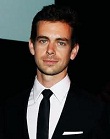
In Mar. 2006 Twitter.com is founded by Jack Dorsey (1976-), becoming the first Internet telegraphing service, where users can select whose message stream of up to 140 chars. per message to follow; on Aug. 27 Chris Messina invents the Twitter hashtag, with the first Tweet using it reading "how do you feel about using # (pound) for groups."
On Jan. 1, 2007 Nature Biotechnology reports that scientists have "knocked out" the genes responsible for making prions, making cows potentially immune from made cow disease. On Jan. 7 researchers at Wake Forest U. and Harvard U. report in Nature Biotechnology that stem cells may be extracted from amniotic fluid donated by pregnant women. On Jan. 14 an article in the journal Nature Genetics claims that the gene SORL1 can raise the risk of developing the most common form of Alzheimer's disease. On Jan. 22 scientists at the Alpbach Conference in Austria warn that glaciers will disappear from the Alps by 2050; glaciers in the Tyrol are shrinking 3% a year. On Jan. 26 an article in Science by researchers at USC claims that the insula inside the cerebral cortex may control addictive cravings. In Jan. scientists at the Nat. Microbiology Lab in Winnipeg, Man., Canada reconstruct the 1918-19 Spanish flu virus from the exhumed body of a victim buried in Alaskan permafrost - how was I to know she was with the Russians too? On Feb. 2 the first "sniffs of air" of two huge distant planets, incl. HD209458b (900T mi. from Earth) by NASA's Spitzer Space Telescope cause surprise by the absence of water in their atmospheres. On Feb. 22 the Nat. Insts. of Health announce that circumcision reduces a man's risk of contracting AIDS from hetero sex by about half, stopping clinical trials because the results are so clear. On Feb. 28 Dutch researchers present findings at the 47th Annual Conference of the Am. Heart Assoc. that drinking a little alcohol each day, esp. wine (one-half glass) may be associated with an increase in life expectancy. In Feb. Takashi Tsuji et al. of Tokyo U. announce in Nature Methods that they have found a way to regrow teeth in mice using embryonic stem cells. In Mar. a group of top physicists incl. Brian Greene (1963-) of Columbia U. announce that time travel is beyond our capabilities - when did they announce this? In Mar. Swiss scientists build a robot lamprey that can swim like an eel and crawl on land like a salamander, allegedly showing how evolution might have worked. On Apr. 13 Science mag. pub. news of the sequencing of the genome of the Rhesus macaque Old World monkey, becoming the third primate to be sequenced. On Apr. 24 asronomers report finding potentially Earth-like Planet 581c a mere 20.5 l.y. (120T mi.) away in Libra orbiting a dim red dwarf star (like 80% of the stars near Earth); surface temp range is 34-124F. On Apr. 26 the first flight of NASA's Stratospheric Observatory for Infrared Astronomy (SOFIA) takes off from Waco, Tex. In Apr. the new mineral jadarite is discovered in Serbia, with the chem. formula sodium lithium boron silicate hydroxide, the same as written on a case of "kryptonite" stolen by Lex Luther in the movie "Superman Returns"; it is white, powdery and not radioactive. On May 8 Intel announces a new hafnium-based IC that will allow double the number of transistors per chip compared to silicon and is faster too. On May 20 Justinus Lahama of Jakarta, Indonesia catches a 4-ft. 110-lb. coelacanth, and keeps it alive in a pool for 17 hours. On May 28 ViaLactia of Australia announces Marge the Cow, the first cow with a genetic mutation to produce low-fat milk. In May Watson & Crick survivor James Dewey Watson (1928-) becomes the first person to receive his own personal genome map; too bad, on Oct. 14 an article in the Sunday Times Mag. contains some comments that piss off the PC police, saying that he is "inherently gloomy about the prospect of Africa", because "All our social policies are based on the fact that their intelligence is the same as ours, whereas all the testing says not really", and "There is no firm reason to anticipate that the intellectual capacities of peoples geographically separated in their evolution should prove to have evolved identically. Our wanting to reserve equal powers of reason as some universal heritage of humanity will not be enough to make it so", causing him to be fired from Cold Spring Harbor Lab on Oct. 18, and after tries to retract and apologize don't work, he resigns on Oct. 25, after which the Sunday Times pub. a cheap shot article claiming that 16% of his DNA is of African origin, using a flawed version of his genome map. On June 28 J. Craig Venter et al. announce the first species conversion, the conversion of one species of bacterium into another by replacing its DNA; "This is the equivalent of changing a Macintosh computer to a PC by inserting a new piece of software" (Venter); their next goal is to create a simple creature that has never existed before. On Aug. 4 the NASA Phoenix Mars Lander blasts off, with the mission of testing the icy ground near the planet's north pole for signs of past or present life when it lands in May 2008; it was named from the fact it was built from recycled parts from a scrapped 2001 mission. On Nov. 20 James Alexander "Jamie" Thomson (1958-) et al. of the U. of Wisc. report a new way to turn ordinary human skin cells into embryonic stem cells by adding four genes, defusing the debate about using human embryos; the same lab did the first stem cell-plucking from embryos in 1998. In Nov. 2,264 sq. mi. C19A becomes the largest iceberg on Earth after 4.4K sq. mi. B15 cracks in two. Garret Lisi proposes E8: An Exceptionally Simple Theory of Everything; it is disproven in 2010 by mathematician Skip Garibaldi of Emory U. On Dec. 20 Ohio anatomy prof. Hans Thewissen pub. an article in Nature claiming to have found the long-sought missing link between land animals and whales (the hippo having proved a dead-end), the Indohyus, a cross between a long-tailed deer and an overgrown long-legged rat - what's that intelligent design stuff again? By the end of this year scientists have discovered 260 planets orbiting stars other than the Sun. Green Pea Galaxies are discovered by amateur astronomers. Dutch school teacher Hanny van Arkel discovers mysterious Hanny's Voorwerp close to spiral galaxy IC 2497 in the constellation Leo Minor, a huge hole 16K l.y. across sans stars with an unusually green color; on June 17, 2010 Hayden Rampadarath concludes that it contains a massive black hole at its center. Kenya's nat. museum stages its first public display of Turkana Boy, the most complete prehistoric human skeleton ever found, causing Christian evangelical Bishop Boniface Adoyo to lead a protest, saying "I did not evolve from Turkana Boy or anything like it". A 405-y.-o. quahog clam is dredged off the N coast of Iceland, becoming the world's oldest known living animal.
On June 29, 2007 (Fri.) Apple begins marketing their techno-beautiful iPhone enhanced cell phone to long lines of waiting customers, who pay up to $600 each; too bad, AT&T can't handle the increased load on its servers, causing many to have problems activating it, so that even its alarm clock won't work; later buyers learn that the battery is soldered in and it requires a technician to replace it for $79. On Jan. 27, 2010 (13:00 ET) Apple unveils the $499 iPad ($629 with AT&T data), becoming a giant hit - a feminine hygiene product for robots?

In 2007 Nassim Nicholas Taleb (1960-) pub. The Black Swan, about how major scientific discoveries tend to be undirected and unpredicted "black swans", incl. the PC and Internet, forming counterexamples to the Western idea that "All swans are white" (originated by Juvenal in 82 C.E.).
On Jan. 18, 2008 Botanic Gardens Conservation Internat. issues a statement that "400 medicinal plants are at risk of extinction, from over-collection and deforestation, threatening the discovery of future cures for disease"; examples incl. Yew trees, Hoodia, Magnolias, and Autumn crocus. On Jan. 31 British scientists announce the creation of sperm cells from a human female embroyo, opening up the possibility of lesbian couples having children. On Feb. 14 the 124K-member Am. College of Physicians calls for the U.S. govt. to end its ban on research on marijuana as a medicine. On Feb. 14 an article in Nature reveals what we've always wanted to know, whether bats developed their airborne sonar before or after learning to fly, a 52M-y.-o. bat fossil of Onychonycteridae finneyi (AKA "the clawed bat") (found in Wyo. in 2003), showing wings but no sonar equipment, and claws on all five fingers instead of just 1-2 like modern bats - so they got sonar after trimming Lady Five Fingers? In Feb. High Frequency Active Auroral Research Program (HAARP) creates a patch of "artificial ionosphere" using their 3.6MW radio transmitter, leading to a new way to bounce radio signals around the Earth. In Mar. Avraham Trakhtman, a Russian immigrant to Israel who worked as a night watchman becomes a real-life Good Will Hunting by solving the 1970 Road Coloring Problem, proving the existence of a universal map permitting a traveler to reach a given destination whatever his starting point. On Apr. 24 an article in Science reports that protein derived from T-Rex bones closely resembles the main protein in chicken and ostrich bones and is only distantly related to lizard protein - tastes like chicken jokes here? In Apr. astronomers discover a storm on Saturn's moon Titan the size of India. On May 5 Archives of Gen. Psychiatry reports that 6-year-olds whose mothers breastfeed them have a verbal IQ 7.5 points higher - the next study will show that oral sex raises IQ among adults? On June 16 a Swedish study of 90 adults pub. in the Proceedings of the Nat. Academy of Sciences Journal finds that gay men and hetero women have brain halves of similar size, while lezzies and straight men have bigger right sides, lending evidence to sexual orientation being genetically determined or influenced - or proof that the once perfect 100% straight human race is degenerating through God's judgment on sin? On June 19 the New England Journal of Medicine pub. a report on a 52-y.-o. Ore. man with terminal skin cancer who was put into remission after an experimental treatment that revved up his T cells. On June 28 U.S. scientist Mark Serreze of the Nat. Snow and Ice Data Center in Boulder, Colo. predicts that the North Pole may becoming ice-free for the first time in recorded history by the end of the summer; luckily, he was wrong. On July 25 an article in Science shows that in the U.S. girls in grades 2-11 have caught up with boys in math tests in the top 5% echelon, making former Harvard U. pres. Lawrence Summers look lame - but what about at the college and postgraduate level? In Aug. the $10B 5-mi.-diam. Large Hadron Collider in Meyrin Switzerland begins test runs, hoping to eventually prove the existence of dark matter and dark energy, which make up 96% of the Universe, plus the Higgs boson, which gives mass to matter, not to mention evidence of the 10 dimensions of superstring theory; meanwhile critics warn that it might cause micro black holes to be created which hunker down inside the Earth and gobble it up; an electrical fault in Sept. 2008 causes it to be shut down until Nov. 20, 2009; in 2009 Holger Bech Nielsen of Denmark and Masao Ninomiya of Japan pub. a theory that the Higgs boson is so abhorrent to Nature that its creation could ripple back in Time and stop the colider before it could make one. On Aug. 5 the Wildlife Conservation Society reports that the gorilla pop. in the Congo is now 125K, double what they used to believe. On Sept. 1 Google releases Chrome, a free open-source competitor to Microsoft's expensive monopolistic Internet Explorer. On Sept. 5 three studies are pub. in Science and Nature, showing how the cascade of genetic changes that turn brain and pancreas cells cancerous proceed along the same 12 core pathways. On Sept. 16 Vatican spokesman Archbishop Gianfranco Ravasi announces that Darwin's Theory of Evolution is compatible with the Bible, but plans no posth. apology to Charles Darwin (1809-82), while announcing a Rome conference next Mar. for the 150th anniv. of his "Origin of Species". On Sept. 28 (Sun.) SpaceX (Space Exploration Technologies) successfully launches its commercial rocket Falcon 1 into orbit from the South Pacific carrying a dummy payload on the 4th attempt. On Oct. 17 the NASA Cassini spacecraft makes the first observations from within the radio aura of another planet other than the Earth, Saturn. On Oct. 22 India launches its 2-year Chandrayaan-1 ("Moon Craft-1") mission (ends 2008) to map the lunar surface and search for water; it reaches the Moon on Nov. 12; in Aug. 2009 it detects evidence of large quantities of water in the polar regions. In Oct. photos of Mercury sent by the NASA Messenger spacecraft reveal that the planet was racked by volcanoes 3.8B-4B years ago, but fail to reveal the composition of the mysterious blue material all over the planet. On Nov. 12 doctors announce that a 42-y.-o. Am. patient living in Berlin, Germany has been cured of AIDS after receiving a bone marrow transplant 20 mo. earlier, giving AIDS patients hope, although the procedure is costly and dangerous. On Nov. 14 the Hubble Space Telescope captures the first photos of planet Formalhaut B, circling Formalhaut 25 l.y. from Earth in the constellation Piscis Australis (Southern Fish), becoming the first photo of a planet circling another star outside the Solar System. On Nov. 20 Nature pub. the result of a $1M study by Stephen Schuster et al. of Penn State U. which deciphered the genetic code of the woolly mammoth, concluding that they could be recreated in as little as 10-20 years - tell McDonald's to try selling one billion of them burgers? In Nov. the U.S. govt. begins funding the Human Microbiome Project to see if shit from one person's intestines can help another person with antibiotic-resistant C. difficile to fight back - shit happens jokes here? In Nov. scientists announce that they have mapped all of the genes of a person with cancer, incl. normal and cancerous cells. In Nov. IBM announces Blue Gene, a supercomputer that they will use to explore the frontiers of computing and brain simulation. On Dec. 28 Thomas Inge et al. of the Cincinnati Children's Hospital report that stomach stapling can reverse Type 2 diabetes in youths just like in adults. On Dec. 30 China announces the discovery of the largest dinosaur fossil site on Earth in Zhucheng, containing 7.6K fossils. In Dec. Alexey Vikhlinin announces that observations from the Chandra X-Ray Observatory indicate that dark energy, which fights gravity to cause the Universe to keep expanding also keeps clusters of 1K or more bright galaxies from getting too big. In Dec. the first exo-solar organic molecules are detected in Jupiter-sized Planet HD 189733b; next year HD 209458b becomes the 2nd exoplanet with organic signatures detected. Seth Lloyd of MIT proposes Quantum Illumination to improve the sensitivity of radar. Japanese scientist Osamu Shimomura isolates a glowing green fluorescent protein in the jellyfish. The Dark Flow of billions of stars racing towards the edge of the observable Universe is discovered by Harald Ebeling of the U. of Hawaii and Dale Kocevski of UC Santa Cruz. Am. neurologists Jack Gallant and Shinji Nishimoto at UCB discover a way to correlate activity in the human brain cortex with static images seen by the subject; next year they extend the technique to moving scenes.
In June 2008 cuil search engine is launched by ex-Google employees. The $549 ASUS Eee PC 900 netbox is released, with an 8.9-in. display, 12 GB SSD, and 1 GB of RAM, starting yet another techie gadget rev. The Blu-Ray and HDVD formats are locked in competition for HD DVD players this year. The NuVinci Transmission is patented, using rotating and tilting balls to smoothly vary transmission speed. The Octopus Tap increases the flow of beer from a beer tap, allowing up to four spouts. The Bullet Fingerprinting Technique is invented, allowing fingerprints to be recovered from bullets.
On Feb. 3, 2009 BioEssays pub. an article by Nick Lane, William Martin et al. of the Univ. College London, rejecting J.B.S. Haldane's 1929 "Primordial Soup Theory for the Origin of Life" in favor of origin in deep-sea hydrothermal vents, powered by hot gases incl. hydrogen, CO2, nitrogen, and hydrogen sulfide. On Feb. 24 the NASA's $280M Orbiting Carbon Laboratory designed to detect worldwide carbon emissions plunges into the ocean after launch from Vandenberg AFB in Calif. when the nose cone fails to come off, weighting it down. On Mar. 17 the Gravity Field and Steady-State Ocean Circulation Explorer (GOCE) satellite is launched by the European Space Agency. On Apr. 4 the 3-year Study of the Therapeutic Effects of Intercessory Prayer (STEP) is pub. in the Am. Heart Journal, finding no evidence for divine intervention but detecting a possible proof for the power of negative thinking, with patients who were prayed for and knew it experiencing a higher rate of postsurgical heart arrhythmias (59% vs. 52%). On Apr. 5 the journal Motivation and Emotion pub. an article claiming that those who smile in their high school yearbook photos had a 5x lower divorce rate than those who frowned, not counting ever-smiley Hollywood celebs. On Apr. 10 researchers at UT Southwestern Medical Center announce that TB4 (Tymosin Beta-4) encourages growth and repair of heart cells if injected after a heart attack. On Apr. 14 the United Arab Emirates claims the world's first cloned camel, the Arab version of Dolly the Sheep, a 1-humped female called Injaz born on Apr. 8 after five years of work. On Apr. 21 Swiss and French scientists from the European Southern Observatory in Chile led by Michel Mayor announce the most Earth-sized and temperate planet yet found beyond the Solar System, #4 orbiting Gliese 581, a dim red star 21 l.y. away, becoming the first of 340+ planets discovered since 1995 that might be able to support life. On May 21 Science Daily reports that so-called "junk DNA" isn't junk but performs vital functions, using genes called transposons to regroup the DNA at key phases in the lifecycle. On May 22 PLoS Genetics announces that HIF-1 (hypoxia-inducible factor 1), which helps survive by turning on when oxygen levels are low plays a role in human cancer, explaining why dietary restriction lengthens lifespan. On May 27 in an article in Nature, scientists in Japan led by Erika Sasaki announce the creation of the first genetically-modified "transgenic" monkeys that can pass their new genetic attributes to their offspring, producing baby marmosets Kei and Kou, whose skin glows green under UV light, causing concerns to be raised of it being used on humans - the answer to race, make everybody into pastel glow in the dark colors? On May 28 a team at the U. of New South Wales in Australia announces that they have used stem cells to help grow contact lenses for corneal patients. On June 9 the journal Genetic pub. a breakthrough by a team of scientists in Germany, Russia, and Sweden of locating the set of genetic regions responsible for animal tameness. On June 16 Nature Materials mag. announces that scientists at NYU have created a method to precisely bind nano and micrometer-sized particles together into large-scale structures after overcoming the problem of uncontrollable sticking. On June 19 German scientists announce official approval for Ununbium as chemical element #112; it was first announced in 1996. On June 19 researchers at the Montreal Neurological Inst. announce in Science the capturing of the protein translation mechanism underlying long-term memory formation. On June 19 Evolutionary Ecology mag. pub. the discovery of the first plant that feigns sickness to avoid insect attacks, Caladium steudneriifolium, found in the forests of S Ecuador. U. of Ga. researcher Jason Locklin et al. develop a method of growing molecular wire brushes that conduct electricity, becoming a first step toward developing biological fuel cells for pacemakers, cochlear implants, and prosthetic limbs. On June 24 the Proceedings of the Royal Society B in Britain reports that warmer environments cause faster microevolution in mammals; until now the effect was only shown for plants and ectothermic marine animals. On June 26 Nature pub. research by the Carnegie Inst. in Md. showing that adult rather than embryonic stem cells can be used to treat muscular disorders. On June 27 Nature Biotchnology pub. an article by Australian scientists Jennifer MacDiarmid and Himanshu Brahmbhatt that they have achieved a 100% survival in mice with human cancer cells using a new "trojan horse" therapy. In June students at Cambridge U. create the seven E. chromi strains of Escherichia colia, one in each color of the rainbow using BioBricks, pioneering synthetic biology; MIT later creates a Registry of Standard Biological Parts for them. In June Yale U. physicist Leonardo DiCarlo et al. make the first solid-state quantum processor, which uses quantum entanglement. In June satellite data reveals that the Earth's temp has dropped by 0.74F since former U.S. vice-pres. Al Gore released "An Inconvenient Truth" in 2006, indicating that the Earth's fever has broken? On July 7 English scientists in Newcastle claim to have created the first human sperm in the lab using stem cells; men are doomed to obsolescence? On July 8 U. of Adelaide and Cambridge U. scientists announce a way of genetically modifying crops to allow them to grow in salty water, promising more food for hungry nations. On July 8 the NASA Cassini spacecraft obtains the first direct evidence of liquid methane lakes on Titan. On July 13 Nature Photonics pub. the discovery by a team at Yale U. of a repulsive force of light, which along with the attractive force can be used as mechanical switches on IC chips; the force is caused by two beams out of phase with each other, and is at right angles to the beams; "The light force is intriguing because it works in the opposite way as charged objects. Opposite charges attract each other, whereas out-of-phase light beams repel each other." (Wolfram Pernice) On July 16 Human Mutation pub. a study by scientists in Montreal, Canada that find a difference between the DNA of blood and tissue cells, shaking up the scientific world. On July 20 Australian amateur astronomer Anthony Wesley alerts NASA to the presence of a new scar on Jupiter's atmosphere on July 19, caused by an unseen object hitting it, which turns out to be a Titanic-sized asteroid - Bernie Madoff's gigabuck loot capsule? On July 23 Nature pub. an article by Taylor Perron et al. of UCB that theoretically predicts the topographic wavelength of ridges and valleys, and explains whey they tend to be evenly spaced despite the underlying soil type. On July 23 the the first panda cub is born using frozen sperm, at Wolong Giant Panda Research Center in Sichuan, China; the mother is You You. On July 26 Nature pub. an article describing the Multiplex Automated Genome Engineering Method, which allows multiple genes to be edited in parallel. In July researchers at Northwestern U. report the first successful growing of mature human eggs in the lab. On July 26 Green Pea Galaxies that form stars 10x faster than the Milky Way despite being 10x smaller and 100x less massive are discovered by amateur astronomers. In July Nature pub. a report by Chinese scientists of the first use of induced pluripotent stem cells to clone mice from adult mouse skin cells. The July issue of the FASEB Journal reports the discovery of why bats live longer than closely rleated animals such as mice, namely, proper protein folding. In July the Journal of Neuroscience reports research by Shihui Han et al. of Beijing U. that shows that brains respond less strongly to the pain of strangers whose ethnicity is different compared to strangers of one's own race. In July opthalmologist John Marshall of King's College, London announces a new technique called Retinal Regeneration Therapy to reverse the onset of macular degeneration (AMD) using a laser to clean debris from Bruch's membrance behind the retina. In July the Proceedings of the Nat. Academy of Sciences pub. a report by researchers at Rice U. led by Yizhi Jane Tao that they have described the atomic structure of the protein shell carrying the genetic code of hepatitis E (HEV). In July scientists at Oxford U. announce in Nature Physics the creation of transparent aluminium by using a powerful soft X-ray laser; the same material was made up for the flick "Star Trek IV". In July Moshe Shoham of the Technion Inst. in Israel develops the first micro robot that can crawl through the human body on micro legs. In July an article in Biogeosciences report that satellite image studies reveal that the Sahara has been slowly regreening between 1982-2002. On Aug. 10 researchers at the Feinberg School of Medicine of Northwestern U. announce that schizophrenia is caused by a deficiency in the brain protein kalirin, causing a traffic jam in the frontal cortex. On Aug. 6 an article in Nature announces that the genetic structure of the HIV-1 virus has finally been decoded. On Aug. 10 scientists at the Lawrence Berkeley Nat. Lab of the U.S. Energy Dept. announce a new high-throughput protein pipeline that determines protein structure in days rather than years. On Aug. 12 astronomers announce the discovery of WASP-17, a planet that orbits a star 1K l.y. from Earth in a direction backward compared to the rotation of the host star, becoming the first-ever. On Aug. 12 the Journal of Biological Engineering pub. an article describing the use of bacteria to build a computer that can solve the Hamilton Path Problem by Todd Eckdahl et al. at Mo. Western State U. On Aug. 17 Joel Smoller of the U. of Mich. and Blake Temple of the U. of Calif. pub. the Big Wave Theory as an alternative to Dark Energy to explain the apparent expansion of the U as caused by an expanding wave in spacetime. On Aug. 17 Vladimir Shalaev et al. of Purdue U. announce the Spaser, the tinest laser ever made. On Aug. 24 Andrew Elefanty, Ed Stanley et al. at Monash U. pub. an article in Nature Methods describing how they have modified stem cells into ErythRED cells, which glow red when they become red blood cells. In Aug. 26 Shoukhrat Mitalipov et al. of the Ore. Health and Sciences U. in Portland announce that they have produced monkeys with DNA from two mothers, raising legal questions for human use. In Aug. Tom Ran and Ehud Shapiro of the Weizmann Inst. in Israel develop a DNA computer that can answer yes-no questions. In Aug. astronomers discover an interplanetary smash-up around young star HD 172555, where an object the size of Earth's Moon slams into a planet the size of Mercury. In Aug. NASA scientists discover glysine in comet Wild 2 (pr. vilt), becoming the first amino acid found in a comet. In Aug. Jay Shendure and Sarah Ng of the U. of Wash. discover the genetic cause of Miller Syndrome, which causes facial malformations et al. On Sept. 3 scientists at the Gladstone Inst. of Cardiovascular Disease pub. an article in Nature tracing the evolution of the 4-chambered human heart to a common genetic factor with turtles and other reptiles. NASA's Jet Propulsion Lab (JPL) deploys spiderbots inside Mount St. Helens, becoming the first network of volcano sensors that can automatically communicate with each other and with satellites without using a base station. On Sept. 3 an article by Jonathan Morris et al. of the Helholtz Centre for Materials and Energy in Berling pub. a paper claiming experimental proof for magnetic monopoles. On Sept. 16 Laboratoire d'Astrophysique in Marseille, France announces the discovery of the first rocky world beyond the Solar System, CoRoT-7b. On Sept. 24 a report in Current Biology announces that researchers can tell what number of dots a person has seen by analyzing brain activity; another report in Neuron announces that they can reconstruct images from recorded neural activity. On Sept. 30 EMBO Molecular Medicine reports that old human muscle can be maintained and repaired by stem cells to restore youthful vigor. On Sept. 30 Nature pub. an article by Hong Sheng Zhao of the U. of St. Andrews in the U.K. reporting that measurements don't support the theory of dark matter. In Sept. the RV 144 AIDS vaccine is found to work on 30% of 16K volunteers from Thailand, becoming the first vaccine that works, although scientists don't know how. In Sept. scientists from Cal Tech report results from NASA's Advanced Composition Explorer (ACE) that cosmic ray concentrations in 2009 are 19% higher than at any time in the last 50 years. On Oct. 2 Tim White of UCLA et al. announce in Nature the discovery of Ardipithecus ramidus AKA Ardi, a female skeleton dated at 4.4M years ago, about 4 ft. tall and 110 lbs., who can stand on two legs and swing through trees with opposable big toes, being 1M years earlier than Lucy and hence our mother, also the mother of chimps, finally ending the debate of whether humans are descended from chimpanzees? On Oct. 3 Nature announces the discovery by Anne Verbiscer of the U. of Va. et al. of a new nearly invisible ring around Saturn. On Oct. 9 (4:30 a.m. ET) NASA crashes the LCROSS (Lunar Crater Observing and Sensing Satellite) into the Moon at 5.6K mph to blast a huge hole in search of hidden water, creating a 30-mi.-high plume observable from Earth with a 10-in. telescope; too bad, no plume was seen. On Oct. 10 scientists at Columbia U. announce in the Proceedings of the Nat. Academy of Sciences that they have created the first complex anatomically-sized bone from human adult stem cells, part of a human jaw bone. On Oct. 14 a study is pub. in Nature by Joseph Ecker of the Salk Inst. announcing the mapping of the first complete human epigenome, the first layer of genetic control. On Oct. 27 (8 a.m.) the prototype $450M NASA Ares I-X (Space Shuttle replacement), designed for the Constellation program that will return astronauts to the Moon by 2020 is launched less than a week after a blue-ribbon panel released its final report bringing the future of the human spaceflight program into question, and recommending that it be privatized; a large dent near the base is found on the rocket after it splashes into the Atlantic Ocean. In Oct. Geophysical Research Letters reveals that a vertical hole on the Moon has been discovered that's as big as a city block and as deep as a modest skyscraper. On Nov. 13 the Darwin Was Wrong Conference in Costa Mesa, Calif. presents evidence and arguments blasting Charles Darwin and Darwinian Evolutionary theory, calling him a great writer but not a great scientist, and claiming that the famous Lucy skeleton is really a man. On Nov. 20 Washington U. in St. Louis, Mo. announces the decoding of the corn (maize) genome. On Nov. 26 the New Journal of Physics describes a new plama disinfection device which works even on the hospital superbug MRSA. In Nov. Sasha Kashlinky et al. of the Goddard Space Flight Center in Md. announce that they believe that something big beyond the visible edge of the Universe exists that is causing 1K galaxy cluters to stream toward it at high speed. In Nov. NASA scientists reproduce uracil in the lab, becoming the first key component of RNA reproduced. Constantinos Daskalakis of MIT pub. a doctoral thesis in game theory that is a breakthrough on Nash equilibrium, proving that it belongs to the subset of NP called PPAD-complete, which is NP-complete with an equilibrium that always exists, becoming the biggest breakthrough in 10 years. On Dec. 2 the U. Bio-Medico of Rome announces a new brain-controlled bionic hand, which works successfully on patient Pierpaolo Petruzziello. On Dec. 16 Nature Genetics pub. research from the Babraham Inst. revealing that genes work together by huddling in clusters in the nucleus. On Dec. 16 British researchers Michael Stratton et al. of the Wellcome Trust announce the decoding of the genomes of lung and skin cancers; lung cancer DNA has more than 23K errors, with every 15 cigarettes causing one error; skin cancer (melanoma) has more than 30K errors. On Dec. 16 researchers announce the finding of the first known burial shroud from the time of Jesus in the 1st cent. C.E. in Jerusalem; the dude has leprosy and TB; its simple weave doesn't jive with the Shroud of Turin's complex design. On Dec. 17 Nature describes 4-Dim. Microscopy, developed at Caltech, allowing photons to be filmed with electrons. The ABCA13 Gene is discovered to be partially inactive in patients with severe psychological conditions incl. schizophrenia by an internat. team of scientists led by Edinburgh U. The World Digital Library Project is started by Tadahiro Kuroda et al. of Tokyo U. to attempt to preserve the contents of digital media in semiconductor memory chips that will last 1K years, vs. 10 years for CD-ROMs. George Ellis from the U. of Cape Town and Tony Rothman of Princeton U. propose a new Quantum Block Universe Model in which the past crystallizes out of the future, in which "The arrow of time arises simply because the future does not yet exist". Wasp-18b, a "hot Jupiter" planet orbiting the star Wasp-18 330 l.y. from Earth upends the physicists' understanding of celestial mechanics because it orbits so close that it should have been consumed by the star in less than 1M years. Human Genome Sciences of Rockville, Md. successfully tests the Lupus drug Benlysta.
In Feb. 2009 researchers at the U. of Calif. San Diego (UCSD) demonstrate their Einstein Robot, which incl. the ability to smile. On Apr. 27 IBM announces the Question Answering (QA) system, which they plan to put in a human vs. computer test on TV's "Jeopardy!". In Apr. the Hitachi Ltd. Wooo H001 Cell Phone has a 3-D mode, but is too cumbersome and isn't marketed in the U.S. On June 19 Manchester U. physicist Andre Geim announces the invention of Graphene, the thinnest and strongest known material in the Universe, one atom thick, made of pure carbon; it has the potential of beating silicon as the fastest material for computer chips. In June Bing.com search engine is launched by Microsoft to compete with Google. On July 8 Google announces that it is developing the Chrome Operating System in direct competition to Microsoft's bug-filled Windows Operating System for netbooks. On Oct. 22 Microsoft launches Windows 7, hoping to win back millions of pissed-off customers who bought their cruddy Vista Operating System. On Oct. 29 Samsung Electronics Co. displays their 10.1" color electronic paper (e-paper) device, which they plan to produce in 1-2 years. In Oct. the first genetically-engineered "Holy Grail of the plant breeding world" blue roses hit the market in Japan at $22 apiece, 10x the usual price. On Nov. 17 NEC Electronics Corp. and Soundpower Corp. announce a new type of vibration-driven remote control that doesn't require a battery and can be used with home electric appliances, generating electricity from the vibration caused by pressing the button. On Dec. 8 a Plain Paper Battery coated with carbon nanotubes and dipped in lithium electrolyte solution that reduces battery weight by 20% is described by Liangbing Hu. On Dec. 15 the fuel-saving carbon composite 186-ft.-long Boeing 787 Dreamliner aircraft makes its first flight two years behind schedule. On Dec. 24 the first 1-Molecule Transistor is announced in Nature by researchers from Yale U. and Gwangju Inst. of Science and Tech. in South Korea. In Dec. the 5-pasenger BYD E6 electric car from China is introduced, going 250 mi. on a single charge. In Dec. UCSD prof. Ricardo Dominguez announces the Transborder Immigrant Tool, a cell phone app to help illegal immigrants from Mexico find the best locations for food, water, and groups to help them sneak into the U.S. In Dec. MIT develops a new wheel for bicycles that captures the kinetic energy released when it brakes and saves it for when the rider needs a boost. Cloud computing begins to threaten software giant Microsoft et al. by providing software as a service rather than a product, with leaders incl. Google. Ares (Assembling Reconfigurable Endoluminal Surgical System by Scuola Superiore Sant'Anna in Italy is swallowed by the patient in 15 separate parts, after which it self-assembles inside the body and helps surgeons carry out procedures. Blue Brain is built by Ecole Polytechnique Federale de Lausanne in Switzerland, attempting to duplicate the brain in silicon. The Eigenharp, an new electronic combo sitar-bassoon is marketed by Eigenlabs in Devon, England. Nepalese science student Milan Karki (1991-) invents a solar panel made of human hair; a £23 panel produces 9V at 18W, 4x cheaper than current panels. Jeremy O'Brien, Jonathan Matthews, Alberto Politi et al. of the U. of Bristol build a siicon chip that implements the 1994 Peter Shor algorithm to crack the RSA algorithm, making the govt. and all computer users nervous. The USAF RQ-170 Sentinel is a stealth reconnaisance jet aircraft flying wing, AKA the Beast of Kandahar. The Ceramtek Wonder Battery, built in Salt Lake City, Utah crams 20-40 KWH of energy into a refrigerator-sized package, promising to revolutionize the world and end dependence on an energy grid. The DEKA Arm (AKA Luke after Luke Skywalker of "Star Wars") is developed with funds from the Pentagon. HP Labs announces a project to build the Central Nervous System for the Earth (CeNSE) as part of the emerging Internet of Things. Frank Guenter et al. of Boston U., Harvard U. and MIT develop the first thought-to-speech translator. The ErockIT electric pedal-assisted bicycle from Germany attains speeds of 50 mph. Tire manufacturer Yokohama begins marketing Super E-spec Tires, made with orange oil instead of rubber to save on petroleum. The Nao humanoid robot can surf the Web. British scientist Jon Spratley develops a "telepathic microchip" allowing paraplegics to control computers. Softkinetic and Optima of Belgium invent 3-D Gesture Recognition, allowing TVs and videogames to be controlled by a wiggle of the fingers. The hydrogen-powered Riversimple Car is leased at $315 a mo.; the first vehicles go into production in 2013. Nephelios, a solar-powered blimp is built by high school engineering students in France. Hiroshi Ishiguro of Japan creates a robot twin called Geminoid HI-1, which incl. his personal idiosyncrasies such as tapping its toes and fidgeting. The Bloodhound SSC supersonic car is developed, containing a rocket, a jet engine, and a V-12 gasoline engine; it will try to break the 1600 km/h (1000 mph) land speed barrier in 2011. Julie Sodem et al. of the U. of Ulster invent a Formula Three car made out of cashew nut cells and other recycled materials, which runs on bio-disel and has a top speed of 130 mph. Toyota develops the Brain-Machine Interface, allowing a person to control a wheelchair with his mind; an emergency stop is effected by puffing one's cheeks. The first slime mold biological robot (AKA Plasmobot) is built in Britain. Victor Gura of UCLA invents a portable kidney dialysis machine. Rickard Hederstierna (1982-) invents the Cocoon, a glass cooker that grows a meatlike material for food out of packets containing muscle cells, oxygen and other nutrients. The Rear Projection Urinal is invented by a pub in Melbourne, Australia. The Toyota Flowers, developed from the cherry sage plant and gardenia absorb harmful atmospheric gases and create water vapor on the grounds of their Prius plant in Toyota City, Japan. The YikeBike looks like a bar seat but can be turned into a "mini penny-farthing" that goes 10 mph. Russia announces that it is designing a nuclear ship to fly humans to Mars, and that the design will be ready by 2010, after which it will take nine years and 17B rubles ($600M) to build it. Coca Colla, containing cocaine is manufactured in Bolivia, becoming a hit in the region, but running afoul of internat. drug laws; it has a red-white label like Coca-Cola, and is marketed as an energy drink.
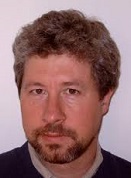
On Jan. 4, 2010 the Journal of Sexual Medicine pub. a study of 1.8K women that concludes that the female G-spot doesn't really exist but is subjective. On Jan. 4 the Proceedings of the Nat. Academy of Scientists pub. an article describing a computer method to spot art fakes by "sparse coding", which builds a virtual library of an artist's works and breaks them down into the simplest possible visual elements. On Jan. 6 Dutch physicist Erik Peter Verlinde (1962-) pub. the article "On the Origin of Gravity and the Laws of Newton", claiming that the force of gravity doesn't exist and is just a result of entropy, "an entropic force caused by changes in the information associated with the positions of material bodies", i.e., an emergent force like temperature, announcing the theory of Entropic Gravity. On Jan. 8 Radu Colea et al. of Oxford U. and Helmholtz-Zentrum Berlin fur Materialien und Energie in Germany pub. an article in Nature claiming to have seen signs of the Golden Ratio at the quantum level, becoming the first observation of hidden symmetry in a material. On Jan. 8 the Proceedings of the Nat. Academy of Sciences pub. a study by Mauro Santos of the U. of Barcelona rejecting the "metabolism first" theory that life originated from a system of self-catalytic molecules capability of Darwinian evolution sans the need of RNA or DNA. On Jan. 10 Reuben Harris et al. of the U. of Minn. pub. an article in Nature Structural and Molecular Biology announcing the discovery of the human immune cell enzyme APOBEC3A that deactivates and degrades foreign DNA. On Jan. 10 Astrophysical Journal Letters pub. an article explaining the mysterious Space Ribbon at the outer boundary of the Solar System as a reflection of solar wind particles by a galactic magnetic field. On Jan. 14 William Peterson of the U. of Iowa et al. pub. an article in Nature reporting the detection of the first magnetic field from a star other than the Sun, a giant magnetic loop sweeping out from the Algol binary pair 93 l.y. from Earth. On Jan. 20 Nature pub. an article announcing that scientists have made a "microbial clock" consisting of bacteria that count time together. On Jan. 25 Martin Dominik of the U. of St. Andrews leads a conference at the Royal Society in London to develop a framework for responding to a possible discovery of extraterrestrial intelligence. On Jan. 27 scientists at Stanford U. announce that they have turned skin into nerve cells without intermediate steps. In Jan. A. Welfore Castleman Jr. et al. of Penn State U. announce the creation of superatoms with electronic signatures of more expensive or exotic atoms. In Jan. AraNet is announced, a new computational model to predict gene function of uncharacterized plant genes, with over 19.6K genes and 1M links. In Jan. Anna Tampiere et al. of Istec Lab of Faenza (near Bologna), Italy announce a new process for turning rattan wood into bone-like material. On Feb. 2 Thomas Nystrom of the U. of Gothenburg et al. pub. research poving that old and damaged mother cells produce health daughter cells by using a conveyor belt machanism to offload damaged proteins. On Feb. 3 Nature pub. an article by Gregory Scholes of the U. of Toronto et al., that algae and bacteria can perform quantum calculations. On Feb. 4 the Hubble Space Telescope reveals a weird bright spot on Pluto near the equator, perhaps caused by carbon monoxide frost. On Feb. 11 NASA launches the Solar Dynamics Laboratory to observe the Sun for 5+ years, producing new high-detail images incl. extreme closeups of surface activity. On Feb. 11 Neuron pub. an article by Cosimo Urgesi et al. of the U. of Udine in Italy linking a specific area of the human brain with the personality trait of self-transcendence. On Feb. 14 Nature Photonics pub. research by Andrew MacRae et al. of the U. of Calgary on constructing 2-story "quantum toy houses" using photons. On Feb. 19 Cell pub. research by Susan Golden of UC San Diego et al. describing how the cell's biological clock works. On Feb. 21 U. of Colo. researchers Margaret Murnane and Henry Kapteyn announce the creation of a tabletop X-ray laser, which can be used for super hi-res imaging. On Feb. 22 52 Turkish military cmdrs., incl. 21 gens. and adms. are arrested for allegedly planning to blow up mosques to precede a military overthrow of the Islamic-oriented govt., signaling a V against the secularist govt. founded by Kemal Ataturk in the 1920s, and which has ousted four govts. since 1960; 400 have been jailed since the July 2007 reelection of PM Recep Tayyip Erdogan, although nobody has been convicted. On Feb. 22 a suicide bomber in a busy market in the district capital of Minora in the Swat Valley of NW Pakistan kills eight and wounds dozens, incl. British convert Belinda Khan (b. 1965). On Feb. 22 eight members of a Shiite family are killed in the Sunni-Shiite village of Wahda 20 mi. S of Baghdad; some are beheaded, raising fears of a resurgence of Sunni insurgents. In Feb. Lori Marino et al. of Emory U. pub. their research on dolphins, claiming they are the 2nd most intelligent species to humans and that they should be treated as "non-human persons" and not kept in zoos. In Feb. Cancer Epidemiology, Biomarkers & Prevention pub. a study by Noel Mueller et al. indicating that drinking two or more soft drinks a week doubles the risk of pancreatic cancer. On Mar. 1 the Journal of Animal Behavior pub. a study by Markus Knaden et al. of the Max Planck Inst. for Chem. Ecology in Jena, Germany, proving that some ants navigate by stereo smell. On Mar. 4 a panel of 41 world scientists announces that the theory of extinction of the dinosaurs by an asteroid has been proven, and the volcano theory disproven. On Mar. 9 researchers at the City of Paris Industrial Physics and Chemistry Higher Educational Inst. (ESPCI) pub. an article in Physical Review Letters about research showing that it's possible to focus light through opaque materials and detect objects behind them using the material's transmission matrix. On Mar. 24 Michael West pub. research showing how to turn any adult cell into a completely rejuvenated stem cell; the same week, the Internat. Stem Cell Corp. announces a breakthrough with parthenogenic stem cells. On Mar. 27 Universe Today pub. an article by Matthew Hayesthat observations with the HAWK-I telescope camera show that 90% of galaxies have gone undetected. On Mar. 29 Nature pub. research by the U. of Tex. M.D. Anderson Cancer Center that a 2-drug combo can destroy precancerous colon polyps. In Mar. Eleanor Maguire et al. at the Wellcome Trust Centre for Neuromaging at the Univ. College London announce the creation of a computer algorithm that can predict which of three short films a person is thinking about by analyzing brain activity. On Apr. 6 Theodor W. Hansch et al. of the Max Planck Inst. announce in Nature the first multi-particle entanglement in a Bose-Einstein Condensate on a microchip. On Apr. 7 Thomas Werner et al. of the U. of Wisc.-Madison announce in Nature that the protein called Wingless helps fruit flies produce 16 colored spots in their wings, leading to theorizing that it controls all complex animal color patterns. On Apr. 8 Robert Danovaro et al. of Marche Polytechnic U. in Ancona, Italy announce the Spinoloricus Cinzia and two other new species of the Loriciferans group, the first animals that can survive and reproduce entirely without oxygen, who live on the floor of the Mediterranean Sea. On Apr. 8 Am. paleoanthropologist Lee R. Berger pub. a report in Science on the new hominid species Australopithecus sediba (Sotho for fountain or wellspring) that lived in South Africa 1.78M to 1.95M years ago and might be the missing link. On Apr. 11 Howard Kaufman et al of Rush U. in Chicago, Ill. announce a new cure for melanoma (skin cancer) using a vaccine treatment. On Apr. 13 the first direct recording of mirror neurons in the human brain is announced by Itzhak Fried et al. of UCLA in Current Biology. On Apr. 13 the RAS Nat. Astronomy Meeting in Scotland announces that a new group of 27 exoplanets contains six with retrograde orbits; 452 exoplanets have been identified. On Apr. 14 scientists at Newcastle U. in Britain announce in Nature the first three-parent IVF to prevent inherited disease by preventing damaged DNA in mitochrondria from being passed on by the mother. On Apr. 19 scientists at the NIST in Boulder, Colo. set a record for measuring the smallest force ever, 174 yoctonewtons (10^-24 newtons); the old record was in the attonewton (10^-18) range. On Apr. 22 scientists at Columbia U. announce the first lab-grown human jawbone using human stem cells. On Apr. 22 Nature Neuroscience pub. an article by Scripts Research Inst. and the Genomics Inst. of the Novartis Research Foundation (GNF) identifying a region of the protein TRPV1 that enables temperature sensitivity. On Apr. 23 IBM scientists announce the world's smallest 3D map, with 1K begin able to fit on a grain of salt. On Apr. 23 the first full face transplant is announced by a team of 30 Spanish doctors at Vall d'Hebron U. Hospital in Barcelona. On Apr. 30 Cell announces that researchers at UCLA led by Hong Zhou have used a new type of cryo-electron (cryo-EM) microscope to see atoms for the first time in a virus with 3.3 angstrom resolution. In Apr. Stephen R. Quake (1969-) becomes the first scientist in history to decode his own genome with a machine he invented. In Apr. Wake Forest U. School of Medicine in N.C. announces a bioprinter that sprays skin cells onto burn wounds to speed healing. In Apr. NASA unveils SOLO-TREC, a wax-filled buoy that is powered by temp differences in the ocean water. On May 2 Nature Genetics reports the cloning of the hemoglobin protein from mammoth blood, and that it oxygenates blood at lower temperatures than modern elephants. On May 18 the Fermi Nat. Accelerator Lab in Batavia, Ill. announces that 1% more muons than antimuons arise from the decay of B mesons, allegedly explaining why the Universe exists. On May 20 scientists at the J. Craig Venter Inst. announce the first organism controlled by completely manmade DNA, the first synthetic cell, a Mycoplasma bacterium with DNA made with four bottles of chemicals in a chemical synthesizer using computerized info., causing the word "Frankenstein" to be mentioned. On May 26 scientists at UC Irving announce the creation of a retina from human embryonic stem cells. On June 7 Steve Squyres et al. of Cornell U. announce that the rock outcrop Comanche on Husband Hill near Home Plate Plateau on Mars show evidence of a past wet non-acidic environment that may have been favorable for life. On June 14 scientists at the Geophysical Lab of Carnegie U. announce that the water content of the Moon is up to 5 parts per million, two orders of magnitude higher than previously thought. On June 18 Science pub. an article by Christopher Bronk Ramsey et al. of Oxford U. and Cranfield U., reporting that radiocarbon measurements from 211 different plants have given a more accurate dating of ancient Egyptian kings, making Pharaoh Djoser's reign 50-100 years earlier than before. On June 23 Ivan Schwab et al. of UCD announce a new stem cell treatment for blindness, with a 75% cure rate. On June 24 Laura Niklason et al. of Yale U. announce the building of the first functioning lung in a lab animal (rat) by growing cells on the skeleton of a donor lung. On July 9 Anthony S. Fauci of the Nat. Inst. of Allergy and Infectious Diseases of the Nat. Insts. of Health announces the discovery of two antibodies that can prevent 90% of known HIV strains from infecting human cells in the lab. On July 9 Geophysical Research Letters pub. an article by Noath Diffenbaugh of Stanford U., predicting that by 2039 most of the U.S. will experience four seasons as exceptionally long heat waves become commonplace. On July 22 astrophysicist Paul Crowther et al. discover R136a1, the most massive star yet discovered, which may once have weighted 320 solar masses. On July 23 Gregor Weihs et al. from the U. of Innsbruck and U. of Waterloo experimental confirm the 1926 Born's Rule that quantum interference only occurs in pairs of probabilities, not higher order. On July 23 Buckyballs are detected by Jan Cami of the U. of West Ontario 6.5K l.y. from Earth in the cosmic dust of Tc 1. On July 23 it is announced that 100+ Earth-like planets have been discovered in the past few weeks via the Kepler space telescope; scientists believe there might be 100M such planets in the Milky Way. On Aug. 9 researchers at UCI, UCSD, and Harvard announce the regeneration of nerve connections that control voluntary movement after spinal cord injury in rodents. On Aug. 19 scientists at the Nat. Insts. of Health announce the discovery of three antibodies that neutralize a broad range of HIV strains, making an HIV vaccine closer to reality. On Aug. 19 Abraham Loyter et al. of Hebrew U. announces the development of a new technique to eliminate HIV by targeting killing of only HIV-infected cells, becoming the first treatment that doesn't merely inhibit replication and delay onset. On Aug. 20 researchers at Loyola U. announce the discovery of a protein called TRIM5a that destroys HIV in rhesus monkeys; meanwhile other researchers isolate the protein BRCA2 that is involved in inherited cases of breast and ovarian cancer. On Aug. 23 Am. Chem. Society scientists report the first evidence that eating blueberries, strawberries, acai berries, and possibly walnuts may help the aging brain stay healthy by activating its "housekeeper" mechanism that cleans up and recycles toxic proteins related to age-related memory loss et al. On Aug. 23 Genome Research pub. a new study of Vitamin D that finds that it influences over 200 genes. On Aug. 23 researchers in the U.K. announce the successful use of drugs to restart the natural 24-hour body clock in lab mice. On Aug. 24 researchers at the European Science Observatory announce the discovery of the "richest" system of exoplanets yet found, five planets orbiting star HD 10180, 127 l.y. away in the southern constellation Hydrus. On Aug. 25 the first artificial corneas are announced by May Griffiths et al. of Linkoping U. in Sweden. In Aug. 26 Angewandte Chemie pub. work by MIT prof. Christopher Cummings et al. that instead of using chlorine, phosophorus can be attached to organic compounds using UV light. On Aug. 27 Nature announces the creation of the first 3-D atomic views of genetic processes by Song Tan et al. of Penn State U. On Aug. 27 British scientists announce the cracking, er, of the genetic code for wheat, and release it for free to help growers develop new better strains. On Aug. 30 the Proceedings of the Nat. Academy of Sciences announces the discovery in Romania of Balaur bondoc (stocky dragon), a kick-boxing cousin of Velociraptor that was unearthed in 2019 by Transylvanian geologist Mtys Vremir. In Aug. scientists find a treatment for the rare birth disorder congenital adrenal hyperplasia, which causes girls to develop ambiguous genitals and facial hair and fail to menstruate, causing an outcry from lesbians that this could lead to engineering in the womb to control sexual orientation. On Sept. 1 scientists in Utah announce that they can read words inside a human mind. On Sept. 5 Proceedings of the Nat. Academy of Sciences pub. research by the U. of Ore. that determined the fine-scale genetic structure of the first animal to show an evolutionary response to rapid climate change, the pitcher plant mosquito Wyoeomyia smithii. On Sept. 7 BioMed Central's Genome Biology reports the first sequencing of the entire genome of an Irish person; meanwhile PLoS Biology reports the 90%-sequencing of the genome of the turkey. On Sept. 17 David Grennan of Dublin, Ireland becomes the first amateur astronomer to discover a supernova. On Sept. 22 a team led by Daniel Meulemans Medeiros of the U. of Colo. pub. an article in Proceedings of the Nat. Academy of Science trace the genes for jaw development to lampreys. On Sept. 30 Bruce Kane of the U. of Md. announces the fastest-spinning object ever created, a speck of levitating graphene spinning at 60M rpm. On Sept. 30 Nature announces the first 3-qubit entanglement by a team at Yale U. On Sept. 30 Nature pub. an article by Peter B. McIntyre of the U. of Wisc. revealing that the world's rivers are in a crisis state. In Sept. astronomers announce the discovery of Gliese 581g (20 l.y. from Earth), the first exoplanet that can support liquid water and hence potentially life. In Sept. Global Rainmakers Inc. signs a contract with the city of Leon, Mexico to become the first city secured through biometric identification, via iris-scanning technology. Beatrice H. Hahn completes an analysis of great ape dung samples and discovers that the most dangerous form of malaria originated in gorillas not chimps. On Oct. 1 a study on breast cancer screening on women aged 40-49 in Cancer finds that annual mammography screening reduces the death rate by nearly 30%. On Oct. 3 Nature pub. an article by scientists Brandt Eichman of Vanderbilt U. et al. announcing discovery of a new way that DNA-repair enzymes detect and repair damageto the chemical bases that form the letters of the genetic code. On Oct. 4 the Proceedings of the Nat. Academy of Sciences pub. a study showing that storing fat in the thighs lowers the risk of metabolic disease, while ' storing it in the abdomen raises it. On Oct. 5 Lan Zhou et al. of the Cleveland Clinic in Ohio pub. research showing that inflammation helps heal wounds by producing insulin-like growth factor-1 (IGF-1), increasing the rate of muscle regeneration, revolutionizing treatment of sports injuries. On Oct. 11 Yuk Ting Ma et al. from the Inst. of Cancer Studies in Britain report the first link proved between smoking and epigentic changes associated with the development of cancer. On Oct. 14 Mark Brodwin of the Harvard-Smithsonian Center for Astrophysics pub. a paper in Astrophysical Journal announcing the discovery of a record galaxy cluster with 800T Suns and hundreds of galaxies 7B l.y. from Earth. On Oct. 15 a study of Egyptian mummies by Michael Zimmerman of Manchester U. finds no trace of cancer, suggesting that it is a manmade modern disease. On Oct. 18 the 2010 Living Planet Report of the World Wildlife Federation is pub., showing "an alarming rate of biodiversity loss in low-income, often tropical countries while the developed world is living in a false paradise, fuelled by excessive consumption and high carbon emissions", and claiming that humanity's demands on natural resources are skyrocketing to 50% more than the Earth can sustain. On Oct. 21 NASA reports vastly more water on the Moon than previously believed, along with mercury, gold and silver. On Oct. 21 Science pub. an article by scientists from Imperial College London et al., revealing that two strains of the Anopheles gambiae mosquito appear to becoming different species. On Oct. 25 a report by investigators at the U. of Mich. indicates that statin use is associated with a statistically significant reduction in colorectal cancer. On Oct. 25 Kevin Choe et al. of the U. of Tex. report that men with prostate cancer who take aspirin plus radiation therapy or surgery may cut their risk of dying by more than half. On Oct. 25 Susanne Dams of Eindhoven U. of Tech. reports that laser heat shocks of 45C on wrinkled skin causes the cells to produce more collagen, restoring firmness and elasticity. On Oct. 26 the Lawrence Berkeley Nat. Lab announces the discovery of six new isotopes of the superheavy elements. On Oct. 29 the U.S. Dept. of Justice files a brief saying that human and other genes should not be patentable because they are part of Nature and aren't manmade. On Oct. 31 Douglas Keszler et al. of Oregon State U. announce the creation of the first metal-insulator-metal diode, which could spawn a new industry. In Oct. Gary Miller et al. of Carnegie Mellon U. announce a breakthrough algorithm for solving systems of linear equations that promises a revolution in image processing, logistics and scheduling problems et al. On Nov. 10 the VIRUS-W spectograph sees "first light" at the Harlan J. Smith Telescope in Tex. with images of a spiral galaxy 30M l.y. from Earth. On Nov. 17 scientists from Lawrence Berkeley Nat. Lab and UCB announce the first successful trapping and storing of antimatter atoms. On Nov. 18 Rainer Klement of the Max Planck Inst. announces the discovery of the first planet of extragalactic origin in the Milky Way galaxy; still no planets outside it. On Nov. 24 scientists at the U. of Nottingham announce a breakthrough allowingthem to build 3-D nanomolecular structures on a 2-D surface. On Nov. 24 NASA's JPL pub. a study claiming that the Earth's largest lakes have warmed over the last 25 years due to climate change. On Nov. 25 NASA's Cassini probe discovers oxygen on Saturn's moon Rhea, becoming the first outside Earth. On Nov. 25 Christina Smolke of Stanford U. et al. announce the creation of a programmable genetic "circuit" that can make cells respond to signals to transform to different cells or die. On Dec. 2 Ed Weiler of NASA announces the discovery of the first known microorganism on Earth that can thrive and reproduce using the toxic chemical arsenic, located in Mono Lake in Calif. On Dec. 2 Calestous Juma of Harvard U. pub. an article claiming that African can feed itself in a generation. On Dec. 3 Cell Stem Cell pub. an article by Shen Ding of Scripps Research Inst. that a new cocktail of small drug-like molecules assisted by gene Oct4 enables reprogramming of human skin cells into stem cells. On Dec. 6 Vaccine pub. a study showing that flu vaccine can be grown in bacteria instead of eggs, allowing those allergic to eggs to take it. On Dec. 7 Charite Hospital in Berlin announces the first machine that can create MRI images of a baby being born. On Dec. 8 a team led by MIT verifies the discovery of the first planet with a carbon-enriched atmosphere, WASP-12b, 1.2K l.y. from Earth. On Dec. 8 Slovenian scientists Matjaz Humar and Igor Musevic announce the first practical 3-D laser, which uses spherical drops holding dye molecules. On Dec. 12 James Wells et al. of Cinainnati Children's Hospital in Ohio announce the first time that human intestinal tissue has been created in the lab from stem cells. On Dec. 17 the first Quantum Machine is announced, the first to move according to the laws of quantum mechanics not classical mechanics. On Dec. 18 the IceCube, the world's largest neutrino observatory located at the South Pole is completed. In 2010 the Joint Inst. for Nuclear Research (JINR) in Dubna, Russia discovers the synthetic radioactive element Ununseptium (Uus) (#117).
On Jan. 27, 2010 (13:00 ET) Apple unveils the $499 iPad; $629 with AT&T data - a feminine hygiene product for robots? On Jan. 29 the Russian PAK FA (T-50) Stealth Fighter makes its first test flight. On Feb. 21 the Bloom Box is unveiled on 60 Minutes, which can power a corp. for $700K-$800K by transforming a flow of methane and oxygen into electricity after being heated to 100C; inventor K.R. Sridhar claims that the unit will be in every home one day. On Apr. 25 English physicist Stephen Hawking says that we shouldn't try to contact extraterrrestrials because they might be looking to take us over like Christopher Columbus did the New World, pissing-off self-appointed E.T. Messiah Rael, who issues the soundbyte "With these views, Hawking demonstrates that he's not only physically handicapped but mentally handicapped by the degenerative disease of 'evolutionism' or 'Darwinism'. His fears about murderous, invading aliens are based on the theory of evolution – the myth of evolution, to be more precise. He's afraid humans are inferior to aliens who might invade. That's logical, but only if you accept the myth of evolution." In June the European aerospace firm EADS launches its first algae-powered airplane. On July 13 Apple debuts the iPhone4; on July 16 Steve Jobs holds a surprise conference to admit problems with the antenna; meanwhile rival Microsoft all-but drops out of the mobile phone biz, while its stock is valued less than Apple's. In July the govt. of India releases a prototype $35 touchscreen tablet computer. On Aug. 24 Niek van Hulst of the Inst. of Photonic Sciences in Barcelona announces the development of a new nano-antenna that can transmight light in a single direction and resembles a tiny directional TV antenna. On Aug. 27 engineers at Tel Aviv U. announce the development of an organic LED light source. On Sept. 27 Research In Motion (maker of the BlackBerry) introduces the BlackBerry PlayBook, its first tablet computer. In Sept. the FDA approves the Zerona low energy cold laser light (658 nm) device that shrinks fat cells. On Oct. 13 scientists at Berlin's Free U. unveil a self-driving car, with Prof. Paul Rojas predicting "In the future it will be forbidden for safety reasons for people to drive cars". In Oct. the LCD 20 in. Toshiba Regza GL1 3-D TV is introduced, becoming the first that doesn't require glasses by using a double convex sheet and parallax, requiring the viewer to be close to the screen. In Dec. the Nissan Leaf debuts as the first all-electric car from a major auto co.; the U.S. govt. offers a $7.5K federal tax credit for purchasers, along with a free $3K home-charging unit from the U.S. Dept. of Energy; Tenn. offers a $2.5K cash rebate. Complete Genomics Inc. begins offering low-cost human genomes, sequencing thousands this year and promising 1M over the next five years. Microsoft releases Windows 7 client operating system. The EU Sartre (Safe Road Trains for the Environment) project is launched to create the technology for 6-8 cars to create a road train that automatically drives them to their common destination, all within 10 years. The U. of Ariz. develops the first Skinput, which allows the arm to be used as a touchscreen. Hewlett Packard scientists create the first real-time holographic telepresence that can project a 3-D moving image without the need for special eyewear. memristors as first proposed in 1971 by Leon Ong Chua, making fast more efficient computers a possibility. The U. of Tuebingen in Germany develops a retinal implant that allows blind people to see shapes and objects within three days of installation. Engineers from Southeast U. in Nanjing, China invent an Illusion Media, which can act as an invisibility cloak plus generate virtual images on top of the background. The European robot Nao becomes the first robot that can allegedly detect and express emotions. An MIT computer program that translates ancient languages cracks ancient Ugaritic in a few hours by comparing it with Hebrew. Researchers at Stanford U. develop glass wall-climbing robots. The Neuneu Project funded by the EU's Future and Emerging Technologies (FET) Proactive Initiative builds a massive parallel computer out of lipid BZ (Belousov-Zhabotinskii) Bubbles. Zhong Lin Wang et al. of Georgia Inst. of Tech. in the U.S. develop paper clip-sized plastic-encased nanogenerators that put out as much voltage as a AA battery when squeezed, bent, or shaken.
In 2011 D-Wave announces the D-Wave One, the first commercial quantum computer; next year it claims the creation of a 300-qubit quantum simulator, and on May 16, 2013 creates a 512-qubit quantum computer; in June 2014 tests show it to be no faster than a normal PC.
On Mar. 16, 2012 Euro scientists announce that neutrinos don't travel faster than light as formerly believed from a Sept. experiment. Chemical elements #114 Flerovium and #115 Livermorium are officially named by the Internat. Union of Pure and Applied Chemistry. The Atacama Large Millimeter Array (ALMA) in Chile becomes operational. On Feb. 21 scientists regenerate 31.8K-y.-o. specimens of the Arctic flower Silene stenophylla, a record. On Mar. 1 Barbel Honisch et al. of Columbia U. pub. an article in Science announcing that the Earth's oceans may be turning acidic from human carbon emissions faster than during the last four major extinctions over 300M years. On Mar. 2 Lee Hooper et al. of Norwick Medical School pub. an article in Am. Journal of Clinical Nutrition reporting that 42 studies indicate that people who eat chocolate have lower rates of heart risks incl. high blood pressure. On Mar. 12 Harvard Medical School pub. a Report on Red Meat, saying that a study of 120K suggests that eating it increases the death risk from cancer and heart problems. On Mar. 16 Euro scientists announce that neutrinos don't travel faster than light as formerly believed from a Sept. experiment. On Apr. 24 scientists at the Swiss Federal Inst. of Tech. demonstrate the first Thought-Controlled Robot. On Apr. 10 Michel Poulin and Anneke Buffone of the U. of Buffalo, and E. Alison Holman of UCI pub. an article in Psychological Science, announcing the possible discovery of a "niceness gene". On May 11 physicists at the U. of Science and Technology of China in Shanghai announce that they've broken a 2-y.-o. record of 10 mi. by quantum teleporting photons 97 km. In June Wei Pan et al. pub. an article in Nature Communications that claims that city living generates super-linear productivity because of increased social ties. On Dec. 18 a team of doctors at Johns Hopkins U. perform the first successful double arm transplant on veteran Sgt. Brendan Marrocco (1986-). On Dec. 27 scientists in Leeds, England perform the first human hand transplant.
On Apr. 1, 2012 Tokyo U. unveils a Smelling Screen that uses gel pellets to eject smells from different parts of the screen. IBM and the Bavarian Academy of Science build the SuperMUC 3 petaflop supercomputer; Intel and SGI build the Pleiades 10 petaflop supercomputer; IBM builds the Sequoia 20 petaflop supercomputer.
On Jan. 11, 2013 the White House announces that it won't pursue a Moon-sized Death Star :). On Jan. 28 geneticists at USC announce that they've extended the lifespan of baker's yeast by 10x, equivalent to 800 years for humans by knocking out the RAS2 and SCH9 genes and putting it on a calorie-restricted diet. In Jan. six hypervelocity stars of Solar size racing through the Milky Way at up to 2M mph are discovered. On Feb. 17 Hungarian physicist Albert-Laszlo Barabasi pub. a paper claiming that every one of the 1T Web documents (14B Web pages plus images, videos, and files) is connected with every other by at most 19 clicks. On Feb. 25 the New England Journal of Medicine pub. a study that finds that 30% of heart attacks, strokes, and deaths from heart disease can be prevented by the Mediterranean diet consisting of olive oil, nuts, beans, fish, fruits, vegetables, and wine drunk with meals. On Feb. 27 a study pub. in Nature reports that the bacteriophage virus can steal the immune system of bacteria and use it against its host. In Feb. the U.S. economy adds 236K jobs while employment drops to 7.7%. In Feb. scientists at the Nat. Research Council in Canada pub. an article in Nature Photonics indicating that Heisenberg's Uncertainty Principle might be wrong. On Mar. 3 Deborah Persaud of Johns Hopkins U. announces the first documented case of a child being cured of HIV using antiretrovirals. On Mar. 6 a report by researchers at Yale Medical School identifies table salt as a trigger for autoimmune diseases. On Mar. 7 Shaun Marcott et al. of Oregon State U. pub. an article in Science which claims that global temps are the warmest in 4K years. On Mar. 7 a team of Chinese physicists announce that Einstein's "spooky action at a distance" is at least 10Kx faster than light. On Mar. 9 the NASA Mars Reconnaissance Orbiter (MRO) reveals evidence of a Martian megaflood. On Mar. 14 after announcing its discovery last July physicists at CERN announce confirmation of the discovery of the Higgs Boson AKA the God Particle, first predicted in 1964, which explains what gives electrons and matter size and shape; this is actually the greatest intention experiment ever conducted, where thousands of scientists find what they want to find by skewing the data? On Mar. 15 a British team of doctors announces that they have kept a human liver alive outside the body for the first time ever. On Mar. 28 Stanford U. bioengineers pub. an article in Science reporting the first biological transistor made from DNA and RNA, which they call the transcriptor. On Mar. 28 Alexei A. Sharov and Richard Gordon pub. the paper Life Before Earth, which claims that an reverse extrapolation of genetic complexity suggests that life originated 9.7B years ago, before the Earth was born. In Mar. the NASA Messenger spacecraft makes the firt complete map of Mercury.

On Apr. 2, 2013 Pres. Obama launches the $100M BRAIN Initiative to unlock the mysteries of the human mind, starting with $40M in FY 2014. On Apr. 2 an article in Lancet claims that there is a continuum among neurodevelopmental and psychiatric disorders, which should be considered as different manifestations of a common "developmental brain dysfunction". On Apr. 4 the Teachers' Union of Ireland (TUI) becomes the first academic union in Europe to academically boycott Israel to please the Palestinians, calling it an "apartheid state". On Apr. 4 researchers in Japan report in Science that they can predict dream imagery with 60% accuracy using MRI scans. On Apr. 7 T.L. Winslow (TLW) announces that the human mind is a quantum entanglement device. On Apr. 10 Tor Wager et al. pub. a paper in the New England Journal of Medicine claiming that they can pinpoint what pain looks like in the brain using MRI brain scans. On Apr. 11 neuroscientists at Karolinska Inst. in Sweden pub. a paper claiming that they can create the sensation of a phantom hand in a non-amputated patient. On Apr. 15 physicians at Va. Commonwealth U. Medical Center become the first to successfully implant a telescope in a patient's eye to treat macular degeneration. On Apr. 16 Ralph Curry et al. of the U. of Mo. announce Open-Air Containment of Plasma. On Apr. 16 William P. King et al. of the U. of Ill. announce the creation of 3-D microbatteries that outpower supercapacitors and recharge 1Kx faster. On Apr. 16 scientists at Stanford U. announce the location of a brain "hot spot" responsible for numeral recognition. On Apr. 17 Chinese-born Am. mathematician (former Subway sandwich shop worker) Yitang "Tom" Zhang submits a paper to Annals of Mathematics, which is pub. a record three weeks later, announcing a breakthrough in prime number theory by proving that there are infinitely many prime number pairs differing by less than 70M, helping close in on the Twin Prime Conjecture that there are infinitely many differing by 2. On Apr. 17 neuroscientsts at Case Western Reverse U. announce an efficient and reliable method of analyzing brain activity to detect autism in children. On Apr. 17 researchers at the U. of Tex. announce the identification of a protein that can block the brain's response to the appetite-suppressing hormone leptin. On Apr. 24 a study is pub. by Jean Decety et al. of the U. of Chicago that uses MRI to find that psychopaths lack basic neurophysiological hardwiring to have concern for others. On Apr. 25 the Harvard Stem Cell Inst. announces the discovery of the hormone betatrophin, which spurs beta cell production, promising a new treatment for diabetes. On Apr. 29 the atmospheric CO2 concentration at NOAA's Mauna Loa Observatory reaches 400 ppm for the first time after increasing 2.1 ppm per year for the last 10 years. On May 1 Nassim Haramein of the Hawaii Inst. for Unified Physics (HIUP) pub. the paper Quantum Gravity and the Holographic Mass, which discusses his Connected Universe Theory, a new explanation of gravity and the source of mass, claiming that everything the Universe is connected, and that space defines matter not vice-versa. On May 1 scientists at Albert Einstein College of Medicine pub. a study that indicates that the hypothalamus may be the body's "fountain of aging". On May 2 scientists at Weill Cornell Medical College pub. a study that finds that Thrombospondon 1 (Tsp-1) stops human cancers from metastisizing. On May 7 after research by scientists at the U. of Southern Denmark, British surgeons announce that 40% of patients with chronic back pain could be cured with antiobiotics that treat Proprionibacterium acnes, the bacteria that causes acnes, being hailed as a major breakthrough. On May 9 Kerd Kempermann of the DZNE in Dresden, Germany announces experimental proof that experience leads to growth of new brain cells, which leads to individuality. On May 15 Cell announces the first verified creation of human stem cells through cloning by the same technique that produced Dolly the Cloned Sheep in 1996. On May 15 Michael Fanselow and Moriel Zelikowsky of UCLA and Bryce Vissel of the Garvan Inst. of Medical Research pub. a paper revealing that parts of the prefrontal cortex take over when the hippocampus is disabled, becoming the first demonstration of neural circuit plasticity. On May 16 Tazu Aoki and Hitoshi Okamoto of the Laboratory for Developmental Gene Regulation pub. an article in Neuron that shows for the first time how info. stored as long-term memory in the cerebral cortex is processed to guide behavioral choices. On May 16 Current Biology pub. an article showing that Transcranial Random Noise Stimulation (TNRS) can cause long-term improvements in cognitive and brain function. On May 16 Mark Anderson and Matthias Hebrok of UCSF pub. an article in Cell Stem Cell announcing the first-ever growing of human thymus cells in mice. On May 16 Stephen Palmer of UCB pub. an article in Proceedings of the Nat. Academy of Sciences showing that people pair music and colors the same across individuals and cultures. On May 20 Craig Ventner announces the first-ever creation of artificial life in a lab. On May 22 a study pub. by the U. of Wisc. shows that young adults can be trained to be compassionate through Buddhist-style meditation. On May 22 Peter Chupas et al. of Argonne Nat. Lab pub. an article in the Journal of the Am. Chemical Society announcing the creation of a new material that expands when squeezed. On May 23 an article by Duje Tadin and Michael Melnick of the U. of Rochester in Current Biology reports a link between IQ and motion filtering. On May 23 Owen Wolfkowitz et al. of UCSF reports to the Am. Psychiatric Assoc. (APA) in San Francisco that patients with major depression have greater activity of the enzyme telomerase in their immune system cells, indicating an attempt to fight back. On May 24 an article in Science by Swiss Federal Inst. of Technology (ETH) in Zurich the describes the first experimental observation of quantum magnetism. On May 26 researchers at the U. of Hawaii pub. an article in Nature Geoscience revealing that El Nino is dependent on an unusual wind pattern that straddles the equatorial Pacific and has a 15 mo. cycle. On May 27 researchers at Argonne Nat. Lab pub. an article describing a formula to turn cement into metal by heating it in a way to trap electrons. On May 28 researchers at the U. of Adelaide pub. an article in ACS Synthetic Biology describing Clonetegration, a 1-step bacterial genetic engineering process. On May 29 researchers at the U. of Tex. Galveston pub. a paper tying brain injury to a toxic form of tau units called oligomers. On May 30 researchers from Purdue U. pub. a paper in Science confirming the theory that mascons on the Moon are caused by ancient massive asteroid impacts. On May 31 Shoukhrat Mitalipov of the U. of Ore. pub. an article in Science announcing the production of the first cloned human embryonic stem (ES) cells.
On June 3, 2013 Idan Shalev et al. of Duke pub. an article in Psychological Science, reporting that the width of blood vessels in the retina may indicate brain health years before the onset of dementia. On June 3 researchers pub. an article in Am. Journal of Primatology supporting the universal existence of five personality dimensions in chimpanzees: reactivity/undependability, dominance, openness, extraversion, and agreeableness, with a possible 6th dimension of methodical. On June 5 researchers from UCLA announce the discovery of Multi-lineage Stress-Enduring (MUSE-AT) Stem Cells in adipose tissue, which can differentiate into virtually every human cell type without modification - a new meaning to the term fathead? On June 5 scientists at the Nat. Inst. of Standards and Technology (NIST) report observing the Spin Hall Effect in a Bose-Einstein Condensate (BEC). On June 5 doctors at Duke U. Hospital implant the first bioengineered blood vessel into a kidney patient's arm. On June 5 chemists at the U. of Pittsburgh pub. their development of titanium dioxide on a stick of carbon nanotubes which might be used to create a sensor to measure blood sugar from human breath samples. On June 5 researchers at Oxford U. pub. a study that finds that a "belief in science" helps non-religious/atheist people deal with adversity by giving them comfort and reassurance. On June 6 researchers at Weill Cornell Medical College pub. an article in Cell reporting the discovery of a mechanism that guides the wiring of neural circuits in a developing brain. On June 6 Jonas Frisen et al. of the Karolinska Inst. pub. an article in Cell reporting the use of C14 dating to establish that about 1.4K new neurons are created in the hippocampus each day during adulthood, with the rate declining modestly with age. On June 7 astronomers using the Atacama Large Millimeter/Submillimeter Array (ALMA) pub. an article in Science announcing the first observation of a "dust trap" around a young star which generates planets, comets, etc. On June 7 Dennis O'Leary et al. of the Salk Inst. for Biological Studies pub. an article in Science announcing that input from the thalamus is required to determine how the cerebral cortex grows into separate functional areas, not genes alone. On June 9 Steve Finkbeiner et al. of Gladstone Insts. pub. an article in Nature Neuroscience reporting that the protein called Arc controls homeostatic scaling of synapses to form long-term memories without causing epileptic seizures. On June 10 Leon Petchkovsky pub. an article in Journal of Analytical Psychology that reveals a 3-sec. conflict between the left and right brain caused by some trigger words, after which the left brain takes over to ensure that the "hot buttons" will continue to be active. On June 12 researchers at the U. of Penn. pub. a study in the Journal of Neuroscience that finds that a father's life stress exposure leaves a mark on his sperm that can affect the brain development of his offspring. On June 13 the U.S. Supreme Court unanimously ze rules that human genes cannot be patented, but permits patenting of synthetic DNA. On June 18 an article in Nature reports the observation of the first 4-quark particle, called Zc(3900) in the Belle Detector of the High Energy Accelerator Research Org. in Japan. On June 19 scientists at the U. of Calgary pub. an article in Nature Immunology that reprots that platelets actively search for bacteria and seal it off from the body. On June 19 scientists at Carnegie Mellon U. pub. an article in PLOS ONE reporting that they have identified which emotion a person is experiencing based on brain activity as measured by functional MRI. On June 19 Bruce Donald et al. of Duke U. pub. an article in PLOS ONE reporting that they can use carbon nanotubes like harpoons to record electrical signals from individual neurons. On June 20 physicists at UTA pub. an article in Nature Communications announcing the invention of a tabletop particle accelerator that can accelerate electrons to 2GeV at a distance of only 1 in. On June 20 Niek van Hulst et al. of the U. of Glasgow and the ICFO-Inst. of Photonic Sciences pub. an article in Science reporting the first direct observation of the quantum effects in photosynthesis, revealing that coherence maintains high levels of transport efficiency and adapts to environmental influences. On June 20 Lara Gundel et al. of Lawence Berkeley Nat. Lab pub. an article that proves that thirdhand smoke (noxious residue from secondhand smoke) causes DNA damage in humans. On June 21 researchers from Germany and Canada pub. an article in Science announcing BigBrain, a 3-D digital model of the human brain at a spatial resolution of 20 microns. In June 2013 Gastroenterology pub. a study by scientists at UCLA proving that bacteria ingested in food can affect brain function in humans.
On May 3, 2013 the USAF successfully tests a hypersonic unmanned aircraft, which goes 3K mph (Mach 5.1) at 60K ft. using an exotic scramjet. On June 19 Daniel Smalley et al. of MIT pub. an article in Nature about using waveguides to create color holographic video displays that are cheaper than monochromatic displays and can increase the resolution of 2-D displays. On June 25 astronomers announce that Gliese 667C has 3-4 potentially habitable planets orbiting a triple-star system 22 l.y. from Earth, a first. On June 25 scientist pub. an article in Nature announcing the discovery of the mechanism that points transcription in the right direction and tells it to skip over junk DNA. In June Richard Crooks of UTA and Ulrich Tallarek of the U. of Marburg pub. an article in Angewandte Chemie describing their new technique of electrochemically-mediated seawater desalination, which uses a small electrical field to desalinate seawater sans membranes.
On July 1, 2013 Roger Godschalk et al. of Maastrich U. pub. an article in The FASEB Journal reporting a pilot study indicating that gene mutations caused by a father's lifestyle can be inherited by his children and passed to grandchildren. On July 15 Georg Heinze, Christian Hubrich, and Thomas Halfmann of the Inst. fur Angewandte Physik pub. an article in Phys. Rev. Lett. reporting that they have stopped a light beam and stored an image by electromagnetically-induced transparency for a record 1 min. On July 16 Christof Wetterich of the U. of Heidelberg pub. an article proposing a new cosmology in which the Universe isn't expanding but the mass of everything has been increasing, making the Big Bang singularity unnecessary. On July 17 Jeanne B. Lawrence et al. at UMass Medical School pub. an article in Nature showing that a naturally occurring X chromosome "off switch" can be rerouted to neutralize the extra chromosome causing Down Syndrome (Trisomy 21). On July 19 researchers at Peking U. and Beijing Vitalstar Biotechnology pub. an article in Science reporting on their creation of induced pluripotent stem cells (iPSCs) from mouse somatic cells using a combination of seven small-molecule compounds sans genetic manipulations. On July 29 Amit Sahai et al. of UCLA pub. a Mathematical Jigsaw Algorithm to encrypt software so that someone can use it without being able to uncover the code behind it. On July 31 British researchers send a balloon to an altitude of 27km alt. which collects the cell wall of a diatom, claiming it as proof of the extraterrestrial origin of life.
On Aug. 2, 2013 scientists at the U. of Colo. pub. an article in Science announcing a new solar-thermal system that can split water with sunlight, "the Holy Grail of a sustainable hydrogen economy". On Aug. 5 John Rasko, William Ritchie et al. at Centenary Inst. in Sydney, Australia pub. an article in Science reporting that 97% of so-called human junk DNA can actually play a significant roll in cell development. On Aug. 6 Mark Post of Maastricht U. unveils the first test tube hamburger in London, which cost 250K euros to create. On Aug. 9 Lawrence Krauss of Arizona State U. and James Dent of the U. of La. pub. an article in Physical Review Letters proposing that the Grand Unified Scale might create another background field in addition to the Higgs Field that would account for dark energy and explain why its density is so small, 120 orders of magnitude less than expected based on fundamental physics. On Aug. 13 Shyam Gollakota et al. of the U. of Wash. pub. an article in Data Communication reporting a new technique to repurpose wireless signals as a source of power to allow wireless devices to go battery-free. On Aug. 27 U. of Wash. researchers Rajesh Rao and Andrea Stocco perform the first noninvasive human-to-human brain interface, with one sending a brain signal via the Internet to control the hand motions of the other.
On Sept. 1, 2013 researchers at Macquarie U., the U. of Adelaide, and Peking U. pub. an article in Nature Nanotechnology announce the SuperDot, a nanocrystal with a special optical fiber that enables light to interact with nanoscale volumes of liquid, becoming a breakthrough in nanoscale measurement of living cells. On Sept. 8-13 the 2013 European Planetary Science Congress presents evidence that Mars was quite wet once, and had two wet eras. On Sept. 26 Shehan Hettiaratchy of Imperial College in Fuzhou, China announces the world's first replacement nose grown on a patient's forehead. On Sept. 26 NASA's Curiosity Rover discovers that Mars' surface soil contains 2% water by weight. On Sept. 27 researchers at UCLA et al. pub. an article reporting the first-ever measurement of the energy of magnetic reconnection in the magnetosphere that drives space weather using six aligned Earth-orbiting spaceraft and NASA's ARTEMIS dual lunar orbiter. On Sept. 27 researchers from the U. of N.C. pub. an article in Science reporting that faulty wiring in BNST cells in the brain can interfere with hunger or satiety signals, leading to eating disorders.
On Oct. 7, 2013 Lawrence Livermore Labs in Calif. announce the first-ever fusion reaction where the energy released exceeded the amount absorbed by the fuel, just one step short of ignition, where it releases as much energy as the lasers supply. On Oct. 26 Spencer Smith et al. of UNC pub. an article in Nature reporting that dendrites in the brain actively process info., multiplying the brain's computing power.
On Jan. 2, 2014 Japanese scientists Kazuya Iwamoto et al. pub. an article in Neuron announcing that a class of junk DNA retrotransposons called Long Interspersed Nuclear Elements (LINE) might be responsible for schizophrenia. On Jan. 9 Martin Leeb et al. of Cambridge U. pub. an article in Neuron describing a fast and comprehensive method for determining the function of genes using transposons (jumping genes). On Jan. 14 Jan van Hest and Ruud Peters of Ribaud U. Nijmegen pub. an article in Angewandte Chemie announcing the creation of the first artificial cell containing organelles capable of carrying out the various steps of a chemical reaction. On Jan. 15 s Bijan Pesaran et al. of NYU pub. an article in Nature revealing that humans use both sides of their brains for speech. On Jan. 28 Matthew Rushworth et al. of Oxford U. pub. an article in Neuron announcing the discovery of the lateral frontal pole prefrontal cortex, which is unique to humans and is connected with higher level thinking. On Jan. 29 researchers at Amherst College and Aalto U. pub. an article in Nature reporting the creation of an artificial magnetic monopole. On Jan. 30 researchers at Nanjing Medical U. and Yunnan Key Lab of Primate Biomedical Research in Kunming, China pub. an article in Cell reporting the creation of genetically-modified monkeys using a new method of DNA engineering known as CRISPR.
On June 17, 2016 Am. theoretical physicist Michio Kaku (co-founder of String Theory) pub. an article in Geophilosophical Assoc. of Anthropological and Cultural Studies, announcing that primitive semi-radius tachyons (discovered in 2005) are physical evidence that the Big U is a Matrix was created by a higher intelligence, with the soundbyte: "I have concluded that we are in a world made by rules created by an intelligence. Believe me, everything that we call chance today won't make sense anymore.... To me it is clear that we exist in a plan which is governed by rules that were created, shaped by a universal intelligence and not by chance."